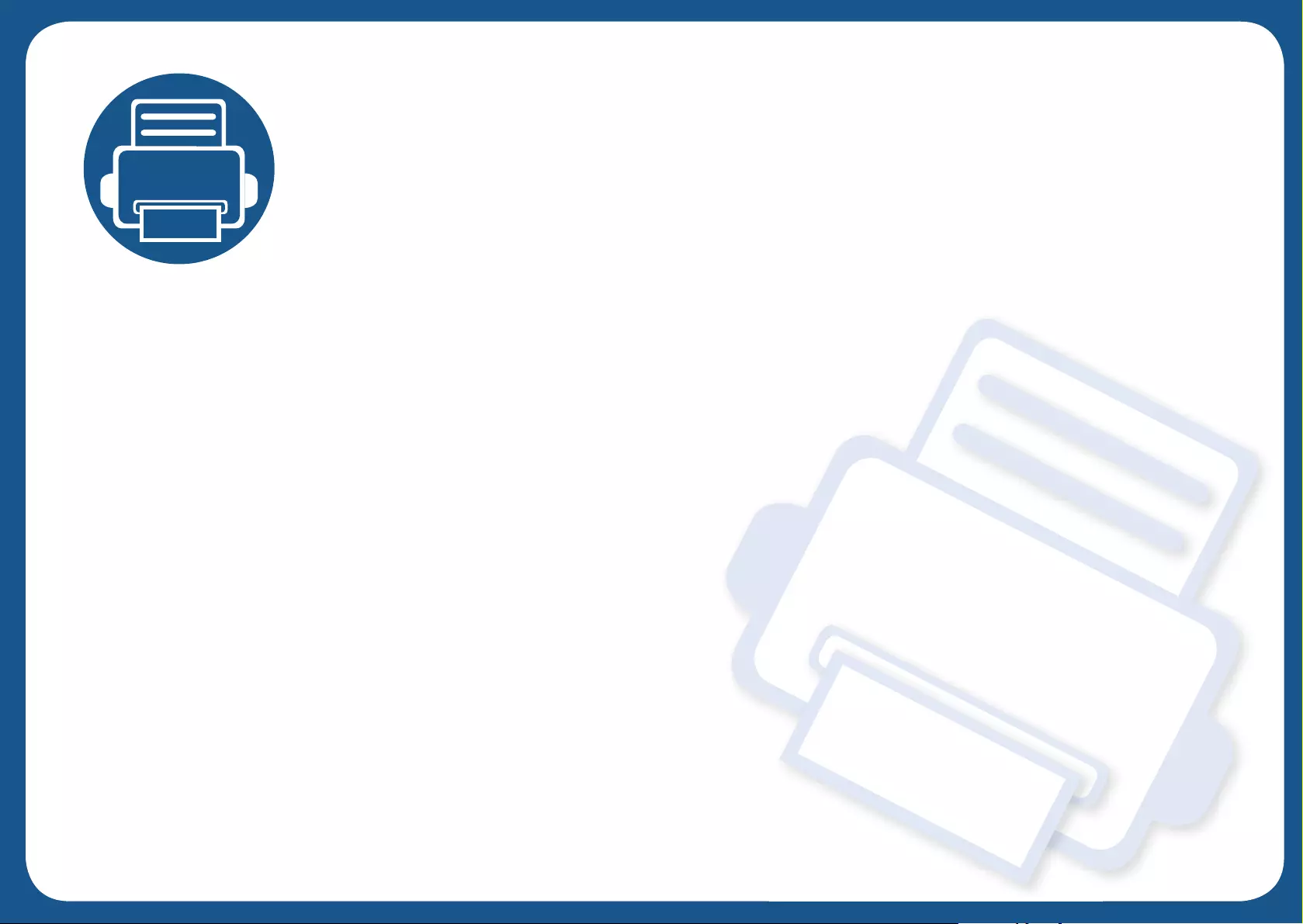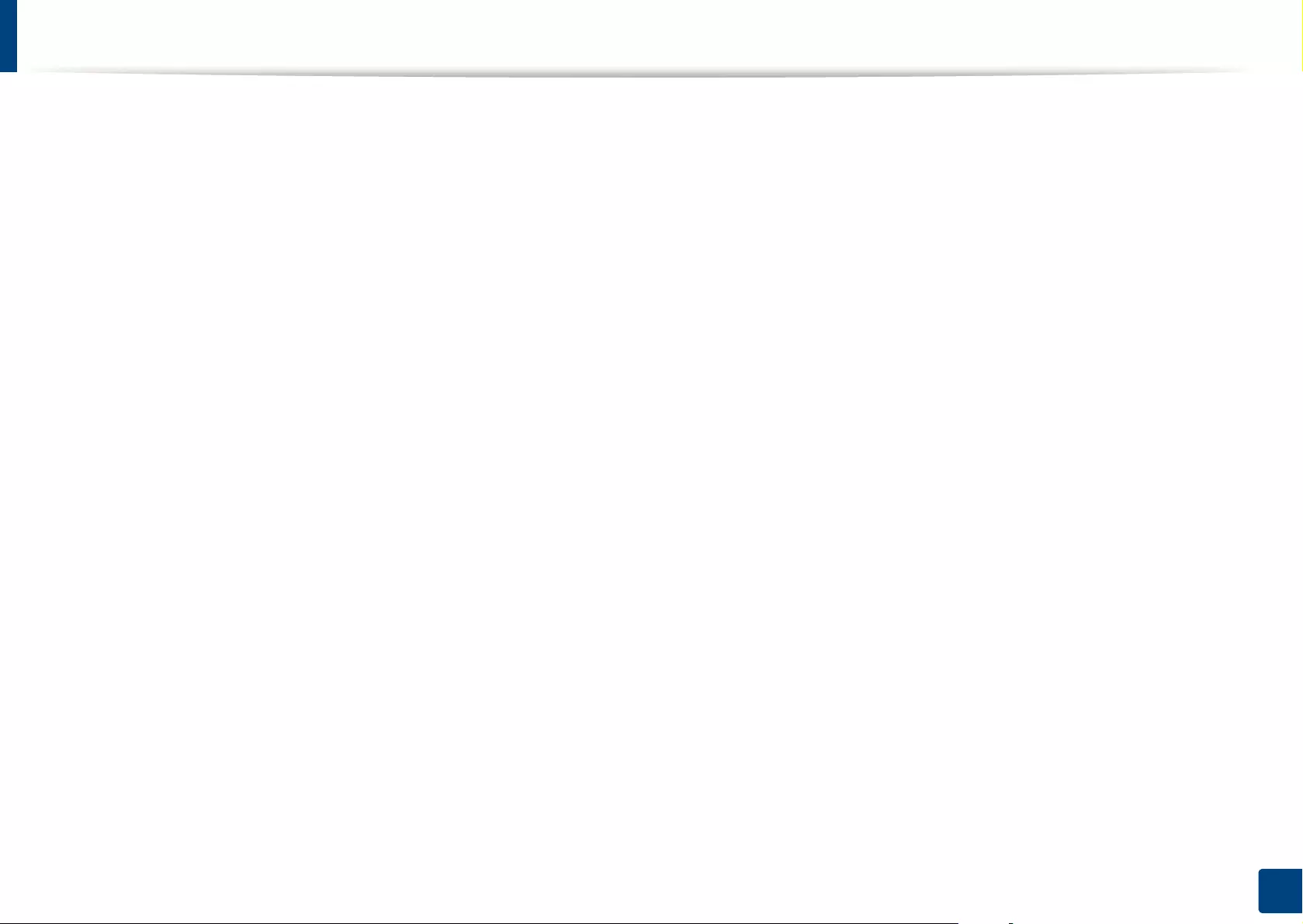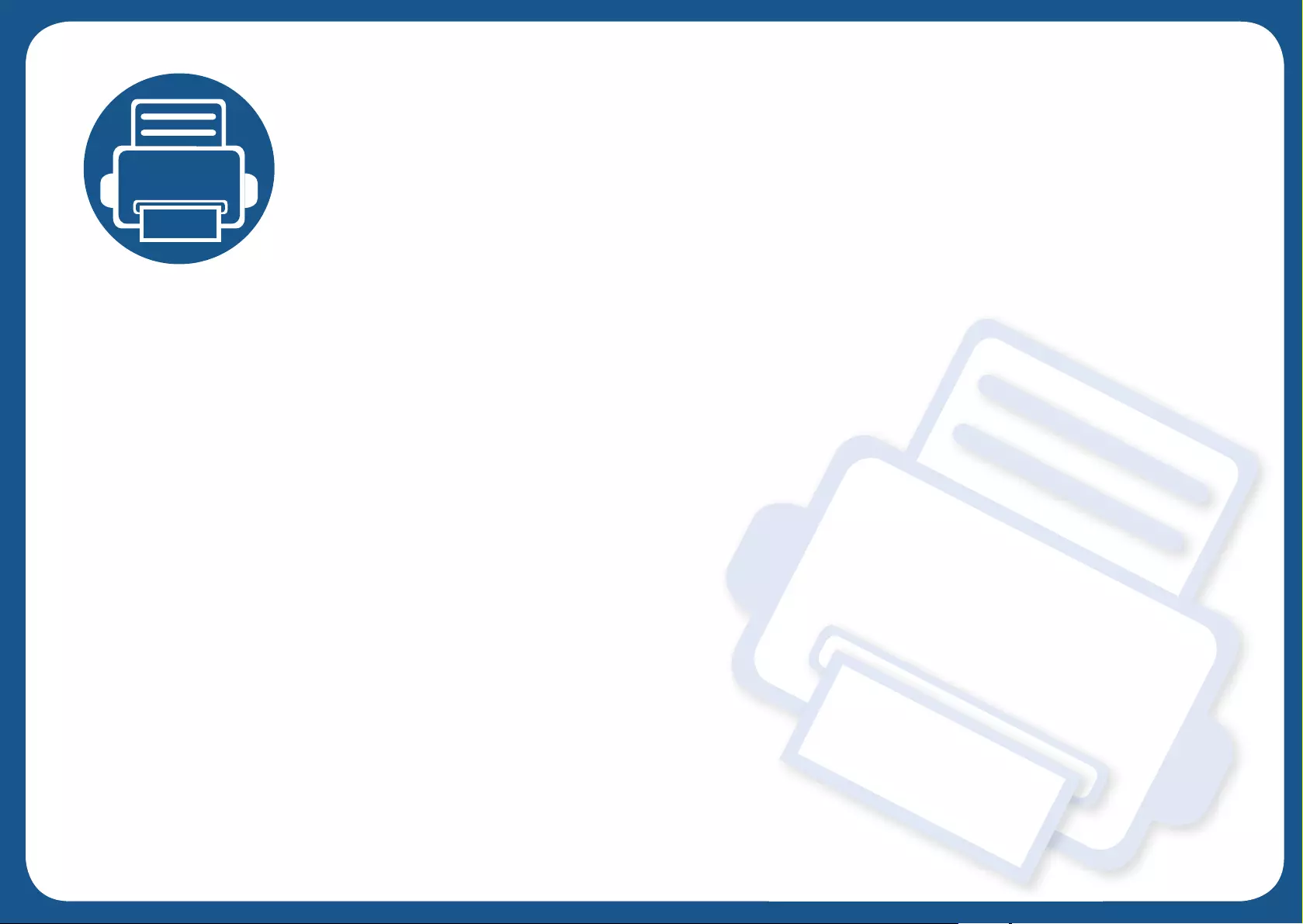Table of Contents
- User Guide
- 1. Introduction
- 2. Software Installation
- 3. Using a Network- Connected Machine
- 4. Media and tray
- 5. Printing
- 6. Copying
- 7. Scanning
- Understanding the scan methods
- Scanning and sending through email
- Scanning and sending via SMB/FTP
- Scanning and sending to your computer
- Scanning and sending to USB /shared folder
- Changing the scan feature settings
- Using a programs setting
- Scanning with TWAIN-enabled software
- Scanning with Samsung Easy Document Creator
- Mac scanning
- Linux scanning
- 8. Faxing (Optional)
- 9. Setting up an Address Book
- 10. Using the Machine via Mobile Device
- 11. Using Shared Folder, Stored Document, and USB
- 12. Menu Overview and Advanced Features
- 13. Useful Tools
- 14. Maintenance
- Ordering supplies and accessories
- Available supplies
- Available accessories
- Available maintenance parts
- Storing the toner cartridge
- Redistributing toner
- Replacing the toner cartridge
- Replacing the imaging unit
- Replacing the waste toner container
- Installing accessories
- Checking the supplies life
- Cleaning the machine
- Tips for storing the machine, supplies, and paper
- Tips for moving the machine
- 15. Troubleshooting
- 16. Appendix
- Contact SAMSUNG worldwide
- Glossary
- Index
Samsung SL-K3300NR User Manual
Displayed below is the user manual for SL-K3300NR by Samsung which is a product in the Multifunctionals category. This manual has pages.
Related Manuals

User GuideUser Guide
Thank you for purchasing a Samsung product.
This guide provides information concerning installation, operation and
troubleshooting on various operating system.

2
1. Introduction
Key benefits 7
Features by model 9
Useful to know 12
About this user’s guide 13
Safety information 14
Machine overview 20
Control panel overview 23
Connecting a network cable 24
Turning on the machine 25
Understanding the LEDs 27
Display screen and useful button 30
Understanding the pop-up keyboard 34
2. Software Installation
Installing the driver 36
Reinstalling the driver 39
3. Using a Network-Connected
Machine
Network environment 42
Accessing network setup 43
Network settings (TCP/IP) 44
Setting IP address 46
Installing driver over the network 51
Wireless network setup (Optional) 58
4. Media and tray
Loading originals 72
Selecting print media 75
Loading paper in the tray 76
Printing on special media 85
Tray Settings 89
5. Printing
Printer driver features 93
Basic printing 94

3
Opening printing preferences 96
Using special print features 105
Using direct printing utility 113
Changing the default print settings 115
Setting your machine as a default machine 116
Printing to a file (PRN) 117
Mac printing 118
Linux printing 120
Unix printing 121
6. Copying
Understanding the copy screen 124
Basic copying 126
Quick copying 129
ID card copying 130
Using special copy features 136
Using a program’s setting 142
7. Scanning
Understanding the scan methods 145
Scanning and sending through email 146
Scanning and sending via SMB/FTP 152
Scanning and sending to your computer 158
Scanning and sending to USB /shared folder 160
Changing the scan feature settings 162
Using a programs setting 166
Scanning with TWAIN-enabled software 167
Scanning with Samsung Easy Document Creator 168
Mac scanning 169
Linux scanning 170
8. Faxing (Optional)
Preparing to fax 172
Sending a fax from your computer 173
Understanding the fax screen 175
Sending a fax 177
Receiving a fax 184
Adjusting the document settings 187
Printing a fax report 190
Using a programs setting 191

4
9. Setting up an Address Book
Setting up an address book from the control panel
194
Setting up an address book from SyncThru™ Web
Service 198
10. Using the Machine via Mobile Device
Using the NFC feature (Optional) 206
Supported Mobile Apps 216
Mopria™ 217
AirPrint 219
Samsung Cloud Print 220
PrinterOn 223
Google Cloud Print™ 225
11. Using Shared Folder, Stored
Document, and USB
Understanding the Shared Folder screen 228
Using the Shared Folder 229
Understanding the Stored Document screen 230
Saving documents in the Stored Document 231
Understanding the USB screen 232
About USB memory device 233
Printing from a USB memory device 234
Scanning to a USB memory device 236
12. Menu Overview and Advanced
Features
Menu overview 238
Machine setup 243
13. Useful Tools
Accessing management tools 268
SyncThru™ Web Service 269
Easy Capture Manager 275
Samsung AnyWeb Print 276
Easy Eco Driver 277
Using Samsung Easy Document Creator 278
Using Samsung Printer Center 279
Using Samsung Easy Printer Manager 282

5
Using Samsung Printer Status 285
Using Samsung Printer Experience 287
14. Maintenance
Ordering supplies and accessories 294
Available supplies 295
Available accessories 296
Available maintenance parts 298
Storing the toner cartridge 299
Redistributing toner 300
Replacing the toner cartridge 303
Replacing the imaging unit 306
Replacing the waste toner container 310
Installing accessories 313
Checking the supplies life 315
Cleaning the machine 316
Tips for storing the machine, supplies, and paper 334
Tips for moving the machine 335
15. Troubleshooting
Tips for avoiding paper jams 337
Clearing paper jams 338
Understanding display messages 367
Paper feeding problems 378
Power and cable connecting problems 379
Solving other problems 380
16. Appendix
Specifications 397
Regulatory information 405
Copyright 418

1. Introduction
These are the main components of your machine:
This chapter includes:
•Key benefits 7
• Features by model 9
• Useful to know 12
• About this user’s guide 13
• Safety information 14
• Machine overview 20
• Control panel overview 23
• Turning on the machine 25
• Understanding the LEDs 27
• Display screen and useful button 30
• Understanding the pop-up keyboard 34

Key benefits
Environmentally friendly
• To save toner and paper, this machine supports Eco feature (see "Eco tab"
on page 102).
• To save paper, you can print multiple pages on one single sheet of paper
(see "Printing multiple pages on one sheet of paper" on page 105).
• To save paper, you can print on both sides of the paper (double-sided
printing) (see "Printing on both sides of the paper" on page 107).
• To save electricity, this machine automatically conserves electricity by
substantially reducing power consumption when not in use.
• We recommend using recycled paper for saving energy.
Fast high resolution printing
• You can print with a resolution of up to 1,200 x 1,200 dpi with reduced
speed.
• Fast, on-demand printing.
- X322x series
▪For single-side printing, up to 22 ppm (A4 or Letter).
- X328x series
▪For single-side printing, up to 28 ppm (A4 or Letter).
• Fast, on-demand printing.
- K325x series
▪For single-side printing, up to 25 ppm (A4 or Letter).
- K330x series
▪For single-side printing, up to 30ppm (A4 or Letter).

Key benefits
Convenience
• You can print on the go from your smartphone or computer using Samsung
Cloud Print apps (see "Samsung Cloud Print" on page 220).
• You can print on the go from your smartphone or computer using Google
Cloud Print™ enabled apps (see "Google Cloud Print™" on page 225).
• Easy Capture Manager allows you to easily edit and print whatever you
captured using the Print Screen key on the keyboard (see "Easy Capture
Manager" on page 275).
• Samsung Easy Printer Manager and Printing Status is a program that
monitors and informs you of the machine’s status and allows you to
customize the machine’s settings (see "Using Samsung Printer Status" on
page 285 or "Using Samsung Easy Printer Manager" on page 282).
• Samsung Easy Document Creator is an application to help users scan,
compile, and save documents in multiple formats, including .epub format.
These documents can be shared via social networking sites or fax (see
"Using Samsung Easy Document Creator" on page 278).
• AnyWeb Print helps you screen-capture, preview, scrap, and print the
screen of Windows Internet Explorer more easily than when you use the
ordinary program (see "Samsung AnyWeb Print" on page 276).
• Smart Update allows you to check for the latest software and install the
latest version during the printer driver installation process. This is available
only for Windows.
• If you have Internet access, you can get help, support application, machine
drivers, manuals, and order information from the Samsung website,
www.samsung.com > find your product > Support or Downloads.
Wide range of functionality and application support
• Supports various paper sizes (see "Print media specifications" on page 399).
• Print watermark: You can customize your documents with words, such as
“Confidential” (see "Using watermarks" on page 109).
• You can print in various operating systems (see "System requirements" on
page 402).
• Your machine is equipped with a USB interface and/or a network interface.
Support XOA applications
The machine supports XOA custom applications.
• Regarding the XOA custom applications, please contact your XOA custom
application provider.

Features by model
Some features and optional goods may not be available depending on model or country.
Operating System
(●: Supported, Blank: Not supported)
Software
You can install the printer driver and software when you insert the software CD into your CD-ROM drive. For windows, select the printer driver and software
in the Select Software to Install window.
Operating System Color Mono
X322x/ X328x series K325x/ K330x series
Windows ● ●
Mac ● ●
Linux ● ●
Unix ● ●
Software Color Mono
X322x/ X328x series K325x/ K330x series
SPL printer driver
PCL printer driver ● ●
PS printer drivera● ●
XPS printer drivera● ●
Direct Printing Utilitya● ●

Features by model
(●: Supported, ○: Optional, Blank: Not supported)
Samsung Easy Printer Manager Scan to PC Settings ● ●
Fax to PC Settings ○ ○
Advanced Setting ● ●
Samsung Printer Center ● ●
Samsung Printer Status ● ●
Samsung Easy Document Creator ● ●
Easy Capture Manager ● ●
SyncThru™ Web Service ● ●
SyncThru Admin Web Service ● ●
Samsung Eco Driver Packb● ●
Samsung Stylish Driver Packc● ●
Fax Samsung Network PC Fax ○ ○
Scan Scan driver ● ●
a. Download the software from the Samsung website and install it: (http://www.samsung.com > find your product > Support or Downloads). Before
installing, check whether your computer’s OS support the software.
b. To use the Easy Eco Driver features, the Eco Driver Pack must be installed.
c. The printer driver includes a user interface that is optimized for touchscreens. To use this UI, click Samsung Printer Center > Device Options and
then select Stylish User Interface (see "Using Samsung Printer Center" on page 279).
Software Color Mono
X322x/ X328x series K325x/ K330x series

Features by model
Variety feature
(●: Supported, ○: Optional, Blank: Not supported)
Features X322x series X328x series K325x series K330x series
Hi-Speed USB 2.0 ●●●●
USB memory interface ●●●●
Network Interface Ethernet 10/100/1000 Base TX wired LAN ● ●●●
Network Interface 802.11b/g/n wireless LANa○○○○
NFC (Near Field Communication) ○○○○
Google Cloud Print™ ●●●●
Samsung Cloud Print ●●●●
AirPrint ●●●●
Mopria ●●●●
Eco printing ●●●●
Duplex (2-sided) printing ●●●●
Document Feeder Reverse Automatic Document
Feeder(RADF) ●●●●
Cabinet Stand ○○○○
Dual Cassette Feeder ○○○○
Finisher ○ ○
Mass Storage Device (Hard disk) ●●○○
Fax Kit ○○○○
FDI ○○○○
a. Depending on your country, wireless LAN card may not be available. For some countries, only 802.11 b/g can be applied. Contact your local Samsung dealer or the retailer where you
bought your machine.

Useful to know
The machine does not print.
• Open the print queue list and remove the document from the
list (see "Canceling a print job" on page 95).
• Remove the driver and install it again (see "Installing the driver"
on page 36).
• Select your machine as your default machine in your Windows
(see "Setting your machine as a default machine" on page 116).
Where can I purchase accessories or supplies?
• The toner cartridge included in the printer/all-in-one product
you purchased is not available for sale and is not guaranteed
to be compatible with any other printer.
• Inquire at a Samsung distributor or your retailer.
• Visit www.samsung.com/supplies. Select your country/region
to view product service information.
The status LED flashes or remains constantly on.
• Turn the product off and on again.
• Check the meanings of LED indications in this manual and
troubleshoot accordingly (see "Understanding the LEDs" on
page 27).
A paper jam has occurred.
• Open and close the cover (see "Front view 1" on page 20).
• Check the instructions on removing jammed paper in this
manual and troubleshoot accordingly (see "Clearing paper
jams" on page 338).
Printouts are blurry.
• The toner level might be low or uneven. Shake the toner
cartridge (see "Redistributing toner" on page 300).
• Try a different print resolution setting (see "Opening printing
preferences" on page 96).
• Replace the toner cartridge (see "Replacing the toner
cartridge" on page 303).
Where can I download the machine’s driver?
• You can get help, support application, machine drivers,
manuals, and order information from the Samsung website,
www.samsung.com > find your product > Support or
Downloads.

13
1. Introduction
About this user’s guide
This user’s guide provides information for your basic understanding of the
machine as well as detailed steps to explain machine usage.
• Do not discard this manual and keep it for future reference.
• Read the safety information before using the machine.
• If you have a problem using the machine, refer to the troubleshooting
chapter.
• Terms used in this user’s guide are explained in the glossary chapter.
• All illustrations in this user’s guide may differ from your machine depending
on its options or model you purchased.
• The screenshots/some menus in this user’s guide may differ from your
machine depending on the machine’s firmware/driver version.
• The procedures in this user’s guide are mainly based on Windows 7.
1
Conventions
Some terms in this guide are used interchangeably, as below:
• Document is synonymous with original.
• Paper is synonymous with media, or print media.
• Machine refers to printer or MFP.
2
General icons
Icon Text Description
Warning Used to alert users to the possibility of personal injury.
Caution Gives users information to protect the machine from
possible mechanical damage or malfunction.
Note Provides additional information or detailed
specification of the machine function and feature.

14
1. Introduction
Safety information
These warnings and precautions are included to prevent injury to you and
others, and to prevent any potential damage to your machine. Be sure to read
and understand all of these instructions before using the machine. After reading
this section, keep it in a safe place for future reference.
3
Important safety symbols
Explanation of all icons and signs used in this chapter
4
Operating environment
Warning
Warning Hazards or unsafe practices that may result in severe
personal injury or death.
Caution Hazards or unsafe practices that may result in minor
personal injury or property damage.
Do not attempt.
Do not use if the power cord is damaged or if the electrical outlet is
not grounded.
This could result in electric shock or fire.
Do not place anything on top of the machine (water, small metal or
heavy objects, candles, lit cigarettes, etc.).
This could result in electric shock or fire.
• If the machine gets overheated, it releases smoke, makes strange
noises, or generates an odd odor, immediately turn off the power
switch and unplug the machine.
• The user should be able to access the power outlet in case of
emergencies that might require the user to pull the plug out.
This could result in electric shock or fire.
Do not bend, or place heavy objects on the power cord.
Stepping on or allowing the power cord to be crushed by a heavy
object could result in electric shock or fire.
Do not remove the plug by pulling on the cord; do not handle the
plug with wet hands.
This could result in electric shock or fire.

Safety information
15
1. Introduction
Caution
5
Operating method
Caution
During an electrical storm or for a period of non-operation,
remove the power plug from the electrical outlet.
This could result in electric shock or fire.
Be careful, the paper output area is hot.
Burns could occur.
If the machine has been dropped, or if the cabinet appears
damaged, unplug the machine from all interface connections and
request assistance from qualified service personnel.
Otherwise, this could result in electric shock or fire.
If the machine does not operate properly after these instructions
have been followed, unplug the machine from all interface
connections and request assistance from qualified service
personnel.
Otherwise, this could result in electric shock or fire.
If the plug does not easily enter the electrical outlet, do not
attempt to force it in.
Call an electrician to change the electrical outlet, or this could
result in electric shock.
Do not allow pets to chew on the AC power, telephone or PC
interface cords.
This could result in electric shock or fire and/or injury to your pet.
Do not forcefully pull the paper out during printing.
It can cause damage to the machine.
Be careful not to put your hand between the machine and paper
tray.
You may get injured.
Be careful when replacing paper or removing jammed paper.
New paper has sharp edges and can cause painful cuts.
When printing large quantities, the bottom part of the paper
output area may get hot. Do not allow children to touch.
Burns can occur.
When removing jammed paper, do not use tweezers or sharp metal
objects.
It can damage the machine.
Do not allow too many papers to stack up in the paper output tray.
It can damage the machine.

Safety information
16
1. Introduction
6
Installation / Moving
Warning
Do not block or push objects into the ventilation opening.
This could result in elevated component temperatures which can
cause damage or fire.
Use of controls or adjustments or performance of procedures other
than those specified herein may result in hazardous radiation
exposure.
This machine's power reception device is the power cord.
To switch off the power supply, remove the power cord from the
electrical outlet.
Do not place the machine in an area with dust, humidity, or water
leaks.
This could result in electric shock or fire.
Place the machine in the environment where it meets the
operating temperature and humidity specification.
Do not use the machine when it is below freezing temperature or
has recently been moved from a location below freezing
temperature. Doing so may damage the machine. Only operate the
machine when the internal temperature of the machine is within
the operating temperature and humidity specifications.
Otherwise, quality problems can occur and cause damage to the
machine.
See "General specifications" on page 397.

Safety information
17
1. Introduction
Caution
Before moving the machine, turn the power off and disconnect all
cords. The information below are only suggestions based on the
units weight.
If you have a medical condition that prevents you from lifting, do
not lift the machine. Ask for help, and always use the appropriate
amount of people to lift the device safety.
Then lift the machine:
• If the machine weighs under 20 kg (44.09 lbs), lift with 1 person.
• If the machine weighs 20 kg (44.09 lbs) - 40 kg (88.18 lbs), lift
with 2 people.
• If the machine weighs more than 40 kg (88.18 lbs), lift with 4 or
more people.
The machine could fall, causing injury or machine damage.
Choose a flat surface with enough space for ventilation to place
the machine. Also consider the space required to open the cover
and trays.
The place should be well-ventilated and be far from direct light,
heat, and humidity.
When using the machine for a long period of time or printing a
large number of pages in a non-ventilated space, it could pollute
the air and be harmful to your health. Place the machine in a well-
ventilated space or open a window to circulate the air periodically.
Do not place the machine on an unstable surface.
The machine could fall, causing injury or machine damage.
Use only No.26 AWGa or larger, telephone line cord, if necessary.
Otherwise, it can cause damage to the machine.
Make sure you plug the power cord into a grounded electrical
outlet.
Otherwise, this could result in electric shock or fire.
Use the power cord supplied with your machine for safe
operation. If you are using a cord which is longer than 2 meters (6
feet) with a 110V machine, then the gauge should be 16 AWG or
larger.
Otherwise, it can cause damage to the machine, and could result
in electric shock or fire.
Do not put a cover over the machine or place it in an airtight
location, such as a closet.
If the machine is not well-ventilated, this could result in fire.
Do not overload wall outlets and extension cords.
This can diminish performance, and could result in electric shock
or fire.
The machine should be connected to
the power level which is specified on the label.
If you are unsure and want to check the power level you are using,
contact the electrical utility company.
a. AWG: American Wire Gauge

Safety information
18
1. Introduction
7
Maintenance / Checking
Caution
8
Supply usage
Caution
Unplug this product from the wall outlet before cleaning the
inside of the machine. Do not clean the machine with benzene,
paint thinner or alcohol; do not spray water directly into the
machine.
This could result in electric shock or fire.
When you are working inside the machine replacing
consumables or cleaning the inside, do not operate the machine.
You could get injured.
Keep cleaning consumables away from children.
Children could get hurt.
Do not disassemble, repair or rebuild the machine by yourself.
It can damage the machine. Call a certified technician when the
machine needs repairing.
To clean and operate the machine, strictly follow the user's guide
provided with the machine.
Otherwise, you could damage the machine.
Keep the power cable and the contact surface of the plug clean
from dust or water.
Otherwise, this could result in electric shock or fire.
• Do not remove any covers or guards that are fastened with
screws.
• Fuser units should only be repaired by a certified service
technician. Repair by non-certified technicians could result in
fire or electric shock.
• The machine should only be repaired by a Samsung service
technician.
Do not disassemble the toner cartridge.
Toner dust can be dangerous if inhaled or ingested.
Do not burn any of the consumables such as toner cartridge or
fuser unit.
This could cause an explosion or uncontrollable fire.

Safety information
19
1. Introduction
When storing consumables such as toner cartridges, keep them
away from children.
Toner dust can be dangerous if inhaled or ingested.
Using recycled consumables, such as toner, can cause damage to
the machine.
In case of damage due to the use of recycled consumables, a
service fee will be charged.
For consumables that contain toner dust (toner cartridge, waste
toner bottle, imaging unit, etc.) follow the instructions below.
• When disposing of the consumables, follow the instructions for
disposal. Refer to the reseller for disposal instructions.
• Do not wash the consumables.
• For a waste toner bottle, do not reuse it after emptying the
bottle.
If you do not follow the instructions above, it may cause machine
malfunction and environmental pollution. The warranty does not
cover damages caused by a user's carelessness.
When toner gets on your clothing, do not use hot water to wash it.
Hot water sets toner into fabric. Use cold water.
When changing the toner cartridge or removing jammed paper,
be careful not to let toner dust touch your body or clothes.
Toner dust can be dangerous if inhaled or ingested.

20
1. Introduction
Machine overview
9
Front view 1
1 Reversing Automatic Document
Feeder (RADF) cover
8Power receptacle
2 Reversing Automatic Document
Feeder (RADF) width guides
9Handles
2
3
4
6
1
14
10
11
12
7
8
5
13
9
3 Reversing Automatic Document
Feeder (RADF) input tray
10 Standard tray (Tray 2)
4 Control panel 11 Standard tray (Tray 1)
5 Side door 12 Front door
6 Multi-purpose tray 13 Front door handle
7 Power-switch 14 Paper output tray

Machine overview
21
1. Introduction
10
Front view 2
11
Inner view
X322x/ X328x series
If you want to see the imaging unit, you need to remove the waste toner
container.
1 Scanner glass 4 Multi-purpose tray
2 White sheet 5 USB memory port
3 Multi-purpose tray paper width
guides
3
4
2
1
5
1 LSU window cleaning stick
2 Waste toner container
3 Toner cartridges
4Imaging units
1
2
3 4

Machine overview
22
1. Introduction
K325x/ K330x series
If you want to see the imaging unit, you need to remove the waste toner
container.
12
Rear view
1 Waste toner container
2 Toner cartridge
3Imaging unit
1
2
3
1 Output support tray 5 Network port
2Control board cover 6Cover for optional FDI kita
a. Open this cover to install the optional device.
3USB memory port 7Cover for optional Fax1 porta
4USB port
2 1
6
7
5
4
3

23
1. Introduction
Control panel overview
13
Control panel
When you use the display screen, use your finger only. The screen may be
damaged with a sharp pen or anything else.
1
Display screen
Shows the current machine status and prompts during
an operation. You can set menus easily using the display
screen.
2Job Status Shows the jobs currently running, queued jobs,
completed jobs, current error code or secured jobs.
3Counter Shows the amount of paper used (see "Counter button"
on page 31).
4
Numeric keypad
Dials numbers and enters alphanumeric characters. You
can also enter the number value for document copies or
other options.
5
Eco
Turn on Eco mode. Turn on the Eco mode to reduce
toner consumption and paper usage when pc-printing
and copying only (see "Eco button" on page 32).
7
8
9
10
15 1314 12 11
23 4 5 6
1
6
Power/Wakeup
Turns the power on or off. When the blue LED is on, the
machine is powered on and you can use it. To turn the
machine off, press and hole this button for at least 3
seconds. Press Yes when the confirmation window
appears.
7Clear Deletes characters in the edit area.
8Interrupt Stops a job in operation for urgent copying.
9
Stop
Stops an operation at any time. The pop-up window
appears on the screen showing the current job that the
user can stop or resume.
10 Start Starts a job.
11
Redial/Pause
Redials the recently sent fax number or received caller
ID in ready mode, or inserts a pause (-) into a fax number
in edit mode.
12 Logout Allows user to log out.
13
On Hook Dial
When you press this button, you can hear a dial tone.
Then enter a fax number. It is similar to making a call
using a speaker phone.
14 Reset Resets the current machine setup.
15 Status LED Shows the status of your machine (see "Understanding
the LEDs" on page 27).

24
1. Introduction
Connecting a network cable
This machine has a built-in network interface card. You can connect your machine to a network using a network cable.

25
1. Introduction
Turning on the machine
Keep in mind that you should use the power cord supplied with the
machine. Otherwise, it can cause damage or fire to the machine.
1Plug the power cord into the power receptacle.
2 Plug the other end into a properly grounded AC outlet.

Turning on the machine
26
1. Introduction
3 Turn on the main power switch.
• You can also turn the machine on pressing the (Power/Wakeup).
• Some parts inside of the machine may be hot when power is on, or after
printing. Be careful not to burn yourself when working inside the
machine.
• Do not disassemble the machine when it is turned on or plugged in.
Doing so may give you an electric shock.

27
1. Introduction
Understanding the LEDs
The color of the status LED indicates the machine's current status.
• Some LEDs may not be available depending on model or country (see "Control panel overview" on page 23).
• To resolve the error, look at the error message and its instructions from the troubleshooting part (see "Troubleshooting" on page 336).
• You also can resolve the error with the guideline from the computers’ Samsung Printer Status program window (see "Using Samsung Printer Status" on page 285).
• If the problem persists, call a service representative.
14
Understanding the status LED
Status Description
Off • The machine is off-line.
• The machine is in power save mode.
Blue On The machine is on-line and can be used.
Blinking Fax The machine is sending or receiving faxes.
Copy The machine is copying documents.
Scan The machine is scanning documents.
Print • When the status LED slowly blinks, the machine is receiving data from the computer.
• When the status LED blinks rapidly, the machine is printing data.

Understanding the LEDs
28
1. Introduction
Check the message on the display screen. Follow the instructions in the message or refer to the troubleshooting chapter (see "Understanding display messages" on
page 367). If the problem persists, call for service.
Orange On • A toner cartridge has almost reached its estimated cartridge lifea. It is recommended to replace the toner cartridge.
• A paper jam has occurred (see "Clearing paper jams" on page 338).
• The door is opened. Close the door.
• There is no paper in the tray. Load paper in the tray (see "Loading paper in the tray" on page 76).
• The machine has stopped due to a major error. Check the display message (see "Understanding display messages" on page 367).
• An imaging unit has almost reached its estimated cartridge life. It is recommended to replace the toner cartridge.
• The waste toner container is not installed in the machine or it is full (see "Replacing the waste toner container" on page 310).
Blinking • A minor error has occurred and the machine is waiting for the error to be cleared. Check the display message (see "Understanding display
messages" on page 367). When the problem is cleared, the machine resumes its original task.
• The toner cartridge lifea or imaging unit is near the end of its life. Order a new toner cartridge or imaging unit. You can temporarily improve
print quality by redistributing the toner.
a. Estimated cartridge life means the expected or estimated toner cartridge life, which indicates the average capacity of print-outs and is designed pursuant to ISO/IEC 19752 (K325x/ K330x series)
or ISO/IEC 19798 (X322x/ X328x series). The number of pages may be affected by operating environment, percentage of image area, printing interval, graphics, media and media size. Some amount
of toner may remain in the cartridge even when orange LED is on and the printer stops printing.
Status Description

Understanding the LEDs
29
1. Introduction
15
Power LED
The color of the status LED indicates the machine's current status.
Check the message on the display screen. Follow the instructions in the message or refer to the troubleshooting chapter (see "Understanding display messages" on
page 367). If the problem persists, call for service.
Status Description
Off The machine is off-line.
Blue On • The machine is on-line and can be used.
• The machine is in power save mode. When data is received, or any screen is pressed, it switches to on-line automatically.

30
1. Introduction
Display screen and useful button
16
Display screen
The display screen on the control panel allows user-friendly operation of the
machine. Once you press the home icon ( ) on the screen, it shows the display
screen. The display screen image in this user’s guide may differ from your
machine depending on its option or model.
• To switch to the next display screen, press the right arrow or drag your
finger across the display screen.
• Depending on the authentication setting, the machine’s users have to
enter an ID and a password. In this case, the machine can only be used by
an authorized user who has registered an ID and a password on the
machine. Contact the machine’s administrator.
•Copy: Enters the Copy menu (see "Copying" on page 123).
•Fax: Enters the Fax menu (see "Faxing (Optional)" on page 171).
•Stored Document: Enters the Stored Document menu (see
"Understanding the Stored Document screen" on page 230).
•Shared Folder: Enters the Shared Folder menu (see "Understanding the
Shared Folder screen" on page 228).
•Scan to Email: Enters the Scan to Email menu (see "Scanning and sending
through email" on page 146).

Display screen and useful button
31
1. Introduction
•Scan to Server: Enters the Scan to Server menu (see "Scanning and
sending via SMB/FTP" on page 152).
•Scan to PC: Enters the Scan to PC menu (see "Scanning and sending
through email" on page 146).
•Scan to Shared Folder: Enters the Scan to Shared Folder menu (see
"Scanning and sending to USB /shared folder" on page 160).
•Quick Copy: Enters the Quick Copy menu (see "Quick copying" on page
129).
•USB: Enters the USB menu. When a USB memory device is inserted into the
USB memory port on your machine, USB is activated on the display screen
(see "Understanding the USB screen" on page 232).
•Scan to USB: Enters the Scan to USB menu. When a USB memory device is
inserted into the USB memory port on your machine, Scan to USB is
activated on the display screen (see "Scanning to a USB memory device" on
page 236).
•Machine Setup: You can browse current machine settings or change
machine values (see "Machine setup" on page 243).
Some menus are only configured by an administrator or an authorized user
who has an ID and password registered on the machine by an administrator.
When the machine requests, enter the ID and password.
•Scan to Samsung Cloud: In order to use this menu, Samsung Cloud Printer
should be registered. For more information, contact your local Samsung
dealer or the retailer where you purchased your machine (see "Scanning
and sending to Samsung Cloud Print" on page 222).
17
Counter button
When you press the Counter button on the control panel, You can see the
number of impressions.
When you select Device, you can see the number of impressions by device. An
impression typically refers to a single side of a sheet and not a one-sided print.
•Total Usage: Displays the total number of impressions.
•Send Usage: Displays the number of images sent via email, server, etc.
•Large Page: Displays the total number of impressions with large size paper.
•Fax Send Usage(PSTN): Displays the number of sent faxes.
When you select User, you can see the number of usage, limit, and remaining
usage by each user.

Display screen and useful button
32
1. Introduction
18
Eco button
The eco feature allows you to save print resources and leads you to eco-friendly
printing. When you press the Eco button, the machine turns eco mode on or off.
If the eco mode is on, you can see the eco image ( ) on some features. Some
options in the features are not available to use in the eco mode.
• Only administrators have permission for Eco Settings in Machine Setup
(see "Eco Settings" on page 260).
• If the machine requests a password for eco mode, you need to enter the
password. Contact your administrator.
• The Eco button is activated only for Copy, Quick Copy menus.
19
Job Status button
When you press the Job Status button, the screen lists the currently running,
queued, and completed jobs.
Current Job
Displays the list of jobs in progress and pending.
Pressing the job name shows more detailed information.
•No.: Gives the order of jobs.
•Job Type: Displays type of the job, such as print, copy, fax, etc.
•Job Name: Displays the name of the job.
•User: Displays the name of the job owner.
•Status: Displays the current status of each job.
•Delete: Removes a selected job from the list.
Completed Job
Displays the list of completed jobs.
Pressing the job name shows more detailed information.
•No.: Gives the order of jobs.
•Job Type: Displays type of the job, such as print, copy, fax, etc.
•Job Name: Displays the name of the job.
•User: Displays the name of the job owner.
•Status: Displays the status of each completed job.
Status Description
Off The machine is not in Eco mode.
Green On The machine is in Eco mode.

Display screen and useful button
33
1. Introduction
Secured Job
Displays the list of secured jobs the user has set in the printer driver (see "Print
Mode" on page 103). You need to enter the ID and Password set in the printer
driver.
•No.: Gives the order of jobs.
•Job Type: Displays type of the job.
•Job Name: Displays the name of the job.
•User: Displays the name of the job owner.
•Detail: Displays detailed information of the selected job. You can also
change the number of copies by pressing Change Settings.
•Edit: Changes the Job Name of the selected job.
•Delete: Removes the selected job from the list.
•Print: Prints the selected job from the list.
•Close: Closes the job status window.
Active Notice
Displays any error messages and codes that have occurred.
•Time: Display the time of messages.
•Type: Displays type of the job.
•Machine Status Message: Displays the error messages for the current
errors in the machine.
•Error Code: Displays the error message's code.
20
Interrupt button
When you press the Interrupt button, the machine goes into interrupt mode,
which means it stops the current printing job for an urgent copy job. When the
urgent copy job is completed, the previous printing job continues.
Status Description
Off The machine is not in interrupt printing mode.
Blue On The machine is in interrupt printing mode.

34
1. Introduction
Understanding the pop-up keyboard
You can enter alphabet characters, numbers, or special symbols using the pop-
up keyboard on the display screen. This keyboard is the same as a normal
keyboard for easy usability.
Touch the input area where you need to enter characters, then the keyboard
pops up on the screen. The keyboard is the default showing the lowercase
letters.

36
2. Software Installation
Installing the driver
A locally connected machine is a machine directly attached to your computer
using a USB cable. If your machine is attached to a network, skip the following
steps below and go on to installing a network connected machine’s driver (see
"Installing driver over the network" on page 51).
• The installation window in this user’s guide may differ depending on the
machine and interface in use.
• Only use a USB cable no longer than 3 meters (118 inches).
1
Windows
1Make sure that the machine is connected to your computer and
powered on.
2 Insert the supplied software CD into your CD-ROM drive.
If the installation window does not appear, click Start > All programs >
Accessories > Run.
X:\Setup.exe replacing “X” with the letter, which represents your CD-
ROM drive and click OK.
• For Windows 8
If the installation window does not appear, from Charms, select
Search > Apps and search for Run. Type in X:\Setup.exe, replacing
“X” with the letter that represents your CD-ROM drive and click OK.
If “Tap to choose what happens with this disc.” pop-up window
appears, click the window and select Run Setup.exe.
• For Windows 10 / Windows Server 2016
If the installation window does not appear, from task bar, type in
X:\Setup.exe in Search input area, replacing “X” with the letter that
represents your CD-ROM drive and press the Enter key.
3 Review and accept the installation agreements in the installation
window, and then click Next.
4 Select USB on the Printer Connection Type screen, and then click Next.
5 Follow the instructions in the installation window.

Installing the driver
37
2. Software Installation
From the Windows 8 Start Screen
• The V4 driver is automatically downloaded from the Windows Update if
your computer is connected to the Internet. If not, you can manually
download the V4 driver from Samsung website, www.samsung.com >
find your product > Support or downloads.
• You can download Samsung Printer Experience app from the Windows
Store. You need have a Microsoft account to use the Windows Store.
1 From Charms, select Search.
2 Click Store.
3 Search and click Samsung Printer Experience.
4 Click Install.
• If you install the driver using the supplied software CD, V4 driver is not
installed. If you want to use the V4 driver in the Desktop screen, you can
download from the Samsung website, www.samsung.com > find your
product > Support or downloads.
• If you want to install Samsung’s printer management tools, you need to
install them using the supplied software CD.
1Make sure that your computer is connected to the Internet and powered
on.
2 Make sure that the machine is powered on.
3 Connect the computer and the machine with a USB cable.
The driver is automatically installed from the Windows Update.
2
Mac
1Make sure that the machine is connected to your computer and
powered on.
2 Insert the supplied software CD into your CD-ROM drive.
3 Select the CD-ROM volume that appears on Finder.
4 Double-click the Install Software icon.
5 Read the license agreement and check installation agreement button.
6 Click Next and then follow the instructions in the installation window.

Installing the driver
38
2. Software Installation
3
Linux
You need to download Linux software packages from the Samsung website to
install the printer software (http://www.samsung.com > find your product >
Support or Downloads).
Installing the Unified Linux Driver
You must log in as a super user (root) to install the machine software. If you
are not a super user, ask your system administrator.
1Make sure that the machine is connected to your computer and
powered on.
2 Copy Unified Linux Driver package to your system.
3 Open Terminal program and go to the folder that you copied the
package to.
4 Extract the package.
5 Move to uld folder.
6 Execute "./install.sh" command (If you're not logged in as root, execute
the command with "sudo" as "sudo ./install.sh")
7 Proceed with installation.
8 When installation finished, launch printing utility (Go to System >
Administration > Printing or execute "system-config-printer"
command in Terminal program).
9 Click Add button.
10 Select your printer.
11 Click Forward button and add it to your system.

39
2. Software Installation
Reinstalling the driver
If the printer driver does not work properly, follow the steps below to reinstall
the driver.
4
Windows
1Make sure that the machine is connected to your computer and
powered on.
2 From the Start menu, select Programs or All Programs > Samsung
Printers > Uninstall Samsung Printer Software .
• For Windows 8,
1 From Charms, select Search > Apps.
2 Search and click Control Panel.
3 Click Programs and Features.
4 Right-click the driver you want to uninstall and select Uninstall.
• For Windows 10 / Windows Server 2016
1 From task bar, type in Programs and Features in Search input
area. Press the Enter key.
OR
From the Start ( ) icon, select All apps > Search > type in
Programs and Features.
2 Right-click the driver you want to uninstall and select Uninstall.
3 Follow the instructions in the installation window.
4 Insert the software CD into your CD-ROM drive and install the driver
again (see "Installing the driver" on page 36).
From the Windows 8 Start Screen
1Make sure that the machine is connected to your computer and
powered on.
2
Click on the
Uninstall Samsung Printer Software
tile in the
Start
screen.
3 Follow the instructions in the window.
• If you cannot find a Samsung Printer Software tile, uninstall from the
desktop screen mode.
• If you want to uninstall Samsung’s printer management tools, from the
Start screen, right-click the app > Uninstall > right-click the program
you want to delete > Uninstall and follow the instruction in the window.

Reinstalling the driver
40
2. Software Installation
5
Mac
If the printer driver does not work properly, uninstall the driver and reinstall it.
1Open the Applications folder > Samsung > Printer Software
Uninstaller.
2 To uninstall printer software, click Continue.
3 Check the program you want to delete and click Uninstall.
4 Enter the password and click OK.
5 After the uninstallation is finished, click Close.
If a machine has already been added, delete it from the Print Setup Utility
or Print & Fax.
6
Linux
If the printer driver does not work properly, uninstall the driver and reinstall it.
1 Open Terminal program.
2 Move to uld folder extracted from Unified Linux Driver package.
3 Execute "./uninstall.sh" command (If you're not logged in as root,
execute the command with "sudo" as "sudo ./uninstall.sh")
4 Proceed with uninstallation.

3. Using a Network-
Connected Machine
This chapter gives you step-by-step instructions for setting up the network environment before using the machine. You
need to be familiar with the terms used for setting up the network environment. Refer to the glossary for terms you do
not understand ("Glossary" on page 426).
This chapter includes:
• Network environment 42
• Accessing network setup 43
• Network settings (TCP/IP) 44
• Setting IP address 46
• Installing driver over the network 51
• Wireless network setup (Optional) 58

42
3. Using a Network-Connected Machine
Network environment
You can use network after connecting network cable to a corresponding port on
your machine.
You need to set up the network protocols on the machine to use it as your
network machine. You can set up the basic network settings through the
machine's control panel.
The following table shows the network environments supported by the
machine:
Items Specifications
Network interface • Ethernet 10/100/1000 Base-TX Wired Lan
• 802.11b/g/n Wireless LAN a
Network operating
system
•Windows
® XP Service Pack 3, Windows Server® 2003,
Windows Vista®, Windows® 7/8, Windows Server®
2008 R2, Windows® 10, Windows® Sever 2016
•Various Linux OS
• Mac OS X 10.6 -10.10
•UNIX OS
Network protocols •TCP/IPv4
• DHCP, BOOTP
• DNS, WINS, Bonjour, SLP, UPnP
• Standard TCP/IP Printing (RAW), LPR, IPP, WSD
• SNMPv 1/2/3, HTTP, IPSec
• TCP/IPv6 (DHCP, DNS, RAW, LPR, SNMPv 1/2/3, HTTP,
IPSec)
Wireless security a• Authentication: Open System, Shared Key, WPA/
WPA2-Personal/Enterprise
• Encryption: WEP64, WEP128, TKIP, AES
a. Optional device
Items Specifications

43
3. Using a Network-Connected Machine
Accessing network setup
1Make sure that the ethernet cable is connected to your machine.
2 Press Machine Setup > Network Settings from the display screen.
3 Select the option you want. If the option is available for only the
administrator, the following screen appears.
Enter the ID, Password, and Domain using the pop-up keyboard which
appears when you press each field.
• Enter the ID and password you first set when you turned on the machine:
Initial Settings (see "Initial Settings" on page 261).
• You can also use the Recent Users button to find the recently used ID
and Domain List button to find the domain from the list stored in the
machine.
• When you log-in, you can see the ID of the logged in user on the display.
4 Press OK.

44
3. Using a Network-Connected Machine
Network settings (TCP/IP)
When you connect your machine to a network, you must first configure the TCP/
IP settings for the machine. The settings shown below are the basic settings
required for using your machine as a network machine. You can set TCP/IP, DNS
server, TCP/IPv6, Ethernet, and IP address allocation methods.
1
Ethernet
You can set ethernet settings.
Press Machine Setup > Network Settings > TCP/IP > Ethernet from the
display screen.
You can also use this feature from the SyncThru™ Web Service. Open the
Web browser from your networked computer and type the IP address of
your machine (see "Settings tab" on page 271).
•Ethernet: You can enable/disable ethernet port.
•Speed Rate: Choose the speed rate of ethernet.
•MAC Address: Shows the Mac address of the machine.
2
TCP/IP Protocol
You can set IPv4 settings.
Press Machine Setup > Network Settings > TCP/IP > TCP/IPv4 from the
display screen.
You can also use this feature from the SyncThru™ Web Service. Open the
Web browser from your networked computer and type the IP address of
your machine (see "Settings tab" on page 271).
IP Setting
You can choose the method for allocating IP addresses.
•Static: Select to enter IP address/Subnet Mask/Gateway Address manually.
•BOOTP: IP address/Subnet Mask/Gateway Address are automatically
allocated by the BOOTP Server.
•DHCP: IP address/Subnet Mask/Gateway Address are automatically
allocated by the DHCP Server.

Network settings (TCP/IP)
45
3. Using a Network-Connected Machine
DNS Configuration
You can configure the DNS server.
•Host Name: Enter the host name. You can enter up to 63 characters. Default
name is “SEC[MAC address]”.
•Domain Name: Enter the domain name. You can enter up to 128 characters.
•
Primary DNS Server:
Enter the address of the DNS server you want to use primarily.
•
Secondary DNS Server:
Enter the address of the DNS server you want to use as an
alternative.
•
Dynamic DNS Registration:
If you want to use, check the checkbox(es) of dynamic
DNS registration
.
If this option is checked, the machine registers its host name and
domain name to configured DNS servers dynamically. Also, if this option is checked
and DHCP is selected, DHCP FQDN options are automatically disabled.
WINS (Windows Internet Name Service)
You can configure the WINS server. WINS is used in the Windows operating
system. Select this option.
Display IP address
You can set the machine to display the IP address on the Notification Bar. If you
select this option the IP address will show on the Notification Bar.

46
3. Using a Network-Connected Machine
Setting IP address
When you connect your machine to a network, you must first configure the TCP/
IP settings for the machine. The settings shown below are the basic settings
required for using your machine as a network machine. You can set TCP/IP, DNS
server, TCP/IPv6, Ethernet, and IP address allocation methods.
3
IPv4 configuration
• If your device does not support a network connection, it will not be able
to use this feature (see "Rear view" on page 22).
• You can also set the TCP/IPv4 from control panel.
• TCP/IPv6 is not supported by this program.
First, you have to set up an IP address for network printing and managements.
In most cases a new IP address will be automatically assigned by a DHCP
(Dynamic Host Configuration Protocol) server located on the network.
IPv4 configuration using SetIP (Windows)
Before using the SetIP program, disable the computer firewall from Control
Panel > Security Center > Windows Firewall.
The following instructions may differ for your model.
1Download the software from the Samsung website then unpack and
install it: (http://www.samsung.com > find your product > Support or
Downloads).
2 Follow the instructions in the installation window.
3 Connect your machine to the network with a network cable.
4 Turn on the machine.
5 From the Windows Start menu, select All Programs > Samsung
Printers > SetIP > SetIP.
6 Click the icon (third from left) in the SetIP window to open the TCP/
IP configuration window.
7 Enter the machine’s new information into the configuration window. In
a corporate intranet, you may need to have this information assigned by
a network manager before proceeding.
Find the machine’s MAC address from the Network Configuration Report
(see "Other settings" on page 249) and enter it without the colons. For
example, 30:CD:A7:1F:E3:27 becomes 30CDA71FE327.
8 Click Apply, and then click OK. The machine will automatically print the
Network Configuration Report. Confirm that all the settings are
correct.

Setting IP address
47
3. Using a Network-Connected Machine
IPv4 configuration using SetIP (Mac)
Before using the SetIP program, disable the computer firewall from System
Preferences > Security (or Security & Privacy) > Firewall.
1Download the software from the Samsung website then unpack and
install it: (http://www.samsung.com > find your product > Support or
Downloads).
2 Turn on the machine.
3 Run downloaded SetIP application.
4 Click the icon (third from left) in the SetIP window to open the TCP/
IP configuration window.
5 Enter the machine’s new information into the configuration window. In
a corporate intranet, you may need to have this information assigned by
a network manager before proceeding.
Find the machine’s MAC address from the Network Configuration Report
(see "Other settings" on page 249) and enter it without the colons. For
example, 30:CD:A7:1F:E3:27 becomes 30CDA71FE327.
6 Click Apply, and then click OK. The machine will automatically print the
Network Configuration Report. Confirm that all the settings are
correct.
IPv4 configuration using SetIP (Linux)
Before using the SetIP program, disable the computer firewall from System
Preferences or Administrator.
The following instructions may vary from your model or operating systems.
1Download the SetIP program from the Samsung web site and extract it.
2 Double-click the SetIPApplet.html file in cdroot/Linux/noarch/
at_opt/share/utils folder.
3 Click to open the TCP/IP configuration window.
4 Enter the machine’s new information into the configuration window. In
a corporate intranet, you may need to have this information assigned by
a network manager before proceeding.
Find the machine’s MAC address from the Network Configuration Report
(see "Other settings" on page 249) and enter it without the colons. For
example, 00:15:99:29:51:A8 becomes 0015992951A8.
5 The machine will automatically print the Network Configuration
Report.

Setting IP address
48
3. Using a Network-Connected Machine
4
IPv6 configuration
IPv6 is supported properly only in Windows Vista or higher.
From the control panel
Activating IPv6
Accessing menus may differ from model to model (see "Menu overview" on
page 238).
1Press Machine Setup > Network Settings > TCP/IP > TCP/IPv6 from
the display screen.
2 Press the radio button in the display screen to activate the option.
3 Turn the machine off and turn it on again.
When you install the printer driver, do not configure both IPv4 and IPv6. We
recommend to configure either IPv4 or IPv6.
DHCPv6 address configuration
If you have a DHCPv6 server on your network, you can set one of the following
options for default dynamic host configuration.
1Press Machine Setup > Network Settings > TCP/IP > TCP/IPv6 from
the display screen.
2 Press DHCPv6 Configuration.
3 Select the required value you want.
•Always Enable DHCP: Always use DHCPv6 regardless of router
request.
•Never use DHCP: Never use DHCPv6 regardless of router request.
•Use DHCP as directed by a router: Use DHCPv6 only when
requested by a router.

Setting IP address
49
3. Using a Network-Connected Machine
From the SyncThru™ Web Service
Activating IPv6
1Access a web browser, such as Internet Explorer, from Windows. Enter
the machine IP address (http://xxx.xxx.xxx.xxx) in the address field and
press the Enter key or click Go.
2 Type in the ID and Password.
Use the same login ID, Password as when logging in from the machine
(see "Log-in" on page 243).
If you want to change the password, see "Security tab" on page 272.
3 When the SyncThru™ Web Service window opens, move the mouse
cursor over the Settings of the top menu bar and then click Network
Settings.
4 Click TCP/IPv6 on the left pane of the website.
5 Check the IPv6 Protocol check box to activate IPv6.
6 Click the Apply button.
7 Turn the machine off and turn it on again.
• You can also set the DHCPv6.
• To manually set the IPv6 address:
Check the Manual Address check box. Then, the Address/Prefix text
box is activated. Enter the rest of the address
(e.g.,:3FFE:10:88:194::AAAA. “A” is the hexadecimal 0 through 9, A
through F).
IPv6 address configuration
1Access a web browser, such as Internet Explorer, from Windows. Enter
the machine IP address (http://xxx.xxx.xxx.xxx) in the address field and
press the Enter key or click Go.
2 Type in the ID and Password.
Use the same login ID, Password as when logging in from the machine
(see "Log-in" on page 243).
If you want to change the password, see "Security tab" on page 272.
3 When the SyncThru™ Web Service window opens, move the mouse
cursor over the Settings of the top menu bar and then click Network
Settings.
4 Click TCP/IPv6 on the left pane of the website.

Setting IP address
50
3. Using a Network-Connected Machine
5 Select one of the IPv6 addresses from Address Type (see "Other
settings" on page 249).
•Link-Local Address: Self-configured local IPv6 address (Address
starts with FE80).
•Stateless Address: Automatically configured IPv6 address by a
network router.
•Stateful Address: IPv6 address configured by a DHCPv6 server.
•Manual Address: Manually configured IPv6 address by a user.
•Default Gateway: Default gageway configured IPv6 address by a
network router.
6 Enter the IPv6 addresses (e.g.,: http://[FE80::215:99FF:FE66:7701]).
Address must be enclosed in '[ ]' brackets.

51
3. Using a Network-Connected Machine
Installing driver over the network
You must install the printer driver software for printing. The software includes
drivers, applications, and other support programs.
Make sure that the network setup for your machine is completed. All
applications should be closed on your computer before beginning installation.
5
Windows
1Make sure that the machine is connected to the network and powered
on. Also, your machine’s IP address should have been set.
2 Insert the supplied software CD into your CD-ROM drive.
If the installation window does not appear, click Start > All programs >
Accessories > Run.
X:\Setup.exe replacing “X” with the letter, which represents your CD-
ROM drive and click OK.
• For Windows 8
If the installation window does not appear, from Charms, select
Search > Apps and search for Run. Type in X:\Setup.exe, replacing
“X” with the letter that represents your CD-ROM drive and click OK.
If “Tap to choose what happens with this disc.” pop-up window
appears, click the window and select Run Setup.exe.
• For Windows 10 / Windows Server 2016
If the installation window does not appear, type in X:\Setup.exe in
Search input area from task bar, replacing “X” with the letter that
represents your CD-ROM drive and press the Enter key.
3 Review and accept the installation agreements in the installation
window. Then, click Next.
4 Select Network on the Printer Connection Type screen. Then, click
Next.
5 Follow the instructions in the installation window.
From the Windows 8 Start Screen
• The V4 driver is automatically downloaded from the Windows Update if
your computer is connected to the Internet. If not, you can manually
download the V4 driver from Samsung website, www.samsung.com >
find your product > Support or downloads.

Installing driver over the network
52
3. Using a Network-Connected Machine
• You can download Samsung Printer Experience app from the Windows
Store. You need have a Microsoft account to use the Windows Store.
a From Charms, select Search.
b Click Store.
c Search and click Samsung Printer Experience.
d Click Install.
• If you install the driver using the supplied software CD, V4 driver is not
installed. If you want to use the V4 driver in the Desktop screen, you can
download from the Samsung website, www.samsung.com >find your
product > Support or downloads.
• If you want to install Samsung’s printer management tools, you need to
install them using the supplied software CD.
1Make sure that the machine is connected to the network and powered
on. Also, your machine’s IP address should have been set.
2 From Charms, select Settings > Change PC settings > Devices.
For Windows 10 / Windows Server 2016
From task bar, type in Devices and Printers in Search input area. Press the
Enter key.
OR
From the Start () icon, select Settings > Devices > Devices and
Printers.
3 Click Add a device.
Discovered machines will be shown on the screen.
4 Click the model name or host name you wish to use.
You can print a Network Configuration Report from the machine’s control
panel that will show the current machine’s host name.
5 The driver is automatically installed from the Windows Update.

Installing driver over the network
53
3. Using a Network-Connected Machine
Silent installation Mode
Silent installation mode is an installation method that does not require any user
intervention. Once you start the installation, the machine driver and software
are automatically installed on your computer. You can start the silent installation
by typing /s or /S in the command window.
Command-line Parameters
Following table shows commands that can be used in the command window.
Following command-line are effective and operated when command is
used with /s or /S. But /h, /H or /? are exceptional commands that can be
operated solely.
Command- line Definition Description
/s or
/S
Starts silent installation. Installs machine drivers
without prompting any UIs or
user intervention.
/p”<port name>” or
/P”<port name>”
Specifies printer port.
Network Port will
be created by use
of Standard TCP/IP
Port monitor. For
local port, this port
must exist on
system before
being specified by
command.
Printer port name can be
specified as IP address,
hostname, USB local port
name, IEEE1284 port name or
network path.
For example:
• /p”xxx.xxx.xxx.xxx” in
where, “xxx.xxx.xxx.xxx”
means IP address for
network printer. /
p”USB001”, /P”LPT1:”, /
p”hostname”
•/
p"\\computer_name\shar
ed_printer" or
"\\xxx.xxx.xxx.xxx\shared_
printer" in where,
"\\computer_name\share
d_printer" or
"\\xxx.xxx.xxx.xxx\shared_
printer" means the
network path to the
printer by entering two
slashes, the computer
name or local IP address of
the PC sharing the printer,
and then the share name
of the printer.
Command- line Definition Description

Installing driver over the network
54
3. Using a Network-Connected Machine
/a”<dest_path>” or
/A”<dest_path>”
Specifies destination path
for installation.
The destination
path should be a
fully qualified
path.
Since machine drivers should
be installed on the OS
specific location, this
command applies to only
application software.
/n”<Printer name>”
or
/N”<Printer name>”
Specifies printer name.
Printer instance shall be
created as specified
printer name.
With this parameter, you can
add printer instances as your
wishes.
/nd or
/ND
Commands not to set the
installed driver as a default
machine driver.
It indicates installed machine
driver will not be the default
machine driver on your
system if there are one or
more printer drivers installed.
If there is no installed
machine driver on your
system, then this option
won’t be applied because
Windows OS will set installed
printer driver as a default
machine driver.
Command- line Definition Description
/x or
/X
Uses existing machine
driver files to create
printer instance if it is
already installed.
This command provides a
way to install a printer
instance that uses installed
printer driver files without
installing an additional
driver.
/up”<printer
name>” or
/UP”<printer
name>”
Removes only specified
printer instance and not
the driver files.
This command provides a
way to remove only specified
printer instance from your
system without effecting
other printer drivers. It will
not remove printer driver
files from your system.
/d or
/D
Uninstalls all device
drivers and applications
from your system.
This command will remove all
installed device drivers and
application software from
your system.
/v”<share name>” or
/V”<share name>”
Shares installed machine
and add other available
platform drivers for Point
& Print.
It will install all supported
Windows OS platform’s
machine drivers to system
and share it with specified
<share name> for point and
print.
/o or
/O
Opens Printers and Faxes
folder after installation.
This command will open
Printers and Faxes folder
after the silent installation.
/h, /H or /? Shows Command-line Usage.
Command- line Definition Description

Installing driver over the network
55
3. Using a Network-Connected Machine
6
Mac
1Make sure that the machine is connected to your computer and
powered on.
2 Insert the supplied software CD into your CD-ROM drive.
3 Select the CD-ROM volume that appears on Finder.
4 Double-click the Install Software icon.
5 Read the license agreement and check installation agreement button.
6 Click Next.
7 Select Network on the Printer Connection Type.
8 Click Next.
9 Follow the instructions in the installation window.
7
Linux
You need to download Linux software packages from the Samsung website to
install the printer software (http://www.samsung.com > find your product >
Support or Downloads).
1Make sure that the machine is connected to your network and powered
on. Also, your machine’s IP address should have been set.
2 Copy Unified Linux Driver package to your system.
3 Open Terminal program and go to the folder that you copied the
package to.
4 Extract the package.
5 Move to uld folder.
6 Execute ” ./install.sh“ command (If you are not logged in as root,
execute the command with “sudo” as “sudo ./install.sh”).
7 Proceed with installation.
8 When installation finished, launch Printing utility (Go to System >
Administration > Printing or execute “system-config-printer“
command in Terminal program).
9 Click Add button.
10 Select AppSocket/HP JetDirect and enter your machine’s IP address.
11 Click Forward button and add it to your system.

Installing driver over the network
56
3. Using a Network-Connected Machine
8
UNIX
• Make sure your machine supports the UNIX operating system before
installing the UNIX printer driver (see "Operating System" on page 9).
• The commands are marked with “”, when typing the commands, do not
type “”.
• Some features and optional goods may not be available depending on
model or country (see "Operating System" on page 9).
To use the UNIX printer driver, you have to install the UNIX printer driver
package first, then setup the printer. You can download the UNIX printer driver
package from the Samsung website (http://www.samsung.com > find your
product > Support or Downloads).
Installing the UNIX printer driver package
The installation procedure is common for all variants of UNIX OS mentioned.
1From the Samsung website, download and unpack the UNIX Printer
Driver package to your computer.
2 Acquire root privileges.
“su -”
3 Copy the appropriate driver archive to the target UNIX computer.
See administration guide of your UNIX OS for details.
4 Unpack the UNIX printer driver package.
For example, on IBM AIX, use the following commands.
“gzip -d < enter the package name | tar xf -”
5 the unpacked directory.
6 Run the install script.
“./install –i”
install is the installer script file which is used to install or uninstall the
UNIX Printer Driver package.
Use “chmod 755 install” command to give the permission to the
installer script.
7 Execute the “. /install –c” command to verify installation results.
8 Run “installprinter” from the command line. This will bring up the Add
Printer Wizard window. Setup the printer in this window referring to
the following procedures.

Installing driver over the network
57
3. Using a Network-Connected Machine
On some UNIX OS, for example on Solaris 10, just added printers may not be
enabled and/or may not accept jobs. In this case run the following two
commands on the root terminal:
“accept <printer_name>”
“enable <printer_name>”
Uninstalling the printer driver package
The utility should be used to delete the printer installed in the system.
a Run “uninstallprinter” command from the terminal.
It will open the Uninstall Printer Wizard.
The installed printers are listed in the drop-down list.
b Select the printer to be deleted.
c Click Delete to delete the printer from the system.
d Execute the “. /install –d” command to uninstall the whole package.
e To verify removal results, execute the “. /install –c” command.
To re-install it, use the command “. /install –i” to reinstall the binaries.
Setting up the printer
To add the printer to your UNIX system, run ‘installprinter’ from the command
line. This will bring up the Add Printer Wizard window. Setup the printer in this
window according to the following steps:
1Type the name of the printer.
2 Select the appropriate printer model from the model list.
3 Enter any description corresponding to the type of the printer in the
Type field. This is optional.
4 Specify any printer description in the Description field. This is optional.
5 Specify the printer location in the Location field.
6 Type the IP address or DNS name of the printer in the Device textbox for
network-connected printers. On IBM AIX with jetdirect Queue type,
only the DNS name is possible-numeric IP address is not allowed.
7 Queue type shows the connection as lpd or jetdirect in the
corresponding list box. Additionally, usb type is available on Sun Solaris
OS.
8 Select Copies to set the number of copies.
9 Check the Collate option to receive copies already sorted.
10 Check the Reverse Order option to receive copies in the reverse order.
11 Check the Make Default option to set this printer as default.
12 Click OK to add the printer.

58
3. Using a Network-Connected Machine
Wireless network setup (Optional)
• If you want to add wireless feature to the machine, check the option lists
and contact the purchasing point to order (see "Available accessories" on
page 296). When you purchase a Wireless/NFC kit (Optional), install the
kit by following the steps described in the Wireless/NFC kit (Optional)
Installation Guide which is enclosed in the kit. After installing the
Wireless/NFC kit (Optional), set the machine to use this feature.
• Make sure your machine supports wireless networking. Wireless
networking may not be available depending on the model (see "Features
by model" on page 9).
Wireless networks require higher security, so when an access point is first set up,
a network name (SSID), the type of security used, and a Network Password are
created for the network. Ask your network administrator about this information
before proceeding with the machine installation.
9
Introducing wireless set up methods
You can set wireless settings either from the machine or the computer. Choose
the setting method from the below table.
• Some wireless network installation types may not be available
depending on the model or country.
• It is strongly recommended that you set the password on Access Points.
If you do not set the password on Access Points, they might be exposed
to illegal access from unknown machines including PCs, smart phones
and printers. Refer to the Access Point user' guide for password settings.
Set up method Connecting method Description & Reference
With Access
Point
From the computer
See
"Setting up via USB cable" on page
62
for Window.
See "Setting up via USB cable" on page
64 for Mac.
See "Using a network cable" on page
66.
From the machine’s
control panel
See "Using the WPS menu" on page 59.
See "Using the Wi-Fi Networks" on page 61.
Wi-Fi Direct setup See "Setting the Wi-Fi Direct for mobile
printing" on page 68.

Wireless network setup (Optional)
59
3. Using a Network-Connected Machine
10
Using the WPS menu
If your machine and access point (or wireless router) support Wi-Fi Protected
Setup™ (WPS), then you can easily configure the wireless network settings
through the WPS menu without the need for a computer.
• If you want to use the wireless network using the infrastructure mode,
make sure that the network cable is disconnected from the machine.
Using the WPS(PBC) or entering the PIN from the computer to connect
to the access point (or wireless router) varies depending on the access
point (or wireless router) you are using. Refer to the user's guide of the
access point (or wireless router) you are using.
• When using the WPS to set the wireless network, security settings may
change. To prevent this, lock the WPS option for the current wireless
security settings. The option name may differ depending on the access
point (or wireless router) you are using.
Items to prepare
• Check if the access point (or wireless router) supports Wi-Fi Protected
Setup™ (WPS).
• Check if your machine supports Wi-Fi Protected Setup™ (WPS).
• Networked computer (PIN mode only)
Choosing your type
There are two methods available to connect your machine to a wireless network.
• The Push Button Configuration (PBC) method allows you to connect your
machine to a wireless network by pressing both the WPS Settings menu on
the control panel of your machine and the WPS (PBC) button on a Wi-Fi
Protected Setup™ WPS-enabled access point (or wireless router)
respectively.
• The Personal Identification Number (PIN) method helps you connect your
machine to a wireless network by entering the supplied PIN information on
a Wi-Fi Protected Setup™ WPS-enabled access point (or wireless router).

Wireless network setup (Optional)
60
3. Using a Network-Connected Machine
Connecting WPS
Factory default in your machine is PBC mode, which is recommended for a
typical wireless network environment.
If the machine is connected to a wired network, then you cannot connect to
it using the WPS feature. If a network cable is plugged into the network port,
remove it from the network port.
Connecting in PBC mode
Type in the ID and Password.
Use the same login ID, Password, Domain as when logging in from the
machine (see "Log-in" on page 243). If you want to change the password,
see "Security tab" on page 272.
1Press Machine Setup > Network Settings from the display screen.
2 Press Wi-Fi.
3 Press WPS > PBC.
4 Press Start.
5 Press the WPS (PBC) button on the access point (or wireless router).
6 Follow the instruction on the display screen.
The messages are displayed on the display screen
Connecting in PIN mode
Type in the ID and Password.
Use the same login ID, Password, Domain as when logging in from the
machine (see "Log-in" on page 243). If you want to change the password,
see "Security tab" on page 272.
1Press Machine Setup > Network Settings from the display screen.
2 Press Wi-Fi.
3 Press WPS > PIN.
4 Press Start.
5 The eight-digit PIN appears on the display.
You need to enter the eight-digit PIN within two minutes on the
computer that is connected to the access point (or wireless router).

Wireless network setup (Optional)
61
3. Using a Network-Connected Machine
You need to enter the PIN from the computer to connect to the access point
(or wireless router) varies depending on the access point (or wireless router)
you are using. Refer to the user's guide of the access point (or wireless
router) you are using.
6 Follow the instruction on the display screen.
The messages are displayed on the display screen
11
Using the Wi-Fi Networks
Before starting, you will need to know the network name (SSID) of your wireless
network and the network key if it is encrypted. This information was set when
the access point (or wireless router) was installed. If you do not know about your
wireless environment, please ask the person who set up your network.
Type in the ID and Password.
Use the same login ID, Password, Domain as when logging in from the
machine (see "Log-in" on page 243). If you want to change the password,
see "Security tab" on page 272.
1Press Machine Setup > Network Settings from the display screen.
2 Press Wi-Fi.
3 Press Wi-Fi Settings.
4 The machine will display a list of available networks from which to
choose. After a network is chosen then printer will prompt for the
corresponding security key.
5 Select the Wi-Fi network option you want.
If a network cable is plugged into the network port, remove it from the
network port.

Wireless network setup (Optional)
62
3. Using a Network-Connected Machine
12
Setup using Windows
Shortcut to the Samsung Easy Wireless Setup program without the CD: If
you have installed the printer driver once, you can access the Samsung
Easy Wireless Setup program without the CD.
Setting up via USB cable
Items to prepare
• Access point
• Network-connected computer
• Software CD that was provided with your machine
• A machine installed with a wireless network interface
• USB cable
Creating the infrastructure network
1Check whether the USB cable is connected to the machine.
2 Turn on your computer, access point, and machine.
3 Insert the supplied software CD into your CD-ROM drive.
If the installation window does not appear, click Start > All programs >
Accessories > Run.
X:\Setup.exe replacing “X” with the letter, which represents your CD-
ROM drive and click OK.
• For Windows 8,
If the installation window does not appear, from Charms, select
Search > Apps and search for Run. Type in X:\Setup.exe, replacing
“X” with the letter that represents your CD-ROM drive and click OK.
If “Tap to choose what happens with this disc.” pop-up window
appears, click the window and select Run Setup.exe.
• For Windows 10 / Windows Server 2016
If the installation window does not appear, type in X:\Setup.exe in
Search input area from task bar, replacing “X” with the letter that
represents your CD-ROM drive and press the Enter key.
4 Review and accept the installation agreements in the installation
window. Then, click Next.

Wireless network setup (Optional)
63
3. Using a Network-Connected Machine
5 Select Wireless on the Printer Connection Type screen. Then, click
Next.
6 On the Are you setting up your printer for the first time? screen, select
Yes, I will set up my printer's wireless network. Then, click Next.
If your printer is already connected on the network, select No, my
printer is already connected to my network.
7 Select Using a USB cable on the Select the Wireless Setup Method
screen. Then, click Next.
8 After searching, the window shows the wireless network devices. Select
the name (SSID) of the access point you want to use and click Next.
If you cannot find the network name you want to choose, or if you want to
set the wireless configuration manually, click Advanced Setting.
•Enter the wireless Network Name: Enter the SSID of the access point
(SSID is case-sensitive).
•Operation Mode: Select Infrastructure.
•Authentication: Select an authentication type.
Open System: Authentication is not used, and encryption may or may
not be used, depending on the need for data security.
Shared Key: Authentication is used. A device that has a proper WEP key
can access the network.
WPA Personal or WPA2 Personal: Select this option to authenticate the
print server based on a WPA Pre-Shared Key. This uses a shared secret key
(generally called Pre Shared Key pass phrase), which is manually
configured on the access point and each of its clients.
•Encryption: Select the encryption (None, WEP64, WEP128, TKIP, AES).
•Network Password: Enter the encryption network password value.
•Confirm Network Password: Confirm the encryption network
password value.
•WEP Key Index: If you are using WEP Encryption, select the appropriate
WEP Key Index.
The wireless network security window appears when the access point
has security settings.
Enter the Network Password of the access point (or router).

Wireless network setup (Optional)
64
3. Using a Network-Connected Machine
9 If your printer supports Wi-Fi Direct, the following screen appears.
Click Next.
• Wi-Fi Direct option appears on the screen only if your printer supports
this feature.
• Can start to build Wi-Fi Direct by using Samsung Easy Printer Manager
(see "Setting up Wi-Fi Direct" on page 68).
•Wi-Fi Direct Name: The default Wi-Fi Direct Name is the model name
and the maximum length is 22 characters.
•Password setting is the numeric string, and the size is 8 ~ 64 characters.
10 When the wireless network set up is completed, disconnect the USB
cable between the computer and machine. Click Next.
11 Select the components to be installed.
12 Follow the instructions in the installation window.
13
Setup using Mac
Items to prepare
• Access point
• Network-connected computer
• Software CD that was provided with your machine
• A machine installed with a wireless network interface
• USB cable
Setting up via USB cable
1Make sure that the machine is connected to your computer and
powered on.
2 Insert the supplied software CD into your CD-ROM drive.
3 Select the CD-ROM volume that appears on Finder.
4 Double-click Install Software icon.
5 Read the license agreement and check installation agreement button.
6 Click Next.

Wireless network setup (Optional)
65
3. Using a Network-Connected Machine
7 Select Wireless on the Printer Connection Type.
8 Click Next.
9 If the installer asks you to allow access to the keychain, click Deny.
If you clicked Always Allow in this step, the Select a wireless printer
window appears without asking for access to the keychain. If this occurs,
click Cancel in the Select a wireless printer window.
10 On the Select the Wireless Setup Method screen, select Using a USB
cable, and then click Next.
If the screen dose not appear, go to step 14.
11 After searching, the window shows the wireless network devices. Select
the name (SSID) of the access point you want to use and click Next.
When you set the wireless configuration manually, click Advanced Setting.
•Enter the wireless Network Name: Enter the SSID of the access point
(SSID is case-sensitive).
•Operation Mode: Select Infrastructure.
•Authentication: Select an authentication type.
Open System: Authentication is not used, and encryption may or may
not be used, depending on the need for data security.
Shared Key: Authentication is used. A device that has a proper WEP key
can access the network.
WPA Personal or WPA2 Personal: Select this option to authenticate the
print server based on the WPA Pre-Shared Key. This uses a shared secret
key (generally called Pre Shared Key pass phrase) that is manually
configured on the access point and each of its clients.
•Encryption: Select the encryption. (None, WEP64, WEP128, TKIP, AES)
•Network Key: Enter the encryption network key value.
•Confirm Network Key: Confirm the encryption network key value.
•WEP Key Index: If you are using WEP Encryption, select the appropriate
WEP Key Index.
The wireless network security window appears when the access point has
security enabled.
Enter the Network Key of the access point (or router).
12 The window showing the wireless network setting appears. Check the
settings and click Next.
• You can start Wi-Fi Direct by using the control panel (see "Setting up Wi-
Fi Direct" on page 68).
•Wi-Fi Direct Name: The default Wi-Fi Direct Name is the model name
and the maximum length is 22 characters.
•Password setting is the numeric string, and the size is 8 ~ 64 characters.

Wireless network setup (Optional)
66
3. Using a Network-Connected Machine
13 The Wireless Network Setting Complete window appears. Click Next.
14 When the wireless network settings are completed, disconnect the USB
cable between the computer and machine. Click Next.
15 Follow the instructions in the installation window.
14
Using a network cable
See your network administrator, or the person that set up your wireless
network, for information about your network configuration.
Your machine is a network compatible machine. To enable your machine to work with
your network, you will need to perform some configuration procedures.
Items to prepare
• Access point
• Network-connected computer
• Software CD that was provided with your machine
• A machine installed with a wireless network interface
• Network cable
Printing a network configuration report
You can identify the network settings of your machine by printing a network
configuration report.
See "Other settings" on page 249.
IP setting using SetIP Program (Windows)
This program is used to manually set the network IP address of your machine
using its MAC address to communicate with the machine. The MAC address is
the hardware serial number of the network interface and can be found in the
Network Configuration Report.
See "Network settings (TCP/IP)" on page 44.
Configuring the machine’s wireless network
Before starting you will need to know the network name (SSID) of your wireless
network and the network key if it is encrypted. This information was set when
the access point (or wireless router) was installed. If you do not know about your
wireless environment, please ask the person who set up your network.
To configure wireless parameters, you can use SyncThru™ Web Service.

Wireless network setup (Optional)
67
3. Using a Network-Connected Machine
Using SyncThru™ Web Service
Before starting wireless parameter configuration, check the cable connection
status.
1Check whether or not the network cable is connected to the machine. If
not, connect the machine with a standard network cable.
2 Start a web browser such as Internet Explorer, Safari, or Firefox and enter
your machine’s new IP address in the browser window.
For example,
3 Click Login on the upper right of the SyncThru™ Web Service website.
4 Type in the ID and Password.
Use the same login ID, Password as when logging in from the machine
(see "Log-in" on page 243).
If you want to change the password, see "Security tab" on page 272.
5 When the SyncThru™ Web Service window opens, click Settings >
Network Settings.
6 Click Wi-Fi > Wizard.
7 Select the one Network Name(SSID) in the list.
8 Click Next.
If the wireless security setting window appears, enter the registered
password (network password) and click Next.
9 The confirmation window appears, please check your wireless setup. If
the setup is right, click Apply.
If a network cable is plugged into the network port, remove it from the
network port.
15
Turning the Wi-Fi network on/off
If a network cable is plugged into the network port, remove it from the
network port.

Wireless network setup (Optional)
68
3. Using a Network-Connected Machine
1Check whether the network cable is connected to the machine. If not,
connect the machine with a standard network cable.
2 Start a web browser such as Internet Explorer, Safari, or Firefox and enter
your machine’s new IP address in the browser window.
For example,
3 Click Login on the upper right of the SyncThru™ Web Service website.
4 Type in the ID and Password.
Use the same login ID, Password as when logging in from the machine
(see "Log-in" on page 243).
If you want to change the password, see "Security tab" on page 272.
5 When the SyncThru™ Web Service window opens, click Settings >
Network Settings.
6 Click Wi-Fi.
7 You can turn the Wi-Fi network on/off.
16
Setting the Wi-Fi Direct for mobile printing
Wi-Fi Direct is a secure and easy-to-use peer-to-peer connection between a Wi-
Fi Direct-enabled printer and mobile device.
With Wi-Fi Direct, you can connect your printer to a Wi-Fi Direct network while
concurrently connecting to an access point. You can also use a wired network
and a Wi-Fi Direct network simultaneously so multiple users can access and print
documents both from Wi-Fi Direct and from a wired network.
• You cannot connect your mobile device to the internet through the
printer’s Wi-Fi Direct.
• The supported protocol list may differ from your model, Wi-Fi Direct networks do
NOT support IPv6, network filtering, IPSec, WINS, and SLP services.
•
The maximum number of devices that can be connected via Wi-Fi Direct is 4.
Setting up Wi-Fi Direct
You can enable Wi-Fi Direct feature by one of the following methods.

Wireless network setup (Optional)
69
3. Using a Network-Connected Machine
From the machine
1Press Machine Setup > Network Settings from the display screen.
2 Type in the ID and Password.
Use the same login ID, Password, Domain as when logging in from the
machine (see "Log-in" on page 243).
If you want to change the password, see "Security tab" on page 272.
3 Press Wi-Fi.
4 Tap Wi-Fi Direct.
5 Enable Wi-Fi Direct.
From the network-connected computer
If your printer is using a network cable or a wireless access point, you can enable
and configure Wi-Fi Direct from SyncThru™ Web Service.
1Access SyncThru™ Web Service and select Settings > Network
Settings > Wi-Fi > Wi-Fi Direct™.
2 Enable Wi-Fi Direct™ and set other options.
Setting up the mobile device
• After setting up Wi-Fi Direct from the printer, refer to the user manual of the
mobile device you are using to set its Wi-Fi Direct.
• After setting up Wi-Fi Direct, you need to download the mobile printing
application (For example: Samsung Mobile printer) to print from your
smartphone.
•
When you have found the printer you want to connect to from your mobile
device, select the printer and the printer's LED will blink. Press the option you
want when the Wi-Fi connection confirmed window appears from the display
screen and it will be connected to your mobile device.
•If your mobile device does not support Wi-Fi Direct, you need to enter
the "Network Key" of a printer.

Wireless network setup (Optional)
70
3. Using a Network-Connected Machine
17
Troubleshooting for wireless network
If problems occur while using the machine on a network, check the following:
For information on the access point (or wireless router), refer to its own
user's guide.
•
Your computer, access point (or wireless router), or machine may not be turned
on.
• Check the wireless reception around the machine. If the router is far from the
machine or there is an obstacle, you might have difficulty receiving the signal.
• Cycle the power for the access point (or wireless router), machine, and
computer. Sometimes cycling the power can recover network communication.
• Check whether firewall software (V3 or Norton) is blocking the communication.
If the computer and the machine are connected on the same network and it
cannot be found when searching, firewall software might be blocking the
communication. Refer to the user's guide for the software to turn it off and try
searching for the machine again.
• Check whether the machine's IP address is allocated correctly. You can check the
IP address by printing the network configuration report.
• Check whether the access point (or wireless router) has a configured security
(password). If it has a password, refer to the access point (or wireless router)
administrator.
• Check the machine's IP address. Reinstall the machine driver and change the
settings to connect to the machine on the network. Due to the characteristics of
DHCP, the allocated IP address could change if the machine is not used for a long
time or if the access point has been reset.
Register the product's MAC address when you configure the DHCP server on the
access point (or wireless router). Then you can always use the IP address that is
set with the MAC address. You can identify the Mac address of your machine by
printing a network configuration report.
• Check the wireless environment. You might not be able to connect to the
network in the infrastructure environment where you need to type in a user's
information before connecting to the access point (or wireless router).
• This machine only supports IEEE 802.11 b/g/n and Wi-Fi. Other wireless
communication types (e.g., Bluetooth) are not supported.
• The machine is within the range of the wireless network.
• The machine is located away from obstacles that could block the wireless signal.
Remove any large metal objects between the access point (or wireless router)
and the machine.
Make sure the machine and wireless access point (or wireless router) are not
separated by poles, walls, or support columns containing metal or concrete.
• The machine is located away from other electronic devices that may interfere
with the wireless signal.
Many devices can interfere with the wireless signal, including a microwave oven
and some Bluetooth devices.
• Whenever the configuration of your access point (or wireless router)
changes, you must do the product's wireless network setup again.
• The maximum number of devices that can be connected via Wi-Fi Direct is 4.

72
4. Media and tray
Loading originals
You can use the scanner glass or the Reverse Automatic Document Feeder
(RADF) to load an original for copying, scanning, and sending a fax.
1
On the scanner glass
Make sure that no originals are in the RADF. If an original is detected in the RADF,
the machine gives it priority over the original on the scanner glass. To get the
best scan quality, especially for colored or gray-scaled images, use the scanner
glass.
Preparing originals
• Do not load paper smaller than 25 x 25 mm (1.0 x 1.0 inch) or larger than 297
x 432 mm (11.7 x 17 inches).
• Make sure any glue, ink, or correction fluid on the paper is completely dry
before loading.
1Open the RADF.
2 Place the original face down on the scanner glass and align it with the
registration guide at the top left corner of the glass.

Loading originals
73
4. Media and tray
3 Close the RADF.
• Leaving the RADF open while copying may affect copy quality and toner
consumption.
• Dust on the scanner glass may cause black spots on the printout. Always
keep it clean.
• If you are copying a page from a book or magazine, lift the RADF until its
hinges are caught by the stopper and then close the lid. If the book or
magazine is thicker than 30 mm (1 inch), start copying with the lid open.
• Be careful not to break the scanner glass. You may get hurt.
• Do not put hands on the scanner glass while closing the RADF. The RADF
may fall on your hands and cause injury.
• Do not look at the light inside of the scanner while copying or scanning.
It is harmful to eyes.
2
In the reverse automatic document feeder (RADF)
Preparing originals
• Do not load paper smaller than 140 x 140 mm (5.5 x 5.5 inches) or larger than
297 x 432 mm (11.7 x 17 inches).
• The RADF can automatically detect A5 LEF, Letters or A4 SEF, Legal SEF, A3
SEF.
• Do not attempt to load the following types of paper, in order to prevent
paper jams, low print quality, and machine damage.
- Carbon paper or carbon-backed paper
- Coated paper
- Onion skin or thin paper
- Wrinkled or creased paper
- Curled or rolled paper
- Torn paper
• Remove all staples and paper clips before loading.
• Make sure any glue, ink, or correction fluid on the paper is completely dry
before loading.
• Do not load originals that include different sizes or weights of paper.
• Do not load booklets, pamphlets, transparencies, or documents with other
unusual characteristics.
Using the RADF, you can load up to 100 sheets of paper (80 g/m2, 20 lb bond) for
one job.
1Flex or fan the edge of the paper stack to separate the pages before
loading originals.

Loading originals
74
4. Media and tray
2 Load the originals face up into the RADF. Make sure that the bottom of
the original stack matches the paper size marked on the document input
tray.
Do not overload the tray: it may cause original jams. Make sure that the
paper is below the maximum paper capacity indicator inside the tray.
1 Paper capacity indicator
3 Adjust the document width guides to the paper size.
Dust on the RADF glass may cause black lines on the printout. Always keep
the glass clean.
1

75
4. Media and tray
Selecting print media
You can print on a variety of print media, such as plain paper, envelopes and
labels. Always use print media that meet the guidelines for use with your
machine.
3
Guidelines to select print media
Print media that does not meet the guidelines outlined in this user’s guide may
cause the following problems:
• Poor print quality
• Increased paper jams
• Premature wear on the machine.
Properties, such as weight, composition, grain, and moisture content, are
important factors that affect the machine’s performance and the output quality.
When you choose print materials, consider the following:
• The type, size, and weight of the print media for your machine are described
in print media specifications (see "Print media specifications" on page 399).
• Desired outcome: The print media you choose should be appropriate for
your project.
• Brightness: Some print media are whiter than others and produce sharper,
more vibrant images.
• Surface smoothness: The smoothness of the print media affects how crisp
the printing looks on the paper.
• Some print media may meet all of the guidelines in this user’s guide and
still not produce satisfactory results. This may be the result of the sheets
characteristics, improper handling, unacceptable temperature and
humidity levels, or other variables over which cannot be controlled.
• Before purchasing large quantities of print media, ensure that it meets
the requirements specified in this user’s guide.
• Using print media that does not meet these specifications may cause
problems or require repairs. Such repairs are not covered by Samsung’s
warranty or service agreements.
The amount of paper put into the tray may differ according to media
type used (see "Print media specifications" on page 399).
• Make sure not to use the inkjet photo paper with this machine. It could
cause damage to the machine.
• Using inflammable print media can cause a fire.
• Use designated print media (see "Print media specifications" on page
399).
The use of inflammable media or foreign materials left in the printer may
lead to overheating of the unit and, in rare cases may cause a fire.
The amount of paper put into the tray may differ according to media type used
(see "Print media specifications" on page 399).

76
4. Media and tray
Loading paper in the tray
4
Tray overview
To change the size, you need to adjust the paper guides.
1 Locking switch
2 Paper capacity indicator
3 Paper length guide
4 Paper width guide
If you do not adjust the guide, it may cause paper registration, image skew,
or jamming of the paper.
5
Standard tray / optional dual cassette feeder
Load the print media you use for the majority of your print jobs into the standard
tray. The standard tray can hold a maximum of 1,040 sheets of plain paper.
You can purchase an optional dual cassette feeder and attach it below the
standard tray to load an additional 1,040 sheets of plain paper.
• Standard tray contains two trays. (Tray 1, Tray 2)
• Optional dual cassette feeder contains two trays. (Tray 3, Tray 4)
• The process to load paper in tray 1, tray 2, tray 3, and tray 4 is the same.
Using photographic paper or coated paper may cause problems, that
require repairs. Such repairs are not covered by the warranty or service
agreements.
3
2
1
4

Loading paper in the tray
77
4. Media and tray
1Squeeze the lock lever on the handle and pull out the tray.

Loading paper in the tray
78
4. Media and tray
2 Squeeze the paper length guide, and pull it to the end of the tray.
1 Paper length guide
3 Squeeze the paper width guide, and pull it to the end of the tray.
1 Paper width guide
4 Flex and fan the edge of the paper stack to separate the pages before
loading papers.
1
1

Loading paper in the tray
79
4. Media and tray
5 Load paper with the print side facing up.
Do not overload the tray: it may cause paper jams. Make sure that the paper
is below the maximum paper capacity indicator inside the tray.
1 Paper capacity indicator
1

Loading paper in the tray
80
4. Media and tray
6 Adjust the paper length guide to the desired paper length. 7 After loading paper into the tray, pinch the paper width guide and move
it toward the stack of paper until it lightly touches the side of the stack.
Do not press the guide too tightly to the edge of the paper: the guide
may bend the paper.
• Do not push the paper guide too far causing the media to warp.
• If you do not adjust the paper width guide, it may cause paper jams.

Loading paper in the tray
81
4. Media and tray
8 Fix the paper length guide using the locking switch. Release the locking
switch to load a different sized paper.
1 Locking switch
9 Insert the tray back into the machine.
When you print a document, set the paper type and size for the tray.
For information about setting the paper type and size on the control
panel (see "Tray Settings" on page 89).
• If you experience problems with paper feeding, check whether the paper
meets the media specifications (see "Print media specifications" on page
399). Then, try placing one sheet at a time in the multi-purpose tray (see
"Multi-purpose tray" on page 81).
• The standard tray and optional dual cassette feeder can automatically
detect various-sized paper (see "Media sizes automatically detected" on
page 84).
Check if the paper size and type in the tray are detected or not. If you
want to set the paper size and type or if the machine cannot detect them,
you can set the size and type directly in the confirmation window.
6
Multi-purpose tray
The multi-purpose tray can hold special sizes and types of print material, such as
postcards, note cards, and envelopes. It is useful for single page printing on
colored paper.
Tips on using the multi-purpose tray
• Load only one type, size, and weight of print media at a time in the multi-
purpose tray.
• To prevent paper jams, do not add paper while printing when there is still
paper in the multi-purpose tray. This also applies to other types of print
media.
1

Loading paper in the tray
82
4. Media and tray
• Print media should be loaded face down with the top edge going into the
multi-purpose tray first and be placed in the center of the tray.
• Always load only the specified print media to avoid paper jams and print
quality problems (see "Print media specifications" on page 399).
• Flatten any curl on postcards, envelopes, and labels before loading them
into the multi-purpose tray.
1Open the multi-purpose tray and pull out the extension if necessary.
2 Flex or fan the edge of the paper stack to separate the pages before
loading originals.
3 Load the paper with the side to be printed on facing down.
2
1

Loading paper in the tray
83
4. Media and tray
Do not overload the tray: it may cause paper jams. Make sure that the paper
is below the maximum paper capacity indicator inside the tray.
1 Paper capacity indicator
4 Squeeze the multi-purpose tray paper width guides and adjust them to
the width of the paper. Do not force too much, otherwise the paper will
bend resulting in a paper jam or skew.
5 When you print a document, set the paper type and size for the multi-
purpose tray (see "Media sizes automatically detected" on page 84).
For information about setting the paper type and size on the control
panel (see "Tray Settings" on page 89).
1

Loading paper in the tray
84
4. Media and tray
7
Media sizes automatically detected
This machine can automatically detect various sized-paper. Refer to the table
below.
(●: Supported, Blank: Not supported)
Sizea
(Plain) Standard tray1,2 Optional dual
cassette feeder
Duplex
printing
Letter SEFb●●●
Letter LEFc●●●
Ledger ●
(Tray2 only)
●●
Legal SEF ●
Executive SEF ●
Executive LEF ●
Statement SEF ●●●
A3 SEF ●
(Tray2 only)
●●
A4 SEF ●●●
A4 LEF ●●●
A5 SEF ●●●
A5 LEF
B4 LEF ●●●
JIS B5 SEF ●●●
JIS B5 LEF ●
A6 SEF
ISO B5 SEF ●
ISO B5 LEF
Folio SEF ●●●
Oficio SEF ●
8K SEF ●
16K SEF ●
16K LEF ●
a. This machine can detect paper of similar sizes as the listed paper sizes.
b. SEF meaning is Short Edge Feed.
c. LEF meaning is Long Edge Feed.
Sizea
(Plain) Standard tray1,2 Optional dual
cassette feeder
Duplex
printing

85
4. Media and tray
Printing on special media
The table below shows the available special media for each tray.
When using special media, we recommend you feed one piece of paper at a
time. Check the maximum input number of media for each tray (see "Print
media specifications" on page 399).
(●: Supported, Blank: Not supported)
The media types are shown in the Printing Preferences. This paper type
option allows you to set the type of paper to be loaded in the tray. This
setting appears in the list so that you can select it. This will let you get the
best quality printout. If not, the desired print quality may not be achieved.
Types
(A4)
Standard tray/
optional dual cassette
feeder
Multi-purpose tray
Plain ●●
Thick ●●
Heavy weight ●●
Extra Heavy weight ●
Thin ●●
Cotton ●●
Colored ●●
Preprinted ●●
Recycled ●●
Bond ●●
Archive ●●
Letterhead ●●
Hole Punched ●●
Thin Cardstock ●●
Thin Glossy ●●
Envelope ●
Labels ●
Types
(A4)
Standard tray/
optional dual cassette
feeder
Multi-purpose tray

Printing on special media
86
4. Media and tray
8
Envelope
Successful printing on envelopes depends upon the quality of the envelopes.
To print an envelope, place it with the flap side up.
• When selecting envelopes, consider the following factors:
-Weight: The weight of the envelope paper should not exceed 90 g/m2
(16 lb) otherwise, a jam may occur.
-Construction: Prior to printing, envelopes should lie flat with less than
6 mm (0.25 inches) curl, and should not contain air.
-Condition: Envelopes should not be wrinkled, nicked, or damaged.
-Temperature: Use envelopes that are compatible with the heat and
pressure of the machine during operation.
• Use only well-constructed envelopes with sharp and well-creased folds.
• Do not use stamped envelopes.
• Do not use envelopes with clasps, snaps, windows, coated lining, self-
adhesive seals, or other synthetic materials.
• Do not use damaged or poorly made envelopes.
• Be sure the seam at both ends of the envelope extends all the way to the
corner of the envelope.
1 Acceptable
2 Unacceptable
• Envelopes with a peel-off adhesive strip or with more than one flap that
folds over to seal must use adhesives compatible with the machine’s fusing
temperature of about 170°C (338 °F) for 0.1 second. The extra flaps and strips
might cause wrinkling, creasing, or jams, and may even damage the fuser.
• For the best print quality, position margins no closer than 15 mm (0.6
inches) from the edges of the envelope.
• Avoid printing over the area where the envelope’s seams meet.
12

Printing on special media
87
4. Media and tray
9
Labels
Load the paper with the side to be printed on facing down.
To avoid damaging the machine, use only labels designed for use in laser
machines.
• When selecting labels, consider the following factors:
-Adhesives: The adhesive material should be stable at your machine’s
fusing temperature of about 170°C (338 °F) for 0.1 second.
-Arrangement: Only use labels with no exposed backing between them.
Labels can peel off sheets that have spaces between the labels, causing
serious jams.
-Curl: Prior to printing, labels must lie flat with no more than 13 mm (0.5
inches) of curl in any direction.
-Condition: Do not use labels with wrinkles, bubbles, or other
indications of separation.
• Make sure that there is no exposed adhesive material between labels.
Exposed areas can cause labels to peel off during printing, which can cause
paper jams. Exposed adhesive can also cause damage to machine
components.
• Do not run a sheet of labels through the machine more than once. The
adhesive backing is designed for only a single pass through the machine.
• Do not use labels that are separating from the backing sheet or are wrinkled,
bubbled, or damaged.
• Do not load paper that does not have space between labels running the
same direction as the paper is being fed. Otherwise, it could cause paper
jams.

Printing on special media
88
4. Media and tray
10
Card stock/ Custom-sized paper
• Do not print on media smaller than 98 mm (3.8 inches) wide or 148 mm (5.8
inches) long.
• In the software application, set margins to at least 6.4 mm (0.25 inches) away
from the edges of the material.
11
Letterhead/Preprinted paper
• Preprinted paper must be printed with heat-resistant ink that will not melt,
vaporize, or release hazardous emissions when subjected to the machine’s
fusing temperature of about 170°C (338 °F) for 0.1 second.
• Preprinted paper ink must be non-flammable and should not adversely
affect machine rollers.
• Forms should be sealed in a moisture-proof wrapping to prevent changes
during storage.
• Before you load preprinted paper, verify that the ink on the paper is dry.
During the fusing process, wet ink can come off preprinted paper, reducing
print quality.
Tray Single-sided double-sided
Standard tray/
Optional dual cassette feeder
Face up Face down
Multi-purpose tray Face down Face up

89
4. Media and tray
Tray Settings
After loading paper in the paper tray, set the paper size and type using the
display screen. For computer printing, select the paper size and type in the
application program you use on your computer (see "Opening printing
preferences" on page 96).
The paper setting in the machine and driver should match to print without
a paper mismatch error.
• You change the paper setting set in the machine from Samsung Easy
Printer Manager program or SyncThru™ Web Service.
-
If you machine is connected to the local, you can set the machine’s setting
from
Samsung Easy Printer Manager
>
Advanced Setting
>
Device
Settings
(see
"Using Samsung Easy Printer Manager" on page 282
).
- If your machine is connected to the network, you can set the
machine’s setting from SyncThru™ Web Service > Settings tab >
Machine Settings (see "SyncThru™ Web Service" on page 269).
•You c
an set it using
Machine Setup
>
Tray Settings
>
Settings
> select the tray
you want >
Paper Size
or
Paper Type
on the control panel.
12
Setting the paper size
1Press Machine Setup > Tray Settings > Settings > select the tray you
want from the display screen.
2 Press Paper Size and select the paper size.
If there is no required size paper or you need to use custom size paper, press
the Custom Size Button to set the paper size. You can also set and save the
custom size using Custom Size. You can select the custom size whenever
you need it.
3 Press (Back) to save the selection.
13
Setting the paper type
1Press Machine Setup > Tray Settings > Settings > select the tray you
want from the display screen.
2 Press Paper Type and select the paper type.
3 Press (Back) to save the selection.

Tray Settings
90
4. Media and tray
14
Setting the tray confirmation message
When you load paper into a tray, you can set the confirmation message to
appear automatically; or not at all. This machine can detect some paper sizes
and types automatically. If you want to set the paper size and type, or the
machine cannot detect them, you can set the size and type directly in the
confirmation window.
1Press Machine Setup > Tray Settings > Settings > select the tray you
want from the display screen.
2 Press the button in Tray Confirmation Message to activate this
function.
15
Auto tray switch
This is the option to set if the machine is to continue printing or not when any
tray becomes empty. For example, both tray 1 and tray 2 are filled with the same
size paper, the machine automatically prints from tray 2 after the tray 1 runs out
of paper.
1Press Machine Setup > Tray Settings > Settings > Auto Tray Switch.
2 Press the button on the right to activate this function.
16
Auto continue
This option allows you to continue printing when the paper size you have set is
mismatched with the paper in the tray. When this option is activated, the
machine continues printing using similar or large size paper. If this option is
inactivated, the machine waits until the required size paper is loaded in the tray.
1Press Machine Setup > Tray Settings > Settings > Auto Continue.
2 Choose one of the options.
17
Paper substitution
When the requested paper for a print job is not available in the tray, this feature
allows you to substitute similar paper size, For example, if the requested ledger
sized paper is not available in the tray, this machine substitutes A3 for the
requested paper.
When the paper is substituted, some image loss may occur.
1Press Machine Setup > Tray Settings > Settings > Paper Substitution.
2 Press the button on the right to activate this function.

Tray Settings
91
4. Media and tray
18
Tray protection
When you choose this option, the selected tray will be protected. This will be
used to prevent like paper from being fed if Auto Switching is “ON”.
1Press Machine Setup > Tray Settings > Settings > Tray Protection.
2 Choose tray and press the button to activate this function.
19
Tray priority setting
When you do not select the tray for printing, the tray selected as in the Tray
Priority Setting will be used in order. If the tray does not have the paper on
which you want to print, the machine automatically prints from the trays in the
priority order set.
1Press Machine Setup > Tray Settings > Settings > Tray Priority
Setting.
2 Press a tray, and give priority in the order for printing job using up and
down arrows.

5. Printing
This chapter explains common printing tasks.
This chapter includes:
• Printer driver features 93
• Basic printing 94
• Opening printing preferences 96
• Using special print features 105
• Using direct printing utility 113
• Changing the default print settings 115
• Setting your machine as a default machine 116
• Printing to a file (PRN) 117
• Mac printing 118
• Linux printing 120
• Unix printing 121

93
5. Printing
Printer driver features
• The procedures in this chapter are mainly based on Windows 7.
• Check the operating systems that are compatible with your machine (see
"System requirements" on page 402).
Your printer drivers support the following standard features:
• Paper orientation, size, source, and media type selection
• Number of copies
You can also use various special printing features. The following table shows a
general overview of features supported by your printer drivers:
Some models or operating system may not support the certain feature(s) in
the following table.
(●: Supported, Blank: Not supported)
Feature
PCL/PS
ab
/XPS
bc PSb
Windows Mac Linux Unix
Machine quality
option
●●●●
Poster printing ●●
Multiple pages per
sheet
●●●●
Booklet printing ●●
Fit to page printing ●●
Reduce and enlarge
printing
●●
Different source for
first page
●●
Cover page options ●●
Raster compression ●
(PCL only)
Output options ●●●●
Watermark ●●
Overlay ●
(PCL only)
Double-sided
printing (duplex)
●●●●
a. The PostScript driver is recommended for best print image quality from PostScript-based
applications such as Acrobat Reader®, Adobe Illustrator®, Adobe Photoshop®, etc.
b. Download the software from the Samsung website and install it: (http://www.samsung.com
> find your product > Support or Downloads). Before installing, check whether your
computer’s OS support the software.
c. XPS printer driver can be installed only on Windows Vista OS or higher.
Feature
PCL/PS
ab
/XPS
bc PSb
Windows Mac Linux Unix

94
5. Printing
Basic printing
• Mac printing (see "Mac printing" on page 118).
• Linux printing (see "Linux printing" on page 120).
• UNIX printing (see "Unix printing" on page 121).
The following Printing Preferences window is for Notepad in Windows 7. Your
Printing Preferences window may differ, depending on your operating system
or the application you are using.
1Open the document you want to print.
2 Select Print from the File menu.
3 Select your machine from the Select Printer list.
The basic print settings including the number of copies and print range
are selected within the Print window.
To take advantage of the printer features provided by your printer driver,
click Properties or Preferences in the application’s Print window to
change the print setting (see "Opening printing preferences" on page 96).
4 To start the print job, click OK or Print in the Print window.

Basic printing
95
5. Printing
1
Canceling a print job
If the print job is waiting in the print queue or print spooler, cancel the job as
follows:
• You can access this window by simply double-clicking the machine icon ( )
in the Windows task bar.
• You can also cancel the current job by pressing (Stop) button on the
control panel.

96
5. Printing
Opening printing preferences
When you select an option in Printing Preferences, you may see a warning
mark, , or . An exclamation mark ( ) means you can select that
certain option but it is not recommended, and ( ) mark means you cannot
select that option due to the machine’s setting or environment.
1Open the document you want to print.
2 Select Print from the File menu.
3 Select your printer driver from the Select Printer list.
4 Click Properties or Preferences.
The screenshot may differ depending on model.
• You can apply Eco features to save paper and toner before printing (see
"Easy Eco Driver" on page 277).
• You can check the machine’s current status pressing the Printer Status
button (see "Using Samsung Printer Status" on page 285).
•The printer driver includes a user interface that is optimized for
touchscreens. To use this UI, click Samsung Printer Center > Device
Options and then select Stylish User Interface (see "Using Samsung
Printer Center" on page 279).

Opening printing preferences
97
5. Printing
2
Favorites tab
Listed items help you choose pre-defined settings.
The screenshot may differ depending on model.
3
Basic tab
Basic tab to set various printing options.
Orientation
This option allows you to select the direction in which information is printed on
a page.
Layout Options
This option allows you to select various ways to layout your document.
•Single Page Per Side: This option is a basic layout option. This option allows
you to print a page on one side of a paper.
•Multiple Pages Per Side: See "Printing multiple pages on one sheet of
paper" on page 105.
•Poster Printing: See "Printing posters" on page 106.
•Booklet Printing: See "Printing booklets" on page 106.
•Page Border: This option allows you to print a document that includes page
borders. This option is not available for Poster Printing or Booklet
Printing.

Opening printing preferences
98
5. Printing
Double-Sided Printing
This option allows you to print on both sides of paper (see "Printing on both
sides of the paper" on page 107).
4
Paper tab
Use the Paper tab options to set the basic paper handling specifications.
Copies
This option allows you to choose the number of copies to be printed. You can
select 1 to 9999 copies.
Paper Options
•Original Size: This option allows you to set the actual paper size of the
originals.
•Output Size: This option allows you to scale your print job to any selected
paper size regardless of the originals size (see "Fitting your document to a
selected paper size" on page 108).
-Percentage: This option allows you to change the size of a page’s
contents to appear larger or smaller on the printed page by typing in a
percentage you want (see "Change the size by percentage of your
document" on page 108).
•Source: Make sure that Source is set to the corresponding paper tray. Use
MP Tray when printing on special materials, such as envelopes.
•Type: This option allows you to set the type of paper to be loaded in the tray.
This will let you get the best quality printout. If not, the desired print quality
may not be achieved.
•Speical Pages: This option is allows you to make special pages such as
covers. You can add, delete or update the special page settings to the list.
This option is available only when you use the PCL printer driver.
5
Graphics tab
Use the Graphic tab options to adjust the print quality for your specific printing
needs.

Opening printing preferences
99
5. Printing
Quality
The higher the setting, the sharper the clarity of printed characters and graphics.
The higher setting also may increase the time it takes to print a document.
Font/Text
Select Clear Text to print text darker than on a normal document.
Check All Text Black to print in solid black, regardless of the color it appears on
the screen.
Graphic Controller
It allows user to emphasize edges of texts and fine lines for improving
readability and align each color channel registration in color printing mode.
Toner Save
The Toner Save setting allows the user to save printing toner when printing a
draft version of a document. Select Off to print in normal mode and select On to
print with less toner applied to the page.
Document Type
You can the document’s type. This option allows you to set the actual type of the
originals.
Color Mode
You can choose color options. Setting this option to Color typically produces
the best possible print quality for color documents. If you want to print a color
document in grayscale, select Grayscale.
To adjust color manually, click Advanced. Simply slide the color balance slider
in the Levels tab to adjust color, or click the Matching tab for driver provided
color correction for general image processing.
Click the question mark( ) from the upper-right corner of the window and
click on any option you want to know about.
•If you click Reset, settings in the Levels or Matching return to the
default setting.
• You can change the image which is in the Advanced option. Click the
Import Image button and select a different image.

Opening printing preferences
100
5. Printing
6
Finishing tab
Sort Options
This option allows you to sort out the printouts easily.
•None: Disables this option.
•Offset: When printing multiple copies, this option shifts the output position
of each set.
This feature is available only when the Finisher is installed.
•Rotate: When printing multiple copies, the printouts are stacked criss-
crossed in sets.
• This feature is available only when the standard or booklet finisher is not
installed.
• This feature is available only with Letter- and A4-sized print media.
• Before using this feature, you have to load the paper in the trays with SEF
(Short edge feed) and LEF (Long edge feed). For example, direction of
paper feeding in the tray 1 is SEF, and direction of paper feeding in the
tray 2 is LEF.
Staple Options
This option allows you to specify the number of staples and the staple position.
This option is available only when the optional finisher is installed.
Hole Punch Options
This option allows you to specify the number of holes to punch and the
punching position. This option is available only when the optional punch kit is
installed in the optional finisher.
Output Tray Options
This option allows you to specify the tray where to output the printed
documents (see "Tray Settings" on page 89).
7
Advanced tab
Use the Advanced tab to set various printing options.

Opening printing preferences
101
5. Printing
Watermark
See "Using watermarks" on page 109.
Overlay
See "Using overlay" on page 111.
Output options
•Print Order: This options allows you to set the sequence in which the pages
will print. Print Odd Pages and Print Even Pages are available only when you
use the PCL printer driver.
•Skip Blank Pages: This option allows you to specify not to print blank pages
in the original data.
•Manual Margin: This option allows you to specify binding margin. Binding
margin adjusts binding position. This option is not available when you use the
PS printer driver.
If you click Reset, settings in the Advanced option returns to the default
setting.
Security
Encrypts printing data first, and transmits it to the machine. This feature protects
the printing information to prevent your data from being comprised on your
network. Job Encryption feature is enabled only when the hard drive is
installed. The hard drive is used to decrypt the printing data.
Job Accounting
This option allows you to print with the given permission.
•User permission: If you check this option, only users with user permission
can start a print job.
•Group permission: If you check this option, only groups with group
permission can start a print job.
• Click the question mark( ) from the upper-right corner of the
window and click on any option you want to know about.
• Administrators can enable job accounting and configure permissions in
the control panel or SyncThru™ Web Service. For the detailed
information about them (see "SyncThru™ Web Service" on page 269).

Opening printing preferences
102
5. Printing
8
Eco tab
The Eco tab allows you to save print resources and lead you to eco-friendly
printing. When you select Eco Printing, you can see the eco image ( ) on
some options. Also, some options are not available to use in the eco mode.
Eco Options
•Printer Default: If you select this option, this feature is determined by the
setting you’ve made on the control panel of the machine.
•None: Disables this option.
•Eco Printing: To activate Eco mode, select Double-Sided Printing, Layout,
Color Mode, Skip Blank Pages and Toner save. You want to use in eco
mode to save on paper and toner usage. As long as you do not change the
options from the other tabs, the document will be printed out as a set in the
Eco mode with the selections you have chosen.
•Password: If the administrator sets On-Forced in Default Eco Mode for this
machine, the eco mode is always set by this machine’s eco setting, while the
Eco Options in the printer driver is disabled. If you need to change the print
settings, click Password and enter the password or contact your
administrator.
Result Simulator
Result Simulator shows the result of reduced emission of carbon dioxide, used
electricity, and the amount of saved paper in accordance with the settings you
selected.
• The results are calculated on the basis that the total number of printed
paper is one hundred without a blank page when the eco mode is
disabled.
• Referred to the calculation coefficient about CO2, energy and paper from
IEA(International Energy Agency), the index of Ministry of Internal Affairs
and Communication of Japan and www.remanufacturing.org.uk. Each
model has a different index.
• The power consumption in printing mode refers to the average printing
power consumption in this machine.
• The actual saved or reduced amount may differ depending on the
operating system used, computing performance, application software,
connection method, media type, media size, job complexity, etc.
9
Samsung tab
Use the Samsung tab to display the copyright and the version number of the
driver. If your computer is connected to the Internet, you can have access to
services.

Opening printing preferences
103
5. Printing
10
Print Mode
This option allows you to choose how to print or save the printing file by using
the mass storage device (hard disk) in your machine. The default Print Mode is
Normal which is for printing without storing the printing file on the mass
storage device (hard disk). You can also use this option in other tabs.
•Normal: This mode prints without storing your document.
•Proof: This mode is useful when you print more than one copy. You can
print one copy first to check, then print the rest of the copies later.
•Confidential: This mode is used for printing confidential documents. You
need to enter a password to print it (see "Job Status button" on page 32).
•Store: This mode is used only for storing documents on the mass storage
device (hard disk). If necessary, you can load and print the stored
documents. You can find the stored file in the Stored Document (see
"Understanding the Stored Document screen" on page 230). First, choose a
Stored Document in Save Location and then set Options.
•Store and Print: This mode is used when printing and storing documents at
the same time. If necessary, you can load and print the stored documents.
You can find the stored file in the Stored Document (see "Understanding
the Stored Document screen" on page 230). First, choose a Stored
Document in Save Location and then set Options.
•Job Name: This option is used when you need to find a stored file using
the control panel.
•User ID: This option is used when you need to find a stored file using the
control panel. The user name automatically appears as the user name
that you use to log on Windows.
•Enter Password: If the Property of the stored documents you selected
is Secured, you have to enter the password for the stored document.
This option is used for loading a stored file using the control panel.
•Confirm Password: Re-enter the password to confirm it.
11
Using a favorite setting
The Favorites option, which is visible on each preferences tab except for the
Favorites tab and Samsung tab, allows you to save the current preferences for
future use.
To save a Favorites item, follow these steps:
1Change the settings as needed on each tab.
2 Enter a name for the item in the Favorites input box.

Opening printing preferences
104
5. Printing
3 Click Save.
4 Enter name and description, and then select the desired icon.
5 Click OK. When you save Favorites, all current driver settings are saved.
To use a saved setting, select it in the Favorites tab. The machine is now set
to print according to the settings you have selected.
To delete saved settings, select it in the Favorites tab and click Delete.
12
Using help
Click the option you want to know on the Printing Preferences window and
press F1 on your keyboard.

105
5. Printing
Using special print features
Special print features include:
• "Printing multiple pages on one sheet of paper" on page 105.
• "Printing posters" on page 106.
• "Printing booklets" on page 106.
• "Printing on both sides of the paper" on page 107.
• "Change the size by percentage of your document" on page 108.
• "Fitting your document to a selected paper size" on page 108.
• "Using watermarks" on page 109.
• "Using overlay" on page 111.
13
Printing multiple pages on one sheet of paper
You can select the number of pages to print on a single sheet of paper. To print
more than one page per sheet, the pages will be reduced in size and arranged in
the order you specify. You can print up to 16 pages on one sheet.
1To change the print settings from your software application, access
Printing Preferences (see "Opening printing preferences" on page 96).
2 Click the Basic tab, select Multiple Pages Per Side in the Type drop-
down list.
3 Select Page Border to print a border around each page on the sheet.
4 Select the number of pages you want to print per sheet
(2, 4, 6, 9, or 16) in the Pages per Side drop-down list.
5 Select the page order from the Page Order drop-down list, if necessary.
6 Click the Paper tab, select the Original size, Source, and Type.
7 Click OK or Print until you exit the Print window.

Using special print features
106
5. Printing
14
Printing posters
T
his feature allows you to print a single-page document onto 4, 9, or 16 sheets of paper,
for the purpose of pasting the sheets together to form one poster-size document.
1To change the print settings from your software application, access
Printing Preferences (see "Opening printing preferences" on page 96).
2 Click the Basic tab, select Poster Printing in the Type drop-down list.
3 Select the page layout you want.
4 Select the Poster Overlap value. Specify Poster Overlap in millimeters
or inches by selecting the radio button on the upper right of Basic tab to
make it easier to paste the sheets together.
5 Click the Paper tab, select the Original size, Source, and Type.
6 Click OK or Print until you exit the Print window.
7 You can complete the poster by pasting the sheets together.
15
Printing booklets
This feature prints your document on both sides of a paper and arranges the
pages so that the paper can be folded in half after printing to produce a booklet.
1To change the print settings from your software application, access the
Printing Preferences (see "Opening printing preferences" on page 96).
2 Click the Basic tab, select Booklet Printing from the Type drop-down
list.
3 Click the Advanced button. Then select the option you want.
4 Click the Paper tab, select the Original size, Source, and Type.
The Booklet Printing option is not available for all paper sizes. In order to
find out the available paper size for this feature, select the available paper
size in the Original size option on the Paper tab.
If you select an unavailable paper size, this option can be automatically
canceled. Select only available paper. (paper without or mark).
5 Click OK or Print until you exit the Print window.
8
9

Using special print features
107
5. Printing
16
Printing on both sides of the paper
You can print on both sides of a paper; duplex. Before printing, decide how you
want your document oriented.
Do not print on both sides of the special media, such as labels, envelopes,
or thick paper to print on both sides of paper. It may cause a paper jam or
damage the machine.
1To change the print settings from your software application, access
Printing Preferences (see "Opening printing preferences" on page 96).
2 Click the Basic tab.
3 From the Double-Sided Printing section, select the binding option you
want.
•Printer Default: If you select this option, this feature is determined
by the setting you’ve made on the control panel of the machine. This
option is available only when you use the PCL printer driver.
•None: Disables this feature.
•Long Edge: This option is the conventional layout used in
bookbinding.
•Short Edge: This option is the conventional layout used in calendars.
4 Click the Paper tab, select the Original size, Source, and Type.
5 Click OK or Print until you exit the Print window.

Using special print features
108
5. Printing
17
Change the size by percentage of your document
You can change the size of a document to appear larger or smaller on the
printed page by typing in a percentage you want.
1To change the print settings from your software application, access
Printing Preferences (see "Opening printing preferences" on page 96).
2 Click the Paper tab.
3 Select actual paper size of the originals from the Original Size.
4 Enter the scaling rate in the Percentage input box.
You can also click the up/down arrows to select the scaling rate.
You cannot use this feature when you select a size of paper from the Output
Size.
5 Select the Source and Type.
6 Click OK or Print until you exit the Print window.
18
Fitting your document to a selected paper size
This printer feature allows you to scale your print job to any selected paper size
regardless of the document size. This option can be useful when you want to
check fine details on a small document.
1To change the print settings from your software application, access
Printing Preferences (see "Opening printing preferences" on page 96).
2 Click the Paper tab.
3 Select actual paper size of the originals from the Original Size.
4 Select the size of paper to be printed in the tray from the Output Size.
5 Select the Source and Type.
6 Click OK or Print until you exit the Print window.

Using special print features
109
5. Printing
19
Using watermarks
The watermark option allows you to print text over an existing document. For
example, you use it when you want to have large gray letters reading “DRAFT”
or “CONFIDENTIAL” printed diagonally across the first page or all pages of a
document.
There are several predefined watermarks that come with the machine. They can
be modified, or you can add new ones to the list.
•Header: You can add the selected text to the Top left, Top center, or Top
right.
•Footer: You can add the selected text to the Bottom left, Bottom center,
or Bottom right.
Using an existing watermark
1To change the print settings from your software application, access
Printing Preferences (see "Opening printing preferences" on page 96).
2 Click the Advanced tab, and select the desired watermark from the
Watermark drop-down list.
3 Click OK or Print until you exit the print window.
Creating a watermark
1To change the print settings from your software application, access
Printing Preferences (see "Opening printing preferences" on page 96).
2 From the Advanced tab, select Edit... from the Watermark drop-down
list.
3 Enter a text message in the Watermark Message box. You can enter up
to 256 characters.
When the Draw On First Page Only box is checked, the watermark
prints on the first page only.
4 Select watermark options.
You can select the font name, style, size, and shade from the Font
Attributes section, as well as set the angle of the watermark from the
Watermark Alignment and Angle section.

Using special print features
110
5. Printing
5 Click Add to add a new watermark to the Current Watermarks list.
6 When you finish editing, click OK or Print until you exit the Print
window.
To stop printing the watermark, select None from the Watermark drop-down
list.
Editing a watermark
1To change the print settings from your software application, access
Printing Preferences (see "Opening printing preferences" on page 96).
2 Click the Advanced tab, select Edit... from the Watermark drop-down
list.
3 Select the watermark you want to edit from the Current Watermarks list
and change the watermark message and options.
4 Click Update to save the changes.
5 Click OK or Print until you exit the Print window.
Deleting a watermark
1To change the print settings from your software application, access
Printing Preferences (see "Opening printing preferences" on page 96).
2 Click the Advanced tab, select Edit... from the Watermark drop-down
list.
3 Select the watermark you want to delete from the Current Watermarks
list and click Delete.
4 Click OK or Print until you exit the Print window.

Using special print features
111
5. Printing
20
Using overlay
This option is available only when you use the PCL printer driver.
What is an overlay?
An overlay is text and/or images stored on the computer hard drive (HDD) as a
special file format that can be printed on any document. Overlays are often used
to take the place of letterhead paper. Rather than using preprinted letterhead,
you can create an overlay containing exactly the same information that is
currently on your letterhead. To print a letter with your company’s letterhead,
you do not need to load preprinted letterhead paper in the machine just print
the letterhead overlay on your document.
Creating a new page overlay
To use a page overlay, you must create a new page overlay containing your logo
or image.
1Create or open a document containing text or an image for use in a new
page overlay. Position the items exactly as you wish them to appear
when printed as an overlay.
2 To save the document as an overlay, access Printing Preferences (see
"Opening printing preferences" on page 96).
3 Click the Advanced tab, and select Create from the Overlay drop-down
list.
4 In the Save As window, type a name up to eight characters in the File
name box. Select the destination path, if necessary (The default is
C:\Formover).
5 Click Save.
6 Click OK or Print until you exit the Print window.
When a confirming message window appears, click Yes.
7 The file is not printed. Instead, it is stored on your computer hard disk
drive.
The overlay document size must be the same as the document you print
with the overlay. Do not create an overlay with a watermark.

Using special print features
112
5. Printing
Using a page overlay
After an overlay has been created, it is ready to be printed with your document.
To print an overlay with a document:
1Create or open the document you want to print.
2 To change the print settings from your software application, access
Printing Preferences (see "Opening printing preferences" on page 96).
3 Click the Advanced tab.
4 Select the Print Overlay from the Overlay drop-down list.
5 If the overlay file you want does not appear in the Overlay File 1 or
Overlay File 2 drop-down list, select Load from the Overlay List. Select
the overlay file you want to use.
If you have stored the overlay file you want to use in an external source,
you can also load the file when you access the Load window.
After you select the file, click
Open
. The file appears in the
Overlay List
box and
is available for printing. Select the overlay from the
Overlay List
box.
6 If necessary, check Confirm Page Overlay When Printing box. If this
box is checked, a message window appears each time you submit a
document for printing, asking you to confirm your wish to print an
overlay on your document.
If this box is not checked and an overlay has been selected, the overlay
automatically prints with your document.
7 Click OK or Print until you exit the Print window.
The selected overlay prints on your document.
The resolution of the overlay document must be the same as that of the
document you will print with the overlay.
Deleting a page overlay
You can delete page overlays that you no longer use.
1In the Printing Preferences window, click the Advanced tab.
2 Select the Print Overlay from the Overlay drop-down list.
3 Select the overlay you want to delete from the Overlay List box.
If the overlay file you want does not appear in the Overlay List, select
Load from the Overlay List. Select the overlay file you want to delete.
4 Click Delete.
5 When a confirming message window appears, click Yes.
6 Click OK or Print until you exit the Print window.

113
5. Printing
Using direct printing utility
This chapter explains how to use Direct Printing Utility to print PDF files without
open the files.
• You cannot print PDF files that are restricted. Deactivate the printing
restriction feature and retry printing.
• You cannot print PDF files that are restricted by a password. Deactivate
the password feature, and retry printing.
• Whether or not a PDF file can be printed using the Direct Printing Utility
program depends on how the PDF file was created.
• The Direct Printing Utility program supports PDF version 1.7 and below.
For higher versions, you must open the file to print it.
21
What is Direct Printing Utility?
Direct Printing Utility is a program that sends a PDF file directly to your machine
to print without having to open the file. It sends data through the Windows
spooler using the port of the printer driver. It only supports PDF format.
To install this program:
Download the software from the Samsung website then unpack and install it:
(http://www.samsung.com > find your product > Support or Downloads).
22
Printing
There are several ways you can print using the Direct Printing Utility.
From the Direct Printing Utility window
1From the Start menu select Programs or All Programs > Samsung
Printers.
• For Windows 8, from Charms, select Search > Apps.
• For Windows 10 / Windows Server 2016
From task bar, type in Samsung Printers in Search input area. Press
the Enter key.
OR
From the Start ( ) icon, select All apps > Samsung Printers.
2 Press Direct Printing Utility.
3 Select your machine from the Select Printer drop-down list and click
Browse.
4 Select the file you wish to print and click Open.
The file is added in the Select Files section.
5 Customize the machine settings for your needs.
6 Click Print. The selected PDF file is sent to the machine.

Using direct printing utility
114
5. Printing
23
Using the right-click menu
1Right-click on the PDF file you wish to print and select Direct Printing.
The Direct Printing Utility window appears with the PDF file is added.
2 Select the machine you wish to use.
3 Customize the machine settings for your needs.
4 Click Print. The selected PDF file is sent to the machine.

115
5. Printing
Changing the default print settings
Most Windows applications will override settings you specify in the printer
driver. Change all print settings available in the software application first,
and change any remaining settings using the printer driver.
1For Windows XP Service Pack 3/Server 2003, from the Start menu, select
Printer and Faxes.
• For Windows Server 2008/Vista, from the Start menu, select Control
Panel > Hardware and Sound > Printers.
• For Windows 7, from the Start menu, select Control Panel > Devices
and Printers.
For Widows 8, from the Charms, select Search > Settings > Control
Panel > Devices and Printers.
• For Windows Server 2008 R2, select Control Panel > Hardware >
Devices and Printers.
• For Windows 10 / Windows Server 2016
From task bar, type in Devices and Printers in Search input area.
Press the Enter key.
OR
From the Start ( ) icon, select Settings > Devices > Printers &
scanners >Devices and Printers.
Right-click the Start ( ) icon, you can select Control Panel > Devices
and Printers.
2 Right-click on your machine.
3 For Windows Windows XP Service Pack 3/Server 2003/Server 2008/Vista,
select Printing Preferences.
For Windows 7/8 , Windows Server 2008 R2, Windows 10, or Windows
Sever 2016 from context menus, select Printing preferences.
If Printing preferences has a ►, you can select other printer drivers
connected to the selected printer.
4 Change the settings on each tab.
5 Click OK.
If you want to change the settings for each print job, change it in Printing
Preferences.

116
5. Printing
Setting your machine as a default machine
1For Windows XP Service Pack 3/Server 2003, from the Start menu, select
Printer and Faxes.
• For Windows Server 2008/Vista, from the Start menu, select Control
Panel > Hardware and Sound > Printers.
• For Windows 7, from the Start menu, select Control Panel > Devices
and Printers.
For Widows 8, from the Charms, select Search > Settings > Control
Panel > Devices and Printers.
• For Windows Server 2008 R2, select Control Panel > Hardware >
Devices and Printers.
• For Windows 10 / Windows Server 2016
From task bar, type in Devices and Printers in Search input area.
Press the Enter key.
OR
From the Start ( ) icon, select Settings > Devices > Printers &
scanners >Devices and Printers.
Right-click the Start ( ) icon, you can select Control Panel > Devices
and Printers.
2 Select your machine.
3 Right-click your machine and select Set as Default Printer.
For Windows 7 or Windows Server 2008 R2, if Set as default printer has a
►, you can select other printer drivers connected to the selected printer.

117
5. Printing
Printing to a file (PRN)
You will sometimes need to save the print data as a file.
To create a file:
1Check the Print to file box at the Print window.
2 Click Print.
3 Type in the destination path and the file name, and then click OK.
For example c:\Temp\file name.
If you type in only the file name, the file is automatically saved in My
Documents, Documents and Settings or Users. The saved folder may
differ, depending on your operating system or the application you are
using.

118
5. Printing
Mac printing
Some features may not be available depending on models or options. It
means that the features are not supported.
24
Printing a document
When you print with a Mac, you need to check the printer driver settings in each
application you use. Follow the steps below to print from a Mac:
1Open the document to print.
2 Open the File menu and click Page Setup (Document Setup in some
applications).
3 Choose your paper size, orientation, scaling, other options, and make
sure that your machine is selected. Click OK.
4 Open the File menu and click Print.
5 Choose the number of copies and indicate which pages to print.
6 Click Print.
25
Changing printer settings
You can use advanced printing features when using your machine.
Open an application and select Print from the File menu. The machine name,
which appears in the printer properties window, may differ depending on the
machine in use. Except for the name, the composition of the printer properties
window is similar to the following.
26
Printing multiple pages on one sheet
You can print more than one page on a single sheet of paper. This feature
provides a cost-effective way to print draft copies.
1Open an application, and select Print from the File menu.
2 Select Layout from the drop-down list under Orientation. In the Pages
per Sheet drop-down list, select the number of pages you want to print
on one sheet of paper.
3 Select the other options to use.
4 Click Print.
The machine prints the selected number of pages to print on one sheet
of paper.

Mac printing
119
5. Printing
27
Printing on both sides of the paper
Some features may not be available depending on models or options. It
means that the features are not supported (see "Variety feature" on page
11).
Before printing in the duplex mode, decide on which edge you will be binding
your finished document. The binding options are, as follows:
•Long-Edge Binding: This option is the conventional layout used in book
binding.
•Short-Edge Binding: This option is the type often used with calendars.
1From your Mac application, select Print from the File menu.
2 Select Layout from the drop-down list under Orientation.
3 Select a binding orientation from the Two-Sided option.
4 Select the other options to use.
5 Click Print and the machine prints on both sides of the paper.
If you print more than 2 copies, the first copy and the second copy might
print on the same sheet of paper. Avoid printing on both sides of paper
when you are printing more than 1 copy.
28
Using help
Click the question mark on the bottom-left corner of the window and click on
the topic you want to know about. A pop-up window appears with information
about that option's feature, which is provided from the driver.

120
5. Printing
Linux printing
Some features may not be available depending on models or options. It
means that the features are not supported.
29
Printing from applications
There are a lot of Linux applications that allow you to print using Common UNIX
Printing System (CUPS). You can print on your machine from any such
application.
1Open the document to print.
2 Open the File menu and click Page Setup (Print Setup for some
applications).
3 Choose your paper size, orientation, and make
sure that your machine is selected. Click Apply.
4 Open the File menu and click Print.
5 Select your machine to print.
6 Choose the number of copies and indicate which pages to print.
7 Change other printing options in each tab, if necessary.
8 Click Print.
Automatic/manual duplex printing may not be available depending on
models. You can alternatively use the lpr printing system or other
applications for odd-even printing (see "Features by model" on page 9).
30
Printing files
You can print text, image, pdf files on your machine using the standard
CUPS directly from the command line interface. The CUPS lp or lpr utility allows
you to do that. You can print these files by using below command format.
"lp -d <printer name> -o <option> <file name>"
Please refer to lp or lpr man page on your system for more details.
31
Configuring Printer Properties
You can change the default printing options or connection type with Printing
utility supplied by o/s.
1Launch Printing utility(Go to System > Administration > Printing
menu or execute "system-config-printer" command in Terminal
program).
2 Select your printer and double-click it.
3 Change default printing options or connection type.
4 Click Apply button.

121
5. Printing
Unix printing
Some features may not be available depending on models or options. It
means that the features are not supported (see "Features by model" on
page 9).
32
Proceeding the print job
After installing the printer, choose any of the image, text, or PS files to print.
1Execute “printui <file_name_to_print>” command.
For example, if you are printing “document1”
printui document1
This will open the UNIX Printer Driver Print Job Manager in which the
user can select various print options.
2 Select a printer that has been already added.
3 Select the printing options from the window such as Page Selection.
4 Select how many copies are needed in Number of Copies.
To take advantage of the printer features provided by your printer driver,
press Properties.
5 Press OK to start the print job.
33
Changing the machine settings
The UNIX printer driver Print Job Manager in which the user can select various
print options in printer Properties.
The following hot keys may also be used: “H” for Help, “O” for OK, “A” for Apply,
and “C” for Cancel.
General tab
•Paper Size: Set the paper size as A4, Letter, or other paper sizes, according
to your requirements.
•Paper Type: Choose the type of the paper. Options available in the list box
are Printer Default, Plain, and Thick.
•Paper Source: Select from which tray the paper is used. By default, it is Auto
Selection.
•Orientation: Select the direction in which information is printed on a page.
•Duplex: Print on both sides of paper to save paper.
Automatic/manual duplex printing may not be available depending on
models. You can alternatively use the lpr printing system or other
applications for odd-even printing.
•Multiple pages: Print several pages on one side of the paper.
•Page Border: Choose any of the border styles (e.g., Single-line hairline,
Double-line hairline).

Unix printing
122
5. Printing
Image tab
In this tab, you can change the brightness, resolution, or image position of your
document.
Text tab
Set the character margin, line space, or the columns of the actual print output.
Margins tab
•Use Margins: Set the margins for the document. By default, margins are not
enabled. The user can change the margin settings by changing the values in
the respective fields. Set by default, these values depend on the page size
selected.
•Unit: Change the units to points, inches, or centimeters.
Printer-Specific Settings tab
Select various options in the JCL and General frames to customize various
settings. These options are specific to the printer and depend on the PPD file.

124
6. Copying
Understanding the copy screen
When you press Copy from the display screen, the Copy screen appears which
has several tabs and lots of copying options. All the options are grouped by
features so that you can configure your selections easily.
If a different screen is displayed, press ( ) to go to the home display screen.
1
Basic tab
•Copies: Enters the number of copies.
•Paper Source: Selects the paper source tray.
•Reduce/Enlarge: Reduces or enlarges the size of a copied image.
•Duplex: Sets the machine to print copies on both sides of the paper.
•Color Mode : Selects a color mode for making copies.
•Output: Sets the machine’s various output options.
•Darkness: Adjusts the brightness level to make a copy for easier reading,
when the original contains faint markings and dark images.
•Programs: Allows you to save the current settings for future use (see "Using
a program’s setting" on page 142).

Understanding the copy screen
125
6. Copying
2
Advanced tab
•Original Size: Selects the actual paper size of the originals.
•Original Orientation: Selects the orientation of the originals.
•N-Up: Prints 2 or more original images, reduced to fit onto one sheet of
paper.
•ID Copy: Prints 2-sided originals on one sheet of paper. This feature is
helpful for copying a small-sized item, such as a business card (see "ID card
copying" on page 130).
•Book Copy: Allows you to copy the left or/and right pages of book on
separate output paper.
•Booklet: Allows you to create booklets.
•Watermark: Allows you to print a watermark on printouts.
•Stamp: Allows you to print with some information such as date and time.
•Build Job: After the scanning is finished, the Scan More Pages window
appears to ask if you want to scan another page. If you select Yes, then you
can scan another page in the current job. If you select No, then the scanning
process is completed and the remainder of the job is performed.
3
Image tab
•Original Type: Improves the copy quality by selecting the original’s type for
the current copy job.
•Adjust Background: Prints an image with a lighter background.
•Erase Backside Image: Prevents copying the original’s image shown
through on the backside.
•Erase Edge: Allows you to erase spots, drill holes, fold creases and staple marks
along any of the four edges of a document.

126
6. Copying
Basic copying
This is the normal and usual procedure for copying your originals.
1Press Copy from the display screen.
2 Place the originals face up in the RADF or place a single original face
down on the scanner glass and close the RADF (see "Loading originals"
on page 72).
3 Adjust the settings for each copy such as Paper Source, Reduce/
Enlarge, Duplex and more in the Basic tab.
4 Set the copy features in the Advanced or Image tabs, if necessary (see
"Using special copy features" on page 136).
5 Enter the number of copies using the numeric keypad on the control
panel, if necessary.
6 Press (Start) from the control panel to begin copying.
• To cancel the current copy job, press (Stop) on the control panel.
• You can delete current and pending jobs using Job Status on the control
panel. Select the job you want to cancel and press Delete (see "Job
Status button" on page 32).

Basic copying
127
6. Copying
4
Copying originals of different sizes
This feature allows you to copy originals of different sizes at once.
If you want to copy different sized originals at once, select Mixed Size under
the Original Size option. Otherwise, it could cause original- document
jams.
1Press Copy from the display screen.
2 Place the different sized originals face up in the RADF. When you place
them in the RADF, align and gently push them to the center side of the
RADF width guide.
3 Press the Advanced tab > Original Size > Mixed Size from the display
screen.
•Mixed Size is activated when the originals are placed in the RADF.
•When using the Mixed Size option, we recommend that you use the
following combinations for copying different sized originals. Using
combinations that are not recommended may cause original-document
jams. Depending on the default paper size (A4 or Letter), the
combinations are as follows.
If A4 is the default paper size,
-A3 and A4 LEF
-B4 and B5 LEF

Basic copying
128
6. Copying
-A4 SEF and A5 LEF
- Letter LEF and Ledger
If Letter is the default paper size,
-A3 and A4 LEF
-B4 and B5 LEF
-Ledger and Letter LEF
- Legal, Letter SEF and Statement LEF
4 Adjust the settings for each copy such as Paper Source, Duplex and
more in the Basic tab.
5 Set the copy features in the Advanced or Image tab, if necessary (see
"Using special copy features" on page 136).
6 Enter the number of copies using the numeric keypad on the control
panel, if necessary.
7 Press (Start) from the control panel to begin copying.

129
6. Copying
Quick copying
The Quick Copy menu allows you to quickly set copy options without having to
move to a lower level menu or another tab. But, this menu does not provide all
copy options. If you need to use other copy options, use the copy options in the
Copy menu (see "Using special copy features" on page 136).
1Press Quick Copy from the display screen.
2 Place the originals face up in the RADF or place a single original face
down on the scanner glass and close the RADF (see "Loading originals"
on page 72).
3 Adjust the settings for each copy such as Reduce/Enlarge, Duplex/N-
Up, Output, Paper Source, etc.
You can set the default Quick Copy options from Machine Setup >
Application Settings > Copy Settings from the display screen. Set the
most frequently used settings.
4 Enter the number of copies using the numeric keypad on the control
panel, if necessary.
5 Press (Start) from the control panel to begin copying.

130
6. Copying
ID card copying
5
ID Copy
The machine prints one side of the original on the upper half of the paper and
the other side on the lower half without reducing the size of the original.
This feature is helpful for copying a small-sized item, such as a business card.
• This copy feature is available only when you place originals on the
scanner glass.
• The size of the 2-sided originals should be smaller than A5, if not, some
of it won’t be copied.
1Press Copy from the display screen.
2 Press the Advanced tab > ID Copy from the display screen.
3 Select a tray in Paper Source.
4 Follow the steps on the display screen.
5 Place the front side of an original facing down on the scanner glass as
shown below, and close the RADF.
When you place an original on the scanner glass, leave a little space
between the edge of the scanner glass and the original. Otherwise, part of
original may not be printed.
6 Press (Start) on the control panel. Then the machine starts scanning.

ID card copying
131
6. Copying
7 Turn the original over and place it on the scanner glass as shown below,
and then close the RADF.
When you place an original on the scanner glass, leave a little space
between the edge of the scanner glass and the original. Otherwise, part of
original may not be printed.
8 Press (Start) on the control panel to begin copying.
• If the original is larger than the printable area, some portions may not be
printed.
• If you do not press the (Start) button, only the front side will be
copied.
• If you press the (Stop) button, the machine cancels the copy job and
returns to ready mode.
6
Manual ID copy
The Manual ID Copy menu allows you to customize the ID Copy layout to print
up to 4 originals on a single sheet. You can use this menu to define the scanning
position of the originals and the layout of the printed sheet.

ID card copying
132
6. Copying
• This copy feature is available only when you place originals on the
scanner glass.
• The size of the 2-sided originals should be smaller than A5, if not, some
of it won’t be copied.
Setting up Manual ID copy
The Manual ID Copy Setup menu allows you to customize the manual ID copy
template.
Creating a new template
1Press Machine Setup from the display screen.
2 Press the Application Settings > Copy Settings from the display
screen.
3 Select a Manual ID Copy Setup > New.
4 Select the Template Name and then type the name of the template.
5 Select the Scan Position and then input the location of the original on
the scanner glass (mm).
• You can define the scan area using two sets of x and y coordinates.
•(Left, Top): Input the x and y coordinates for the top left corner of
the ID.

ID card copying
133
6. Copying
•(Right, Bottom): Input the x and y coordinates for the bottom right
corner of the ID.
• The Scan Position is defined by the rectangle created between the Left(
0 - 272 mm, 0 - 10.72 inches ), Top( 0 - 407 mm, 0 - 16.04 inches ) and
Right( 25 - 432 mm, 0.98 - 17.02 inches ), Bottom( 25 - 297 mm, 0.98 - 11.7
inches ) coordinates.
6 Select the Number of images and then select the number of images to
include on the output sheet. The maximum number of image is 4.
7 Select the Image Position and then input the coordinates for the Image
Position (mm).
• You can specify where to print the scanned images using two sets of x
and y coordinates.
•(Left, Top): Input the x and y coordinates for the top left corner of
the ID.
•(Right, Bottom): Input the x and y coordinates for the bottom right
corner of the ID.
• The Image Position is defined by the rectangle created between the
Left( 0 - 331 mm, 0 - 13.04 inches ), Top( 0 ~ 191 mm, 0 - 7.52 inches ) and
Right( 25 - 216 mm, 0.98 - 8.5 inches ), Bottom(25 - 356 mm, 0.98 - 14.02
inches) coordinates.
Editing a template
Select this setting for edit of manual ID copy template.

ID card copying
134
6. Copying
Deleting a template
Select this setting for delete of manual ID copy template.
1Press Machine Setup from the display screen.
2 Press the Application Settings > Copy Settings from the display
screen.
3 Select a Manual ID Copy Setup.
4 Select a template and press Delete.
Using the Manual ID copy
1Press Copy from the display screen.
2 Press the Advanced tab > ID Copy from the display screen.
3 Press Manual ID copy, and then select the desired option.
•Template: Allows you to select an existing template (For more
information on creating templates, see "Setting up Manual ID copy"
on page 132).
•Print now: Prints only one side of the ID.
•ID Copy: Specifies the default ID Copy method (see "ID Copy" on
page 130).
4 Follow the steps on the display screen.
5 Place the front side of an original facing down on the scanner glass as
shown below, and close the RADF.

ID card copying
135
6. Copying
When you place an original on the scanner glass, leave a little space
between the edge of the scanner glass and the original. Otherwise, part of
original may not be printed.
6 Press (Start) on the control panel. Then the machine starts scanning.
• If the original is larger than the printable area, some portions may not be
printed.
• If you press the (Stop) button, the machine cancels the copy job and
returns to ready mode.

136
6. Copying
Using special copy features
On the Basic, Advanced, or Image tab of the Copy screen, you can select
specific copy features.
Some menus may not appear in the display depending on options or
models.
To change the menu options:
1Press Copy from the display screen.
2 Place the originals face up in the RADF or place a single original face
down on the scanner glass and close the RADF (see "Loading originals"
on page 72).
3 If you want to customize the copy settings including reduce/enlarge,
darkness, original type, and more from the display screen.
4 Press the Basic, Advanced, or Image tab from the display screen.
5 Press the appropriate option.
Item Description
Paper Source
Paper Source sets the tray containing the paper to be
used for printing. The machine prints the scanned
image on the paper in the selected tray. You can see the
icons that show paper sizes and the remaining amount
of paper in each tray.
Reduce/Enlarge
Reduces or enlarges the size of a copied image.
If the machine is set to Eco mode, reduce and
enlarge features are not available.

Using special copy features
137
6. Copying
Output
You can select the options for how you want the outputs to be
arranged.
•
Sort:
Select how to sort the output.
-
Collated:
The outputs are in sets to match the
sequence of originals.
-
Uncollated:
The outputs are sorted into stacks of
individual pages.
•
Rotate:
Stacks the printouts in criss-crossed sets.
• This feature is available only when the
finisher is not installed.
• This feature is available only with Letter- and
A4-sized print media.
• Before using this feature, you have to load
the paper in the trays with SEF (Short edge
feed) and LEF (Long edge feed). For example,
direction of paper feeding in tray 1 is SEF,
and direction of paper feeding in tray 2 is
LEF.
Item Description
Output
• This feature is available only when the
optional finisher is installed.
• Some features are available only when the
optional finisher is installed.
•Output Tray: This option allows you to specify the
tray where to output the printed documents.
•Staple: Specify the number of staples to use when
binding the document (either 1 or 2 staples).
•Punch: Specify the number of holes to punch in the
document (either two or three holes). Some punch
kits may offer a 4 Hole option instead of the 3 Hole
option.
Darkness
You can adjust the degree of darkness. This feature
allows dark images to be printed into lighter images, or
light images into darker images.
Item Description

Using special copy features
138
6. Copying
Duplex
You can set the machine to print copies on both sides of
paper.
•1 -> 1 Sided: Scans one side of an original and prints
it on one side of the paper.
•1 -> 2 Sided
•2 -> 1 Sided
•2 -> 2 Sided
If an original is placed on the scanner glass and
you press 1 -> 2 Sided, 2 -> 1 Sided or 2 -> 2
Sided, the message Do you want to scan
another page? appears after the first page is
copied. Load another original and press Yes.
When you finish, press No on this window.
Item Description
Color Mode
You can select the default color mode to use for copy
jobs.
•Autoa: Automatically detects whether the scanned
document is in color or black and white and then
sets the appropriate color setting.
•Full Colora: Prints the copy in the same color as the
original. Depending on the quality of the original,
the quality of the copy may differ from that of the
original.
•B/W: Prints the copy in black and white, regardless
whether the scanned document is in color or black
and white.
Original Size
Copies can be produced after specifying the document
scanning size if the document size cannot be detected
automatically or if you wish to specify a certain
document size.
Item Description

Using special copy features
139
6. Copying
Original Orientation
When copying double-sided documents or making
double-sided copies or combined copies, specify the
document orientation; otherwise, the copies may not
be printed in the correct page order or correct front and
back page arrangement.
•Upright Images: Select this setting for an original
document loaded with the top toward the back of
the machine.
•Sideways Images: Select this setting for an original
document loaded into the RADF with the top of the
original document toward the left side of the
machine or an original document placed on the
scanner glass with the top of the original document
toward the right side of the machine.
Original Type
The original type setting is used to improve copy
quality by selecting document types for current copy
jobs.
•Text: Use for originals containing mostly text.
•Text/Photo: Use for originals containing text mixed
with photographs.
•Photo: Use when the originals are photographs.
•Copied Original: Use for copied documents.
•Map: Use for maps.
•Light Original: Use for light documents.
Item Description
N-Up
Reduces the size of the original images and prints 2 or
32 pages onto one sheet of paper.
•Off: Copies an original onto one sheet of paper.
•2UP - 32UP: Copies corresponding numbers of
separate originals to one page.
Depending on original document size, output
paper size, and the reduced rate of image, some
options may be inactivated.
Item Description

Using special copy features
140
6. Copying
Booklet The machine automatically prints on one or both sides
of the paper, which are then folded to produce a
booklet with all the pages in the correct sequence.
The machine will also reduce and correctly adjust the
position of each image to fit on the selected paper.
•Off: Disables this feature.
•1 Sided Original: Copies from one side of the
original to one page of a booklet.
•2 Sided Original Book: Copies each side of an
original to one page of a booklet.
•2 Sided Original Calendar: Copies each side of an
original to one page of a booklet. The second side of
each original is rotated 180 degrees so the text will
be upright in the booklet.
Item Description
Book Copy
This feature allows you to copy an entire book. If the
book is too thick, lift the cover until its hinges are
caught by the stopper and then close the cover. If the
book is thicker than 30 mm, start copying with the
cover open.
•Off: Disables this feature.
•Left Page: Prints only the left page of the book.
•Right Page: Prints only the right page of the book.
•Both Pages (From Left): Prints both facing pages
from the left page.
•Both Pages (From Right): Prints both facing pages
from the right page.
This copy feature is available only when you
place originals on the scanner glass.
Adjust Background
Prints an image without its background. This copy
feature removes the background color and can be
helpful when copying an original containing color in
the background, such as a newspaper or a catalog.
•Off: Disables this feature.
•Auto: Optimizes the background.
•Enhance: The higher the number is, the more vivid
the background.
•Erase: The higher the number is, the lighter the
background.
Item Description

Using special copy features
141
6. Copying
Erase Edge
Allows you to erase spots, drill holes, fold creases and
staple marks along any of the four edges of a document.
•Off: Disables this feature.
•Border Erase: Erases the certain amount of the edge
of the printout.
•Hole Punch Erase: Erases the marks of bookbinding
holes.
Stamp
You can apply the stamp feature.
•IP Address: This option allows you to print a IP
Address on the printouts.
•ID: This option allows you to print a user ID on the
printouts.
•Device information: This option allows you to print
a device information on the printouts.
•Comment: This option allows you to print your
comment on the printouts.
•Date & Time: This option allows you to print time
and date stamps on the printouts.
•Page Number: This option allows you to print page
number on the printouts.
Item Description
Watermark
The watermark option allows you to print text over an
existing document. For example, you use it when you
want to have large gray letters reading “DRAFT” or
“CONFIDENTIAL” printed diagonally across the first
page or all pages of a document.
ID Copy This feature is helpful for copying a small-sized item
such as business card (see "ID card copying" on page
130).
Erase Backside Image When the original is thin and backside images show
through, you can use this feature to remove the
backside images.
Build Job After the scanning is finished, the Scan More Pages
window appears to ask if you want to scan another
page. If you select Yes, then you can scan another page
in the current job. If you select No, then the scanning
process is completed and the remainder of the job is
performed.
a. X322x/ X328x series only.
Item Description

142
6. Copying
Using a program’s setting
This option allows you to save the current settings for future use. You can also
use the previous settings from the last job.
7
Saving Programs
1Press Copy from the display screen.
2 Adjust the settings for each copy such as Paper Source, Duplex and
more in the Basic tab.
3 Set the copy features in the Advanced or Image tabs, if necessary (see
"Using special copy features" on page 136).
4 Press the Basic tab or Back.
5 Enter the number of copies using the numeric keypad on the control
panel, if necessary.
6 Press Programs.
7 Press Save.
8 Press Program Name input area. The pop-up keyboard appears.
Enter the program name you want. Press Done.
You can see the values of set Programs by scrolling up or down and check
the values using the up/down arrows.
9 Press Save. When the confirmation window appears, the settings you set
are saved.

Using a program’s setting
143
6. Copying
8
Loading Programs
1Press Copy from the display screen.
2 Place the originals face up in the RADF or place a single original face
down on the scanner glass and close the RADF (see "Loading originals"
on page 72).
3 Press Programs > Load.
4 Press a program name you want to use on the list.
To delete a program, select the checkbox for that program, and then tap
Delete.
5 Press Apply.
The machine is now set to copy according to the setting you selected.
6 Press (Start) from the control panel to begin copying.

7. Scanning
Scanning with your machine lets you turn pictures and text into digital files that can be stored on your computer.
This chapter includes:
• Understanding the scan methods 145
• Scanning and sending through email 146
• Scanning and sending via SMB/FTP 152
• Scanning and sending to your computer 158
• Scanning and sending to USB /shared folder 160
• Changing the scan feature settings 162
• Using a programs setting 166
• Scanning with TWAIN-enabled software 167
• Scanning with Samsung Easy Document Creator 168
• Mac scanning 169
• Linux scanning 170
The maximum resolution that can be achieved depends upon various factors, including
computer speed, available disk space, memory, the size of the image being scanned, and bit
depth settings. Thus, depending on your system and what you are scanning, you may not be
able to scan at certain resolutions, especially using enhanced resolution.

145
7. Scanning
Understanding the scan methods
To use the scanning feature, press Scan to Email, Scan to USB, Scan to Server,
Scan to PC, Scan to Samsung Cloud, or Scan to Shared Folder on the display
screen.
If a different screen is displayed, press ( ) to go to the home display screen.
•Scan to Email: Scans and sends scanned output to the destination by e-mail
(see "Scanning and sending through email" on page 146).
•Scan to Server: Scans and sends scanned output to the destination with
SMB or FTP (see "Scanning and sending via SMB/FTP" on page 152).
•Scan to PC: Scans and sends scanned output to a computer (see "Scanning
and sending to your computer" on page 158).
•Scan to Shared Folder: Scans and stores scanned output in the shared
folder (see "Scanning and sending to USB /shared folder" on page 160).
This option is available when the mass storage device (hard disk) installed.
•Scan to USB: Scans and stores scanned output onto a USB memory device
(see "Scanning to a USB memory device" on page 236).
If you want to use this feature, you need to insert a USB memory device into
the USB memory port on your machine.
•Scan to Samsung Cloud: In order to use this menu, Samsung Cloud Printer
should be registered. For more information, contact your local Samsung
dealer or the retailer where you purchased your machine (see "Scanning
and sending to Samsung Cloud Print" on page 222).

146
7. Scanning
Scanning and sending through email
You can scan originals and send the scanned image to several destinations from
the machine by email.
To scan and send an image as an email attachment, you need to set up
network parameters, SMTP settings and Scan to Email settings using the
control panel or SyncThru™ Web Service (see "Setting up an email account"
on page 148).
1
Understanding the Scan to Email screen
Press Scan to Email in the display screen.
Basic tab
•Send To Me: Press the Advanced tab > Email Settings, then type the
sender’s email address. Click the checkbox on the right to send to yourself.
•Input Address: Tap the screen to add recipient’s email addresses.
•File Name: Makes the file name for the file to be sent.
•File Format: Select the file format before you proceed with the scanning
job.
•Resolution: Selects scanning resolution value.
•Darkness: Adjusts the degree of darkness of scanned output.
•Address Book(( )Favorite, All, ABC, 123/!@#, Server): Inputs the
recipient's address by pressing stored addresses. You can save frequently
used email addresses using the control panel or SyncThru™ Web Service (see
"Setting up an address book from the control panel" on page 194 or "Setting
up an address book from SyncThru™ Web Service" on page 198).

Scanning and sending through email
147
7. Scanning
•Recent: Shows the latest email addresses used. Also, you can choose email
addresses instead of pressing the pop-up keyboard (see "Resending to the
last email address" on page 150).
•Programs: Allows you to save the current settings for future use (see "Using
a programs setting" on page 166).
Advanced tab
•Original Size: Selects the size of originals.
•Original Orientation: Selects the orientation of the originals.
•Email Settings: Enter the information including From, Subject and
Message.
•Duplex: For originals that are scanned on both sides.
•Build Job: After the scanning is finished, the Scan More Pages window
appears to ask if you want to scan another page. If you select Yes, then you
can scan another page in the current job. If you select No, then the scanning
process is completed and the remainder of the job is performed.
Image tab
You can move to the next or previous page using the up/down arrows located
at the bottom left.
•Original Type: Selects whether the original is text, photo, etc.
•Color Mode: Adjusts the color options of scanned output.
•Adjust Background: Erase the background to some extent by adjusting
density or brightness.
•Erase Backside Image: Prevents scanning the other side’s image shown
through the original paper.
•Scan to Edge: Scans the document all the way to the edge of the paper.

Scanning and sending through email
148
7. Scanning
Output tab
•Quality: Adjusts the display quality of the scanned output.
•File Format: Selects the file format for the file to be sent.
2
Setting up an email account
1Check whether or not the network cable is connected to the machine. If
not, connect the machine with a standard network cable.
2 Start a web browser such as Internet Explorer, Safari, or Firefox and enter
your machine’s new IP address in the browser window.
For example,
3 Click Login on the upper right of the SyncThru™ Web Service website.
4 Type in the ID and Password.
Use the same login ID, Password as when logging in from the machine
(see "Log-in" on page 243).
If you want to change the password, see "Security tab" on page 272.
5 Select Settings > Network Settings and Outgoing Mail Server(SMTP).
6 Enter the IP address in dotted decimal notation or as a host name.
7 Select a Secure Email Connection with SSL/TLS option.
Based on the option you select, you must enter the port number in step 8.
•None: Port 25 is used by default.
•SSL: Port 465 is used by default.
•TLS: Port 587 is used by default.
8 Enter the server port number, from 1 to 65535.
9 Check the box next to SMTP Requires Authentication to require
authentication.
10 Enter the SMTP server login name and password.

Scanning and sending through email
149
7. Scanning
11 Press Apply.
• If the authentication method of SMTP server is POP3 before SMTP, put a
check mark of SMTP Requires POP Before SMTP Authentication.
• Enter the IP address and port number.
3
Scanning and sending an email
You can scan originals and send the scanned image to several destinations from
the machine by email
To scan and send an image as an email attachment, you need to set up
network parameters, SMTP settings and Scan to Email settings using the
control panel or SyncThru™ Web Service (see "Setting up an email account"
on page 148).
1Place the originals face up in the RADF or place a single original face
down on the scanner glass and close the RADF (see "Loading originals"
on page 72).
2 Press Scan to Email from the display screen.
3 Set the scan features in the Advanced, Image, or Output tabs.
4 Press the Basic tab.

Scanning and sending through email
150
7. Scanning
5 Enter the login name and password if you configured on SyncThru™ Web
Service (see "SyncThru™ Web Service" on page 269).
6 Enter the sender’s and recipient’s email address.
•Add to Address: Allows you to add an email address in the Recent
results to the Address Book.
•Delete: Allows you to delete an email address in the Recent results. Press
the email address you want to delete. Then press Delete.
7 Set the scan quality by Duplex and Resolution.
8 Press the (Start) button to scan and send the file.
9 The machine begins scanning and then sends the email.
• To cancel the current scan job, press (Stop) on the control panel. Or
you can delete current and pending jobs using Job Status on the control
panel. Select the job you want to cancel and press Delete (see "Job
Status button" on page 32).
• While the machine is sending a scanned data, you cannot use the
machine to copy or to send a fax.
4
Resending to the last email address
To resend to the last used email address:
1Place the originals face up in the RADF or place a single original face
down on the scanner glass and close the RADF (see "Loading originals"
on page 72).
2 Press Scan to Email from the display screen.
3 Set the scan features in the Advanced, Image, or Output tabs.

Scanning and sending through email
151
7. Scanning
4 Press the Basic tab.
5 Press To’s input area and Recent.
6 Press the email address which you want to re-send. Then press OK.
•Add to Address: Allows you to add an email address in the Recent
results to the Address Book.
•Delete: Allows you to delete an email address in the Recent results. Press
the email address you want to delete. Then press Delete.
7 Set the scan quality by Duplex and Resolution.
8 Press the (Start) button to scan and send the file.
If an original is placed on the scanner glass, the machine shows the
window asking if you want to place another page. Load another original
and press Yes. When you finish, press No on this window.
5
Printing an email confirmation report
You can set the machine to print a report whether an email transmission is
successfully completed or not.
If a report contains characters or fonts that the machine does not support,
Unknown could be printed instead of the characters/fonts in the report.
1Press Machine Setup > Application Settings > Scan to Email Settings
from the display screen.
2 Press the appropriate option in Print Confirmation Report.
•Always: Always prints a confirmation report whether an email
transmission is successfully completed or not.
•Never: Never prints a confirmation report.
•On Errors Only: Prints a confirmation report only when an email
transmission is not successful.
3 Press (Back) to go back to the previous screen.

152
7. Scanning
Scanning and sending via SMB/FTP
If you install a mass storage device (hard disk), you can send scanned images to
up to ten different destinations via SMB or FTP. Without a mass storage device,
you can only send scanned images to a single destination via SMB or FTP.
To scan and send an image to a server, you need to set up network
parameters using the control panel or SyncThru™ Web Service (see "Setting
up an FTP/SMB server" on page 154).
6
Understanding the Scan to Server screen
Press Scan to Server in the display screen.
Basic tab
•File Name: Makes the file name for the file to be sent.
•File Format: Select the file format before you proceed with the scanning
job.
•Recent: Shows the latest email addresses used. Also, you can choose email
addresses instead of pressing the pop-up keyboard (see "Resending to the
last email address" on page 150).
•Resolution: Selects scanning resolution value.
•Darkness: Adjusts the degree of darkness of scanned output.

Scanning and sending via SMB/FTP
153
7. Scanning
•Address Book(( )Favorite, All, ABC, 123/!@#): Inputs the recipient's
address by pressing stored addresses. You can save frequently used email
addresses using the control panel or SyncThru™ Web Service (see "Setting
up an address book from the control panel" on page 194 or "Setting up an
address book from SyncThru™ Web Service" on page 198).
•Programs: Allows you to save the current settings for future use (see "Using
a programs setting" on page 166).
Advanced tab
•Original Size: Selects the size of originals.
•Original Orientation: Selects the orientation of the originals.
•Duplex: For originals that are scanned on both sides.
•Build Job: After the scanning is finished, the Scan More Pages window
appears to ask if you want to scan another page. If you select Yes, then you
can scan another page in the current job. If you select No, then the scanning
process is completed and the remainder of the job is performed.
Image tab
You can move to the next or previous page using the up/down arrows located
at the bottom left.
•Original Type: Selects whether the original is text, photo, etc.
•Color Mode: Adjusts the color options of scanned output.
•Adjust Background: Erase the background to some extent by adjusting
density or brightness.
•Erase Backside Image: Prevents scanning the other side’s image shown
through the original paper.
•Scan to Edge: Scans the document all the way to the edge of the paper.

Scanning and sending via SMB/FTP
154
7. Scanning
Output tab
•Quality: Adjusts the display quality of the scanned output.
•File Format: Selects the file format of the scanned output.
7
Setting up an FTP/SMB server
1Check whether or not the network cable is connected to the machine. If
not, connect the machine with a standard network cable.
2 Start a web browser such as Internet Explorer, Safari, or Firefox and enter
your machine’s new IP address in the browser window.
For example,
3 Click Login on the upper right of the SyncThru™ Web Service website.
4 Type in the ID and Password.
Use the same login ID, Password as when logging in from the machine
(see "Log-in" on page 243).
If you want to change the password, see "Security tab" on page 272.
5 Select Address Book > Individual > Add.
6 Check the box next to Add FTP or Add SMB.
7 Enter the IP address in dotted decimal notation or as a host name.
8 Enter the server port number, from 1 to 65535.
9 Check the box next to Anonymous, then the server permits the access
of unauthorized people.
10 Enter the login name and password.
11 Enter the domain name if your server is joined to the certain domain,
otherwise just enter your computer name which is registered to the SMB
server.
12 Enter the path for saving the scanned image.

Scanning and sending via SMB/FTP
155
7. Scanning
• The folder to save the scanned image must be on the root.
• The folder properties need to be setup as a share.
• Your user name should have the rights to read and write the folder.
13 Press Apply.
8
Scanning and sending to an SMB/FTP server
You can select destinations using SMB, or FTP servers.
To scan and send an image to a server, you need to set up network
parameters using the control panel or SyncThru™ Web Service (see "Setting
up an FTP/SMB server" on page 154).
1Place the originals face up in the RADF or place a single original face
down on the scanner glass and close the RADF (see "Loading originals"
on page 72).
2 Press Scan to Server from the display screen
3 Set the scan features in the Advanced, Image, or Output tabs (see
"Changing the scan feature settings" on page 162).

Scanning and sending via SMB/FTP
156
7. Scanning
4 Press the Basic tab.
5 Press the server name input area, you can enter a recipient’s server
address manually. You cannot enter an address in the second field
before entering an address in the first field.
You can also use Address Book to enter the addresses easily (see
"Setting up an Address Book" on page 193).
6 Set the scan quality by Duplex and Resolution.
7 Press (Start) on the control panel.
The machine begins scanning and then sends the scanned image to the
specified server.
If an original is placed on the scanner glass, the machine shows the
window asking if you want to place another page. Load another original
and press Yes. When you finish, press No on this window.
• To cancel the current scan job, press (Stop) on the control panel. Or
you can delete current and pending jobs using Job Status on the control
panel. Select the job you want to cancel and press Delete (see "Job
Status button" on page 32).
• While the machine is sending a scanned data, you cannot use the
machine to copy or to send a fax.
9
Resending to the last server address
To resend a file to the server address last sent to:

Scanning and sending via SMB/FTP
157
7. Scanning
1Place the originals face up in the RADF or place a single original face
down on the scanner glass and close the RADF (see "Loading originals"
on page 72).
2 Press Scan to Server from the display screen.
3 Set the scan features in the Advanced, Image, or Output tabs.
4 Press the Basic tab.
5 Press Recent.
6 Press the server address to which you want to resend. Then press OK.
•Add to Address: Allows you to add a server address in the Recent results
to the Address Book.
•Delete: Allows you to delete a server address in the Recent results. Press
the server address you want to delete. Then press Delete.
7 Set the scan quality by Duplex and Resolution.
8 Press the (Start) button to scan and send the file.
If an original is placed on the scanner glass, the machine shows the
window asking if you want to place another page. Load another original
and press Yes. When you finish, press No on this window.

158
7. Scanning
Scanning and sending to your computer
This option allows you to scan an image on the machine and send it out to your
network-connected computer.
10
For a network connected machine
Make sure the scanner driver is installed on your computer.
1Make sure that your machine and the computer are connected to a
network.
To enable this feature, click or tap Advanced Setting > Scan to PC Settings
in Samsung Easy Printer Manager, and then set the Scan activation option
to Enable (see "Using Samsung Easy Printer Manager" on page 282). This
option is disabled.
2 Place the originals face up in the RADF or place a single original face
down on the scanner glass and close the RADF (see "Loading originals"
on page 72).
3 Press Scan to PC from the display screen.
4 Select your computer name and press OK. If the machine requests a
password, enter the password using the numeric keypad on the control
panel.
5 Press the application program you want and press Select.
Default setting is My Documents.
6 Set the scan quality with Resolution in the Basic tab.
7 Set the size of original in the Advanced tab. If you are not sure of the
original size, select Auto.
8 Set the color mode in the Image tab.
9 Set the file format in which the image is to be saved in the Output tab.

Scanning and sending to your computer
159
7. Scanning
File Format activates only when you select the application program as My
Documents.
10 Press (Start) from the control panel to begin scanning.
Scanned image is saved in the computer’s My Documents > Scan folder.

160
7. Scanning
Scanning and sending to USB /shared folder
You can scan a document and save the scanned image onto USB memory
device/ shared folder. When you scan a document, the machine uses the default
settings, such as for resolution. You can also customize your own scan settings
(see "Changing the scan feature settings" on page 162).
11
Understanding the USB /shared folder screen
Press Scan to USB or Scan to Shared Folder in the display screen.
This option is available when the USB inserted or mass storage device (hard
disk) installed.
Basic tab
•File Name: Makes a file name to store the scan data.
•File Format: Select the file format before you proceed with the scanning
job.
•Resolution: Selects the scanning resolution value.
•Darkness: Adjusts the degree of darkness of scanned output.
Advanced tab
•Duplex: For originals that are scanned on both sides.
•Original Size: Selects the size of originals.
•Original Orientation: Selects the orientation of the originals.
•Build Job: After the scanning is finished, the Scan More Pages window
appears to ask if you want to scan another page. If you select Yes, then you
can scan another page in the current job. If you select No, then the scanning
process is completed and the remainder of the job is performed.
Image tab
You can move to next or previous pages using the up/down arrows located at
the bottom left.
•Original Type: Selects whether the original is text, photo, etc.
•Color Mode: Adjusts the color options of scanned output.
•Adjust Background: Erase the background to some extent by adjusting
density or brightness.
•Erase Backside Image: Prevents scanning the other side’s image shown
through the original paper.
•Scan to Edge: Scans the document all the way to the edge of the paper.

Scanning and sending to USB /shared folder
161
7. Scanning
Output tab
•Quality: Adjusts the display quality of the scanned output.
•File Format: Selects the file format of the scan output.
•Filing Policy: Automatically renames or overwrites when the USB memory
device has a file with same name.
12
Scanning to a USB /shared folder
• To use Scan to USB feature: Insert a USB memory device into the USB
memory port on your machine.
• To use Scan to shared folder feature: Install the mass storage device (hard
disk) device.
1Place the originals face up in the RADF or place a single original face
down on the scanner glass and close the RADF (see "Loading originals"
on page 72).
2 Press Scan to USB or Scan to Shared Folder from the display screen.
3 Press the Basic tab.
4 Select a folder for storing the scanned image. If you do not select a folder,
the scanned image is stored in root directory.
5 Press the File Name input area. The pop-up keyboard appears.
6 Enter a file name to store the scan data. Press Done.
7 Set the File format, Resolution, and Darkness.
8 Set the scan features in the Advanced, Image, or Output tabs, if
necessary (see "Changing the scan feature settings" on page 162).
9 Press the (Start) button to scan and store the file.
If an original is placed on the scanner glass, the machine shows the
window asking if you want to place another page. Load another original
and press Yes. When you finish, press No on this window.

162
7. Scanning
Changing the scan feature settings
This section explains how to adjust the document settings for each scan job,
such as resolution, duplex, original size, original type, color mode, darkness, and
more. The settings you change will be maintained for a certain time, but after
that period, the options will be reset to default values.
Some menus may not appear in the display depending on options or
models.
To change the menu options:
1Press Scan menu from the display screen.
2 Place the originals face up in the RADF or place a single original face
down on the scanner glass and close the RADF (see "Loading originals"
on page 72).
3 If you want to customize the scan settings including reduce/enlarge,
darkness, original type, and more from the display screen.
4 Press the Basic, Advanced, Image, or Output tab from the display
screen.
5 Press the appropriate option.
Item Description
Original Size Sets the image size.
Original Orientation •Upright Images: Select this setting for an original
document loaded with the top toward the back of
the machine.
•Sideways Images: Select this setting for an original
document loaded into the RADF with the top of the
original document toward the left side of the
machine or an original document placed on the
scanner glass with the top of the original document
toward the right side of the machine.
Original Type
The original type setting is used to improve the scan
quality by selecting the document type for the current
scanning job.
•Text: Use for originals containing mostly text.
•Text/Photo: Use for originals with mixed text and
photographs.
•Photo: Use when originals are photographs.

Changing the scan feature settings
163
7. Scanning
Resolution
You can adjust document resolution.
Press the resolution and choose the values. The higher
value you select, the clearer the result, but the scanning
time may take longer.
Color Mode
You can select the color options of scan outputs.
•Color: Uses color to display an image: 24 bits per
pixel, 8 bits for each RGB, is used for 1 pixel.
•Gray: Uses the black gradation to display an image:
8 bits per pixel.
•Mono: Displays an image in black and white. 1 bit
per pixel.
Item Description
Duplex
•1 Sided: For originals that are scanned on one side
only.
•2 Sided, Book: For originals that are scanned on
both sides.
•2 Sided, Calendar: For originals that are scanned on
both sides, but the back is rotated 180 degrees.
If an original is placed on the scanner glass, the
machine shows the window asking to place
another page. Load another original and press
Yes. When you finish, select No for this option.
Darkness Adjusts the brightness level to scan.
Filing Policy
This option is available When USB memory is inserted
into the USB memory port on your machine.
You can choose the policy for generating file names
before you proceed with the scan job through the USB
memory device. If the USB memory device already has
the same name entered, you can rename or overwrite it.
•Change Name: If the USB memory device already
has the same name when you enter a new file name,
the file will be saved as a different file name that is
automatically generated.
•Cancel: Does not send the scanned file if a file with
same name is already on the server.
•Overwrite: The sent file overwrites the existing file.
Item Description

Changing the scan feature settings
164
7. Scanning
File Format •JPEG: Scans originals in JPEG format.
•PDF: Scans originals in PDF format. You can open
the file with the Adobe Acrobat Reader.
-Page Settings: Determines whether to save the
scanned originals into one or multiple files.
▪Multi Page: Saves originals in one file. If you
want several originals to be scanned as one
file, press Multi Page.
▪Page Separation: Separates the scanned
originals into multiple files that include the
specified number of pages. This feature is
available only if the Multi Page option is
enabled.
-Searchable: The machine detects text in the
scanned image and creates a searchable PDF for
text searching. Press this button and select a
language that is used in the scanned image. Press
OK.
-Compact: You can compress originals to create a
small-sized file, press Compact. This compression
method is different from the normal PDF format.
Some data parts can be lost during compression.
-Add Digital Signature: You can insert a digital
signature in the PDF with a certificate.
Only an administrator can manage the digital
certificate on Digital Signature in PDF from
SyncThru™ Web Service.
-PDF Encryption: Sets the encrypts PDF files.
Item Description
File Format •TIFF: Scans originals in TIFF (Tagged Image File
Format).
-Page Settings: Determines whether to save the
scanned originals into one or multiple files.
▪Multi Page: Saves originals in one file. If you
want several originals to be scanned as one
file, press Multi Page.
▪Page Separation: Separates the scanned
originals into multiple files that include the
specified number of pages. This feature is
available only if the Multi Page option is
enabled.
•XPS: Scans originals in XPS (XML Paper
Specification).
-Page Settings: Determines whether to save the
scanned originals into one or multiple files.
▪Multi Page: Saves originals in one file. If you
want several originals to be scanned as one
file, press Multi Page.
▪Page Separation: Separates the scanned
originals into multiple files that include the
specified number of pages. This feature is
available only if the Multi Page option is
enabled.
Item Description

Changing the scan feature settings
165
7. Scanning
Adjust Background Adjust the background to some extent by adjusting
density or brightness. You can lighten, or delete the
dark background of colored paper or newspaper to be
scanned.
When you use this option, Erase Backside
Image in the Image tab are inactivated.
•Off: Disables this feature.
•Auto: Automatically adjusts background brightness.
•Enhance: Darkens the background. Use the left/
right arrows to toggle the values.
•Erase: Lightens the background. Use the left/right
arrows to toggle the values.
Erase Backside Image This feature prevents scanning the other side’s image
shown through the original paper
•Off: Turns this option off.
•Erase: Lightens the background. Use the left/right
arrow’s to toggle the values.
Item Description
Quality You can use this option to produce a high-quality
document. The higher quality you select, the larger file
size you get.
•Best: Produces a high-quality image, but the file size
will be larger.
•Normal: Both the image quality and file size will be
between Best and Draft.
•Draft: Produces a low-quality image, but the file size
will be smaller.
Scan to Edge Scans the document all the way to the edge of the
paper.
Build Job After the scanning is finished, the Scan More Pages
window appears to ask if you want to scan another
page. If you select Yes, then you can scan another page
in the current job. If you select No, then the scanning
process is completed and the remainder of the job is
performed.
Item Description

166
7. Scanning
Using a programs setting
This option allows you to save the current settings for future use. You can also
use the previous settings from the last job.
13
Saving
1Press Scan to Email, Scan to Server, Scan to Shared Folder or Scan to
USB from the display screen.
2 Set scan features in the Advanced, Image, or Output tabs (see
"Changing the scan feature settings" on page 162).
3 Press the Basic tab.
4 Set the scan quality by Duplex and Resolution.
5 Press Programs > Save.
6 Press Program Name input area. The pop-up keyboard appears.
Enter the program name you want. Then press Done.
You can see the values of set Programs by scrolling up or down and check
the values using the up/down arrows.
7 Press Save.
8 You can check the settings again. If everything is fine, press Add to
home to make a shortcut on the main screen, Save to save current
settings, or Cancel to quit without saving.
14
Loading
1Press Scan to Email, Scan to Server, Scan to Shared Folder or Scan to
USB from the display screen.
2 Press Programs > Load.
3 Press a previous setting you want to use.
The machine is now set to scan according to the selected setting.
4 Press Add to home to make shortcut in main screen, Delete to delete
the current setting or Apply to use the selected setting.

167
7. Scanning
Scanning with TWAIN-enabled software
If you want to scan documents using other software, you will need to use
TWAIN-compliant software, such as Adobe Photoshop.
Follow the steps below to scan with TWAIN-compliant software:
1Make sure that the machine is connected to your computer and
powered on.
2 Place the originals face up in the RADF or place a single original face
down on the scanner glass and close the RADF (see "Loading originals"
on page 72).
3 Open an application, such as Adobe Photoshop.
4 Open the TWAIN window and set the scan options.
5 Scan and save your scanned images.

168
7. Scanning
Scanning with Samsung Easy Document Creator
Samsung Easy Document Creator is an application to help users scan, compile,
and save documents in multiple formats, including .epub format.
• Available for Windows and Mac OS users only.
•Windows XP Service Pack 3 or higher and Internet Explorer 6.0 or higher
is the minimum requirement for Samsung Easy Document Creator.
•Samsung Easy Document Creator is installed automatically when you
install the machine software (see "Using Samsung Easy Document
Creator" on page 278).
1Place the originals face up in the RADF or place a single original face
down on the scanner glass and close the RADF (see "Loading originals"
on page 72).
2 From the Start menu select Programs or All Programs > Samsung
Printers.
For Mac, open the Applications folder > Samsung folder > Samsung
Easy Document Creator.
3 Click Samsung Easy Document Creator.
4 Click Scan from the home screen.
5 Select the type of scanning or a favorites and then make adjustments to
the image.
6 Click Scan to scan a final image or Prescan to get another preview
image.
7 Press Save to save the scanned image.
8 Press the option you want.
9 Press OK.
Click the Help ( ) button from the window, and then click on any option
you want to know about.

169
7. Scanning
Mac scanning
You can scan documents using Image Capture program. Mac OS X offers Image
Capture program.
15
Scanning with network
1Make sure that your machine is connected to a network.
2 Place the originals face up in the RADF or place a single original face
down on the scanner glass and close the RADF (see "Loading originals"
on page 72).
3 Open the Applications folder and run Image Capture.
4 Select your device below SHARED.
5 Set the scan options on this program.
6 Scan and save your scanned image.
• If scanning does not operate in Image Capture, update Mac OS to the latest
version.
• For more information, refer to the
Image Capture
’s help.
• You can also scan using TWAIN-compliant software, such as Adobe Photoshop.
• You can scan using
Samsung Easy Document Creator
software. Open the
Applications
folder >
Samsung
folder >
Samsung Easy Document Creator
.

170
7. Scanning
Linux scanning
16
Scanning
1Make sure that the machine is connected to your computer and
powered on.
2 Launch a scan application such as xsane or simple-scan(If it's not
installed, please install it manually to use scan features. For example, you
may use "yum install xsane" for rpm package systems and "apt-get install
xsane" for deb package systems to install xsane).
3 Select your device from the list and set the scan options to apply.
4 Click the Scan button.

8. Faxing (Optional)
This guide gives you information about using your machine as a fax machine.
This chapter includes:
• Preparing to fax 172
• Sending a fax from your computer 173
• Understanding the fax screen 175
• Sending a fax 177
• Receiving a fax 184
• Adjusting the document settings 187
• Printing a fax report 190
• Using a programs setting 191

172
8. Faxing (Optional)
Preparing to fax
Before you send or receive a fax, you need to connect the supplied phone line
cord to the wall jack. Refer to the Quick Installation Guide for how to make a
connection. The method of making a telephone connection varies from one
country to another.
• You cannot use this machine as a fax through the internet phone line. For
more information ask the internet service provider.
• We recommend you to use traditional analog phone services (PSTN:
public switched telephone network) when connecting telephone lines
to use Fax. If you use other Internet services (DSL, ISDN, VolP), you can
improve the connection quality by using the Micro-filter. The Micro-filter
eliminates unnecessary noise signals and improves connection quality or
Internet quality. Since the DSL Micro-filter is not provided with the
machine, contact your Internet Service provider for use on DSL Micro-
filter.
1Line port
2Micro filter
3DSL modem / Telephone line

173
8. Faxing (Optional)
Sending a fax from your computer
You can send a fax from your computer without going to the machine. Make
sure that your machine and the computer are connected to the same network.
1
Sending a fax (Windows)
To send a fax from your computer, the Samsung Network PC Fax program
must be installed. This program is installed when you install the printer driver.
For more information about Samsung Network PC Fax, click Help.
1Open the document to be sent.
2 Select Print from the File menu.
The Print window will be displayed. It may look slightly different
depending on your application.
3 Select Samsung Network PC Fax from the Print window
4 Click Print or OK.
5 Enter the recipient’s fax number and set the options if necessary.
6 Click Send.
2
Checking the sent fax list (Windows)
You can check the sent fax list from your computer.
From the Start menu, click Programs or All Programs > Samsung Printers>
Fax Transmission History. Then, the window appears with the list of faxes sent.
For more information about
Fax Transmission History
, click the
Help
( ) button.
3
Sending a fax (Mac)
To send a fax from your computer, the Fax Utilities program must be installed.
This program is installed when you install the printer driver.
Depending on the OS version, the following steps will be different.
1Open the document to be sent.
2 Select Print from the File menu.
3 Select your printer from the drop-down list in Printer.
4 Choose the number of copies and pages.
5 Choose your paper size, orientation, and scale.

Sending a fax from your computer
174
8. Faxing (Optional)
6 Enter the recipients’ fax number into To’s input area. You can also use
Addresses pressing button, if you have stored frequently used fax
numbers.
7 If necessary, enter the access code in the Dialing Prefix input area.
8 If necessary, you can send the fax with a cover page: check Use Cover
Page.
Enter the subject and message of the fax job.
9 Click Fax.
10 The Fax icon ( ) appears on your Mac dock. Click the icon.
You can see the status of the fax job. You can also delete, hold, resume,
and pause the fax job.

175
8. Faxing (Optional)
Understanding the fax screen
To use the fax feature, press Fax on the display screen.
If a different screen is displayed, press ( ) to go to the home display screen.
4
Basic tab
•Fax number input area: Enter the recipient's fax number using the numeric
ke
ypad on the control panel. If you configured the address book, press
Address
Book
(see
"Setting up an address book from the control panel" on page 194
or
"Setting up an address book from SyncThru™ Web Service" on page 198
).
•Resolution: Adjusts the resolution options.
•Darkness: Adjusts the degree of darkness of scanned output
•Recent: Shows the latest fax number used. Also, you can choose fax number
instead of pressing the pop-up keyboard.
•Address Book(()Favorite, All, ABC, 123/!@#): Inputs the recipient's
address by pressing stored addresses. You can save frequently used email
addresses using the control panel or SyncThru™ Web Service (see "Setting
up an address book from the control panel" on page 194 or "Setting up an
address book from SyncThru™ Web Service" on page 198).
•Programs: Allows you to save the current settings for future use (see "Using
a programs setting" on page 191).

Understanding the fax screen
176
8. Faxing (Optional)
5
Advanced tab
•Original Size: Selects the size of the original.
•Duplex: Selects whether the machine sends faxes one side of the original or
both sides of the original.
•Original Orientation: Selects the orientation of the originals.
•Delay Send: Sets the machine to send a fax at a later time without your
intervention (see "Delaying a fax transmission" on page 182).
•Build Job: After the scanning is finished, the Scan More Pages window
appears to ask if you want to scan another page. If you select Yes, then you
can scan another page in the current job. If you select No, then the scanning
process is completed and the remainder of the job is performed.
6
Image tab
•Original Type: Enhances the fax quality based on the type of the original
document being scanned.

177
8. Faxing (Optional)
Sending a fax
This part explains how to send a fax and the special methods of transmission.
When you place the originals, you can use either the RADF or the scanner
glass. If the originals are placed on both the RADF and the scanner glass, the
machine will read the originals on the RADF first, because it has higher
priority in scanning.
7
Setting the fax header
In some countries, you are required by law to indicate your fax number on any
fax you send.
1Press Machine Setup > Application Settings > Fax Settings >
Machine ID & Fax No. from the display screen.
2 Press a fax line if your machine has multiple fax lines.
3 Press the ID Name input area. The pop-up keyboard appears.
Enter your name or the company name. Press OK.
4 Press the Fax Number input area.
Enter your fax number using the numeric keypad on the control panel.
5 Press OK to save the information.
8
Sending a fax
1Place the originals face up in the RADF or place a single original face
down on the scanner glass and close the RADF (see "Loading originals"
on page 72).
This machine automatically reduces the original document to fit the paper
size of the recipient’s fax. For example, the original document size is A5-
sized paper and the paper loaded on recipient’s fax is A4-sized paper, the
original paper get reduced to be fit to A4-sized paper.
2 Press Fax from the display screen.
3 Adjust the document settings in the Advanced or Image tab (see
"Adjusting the document settings" on page 187).

Sending a fax
178
8. Faxing (Optional)
4 Press the Basic tab.
5 Select Resolution.
6 When the cursor is blinking in the input line, enter the fax number using
the numeric keypad on the control panel, or use Address Book from the
display screen, if you have stored frequently used fax numbers.
• You can send a fax to up to 10 destinations at once.
• To insert a pause, press Pause at the appropriate place while entering
the fax number. “-” appears on the display at the corresponding location.
7 Press (Start) on the control panel. The machine starts to scan and
send a fax to the destinations.
• You can send a fax directly from your computer (see "Sending a fax from
your computer" on page 173).
• When you want to cancel a fax job, press (Stop) on the control panel
before the machine starts transmission, or press the Job Status button
on the control panel, and select the job you want to delete, then press
Delete (see "Job Status button" on page 32).
• If an original is placed on the scanner glass, the machine shows the
window asking if you want to place another page. Load another original
and press Yes. When you finish, press No on this window.
• While the machine is sending a fax, you cannot send an email at the same
time.

Sending a fax
179
8. Faxing (Optional)
9
Sending a fax using speed dial numbers
When you are prompted to enter a destination number while sending a fax,
enter the speed dial number you set previously (see "Setting up an Address
Book" on page 193).
1Place the originals face up in the RADF or place a single original face
down on the scanner glass and close the RADF (see "Loading originals"
on page 72).
2 Press Fax from the display screen.
3 Adjust the document settings in the Advanced or Image tab (see
"Adjusting the document settings" on page 187).
4 Press the Basic tab.
5 Select Resolution.
6 When you press the input line from display screen:
• For a one-digit (0-9) speed dial number, press and hold the
corresponding digit button using the numeric keypad on the control
panel.
• For a two- or three-digit speed dial number, press the first digit
button(s) and then hold down the last digit button using the
numeric keypad on the control panel.
7 Press (Start) on the control panel.
The machine starts to scan and send a fax to the destination.

Sending a fax
180
8. Faxing (Optional)
10
Sending a fax manually using On Hook
This method is sending a fax using On Hook in the Basic tab.
When you use Delay Send, Quick Start Fax and Priority Send in the
Advanced tab, you cannot send a fax using On Hook.
1Place the originals face up in the RADF or place a single original face
down on the scanner glass and close the RADF (see "Loading originals"
on page 72).
2 Press Fax from the display screen.
3 Adjust the document settings in the Advanced or Image tab (see
"Adjusting the document settings" on page 187).
4 Press the Basic tab.
5 Select Resolution.
6 Press On Hook on the display screen.
7 When you hear the dial tone, enter a fax number using the numeric
keypad on the control panel.
8 Press (Start) when you hear a high-pitched fax signal from the
remote fax machine.

Sending a fax
181
8. Faxing (Optional)
11
Resending Automatically
When the line you have dialed is busy or there is no answer when you send a fax,
the machine automatically redials the number.
To change the time interval between redials and/or the number of redial
attempts, follow the steps below:
1Press Machine Setup > Application Settings > Fax Settings > Redial
from the display screen.
2 Press a fax line if your machine has multiple fax lines.
3 Set the Redial Term option using the + and - buttons.
4 Set the Redial Times option using the + and - buttons.
12
Redialing the last number
You can choose fax numbers instead of pressing the number key.
1Place the originals face up in the RADF or place a single original face
down on the scanner glass and close the RADF (see "Loading originals"
on page 72).
2 Press Fax from the display screen.
3 Adjust the document settings in the Advanced or Image tab (see
"Adjusting the document settings" on page 187).

Sending a fax
182
8. Faxing (Optional)
4 Press the Basic tab.
5 Select Resolution.
6 Press Recent.
7 Press the fax number you want to redial. Then press OK.
•Add to Address: Allows you to add a fax number in the Recent results to
Address Book.
•Delete: Allows you to delete a fax number in the Recent results. Press
the fax number you want to delete. Then press Delete.
8 Press (Start) on the control panel. The machine starts to scan and
send a fax to destinations.
13
Delaying a fax transmission
You can set your machine to send a fax at a later time when you will not be
present.
• When you use this option, Quick Start Fax and Priority Send in the
Advanced tab are inactivated.
• When you use this option, you cannot send a fax using the On Hook
button on the display screen.
1Place the originals face up in the RADF or place a single original face
down on the scanner glass and close the RADF (see "Loading originals"
on page 72).
2 Press Fax from the display screen.

Sending a fax
183
8. Faxing (Optional)
3 Adjust the document settings in the Advanced or Image tab (see
"Adjusting the document settings" on page 187).
4 Press the Basic tab.
5 Select Resolution.
6 When the cursor is blinking in the input line, enter the fax number using
the numeric keypad on the control panel. Or use Address Book from the
display screen, if you have stored frequently used fax numbers.
7 Press the Advanced tab > Delay Send.
8 Press On to active this feature.
9 Press the Job Name input area. Then the pop-up keyboard appears.
Enter the job name you want. Press Done.
If you do not enter a job name, the machine assigns the job name.
10 Set the delay sending time.
You can set the delay sending time to be greater than 15 minutes later than
the current time. For example, if it is 1:00, then you can set the time starting
to be 1:15. If the set time is incorrect, a warning message will appear when
the machine resets it to the current time.
11 Press (Start) on the control panel. The machine starts to store the
scanned original data into memory.
To cancel delaying a fax, press Off before sending is activated.

184
8. Faxing (Optional)
Receiving a fax
This part explains how to receive a fax and the special receiving methods
available.
14
Changing the receive modes
Your machine is preset to the Fax mode at the factory. When you receive a fax,
the machine answers the call on a specified number of rings and automatically
receives the fax. However, if you want to change the receive mode to another
mode, follow the steps below:
1Press Machine Setup > Application Settings > Fax Settings from the
display screen.
2 Press a fax line if your machine has multiple fax lines.
3 Press Receive Mode.
4 Press the appropriate option.
•Telephone: Receives a fax by pressing Fax > On Hook and then
(Start).
•Fax: Answers an incoming fax call and immediately goes into the fax
reception mode.
•Answering Machine/Fax: Is for when an answering machine is
attached to your machine. Your machine answers an incoming call,
and the caller can leave a message on the answering machine. If the
fax machine senses a fax tone on the line, the machine automatically
switches to Fax mode to receive the fax.
15
Receiving manually in Telephone mode
You can receive a fax call by pressing Fax > On Hook and then pressing
(Start) when you hear a fax tone from the remote machine. The machine
begins receiving a fax.
16
Receiving in secure receiving mode
You may need to prevent your received faxes from being accessed by
unauthorized people. You can turn on secure receiving mode to restrict printing
of received faxes when the machine is unattended. In secure receiving mode, all
incoming faxes go into memory.

Receiving a fax
185
8. Faxing (Optional)
1Press Machine Setup > Application Settings > Fax Settings > Secure
Receive from the display screen.
The Secure Receive mode can only be configured by an authorized user
who has registered an ID and a password on the machine. When the
machine requests, enter the ID and password.
2 Press a fax line if your machine has multiple fax lines.
3 Press On to active this feature.
When the machine receives a fax in this mode, Print will be activated. If you
want to print the secured faxes, press Print. All secured faxes will be printed
out.
4 If you want to Passcode setting, press Passcode blink then input the
Passcode.
5 If you want incoming faxes to go into memory always, press Whole Day.
Otherwise, go to the next step.
6 Set Start Time by pressing the + and - buttons. Press OK.
7 Press End Time, and set the specific end time using the + and - buttons.
8 Press OK from the display screen.
To deactivate the Secure Receive feature, press Off. In this case, the
received fax will be printed out.

Receiving a fax
186
8. Faxing (Optional)
17
Printing received faxes on both sides of the paper
Set this duplex feature to save paper. When the machine prints the received fax
data, it prints them on both sides of the paper.
1Press Machine Setup > Application Settings > Fax Settings >
Received Fax Printing > Duplex from the display screen.
2 Press the appropriate option.
•Off: Prints on only one side of the paper.
•Long Edge: Prints on both sides of the paper; however, the binding
will be the long edge.
•Short Edge: Prints on both sides of the paper; however, the binding
will be the short edge.
3 Press (Back) to go back to the previous screen.
18
Receiving faxes in memory
Since your machine is a multi-tasking device, it can receive faxes while you are
making copies or printing. If you receive a fax while you are copying or printing,
your machine stores incoming faxes in its memory. Then, as soon as you finish
copying or printing, the machine automatically prints the fax.

187
8. Faxing (Optional)
Adjusting the document settings
Before sending a fax, you can adjust the document settings, such as resolution,
darkness, duplex and so on.
• Some menus may not appear in the display depending on options or
models.
• The document setting herein is for the current job only. If you want to
change the default settings on document settings, refer to Machine
Setup > Application Settings > Fax Settings.
To change the menu options:
1Press Fax from the display screen.
2 Place the originals face up in the RADF or place a single original face
down on the scanner glass and close the RADF (see "Loading originals"
on page 72).
3 If you want to customize the copy settings including reduce/enlarge,
darkness, original type, and more from the display screen.
4 Press the Basic, Advanced, or Image tab from the display screen.
5 Press the appropriate option.
Item Description
Darkness
Adjusts the brightness level to scan an original that is
easier to read, when the original contains faint
markings and dark images.

Adjusting the document settings
188
8. Faxing (Optional)
Resolution
The default document settings produce good results
when using typical text-based originals. However, if you
send originals that are of poor quality, or contain
photographs, you can adjust the resolution to produce
a higher quality fax.
•Standard: Usually recommended for originals with
text. This option will reduce the transmission time.
•Fine: Recommended for the originals containing
small characters, thin lines, or text that was printed
using a dot-matrix machine.
•Super Fine: Recommended for originals containing
fine detail. This option is enabled only if the
receiving machine also supports Super Fine
resolution.
•Ultra Fine: Recommended for originals containing
extremely fine detail. This option is enabled only if
the receiving machine also supports Ultra Fine
resolution.
When your machine is set to the Super Fine or
Ultra Fine resolution and the fax machine with
which you are communicating does not
support the Super Fine or Ultra Fine
resolution, the machine transmits using the
highest resolution mode supported by the
other fax machine.
Item Description
Original Type
Enhances the fax quality based on the type of the
original document being scanned.
•Text: For originals with text or line art.
•Text/Photo: For originals with both text and
photographs together.
•Photo: For originals that are a continuous tone
photograph.
Original Size
A fax can be sent after specifying the original document
size if the original document size cannot be detected
automatically or if you wish to specify a certain
document size.
Original Orientation •Upright Images: Select this setting for an original
document loaded with the top toward the back of
the machine.
•Sideways Images: Select this setting for an original
document loaded into the RADF with the top of the
original document toward the left side of the
machine or an original document placed on the
scanner glass with the top of the original document
toward the right side of the machine.
Item Description

Adjusting the document settings
189
8. Faxing (Optional)
Duplex
This function is especially intended for two-sided
originals. You can select whether the machine sends
the fax on one side or both sides of the paper.
•1 Sided: For originals that are printed on one side
only.
•2 Sided, Book: For originals that are printed on both
sides.
•2 Sided, Calendar: For originals that are printed on
both sides, but the back is rotated 180 degrees.
To use 2 Sided, Book and 2 Sided, Calendar,
load the originals on the RADF. If the machine
cannot detect the original on the RADF, it
automatically changes the option to 1 Sided.
Delay Send Sets the machine to send a fax at a later time without
your intervention (see "Delaying a fax transmission" on
page 182).
Build Job After the scanning is finished, the Scan More Pages
window appears to ask if you want to scan another
page. If you select Yes, then you can scan another page
in the current job. If you select No, then the scanning
process is completed and the remainder of the job is
performed.
Item Description

190
8. Faxing (Optional)
Printing a fax report
You can set the machine to print a report whether a fax transmission and
reception is successfully completed or not.
If a report contains characters or fonts that the machine do not support,
Unknown could be printed instead of the characters/fonts in the report.
1Press Machine Setup > Application Settings > Fax Settings > Report
from the display screen.
2 Press Fax Send Confirmation from the display screen.
3 Press the appropriate option.
•Never: Disables this feature.
•Always: Activates this feature.
•On Error Only: Prints a report only when a transmission fails.
4 Press (Back) to go back to the previous screen.

191
8. Faxing (Optional)
Using a programs setting
This option allows you to save the current settings for future use. You can also
use the previous settings from the previous job.
19
Saving Programs
1Press Fax from the display screen.
2 Adjust the document settings in the Advanced or Image tab (see
"Adjusting the document settings" on page 187).
3 Press the Basic tab.
4 Select Resolution.
5 Press Programs > Save.
6 Press Program Name input area. The pop-up keyboard appears.
Enter the program name you want. Then press OK.
You can see the values of set Programs by scrolling up or down and check
the values using the up/down arrows.
7 Press Save. When the confirmation window appears, the settings you set
are saved. Click Go to List or Close.
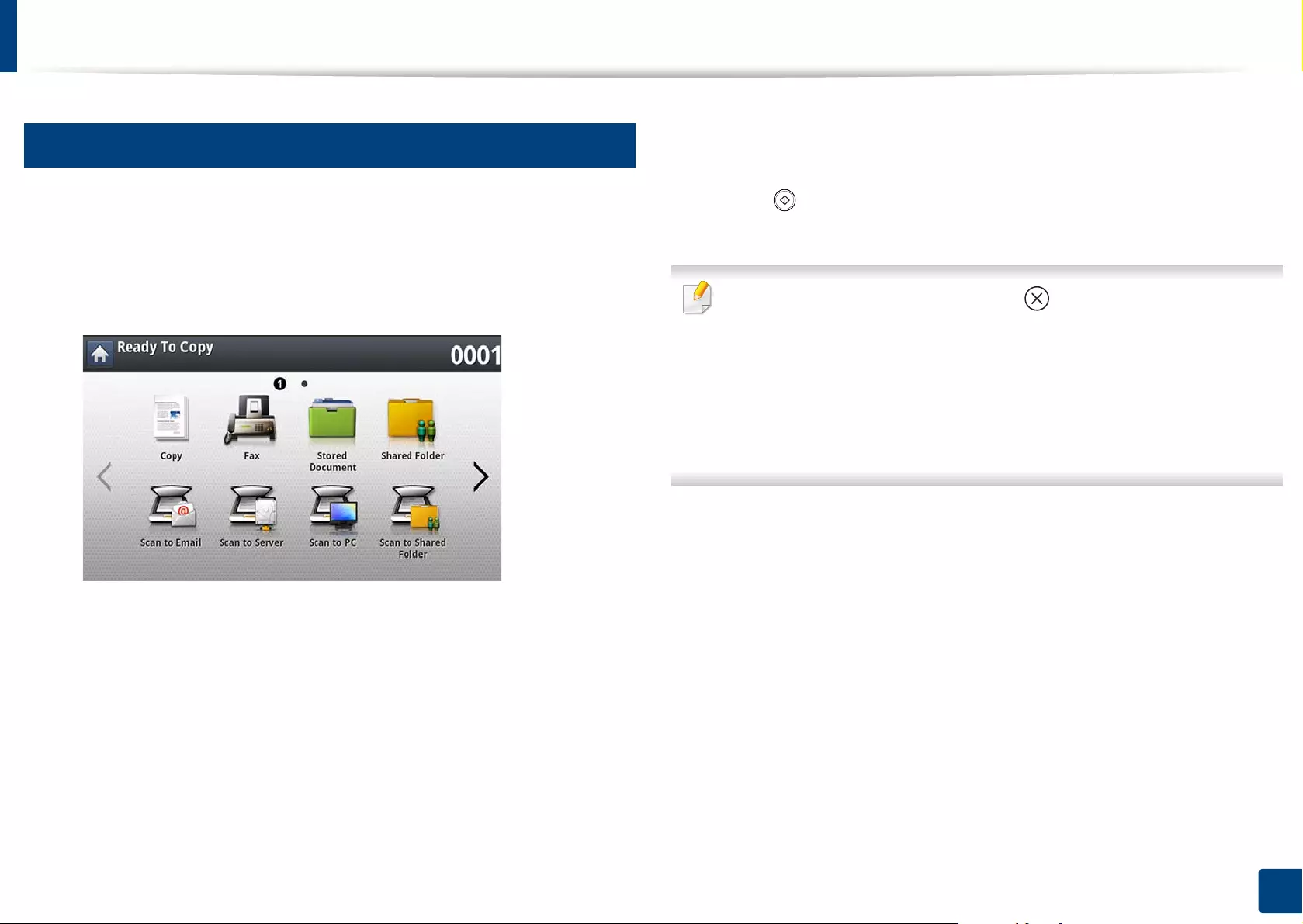
Using a programs setting
192
8. Faxing (Optional)
20
Loading Programs
1Place the originals face up in the RADF or place a single original face
down on the scanner glass and close the RADF (see "Loading originals"
on page 72).
2 Press Fax from the display screen.
3 When the cursor is blinking in the input line, enter the fax number using
the numeric keypad on the control panel, or use Address Book from the
display screen, if you have stored frequently used fax numbers.
4 Press Programs > Load.
5 Press a program name in the list that you want to use.
6 Press OK.
7 Press Yes when the confirmation window appears.
The machine is now set to fax according to the selected setting.
8 Press (Start) on the control panel. The machine starts scanning and
sending a fax to destinations.
•
When you want to cancel a fax job, press (
Stop
) on the control panel before
the machine starts transmission or press the
Job Status
button on the control
panel, and select the job you want to delete, then press
Delete
.
• If an original is placed on the scanner glass, the machine shows the
window asking if you want to place another page. Load another original
and press Yes. When you finish, press No on this window.
•
While the machine is sending a fax, you cannot send an email at the same time.
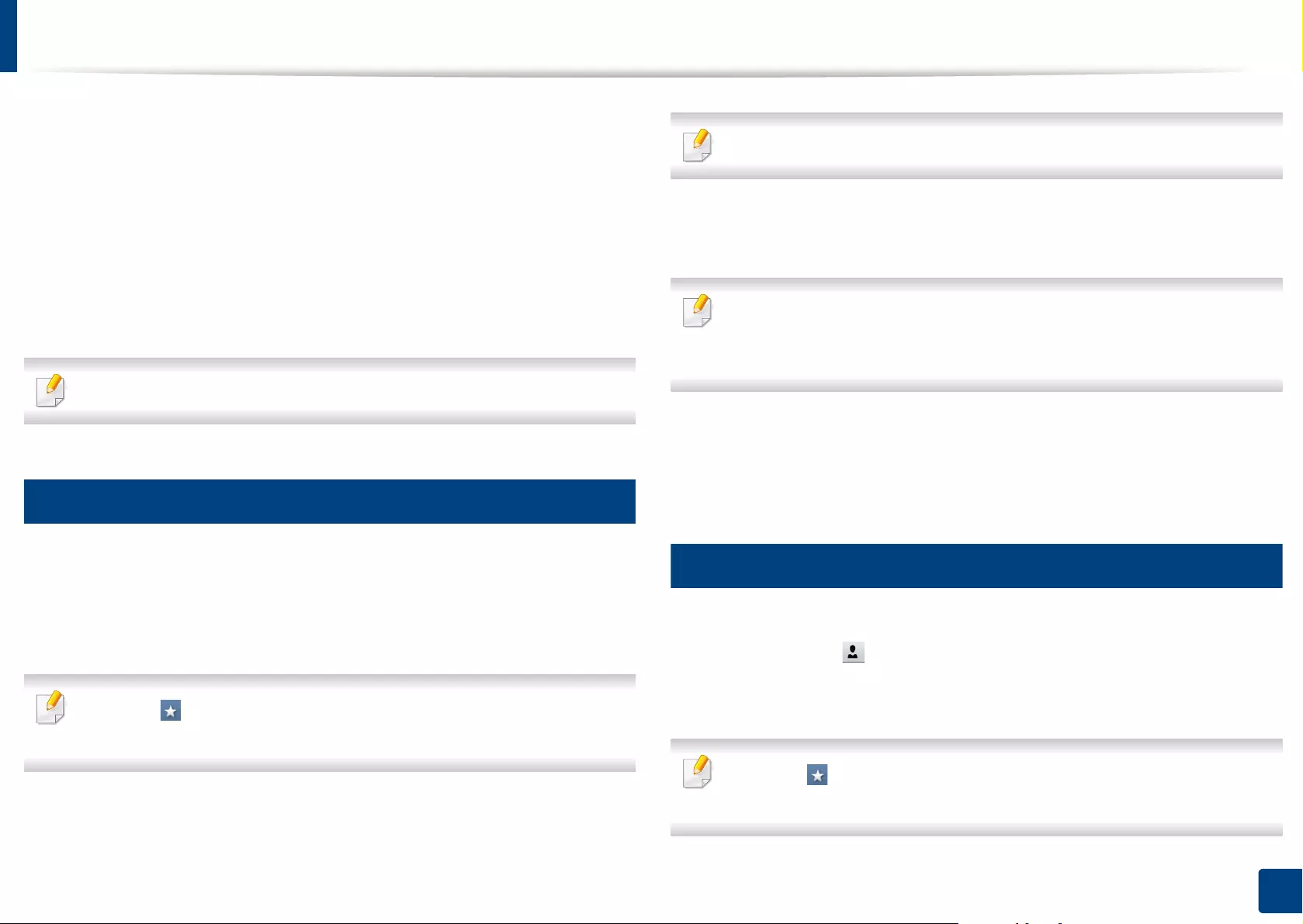
194
9. Setting up an Address Book
Setting up an
address book
from the control
panel
You can save frequently used fax numbers, email addresses, SMB server
addresses, and FTP server addresses in your machine.
•Individual: Stores up to 500 recipients’ information.
•Group: Makes groups when you frequently send the same document to
several destinations. You can register up to 500 recipients in a group. Entries
stored here will be available for selection within the sending list on the Basic
tab of Fax, Scan to Email or Scan to Server. Sending Group can be also
setup comprising of many Individual entries.
You cannot register a group as you register an individual in a group.
1
Storing Individual address (Fax, Email)
1Press Machine Setup > Application Settings > Address Book > New
from the display screen
2 Press the Name input area. Then enter the name of the recipient.
Check the (favorite) icon for addresses you often use. You can easily find
them from the search results.
3 Speed Dial No. is automatically filled with the first free number.
Speed Dial No. is the number representing a recipient’s information.
4 Press the Fax No. input area and enter the fax number using the numeric
keypad on the control panel.
Inserting a pause: with some telephone systems, you must dial an access
code (9, for example) and listen for a second dial tone. In such cases, you
must insert a pause in the telephone number.
5 Press the Email input area. Then enter the email address of the recipient.
6 Press the OK to save the information.
2
Storing Individual addresses (SMB, FTP)
1Press Machine Setup > Application Settings > Address Book > New >
SMB or FTP > (individual) icon from the display screen.
2 Press the Name input area. Then enter the name of the individual.
Check the (favorite) icon for addresses you often use. You can easily find
them from the search results.
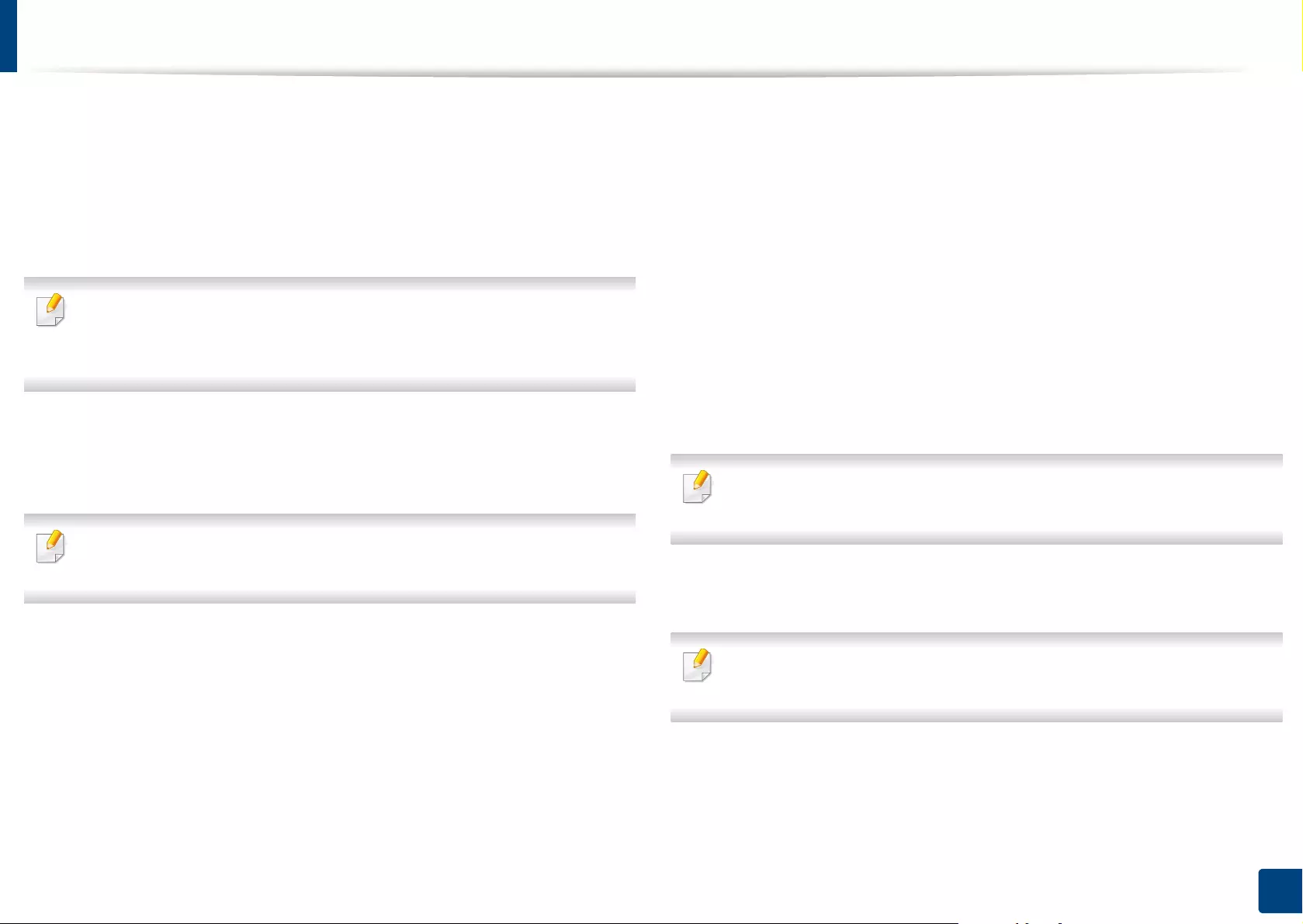
Setting up an address book from the control panel
195
9. Setting up an Address Book
3
Press
IP Address
or
Host
tab, then press the
IP Address
or
Host
input area. Then
enter the server address in dotted decimal notation or a host name.
4 Press the Port No. input area. Then enter the server port number.
5 Press the User Name input area. Then enter the user name.
In case of SMB or FTP, if you want the server to permit access for
unauthorized persons. Press the Anonymous box. This box is unchecked by
default. If you checked the Anonymous box, go to step 7.
6 Press the Password input area. Then enter the password.
7 Press the User Domain input area. Then enter the domain name.
If the SMB server you entered is not registered on any domain, leave it blank
or enter the computer name of the SMB server.
8 Press the Path input area. Then enter the name of file folder where the
sent files are to be stored.
Example: /FileFolder/
9 Press the File Name input area. Enter the name of the sent file.
10 Select the Filing Policy option you want using the arrow. If the server
has a file with the same name already, the file will get processed by
following the file policy you selected.
•Change Name: The sent file is saved as a different file name that is
automatically generated.
•Cancel: Does not save the sent file.
•Overwrite: The sent file overwrites the existing file.
11 Select the Folder Creation option you want.
•Use Login Name: If you select this option the machine creates a sub-
folder in the file folder you selected. The sub-folder is named using
the user name entered in step 5.
If the file folder has a sub-folder with the same name already, the machine
does not create a sub-folder.
•Folder Creation Cycle: You can set the cycle of sub-folder creation.
The machine create a sub-folder according to this option set.
If the file folder has a sub-folder with the same name already, the machine
does not creates a sub-folder.
-Every Day: A sub-folder is created every day. The sub-folder
name format is YYYY-MM-DD (e.g. 2015-01-01).
-Every Month: A sub-folder is created every month. The sub-
folder name format is YYYY-MM (e.g. 2015-01).
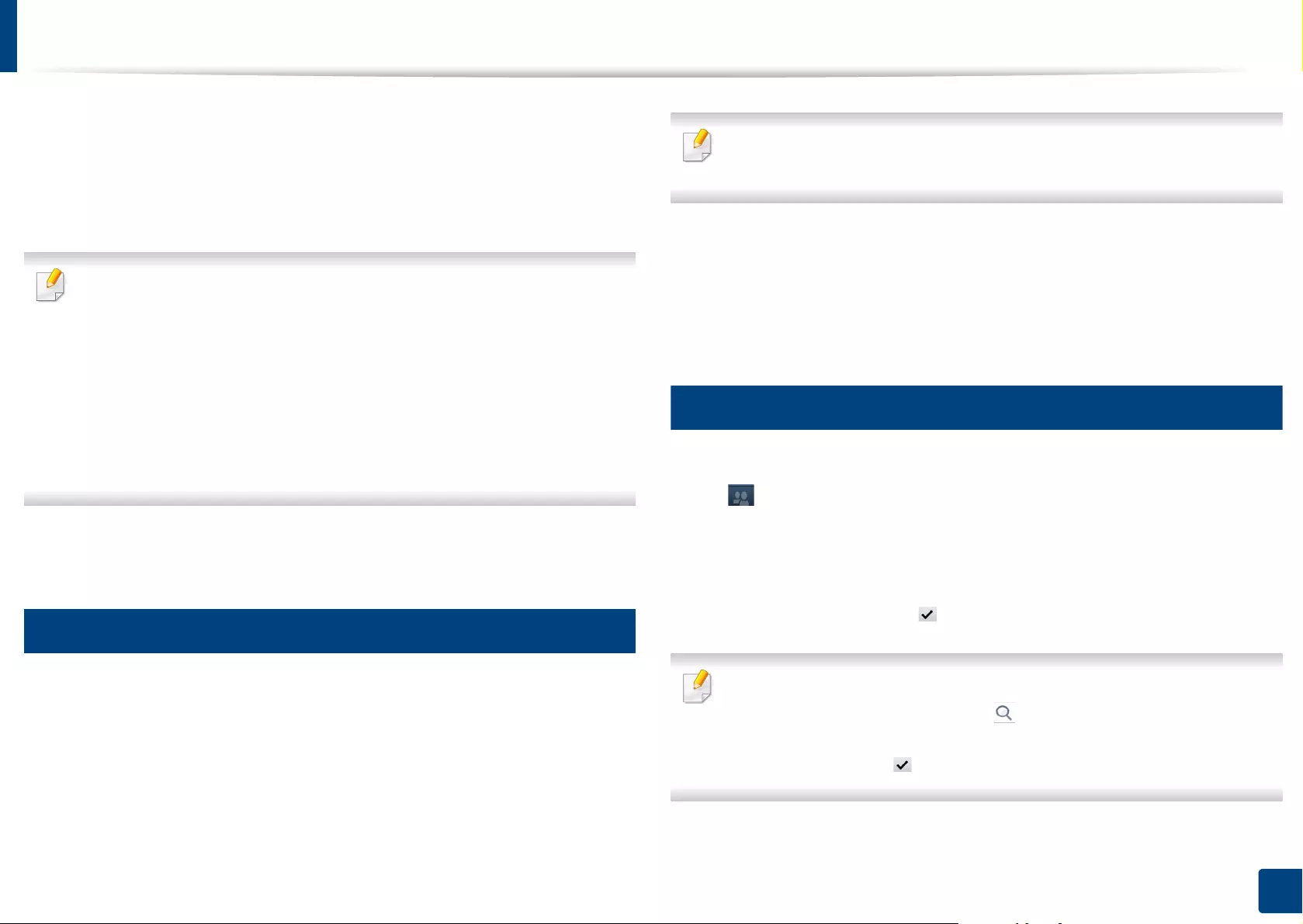
Setting up an address book from the control panel
196
9. Setting up an Address Book
-Every Year: A sub-folder is created every year. The sub-folder
name format is YYYY (e.g. 2015).
•Create Folder For Multiple Files: If you select this option and
scanned multiple files, the machine creates a sub-folder in the file
folder you selected, and the sent files will be stored in the sub-folder.
If all folder creation options are enabled at the same time, the sent file(s) will
be stored as shown below.
• When a single scanned file is sent:
\\folder\user name\2015-01-01\DOC.jpg
• When multiple scanned files are sent:
\\folder\user name\2015-01-01\DOCJPEG\DOC000.jpg
\\folder\user name\2015-01-01\DOCJPEG\DOC001.jpg
\\folder\user name\2015-01-01\DOCJPEG\DOC002.jpg
12 Press OK to save the information.
3
Editing individual address
1Press Machine Setup > Application Settings > Address Book from the
display screen.
2 Press the name of the individual you want to edit. Press Edit.
If you want to delete an individual address, select the checkbox for the
address you want to delete and press Delete.
3 Press the input area you want to change. Then change the contents
using the pop-up keyboard, or numeric keypad on the control panel. If
you use the pop-up keyboard.
4 Press the OK to save the information.
4
Storing group address
1Press Machine Setup > Application Settings > Address Book > New >
(group) icon from the display screen.
2 Press the Group Name input area. Then enter the group name.
3 Press the Add Member. Select the checkbox for the individual address
to include and press the icon.
If you are not sure of the name, you can use the Input Address area. Enter
the first few letters or just press the (search) icon. The machine shows
the individual list. Select the checkbox you want include an individual
address and press the icon.
4 Press OK to save the information.
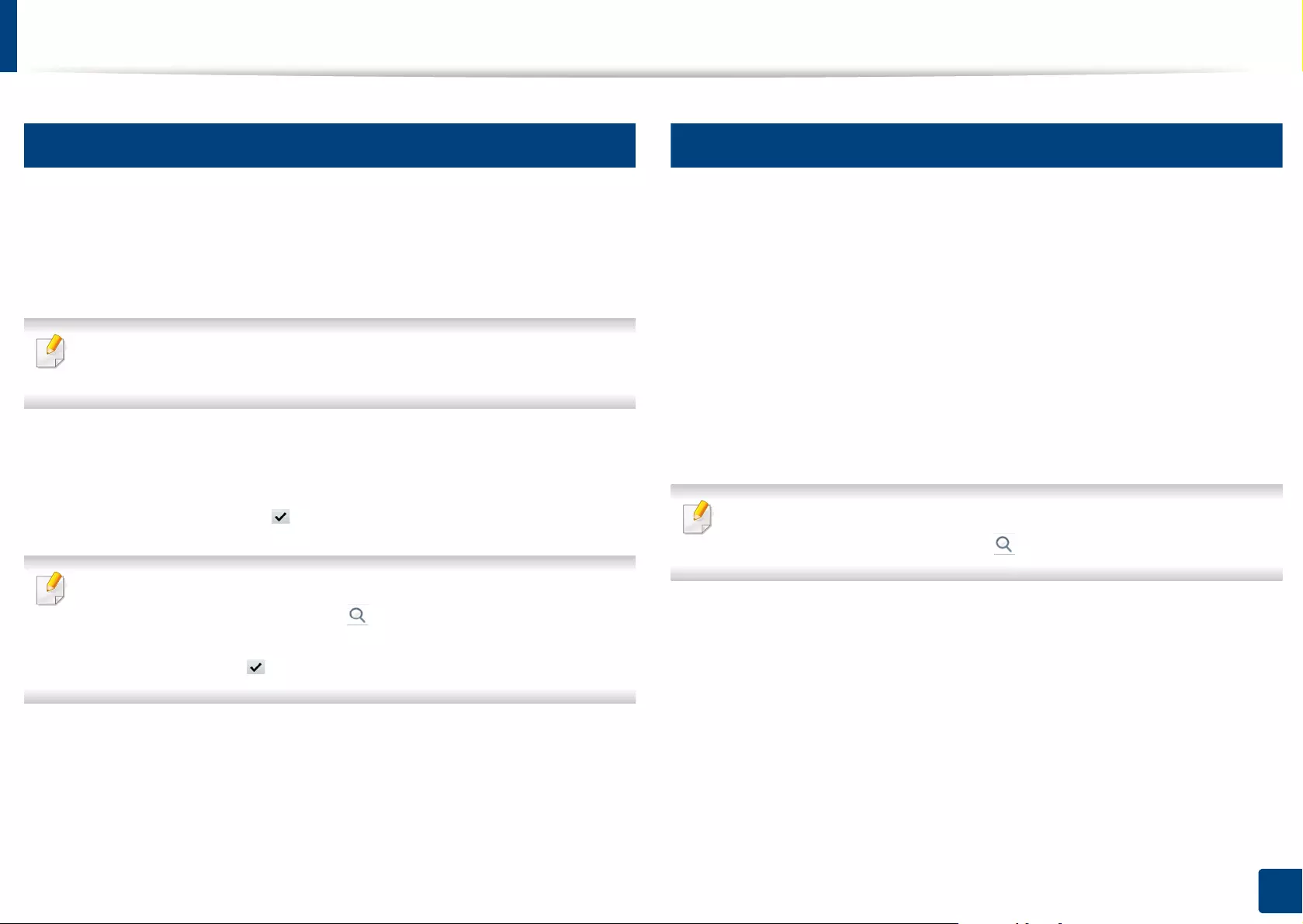
Setting up an address book from the control panel
197
9. Setting up an Address Book
5
Editing group address
1Press Machine Setup > Application Settings > Address Book from the
display screen.
2 Press the name of group you want to edit. Press Edit.
If you want to delete an group address, select the checkbox you want to
delete and press Delete.
3 Press the Group Name input area. Change the group name.
4 Press the Add Member. Select the checkbox for the individual address
to include and press the icon.
If you are not sure of the name, you can use the Input Address area. Enter
the first few letters or just press the (search) icon. The machine shows
the individual list. Select the checkbox you want include an individual
address and press the icon.
5 If you want to delete an individual address, select the checkbox you want
to delete and press Delete. The name of the individual will be deleted
from the group.
6 Press OK to save the information.
6
Searching the address book for an entry
You can search the addresses that are currently stored in the address book.
1Press Machine Setup > Application Settings > Address Book > All
from the display screen.
2 Press the specific category you want.
You can find addresses in a specific category such as All, Individual,
Group.
3 The machine shows the search results.
If you are not sure of the name, you can use the Input Address area. Enter
the first few letters or just press the (search) icon.
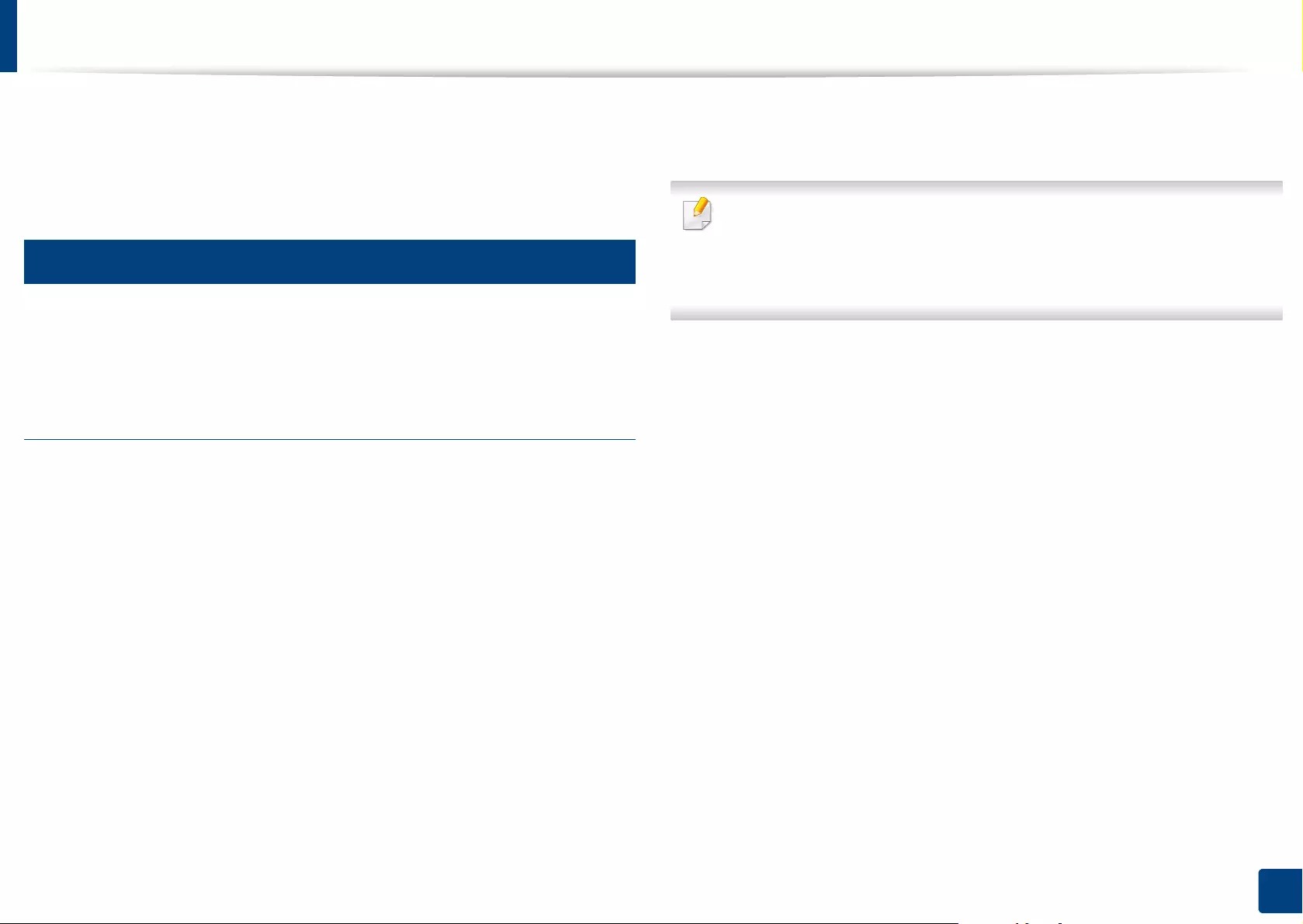
198
9. Setting up an Address Book
Setting up an address book from SyncThru™ Web Service
You can store addresses conveniently from a networked computer using
SyncThru™ Web Service. Only users registered in the machine can store
addresses through login SyncThru™ Web Service.
7
Storing on your local machine
This method means that you store addresses on your machine’s hard drive. You
can add addresses, as well as group them in particular categories.
Adding addresses in Individual Address Book
1Turn your networked computer on and open the web browser.
2 Enter your machine’s IP address as the URL in a browser.
(Example, http://123.123.123.123)
3 Press Enter or click Go to access the SyncThru™ Web Service shows.
4 Click Login.
5 Enter your ID and password to log in to the machine.
6 Click Address Book > Individual.
7 Click Add.
8 Enter the name to be added, and select the speed dial number in
General.
•Speed No. is the number representing a recipient’s information, you can
use the numeric keypad on the control panel.
• Check Favorite for addresses you often use. You can easily find them
from the search results.
9 Enter the email address in E-mail.
10 Enter the fax number in Fax.
11 Check the enable SMB box in Add SMB. You can enter the SMB
information after checking this checkbox.
12 Enter the server address in decimal notation or a host name in SMB
Server Address.
13 Enter the server port number in SMB Server Port.
14 Enter the login name in Login Type.
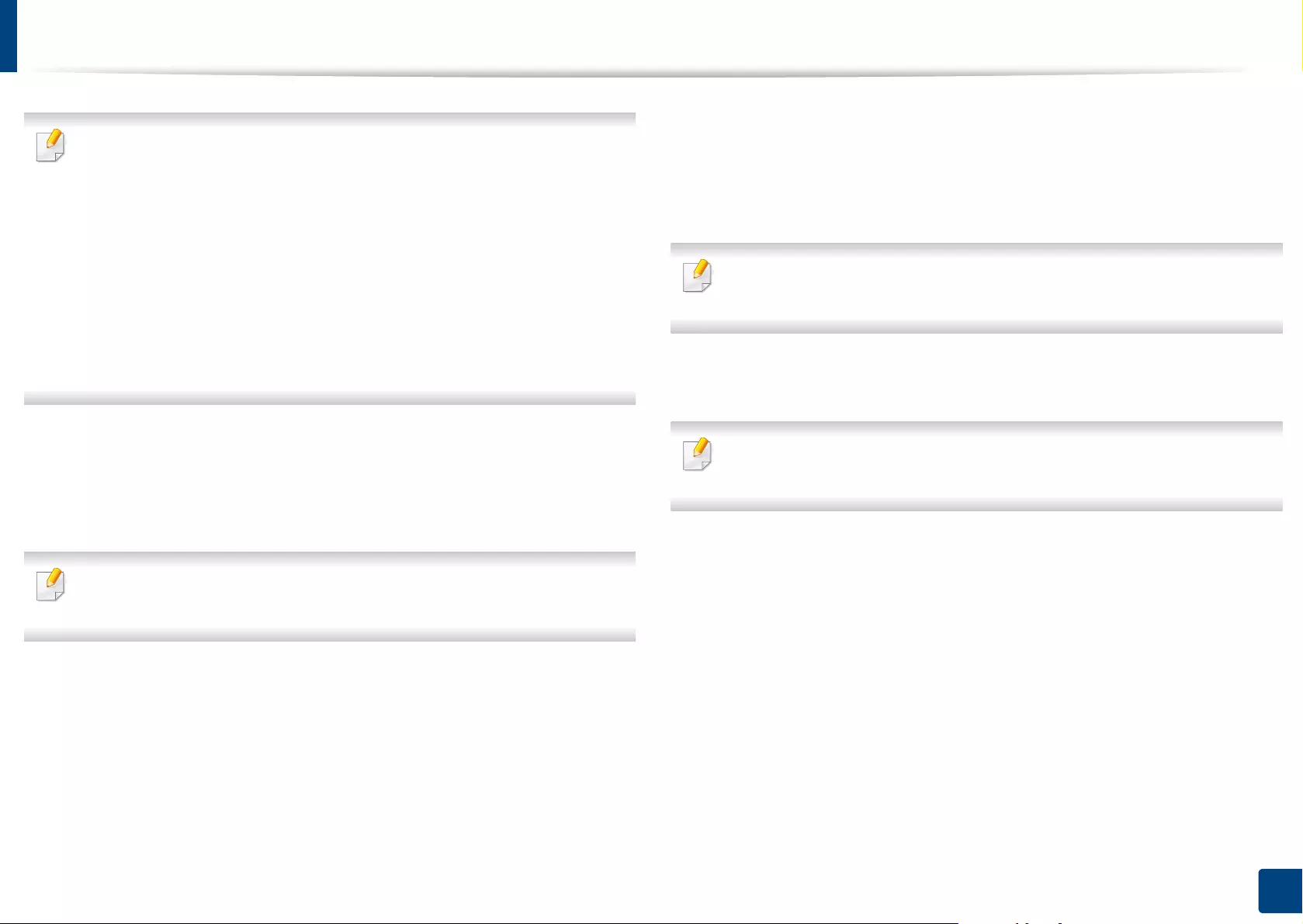
Setting up an address book from SyncThru™ Web Service
199
9. Setting up an Address Book
Select one of the following login methods:
•Auto Login: Allows you to save your ID and password in the Address
Book.
•Anonymous: In case of SMB or FTP, if you want the server to permit
access for unauthorized persons. Press the Anonymous. This box is
unchecked by default. If you checked the Anonymous box, go to step
18.
•Login Prompt: Opens a login prompt every time that you attempt to
access the server. You must enter your login information on the control
panel to access the server. This is the default setting.
15 Enter the login and password, and re-enter the password in Confirm
Password.
16 Enter the domain name in Domain.
If the SMB server you entered is not registered on any domain, leave it blank
or enter the computer name of the SMB server.
17 Enter the scan file folder for storing scanned images in Path.
Example: sharedFolder
18 Select the Scan folder creating policy option you want.
•Create new folder using login name: If you select this option, the
machine creates a sub-folder in the file folder you selected. The sub-
folder is named using the user name you entered in step 15.
If the file folder has a sub-folder with the same name already, the machine
does not create a sub-folder.
•
Create New Folder:
You can set the cycle of sub-folder creation. The
machine creates a sub-folder according to this option set.
If the file folder has a sub-folder with the same name already, the machine
does not create a sub-folder.
-Every Day: A sub-folder is created every day. The sub-folder
name format is YYYY-MM-DD (e.g. 2015-01-01).
-Every Month: A sub-folder is created every month. The sub-
folder name format is YYYY-MM (e.g. 2015-01).
-Every Year: A sub-folder is created every year. The sub-folder
name format is YYYY (e.g. 2015).
•Create new folder only if scan output consist of several files: If
you select this option and scanned multiple files, the machine
creates a sub-folder in the file folder you selected, and the sent files
will be stored in the sub-folder.
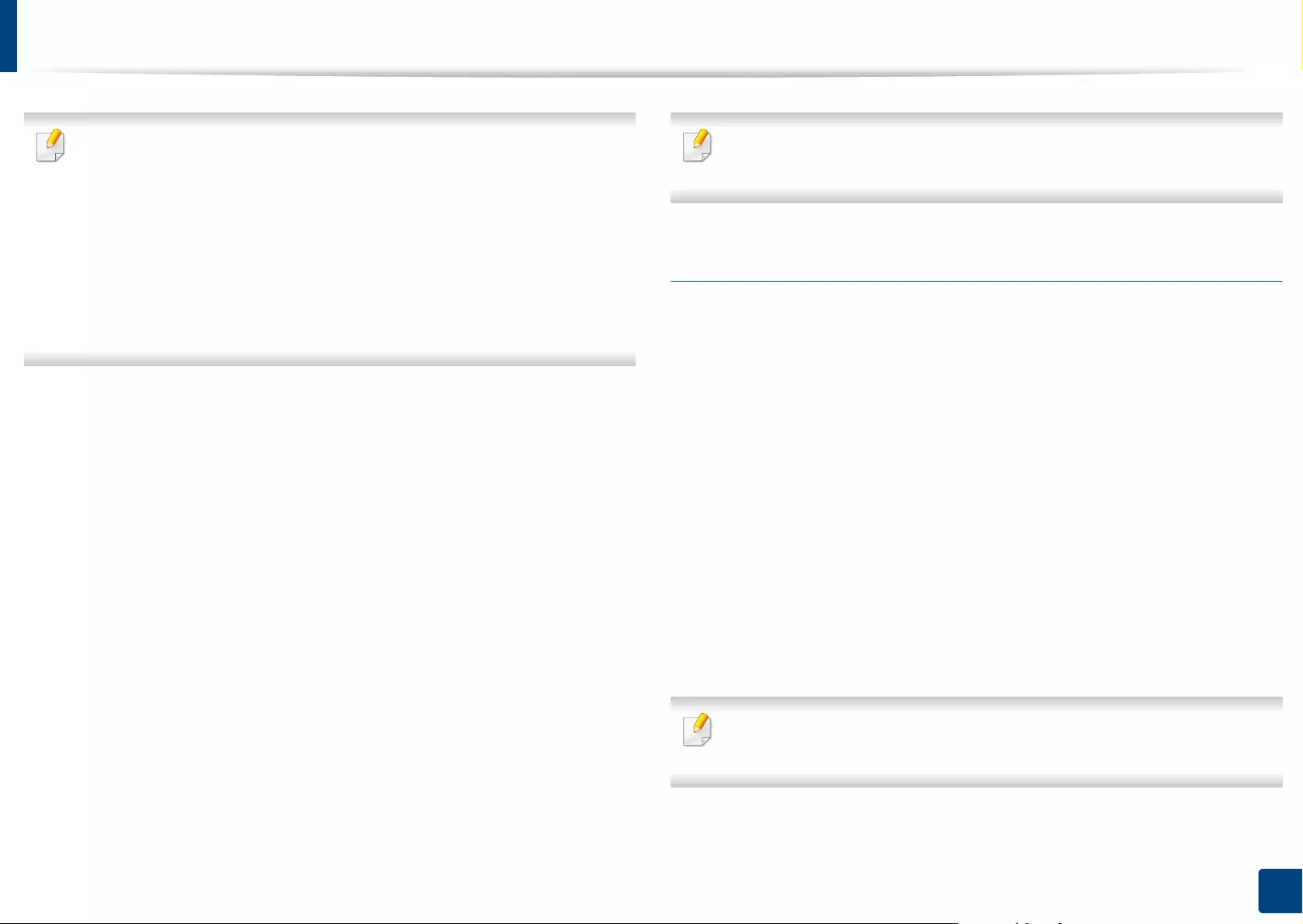
Setting up an address book from SyncThru™ Web Service
200
9. Setting up an Address Book
If all folder creation options are enabled at the same time, the sent file(s) will
be stored as below.
• When single scanned file is sent:
\\folder\user name\2015-01-01\DOC.jpg
• When multiple scanned files are sent:
\\folder\user name\2015-01-01\DOCJPEG\DOC000.jpg
\\folder\user name\2015-01-01\DOCJPEG\DOC001.jpg
\\folder\user name\2015-01-01\DOCJPEG\DOC002.jpg
19 Select the policy for generating file name in Filing Policy. If the server
has a file with the same file name already, the file will get processed by
following the file policy you selected.
•Change Name: The sent file is saved as a different file name that is
automatically generated.
•Cancel: Does not save the sent file.
•Overwrite: The sent file overwrites the existing file.
20 Enter the file name in File Name, which is to be stored in the server.
21 Click Test to check the server’s information.
22 Enter FTP server information almost same as you do for SMB.
23 Click Apply.
Press Undo to delete the information you entered. If you press Cancel, the
Add window is closed.
Editing addresses in an Individual Address Book
1Turn your networked computer on and open a web browser.
2 Enter your machine’s IP address as the URL in a browser.
(Example, http://123.123.123.123)
3 Press Enter or click Go to access SyncThru™ Web Service.
4 Click Login.
5 Enter your ID and password to log in to the machine.
6 Click Address Book > Individual.
7 Check an address you want to edit and press Edit.
8 Change the address information.
9 Click Apply.
Press Undo to delete the information you entered. If you press Cancel, the
Edit window is closed.
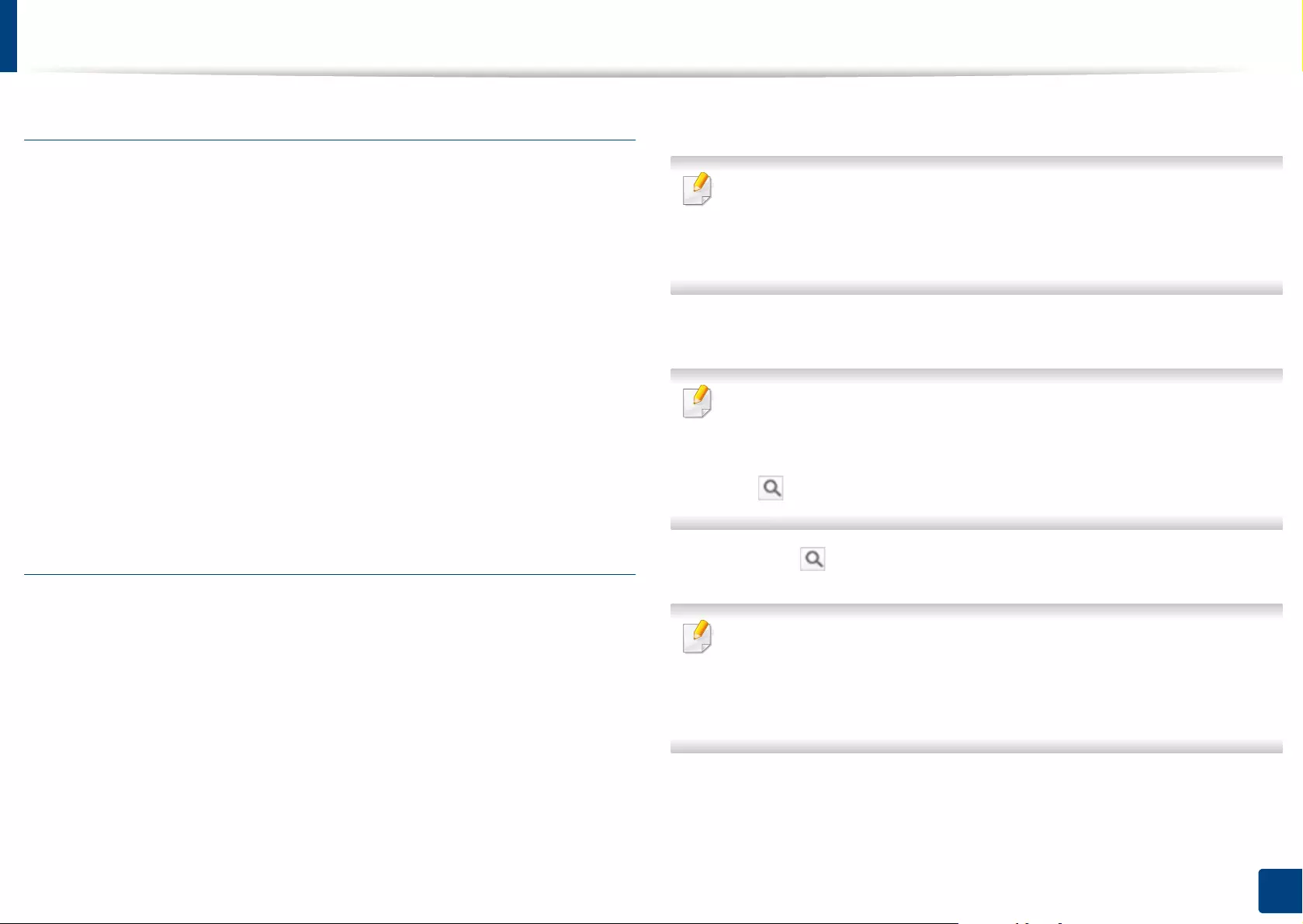
Setting up an address book from SyncThru™ Web Service
201
9. Setting up an Address Book
Deleting addresses in an Individual Address Book
1Turn your networked computer on and open a web browser.
2 Enter your machine’s IP address as the URL in a browser.
(Example, http://123.123.123.123)
3 Press Enter or click Go to access SyncThru™ Web Service.
4 Click Login.
5 Enter your ID and password to log in to the machine.
6 Click Address Book > Individual.
7 Check an address you want to delete and click Delete.
If you select the column headers’ checkbox, all addresses are checked.
Click Yes when the confirmation window appears.
Searching addresses in an Individual Address Book
1Turn your networked computer on and open the web browser.
2 Enter your machine’s IP address as the URL in a browser.
(Example, http://123.123.123.123)
3 Press Enter or click Go to access SyncThru™ Web Service.
4 Click Login.
5 Enter your ID and password to log in to the machine.
6 Click Address Book > Individual.
You can change the arrangement by clicking each column header. For
example, clicking Speed No., you can see the addresses in the order of
speed dial number. If you click Speed No. again, you can see them in the
reversed order.
7 Enter the name for which you want to search in the search input area.
You can find addresses in a specific category such as Fax Number, E-mail,
SMB, etc.
For example, if you want to find the fax number, click drop down list next to
the and select Fax Number.
8 Click the . Then the search result appears.
You can find addresses in a specific category such as Fax Number, E-mail,
SMB, etc.
For example, if you want to see the addresses which are included fax
number, click drop down list below LDAP and select Fax Number.
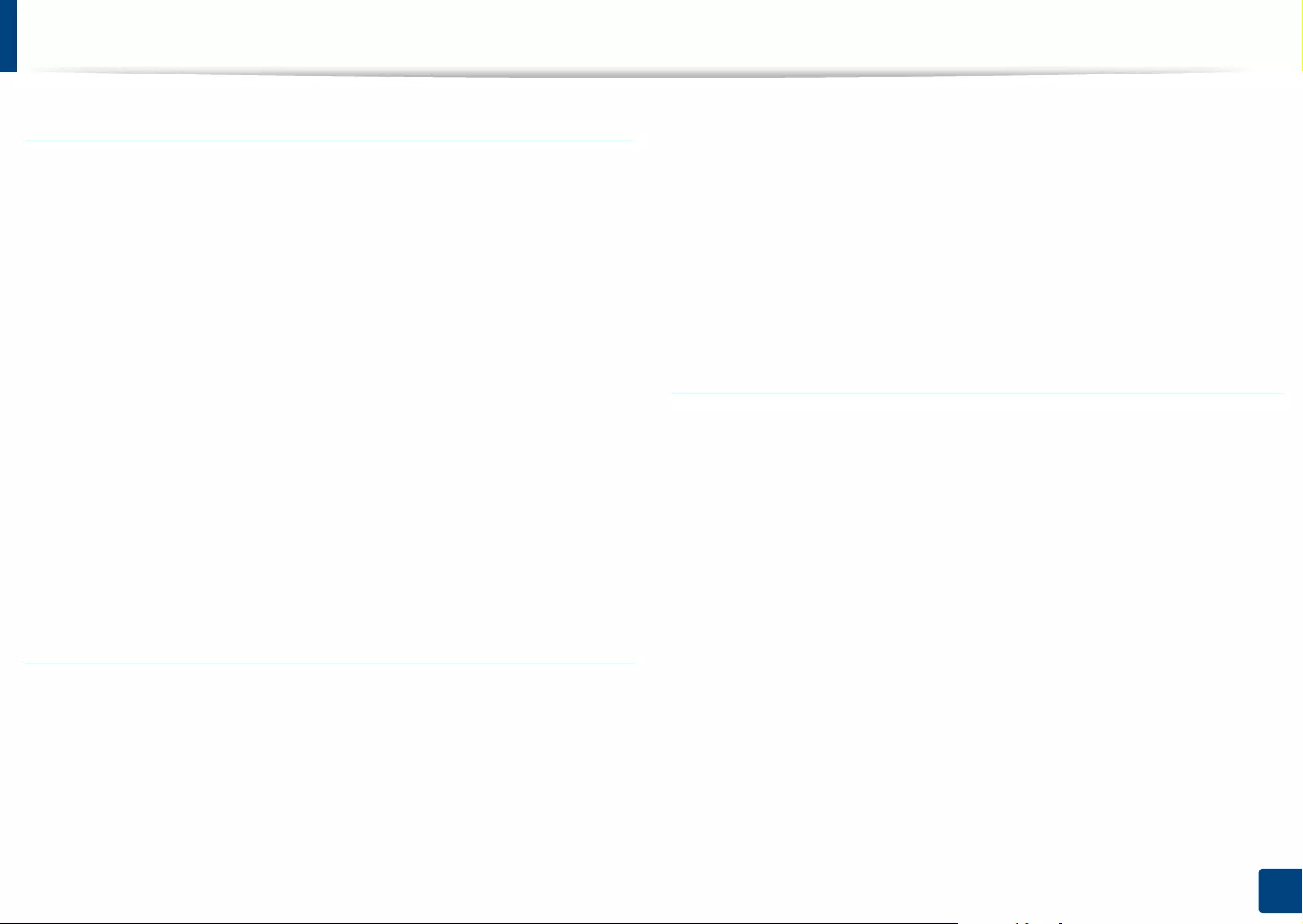
Setting up an address book from SyncThru™ Web Service
202
9. Setting up an Address Book
Importing an Individual Address Book
You can import an address book file from a server or computer. The file should
have the file extension ‘csv’. Also you can import addresses from a LDAP server.
Before importing the addresses to your machine, an LDAP server administrator
should store the addresses.
1Turn your networked computer on and open a web browser.
2 Enter your machine’s IP address as the URL in a browser.
(Example, http://123.123.123.123)
3 Press Enter or click Go to access the SyncThru™ Web Service shows.
4 Click Login.
5 Enter your ID and password to log in to the machine.
6 Click Address Book > Individual.
7 Select Import from the Task drop down list.
8 Select folder name where the file is stored.
9 Click Import > OK.
Exporting an Individual Address Book
You can export an address book file to your computer for backup of the file or to
another Samsung machine.
1Turn your networked computer on and open a web browser.
2 Enter your machine’s IP address as the URL in a browser.
(Example, http://123.123.123.123)
3 Press Enter or click Go to access SyncThru™ Web Service.
4 Click Login.
5 Enter your ID and password to log in to the machine.
6 Click Address Book > Individual.
7 Select Export from the Task drop down list.
8 Click Export. Then the address book file is stored in your computer.
Grouping addresses in Groups Address Book
1Turn your networked computer on and open a web browser.
2 Enter your machine’s IP address as the URL in a browser.
(Example, http://123.123.123.123)
3 Press Enter or click Go to access SyncThru™ Web Service.
4 Click Login.
5 Enter your ID and password to log in to the machine.
6 Click Address Book > Group.
7 Click Add Group.
8 Enter the group name to be added in Group Name.
9 Check Add individual(s) after this group is created.
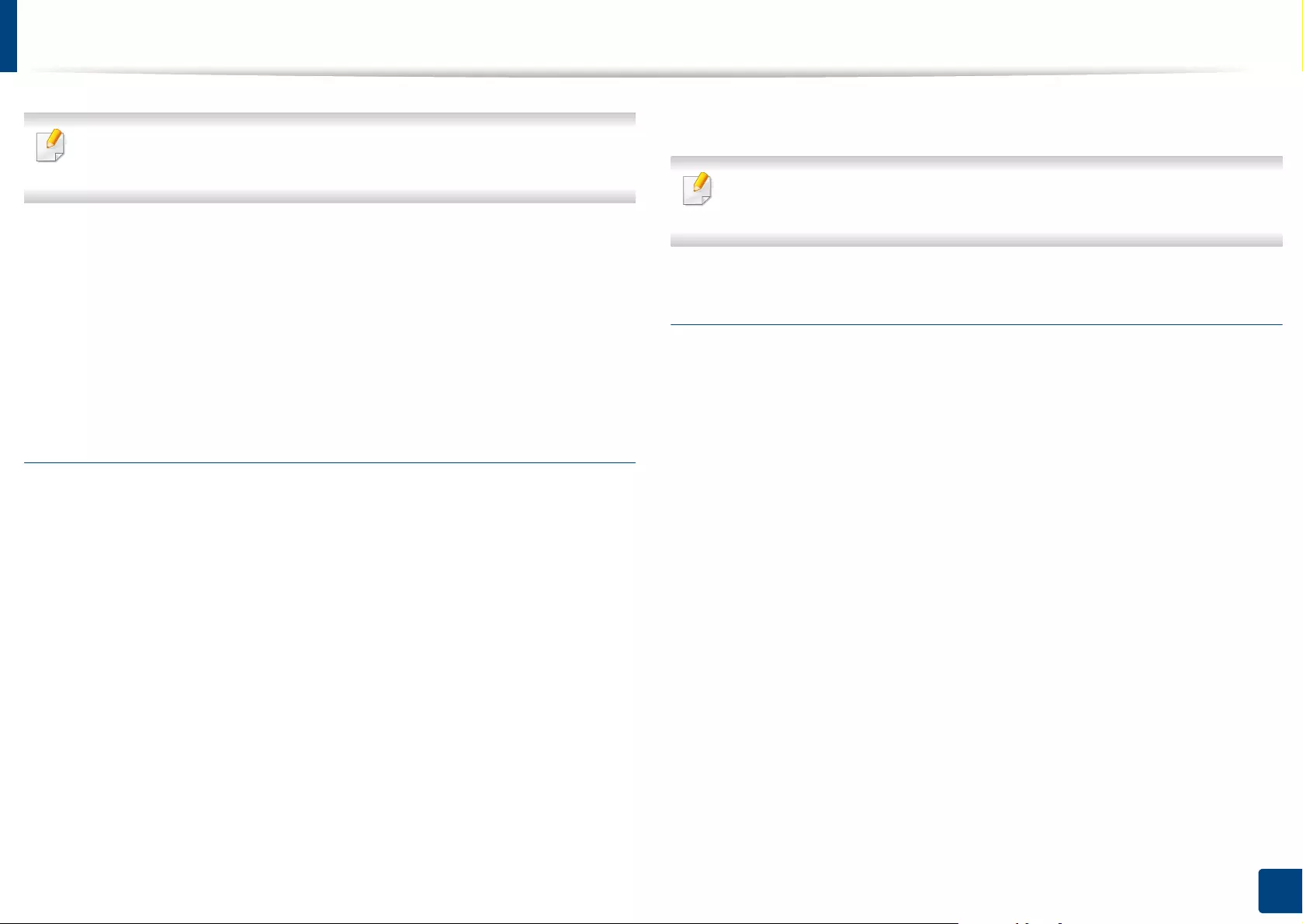
Setting up an address book from SyncThru™ Web Service
203
9. Setting up an Address Book
If you do not want to add individual addresses to the group address you made, skip
this step. You can add individual addresses next time by pressing
Group Details
.
10 Click Apply.
11 Check the addresses you want to add to Group Address Book from
Individual Address Book.
12 Click the arrow in the middle. The selected addresses are added to
Group Address Book.
13 Click Apply.
Editing Group addresses in Groups Address Book
1Turn your networked computer on and open a web browser.
2 Enter your machine’s IP address as the URL in a browser.
(Example, http://123.123.123.123)
3 Press Enter or click Go to access the SyncThru™ Web Service shows.
4 Click Login.
5 Enter your ID and password to log in to the machine.
6 Click Address Book > Group.
7 Check the group address you want to edit and press Edit Group.
8 Change the group address information.
9 Click Apply.
Press Undo to delete the information you entered. If you press Cancel, the
Edit window closes.
Deleting Group addresses in a Groups Address Book
1Turn your networked computer on and open a web browser.
2 Enter your machine’s IP address as the URL in a browser.
(Example, http://123.123.123.123)
3 Press Enter or click Go to access SyncThru™ Web Service.
4 Click Login.
5 Enter your ID and password to log in to the machine.
6 Click Address Book > Group.
7 Check the group addresses you want to delete.
8 Click Delete Group.
Click OK when the confirmation window appears.
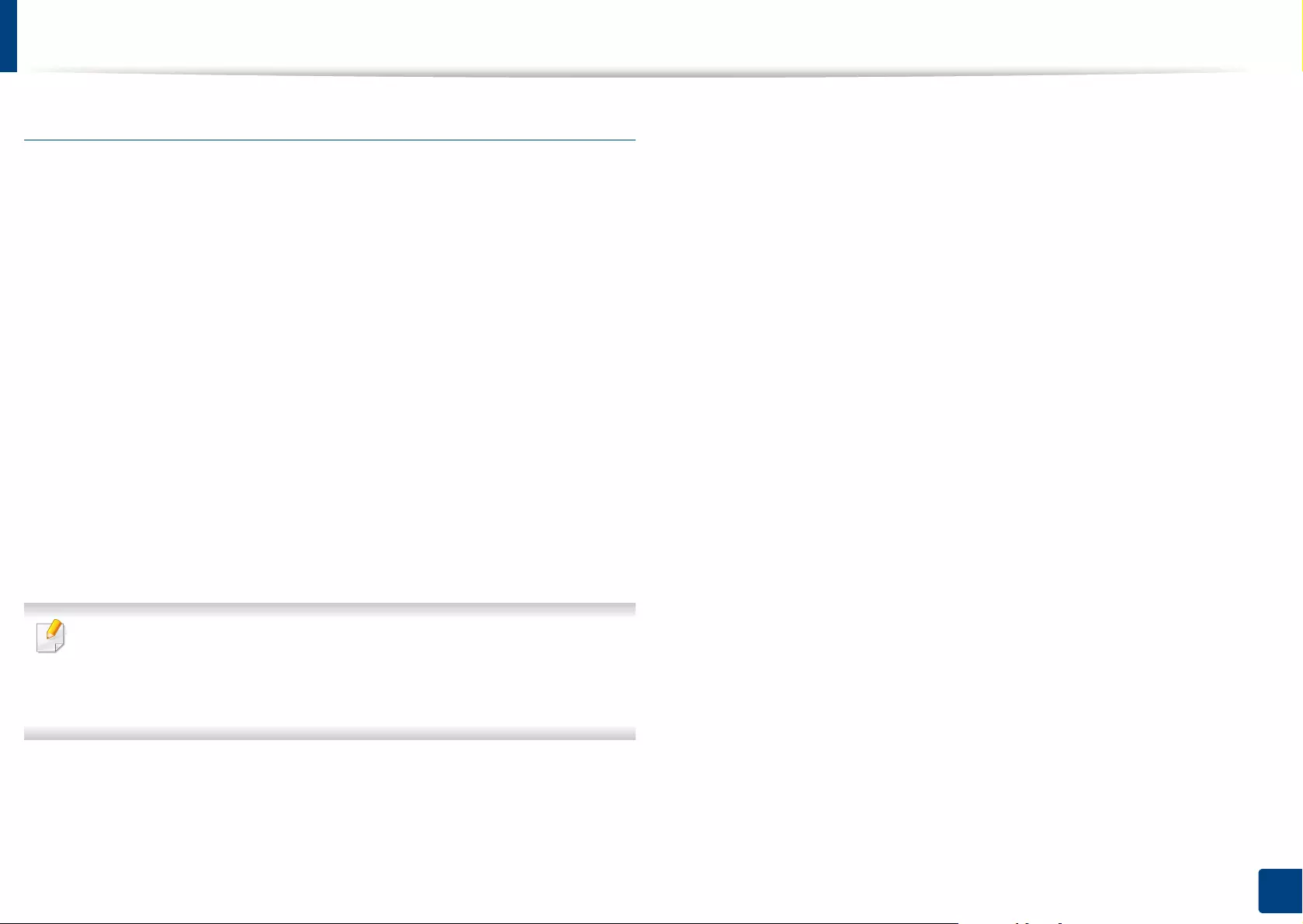
Setting up an address book from SyncThru™ Web Service
204
9. Setting up an Address Book
Checking Group Addresses
You can see information for group addresses. You can also add or delete
individual addresses in the Group Details window.
1Turn your networked computer on and open a web browser.
2 Enter your machine’s IP address as the URL in a browser.
(Example, http://123.123.123.123)
3 Press Enter or click Go to access SyncThru™ Web Service.
4 Click Login.
5 Enter your ID and password to log in to the machine.
6 Click Address Book > Group.
7 Press the group address you want to see.
• You can add individual addresses directly. Check the addresses you want
to add to Group Address Book from Individual Address Book.
• You can delete individual addresses directly. Check the addresses you
want to delete and press Delete in Group Address Book.
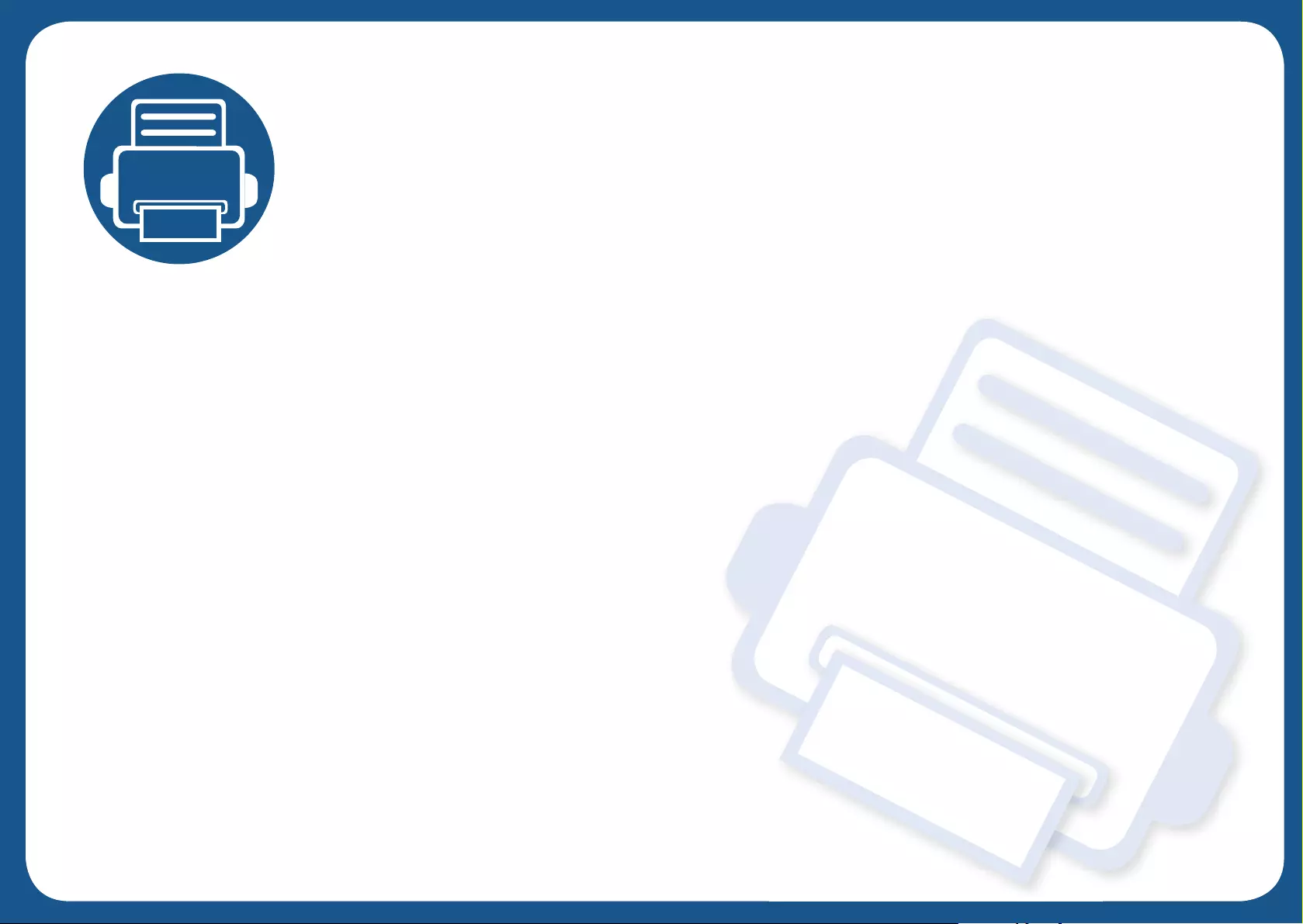
10.Using the Machine via
Mobile Device
This chapter gives you step-by-step instructions for setting up the mobile device before using the machine. Check that
Wi-Fi enabled features are on your mobile device and Wi-Fi feature is enabled on your printer ("Using a Network-
Connected Machine" on page 41).
This chapter includes:
• Using the NFC feature (Optional) 206
• Supported Mobile Apps 216
• Mopria™ 217
• AirPrint 219
• Samsung Cloud Print 220
• PrinterOn 223
• Google Cloud Print™ 225
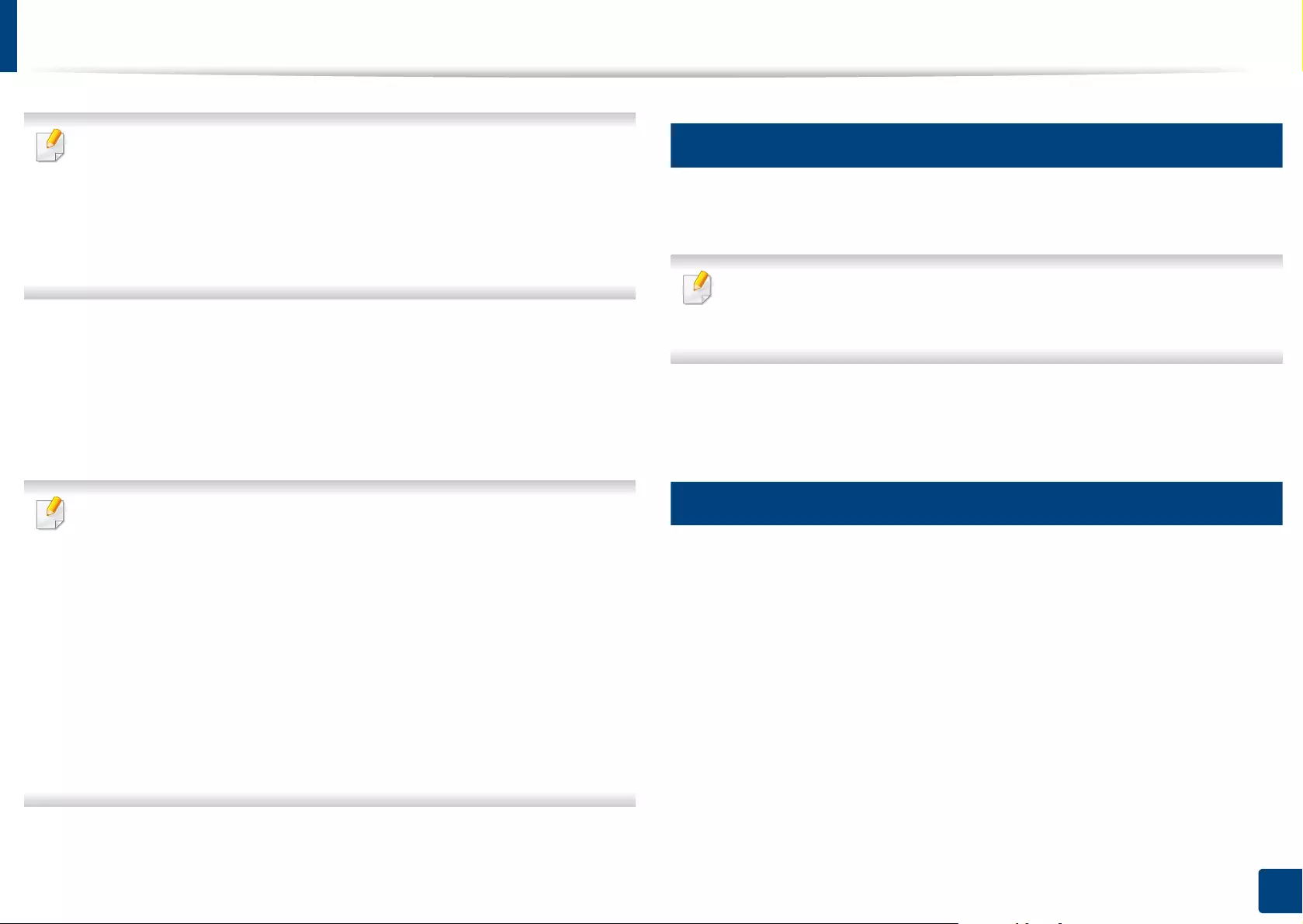
206
10. Using the Machine via Mobile Device
Using the NFC feature (Optional)
If you want to add NFC feature to the machine, check the option lists and
contact the purchasing point to order (see "Available accessories" on page
296). When you purchase a Wireless/NFC kit (Optional), install the kit by
following the steps described in the Wireless/NFC kit (Optional) Installation
Guide which is enclosed in the kit. After installing the Wireless/NFC kit
(Optional), set the machine to use this feature.
The NFC (Near Field Communication) printer allows you to directly print from your mobile
device just by holding your mobile device over the NFC tag on Wireless/NFC Kit (Wireless
LAN Option). It does not require installing print driver or connecting to an access point.
You just need NFC supported mobile device. In order to use this feature, mobile apps
needs to be installed on your mobile device.
• Depending on the material of the mobile device cover, NFC recognition
may not work properly.
• Depending on the mobile device you are using, the transmission speed
may differ.
• This feature is available only for the model with a NFC tag (see "Machine
overview" on page 20).
• Using a cover or a battery other than the ones that came with the mobile
device, or a metal cover/sticker can block NFC.
• If NFC devices keep failing to communicate,
- Remove the case or cover from the mobile device, then try again.
- Reinstall the battery from the mobile device, then try again.
1
Requirements
• NFC and Wi-Fi Direct enabled, supported mobile apps installed mobile
device with Android OS 4.0 or higher.
Only Android OS 4.1 or higher will automatically enable the Wi-Fi Direct
feature on your mobile device when you enable the NFC feature. We
recommend you to upgrade your mobile device to Android OS 4.1 or higher
to use the NFC feature.
• Wi-Fi Direct feature enabled printer (see "Setting the Wi-Fi Direct for mobile
printing" on page 68).
2
Related Apps
There are some apps that can be used with the NFC feature. The apps can be
downloaded from the Google Play Store.
•Samsung Mobile Print: Enables users to print, scan (Only users with the
machine supports scan), or fax (Only users with the machine supports fax)
photos, documents, and web pages directly from your smartphone or tablet
(see "Using the Samsung Mobile Print App" on page 212).
•Samsung Mobile Print Pro: Helps users to get an authentication easily. This
app provides one way of getting a user authentication using your mobile
device (see "Using the Samsung Mobile Print Pro App" on page 207).
•Samsung Mobile Print Manager: Enables users to use cloning and wireless
setup features using your mobile device (see "Using the Samsung Mobile
Print Manager App" on page 209).
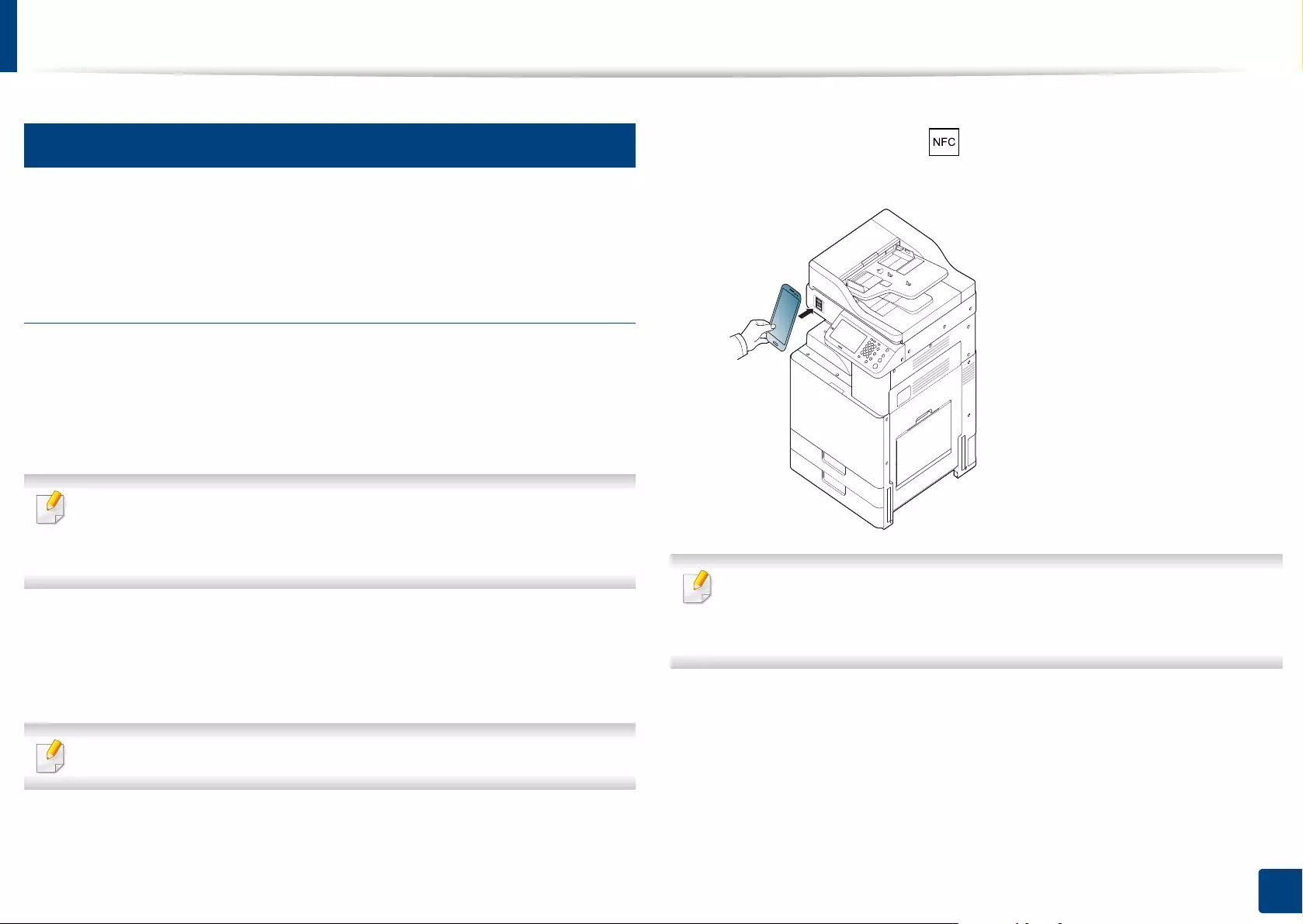
Using the NFC feature (Optional)
207
10. Using the Machine via Mobile Device
3
Using the Samsung Mobile Print Pro App
You can use it to get an authentication/registration from the Samsung Mobile
Print Pro app.
Authentication from the mobile device
1Check that NFC and Wi-Fi Direct enabled features are on your mobile
device and Wi-Fi Direct feature is enabled on your printer.
2 Open Samsung Mobile Print Pro app.
If you do not have Samsung Mobile Print Pro installed on your cellphone,
go to the application store (Samsung Apps, Play Store, App Store) on your
mobile device, and just search for download the app and try again.
3 Type in the ID and Password.
Use the same login ID, Password as when logging in from the machine
(see "Log-in" on page 243).
If you want to change the password, see "Security tab" on page 272.
4 Tag your mobile device (usually located on the back of the mobile
device) over the NFC tag ( ) on your printer.
Wait few seconds for the mobile device to connect to the printer.
For some mobile devices, NFC tag might not be located at the back of the
mobile device. Check the location of the NFC antenna on your mobile
device before tagging.
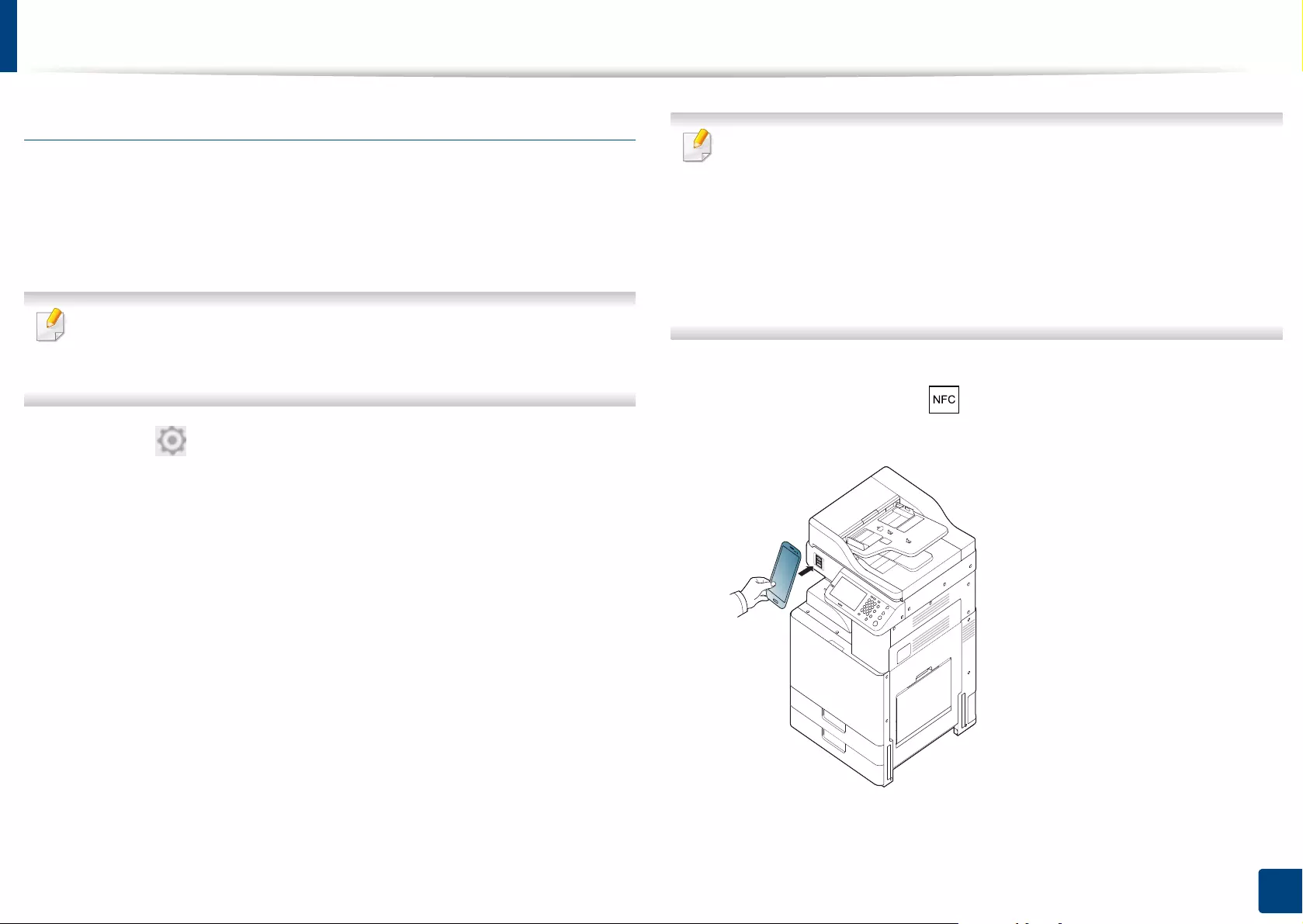
Using the NFC feature (Optional)
208
10. Using the Machine via Mobile Device
Registration from the mobile device
1Check that NFC and Wi-Fi Direct enabled features are on your mobile
device and Wi-Fi Direct feature is enabled on your printer.
2 Open Samsung Mobile Print Pro app.
If you do not have Samsung Mobile Print Pro installed on your cellphone,
go to the application store (Samsung Apps, Play Store) on your mobile
device, and just search for download the app and try again.
3 Press the icon on the Samsung Mobile Print Pro screen.
4 Select On from the Phone login set as default menu.
5 Mobile device ID appears on the Samsung Mobile Print Pro screen.
Press Registration.
6 Type in the ID, Password, Domain, and Passcode, then click OK.
Use the same admin ID, Password, Domain as when logging in from the
machine (see "Log-in" on page 243).
• If you want to change the password, see "Security tab" on page 272.
•Passcode is for when the administrator chooses Two-Factor
Authentication method. You need to enter a passcode for
authentication. Password and passcode should be different. You can
select Two-Factor Authentication from the SyncThru™ Web Service,
select Security > User Access Control > Authentication >
Authentication Method > Options button > Login Method > Two-
Factor Authentication.
7 Tag your mobile device (usually located on the back of the mobile
device) over the NFC tag ( ) on your printer.
Wait few seconds for the mobile device to connect to the printer.
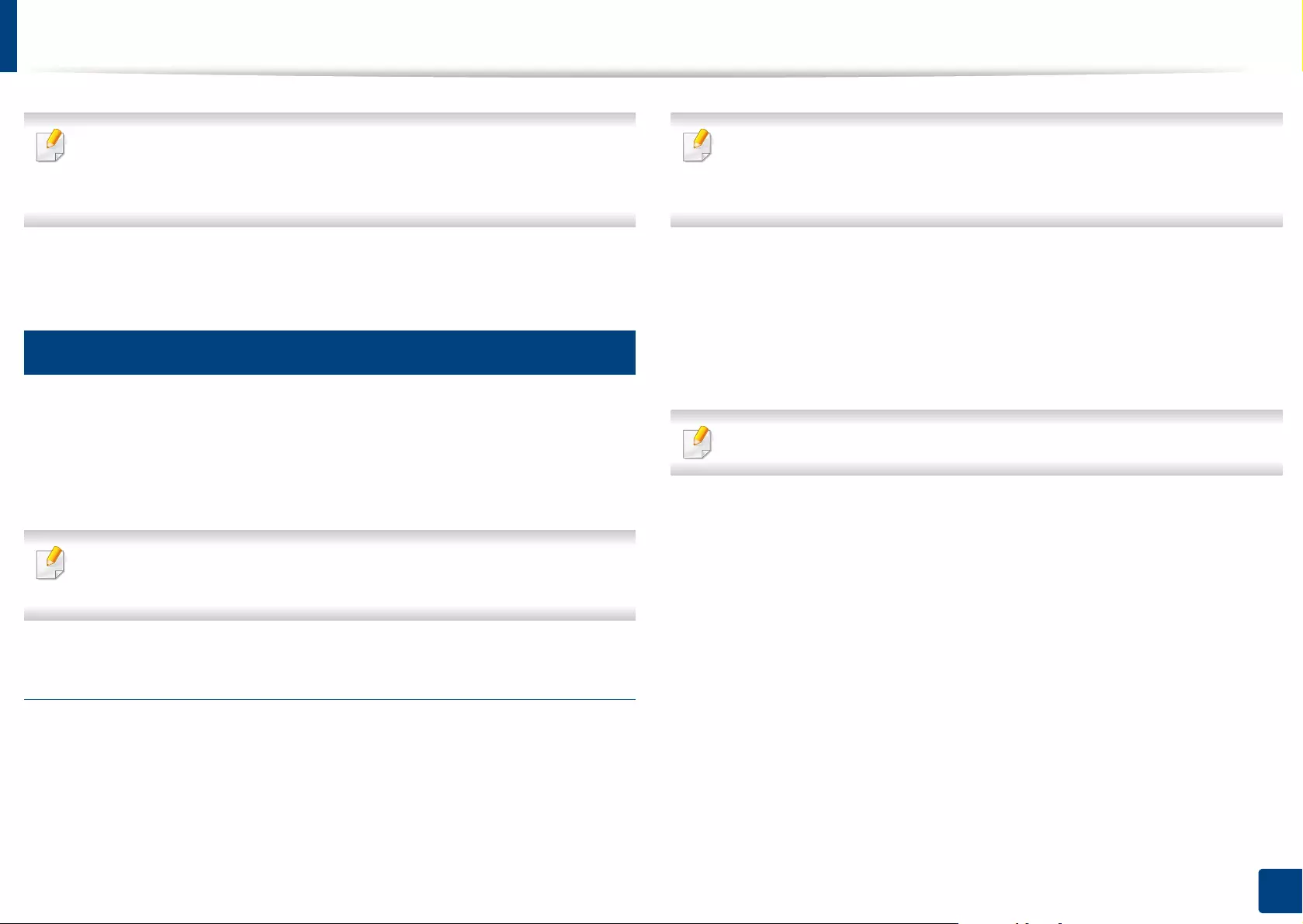
Using the NFC feature (Optional)
209
10. Using the Machine via Mobile Device
For some mobile devices, NFC tag might not be located at the back of the
mobile device. Check the location of the NFC antenna on your mobile
device before tagging.
8 Registration complete message appears on the printer’s touch screen.
4
Using the Samsung Mobile Print Manager App
If you have more than one printer and need to set the same settings on each
printer, you can easily do it using the Samsung Mobile Print Manager app.
Touch your cellphone on the NFC tag on your printer to copy the settings and
tap on the printer you want to set the setting.
When exporting the data, you can save more than one data. When
importing the data, you can select the data from the list and import.
Exporting(Copying the setting to your mobile device)
1Check that NFC and Wi-Fi Direct enabled features are on your mobile
device and Wi-Fi Direct feature is enabled on your printer.
2 Open Samsung Mobile Print Manager from your mobile device.
If you do not have Samsung Mobile Print Manager installed on your
cellphone, go to the application store (Samsung Apps, Play Store) on your
mobile device, and just search for download the app and try again.
3 Press Export.
4 Type in the ID and Password.
Use the same login ID, Password as when logging in from the machine
(see "Log-in" on page 243).
If you want to change the password, see "Security tab" on page 272.
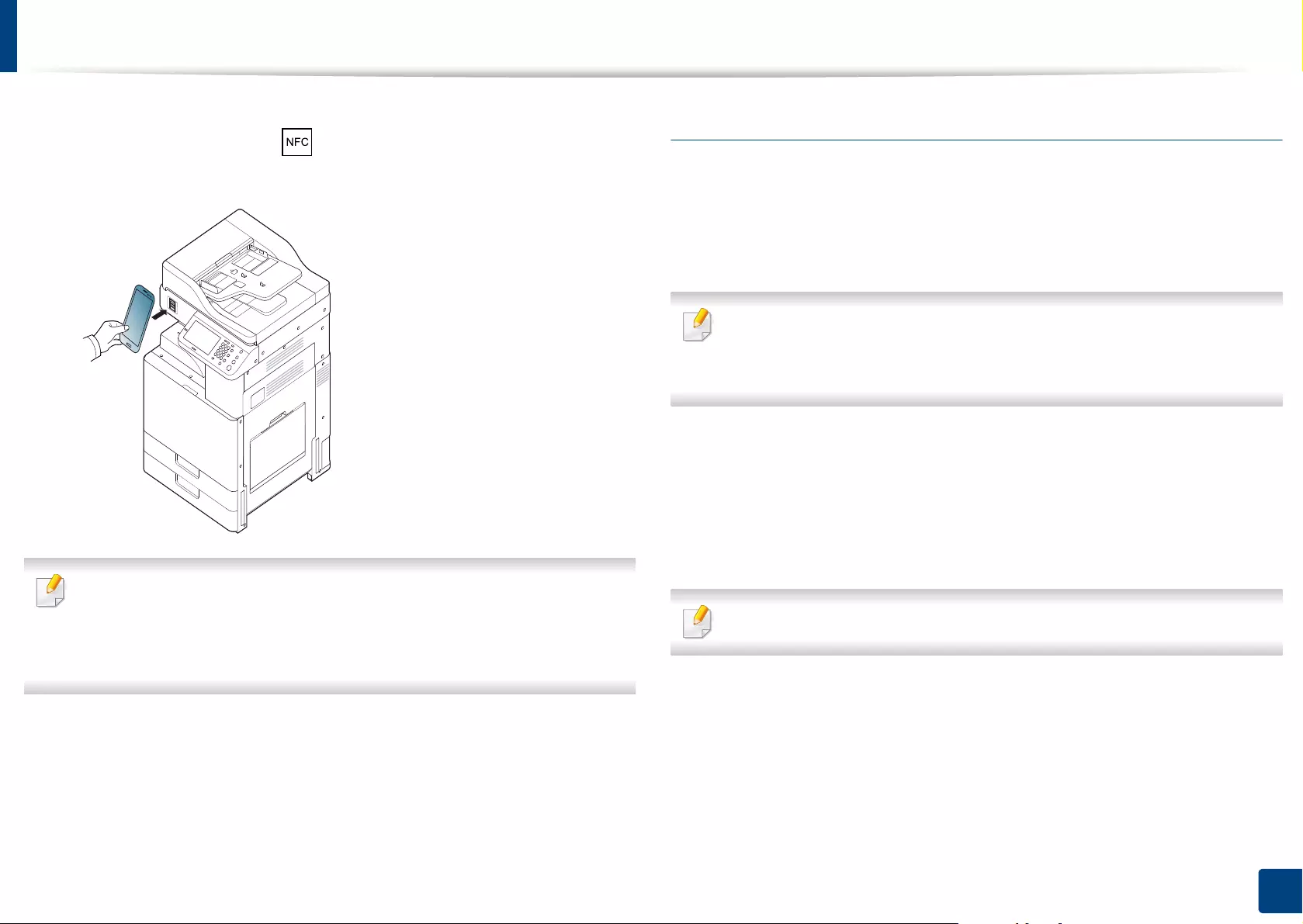
Using the NFC feature (Optional)
210
10. Using the Machine via Mobile Device
5 Tag your mobile device (usually located on the back of the mobile
device) over the NFC tag ( ) on your printer.
Wait few seconds for the mobile device to connect to the printer.
• For some mobile devices, NFC tag might not be located at the back of the
mobile device. Check the location of the NFC antenna on your mobile
device before tagging.
• While cloning, the machine is locked.
6 Select the settings you want to apply and press OK.
7 Follow the instruction on the mobile device’s screen.
Importing (Applying the settings to the machine)
1Check that NFC and Wi-Fi Direct enabled features are on your mobile
device and Wi-Fi Direct feature is enabled on your printer.
2 Open Samsung Mobile Print Manager from your mobile device.
If you do not have Samsung Mobile Print Manager installed on your
cellphone, go to the application store (Samsung Apps, Play Store) on your
mobile device, and just search for download the app and try again.
3 Press Import.
4 Type in the ID and Password.
Use the same login ID, Password as when logging in from the machine
(see "Log-in" on page 243).
If you want to change the password, see "Security tab" on page 272.
5 Select the settings you want to copy.
6 Follow the instruction on the mobile device’s screen.
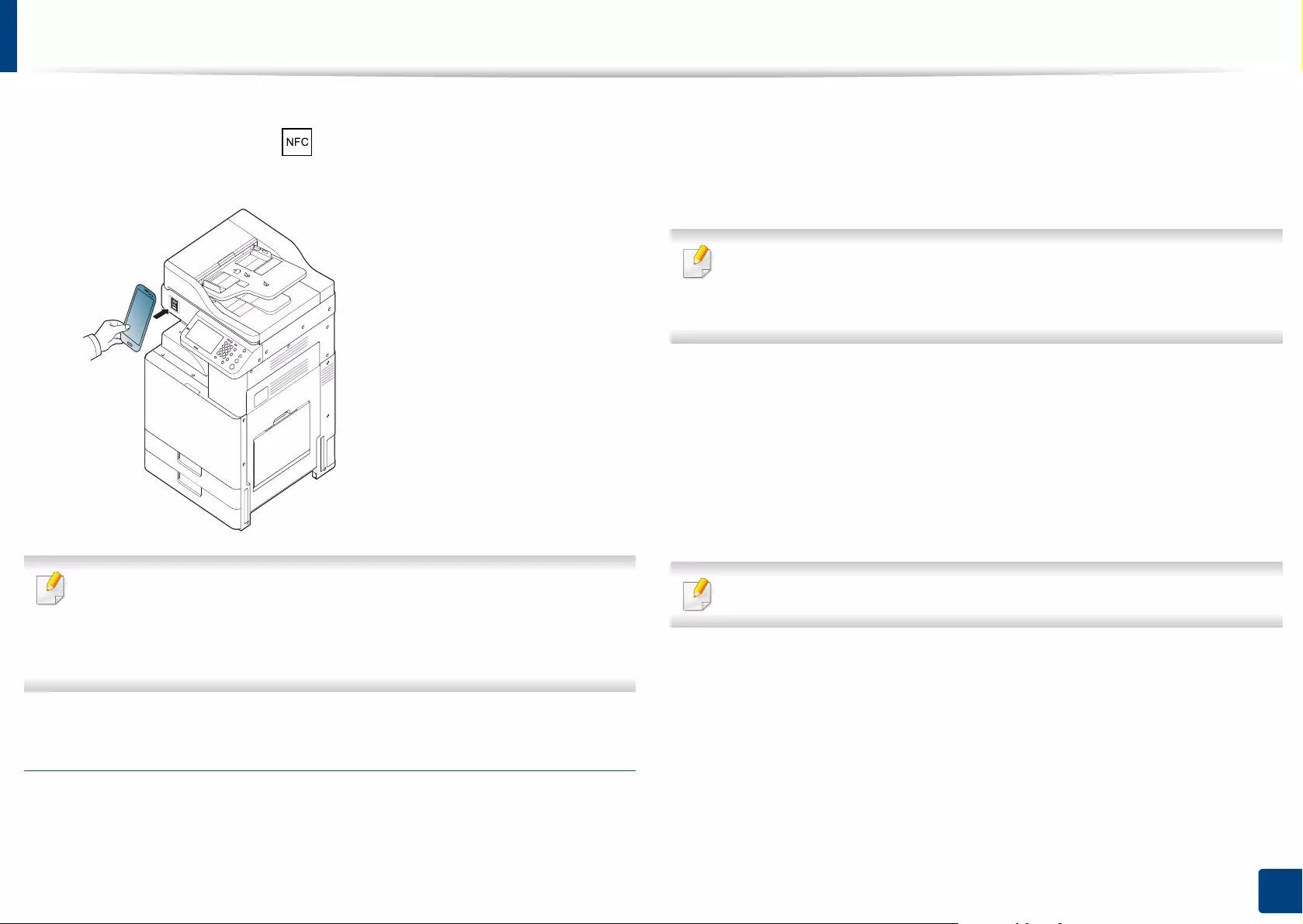
Using the NFC feature (Optional)
211
10. Using the Machine via Mobile Device
7 Tag your mobile device (usually located on the back of the mobile
device) over the NFC tag ( ) on your printer.
Wait few seconds for the mobile device to connect to the printer.
• For some mobile devices, NFC tag might not be located at the back of the
mobile device. Check the location of the NFC antenna on your mobile
device before tagging.
• While cloning, the machine is locked.
Wireless Setup
You can copy wireless setting from your phone to your printer by touching your
mobile device on the NFC tag on your printer.
1Check that NFC and Wi-Fi Direct enabled features are on your mobile
device and Wi-Fi Direct feature is enabled on your printer.
2 Open Samsung Mobile Print Manager from your mobile device.
If you do not have Samsung Mobile Print Manager installed on your
cellphone, go to the application store (Samsung Apps, Play Store) on your
mobile device, and just search for download the app and try again.
3 Mobile device Samsung Mobile Print Pro screen appears.
Press Wi-Fi Setup.
4 Type in the ID and Password.
Use the same login ID, Password as when logging in from the machine
(see "Log-in" on page 243).
If you want to change the password, see "Security tab" on page 272.
5 If the access point (or wireless router) is connected to the connection
confirmation window appears, then click OK.
If the access point (or wireless router) not connection, select the desired
access point (or wireless router) and click OK, then click OK.
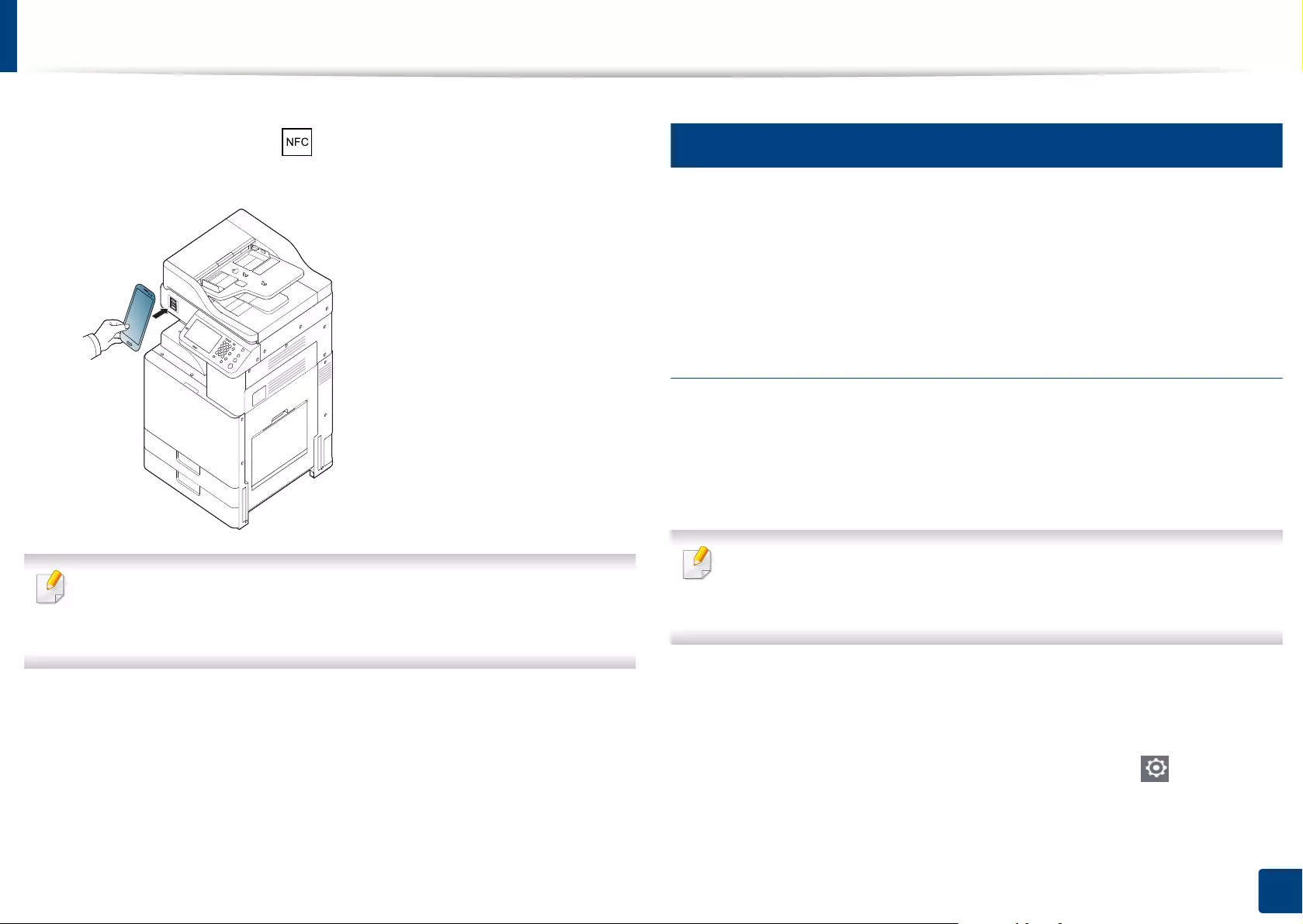
Using the NFC feature (Optional)
212
10. Using the Machine via Mobile Device
6 Tag your mobile device (usually located on the back of the mobile
device) over the NFC tag ( ) on your printer.
Wait few seconds for the mobile device to connect to the printer.
For some mobile devices, NFC tag might not be located at the back of the
mobile device. Check the location of the NFC antenna on your mobile
device before tagging.
7 Follow the instruction on the mobile device’s screen.
5
Using the Samsung Mobile Print App
Samsung Mobile Print is a free application that enables users to print,
scan(Only users with multi-functional printers), or fax(Only users with multi-
functional printers) photos, documents, and web pages directly from your
smartphone or tablet.
Printing
1Check that NFC and Wi-Fi Direct features are enabled on your mobile
device and Wi-Fi Direct feature is enabled on your printer.
2 Open Samsung Mobile Print app.
If you do not have Samsung Mobile Print installed on your cellphone, go
to the application store (Samsung Apps, Play Store, App Store) on your
mobile device, and just search for download the app and try again.
3 Select print mode.
4 Select the content you want to print.
If necessary, change the print option by pressing the icon.
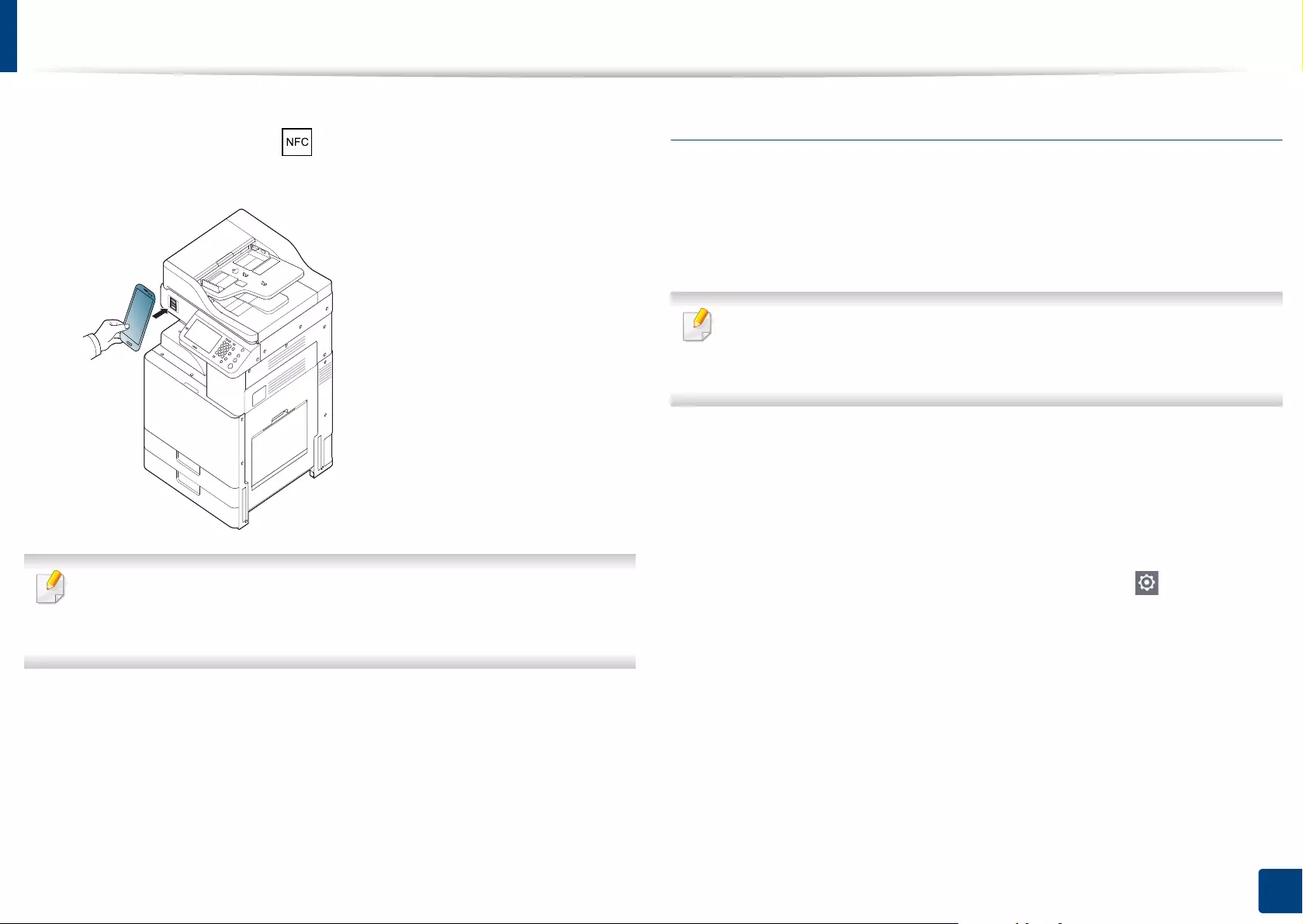
Using the NFC feature (Optional)
213
10. Using the Machine via Mobile Device
5 Tag your mobile device (usually located on the back of the mobile
device) over the NFC tag ( ) on your printer.
Wait a few seconds for the mobile device to send a job to the printer.
For some mobile devices, NFC tag might not be located at the back of the
mobile device. Check the location of the NFC antenna on your mobile
device before tagging.
6 The printer starts printing.
Scanning
1Check that NFC and Wi-Fi Direct features are enabled on your mobile
device and Wi-Fi Direct feature is enabled on your printer.
2 Open Samsung Mobile Print app.
If you do not have Samsung Mobile Print installed on your cellphone, go
to the application store (Samsung Apps, Play Store, App Store) on your
mobile device, and just search for download the app and try again.
3 Select scan mode.
4 Place a single document face down on the document glass, or load the
documents face up into the document feeder (see "Loading originals" on
page 72).
If necessary, change the scan option by pressing the icon.
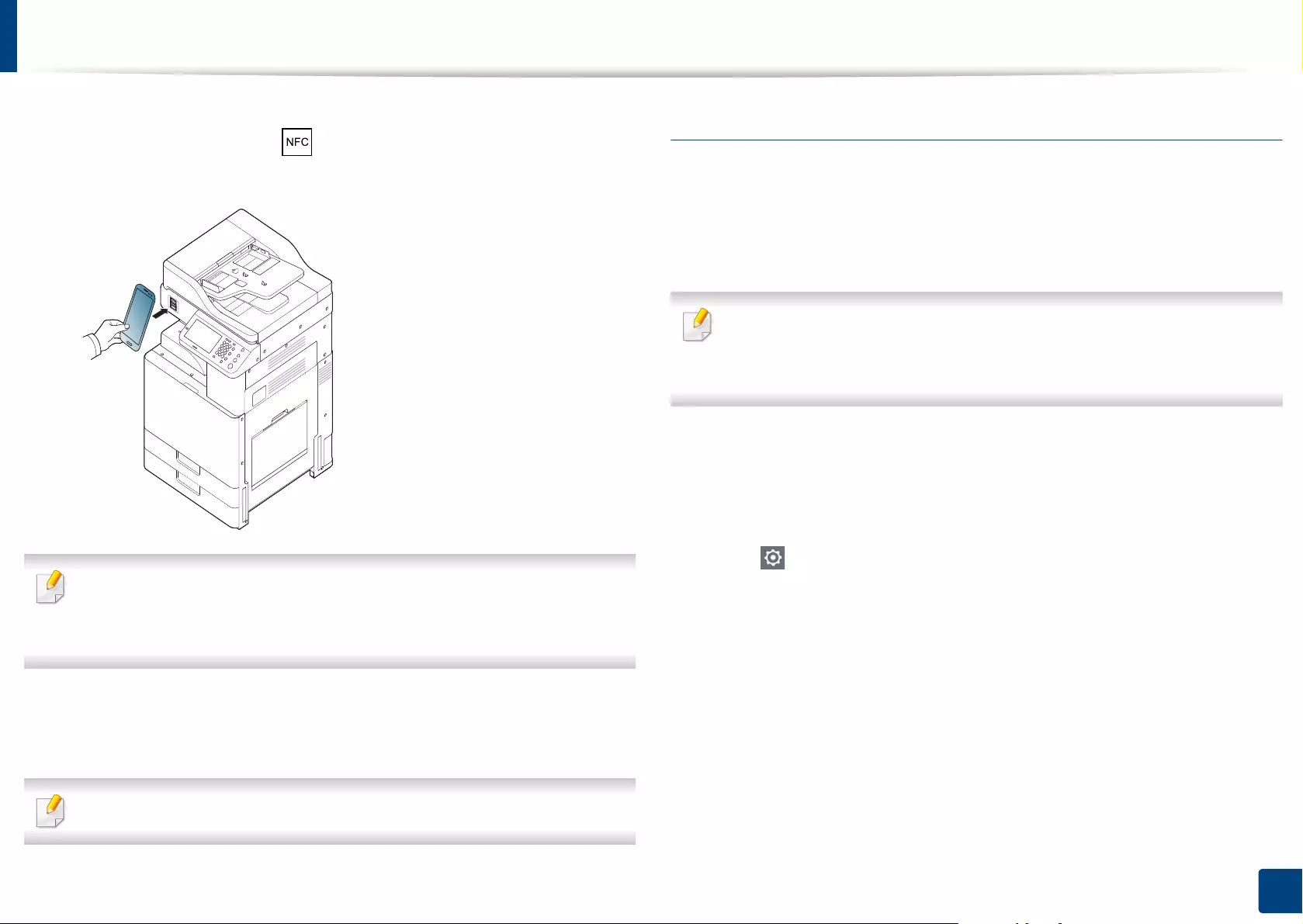
Using the NFC feature (Optional)
214
10. Using the Machine via Mobile Device
5 Tag your mobile device (usually located on the back of the mobile
device) over the NFC tag ( ) on your printer.
Wait few seconds for the mobile device to send a job to the printer.
For some mobile devices, NFC tag might not be located at the back of the
mobile device. Check the location of the NFC antenna on your mobile
device before tagging.
6 The printer starts scanning the content.
The scanned data is saved on your mobile device.
If you want to continue scanning, follow the instruction on the app screen.
Sending Fax
1Check that NFC and Wi-Fi Direct features are enabled on your mobile
device and Wi-Fi Direct feature is enabled on your printer.
2 Open Samsung Mobile Print app.
If you do not have Samsung Mobile Print installed on your cellphone, go
to the application store (Samsung Apps, Play Store, App Store) on your
mobile device, and just search for download the app and try again.
3 Select fax mode.
4 Select the content you want to send fax.
If necessary, enter the fax number and change the fax option by pressing
the icon.
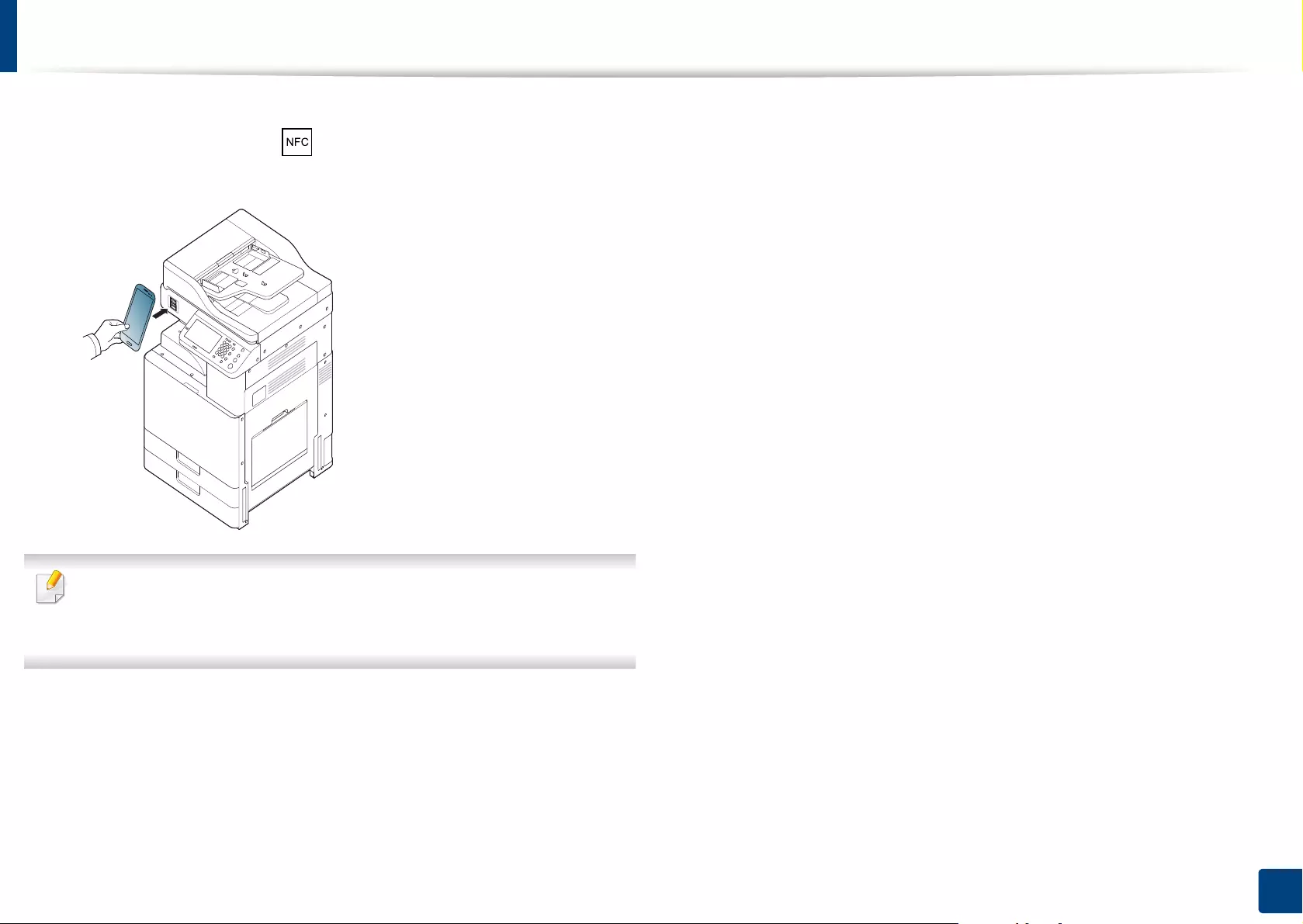
Using the NFC feature (Optional)
215
10. Using the Machine via Mobile Device
5 Tag your mobile device (usually located on the back of the mobile
device) over the NFC tag ( ) on your printer.
Wait few seconds for the mobile device to send a job to the printer.
For some mobile devices, NFC tag might not be located at the back of the
mobile device. Check the location of the NFC antenna on your mobile
device before tagging.
6 The printer starts faxing the content.
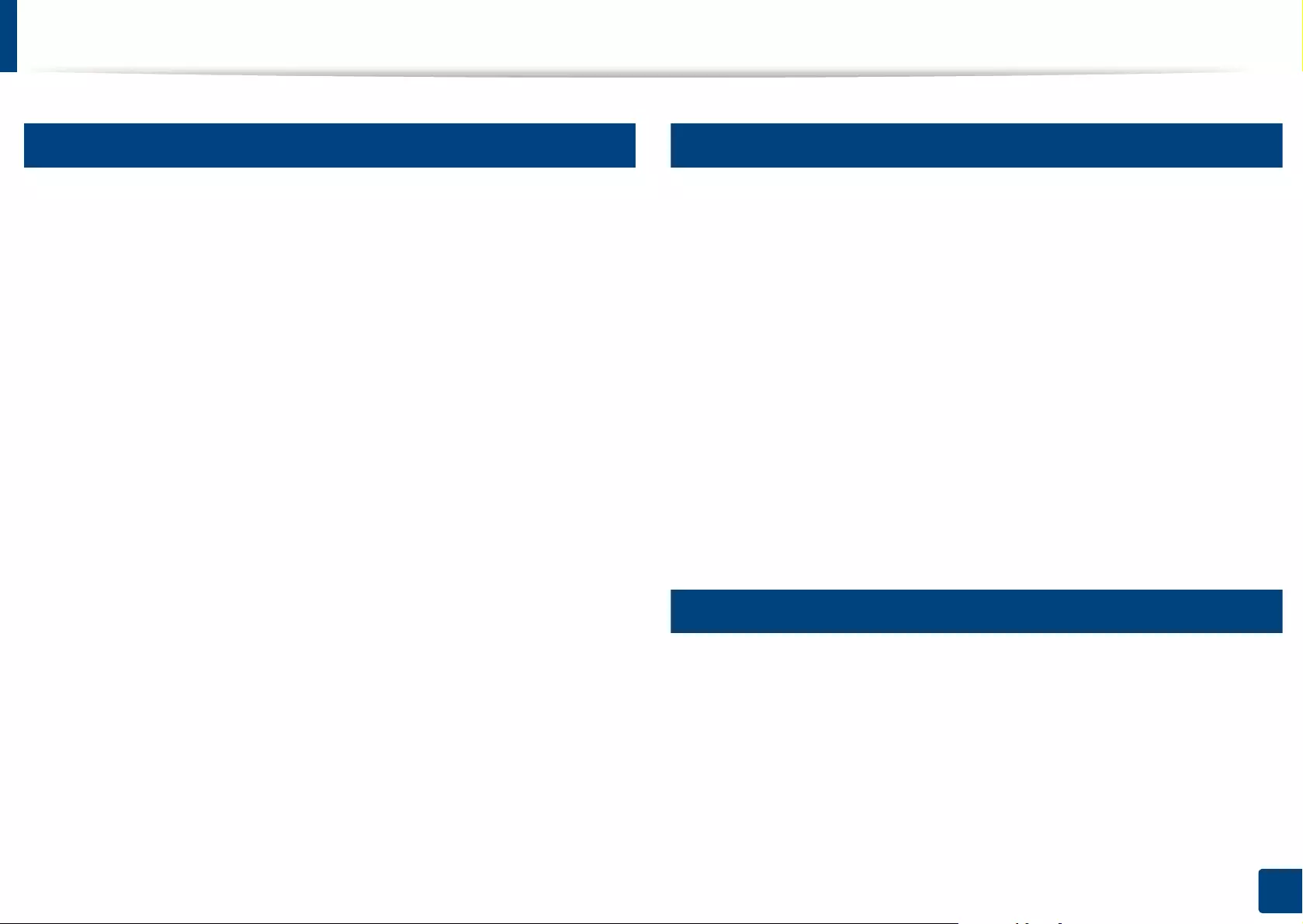
216
10. Using the Machine via Mobile Device
Supported Mobile Apps
6
Available Apps
•Samsung Mobile Print: Samsung Mobile Print is a free application that
enables users to print, scan(Only users with the machine supports scan), or
fax(Only users with the machine supports fax) photos, documents, and web
pages directly from your smartphone or tablet. Samsung Mobile Print is
not only compatible with your Android and iOS smart phones but also with
your iPod Touch and tablet PC. It connects your mobile device to a network
connected Samsung printer or to a wireless printer through a Wi-Fi access
point. Installing a new driver or configuring network settings isn’t necessary
– just simply install the Samsung Mobile Print application, and it will
automatically detect compatible Samsung printers. Besides printing photos,
web pages, and PDFs, scanning is also supported. If you have a Samsung
multifunction, scan any document into a JPG, PDF, or PNG format for quick
and easy viewing on your mobile device (see "Using the Samsung Mobile
Print App" on page 212).
•Samsung Mobile Print Pro: Helps users to get an authentication easily. This
app provides one way of getting a user authentication using your mobile
device (see "Using the Samsung Mobile Print Pro App" on page 207).
•Samusng Mobile Print Manager: Enables users to use cloning and wireless
setup features using your mobile device (see "Using the Samsung Mobile
Print Manager App" on page 209).
7
Downloading Apps
To download apps, go to the application store (Play Store, App Store) on your
mobile device, and just search for “Samsung Mobile Print /Samsung Mobile
Print Pro/Samusng Mobile Print Manager.” You can also visit iTunes for Apple
devices on your computer.
•Samsung Mobile Print
-Android: Search for Samsung Mobile Print from Play Store, and then
download the app.
-iOS: Search for Samsung Mobile Print from App Store, and then
download the app.
•Samsung Mobile Print Pro/Samusng Mobile Print Manager
-Android: Search for Samsung Mobile Print Pro or Samusng Mobile
Print Manager from Play Store, and then download the app.
8
Supported Mobile OS
•Samsung Mobile Print
- Android OS 2.3 or higher
- iOS 5.0 or higher
•Samsung Mobile Print Pro/Samusng Mobile Print Manager
- NFC and Wi-Fi Direct enabled, supported mobile apps installed mobile
device with Android 4.0 or higher.
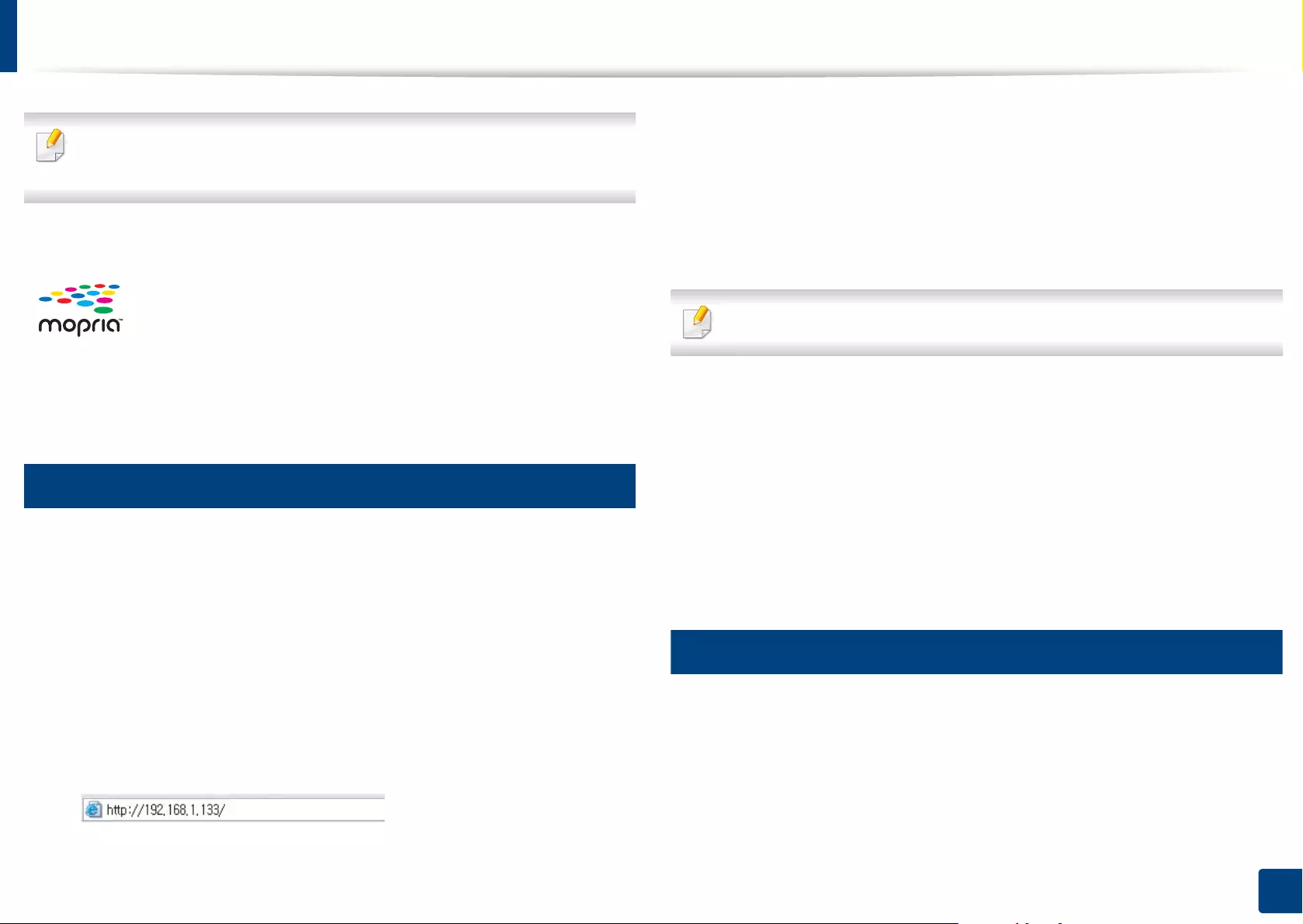
217
10. Using the Machine via Mobile Device
Mopria™
Only Mopria-certified machines can use the Mopria feature. Check the box
that your machine came in for the Mopria-certified logo.
9
Setting up the machine for Mopria printing
Bonjour(mDNS) and IPP protocols are required on your machine to use the
Mopria feature. Perform the following steps to enable the Mopria feature.
1Ensure that the machine is connected to the network.
2 On your computer, open a web browser (Internet Explorer, Safari, or
Firefox) and type the IP address of the machine in the address bar. Then,
press Enter.
For example,
3 Click Login in the upper right corner of the SyncThru™ Web Service
website.
4 Type in the ID and Password.
Use the same login ID, Password as when logging in from the machine
(see "Log-in" on page 243).
If you want to change the password, see "Security tab" on page 272.
5 When the SyncThru™ Web Service window opens, click Settings >
Network Settings > Standard TCP/IP, LPR, IPP > IPP. Then, select
Enable.
6 Click Settings > Network Settings > mDNS. Then, select Enable.
7 Click Security > System Security > Feature Management > Mopria.
Then, select Enable.
10
Setting up Mopria on your mobile device
If you do not have Mopria Print Service app installed on your mobile device,
open to the app store (Play Store, App Store) on your mobile device, search
for,Mopria Print Service, and then download and install the app.
Mopria™ Print Service is a mobile printing solution that enhances
the new print functionality on any Android phone or tablet
(Android version 4.4 or later). With this service, you can connect
and print to any Mopria-certified printer on the same network as
your mobile device without additional set-up. Many native
Android apps support printing, including Chrome, Gmail, Gallery,
Drive and Quickoffice.
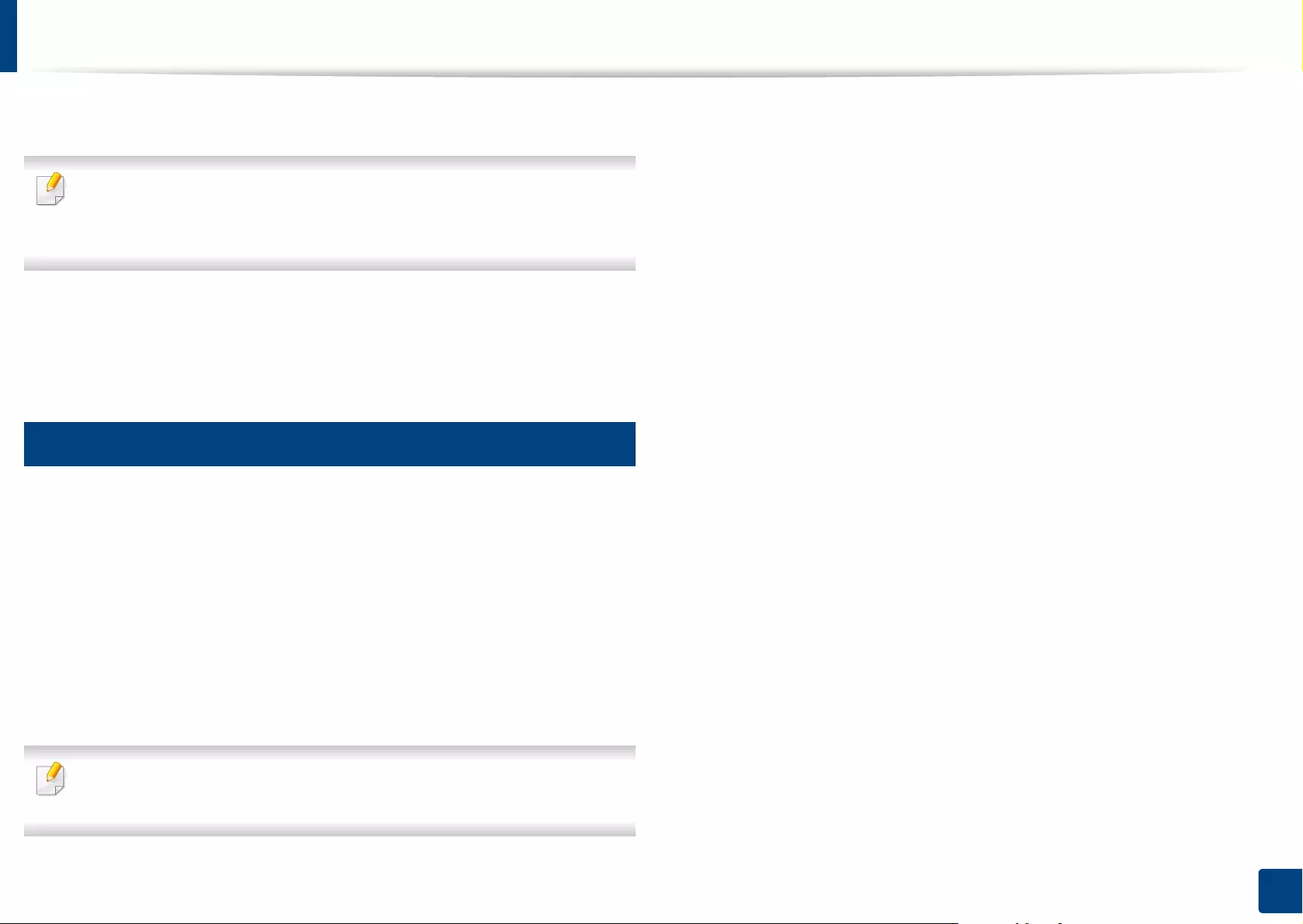
Mopria™
218
10. Using the Machine via Mobile Device
1In the Settings menu of your Android device, tap Printing.
The location of this option may differ depending on your mobile device. If
you cannot locate the Printing option, refer to the user's manual for your
mobile device.
2 Under Print Services, tap Mopria Print Service.
3 Tap the On/Off slider to enable the Mopria Print Service.
11
Printing via Mopria
To print via Mopria on an Android device:
1Open the email, photo, web page, or document that you want to print.
2 Tap Print on the menu in the app.
3 Select your printer, and then configure the print options.
4 Touch Print again to print the document.
To cancel a print job: Select and delete the document from the print queue
in the Notification Bar.
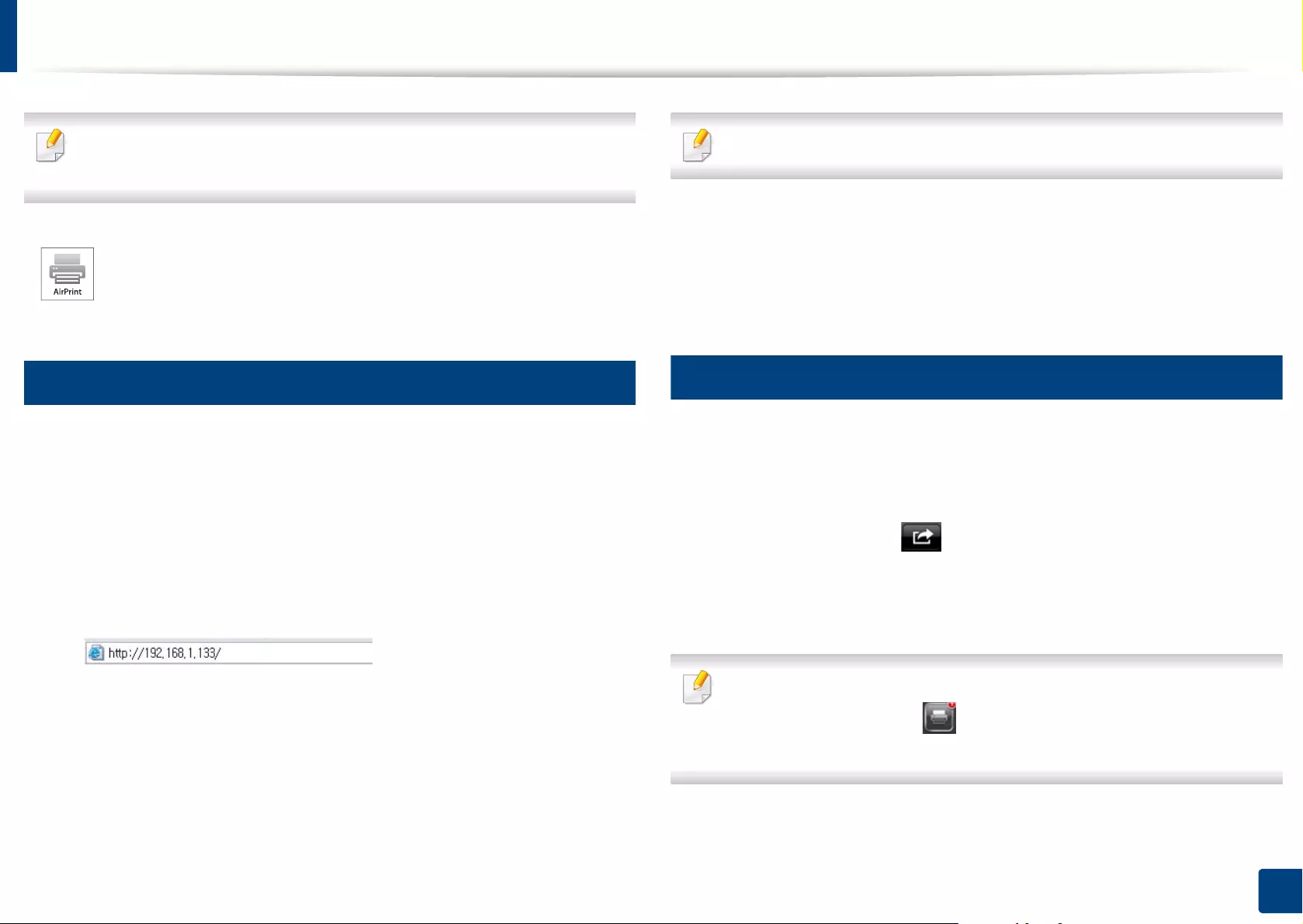
219
10. Using the Machine via Mobile Device
AirPrint
Only AirPrint certified machines can use the AirPrint feature. Check the box
your machine came in for the AirPrint certified mark.
12
Setting up AirPrint
Bonjour(mDNS) and IPP protocols are required on your machine to use the
AirPrint
feature. You can enable the
AirPrint
feature by one of the following methods.
1Check whether the machine is connected to the network.
2 Start a web browser such as Internet Explorer, Safari, or Firefox and enter
your machine’s new IP address in the browser window.
For example,
3 Click Login in the upper right corner of the SyncThru™ Web Service
website.
4 Type in the ID and Password.
Use the same login ID, Password as when logging in from the machine
(see "Log-in" on page 243).
If you want to change the password, see "Security tab" on page 272.
5 When the SyncThru™ Web Service window opens, click Settings >
Network Settings.
6 Click AirPrint.
13
Printing via AirPrint
For example, the iPad manual provides these instructions:
1Open your email, photo, web page, or document you want to print.
2 Touch the action icon( ).
3 Select your printer driver name and option menu to set up.
4 Touch Print button. Print it out.
Cancelling print job: To cancel the printing job or view the print summary,
click the print center icon ( ) in multitasking area. You can click cancel in
the print center.
AirPrint allows you to print directly from iPhone, iPad and iPod touch
running the latest version of iOS.
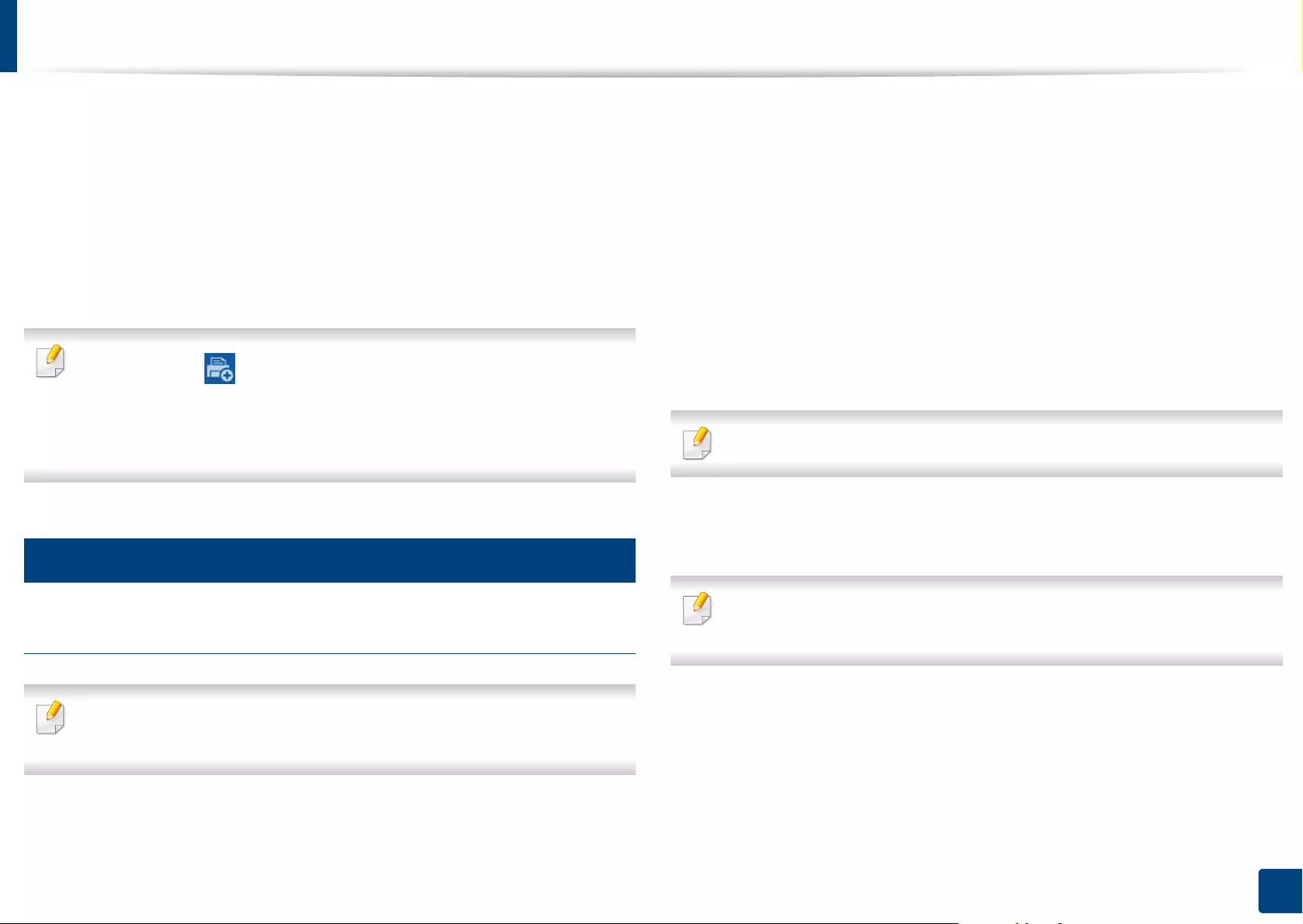
220
10. Using the Machine via Mobile Device
Samsung Cloud Print
Samsung Cloud Print is a free cloud service that allows you to print or scan from
your smartphone or tablet to your Samsung printer or MFP. After installing the
Samsung Cloud Print app, you can register with the Samsung Cloud Print service
just using your mobile number for authentication. No other account login is
required, although you can link the app to your Samsung Account if you wish.
Refer to the Samsung website (www.samsungcloudprint.com) for more
information about Samsung Cloud Print.
If you press the ( ) button from Samsung Cloud Print app, Your mobile
device and printer or MFP can be paired, QR code, or by manually entering
its Mac address. Once paired, you can print or scan from anywhere and
everywhere.
14
Registering your Printer to Samsung Cloud server
Registering from Web Browser
Make sure the printer machine is turned on and connected to a wired or
wireless network that has access to the Internet.
1Open Web browser.
2 Enter your printer’s IP address in the address field and press the Enter key
or click Go.
3 Click Login in the upper right corner of the SyncThru™ Web Service
website.
4 Type in the ID and Password.
Use the same login ID, Password as when logging in from the machine
(see "Log-in" on page 243).
If you want to change the password, see "Security tab" on page 272.
5 When the SyncThru™ Web Service window opens, click Settings >
Network Settings > Samsung Cloud Print.
If the XOA tab is shown, press XOA > Samusng Cloud Agent from
SyncThru™ Web Service.
6 Now your printer is registered with Samsung Cloud Print service.
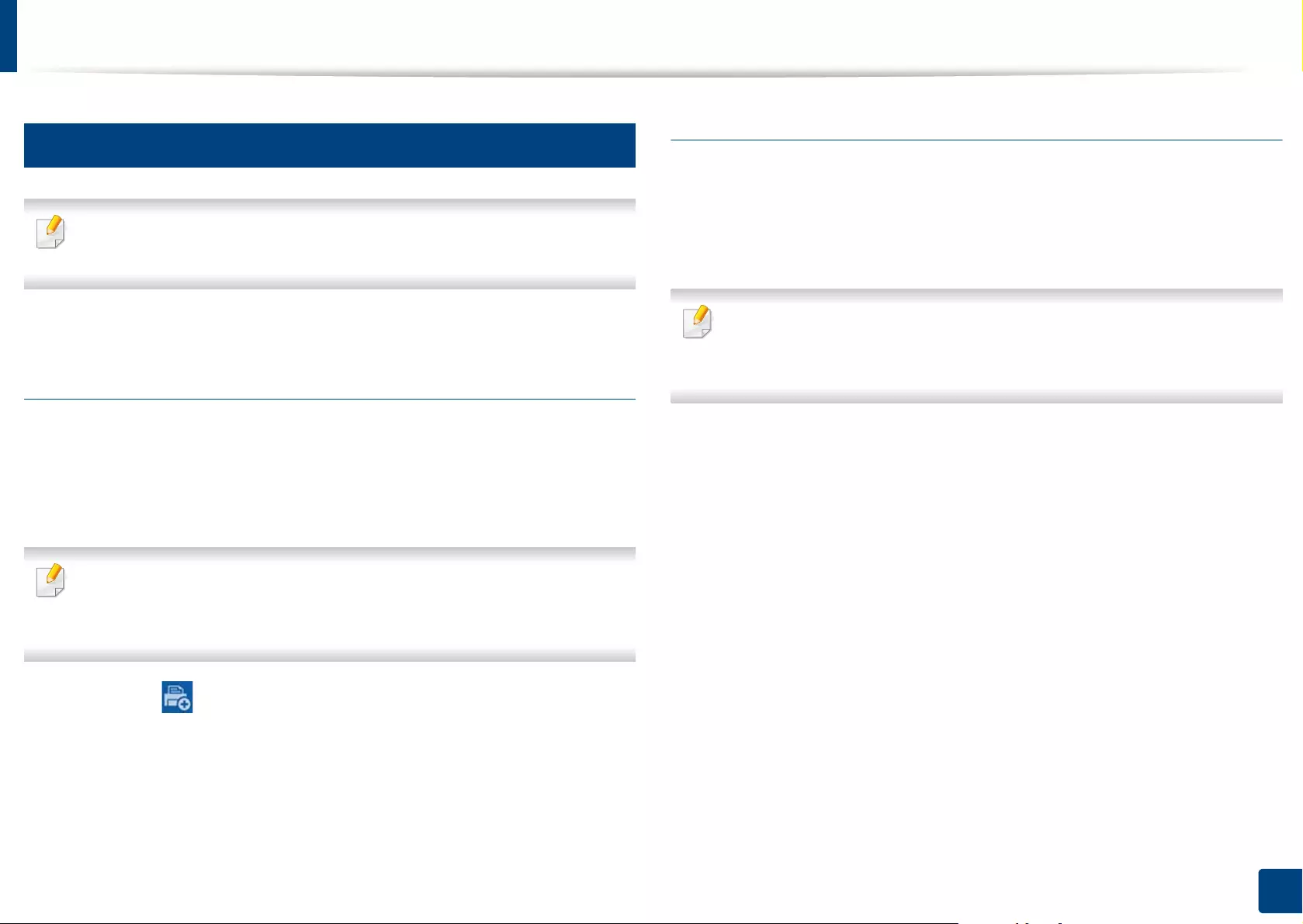
Samsung Cloud Print
221
10. Using the Machine via Mobile Device
15
Using the Samsung Cloud Print
Make sure the printer is turned on and connected to a wired or wireless
network that has access to the Internet.
Registering a printer from an application on mobile
device
The following steps are an example of using the Samsung Cloud Print app from
Android mobile phone.
1Open Samsung Cloud Print app.
If you do not have Samsung Cloud Print app installed on your cellphone,
go to the application store (Samsung Apps, Play Store, App Store) on your
mobile device, and just search for download the app and try again.
2 Press the ( ) button from Samsung Cloud Print app.
3 Your mobile device and printer or MFP can be paired NFC tapping, QR
code or by manually entering its Mac address.
Printing from an application on mobile device
The following steps are an example of using the Samsung Cloud Print app from
Android mobile phone.
1Open Samsung Cloud Print app.
If you do not have Samsung Cloud Print app installed on your cellphone,
go to the application store (Samsung Apps, Play Store, App Store) on your
mobile device, and just search for download the app and try again.
2 Tap the option check button of the document that you want to print.
3 Set the printing options if you want.
4 Tap Send Job.
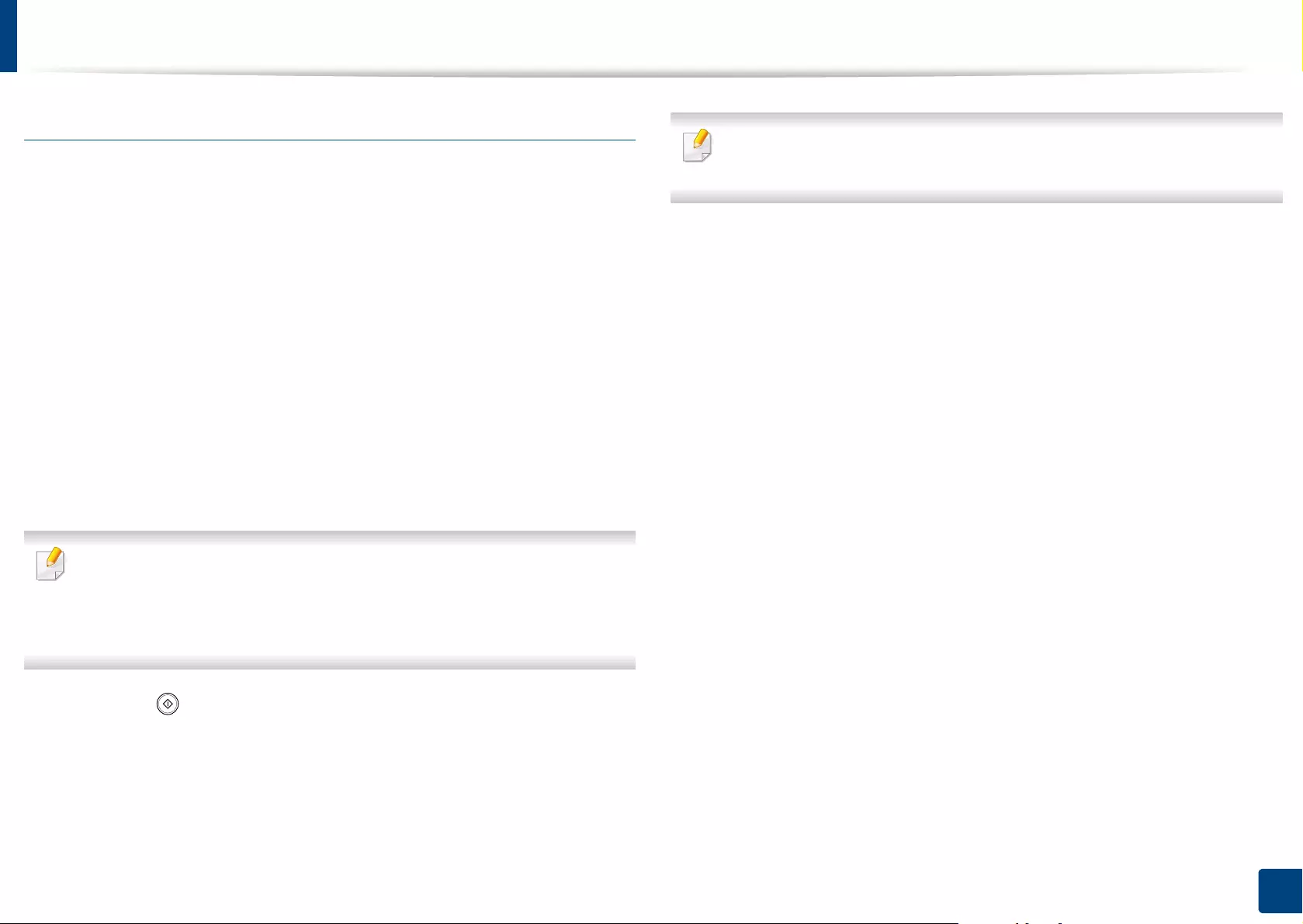
Samsung Cloud Print
222
10. Using the Machine via Mobile Device
Scanning and sending to Samsung Cloud Print
You can scan an image and the scanned data will be stored in the Samsung
Cloud Print.
1Place a single document face down on the document glass, or load the
documents face up into the document feeder (see "Loading originals" on
page 72).
2 Press Samsung Cloud from the control panel.
3 Enter recipient country code and recipient phone number.
4 Enter sender information.
5 Enter a file name to store the scan data.
You can set the file name from the SyncThru™ Web Service. Open the Web
browser from your networked computer and type the IP address of your
machine. When SyncThru™ Web Service opens, click Settings > Machine
Settings > Samsung Cloud > File Name.
6 Press the (Start) button to scan and store the file in samsung cloud
server.
When the user is not registered in the Samsung Cloud Print, a confirmation
window will pop up. Select a work in progress or not.
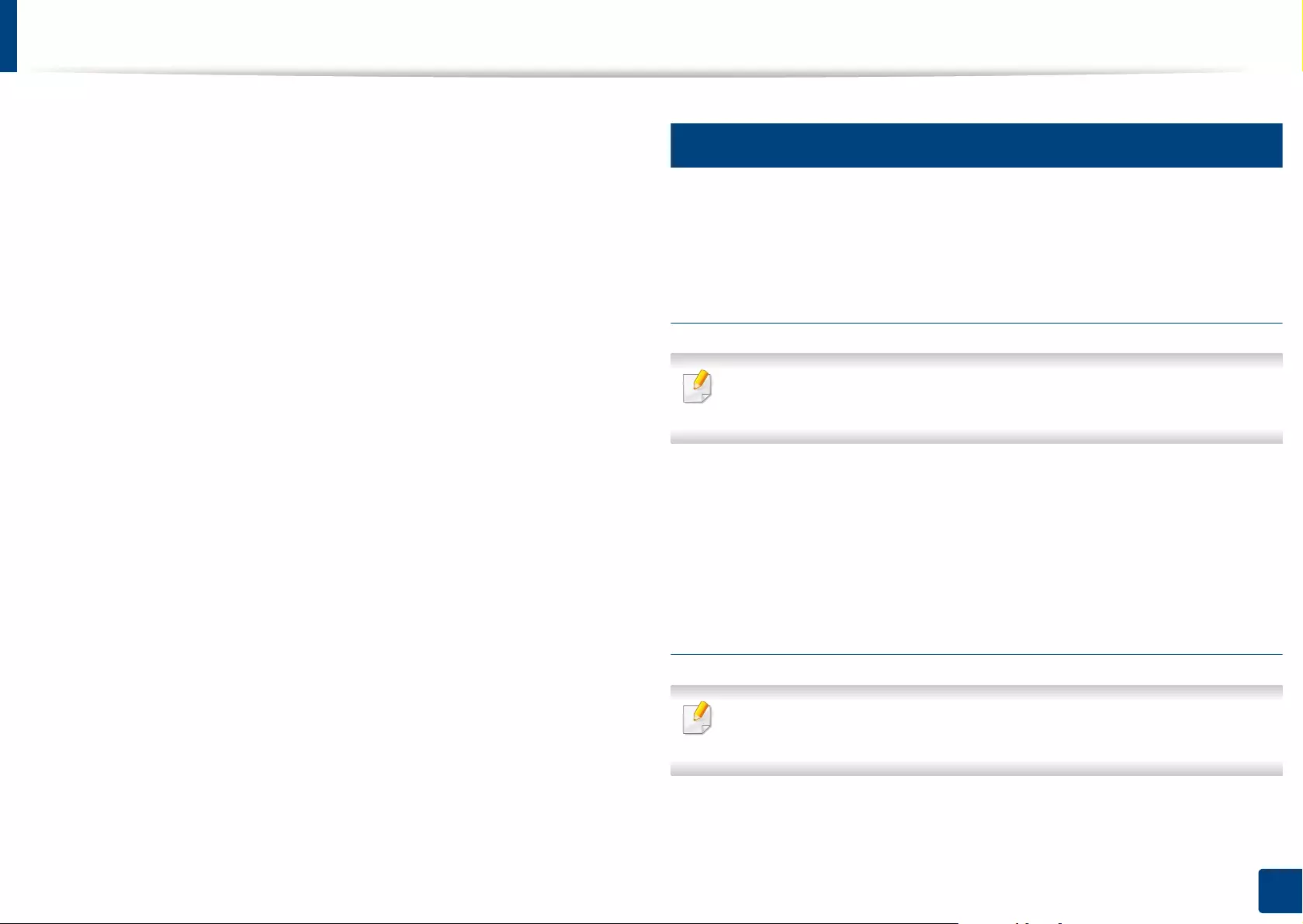
223
10. Using the Machine via Mobile Device
PrinterOn
Registering your PrinterOn-enabled Samsung printer on the PrinterOn service
allows you to print documents on that printer from anywhere in the world. The
PrinterOn service also enables you to print directly from the PrinterOn Mobile
app on your iOS or Android device. After installing the PrinterOn Mobile app,
you can register your device on the PrinterOn service by using your mobile
number for authentication.
To use the PrinterOn feature, you must register your printer on the PrinterOn
website (www.printeron.com).
Only administrators can register or configure a printer on the PrinterOn service.
This chapter does not explain all the features in the PrinterOn service. Instead,
it explains how to register a printer on the PrinterOn service from the control
panel of the machine and the SyncThru™ Web Service.
For more information about the PrinterOn service, visit the PrinterOn website
(www.printeron.com).
16
Registering your printer on the PrinterOn service
To register your printer on the
PrinterOn
service, you must activate the
PrinterOn
feature on the machine through the control panel or SyncThru™ Web Service.
Registering from the control panel
Before you begin this process, make sure that your printer is turned on and
can connect to the Internet.
1Tap PrinterOn from the touch screen.
2 When the pop-up window appears, tap OK.
Now, your printer is registered on the PrinterOn service.
Registering from Web Browser
Before you begin this process, make sure that your printer is turned on and
can connect to the Internet.
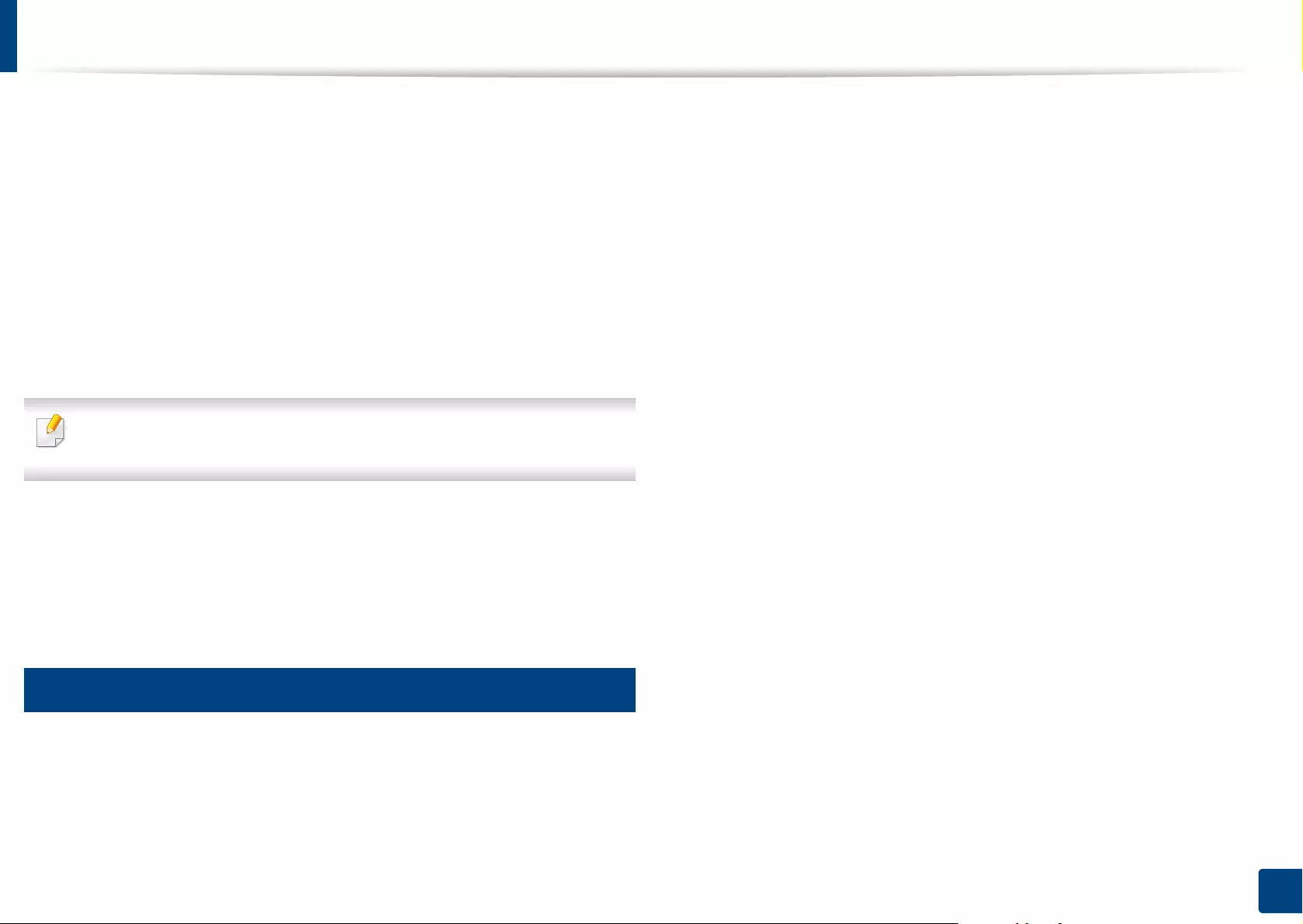
PrinterOn
224
10. Using the Machine via Mobile Device
1On your computer, open a web browser, such as Firefox, Chrome, or
Internet Explorer.
2 In the address bar of the web browser, type the IP address of your printer.
3 When the SyncThru™ Web Service website appears, click Login.
4 Type in the ID and Password.
Use the same login ID, Password as when logging in from the machine
(see "Log-in" on page 243).
5 When the SyncThru™ Web Service window opens, click Settings >
Network Settings > PrinterOn Cloud Print.
If the XOA tab is shown, press XOA > PrinterOn Cloud Print from
SyncThru™ Web Service.
6 Select Enable for the PrinterOn Cloud Print Protocol setting.
7 Click Apply.
Now, your printer is registered on the PrinterOn service.
17
Using the PrinterOn Service
For instruction on how to print using the PrinterOn service, refer to the
PrinterOn service website (www.printeron.com).
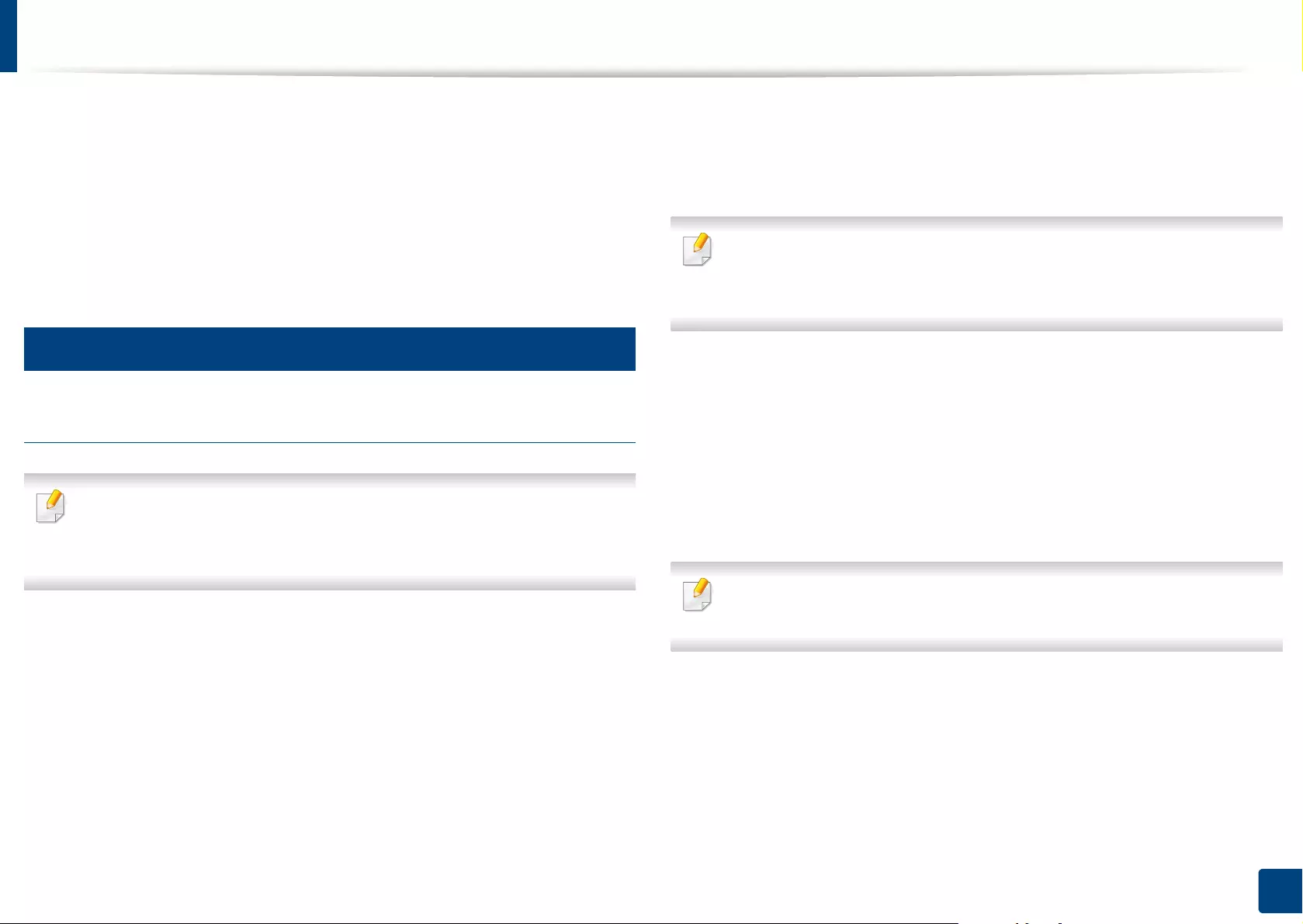
225
10. Using the Machine via Mobile Device
Google Cloud Print™
Google Cloud Print™ is a service that allows you to print to a printer using your
smart phone, tablet, or any other web-connected devices. Just register your
Google account with the printer, and you are ready to use the Google Cloud
Print™ service. You can print your document or email with Chrome OS, Chrome
browser, or a Gmail™/ Google Docs™ application on your mobile device, so you
don’t need to install the printer driver on the mobile device. Refer to the Google
website (http://google.com/cloudprint/learn/ or http://support.google.com/
cloudprint) for more information about Google Cloud Print™.
18
Registering your Google account to the printer
Registering from the Chrome Browser
• Make sure the printer machine is turned on and connected to a wired or
wireless network that has access to the Internet.
•You should create your Google account in the advance.
1Open the Chrome browser.
2 Visit www.google.com.
3 Sign in to the Google website with your Gmail™ address.
4 Enter your printer’s IP address in the address field and press the Enter key
or click Go.
5 Click Login in the upper right corner of the SyncThru™ Web Service
website.
6 Type in the ID and Password.
Use the same login ID, Password as when logging in from the machine
(see "Log-in" on page 243).
If the network environment is using a proxy server, you need to configure the proxy’s
IP and port number from
Settings
>
Network Settings
>
Proxy
. Contact your
network service provider or network administrator for more information.
7 When the SyncThru™ Web Service window opens, click Settings >
Network Settings > Google Cloud Print.
8 Enter your printer’s name and description.
9 Click Register.
The confirmation pop-up window appears.
If you set the browser to block pop-ups, the confirmation window will not
appear. Allow the site to show pop-ups.
10 Click Finish printer registration.
11 Click Manage your printers.
Now your printer is registered with Google Cloud Print™ service.
Google Cloud Print™-ready devices will appear in the list.
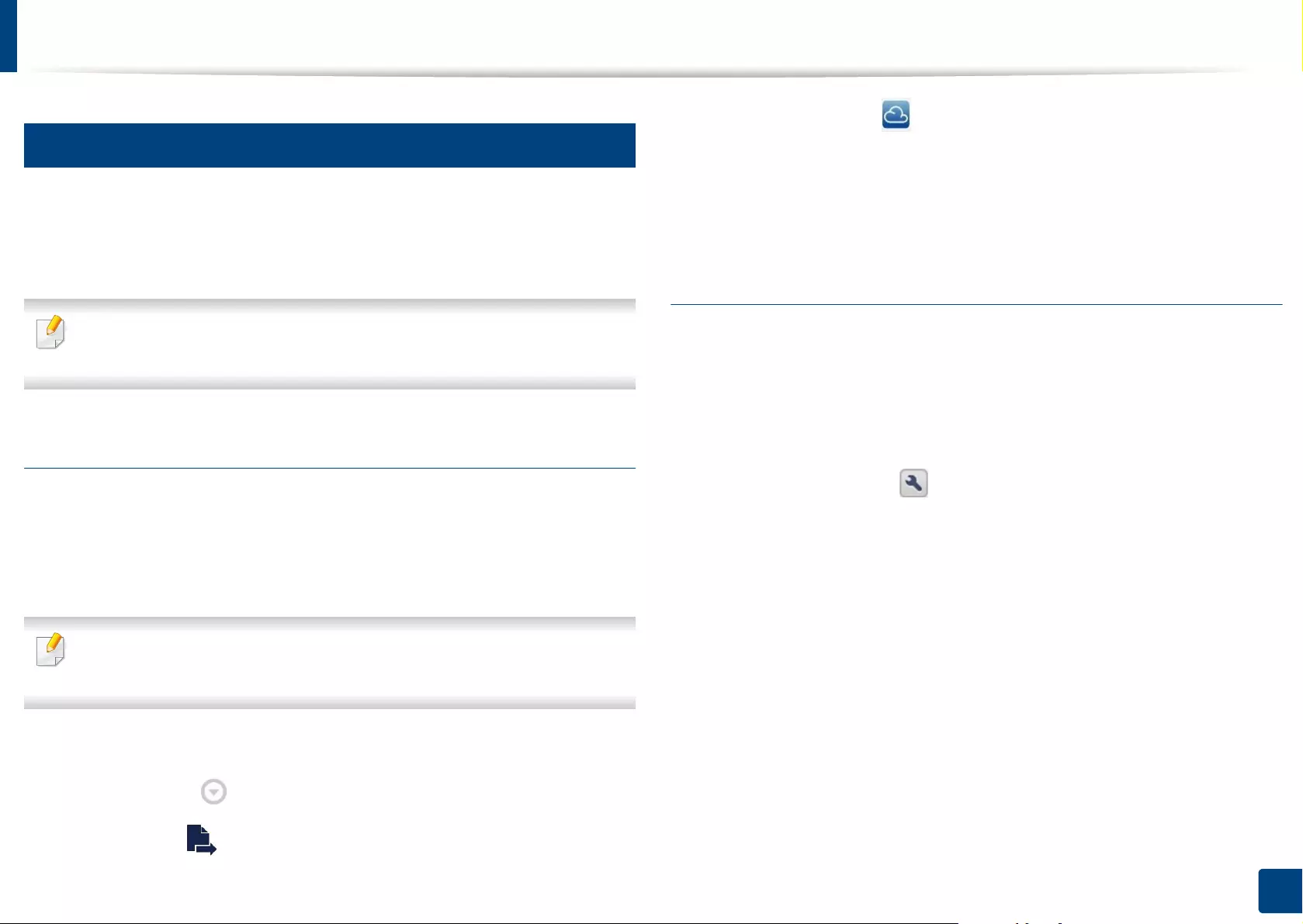
Google Cloud Print™
226
10. Using the Machine via Mobile Device
19
Printing with Google Cloud Print™
The printing procedure varies depending on the application or the device you
are using. You can see the application list that supports Google Cloud Print™
service.
Make sure the printer is turned on and connected to a wired or wireless
network that has access to the Internet.
Printing from an application on mobile device
The following steps are an example of using the Google Docs™ app from
Android mobile phone.
1Install the Cloud Print application on your mobile device.
If you do not have the application, download it from the application store
such as Android Market or App Store.
2 Access the Google Docs™ application from your mobile device.
3 Tap the option button of the document that you want to print.
4 Tap the send button.
5 Tap the Cloud Print button.
6 Set the printing options if you want.
7 Tap Click here to Print.
Printing from the Chrome browser
The following steps are an example of using the Chrome browser.
1Run Chrome.
2 Open the document or email that you want to print.
3 Click the wrench icon in the browser’s top right corner.
4 Click Print. A new tab for printing appears.
5 Select Print with Google Cloud Print.
6 Click the Print button.
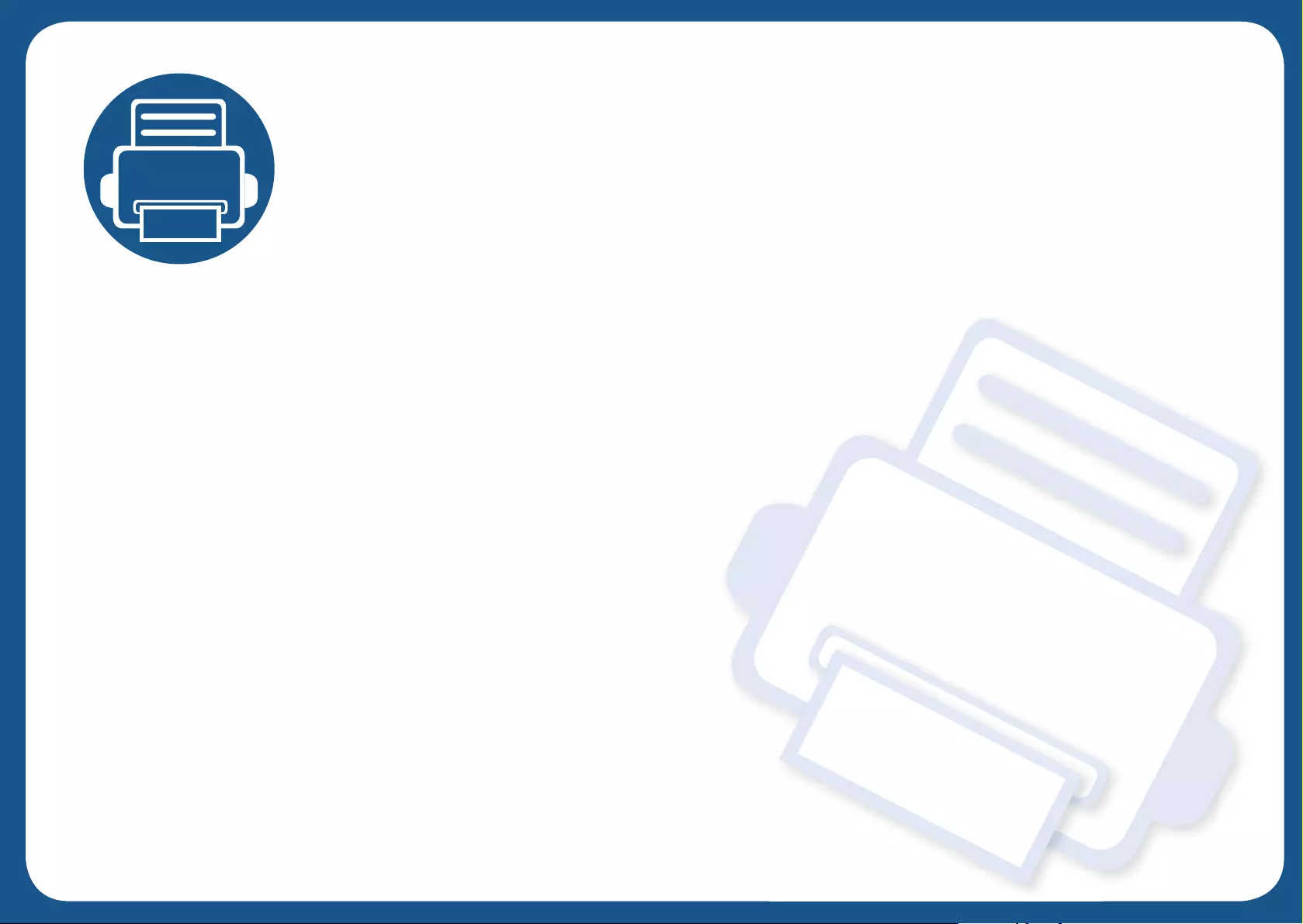
11.Using Shared Folder, Stored
Document, and USB
This chapter explains how to use Shared Folder, Stored Document, and USB with your machine.
This chapter includes:
• Understanding the Shared Folder screen 228
• Using the Shared Folder 229
• Understanding the Stored Document screen 230
• Saving documents in the Stored Document 231
• Understanding the USB screen 232
• About USB memory device 233
• Printing from a USB memory device 234
• Scanning to a USB memory device 236
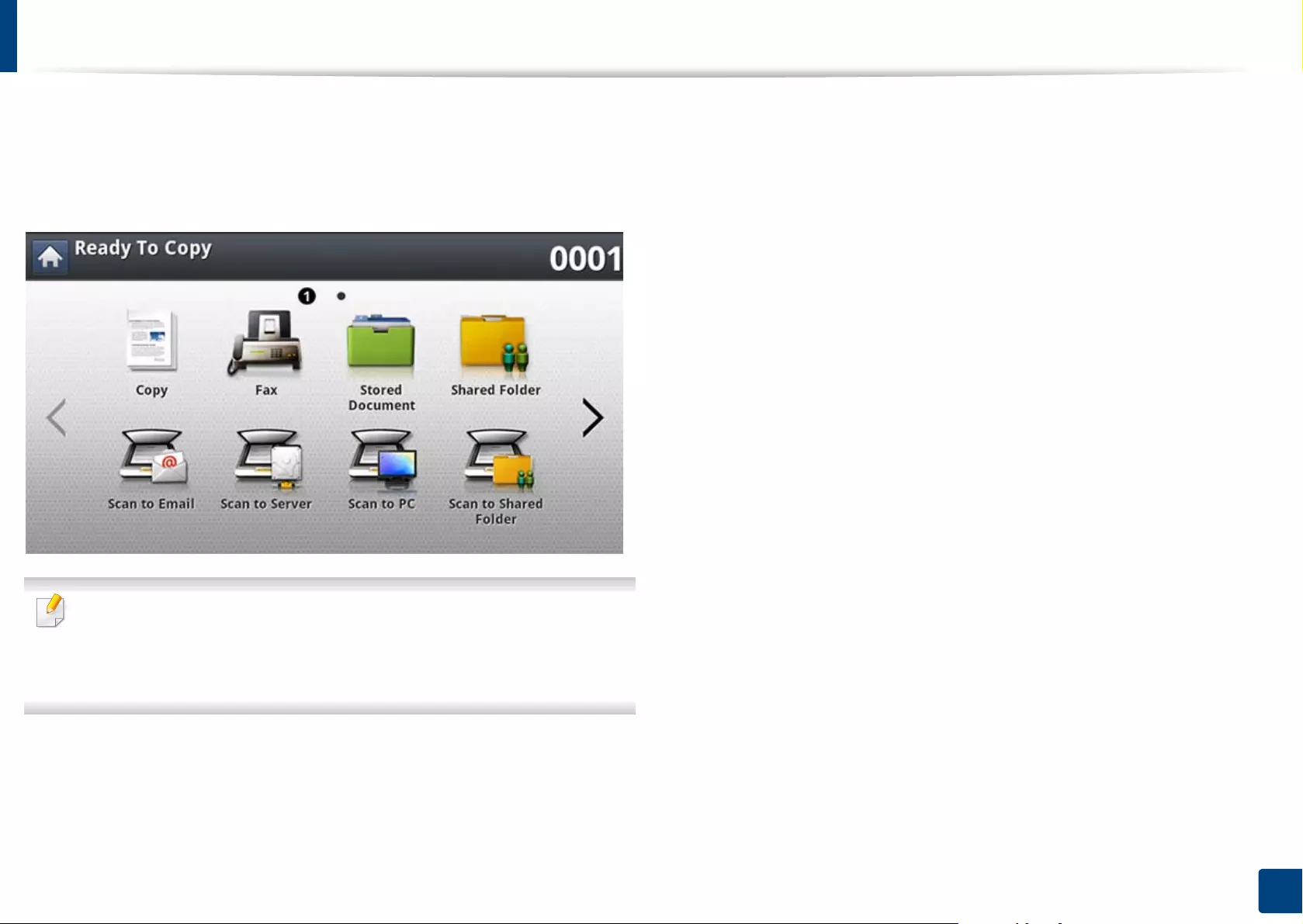
228
11. Using Shared Folder, Stored Document, and USB
Understanding the Shared Folder screen
This feature allows you to use the machine’s memory as a shared folder. The
advantage of this feature is that you can conveniently use the shared folder
through your computer.
To use the Shared Folder feature, press Shared Folder on the display screen.
• This option is available when the mass storage device (hard disk)
installed.
• The administrator can set the ID and password to restrict the user’s
access and also set the maximum number of simultaneous users.
•nfsroot: Create a new folder under nfsroot directory.
•Rename: You can rename data stored in the shared folder.
•Delete: You can delete data stored in the shared folder.
•Print: You can print data stored in the shared folder.
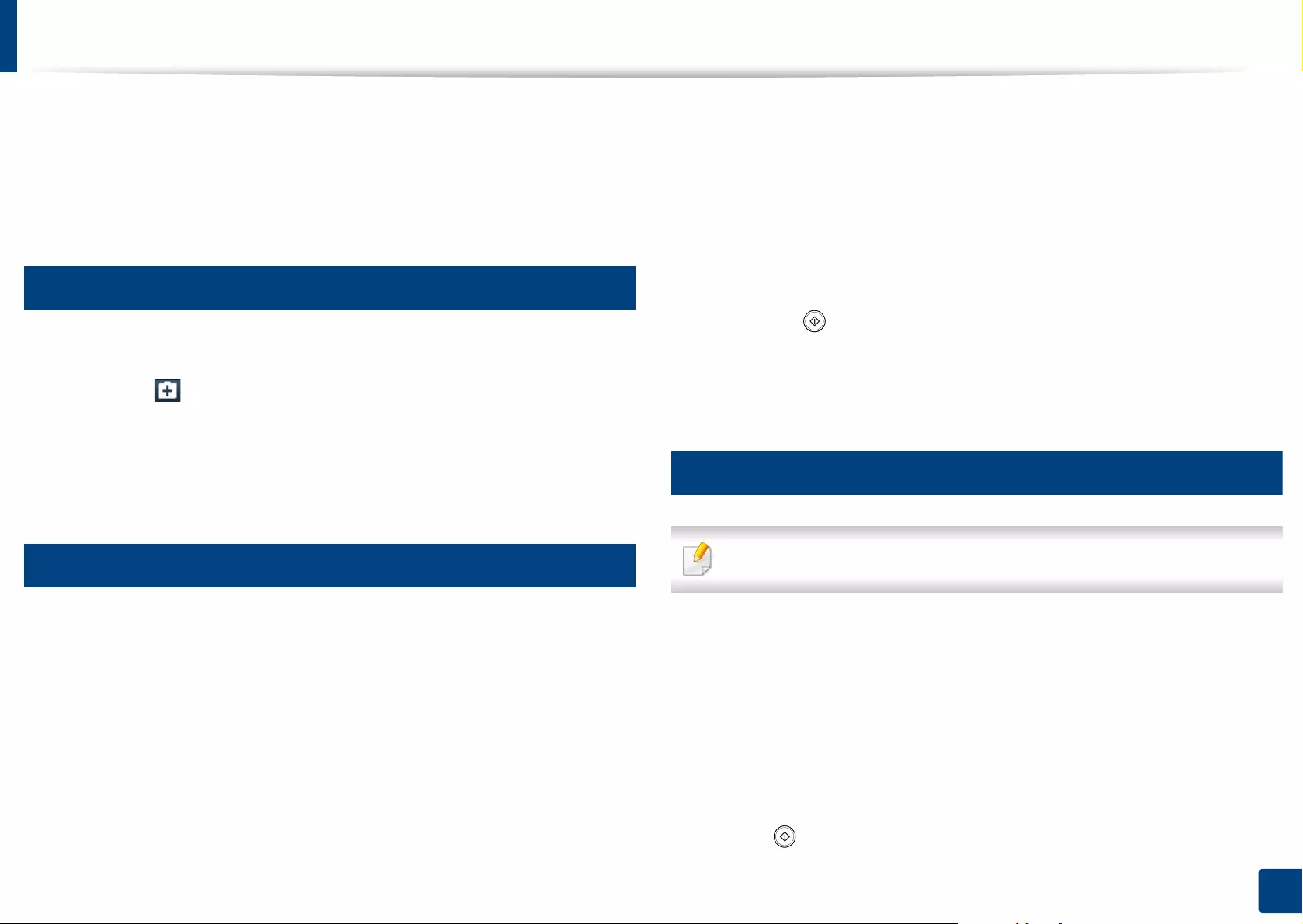
229
11. Using Shared Folder, Stored Document, and USB
Using the Shared Folder
You can use the shared folder in the exact same way as a normal computer.
Create, rename, and delete the folder or file as a normal Windows folder. You
also store scanned data in the shared folder. You can directly print files stored in
the shared folder. You can print TIFF, JPEG, and PRN files.
1
Creating a shared folder
1Press Shared Folder from the display screen.
2 Press the icon in the upper-right corner to create a folder.
3 Enter a folder name in the blank field.
4 Press OK.
2
Scanning and sending to a shared folder
Scans and stores scanned output in the shared folder.
1Place the originals face up in the RADF or place a single original face
down on the scanner glass and close the RADF (see "Loading originals"
on page 72).
2 Press Scan to Shared Folder from the display screen.
3 Press the name of the scanned data you want to print.
4 Press the Basic tab.
5 Select a folder for storing the scanned image. If you do not select a folder,
the scanned image is stored in root directory.
6 Press the File Name input area. The pop-up keyboard appears.
7 Enter a file name to store the scan data.
8 Set the scan features in the Advanced, Image, or Output tabs, if
necessary.
9 Press the (Start) button to scan and store the file.
If an original is placed on the scanner glass, the machine shows the
window asking if you want to place another page. Load another original
and press Yes. When you finish, press No on this window.
3
Printing from shared folder
You can also delete, rename from shared folder.
1Press Shared Folder from the display screen.
2 Press the name of the scanned data you want to print.
3 Press Print.
4 If you want to customize the print settings including color mode, duplex,
and more from the display screen.
5 Press (Start) from the control panel to begin printing.

230
11. Using Shared Folder, Stored Document, and USB
Understanding the Stored Document screen
You can store documents sent from computers in the Stored Document. The
Stored Document is located on your machine’s mass storage device (hard disk),
which means the documents are stored on the mass storage device (hard disk).
You can create a password for a certain Stored Document, so unauthorized users
cannot access it.
If important data is stored in the Stored Document, we recommend you to
backup the data regulary. Samsung disclaims all responsibility for damage
or loss of data caused by misuse or failure of the machine.
To use the Stored Document feature, press Stored Document on the display
screen.
Stored Document allows you to store the scanned data on the mass storage
device (hard disk) in your machine. The stored data can be sent to different
destinations like Fax, Email, Server or USB.
•Public: All users can access the files.
•Private: Set up a password to prevent unauthorized persons from
accessing.
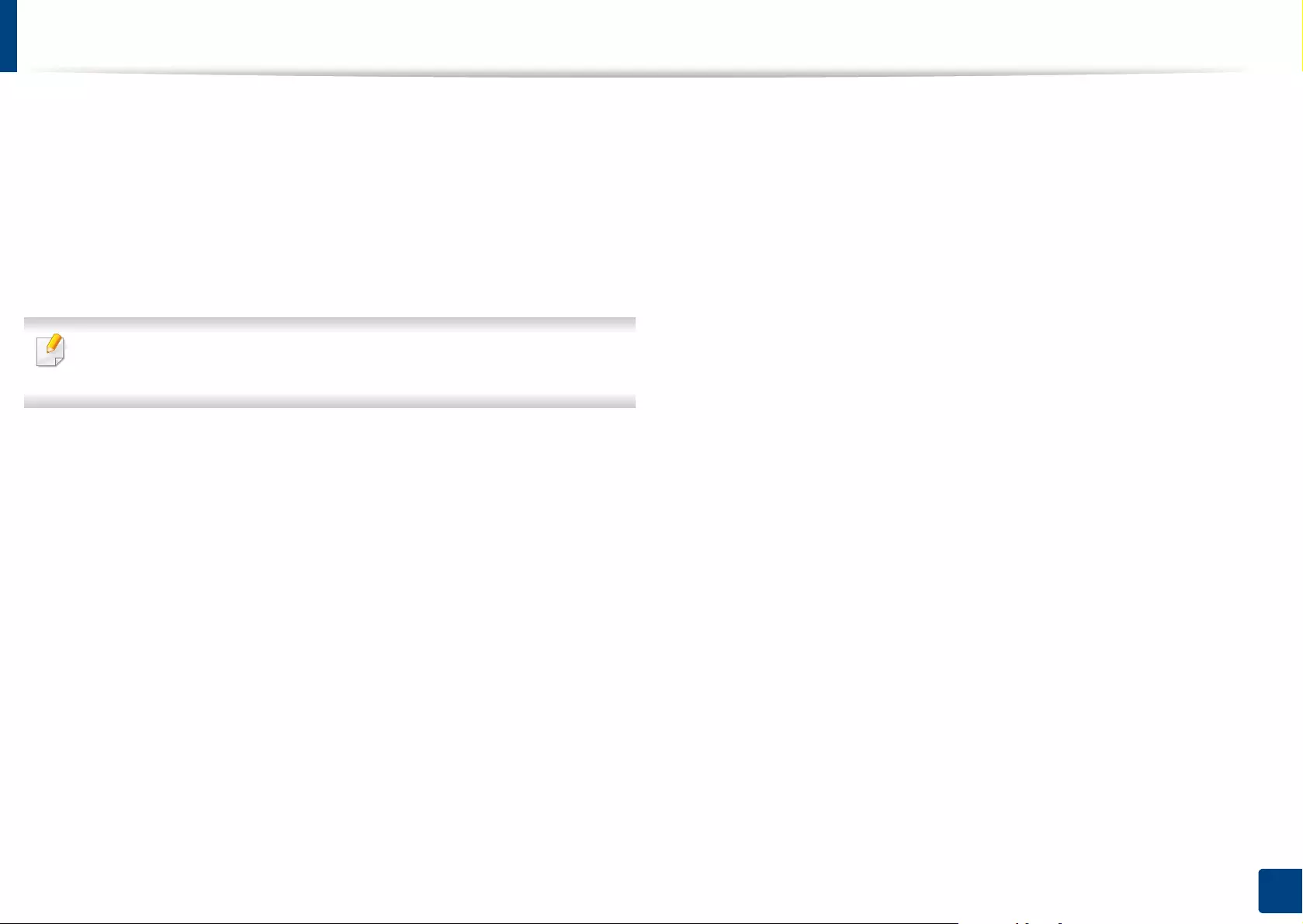
231
11. Using Shared Folder, Stored Document, and USB
Saving documents in the Stored Document
When you use a printing device in an office, school or other public place, you can
protect your personal documents or confidential information by using the
secure printing feature.
1Press Stored Document on the main screen.
2 Press Public or Private tab, then you can see the saved files.
If there is no file, you can save files from your PC (see "Print Mode" on page
103).
3 You can rename, delete or print files.
4 Select the document to print.
5 Enter the password that you set from the printer driver.
6 Print or delete the document.
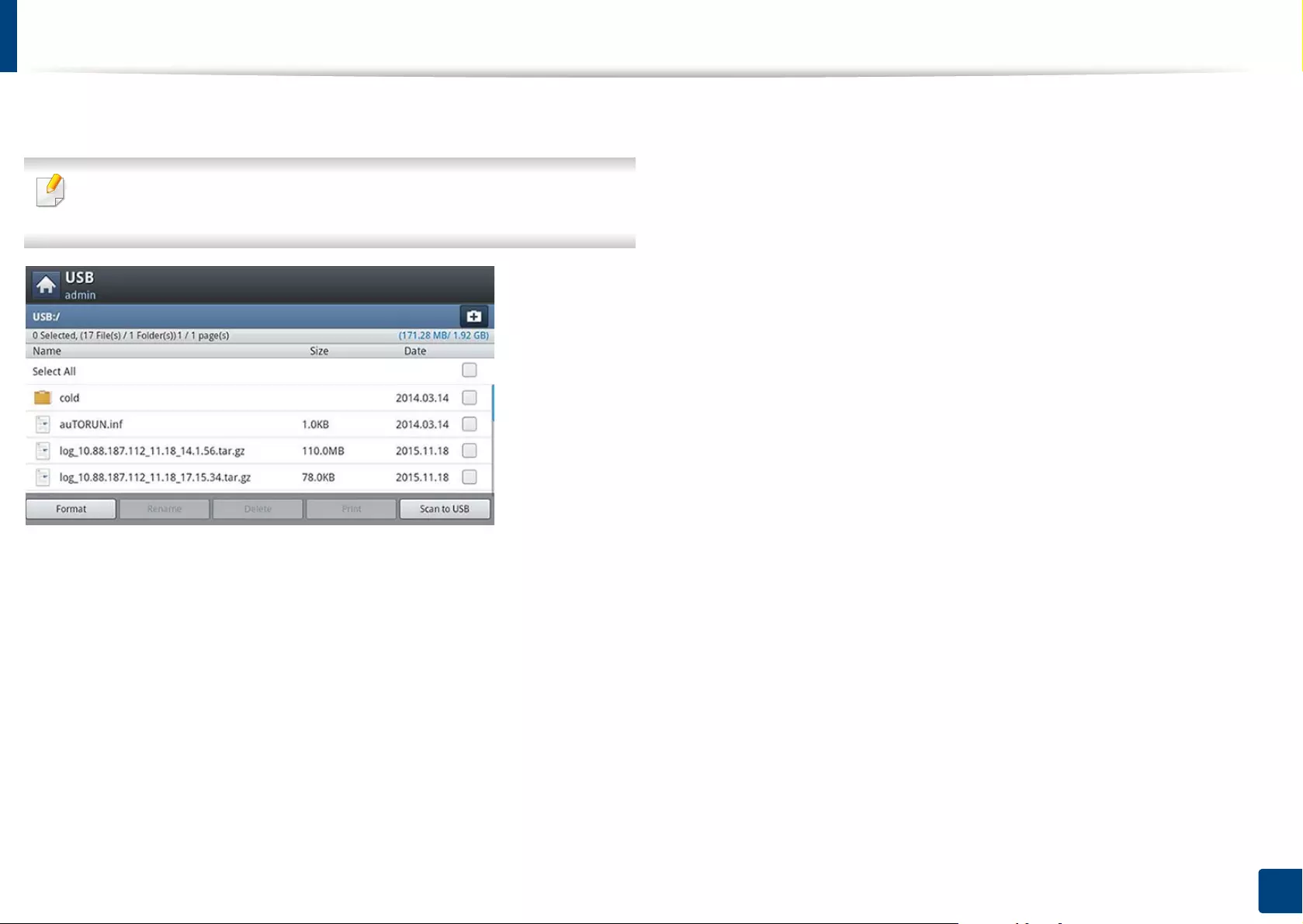
232
11. Using Shared Folder, Stored Document, and USB
Understanding the USB screen
To use the USB feature, press USB on the display screen.
If you want to use this feature, you need to insert a USB memory device into
the USB memory port on your machine.
•USB Display: Displays information of the folder or file.
•Format: Formats the USB memory device.
•Rename: Changes the name of the selected folder or file.
•Delete: Deletes the selected folder or file.
•Print: You can directly print files stored on a USB memory device. You can
print TIFF, JPEG, PDF, PRN and XPS files (see "Printing from a USB memory
device" on page 234).
•Scan to USB: Sends to Scan to USB (see "Scanning to a USB memory device"
on page 236).
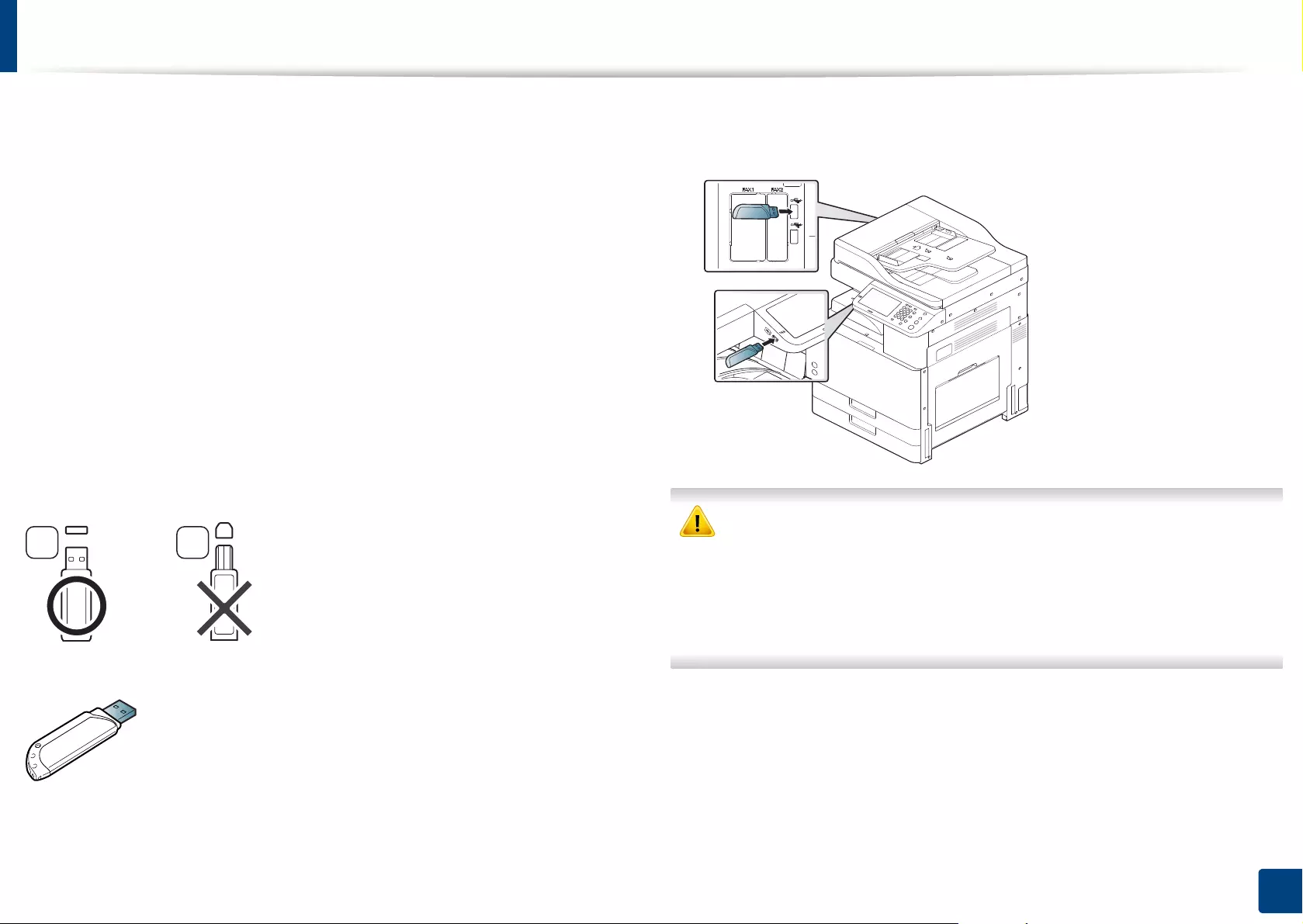
233
11. Using Shared Folder, Stored Document, and USB
About USB memory device
USB memory devices are available with a variety of memory capacities to give
you more room for storing documents, presentations, music and videos, high
resolution photographs, or whatever other files you want to store or move.
You can do the following on your machine using a USB memory device:
• Scan documents and save them on a USB memory device.
• Print data stored on a USB memory device.
• Format the USB memory device.
Your machine supports USB memory devices with FAT16/FAT32 and sector size
of 512 bytes.
Check your USB memory device’s file system from your dealer.
You must use only an authorized USB memory device with an A plug type
connector.
Use only a USB memory device with metal-shielded connector.
Only use a USB memory device that has obtained compatibility certification;
otherwise, the machine might not recognize it.
Insert a USB memory device into the USB memory port on your machine.
• Do not remove the USB memory device while it is in use. The machine
warranty does not cover damage caused by a user’s misuse.
• If your USB memory device has certain features, such as security settings
and password settings, your machine may not automatically detect it.
For details about these features, see the USB memory device’s User’s
Guide.
A B
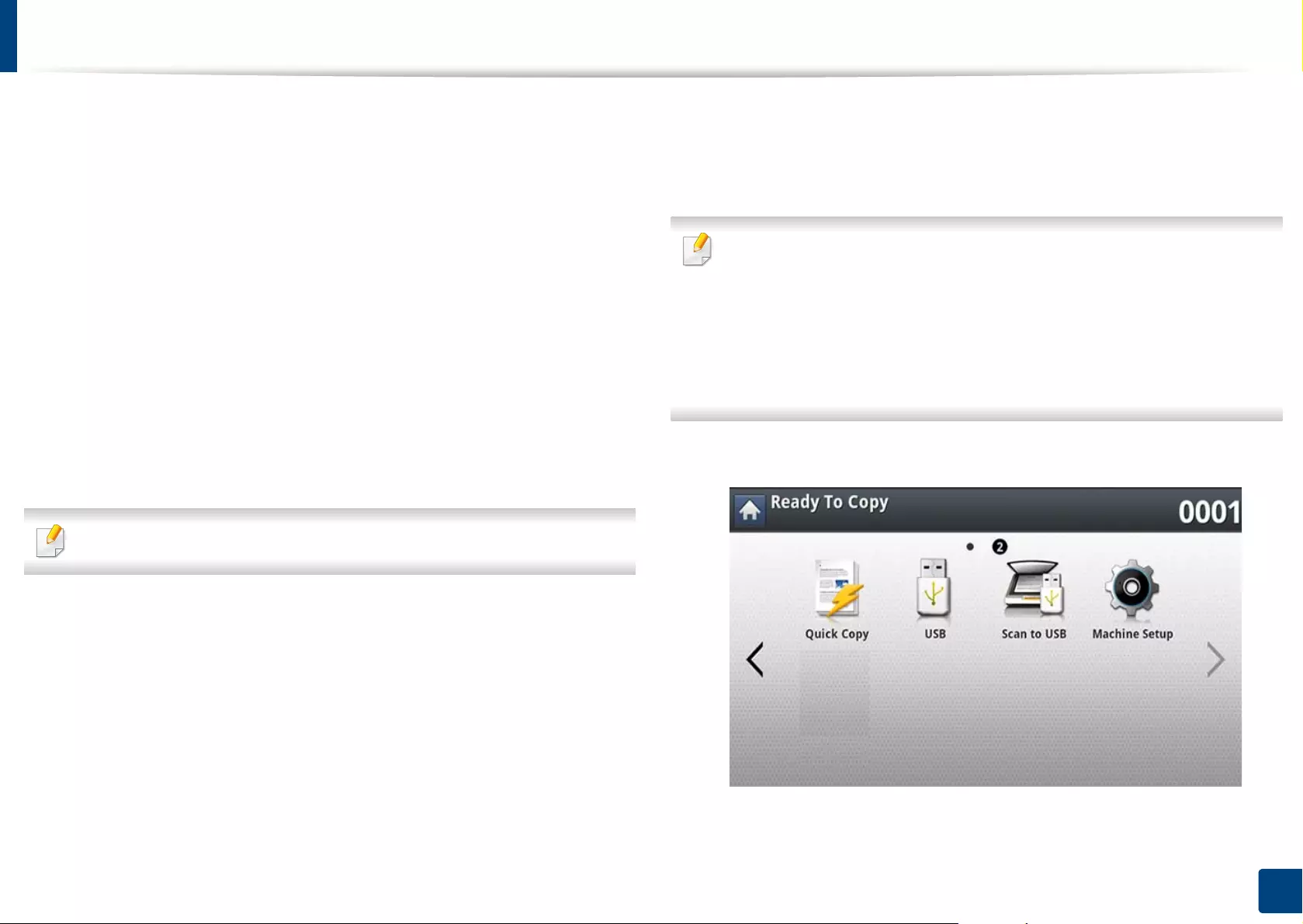
234
11. Using Shared Folder, Stored Document, and USB
Printing from a USB memory device
You can directly print files stored on a USB memory device. You can print TIFF,
JPEG, and PRN files. You can select 50 files and print selected the files at once.
USB print option supported file types:
•PRN: Only files created by provided driver with your machine are
compatible. PRN files can be created by selecting the Print to file check box
when you print a document. The document will be saved as a PRN file, rather
than printed on paper. Only PRN files created in this fashion can be printed
directly from USB memory device (see "Printing to a file (PRN)" on page 117).
•TIFF: TIFF 6.0 Baseline
•JPEG: JPEG Baseline
•PDF: PDF 1.7 and below
•XPS: Used to print files in XPS format.
In case of 8-bit CMYK JPEG files, the job could be cancelled.
To print a document from a USB memory device:
1Insert a USB memory device into the USB memory port on your machine.
Your machine automatically detects the device and reads data stored on
it (see "About USB memory device" on page 233).
• The machine cannot detect an unformatted USB memory device.
Format, and then reinsert the USB memory device into the USB memory
port on your machine.
• The machine can not detect the USB memory device when the machine
is in power save mode. Wait until the machine returns to ready mode,
and then reinsert the USB memory device into the USB memory port on
your machine.
2 Press USB from the display screen.
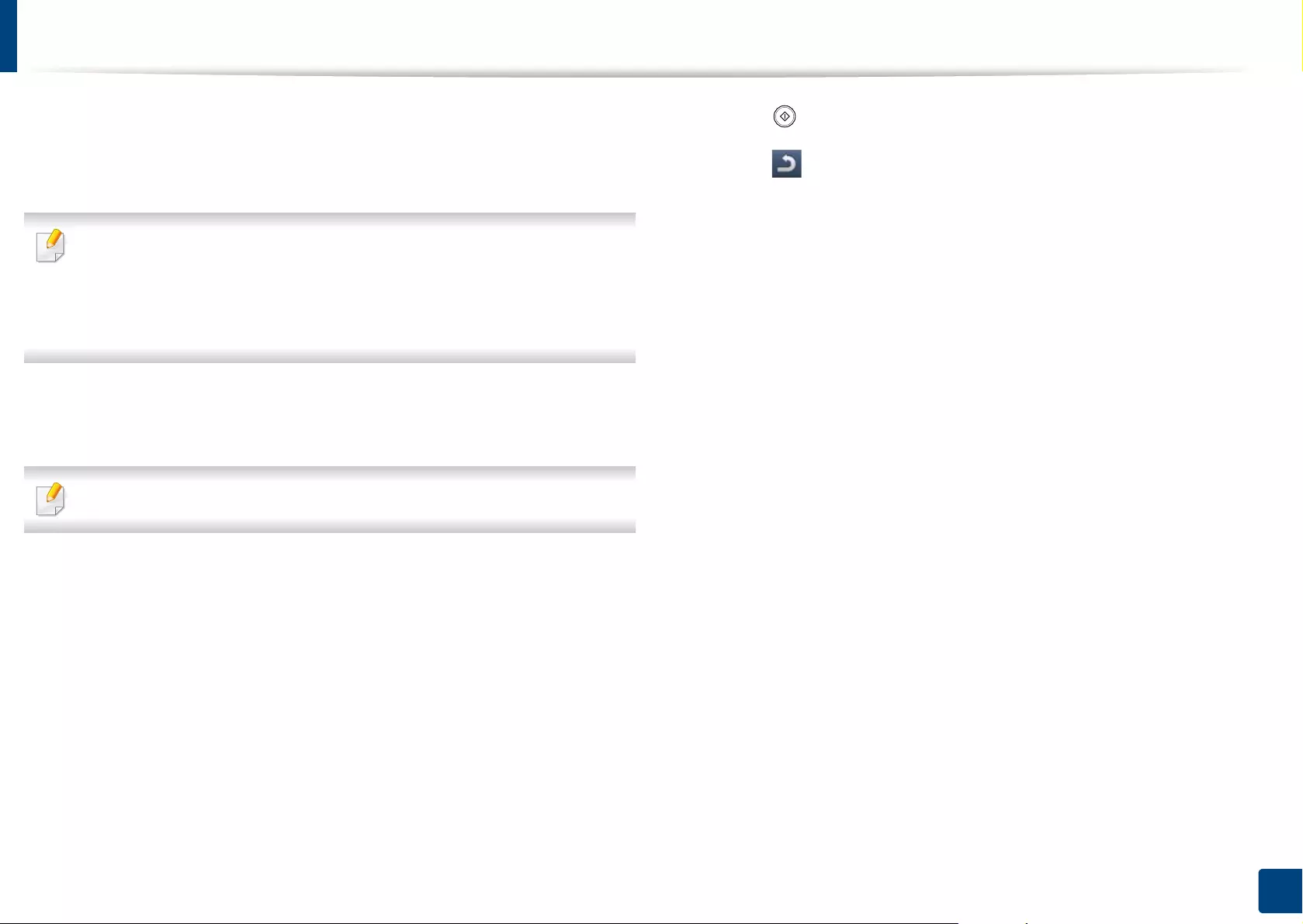
Printing from a USB memory device
235
11. Using Shared Folder, Stored Document, and USB
3 The machine shows all the files in the USB memory device.
Select the file you want to print. You can also select multiple files if you
want to print multiple files.
• If the file is in a folder, press the folder name. Then press Select.
• If the PDF file you selected is secured with a password, you have to know
the password for printing. Enter the password when the machine
requires the secure password. If you do not know the password, the print
job will be cancelled.
4 Press Print.
5 Press the appropriate option.
Some menus may not appear on the display screen.
•Copies: Selects the number of copies.
•Color Mode (X322x/ X328x series only): Selects the color mode of
copies.
•Duplex: Selects the machine to print copies on both sides of the
paper.
•Auto fit: Allows you to scale your print job to the selected paper size
in the tray regardless of the document size. Select a tray, and press
On.
•Paper Source: Selects a tray that contains the paper to be printed.
•Output: Sets the machine’s various output options such as copy
output option.
6 Press (Start) button to print the file.
7 Press (Back) to go back to the previous screen.
8 After printing is completed, you can remove the USB memory device
from the machine.
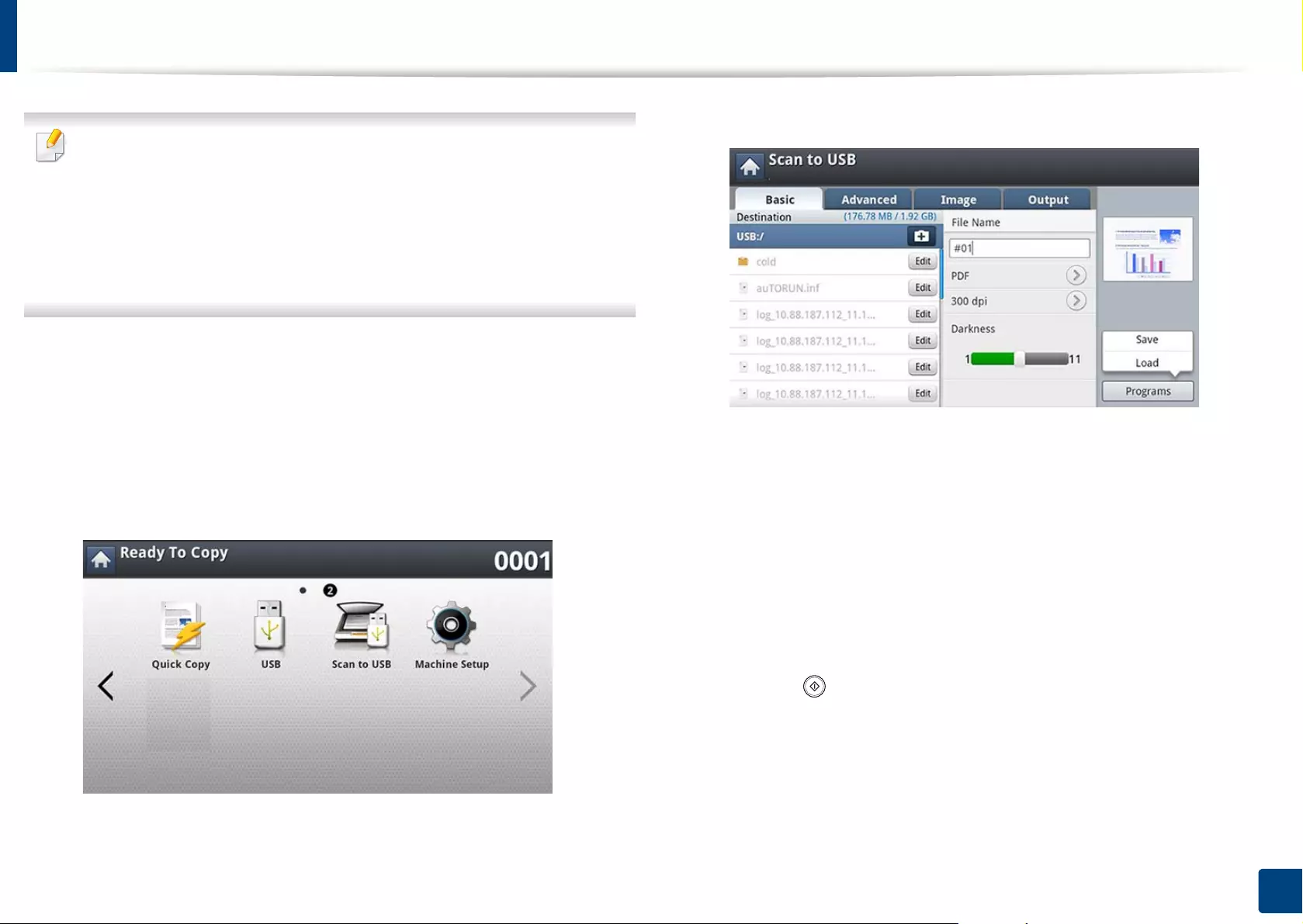
236
11. Using Shared Folder, Stored Document, and USB
Scanning to a USB memory device
• The machine cannot detect the unformatted USB memory device.
Format and then reinsert the USB memory device into the USB memory
port on your machine.
• The machine could not detect the USB memory device when the
machine is in power save mode. Wait until the machine returns to ready
mode, and then reinsert the USB memory device into the USB memory
port on your machine.
1Insert a USB memory device into the USB memory port on your machine.
2 Place the originals face up in the RADF or place a single original face
down on the scanner glass and close the RADF (see "Loading originals"
on page 72).
3 Press Scan to USB from the display screen.
4 Press the Basic tab.
5 Select a folder for storing the scanned image. If you do not select a folder,
the scanned image is stored in root directory.
6 Press the File Name input area. The pop-up keyboard appears.
7 Enter a file name to store the scan data. Press Done.
8 Set the File format, Resolution, and Darkness.
9 Set the scan features in the Advanced, Image, or Output tabs, if
necessary (see "Changing the scan feature settings" on page 162).
10 Press the (Start) button to scan and store the file.
If an original is placed on the scanner glass, the machine shows the
window asking if you want to place another page. Load another original
and press Yes. When you finish, press No on this window.
11 After scanning is complete, you can remove the USB memory device
from the machine.
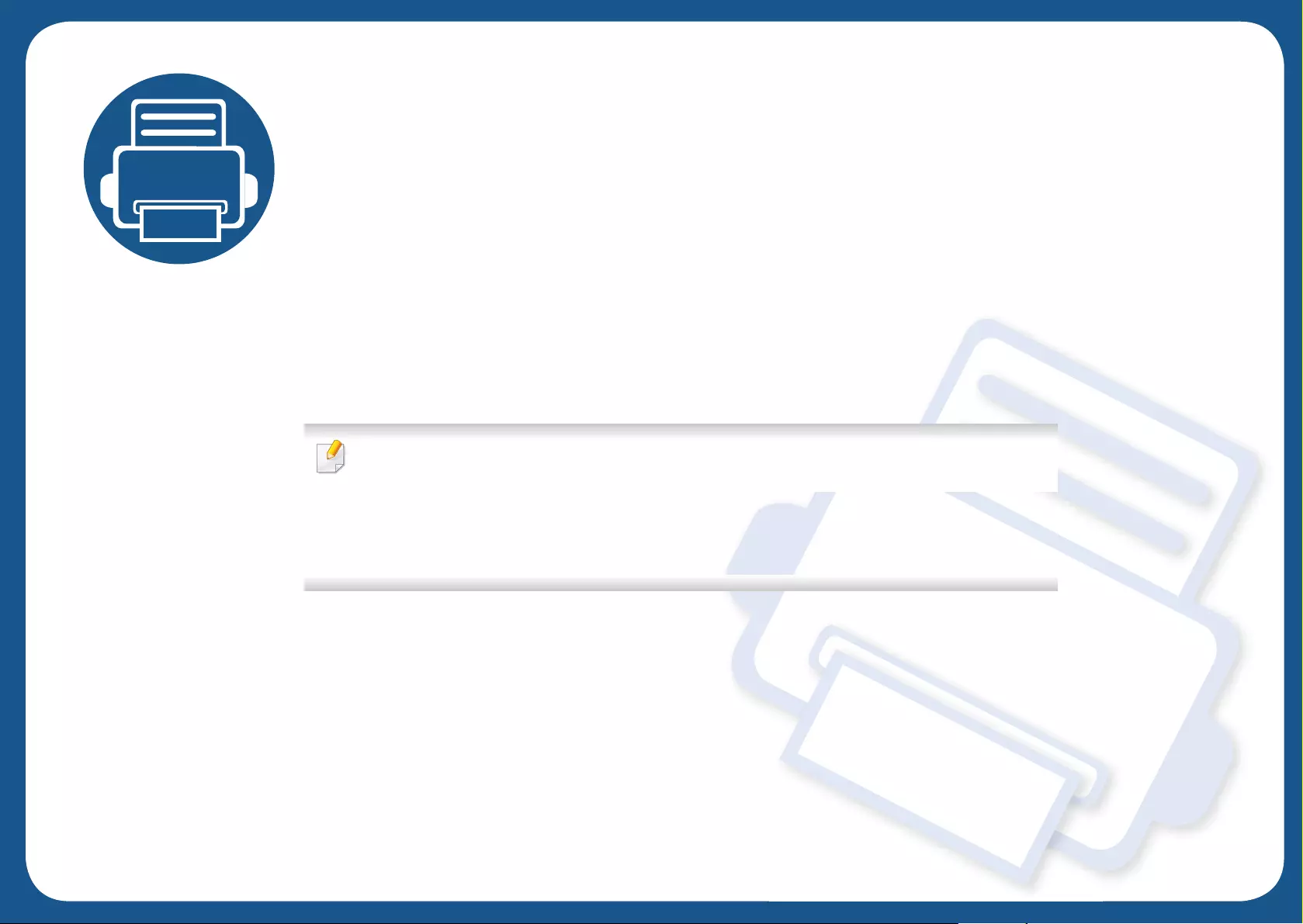
12.Menu Overview and
Advanced Features
This chapter shows an overview of menus provided by your machine and explains the Machine Setup menu in detail.
The Machine Setup menu provides various options for administrators to set in order to use the machine to its full
capabilities. Read this chapter carefully to understand the diverse features your machine provides.
• This administrator’s guide mainly describes features administrators would often use and
settings to set before using the machine.
• For some options, you need to contact your local service provider to set the settings.
• Some menus may not appear on the display screen depending on the settings or models. If
so, it is not applicable to your machine.
This chapter includes:
• Menu overview 238
• Machine setup 243
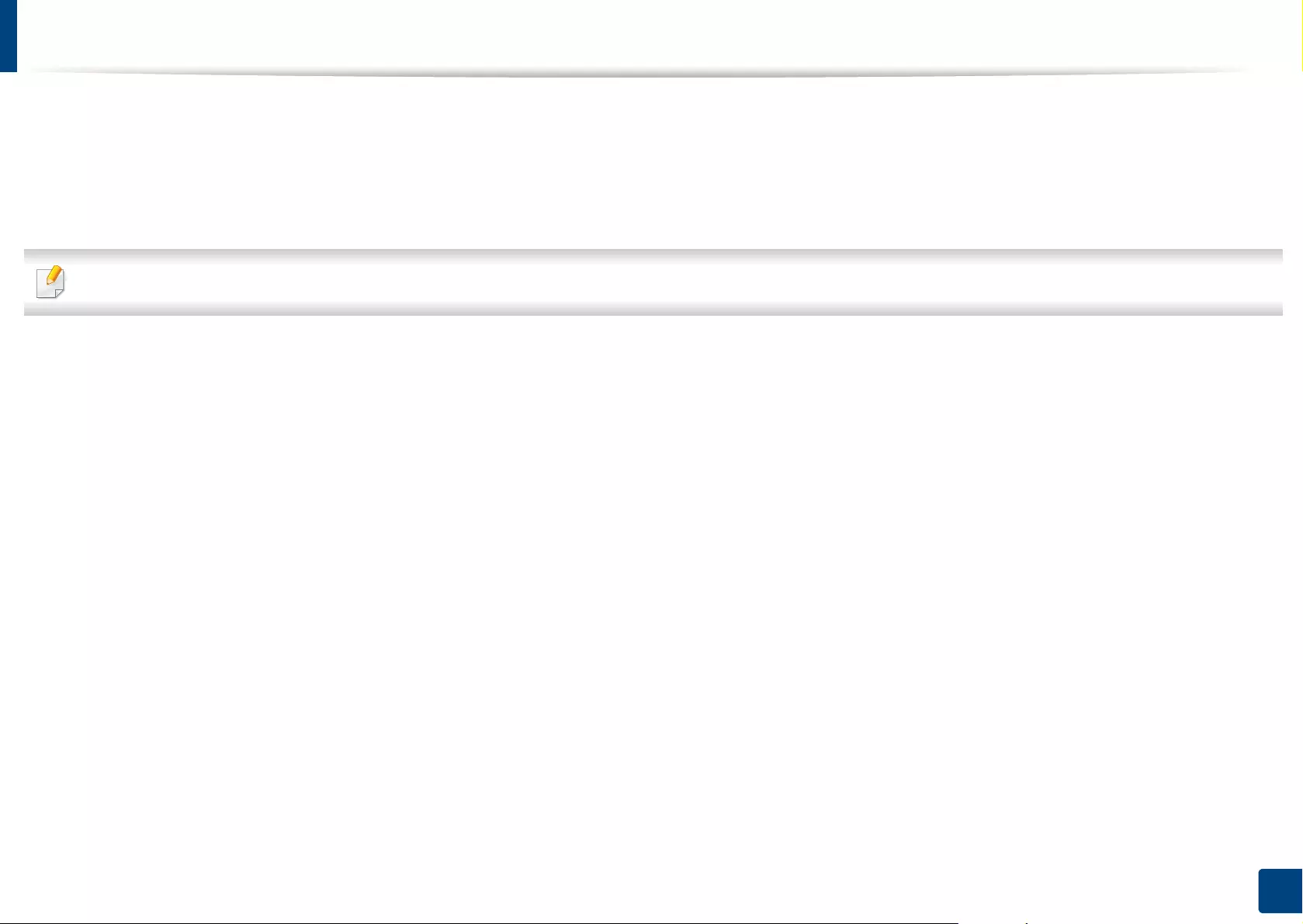
238
12. Menu Overview and Advanced Features
Menu overview
Your machine is equipped with various menus that will be useful for both users and administrators. With the menus, administrators can set the settings for the
machine or use the various features provided. You can access the menus by pressing the display screen on the control panel.
The following table shows the menus provided by your machine. Use the following table to view the menu structure. The menu column shows the main menu and
the option column shows its submenus.
Some menus may not appear on the display screen depending on the settings or models. If so, it is not applicable to your machine.
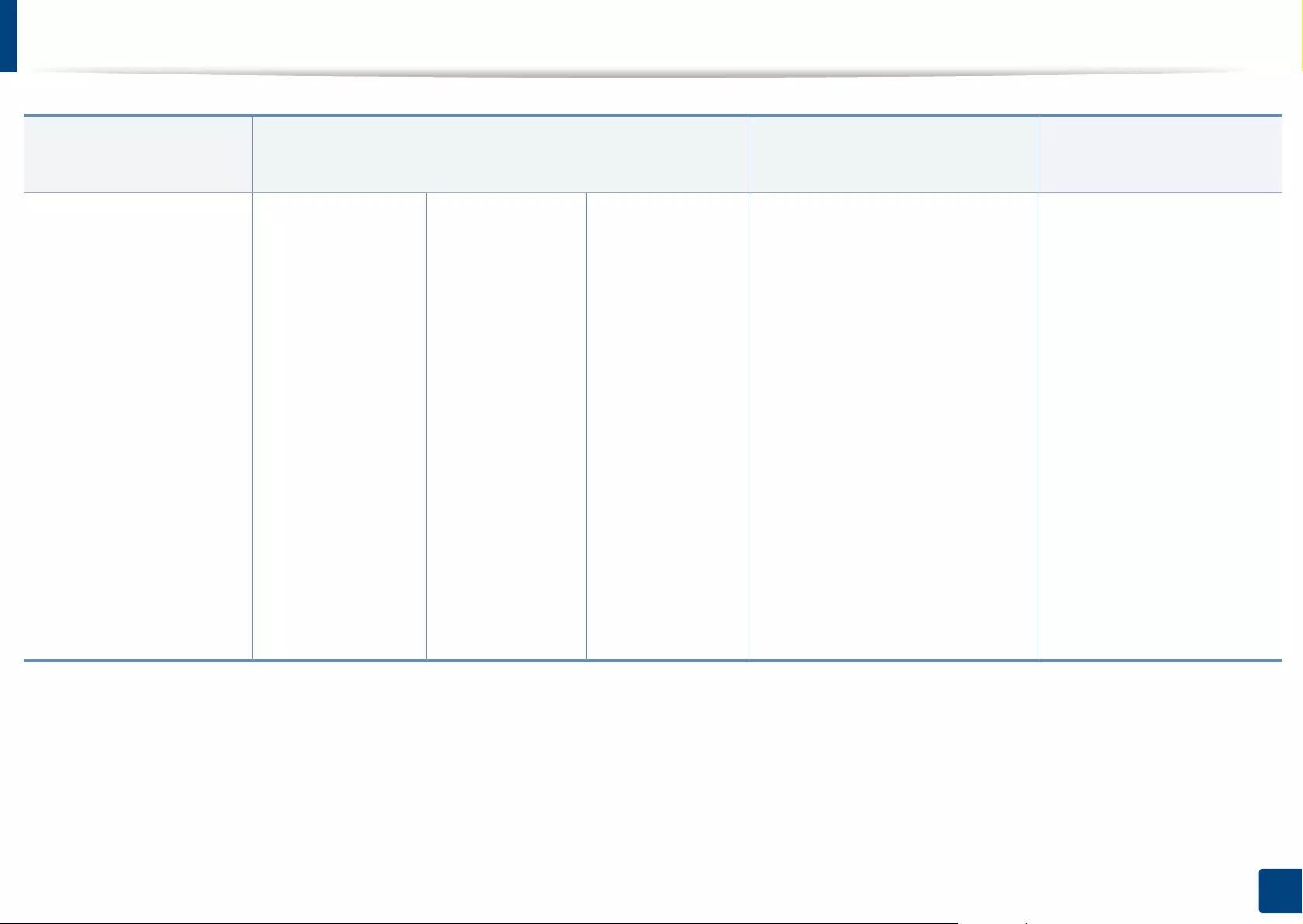
Menu overview
239
12. Menu Overview and Advanced Features
USBa
(see "Understanding the
USB screen" on page 232)
Copy
(see "Copying" on page 123)
Quick Copy
(see "Quick copying" on page 129)
Fax
(see "Faxing (Optional)" on
page 171)
Format
Rename
Delete
Print
Scan to USB
Basic
Paper Source
Reduce/Enlarge
Duplex
Color Mode
Output
Darkness
Programs
Advanced
Original Size
Original
Orientation
ID Copy
N-Up
Booklet
Book Copy
Watermark
Stamp
Build Job
Image
Original Type
Adjust
Background
Erase Backside
Image
Erase Edge
Copies
Paper Source
Reduce/Enlarge
Duplex / N-Up
Outputb
Color Modec
Original Orientation
Darkness
Basic
Direct Input
Resolution
Darkness
Address Book
Pause
Programs
Advanced
Original Size
Duplex
Original Orientation
Delay Send
Build Job
Image
Original Type
a. This option is available when the USB memory inserted.
b. Some menus are available when the optional finisher installed.
c. X322x/ X328x series only.

Menu overview
240
12. Menu Overview and Advanced Features
Scan to Email
(see "Scanning and sending through
email" on page 146)
Scan to PC (see "Scanning and
sending to your computer" on page
158)
Scan to Server (see "Scanning and
sending via SMB/FTP" on page 152)
Scan to Samsung Cloud (see "Scanning
and sending to Samsung Cloud Print"
on page 222)
Basic
Send to Me
File Name
File Format
Resolution
Darkness
Address Book
Programs
Advanced
Email Settings
Duplex
Original Size
Original
Orientation
Build Job
Image
Original Type
Color Mode
Adjust
Background
Erase Backside
Image
Scan to Edge
Output
Quality
File Format
Computers
Basic
Destination
Darkness
Resolution
Advanced
Duplex
Original Size
Original
Orientation
Build Job
Image
Original Type
Color Mode
Adjust
Background
Erase Backside
Image
Scan to Edge
Output
Quality
File Format
Basic
File Name
File Format
Resolution
Darkness
Address Book
Programs
Advanced
Duplex
Original Size
Original
Orientation
Build Job
Image
Original Type
Color Mode
Adjust
Background
Erase Backside
Image
Scan to Edge
Output
Quality
File Format
Basic
Recipient
Phone number
Sender
Information
File Name
Resolution
Darkness
Advanced
Duplex
Original Size
Original
Orientation
Build Job
Image
Original Type
Color Mode
Adjust
Background
Erase Backside
Image
Scan to Edge
Output
Quality
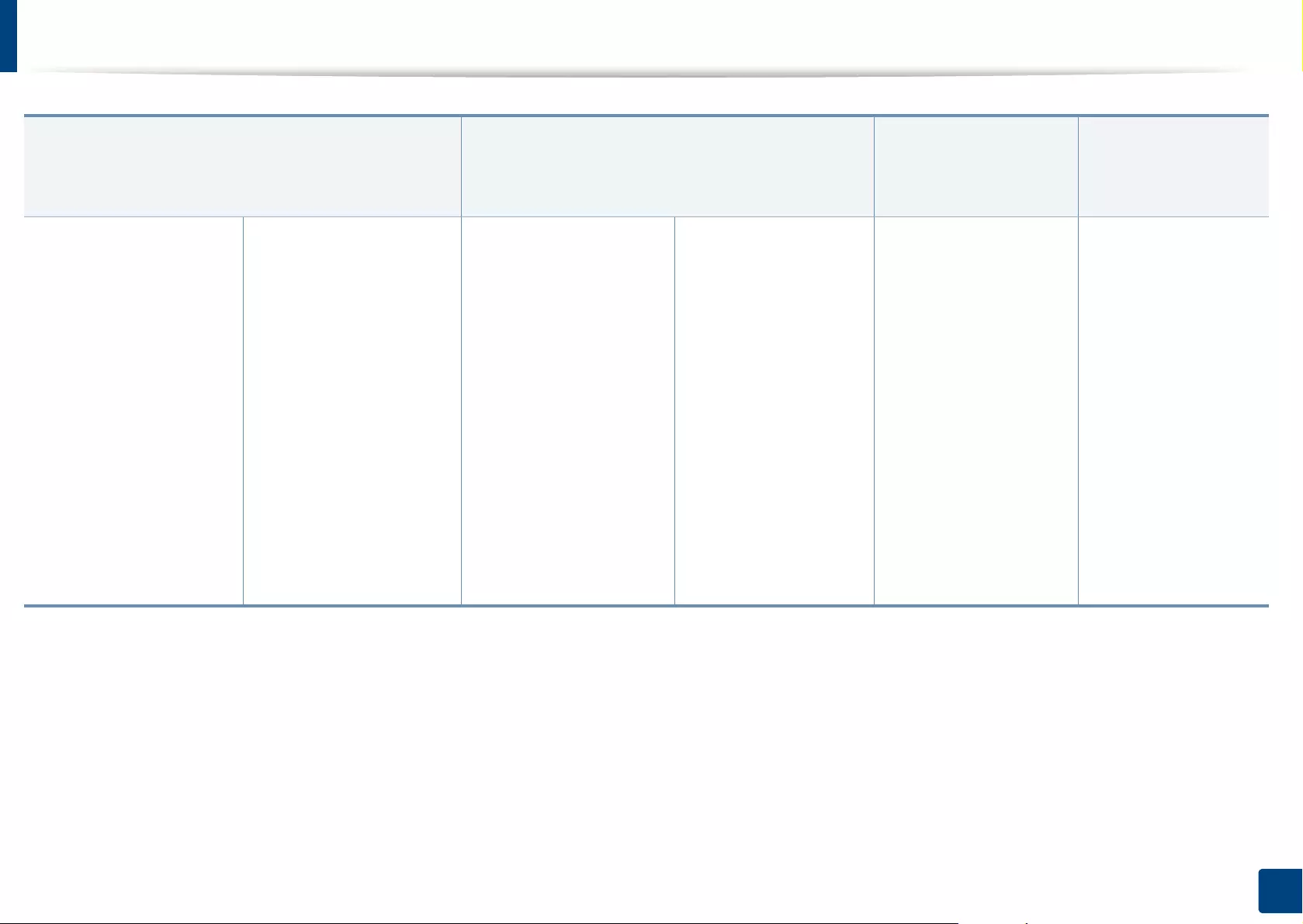
Menu overview
241
12. Menu Overview and Advanced Features
Scan to USBa
(see "Scanning to a USB memory device" on page 236)
Scan to Shared Folderb
(see "Scanning and sending to USB /shared folder"
on page 160)
Stored Document
(see "Understanding
the Stored Document
screen" on page 230)
Shared Folderb
(see "Understanding
the Shared Folder
screen" on page 228)
Basic
Edit
File Name
File Format
Resolution
Darkness
Programs
Advanced
Duplex
Original Size
Original Orientation
Build Job
Image
Original Type
Color Mode
Adjust Background
Erase Backside Image
Scan to Edge
Output
Quality
File Format
Filing Policy
Basic
Destination
File Name
File Format
Resolution
Darkness
Advanced
Duplex
Original Size
Original Orientation
Build Job
Image
Original Type
Color Mode
Adjust Background
Erase Backside
Image
Scan to Edge
Output
Quality
File Format
Filing Policy
Public
Private
Rename
Delete
Print
a. This option is available when the USB memory inserted.
b. This option is available when the mass storage device (hard disk) installed.
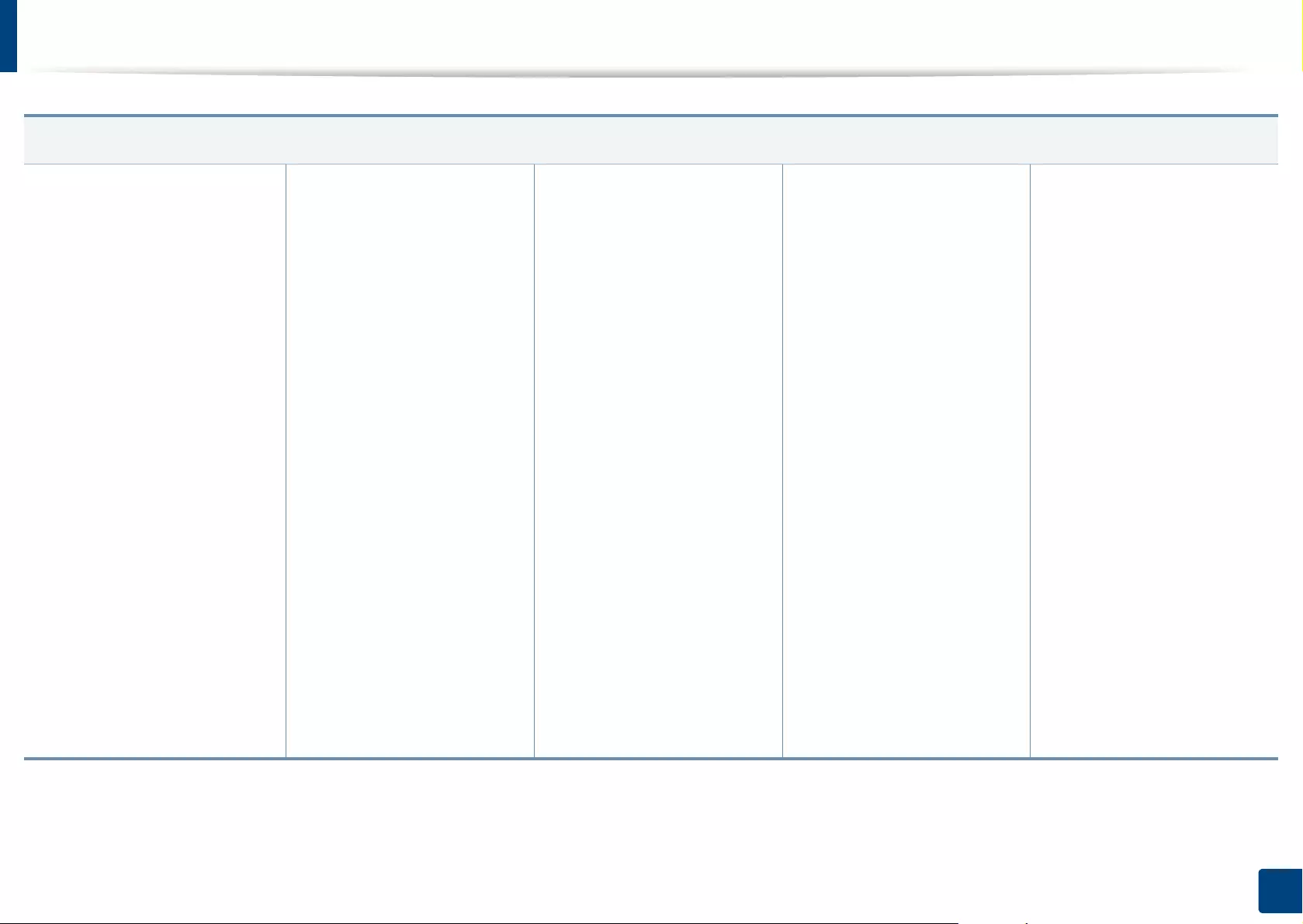
Menu overview
242
12. Menu Overview and Advanced Features
Machine Setup
If you have selected Security > Authentication, you need to log-in as an administrator (see "Security" on page 263).
Machine Details
H/W Configuration
Software Versions
Capabilities
QR Code
Tray Settings
Name
Paper Size
Paper Type
Settings
Eco Settings
Default Eco Mode
Eco Features Configuration
Application Settings
Copy Settings
Fax Settings
Scan to Email Settings
Scan to Server Settings
Scan to USB Settings
Scan to Samsung Cloud
Settings
Scan to Shared Folder
Settings
Address Book
Initial Settings
Print Settings
General
Skip Blank Pages
Emulation
Paper Source
Layout
Orientation
Duplex
No. Of Copies
Margin
Network Settings
TCP/IP
Samsung Cloud Print
PrinterOn
SNMPv1/v2
SNTP
UPnP(SSDP)
mDNS
SetIP
Print
SLP
Network Filtering
HTTP
Wi-Fia
Wi-Fi On/OFF
Wi-Fi Settings
WPS
Wi-Fi Direct
Wi-Fi Signal
Clear Wi-Fi Settings
NFCa
Clear Setting
Security
Image Overwriteb
Authentication
IPSec
802.1x
Accounting
HTTPS
Others
Supplies Life
Contact Information
Report
Application Management
Language
a. This option is available when the optional Wireless/NFC kit installed.
b. This option is available when the mass storage device (hard disk) installed.
General Settings
Date and Time
Power Saver
Timers
Altitude Adjustment
Default Paper Size
PDF
PDF Format
Compact
Supplies Management
Imaging Unit Reorder
Notification
Toner Cartridge
Reorder Notification
Toner Save
Sound
Key Sound
Alarm Sound
Fax Sound
Measurements
Image Management
Auto Color
Registrationc
Color Simulationc
Custom Color
Tone Adjustment
c. X322x/ X328x series only.
Machine Test
Print Adjustment
Home Setting
Default Home Screen
Home Window
Priority
Home Window
Background
Out of Stapled
Continue Job
Hold Job
Stamp
Job Progress Window
Job Rescheduling
Auto Original Detection
Failure
Smart Duplex
Logout Confirmation
Show error animation
immediately
Humidity
d. This option is available when the optional finisher installed.
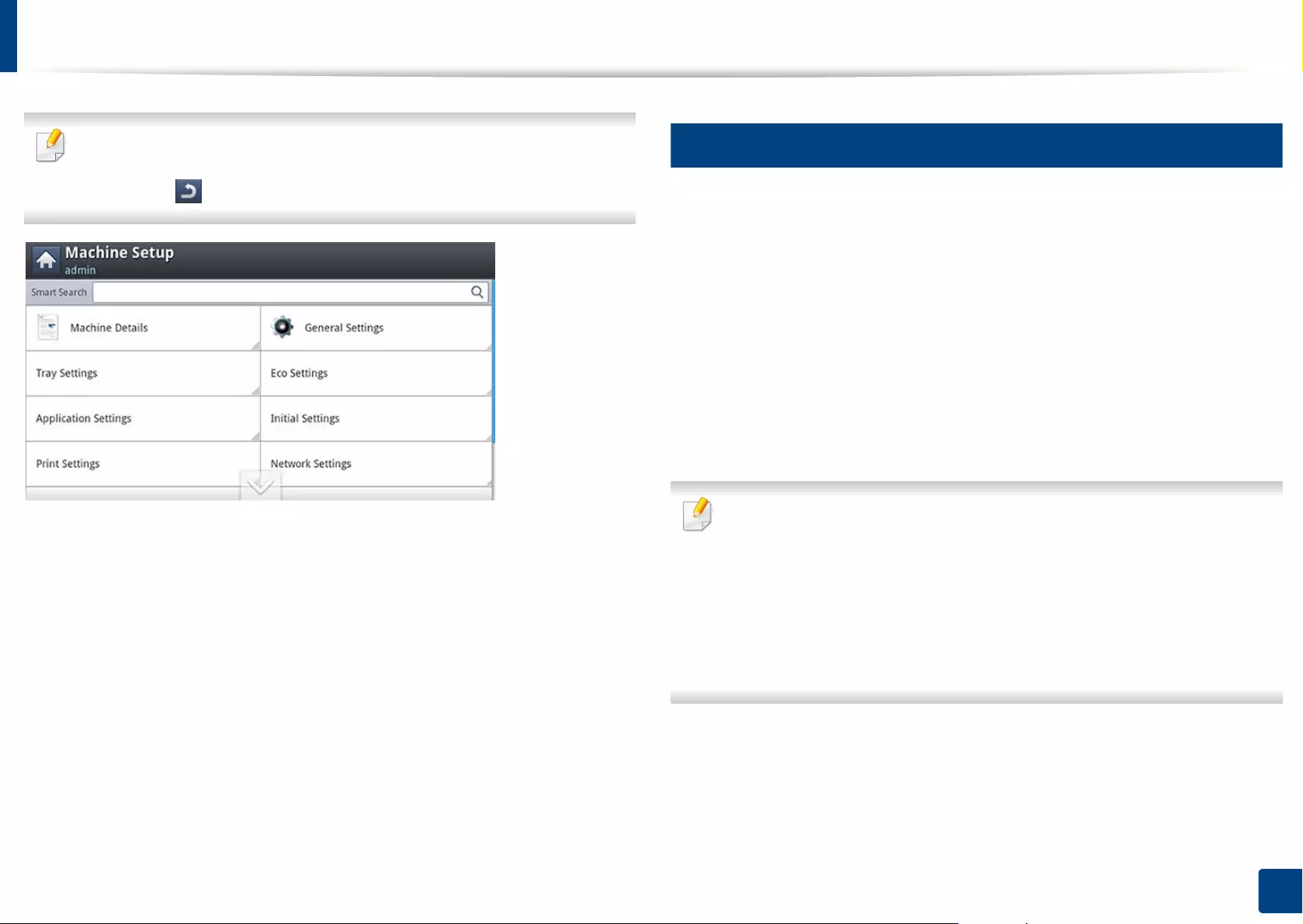
243
12. Menu Overview and Advanced Features
Machine setup
• Some options are only available to the administrator depending on the
authentication settings selected (see "Security" on page 263).
• Press the (Back) button if you want to return to the previous screen.
1
Log-in
Depending on the authentication settings you selected, you may need to log-in
as an administrator to access some options under Machine Setup menu (see
"Security" on page 263).
1Press Machine Setup from the display screen.
2 Select the option you want. If the option is available for only the
administrator, the following screen appears.
Enter the ID, Password, and Domain using the pop-up keyboard which
appears when you press each field.
• Enter the ID
and password you first set when you turned on the machine:
Initial
Settings
(see "Initial Settings" on page 261).
•The default ID is admin.
• You can also use the Recent Users button to find the recently used ID
and Domain List button to find the domain from the list stored in the
machine.
• When you log-in, you can see the ID of the logged in user on the display.
3 Press OK.
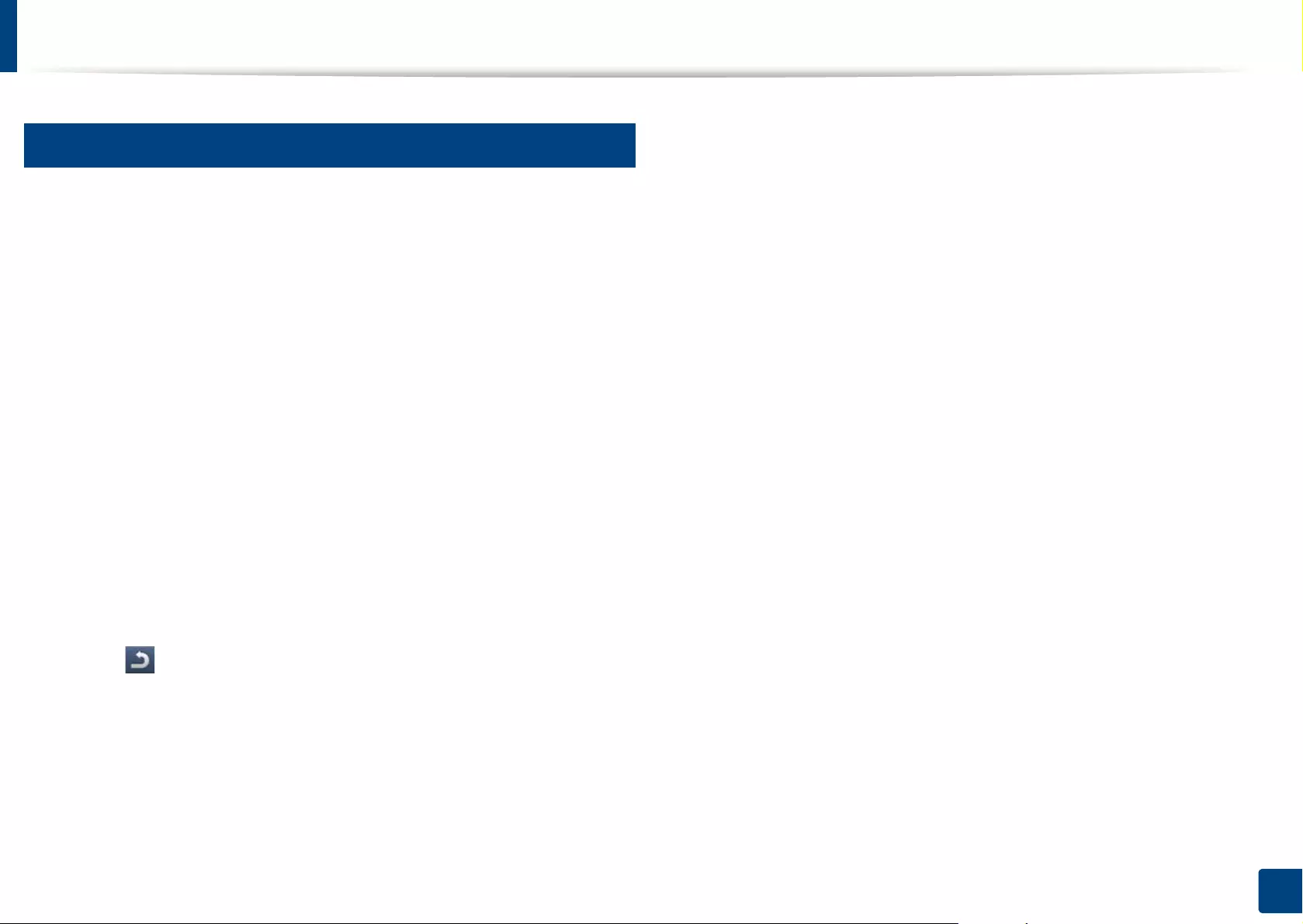
Machine setup
244
12. Menu Overview and Advanced Features
2
Machine Details
You can check the detailed machine information. Check the status of installed
hardware and software versions to help you maintain the machine. You can
download the latest software from the Samsung website.
1Press Machine Setup > Machine Details from the display screen.
2 Press the option you want.
•H/W Configuration: Shows the status of installed hardware
including optional parts.
•Software Versions: Shows the software versions of the systems
installed.
•Capabilities: Shows the capabilities of the hardware.
•QR Code: You can scan the QR code on the screen with your
smartphone or tablet to see information about the printer. You can
also use the QR code to register the printer in Samsung Cloud Print.
3 Press (Back) for return to the previous screen.
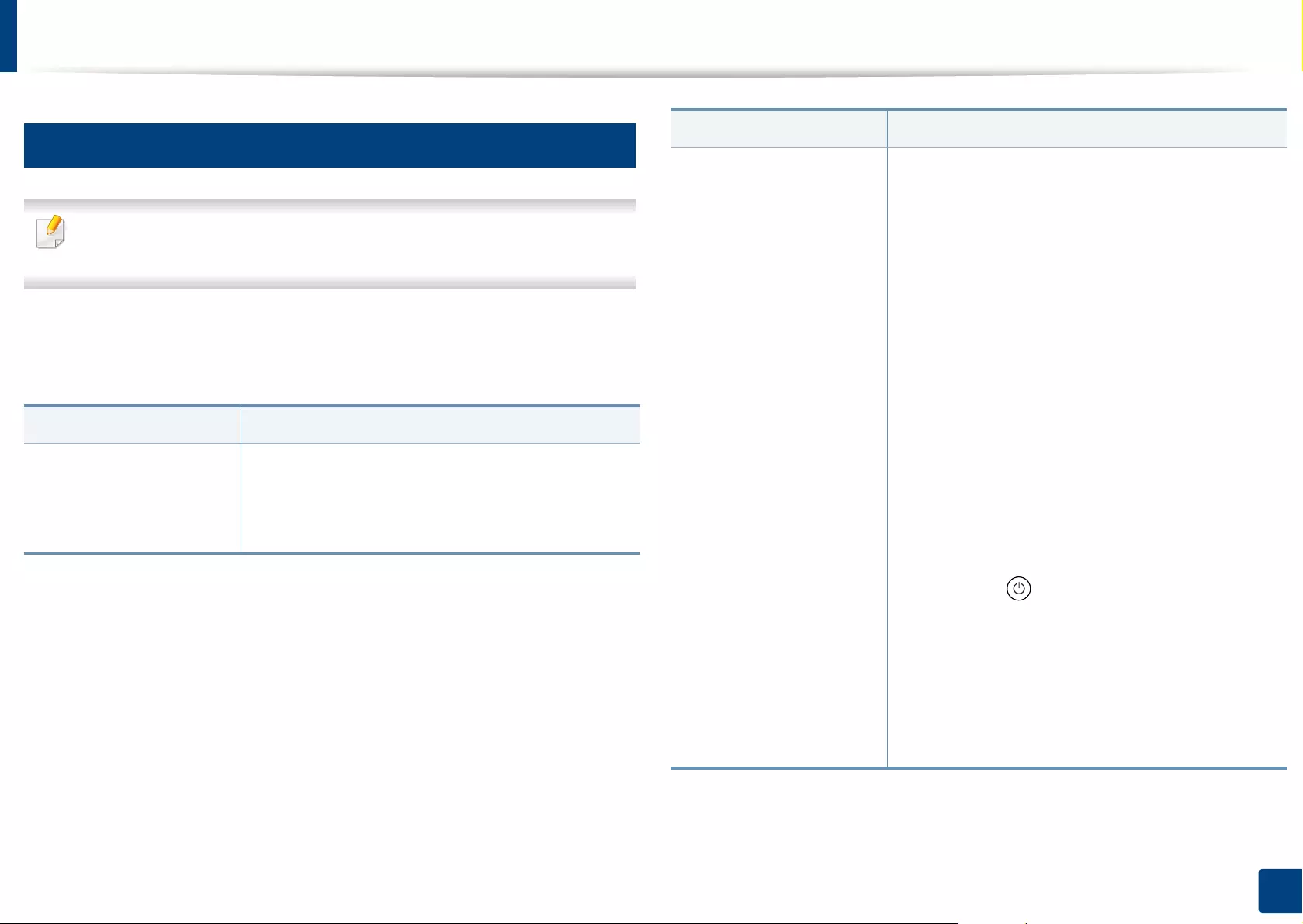
Machine setup
245
12. Menu Overview and Advanced Features
3
General Settings
Some menus may differ from your machine depending on its options or
models.
Before using the machine, set up the general settings, as follows:
Press Machine Setup > General Settings from the display screen.
Feature Description
Date and TimeaAllows you to set the date and time. The date and
time you set in this option will be used for sending/
printing delayed fax/print jobs or will be printed on
reports.
Power Saver Allows you to reduce energy consumption. If you set
this option, the machine goes into power saving
mode when not in use.
•Power Save: When you are not using the
machine for a while, use this option to save
power. The machine conserves more power in
Power Save option than in Low Power Save
mode.
•Low Power Save: Low Power Save option
allows your machine to save power. When you
are not using the machine for a while, some parts
of the machine automatically enter Low Power
Save option. Low Power Save option conserves
less power than Power Save option.
•Performance Optimization: When this option is
On, you can wake up the machine from the
power saving mode with the following actions:
-Pressing (Power/Wakeup)on the control
panel.
- Loading paper in a tray.
- Opening or closing the door.
- Pulling a tray out or pushing a tray in.
- Place the originals in the RADF.
- Plug in the USB Drive device.
Feature Description
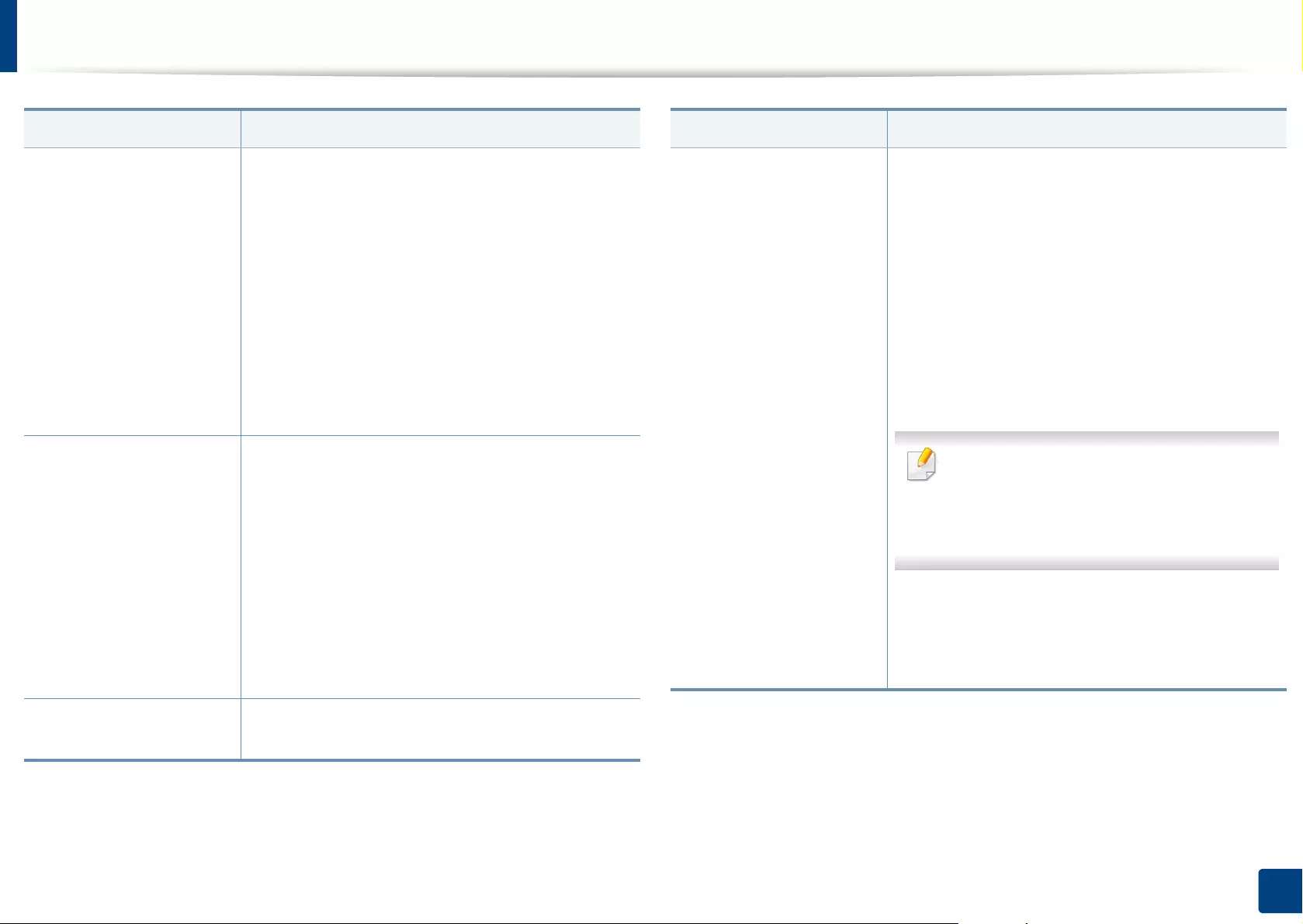
Machine setup
246
12. Menu Overview and Advanced Features
Timers When there is no input for a certain period of time,
the machine cancels the held job or exits the current
menu and goes in to the default settings. You can set
the amount of time the machine will wait before it
cancels a held job or exits the current menu.
•System Timeout: The machine returns to the
Copy menu if there is no input for the given time.
•Held Job Timeout: When an error occurs while
printing and there is no signal from the
computer, the machine holds a job for a specific
time period before deleting it.
Altitude Adjustment Allows you to choose the altitude your machine is
placed in. Print quality is affected by atmospheric
pressure. The atmospheric pressure is determined
by the height of the machine above sea level.
•Normal: 0-1,000 m (3,280 ft)
•High 1: 1,000 m (3,280 ft)-2,000 m (6,561 ft)
•High 2: 2,000 m (6,561 ft)-3,000m (9,842 ft)
•High 3: 3,000 m (9,842 ft)-4,000 m (13,123 ft)
•High 4: 4,000 m (13,123 ft)-5,000 m (16,404 ft)
Default Paper Size Allows you to choose the default paper size (A4 or
Ltr).
Feature Description
PDF Allows you to select the PDF format. If you select
PDF/A, you can create a PDF file that can be
displayed exactly the same way regardless of where
the file is opened. and you can use Compact
function.
•PDF Format
-Standard: Saves the data as a regular PDF.
-PDF/A: Saves the data as a PDF that has the
necessary information to render itself in any
environment.
A PDF/A file must be self-contained: it
cannot rely on another application to render
fonts, open hyperlinks, or execute scripts,
audio files, or video files.
•Compact
-On: You can get smaller PDF file size than
standard PDF file.
-Off: You can turn off this function.
Feature Description
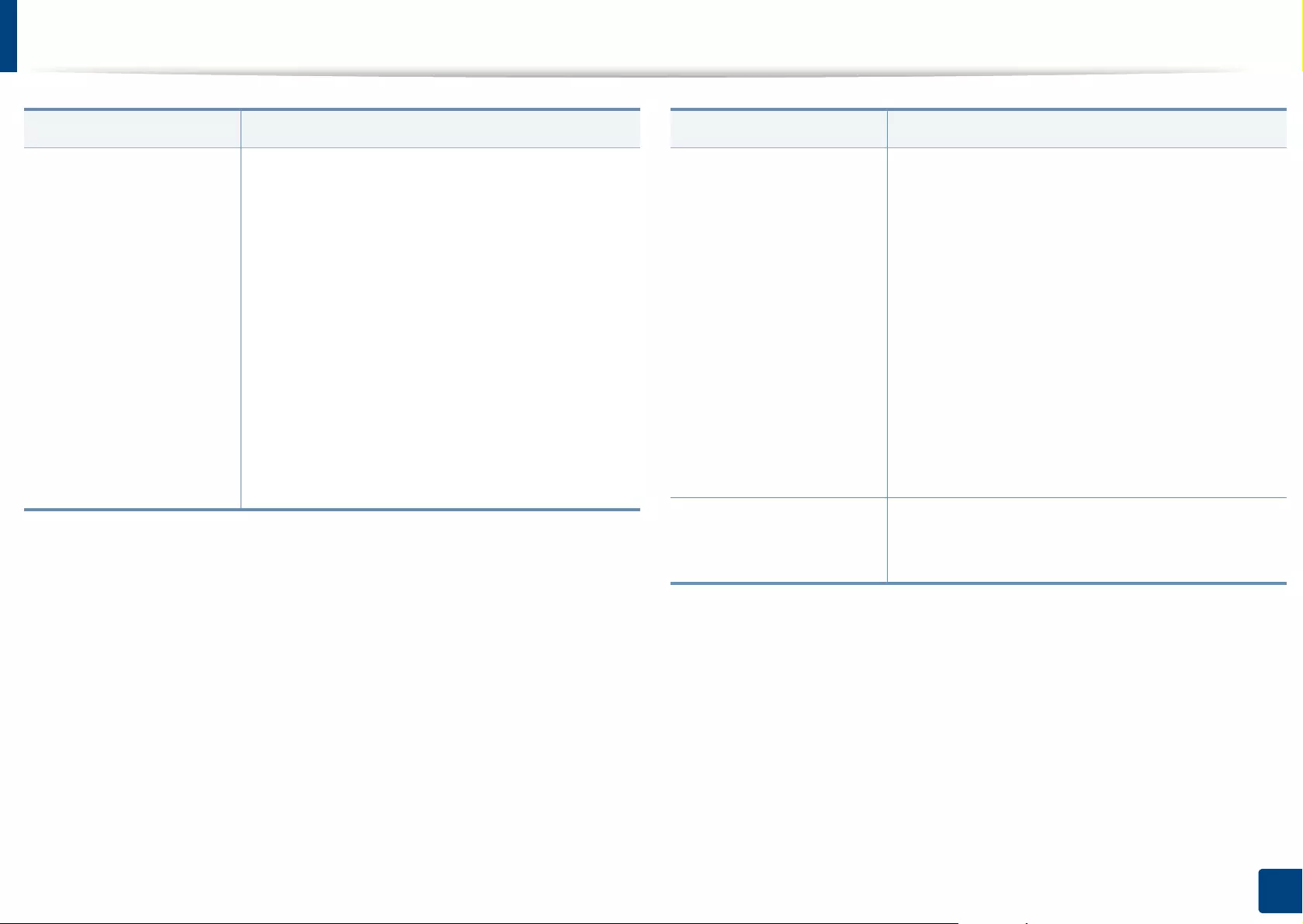
Machine setup
247
12. Menu Overview and Advanced Features
Supplies Management Allows you to set options for supplies reorder
notification. If you set this option, the machine will
display a warning message when the supplies are
running out. Prepare the supplies in advance.
•Imaging Unit Reorder Notification: Issues a
notification when a Imaging unit has the
specified lifespan remaining.
•Toner Cartridge Reorder Notification: Issues a
notification when a toner cartridge has the
specified lifespan remaining.
•Toner Save: Activating this mode extends the
life of your toner cartridge and reduces your cost
per page beyond what one would experience in
the normal mode, but it reduces print quality.
Feature Description
Sound Allows you to set the volume for button sound,
notice alarm, and sounds occurring during fax job.
You can test the volume right after you set the level.
Using the Quiet/Loud buttons select the desired
volume and press the Test button to test the
volume.
•Key Sound: Allows you to adjust the sound
volume for when pressing the button
•Fax Sound: Allows you to adjust the sound
volume occurring during a fax job. This option
has other sub-options.
•Alarm Sound: Allows you to adjust the sound
volume for when notice alarm.
Measurements Allows you to choose the measuring unit (mm or
inch) and set the numeric separation (comma or
period) for thousands separator.
Feature Description
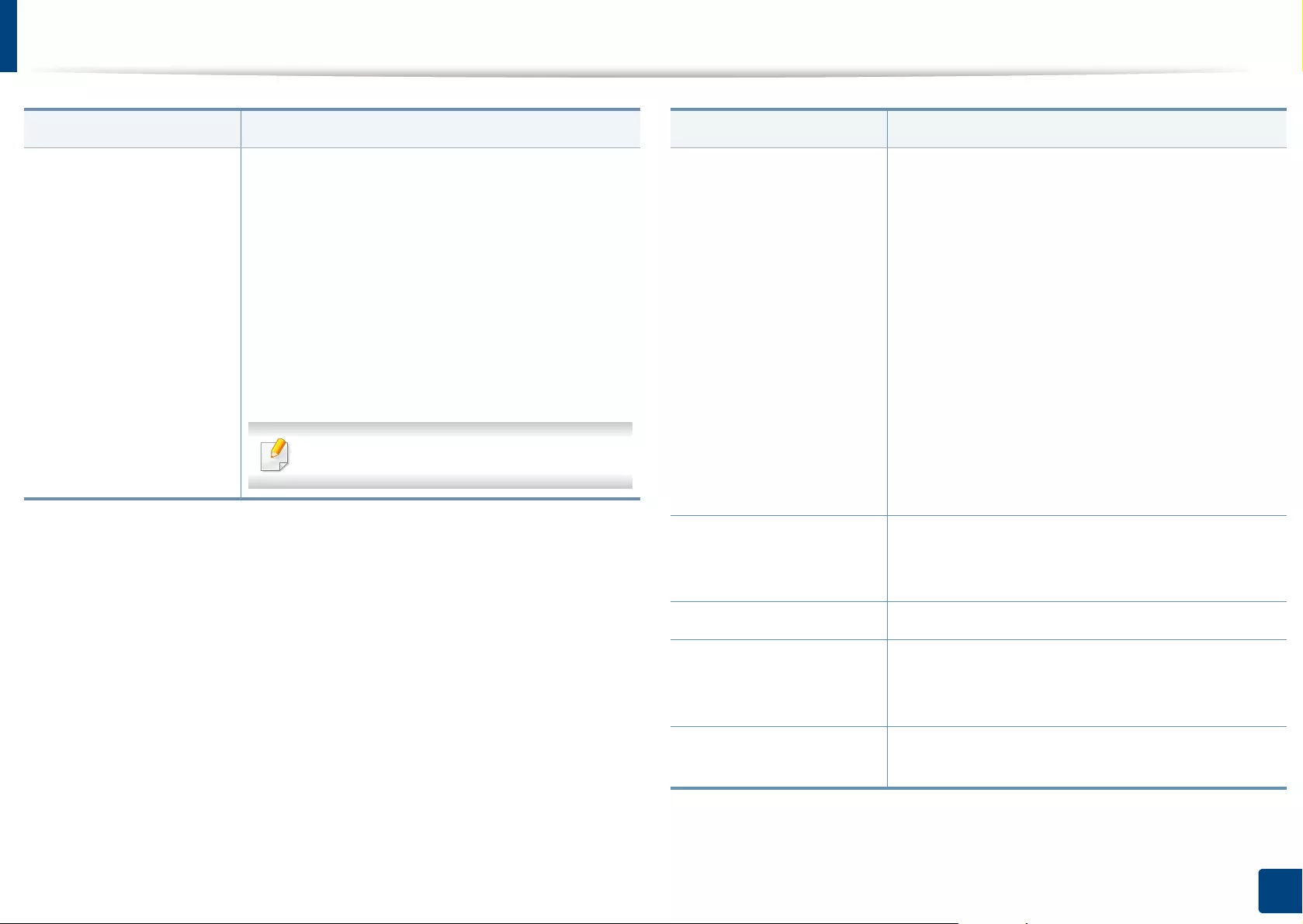
Machine setup
248
12. Menu Overview and Advanced Features
Machine Test •Print Adjustment: Allows you to adjust the print
area. When images are printed off the page or
shifted, adjust the print area.
1
Press
Print Adjustment
from the display screen.
2
Press
Paper Source
and select the tray to supply
the paper from.
3
Press
Paper Size
and select the paper size to use.
4
Press
Print
. The adjustment pattern (chart) is
printed.
5
Press
Next
and follow the instruction on the screen.
The
Next
button is enabled after you press
Print
.
Feature Description
Home Setting Allows you to choose the menu order of the Home
window.
•Home Window: You can select the menus to be
appeared on the Home screen. Select the menu
and press Enable and OK.
•Priority : You can select the order of the home
window menus. Select the Application you want
to move up/down and press the Up/Down
buttons.
•Home Window Background : You can select the
order of the home window background.
•Default Home Screen: The default settings are
used unless they are changed by using the Home
window.
Stamp Allows you to apply the stamp feature, prints the
time and date, IP address, or user ID, on the copy
output.
Job Progress Window Allows you to show job progress in display.
Job Rescheduling Job Rescheduling allows the machine to proceed
to the next job when the current job pauses due to a
paper mismatch or paper empty error.
Image Management Allows you to manage the color settings including
copy darkness, and print density.
Feature Description
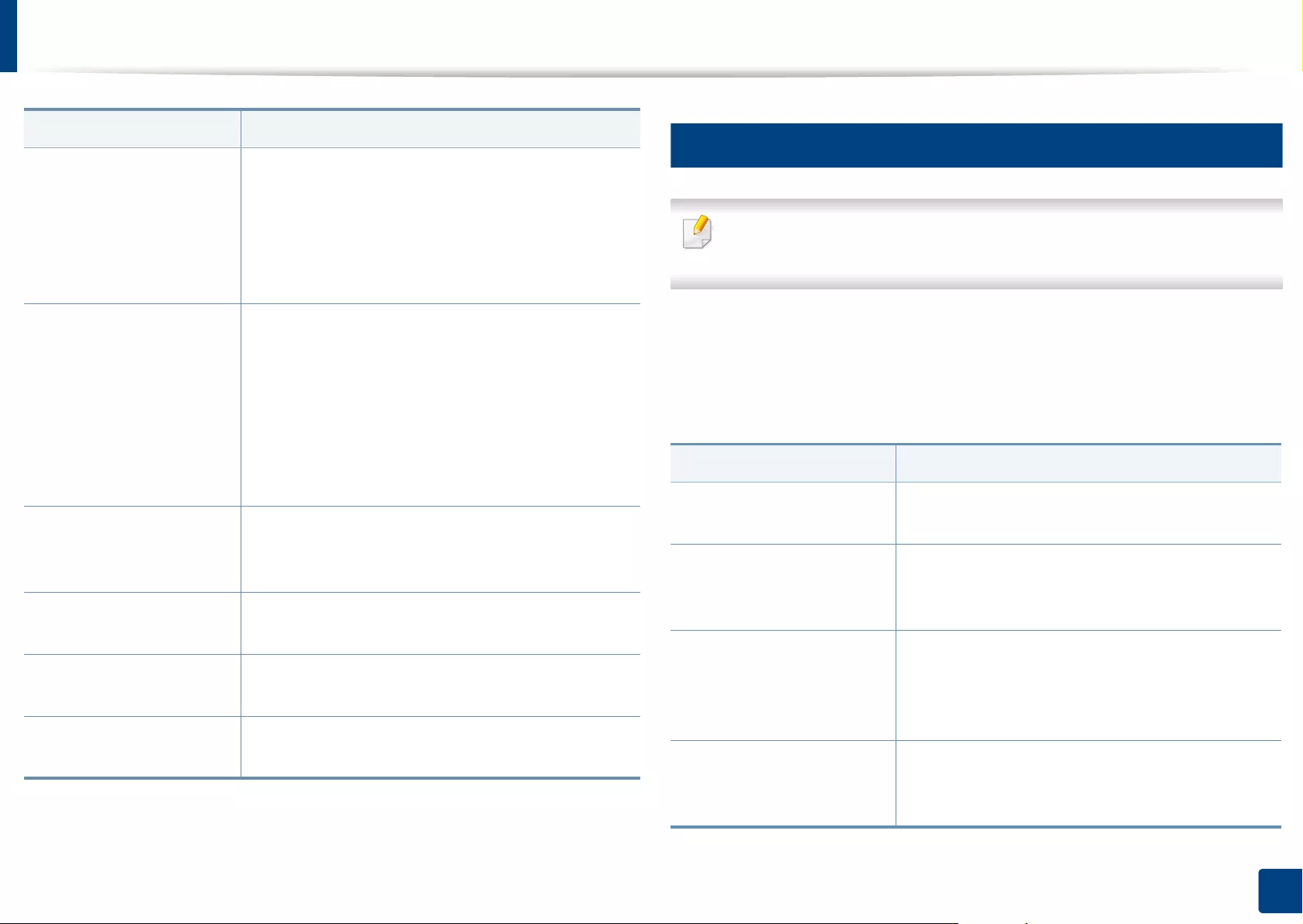
Machine setup
249
12. Menu Overview and Advanced Features
4
Other settings
Some menus may differ from your machine depending on its options or
models.
Press Machine Setup from the display screen.
OR
Press Machine Setup > Others from the display screen.
Out of StaplebDetermines what the machine does when the staple
cartridge is empty.
•Continue Job: Continues to process the job even
if there are no staples.
•Hold Job: Stops processing the job. The job
resumes after you have refilled the staple
cartridge.
Auto Original Detection
Failure
Determines what the machine does when it fails to
automatically detect the size of the original.
•Default Paper Size: Copies documents in the
default paper size (A4 or Ltr).
•Selected Paper Size: Copies documents on the
paper in the selected tray. The machine
automatically detects the available trays and
selects a tray based on the tray priority. However,
you can also manually select the tray.
Smart Duplex Uses simplex mode when printing only one original
page or a blank page although the duplex option is
enabled.
Logout Confirmation Determines whether to use the confirmation pop-
up when you log out.
Show error animation
immediately
Determines whether to show the helpful animation
for solving errors when one occurs.
Humidity Optimizes print quality according to the humidity in
the environment.
a. May only be available for the administrator depending on the authentication settings selected
(see "Security" on page 263).
b. X328x/ K330x series only. This option appears only when the finisher option is installed.
Feature Description
Option Description
Application Settings Allows you to set the default settings for some
features (see "Application settings" on page 252).
Tray Settings Allows you to check the current tray settings and
change the settings if necessary (see "Tray
settings" on page 259).
Eco SettingsaAllows you to set the Eco mode as a default and
change settings for Eco mode. Using Eco mode
can save printing resources (see "Eco Settings" on
page 260).
Initial SettingsaAllows you to set the basic settings needed to be
set before using the machine (see "Initial Settings"
on page 261).
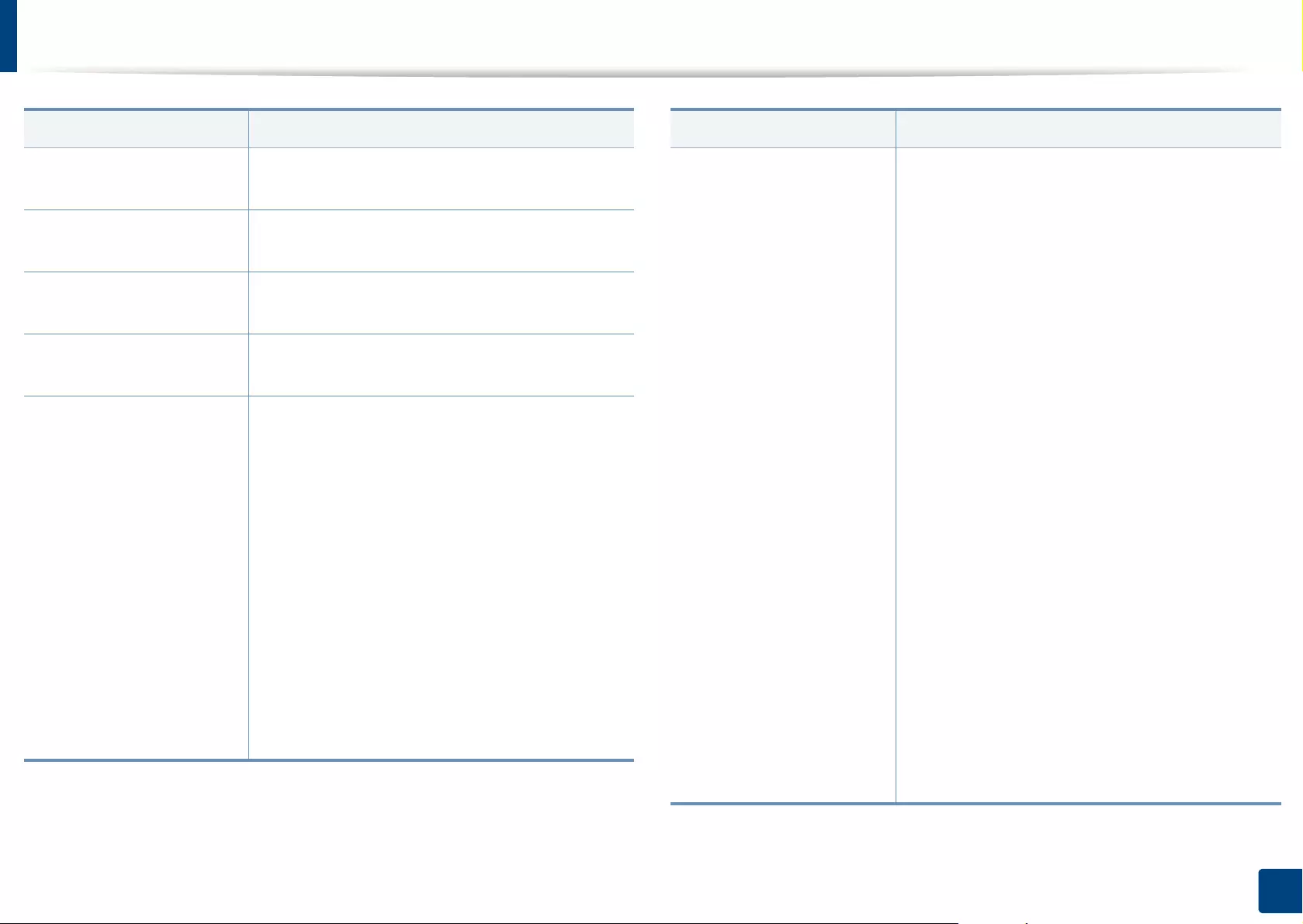
Machine setup
250
12. Menu Overview and Advanced Features
Print Settings Allows you to set the default print settings (see
"Print Settings" on page 262).
Network SettingsaAllows you to set the network related settings (see
"Network Settings" on page 262).
Language Allows you to select the language that appears on
the display screen.
SecurityaAllows you to set up the security related settings
(see "Security" on page 263).
Others Allows you to set up the supplies life.
•Supplies Life: Shows the remaining
percentage of each supply. If you experience
frequent paper jams or printing problems,
check the Supplies Life screen. If necessary,
replace the corresponding parts. This menu
could help you forecast when to replace the
toner cartridge or other replaceable supplies.
•Contact information: Shows the contact
information.
•Report: Allows you to print the report related
to system, fax, email sent, and font.
•Application management: Allows you to
enable/disable the applications.
Option Description
Report Shows the list of reports you can print.
•System
-Configuration: Print to see the machine
configuration information.
-Supplies information: Print to check
remaining percentage of each supply.
-Usage Counter: Print to check the count of
the jobs performed. Print usage, scan usage,
and fax usage information are included.
-Demo Page: Print demo page to check if the
machine is working properly.
-Error Information: Print to check what
errors have occurred in the machine. Error
types and counts are included.
-Network Configuration: Print to see the
network configuration information.
•Fax
-Fax Send Confirmation: You can set the
machine to print a report whether a fax
transmission or reception was successfully
completed or not.
-Fax Received: Print to check the list of faxes
received.
-Fax sent: Print to check the list of faxes sent.
-Fax Scheduled Jobs: Print to check the list
of scheduled fax jobs.
•
Send
-Email Sent: Print to check the transmission
state of the Scan to Email job.
•
Font
-PCL Font List: Print to see the PCL font list.
-PS Font List: Print to see the PS font list
Option Description
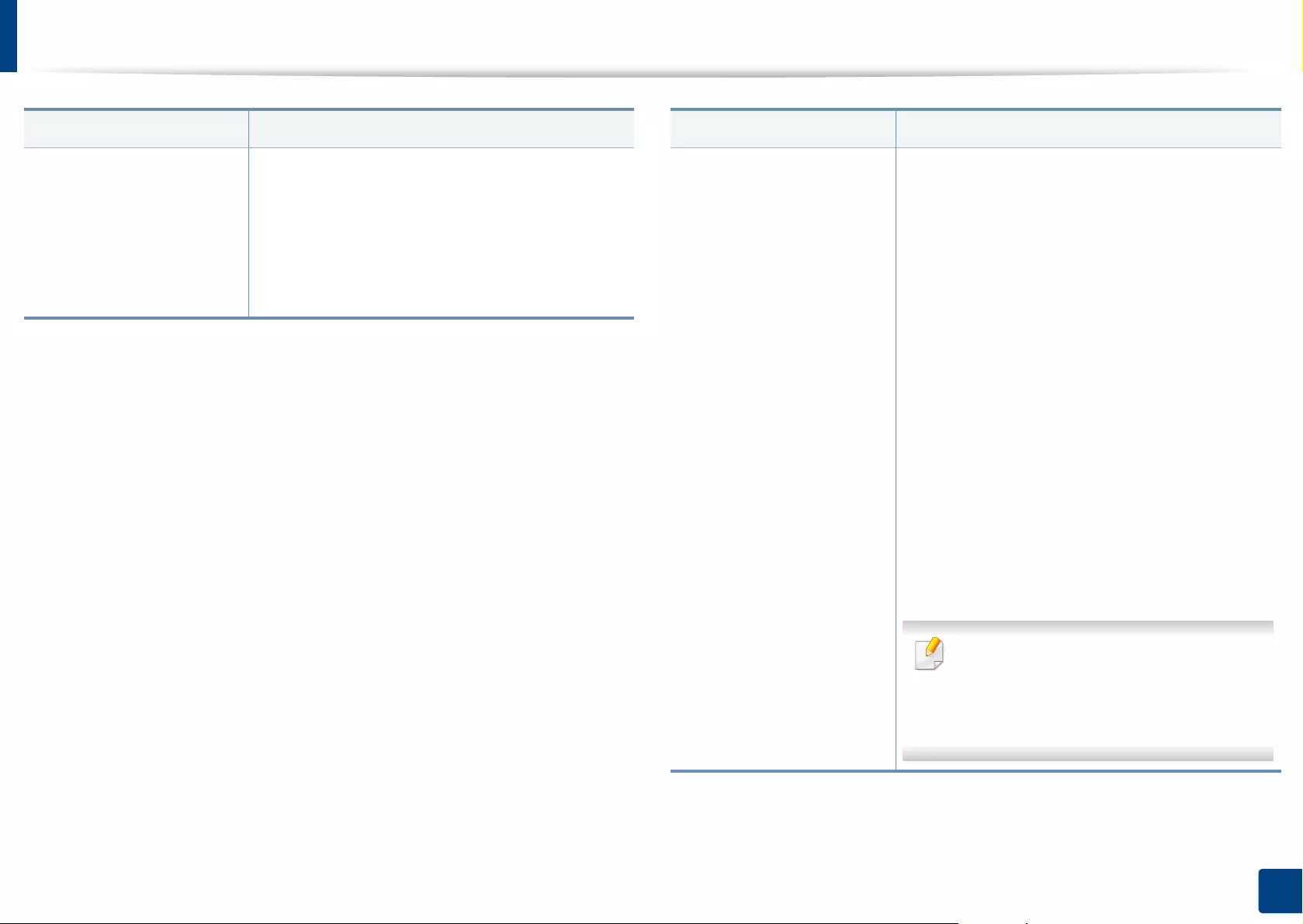
Machine setup
251
12. Menu Overview and Advanced Features
Contact Information Allows you to set the default settings for some
features.
•SAMSUNG Support: Check the information of
the service center.
•System Administrator: Check the contact
information of the administrator.
Option Description
Application ManagementaAllows you to manage application and licenses
• Installing an application
1 Press Machine Setup > Others >
Application Management from the display
screen.
2 Select the Application tab.
3 Connect the USB stick (with the downloaded
application stored) to the machine.
When the USB stick is detected, the Install
button will be enabled.
4 Click the Install button.
5 A pop-up window with list of application
appears. Select the application file and press
OK.
6 A verification message appears. Read the
agreement and check I accept the terms of
the License Agreement and press OK.
Application installation begins.
•
From the list, select the application you
want to view in details and press
Detail
.
•
From the list, select the application you
want to uninstall and press
Uninstall
.
a. Available for the administrator depending on the authentication settings selected (see
"Security" on page 263).
Option Description
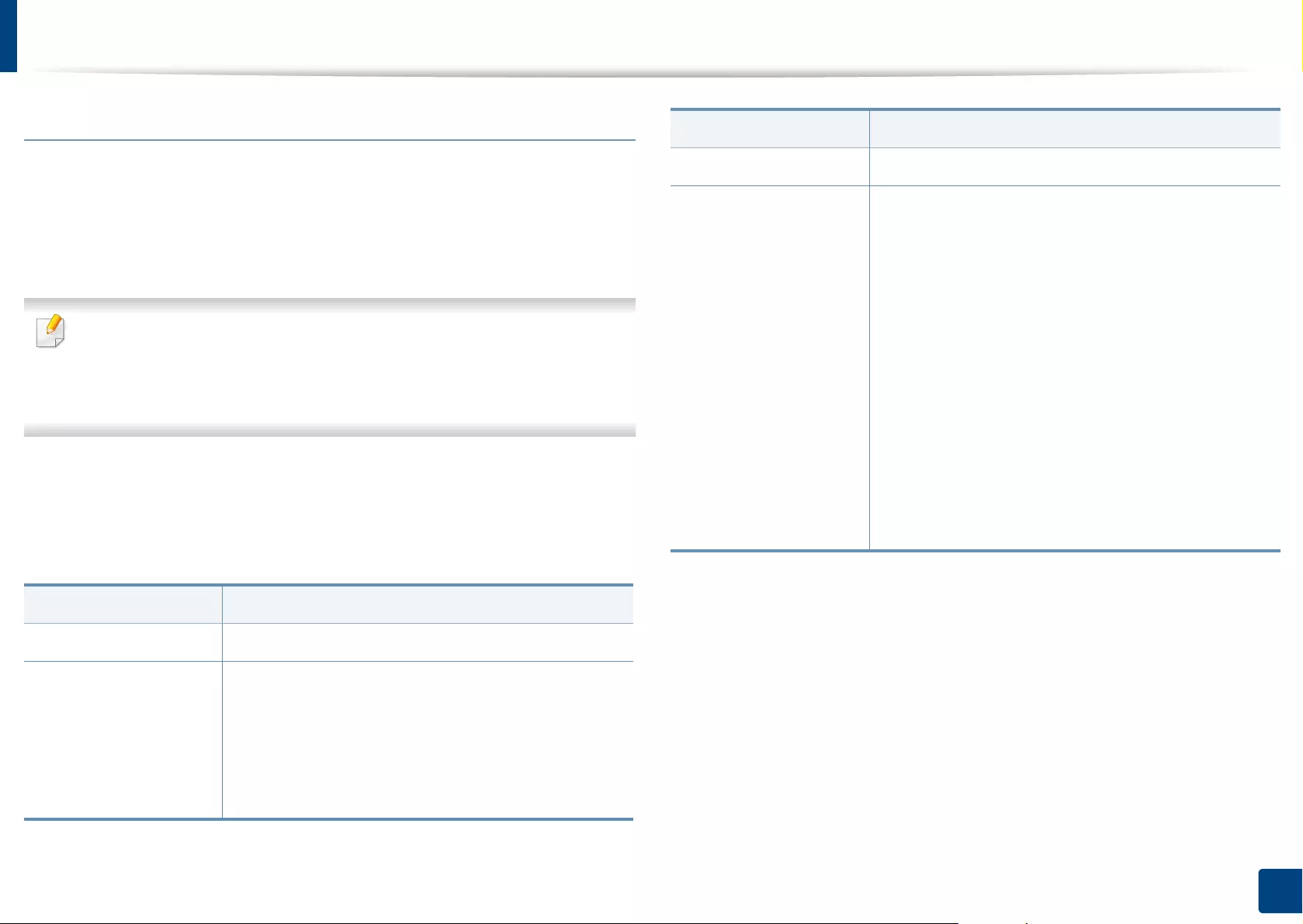
Machine setup
252
12. Menu Overview and Advanced Features
Application settings
Copy Settings
You can set the default copy options. Set the most frequently used copy
settings.
You can also use this feature from the SyncThru™ Web Service. Open the
Web browser from your networked computer and type the IP address of
your machine. When SyncThru™ Web Service opens, click Settings >
Machine Settings > Copy.
1Press Machine Setup > Application Settings > Copy Settings from the
display screen.
2 Select the appropriate option.
Option Description
Paper Source You can select the default tray to use when copying.
Reduce/Enlarge
You can reduce or enlarge the original to fit the paper to
which you are copying. For example, if the original is A3 and
you want it to be copied on A4 sized paper, press
70%(A3 -
> A4)
. If you want to set customized size, select the
Custom
and select the reduce/enlarge percentage of the original
with
+
,
-
button.
Duplex
You can select the duplex and binding options.
Color Mode
The color modes allow you to print the output in color
or black and white. You can select the following color
modes.
•Autoa: Select this setting to automatically detect
whether the scanned document is in color or black
and white, and then select an appropriate color
setting.
•Full Colora: Select this setting to print the same as
the original image color. Depending on the
circumstances and quality of originals, the
printout’s quality could be different from the
sample image’s.
•B/W: Select this setting to print the copy in black
and white, regardless whether the scanned
document is in color or in black and white.
Option Description
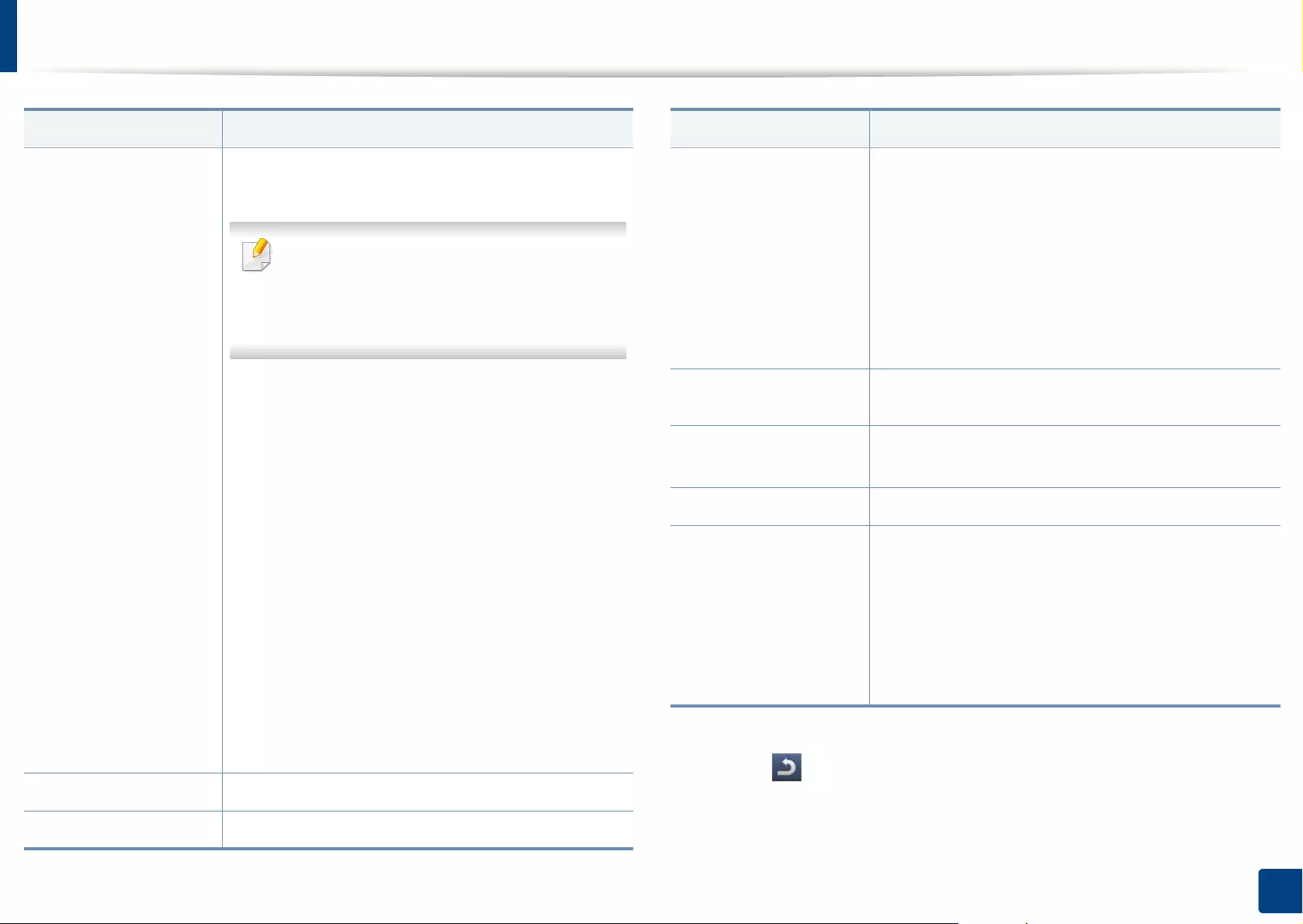
Machine setup
253
12. Menu Overview and Advanced Features
3 Press (Back) to save the change and return to the previous screen.
Output
You can select the options for how you want the outputs to
be arranged.
• This feature is available only when the
optional finisher is installed.
• Some features are available only when the
optional finisher is installed.
•Sort: Select how to sort the output.
-
Collated:
The outputs are in sets to match the
sequence of originals.
-
Uncollated:
The outputs are sorted into stacks of
individual pages.
•
Offset: When printing multiple copies, this option
shifts the output position of each set.
•Rotate: Stacks the printouts in criss-crossed sets.
•Output Tray: This option allows you to specify the
tray where to output the printed documents.
•Staple: Specify the number of staples to use when
binding the document (either 1 or 2 staples).
•Punch: Specify the number of holes to punch in
the document (either two or three holes). Some
punch kits may offer a 4 Hole option instead of the
3 Hole option.
Darkness
You can select the darkness of the copy.
Original Size
You can select the default original’s size.
Option Description
Original Orientation
You can Select the orientation of the originals.
•
Upright Images:
Select this setting for an original
document loaded with the top toward the back of the
machine.
•
Sideways Images:
Select this setting for an original
document loaded into the RADF with the top of the
original document toward the left side of the machine or
an original document placed on the scanner glass with
the top of the original document toward the right side of
the machine.
Original Type
You can select the type of original you are copying. This will
give you a better copy result.
Another Page
Confirmation
After the scanning is finished, the
Scan More Pages
window
appears to ask if you want to scan another page.
ID Copy You can select the ID copy method.
Manual ID Copy Setup Allows you to customize the manual ID copy
template. (see "Setting up Manual ID copy" on page
132).
•New: Creates a new ID copy template.
•Edit: Edits an existing ID copy template.
•Delete: Deletes an existing ID copy template.
a. X322x/ X328x series only.
Option Description
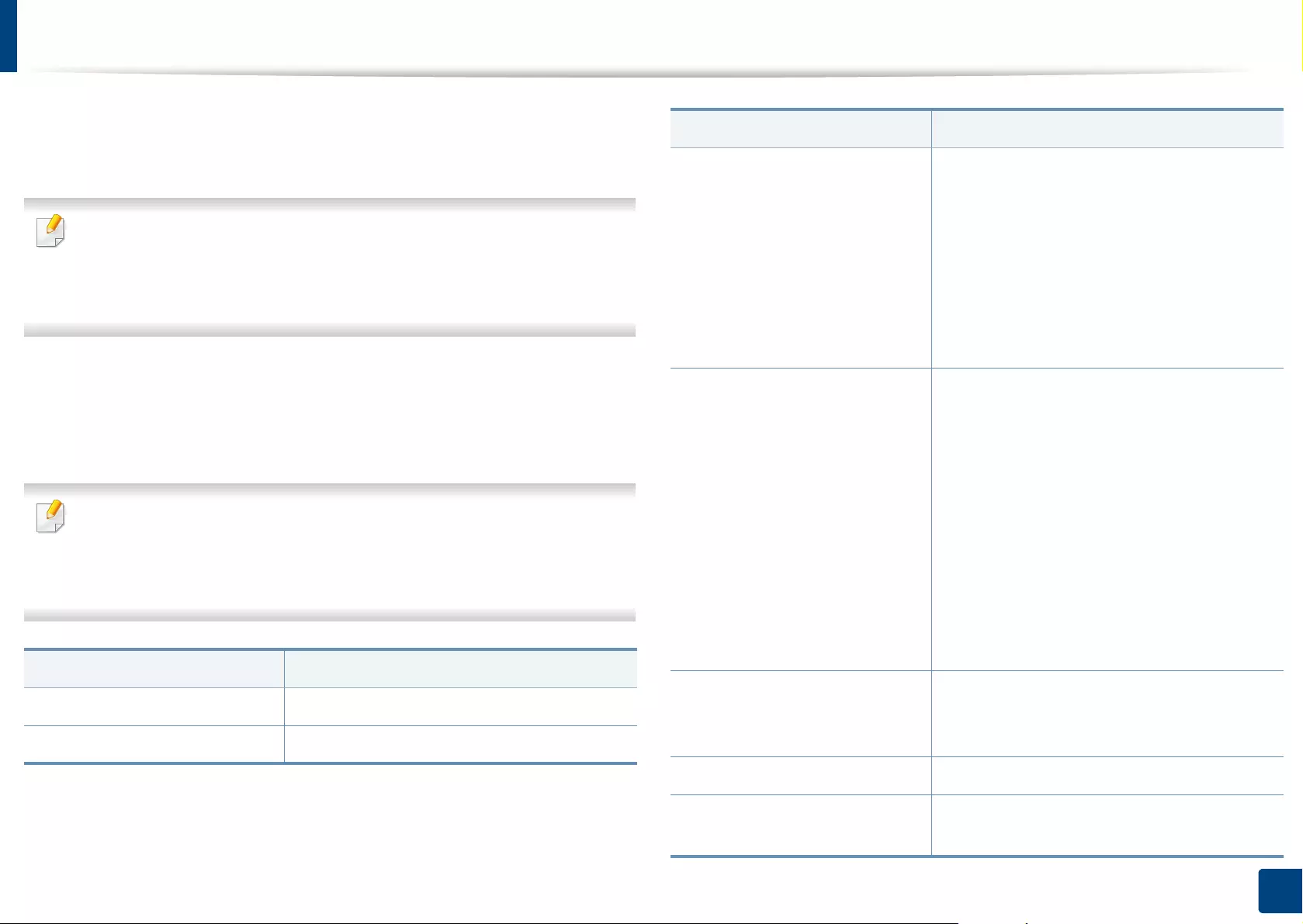
Machine setup
254
12. Menu Overview and Advanced Features
Fax Settings
You can set the default fax options. Set the most frequently used fax settings.
You can also use this feature from the SyncThru™ Web Service. Open the
Web browser from your networked computer and type the IP address of
your machine. When SyncThru™ Web Service opens, click Settings tab >
Machine Settings > Fax.
1Press Machine Setup > Application Settings > Fax Settings from the
display screen.
2 Select the appropriate option.
The fax options are different from country to country depending on the
International Communications Regulatory. If some of the fax options
explained in the instructions have been grayed-out, it means that the
grayed-out option is not supported in your communication environment.
Option Description
Resolution You can select the scanning resolution value.
Original Size You can set the default original’s size to use.
Duplex You can select the duplex options.
•1 Sided: For originals that are printed on
one side only.
•2 Sided, Book: For originals that are
printed on both sides.
•2 Sided, Calendar: For originals that are
printed on both sides, but the back is
rotated 180 degrees.
Original Orientation You can select the orientation of the originals.
•Upright Images: Select this setting for an
original document loaded with the top
toward the back of the machine.
•Sideways Images: Select this setting for
an original document loaded into the
RADF with the top of the original
document toward the left side of the
machine or an original document placed
on the scanner glass with the top of the
original document toward the right side of
the machine.
Original Type You can select the type of original you are
copying. This will give you a better copy
result.
Darkness You can select the darkness of the copy.
Machine ID & Fax No. You can set the machine ID and fax number
which will be printed at the top of each page.
Option Description
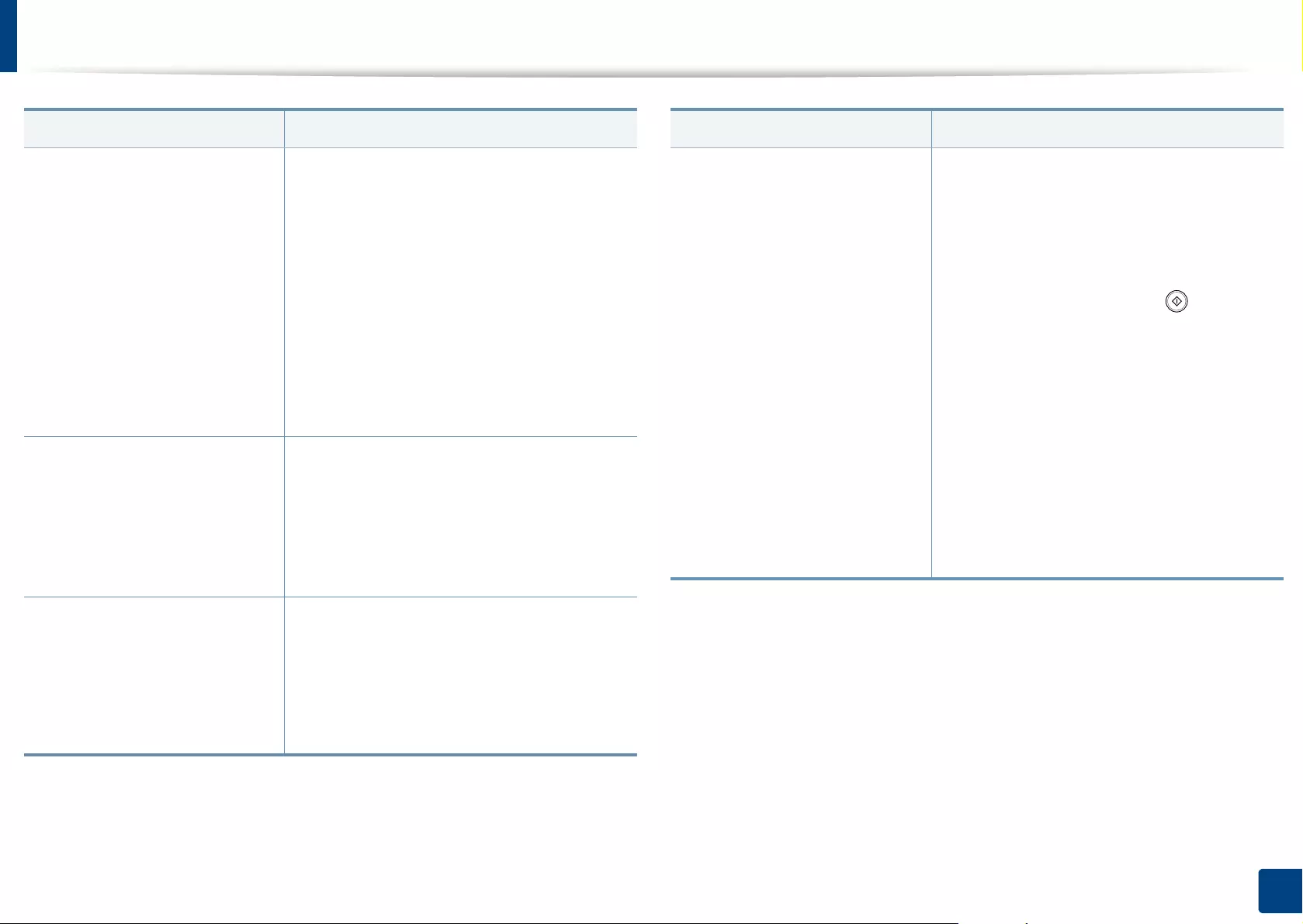
Machine setup
255
12. Menu Overview and Advanced Features
Redial You can set the machine to re-dial the fax
number if the recipient’s fax machine is busy
or not answering. You can set the number of
re-dial attempts and the interval between
attempts.
•Redial Term: Select the terms for re-
dialing using the +/- button.
•Redial Times: Select the re-dial time using
the +/- button. Selecting 0 for Redial
Times means that the machine will not re-
dial.
Prefix Dial You can set the number to be dialed before a
number is dialed. Users may set this to access
a PABX (e.g., 9) or area code (e.g., 02). Once
this number is set, it will automatically appear
on the screen when entering a phone/fax
number.
ECM Mode You can set the machine to correct the error. It
helps with poor line quality and ensures any
faxes you send are properly transmitted to
any other error correction mode-equipped
fax machines. Sending a fax using error
correction mode may take more time.
Option Description
Receive Mode You can set Receive Mode and Dial Type
options.
•
Receive Mode:
Select to change the fax
receiving mode.
-
Telephone:
Receives a fax by
pressing
Fax
>
On Hook
and then
(
Start
)
.
-
Fax:
Answers an incoming fax call and
immediately goes into the fax reception
mode.
-
Answering Machine/Fax:
Is for when an
answering machine is attached to your
machine. Your machine answers an
incoming call, and the caller can leave a
message on the answering machine. If the
fax machine senses a fax tone on the line,
the machine automatically switches to
Fax
mode to receive the fax.
Option Description
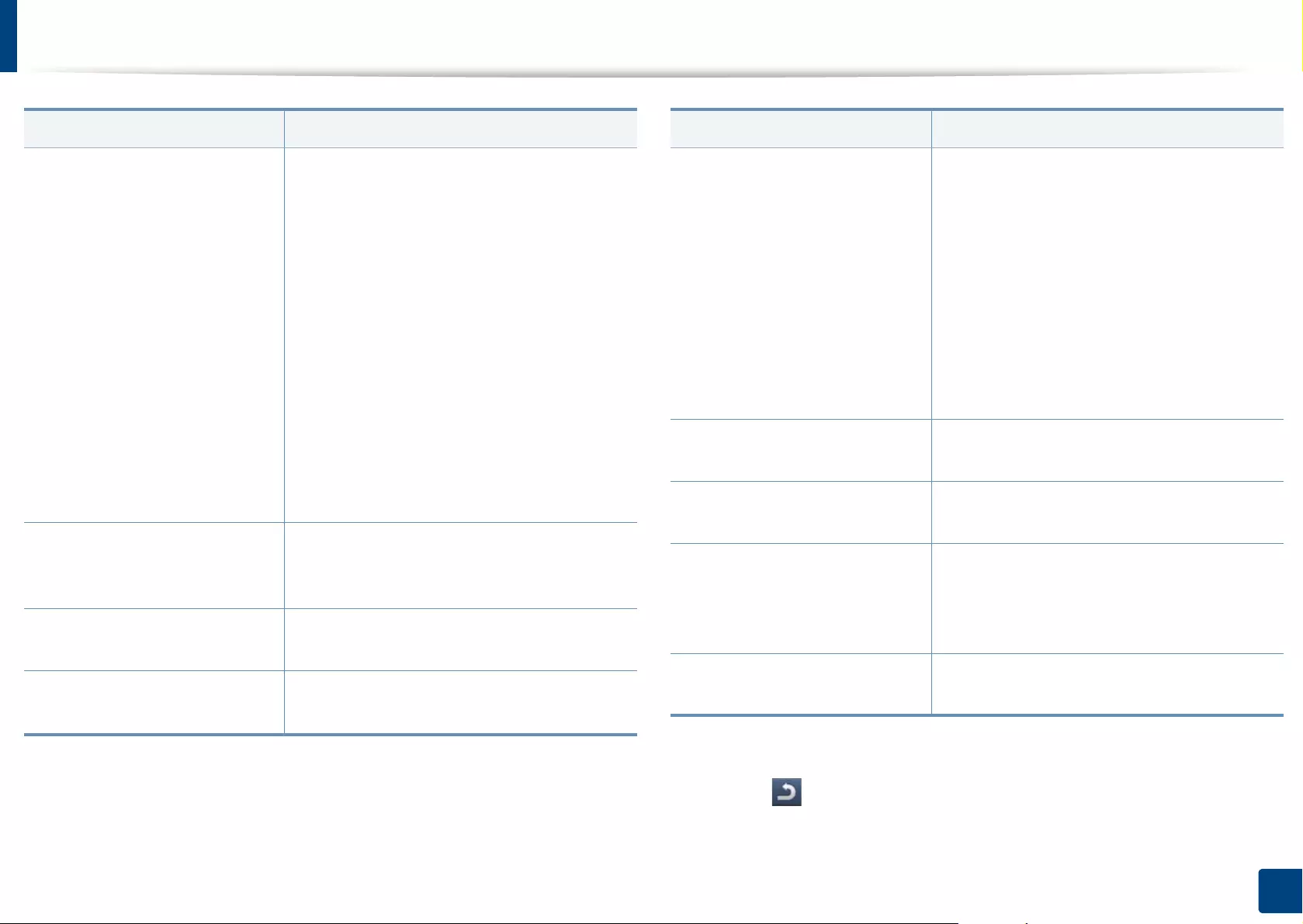
Machine setup
256
12. Menu Overview and Advanced Features
3 Press (Back) to save the change and return to the previous screen.
Receive Start Code This feature works best when you are using
an extension telephone connected to the EXT
socket on the back of your machine. You can
receive a fax from someone you are talking to
on the extension telephone, without going to
the fax machine. When you receive a call on
the extension phone and hear fax tones, press
the keys *9* on the extension phone. The
machine receives the fax. Press the buttons
slowly in sequence. If you still hear the fax
tone from the remote machine, try pressing
*9* once again. *9* is the remote receive code
preset at the factory. The first and the last
asterisks are fixed, but you can change the
middle number to whatever you wish.
Dial Mode Set the dialing mode to either tone or pulse.
This setting may not be available depending
on your country.
Ring to Answer You can set the number of times the machine
rings before answering an incoming call.
Toll Save You can set the machine to send a fax in the
toll save time for saving money.
Option Description
Secure ReceiveaYou can set the machine to keep the received
faxes in memory so that unauthorized people
cannot access them when you are absent. This
option restricts printing of received faxes
when the machine is unattended.
•Off: Select to not use secure receive.
•On: Select to use secure receive.
•Print: Select to print faxes in the memory.
You need to log-in as an administrator to
print out received faxes in memory.
Received Fax Printing You can set options for printing received
faxes.
Report You can select the options for the Fax send
confirmation, Fax sent/ Fax Received report.
Fax Country Setting You can select the country as a default. Before
you change it, you need to connect telephone
line with the machine. When you change the
country, ping test will be followed.
Smart Fax Diagnostics The Smart Fax feature optimizes the settings
for your fax line.
a. May only be available for the administrator depending on the authentication settings
selected (see "Security" on page 263).
Option Description
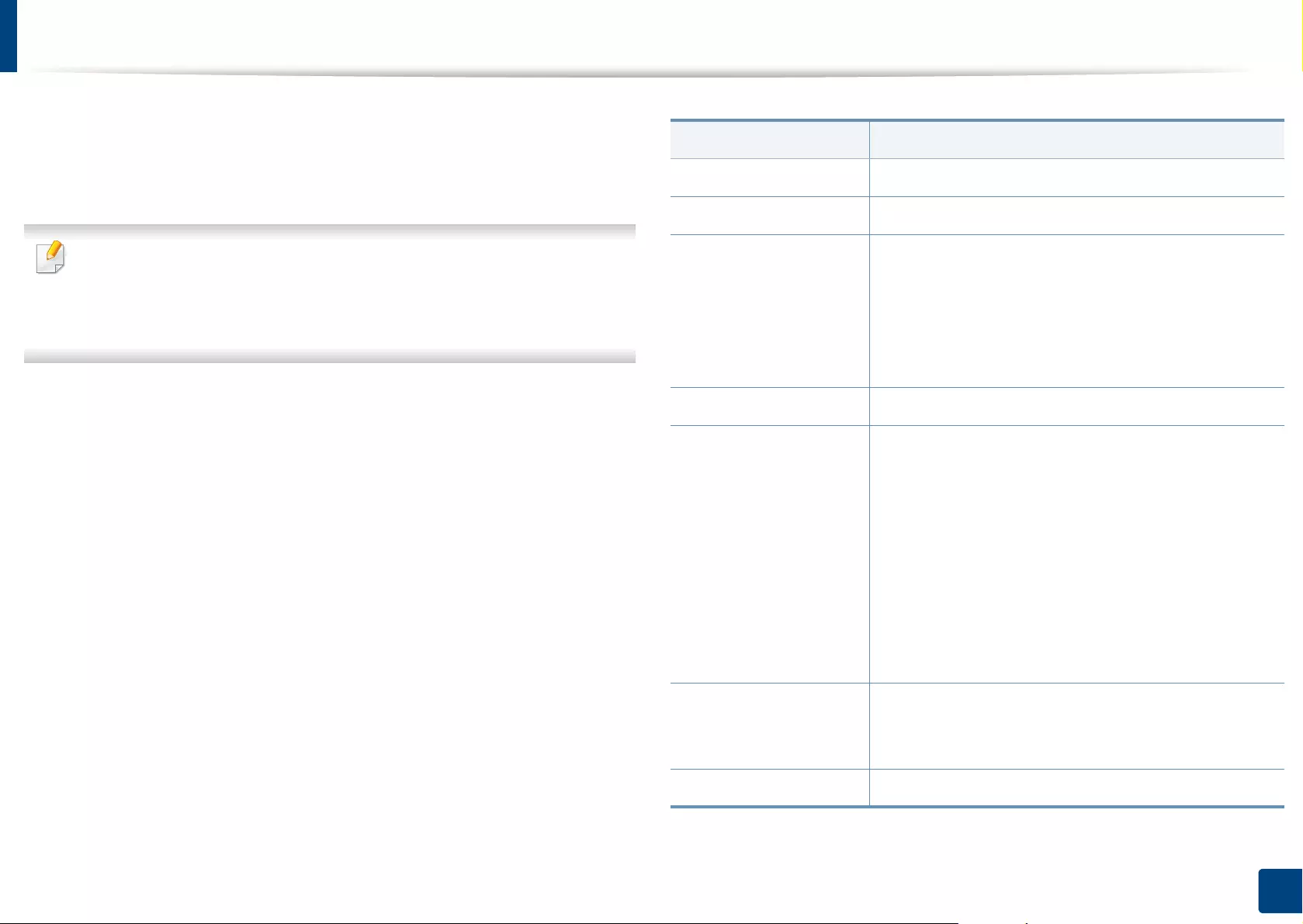
Machine setup
257
12. Menu Overview and Advanced Features
Scan Settings
You can set the options for scanning to email. The options you set here will be
applied when sending the scanned data to e-mail.
You can also use this feature from the SyncThru™ Web Service. Open the
Web browser from your networked computer and type the IP address of
your machine. When SyncThru™ Web Service opens, click Settings tab >
Machine Settings > Scan.
1Press Machine Setup > Application Settings > Scan to Email Settings
from the display screen.
OR
Press Machine Setup > Application Settings > Scan to Server
Settings from the display screen.
OR
Press Machine Setup > Application Settings > Scan to USB Settings
from the display screen.
OR
Press Machine Setup > Application Settings > Scan to Samsung
Cloud Settings from the display screen.
OR
Press Machine Setup > Application Settings > Scan to Shared Folder
Settings from the display screen. This menu appears when the mass
storage device (hard disk) option is installed.
2 Set the appropriate options.
Option Description
Resolution You can select the scanning resolution value.
Darkness You can select the degree of darkness of scan outputs.
Duplex You can select the duplex options.
•1 Sided: Select the binding of the original.
•2 Sided, Book: Select the binding of the original.
•2 Sided, Calendar: Select the binding of the
original.
Original Size You can set the default original’s size to use.
Original Orientation You can Select the orientation of the originals.
•Upright Images: Select this setting for an original
document loaded with the top toward the back of
the machine.
•Sideways Images: Select this setting for an original
document loaded into the RADF with the top of the
original document toward the left side of the
machine or an original document placed on the
scanner glass with the top of the original document
toward the right side of the machine.
Original Type You can select the type of the original you are
scanning. This will enhance the scan quality based on
the type of the original document being scanned.
Color Mode You can select the color options of the scan outputs.
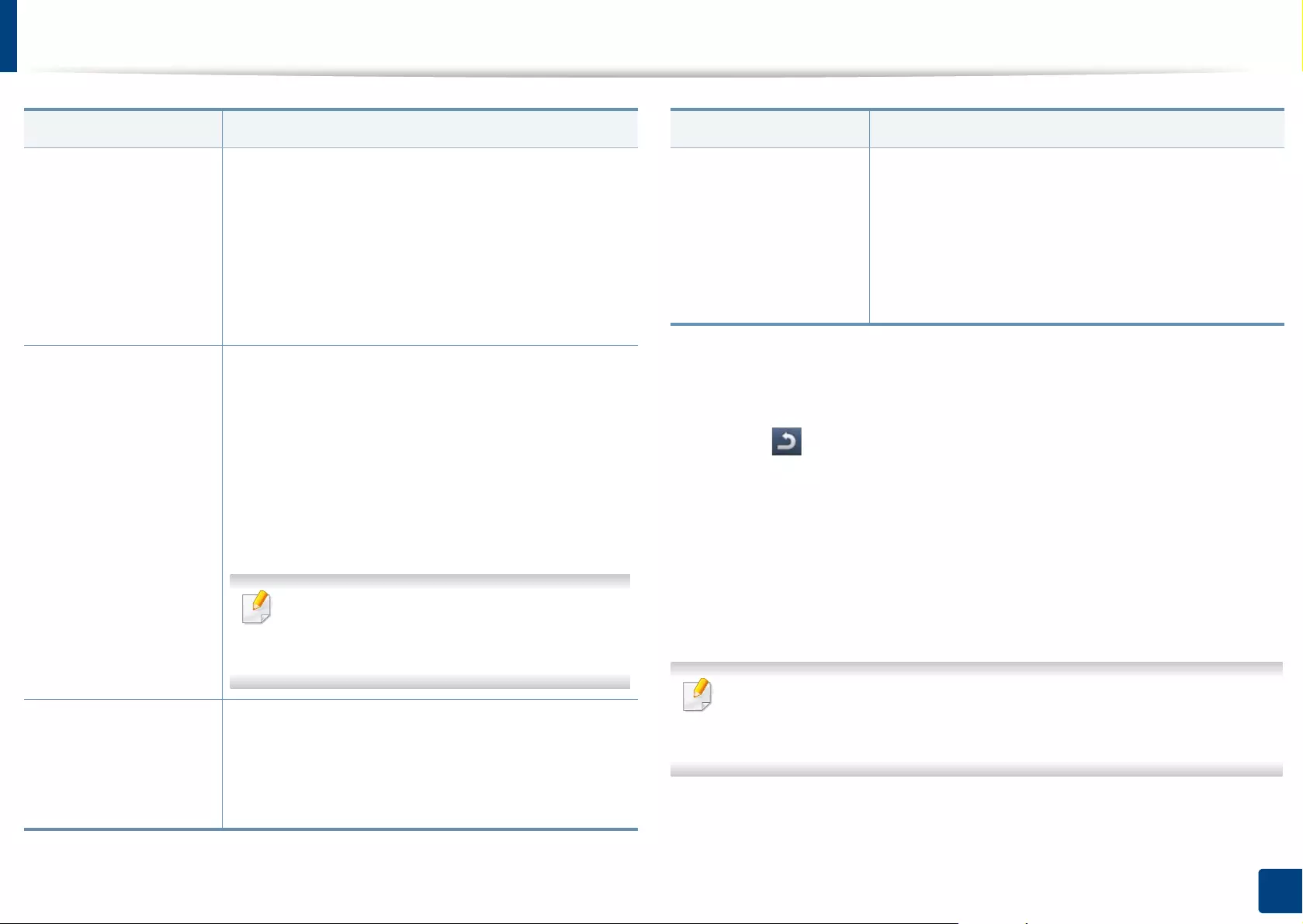
Machine setup
258
12. Menu Overview and Advanced Features
3 Press (Back) to save the change and return to the previous screen.
Address Book
This feature allows you to store frequently used phone numbers, fax numbers,
and e-mail addresses on the machine’s hard drive. When sending a fax, you can
use the address book created here. It will save time entering fax numbers and e-
mail addresses.
You can also use this feature from the SyncThru™ Web Service. Open the
Web browser from your networked computer and type the IP address of
your machine. When SyncThru™ Web Service opens, click Address Book.
Quality You can select the quality of the scan outputs.
•Best: Produces a high quality image, and the file
size will be large.
•Normal: Both the image quality and file size will be
between Best and Draft.
•Draft: Produces a low quality image, and the file
size will be small.
File FormataYou can select the file format of the scan outputs.
•JPEG: Scans originals in JPEG format.
•PDF: Scans originals in PDF format.
•TIFF: Scans originals in TIFF (Tagged Image File
Format).
•XPSb: Scans originals in XPS format. Scans originals
in TIFF (Tagged Image File Format).
If you want several originals to be scanned as
one file, press On in the Multi Page option.
This is not available for JPEG format.
Print Confirmation
Reportc
You can select an option for Print confirmation report
•Always: Prints the report always.
•Never: Does not print report.
•On Errors Only: Print the report only on errors.
Option Description
Filing PolicydYou can choose the policy for generating file names
before you proceed with the scan job.
•Change Name: The sent file is saved as a different
file name that is automatically programmed.
•Cancel: Does not save the sent file.
•Overwrite: The sent file overwrite the existing file.
a. Scan to Samsung Cloud Settings menu does not support this option.
b. This option appears only when the mass storage device (hard disk) option is installed.
c. Scan to Email Settings and Scan to Server Settings only.
d. Scan to USB Settings and Scan to Shared Folder Settings only.
Option Description
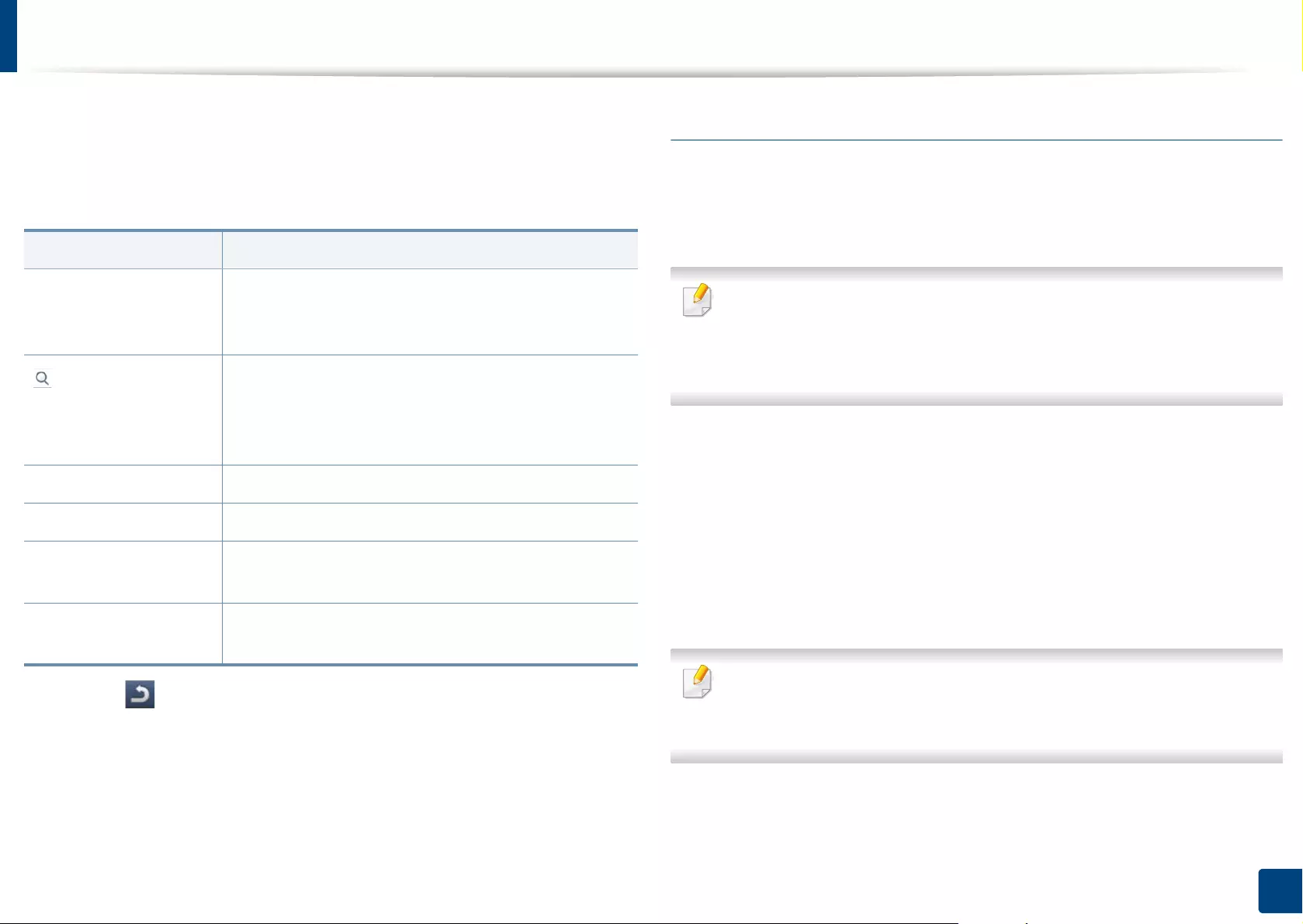
Machine setup
259
12. Menu Overview and Advanced Features
1Press Machine Setup > Application Settings > Address Book from the
display screen.
2 Select the appropriate option.
3 Press (Back) to the previous screen.
Tray settings
This feature allows you to check the current tray settings and change the
settings if necessary. There are many options available for setting the tray and
paper. Make the best use of the options to fit your needs for trays and paper.
You can also use this feature from the SyncThru™ Web Service. Open the
Web browser from your networked computer and type the IP address of
your machine. When SyncThru™ Web Service opens, click Settings tab >
Machine Settings > System >Input Tray.
1Press Machine Setup > Tray Settings from the display screen.
2 Check the current tray settings. If you do not need to change the setting,
go to step 5.
3 Press Settings to change the current settings.
4 Press the option you want to change.
If some options are grayed out, it means that the grayed-out option is not
supported for your machine or optional parts needed to use the option are
not installed.
Option Description
All Press this button and select your search. The
categories are: All, Individual, Group, Favorite and
Email.
Enter the keyword (eg., the first letter of the name for
which you are searching) in the blank field and press
this button. The machine starts to search for the
address.
Select All Press checkbox to select all the addresses in the list.
New Press this button to create a new address.
Edit Select the address you want to edit and press this
button.
Delete Select the address you want to delete and press this
button.
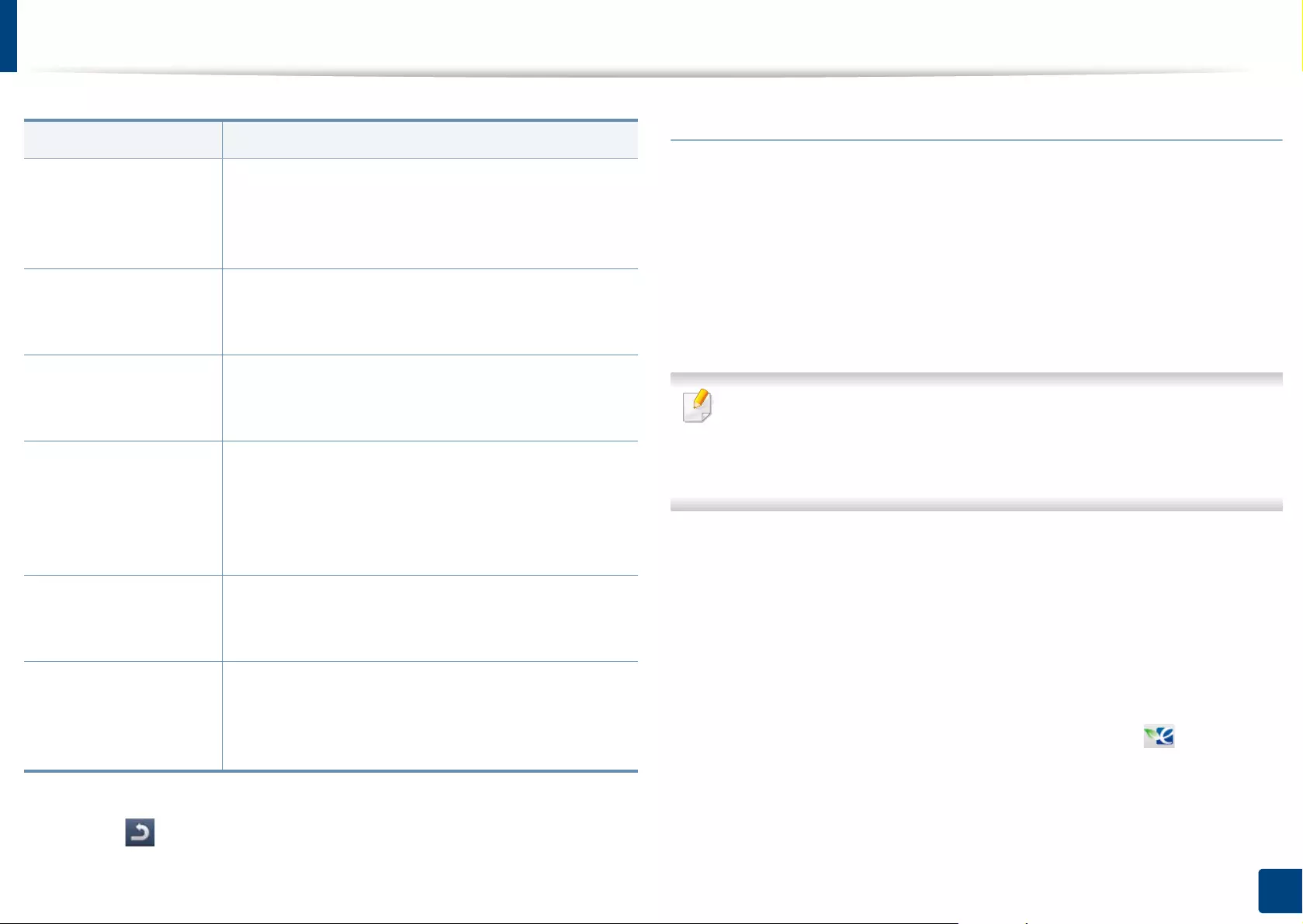
Machine setup
260
12. Menu Overview and Advanced Features
5 Press (Back) to save changes and return to the previous screen.
Eco Settings
This feature allows you to set the Eco mode as a default and options related to
it. Eco mode is created to set the options that reduce toner and paper usage. For
example, one of the options for Eco mode is duplex printing. Instead of printing
on two different pieces of paper, Eco mode is designed to print on both sides of
one piece of paper(duplex). If you try to print on two different pieces of paper
when Eco mode is on, a message asking if you want to disable the Eco mode
appears. Follow the instructions below to set the Eco mode options.
You can also use this feature from the SyncThru™ Web Service. Open the
Web browser from your networked computer and type the IP address of
your machine. When SyncThru™ Web Service opens, click the Settings tab
> Machine Settings > System > Eco Settings.
1Press Machine Setup > Eco Settings from the display screen.
2 Select the appropriate option.
•Default Eco Mode: You can set the Eco mode on as a default. If you
set this mode on, users will need to press the Eco button on the
control panel to turn it off. However, if you (administrator) set the
password, users need to enter the password in order to turn this
mode off. Once this feature is on, you can see the symbol next
to the options set with eco mode.
-On: Set the Eco mode on.
-Off: Set the Eco mode off.
Option Description
Tray [x]a/Mp Tray
a. [tray type] indicates the tray number.
You can set the paper size and type to use in the each
tray. Also, you can activate a tray confirmation
message which asks whether or not to set the paper
size and type for the just opened tray.
Auto Tray Switch You can set the machine to automatically switch to the
tray with the same sized paper when the tray in use is
empty.
Auto Continue Determine whether or not the machine continues
printing when it detects the paper does not match the
paper settings.
Paper Substitution Automatically substitutes the printer driver’s paper
size to prevent the paper mismatch between Letter
and A4. For example, if you have A4 paper in the tray
but you set the paper size to Letter in the printer driver,
the machine prints on A4 paper and vice versa.
Tray Protection You can set the tray to be excluded from the Tray
priority setting. Select the tray and press the radio
button to activate this option.
Tray Priority Setting You can set the usage priority among trays with the
same sized paper. Paper in the tray with the highest
priority will be used first. Select the tray and use the
Up/Down buttons to set the priority.
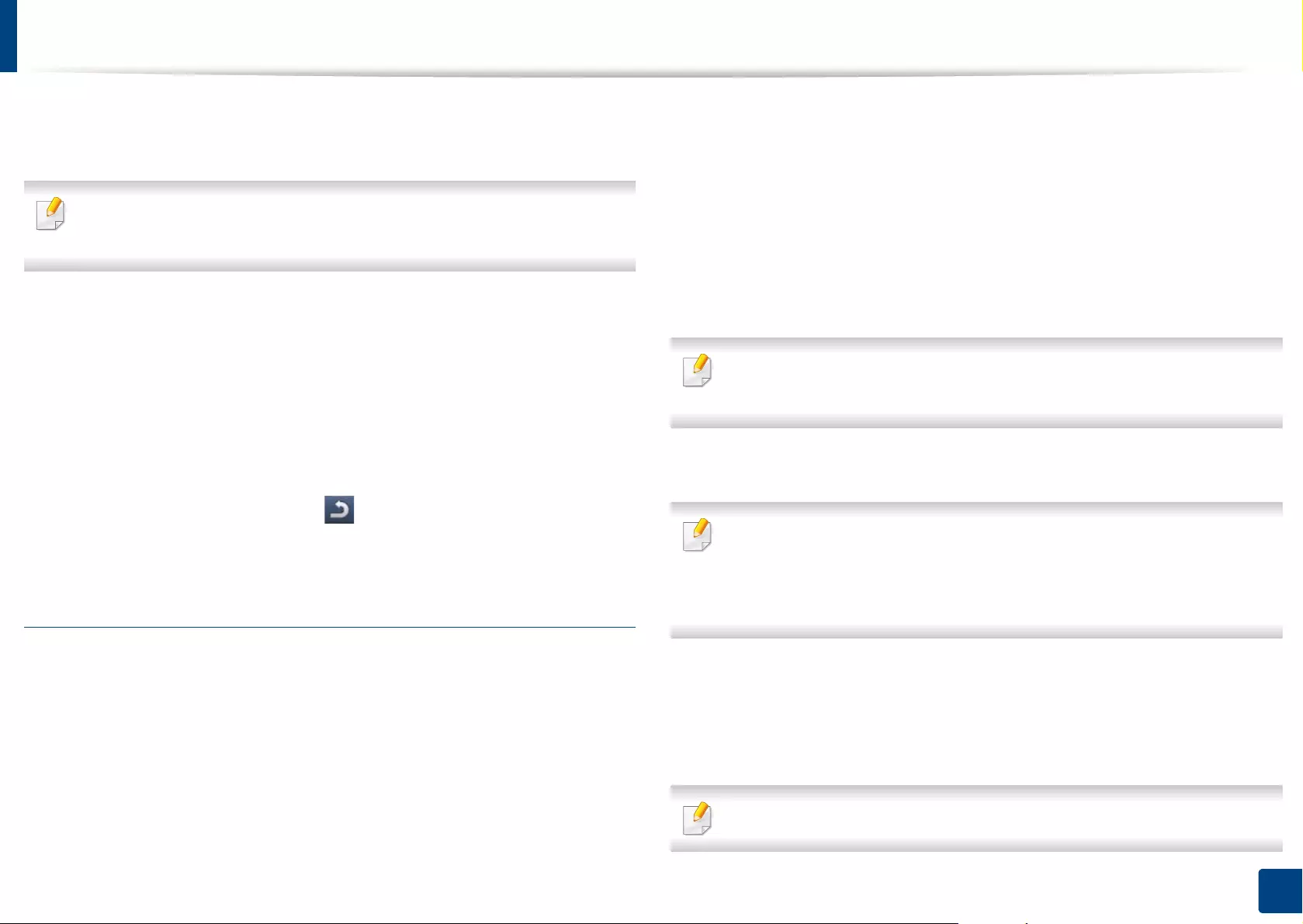
Machine setup
261
12. Menu Overview and Advanced Features
-On-Forced: Set the Eco mode on with password. If a user wants
to turn the Eco mode off, the user needs to enter the password.
If you set this mode to off, the Eco mode print job from the driver will not be
calculated as a Eco mode nor will the Eco mode LED on the control be on.
•Eco Features Configuration: You can set the default options for Eco
mode.
-Factory Default: You can keep the default settings.
-Custom Settings: You can set printing from copy and PC driver
print settings related settings. The settings you set here will be
applied to all copy print and PC driver print jobs sent to the
machine, unless the user disables Eco mode.
3 Press OK to save the change or (Back) to return to the previous
screen.
Initial Settings
You can change the initial settings when you first turn the machine on.
1Press Machine Setup > Initial Settings from the display screen.
2 Press the language to use on the display screen and then press Next.
3 Enter the password to use and then press Next. Re-enter the password
to confirm it, then press Done > Next.
4 Set the time on the machine. Then press Next.
5 Remove the existing device name and enter the device name you want
to use and then press OK. Then press Next. If necessary, enter the
location of the machine in the Location field. If necessary, enter the
information in the Administrator field for the person to contact when
any problem occurs on the machine.
6 When Connected appears after pressing the Test button, press Next.
If Not connected appears, make sure that the machine is connected to
the network then verify the LAN connection again.
If a network connection problem persists, contact your network
administrator.
7
Enter the IP address, subnet mask, and gateway in each field. Then press
Next
.
• If a new IP address is assigned automatically by a DHCP or BOOTP, press
DHCP or BOOTP.
• If you are not sure about your network environment, contact your
network administrator.
8 Enter the Host Name, Domain Name, Primary DNS Server and
Secondary DNS Server in each field. Then press Finish.
9 The completed window appears. Press the Close button.
If the engine is busy, the machine might take longer to reboot.
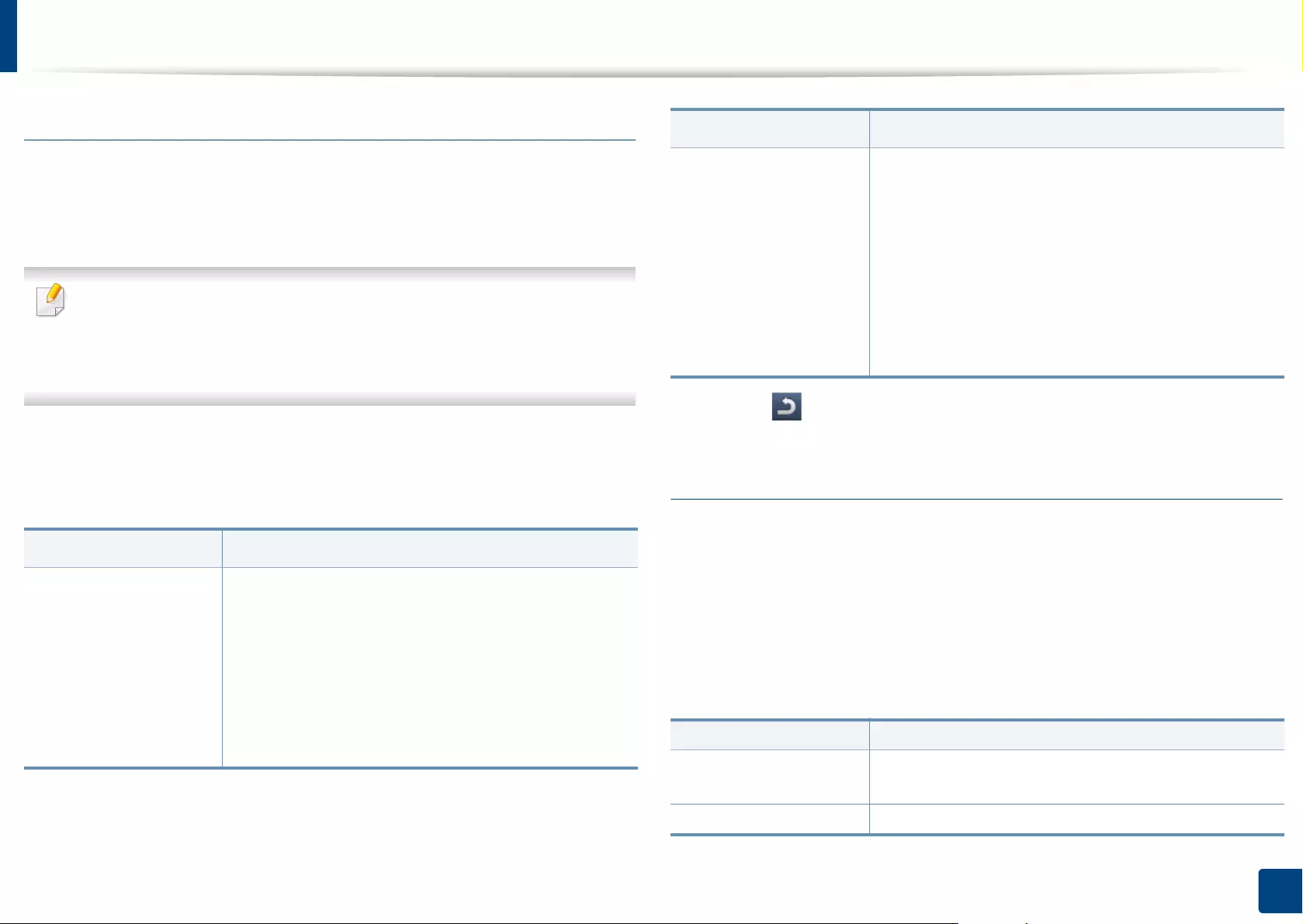
Machine setup
262
12. Menu Overview and Advanced Features
Print Settings
You can set print related settings. When there is no specific input for printing options, the
machine prints with the settings you set here. Set the frequently used printing settings.
This feature can be useful if your company has a specific printing form.
You can also use this feature from the SyncThru™ Web Service. Open the
Web browser from your networked computer and type the IP address of
your machine. When SyncThru™ Web Service opens, click the Settings tab
> Machine Settings > Printer.
1Press Machine Setup > Print Settings from the display screen.
2 Select the appropriate option.
3 Press (Back) to save changes and return to the previous screen.
Network Settings
This feature allows you to set up the network. Before setting up the information,
you must have the relevant information concerning the type of network
protocols and computer system you use. If you are not sure which settings to
use, contact your network administrator for such information.
1Press Machine Setup > Network Settings from the display screen.
2 Set the appropriate options.
Option Description
General You can set Skip Blank Pages, Paper Source,
Emulation.
•Emulation: You can choose the emulation format.
•Paper Source: You can select the tray as a paper
source.
•Skip Blank Pages: You can skip the blank pages
during printing.
Layout Provides paper layout related options.
•Orientation: Select the paper orientation.
•Duplex: Select the paper orientation for duplex
mode.
•No. Of Copies: Select the number of copies you
want to print.
•Margin: Adjust the margin for Common Duplex,
Common Simplex, Emulation.
Option Description
TCP/IP You can set the network settings (see "Network
settings (TCP/IP)" on page 44).
UPnP(SSDP) You can set the UPnP settings.
Option Description
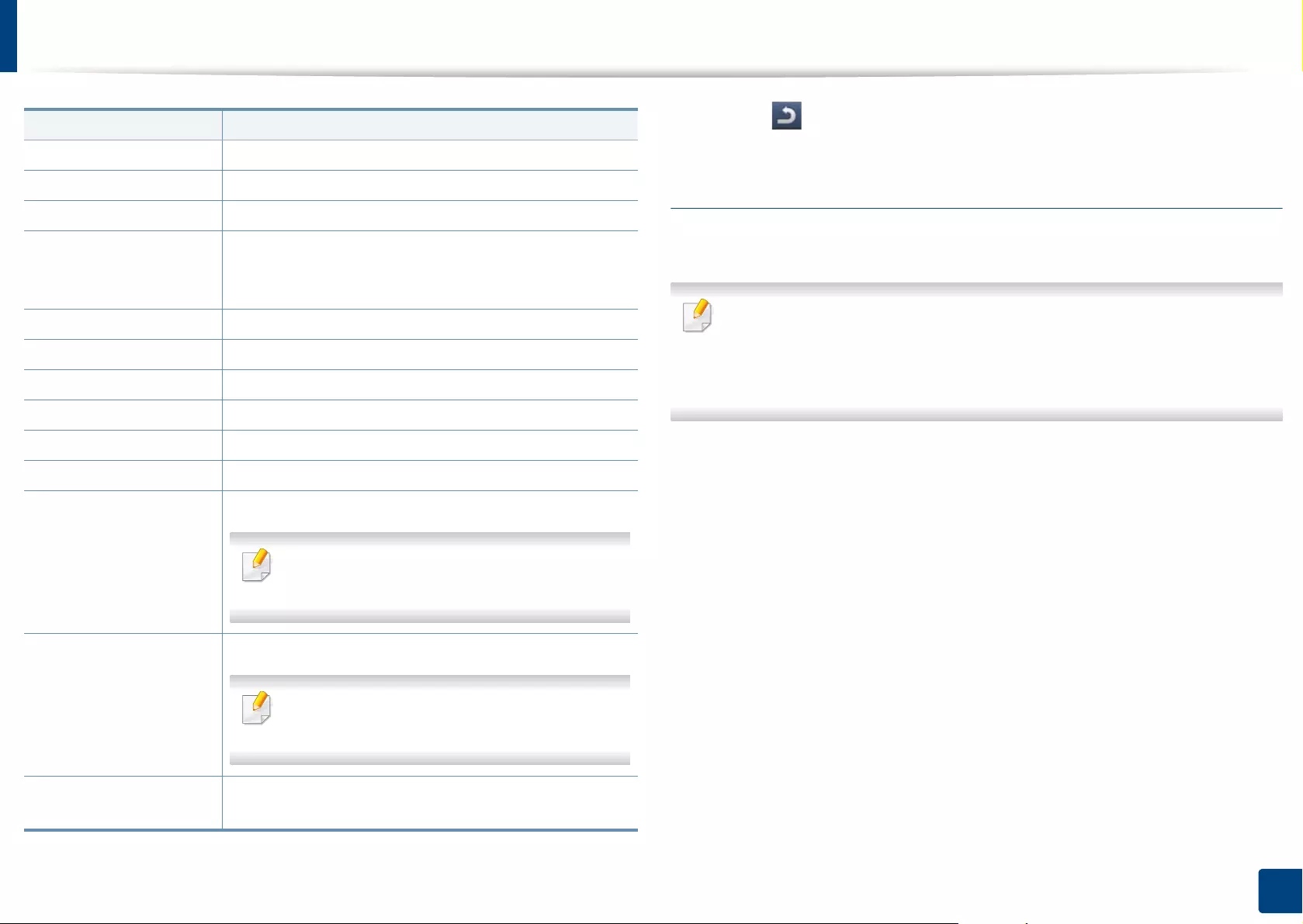
Machine setup
263
12. Menu Overview and Advanced Features
3 Press (Back) to save the change and return to the previous screen.
Security
This feature allows you to set up the security related settings.
You can also use this feature from the SyncThru™ Web Service. Open the
Web browser from your networked computer and type the IP address of
your machine. When SyncThru™ Web Service opens, click the Security tab
> Network Security.
1Press Machine Setup > Security from the display screen.
2 Select the appropriate option.
Print You can set the ports needed for network printing.
Samsung Cloud Print You can set the Samsung Clud Print settings.
PrinterOn You can set the PrinterOn settings.
SNMPv1/v2 You can set SNMP (Simple Network Management
Protocol). Administrator’s can use SNMP to monitor
and manage machines on the network.
mDNS You can set the mDNS settings.
SNTP You can set the SNTP settings.
SetIP You can set the SetIP settings.
SLP You can set the SLP settings.
Network Filtering You can set the network filtering settings.
HTTP You can set the HTTP settings.
Wi-Fi You can set the Wi-Fi settings.
After installing the Wireless/NFC kit (Optional),
set the machine to use this feature.
NFC You can set the NFC settings.
After installing the Wireless/NFC kit (Optional),
set the machine to use this feature.
Clear Setting Reverts the network settings to the default values.
(Reboot required.)
Option Description
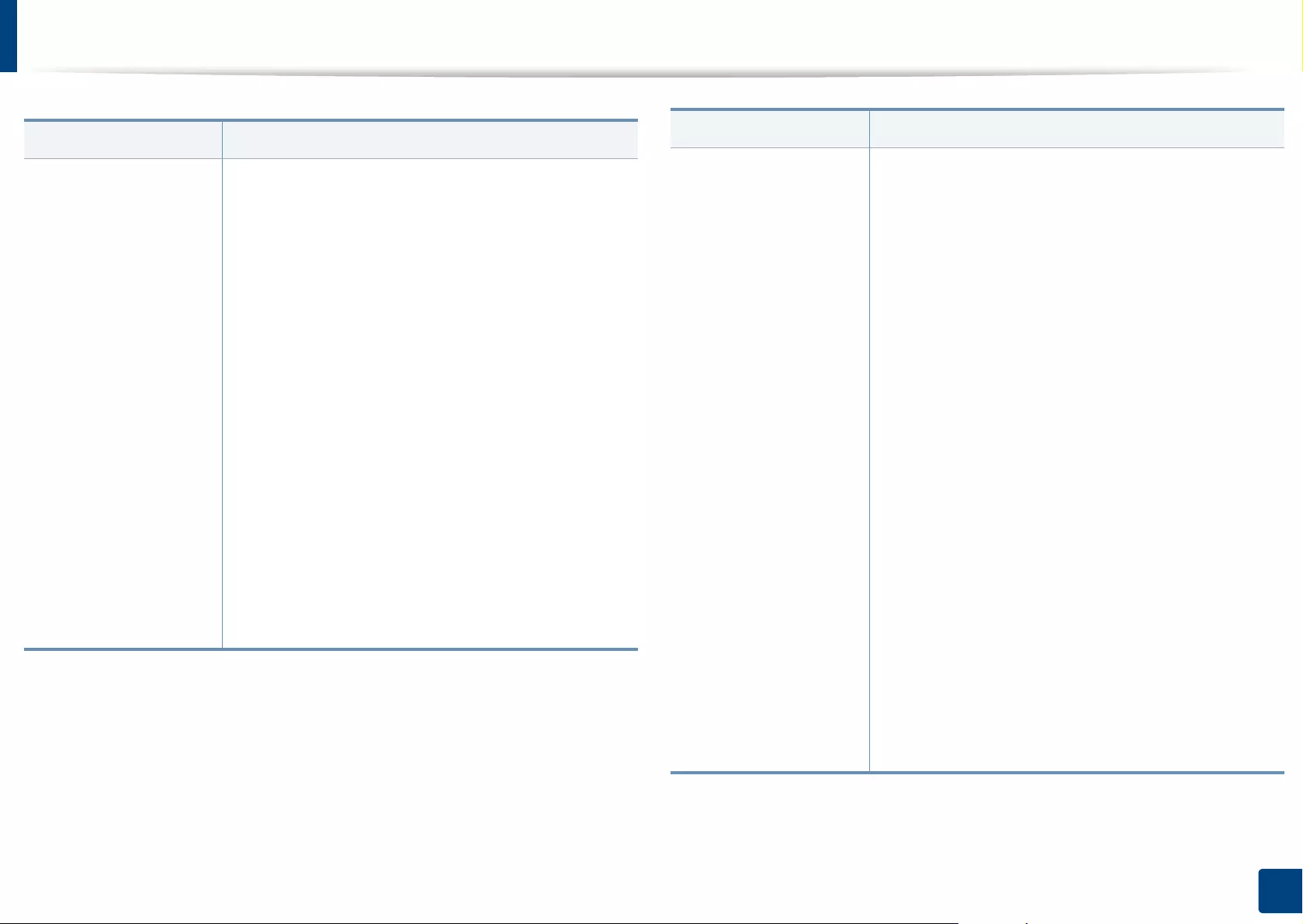
Machine setup
264
12. Menu Overview and Advanced Features
Option Description
Image OverwriteaYou can set the machine to overwrite data stored in
the memory. The machine overwrites the data with
different patterns eliminating the possibilities of
recovery.
•Automatic Image Overwrite: When a job is
completed, there are temporal images left in the
memory. For security reasons, you can set the
machine to automatically overwrite secure non-
volatile memory. If you want to secure memory
space, you can set the machine to automatically
overwrite secure non-volatile memory.
•Manual Image Overwrite: When printing,
copying, scanning, and faxing, the machine
temporarily uses memory space. For security
reasons, you can set the machine to manually
overwrite secure non-volatile memory. If you want
to secure memory space, you can manually
overwrite secure non-volatile memory. You can set
the machine to repeat the manual image overwrite
after the system is rebooted
Image Overwritea•Overwrite Method: You can select the method for
overwriting the secure non-volatile memory (hard
disk).
-German VSITR: Select to overwrite the memory
7 times. When overwriting for the 6 times,
alternate 0x00 and 0xff are used to overwrite the
disk, and, in the 7th time, the disk is written with
0xAA.
-DoD 5220.28-M: Select to overwrite the
memory 3 times. When overwriting three times,
patterns 0x35, 0xCA, 0x97 are used to overwrite
the disk’s content. This method of overwriting
the disk is specified by US DoD.
-Australian ACSI 33: Select to overwrite the
memory 5 times. When overwriting 5 times,
character “C” and its complement alternatively
are used to overwrite the disk. After the 2nd
time, there is a mandatory validation. For the 5th
time, random data is used.
-DoD5220.22-M (ECE): Select to overwrite the
memory 7 times. This method of overwriting the
disk is specified by US DoD.
-Custom: Select to determine the number of
times the memory will be overwritten. The hard
disk will be overwritten as many times as the
number you select.
Option Description
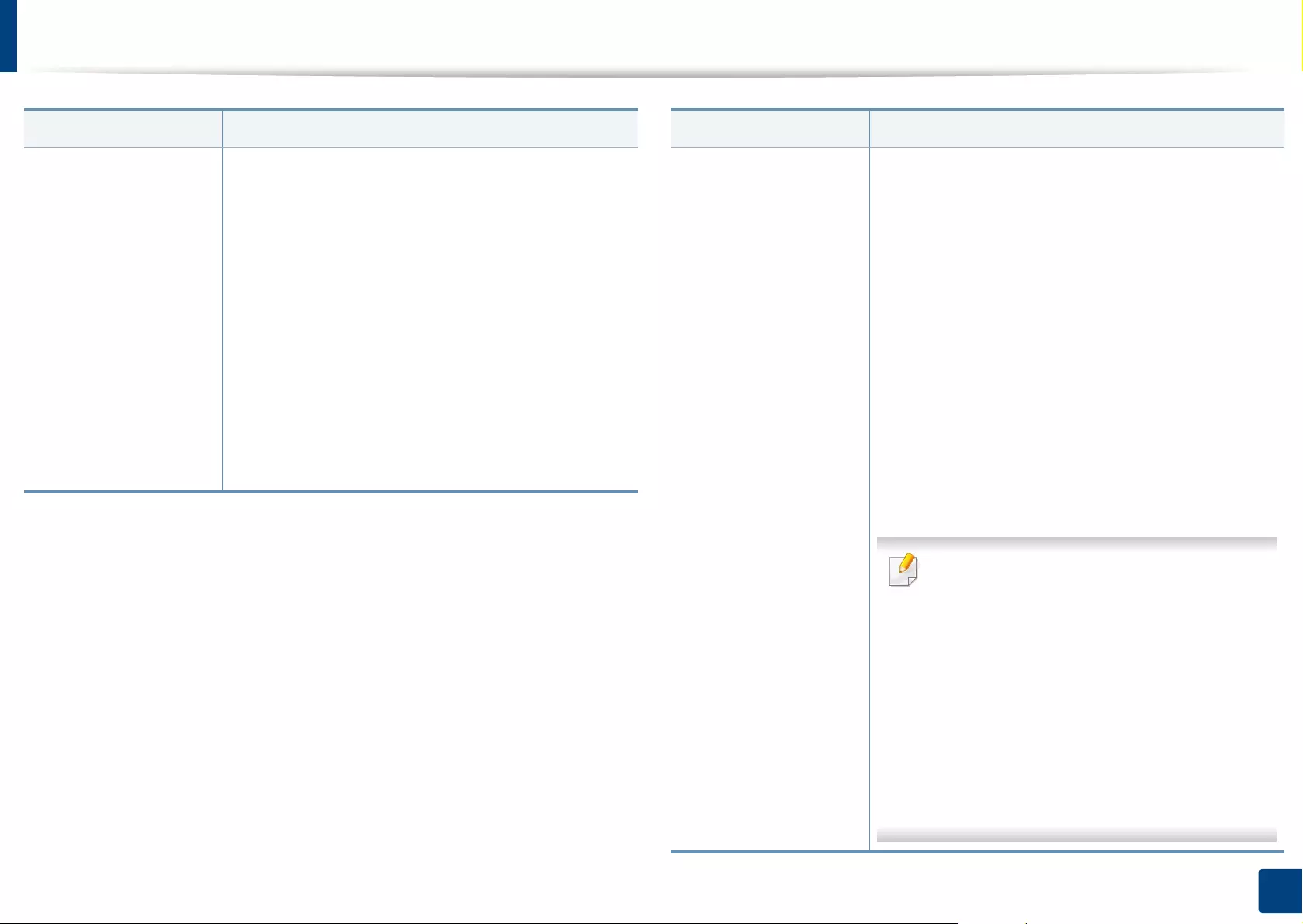
Machine setup
265
12. Menu Overview and Advanced Features
Authentication •Mode
-Device Mode: Activate device authentication.
Device authentication requests a user to login
before being able to use the device. Users
cannot use any application without logging in.
-Application Mode: Activate application
authentication. An administrator can choose the
application(s) to require user to login to use.
Users cannot use the selected application(s)
without logging-in. Press Application mode to
enable authentication.
-Basic Mode: Activate basic authentication.
Users are asked to login when they select
options that are only available to administrators.
Option Description
Authentication •Method
-Local Authentication: Executes
authentification process based on the user
information stored at mass storage device
(hard disk) in the device.
-Standard Accounting Only: Allows users to
login by entering ID and password.
-SyncThru Provider: Executes authentication
process based on the user information allocated
from SyncThru™ Admin (or Fleet Admin Pro).
-Kerberos and Local Authentication: Executes
authentication process based on the user
information stored at kerberos server.
-LDAP and Local Authentication: Executes
authentication process based on the user
information stored at LDAP server.
-SMB and Local Authentication: Executes
authentication process based on the user
information stored at SMB server.
•
LUI Login Screen:
Provides
Pre-Installed-For-
LUI, by default.
•
SWS Login Screen:
Provides
Pre-Installed-For
SyncThru™ Web Service, by default.
•
Options
: Select what to require for the user to
login
-
Auto Logout:
You can use auto logout.
-
Seconds:
You can set the auto logout time.
-
Login Identification:
You can select the
login Identification type.
-
Login Restriction:
You can set the Login
Restriction time, attempt, or lock-out time.
-
Logout Policy:
You can set the logout policy.
Option Description
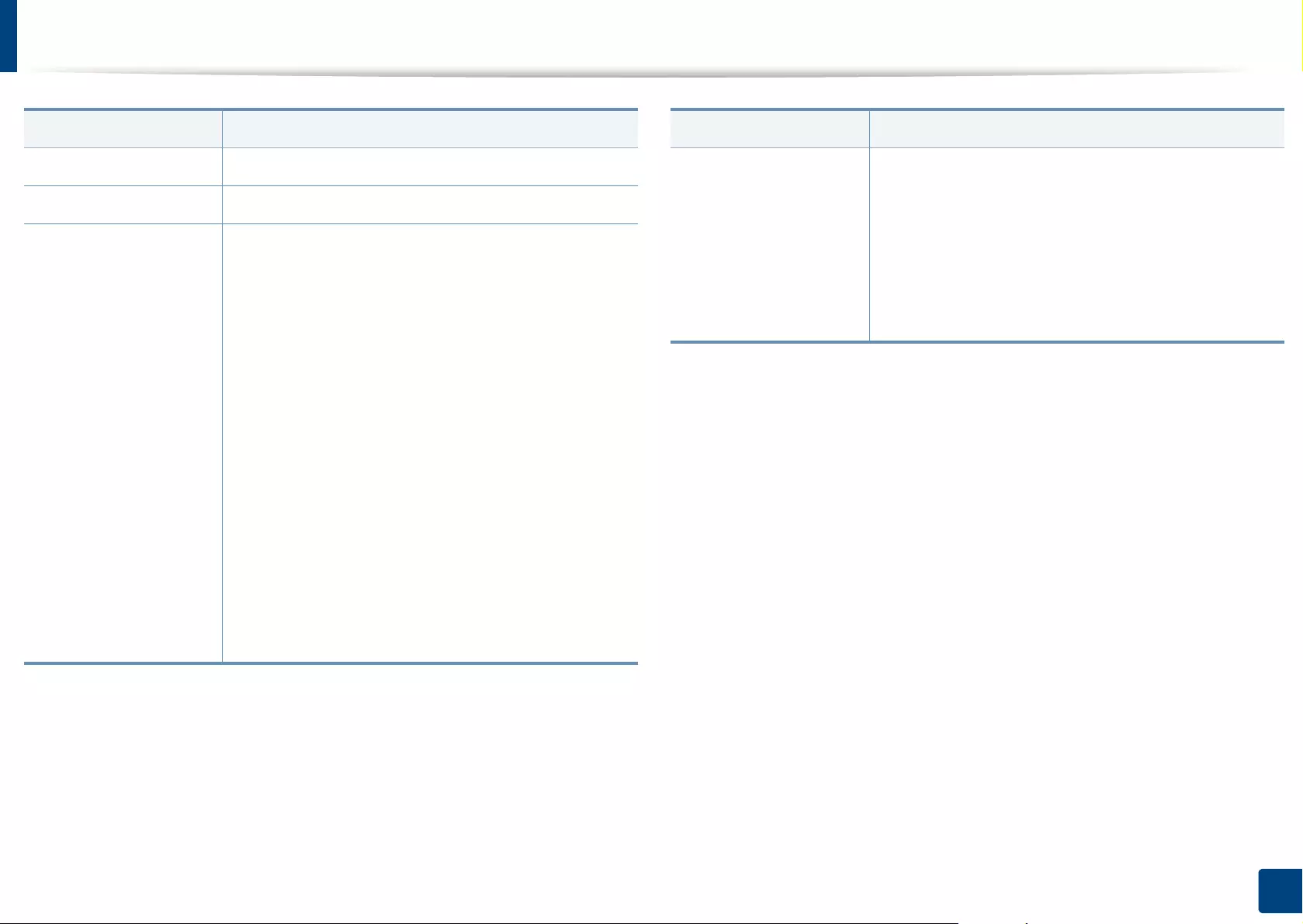
Machine setup
266
12. Menu Overview and Advanced Features
IPSec Select Off to disable IPSec.
HTTPS Select Off to disable HTTPS.
802.1x You can enable 802.1x authentication, which is a port-
based authentication. If this authentication is enabled,
the machine is not allowed to access through the
protected side of the network until the machine is
authorized. Use this feature to protect your network.
•EAP-MD5: Offers minimal security. The MD5 hash
function is vulnerable to dictionary attacks, and
does not support key generation.
•PEAP: Recommended for users who only intend to
use Microsoft desktop clients and servers. For other
users, it is not recommended.
•EAP-MSCHAPv2: EAP-MSCHAPv2 provides two-
way authentication between peers by combining a
peer Challenge message with the Response packet
and an authenticator Response message on the
Success packet.
•TLS: This is used to provide secure communication
over the Internet between a client and server.
Option Description
Accounting •No Accounting: Select not to use this feature.
•Standard Accounting: Select to use the installed
job accounting method.
•SyncThruAaProvier: Select to use the job
accounting method provided by the SyncThru™
Web Admin Service (For detailed information, refer
to the SyncThru™ Web Admin Service guide).
a. This feature may not be available depending on models or option kits installed.
Option Description
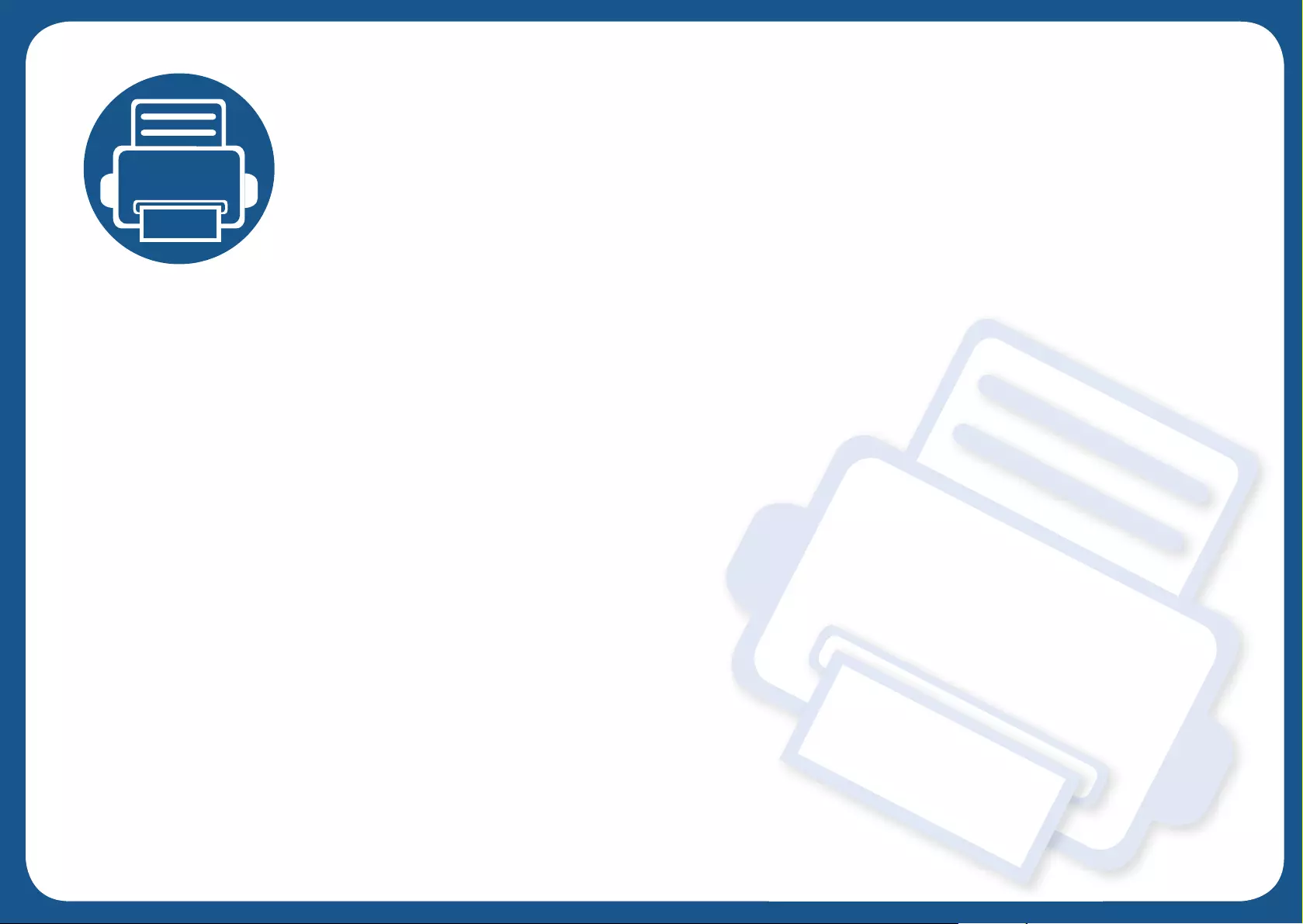
13.Useful Tools
This chapter introduces management tools provided to help you make full use of your machine.
This chapter includes:
• Accessing management tools 268
• SyncThru™ Web Service 269
• Easy Capture Manager 275
• Samsung AnyWeb Print 276
• Easy Eco Driver 277
• Using Samsung Easy Document Creator 278
• Using Samsung Printer Center 279
• Using Samsung Easy Printer Manager 282
• Using Samsung Printer Status 285
• Using Samsung Printer Experience 287
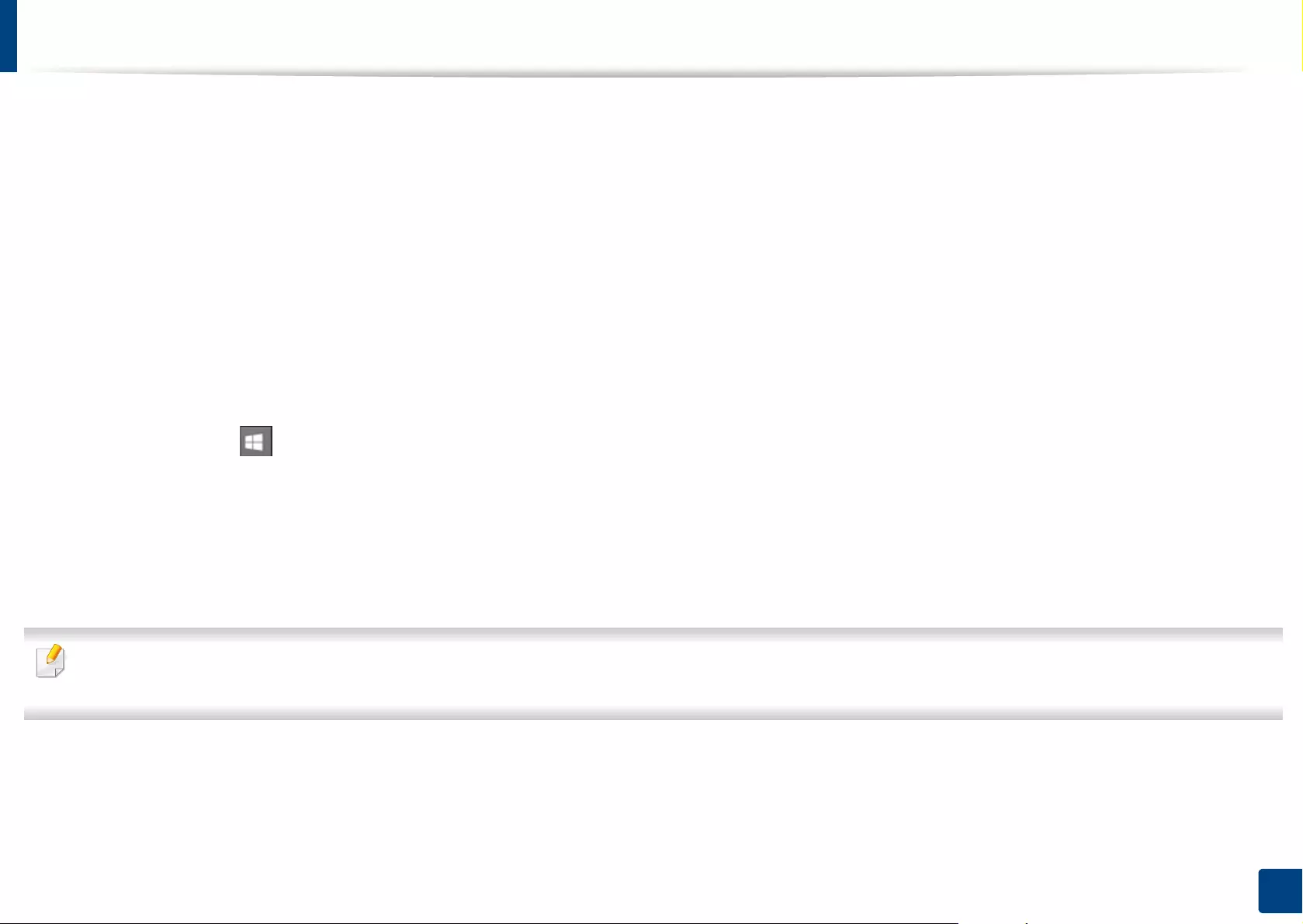
268
13. Useful Tools
Accessing management tools
Samsung provides a variety of management tools for Samsung printers.
1Make sure that the machine is connected to your computer and powered on.
2 From the Start menu, select Programs or All Programs > Samsung Printers.
• For Windows 8
From the Charms, select Search > Apps > Samsung Printers.
• Windows 10 / Windows Server 2016
From task bar, type in Samsung Printers in Search input area. Press the Enter key.
OR
From the Start ( ) icon, select All apps > Samsung Printers.
3 Find Samsung Printers.
4 Under Samsung Printers, you can see installed management tools.
5 Click the management tool you want to use.
• After installing the driver, for some management tools, you can access them directly from the Start menu > Programs or All Programs.
• For Windows 8, after installing the driver, for some management tools, you can access them directly from the Start screen by clicking on the corresponding tile.
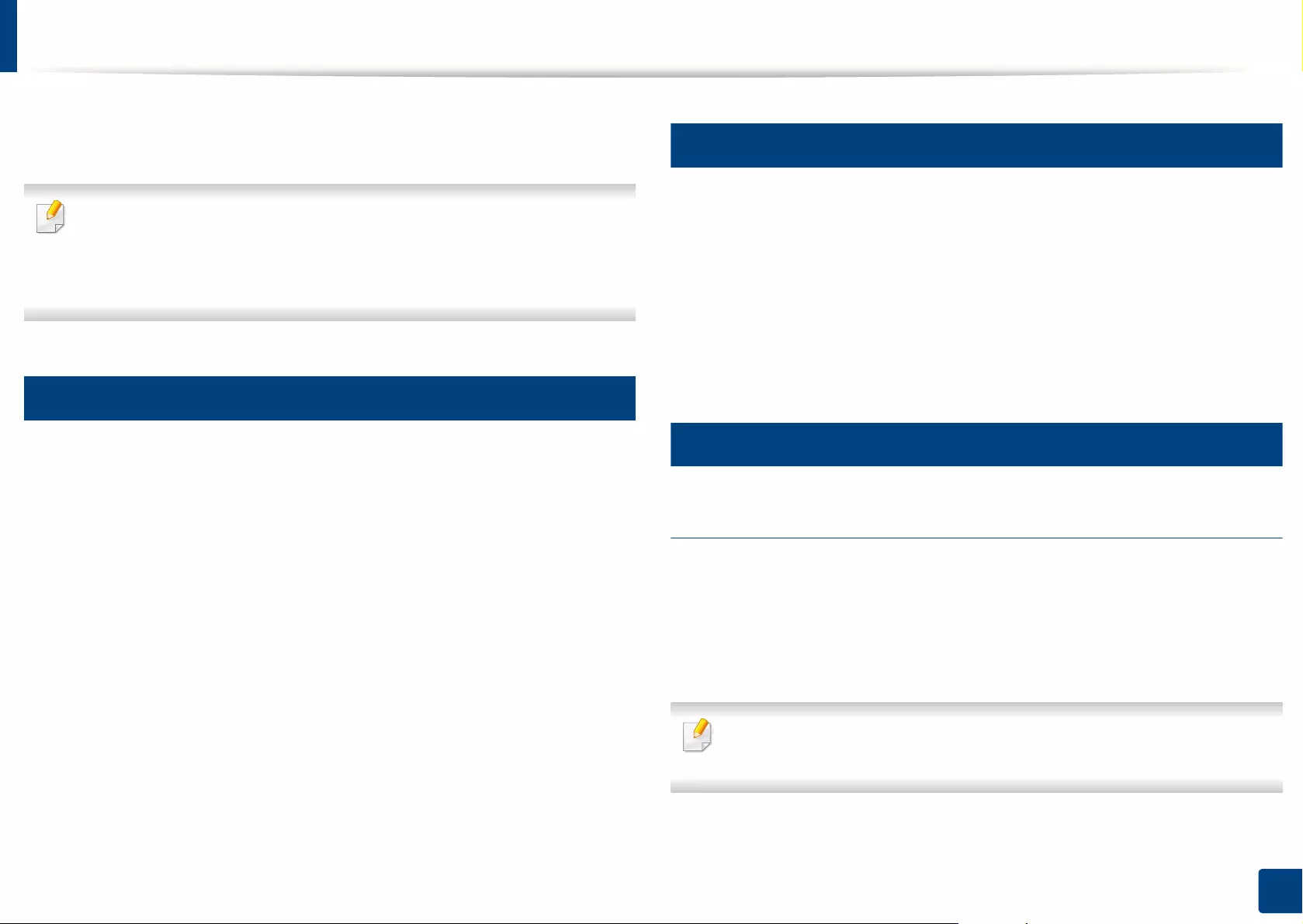
269
13. Useful Tools
SyncThru™ Web Service
This chapter gives you step-by-step instructions for setting up the network
environment through SyncThru™ Web Service.
• Internet Explorer® 8.0 or higher is the minimum requirement for
SyncThru™ Web Service.
• Some menus may not appear on the display screen depending on the
settings or models. If so, it is not applicable to your machine.
1
What is SyncThru™ Web Service?
If you have connected your machine to a network and set up TCP/IP network
parameters correctly, you can manage the machine via SyncThru™ Web Service.
Use SyncThru™ Web Service to:
• View the machine’s device information and check its current status.
• Change TCP/IP parameters and set up other network parameters.
• Change the printer preference.
• Set the email notifications advising of the machine’s status.
• Get support for using the machine.
• Upgrade machine software.
2
Required web browser
You need one of the following web browsers to use SyncThru™ Web Service.
• Internet Explorer® 8.0 or higher
• Chrome 27.0 or higher
• FireFox 21.0 or higher
• Safari 5.9.1 or higher
3
Connecting to SyncThru™ Web Service
IPv4 supported web browser
1Start a web browser, such as Internet Explorer®, that supports IPv4
addressing as a URL.
Enter the machine’s IP address (http://xxx.xxx.xxx.xxx) in the address
field and press the Enter key or click Go.
You can get the machine’s IP address from the machine report (see"Other
settings" on page 249).
2 Your machine’s SyncThru™ Web Service website opens.
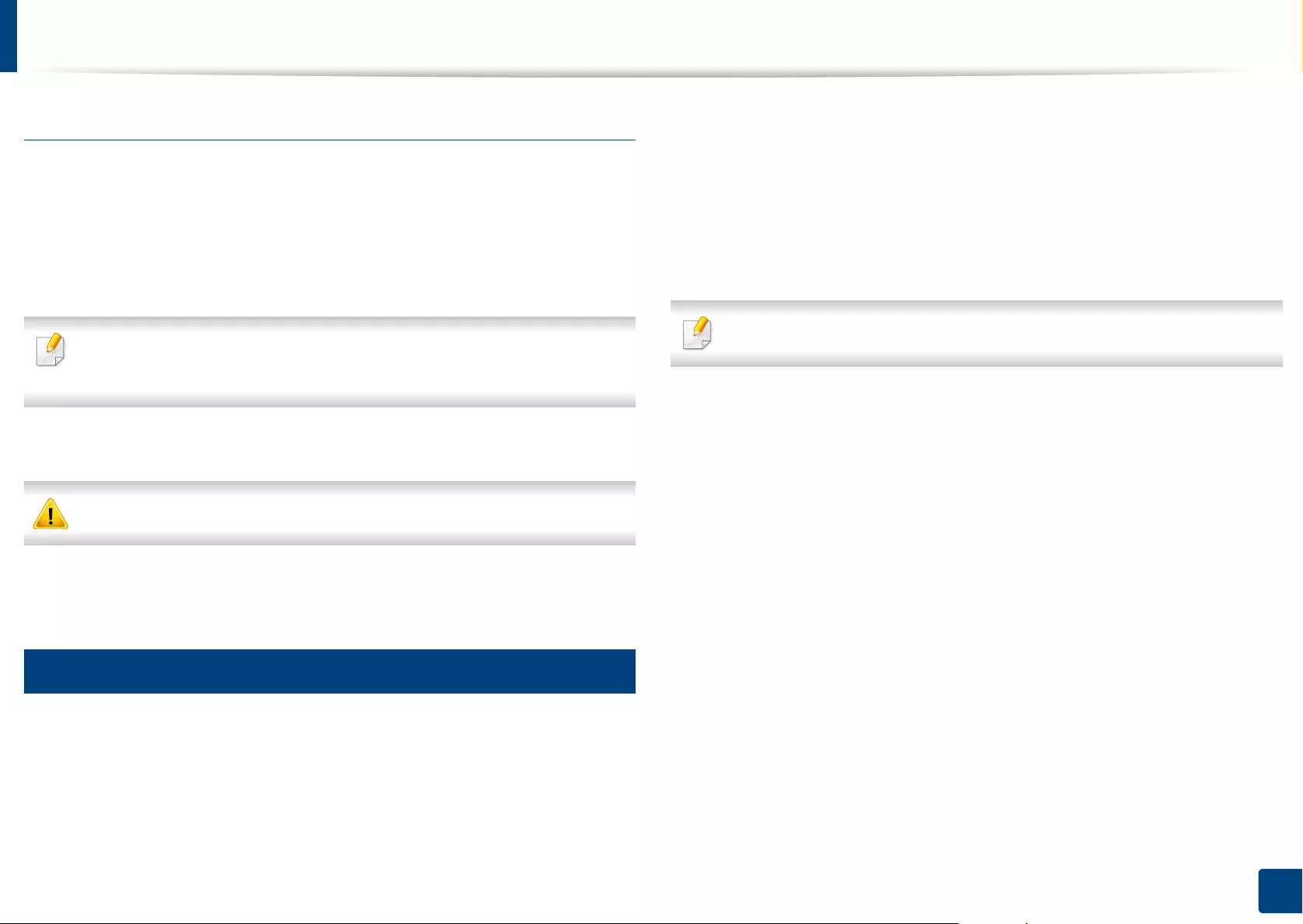
SyncThru™ Web Service
270
13. Useful Tools
IPv6 supported web browser
1Start a web browser, such as Internet Explorer®, that supports IPv6
addressing as a URL.
2 Select one of the IPv6 addresses (Stateless Address, Stateful Address,
Manual Address) from Network Configuration Report.
You can get the machine’s IPv6 address from the machine report (see"Other
settings" on page 249).
3 Enter the IPv6 addresses (eg., http://[3ffe:10:88:194:213:77ff:fe82:75b]).
The address must be enclosed in '[ ]' brackets.
4 Your machine’s SyncThru™ Web Service website opens.
4
Logging into SyncThru™ Web Service
Before configuring options in SyncThru™ Web Service, you need to log-in as an
administrator. You can still use SyncThru™ Web Service without logging in, but
you will not have access to or view the Settings tab and the Security tab.
1Click Login on the upper right of the SyncThru™ Web Service website.
A log-in page appears.
2 Type in the ID and Password.
Use the same login ID, Password as when logging in from the machine
(see "Log-in" on page 243).
If you want to change the password, see "Security tab" on page 272.
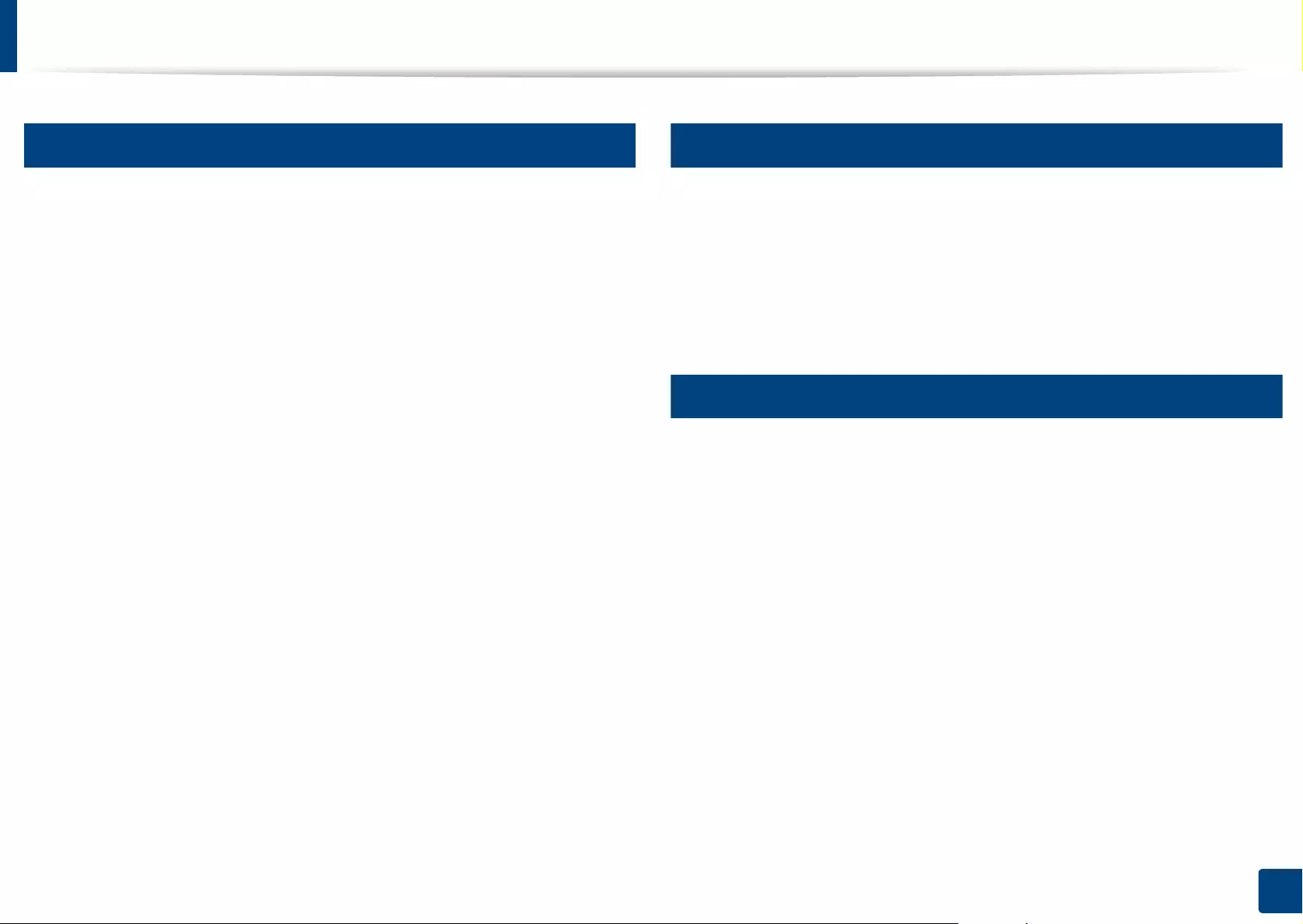
SyncThru™ Web Service
271
13. Useful Tools
5
Information tab
This tab gives you general information about your machine. You can check
things, such as the machine’s status, supplies’ status, count information,
network information, and more. You can also print reports, such as
configuration page.
•Active Alerts: You can check the current alerts in the machine. Use this
information to troubleshoot machine errors.
•Supplies: You can check the supplies’ information. For toner cartridge,
supplies’ status is displayed with a visual graph showing you the amount of
each supply left. Page counts are also available which can help you predict
when to change the supplies. This feature is also available from the machine.
•Usage Counters: You can check the billing information and usage counter
of the machine. This feature is also available from the machine.
•Current Settings: Shows the current settings of the machine and network.
-Machine Information: Shows the current machine settings.
-Network Information: Shows the current network settings. Use this
page as a reference and change the necessary settings needed for using
the network.
•Security Information: Shows the current security settings of the machine
and network.
•Print Information: You can print all the reports provided by your machine.
You can use these reports to help you maintain your machine. This feature
is also available in the machine (see "Other settings" on page 249).
6
Address book tab
You can manage the address book. This feature is also available from the
machine (see "Setting up an address book from the control panel" on page 194).
•Individual: You can manage individual entries in the address book.
•Group: You can manage group address books.
7
Settings tab
Settings tab has sub menus, Machine Settings and Network Settings. You
cannot view or access this tab if you do not log-in as an administrator (see
"Logging into SyncThru™ Web Service" on page 270).
•Machine Settings: You can set machine settings.
-System: You can set machine related settings.
-Printer: You can set print related settings such as darkness or adjust the
background. This feature is also available from the machine.
-Copy: You can set copy related settings such as darkness or adjusting
the background.
-Fax: You can set fax related settings such as fax number or redial times.
This feature is also available from the machine (see "Understanding the
fax screen" on page 175).
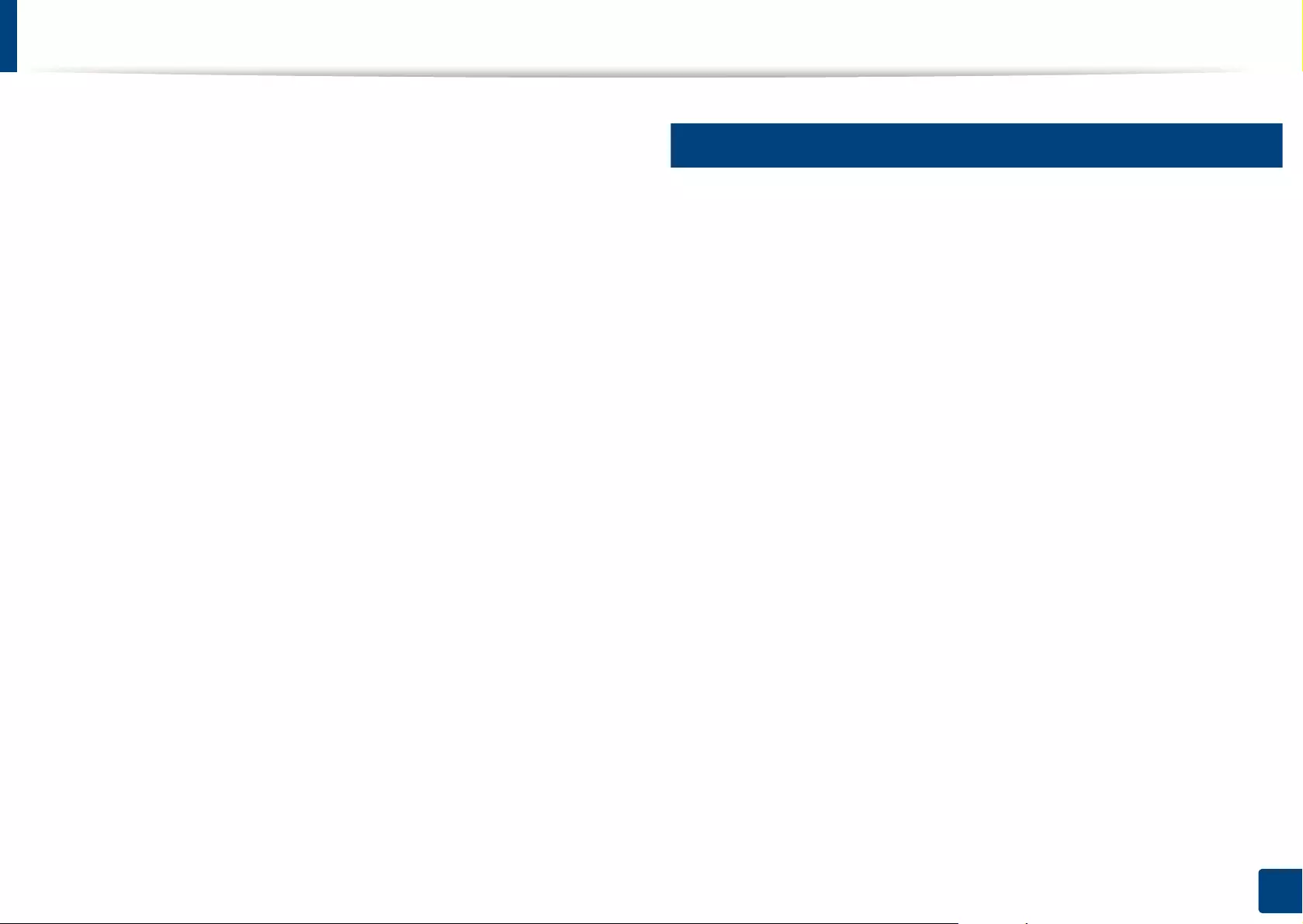
SyncThru™ Web Service
272
13. Useful Tools
-Scan: You can set scan related settings. This feature is also available
from the machine (see "Understanding the Scan to Email screen" on
page 146).
-Email Notification: When an error occurs or the consumables are
running out, the machine sends a notification to the administrator via
email. You can set whether to use this feature or not. You can also select
which alerts to receive and when.
•Network Settings: You can set up the network environment to use your
machine as a network machine. You can also set the settings from the
machine. Refer to the network setup chapter (see "Network Settings" on
page 262).
-General: You can set general machine information to use in the
network and set ethernet settings. This feature is also available from the
machine.
- TCP/IPv4, TCP/IPv6, Raw TCP/IP, LPR/LPD, IPP, Telnet, WSD, SLP, UPNP,
mDNS, CIFS (Shared Folder), SNMPv1/v2, SNMPv3, FTP Print Server,
AirPrint, ThinPrint®, Google Cloud Print: You can set protocol settings.
-Outgoing Mail Server (SMTP): You can set server settings for outgoing
emails. If this setting is not configured, you cannot use scan to email
feature. Outgoing emails will be sent through SMTP server you set here.
-HTTP: You can allow or block users from accessing the SyncThru™ Web
Service.
-Proxy: You can set proxy settings and enable authentication.
-Restore Default: Clicking the Clear button under the Restore Default
section will clear security and network configurations. Restoring the
settings will take effect after the system is rebooted.
8
Security tab
The security tab has System Security, Network Security, User Access Control
and System Log. You cannot access this tab if you do not log-in as an
administrator (see "Logging into SyncThru™ Web Service" on page 270).
•System Security: From the SyncThru™ Web Service, select the Security tab
> System Security.
-System Administrator: Enter the system administrator’s information.
The machine sends email notification to the email address set here. This
feature is also available from the machine.
-Feature Management: Specifies the services, PC application security,
physical ports, and network protocol features to use. Select the features
to use, and then click Apply.
-Information Hiding: Specifies which information to hide. Select the
amount of information that you want to hide, and then click Apply.
-Restart Device: You can reboot your machine. Click the Restart Now
button to reboot.
•Network Security: From the SyncThru™ Web Service, select the Security
tab > Network Security.
-Digital Certificate: You can manage digital certificates. A digital
certificate is an electronic certificate that verifies the secure association
between communication nodes. You need to add the certificate for SSL
communication.
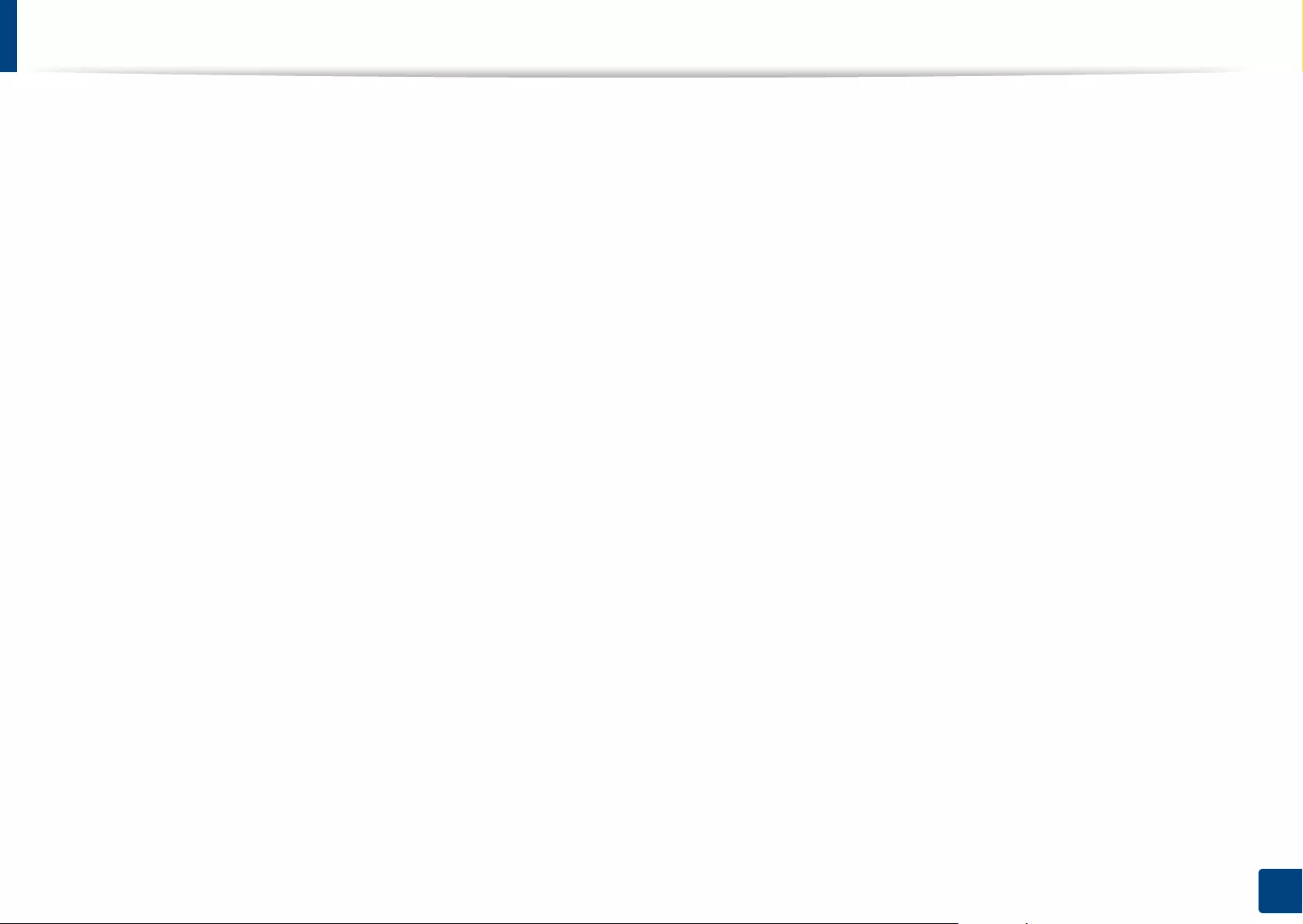
SyncThru™ Web Service
273
13. Useful Tools
-Secure Connection: You can enable or disable secure connection to
use more enhanced secure network channel. For secure
communication, using the Secure Connection feature is
recommended.
-SNMPv3: You can set SNMPv3.
-IP Security: You can set IP security settings.
-IP/MAC Filtering: You can set filtering options for IP and MAC
addresses. If the administrator does not add a filtering rule for IPv4, IPv6,
and MAC addresses, nothing is filtered. If the administrator has added a
filtering rule, filtering will be applied to the entered IPv4, IPv6, and MAC
addresses.
▪IPv4 Filtering: You can enable/disable IPv4 filtering as well as
manage filtering rules.
▪IPv6 Filtering: You can enable/disable IPv6 filtering as well as
manage filtering rules.
▪MAC Filtering: You can enable/disable Mac filtering as well as
manage filtering rules.
-802.1x(Ethernet): You can enable/disable 802.1x Security as well as
manage filtering rules.
-External Authentication Server: Set the servers for authentication.
•User Access Control: You can restrict users from accessing the machine or
application. You can also give specific permission for user to only use certain
feature of the machine. For example, you can allow user A to only use print
feature. In this case, user A will not be able to scan, copy or fax with the
machine.
-Authentication: You can choose the authentication method for user
authentication. Select a mode and click on the Options button.
-Authorization (Giving rights): You can give permissions to a user to
only use certain features of the machine.
▪Authority Management: You can give different rights to different
users. For example, you can allow user A to use all the machine’s
functions while giving user B only the right to print.
▪External User Authority: Set the servers for authentication.
-Accounting: You can manage accounts.
-User profile: You can store user information on the machine’s hard
drive. You can use this feature to manage the users using the machine.
You can also group the users and manage them as a group. You can
make a maximum of 500 individual users and 200 user groups.
•System Log: You can keep logs of events that have happened in the
machine. The administrator can record and manage the machine usage
information by keeping the system log files. The system log files are stored
on the machine’s mass storage device (hard disk), and when it is full, it will
erase old data. Export and save the important audit data separately using
the exporting feature.
-Log configuration: You can enable or disable keeping logs. You can
also backup log files by periods and transfer to a repository server.
-Log Viewer: You can view, delete, and search log files.
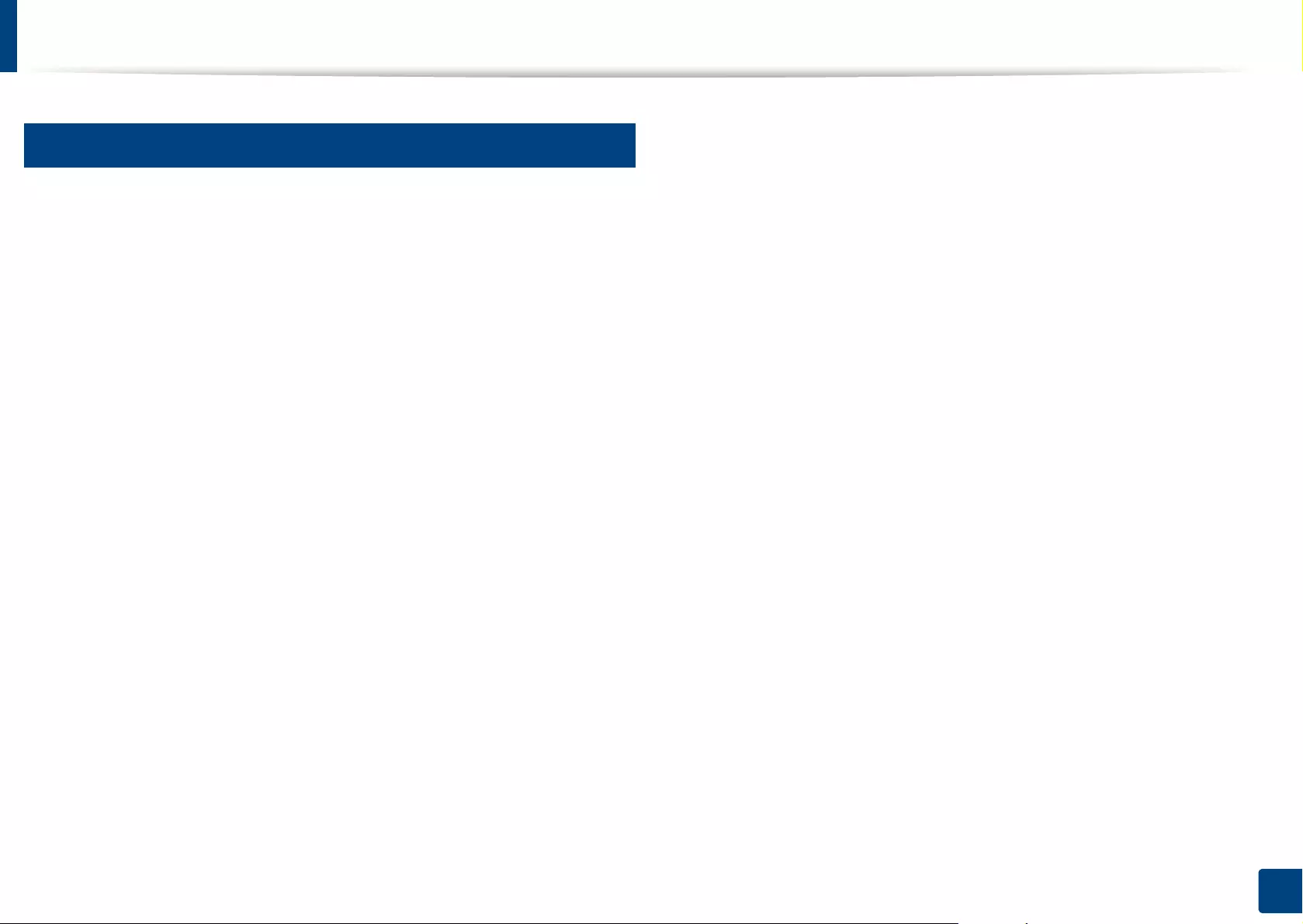
SyncThru™ Web Service
274
13. Useful Tools
9
Maintenance tab
This tab allows you to maintain your machine by upgrading firmware, managing
applications, and setting contact information for sending emails. You can also
connect to the Samsung website or download manuals and drivers by selecting
the Link menu.
•Firmware Upgrade: You can check the firmware version used in the
machine. Check the version and update it if necessary.
•Application Management: You can add or delete applications/license. If
you add an application, you need to activate the license of the installed
application. Some applications may not have a license.
•Contact Information: You can view contact information.
•Link: You can view links to useful websites where you can:
- view product information and get support (Samsung website).
- download manuals and drivers.
- order consumable supplies.
- register your machine on-line.
•Samsung MIB Version: The version number of the MIB(Management
Information Base).
•License Management: License Management provides settings managing
the licenses for installed applications.
•Cloning: The machine prints multiple original images on a single page. The
number of images is automatically determined by the original image and
the paper size. You can enable or disable the clone menu.
•Wi-Fi Interface: You can enable or disable the Wi-Fi menu.
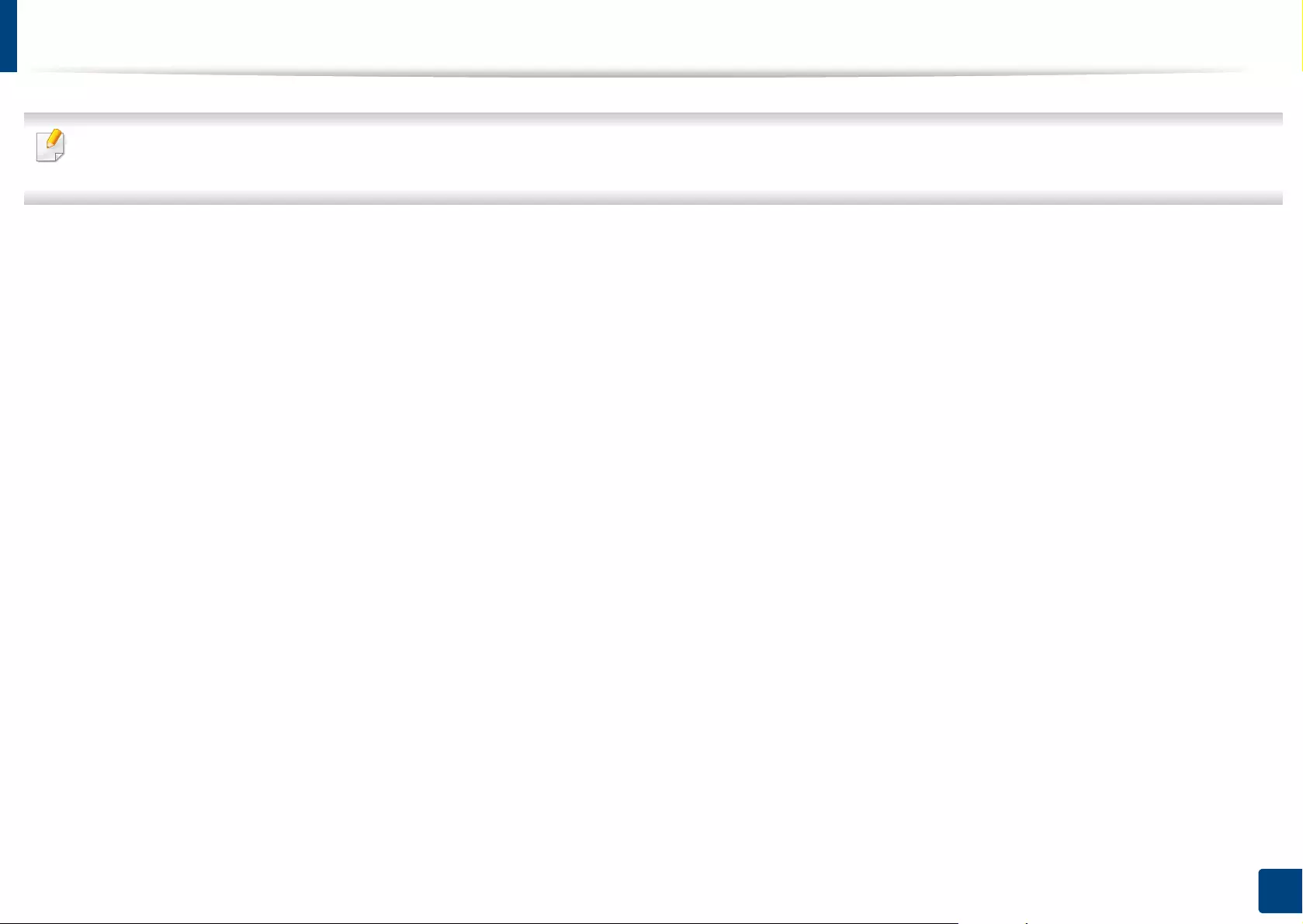
275
13. Useful Tools
Easy Capture Manager
• Available for Windows OS users only.
• This feature may not be available depending on model or optional goods (see "Software" on page 9).
Capture your screen and launch Easy Capture Manager by simply pressing the Print Screen key on the keyboard. Now you can easily print your captured screen as
captured or edited.
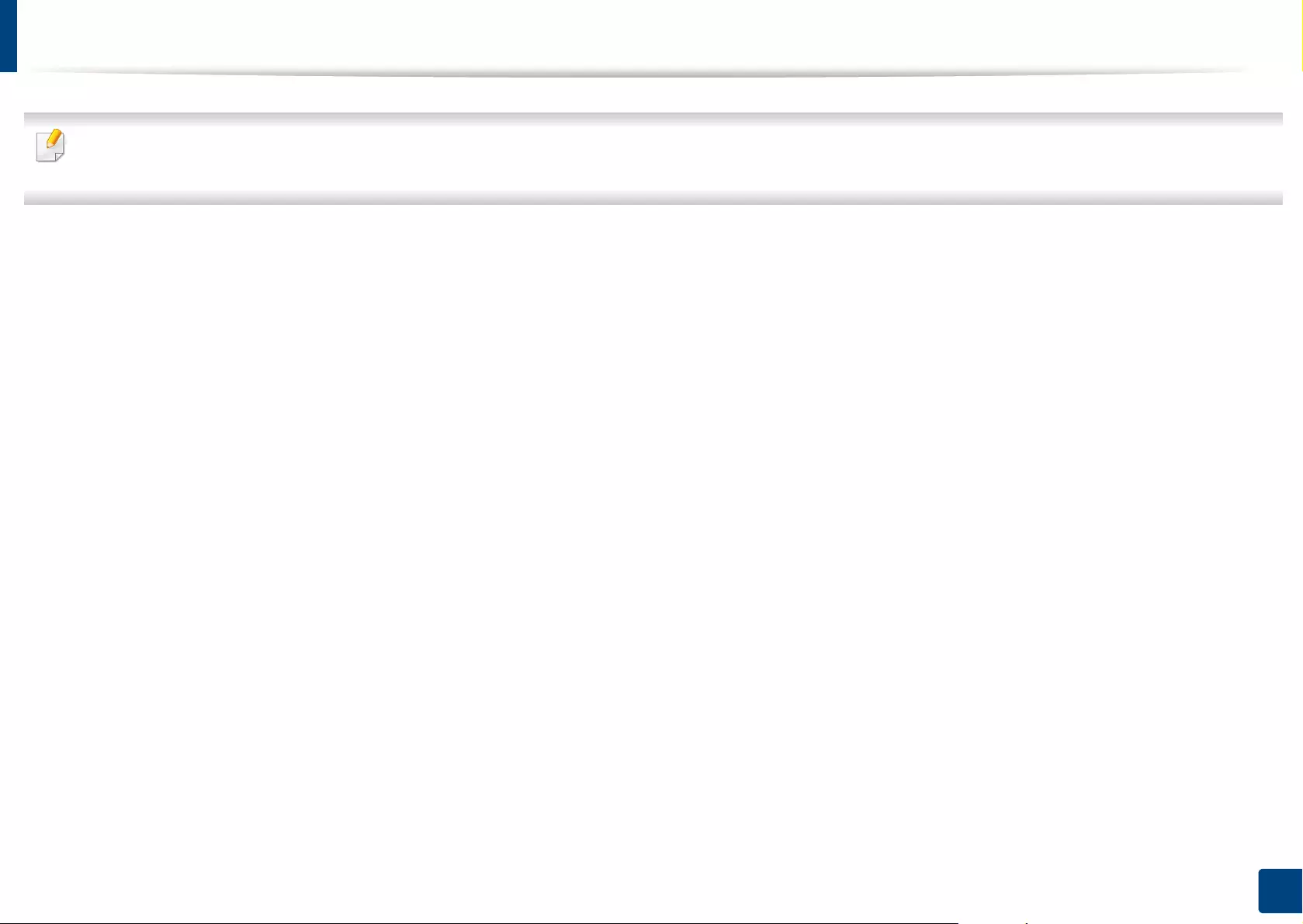
276
13. Useful Tools
Samsung AnyWeb Print
• Available for Windows OS users only.
• This feature may not be available depending on model or optional goods (see "Features by model" on page 9).
This tool helps you screen-capture, preview, scrap, and print Windows Internet Explorer pages more easily, than when you use an ordinary program.
Download the software from the Samsung website then unpack and install it: (http://www.samsung.com > find your product > Support or Downloads).
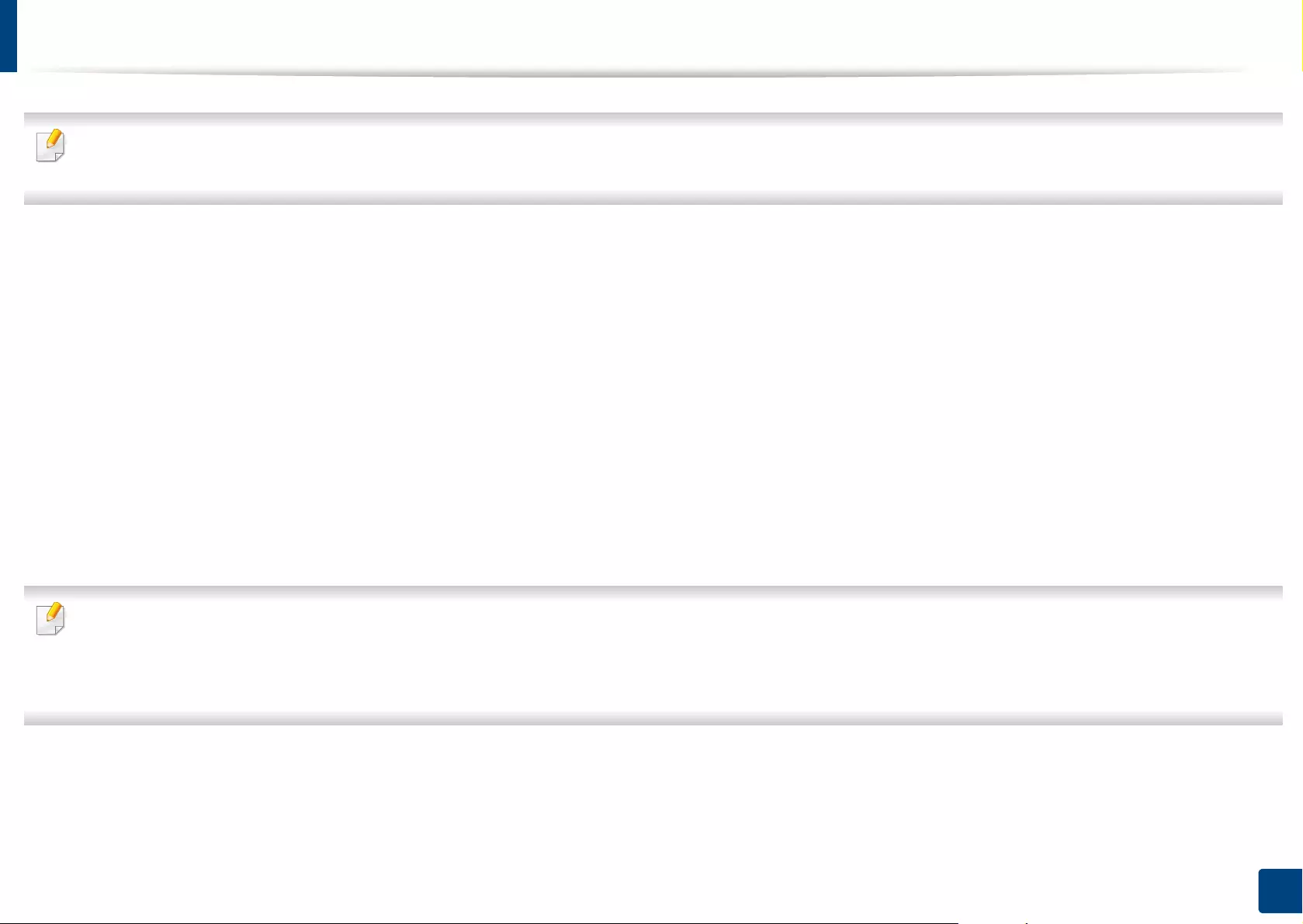
277
13. Useful Tools
Easy Eco Driver
• Available for Windows OS users only (see "Software" on page 9).
• To use the Easy Eco Driver features, the Eco Driver Pack must be installed.
With the Easy Eco Driver, you can apply Eco features to save paper and toner before printing.
Easy Eco Driver also allows you simple editing such as removing images and texts, and more. You can save frequently used settings as a favorite (preset).
How to use:
1 Open a document to print.
2 Open printing preference window (see "Opening printing preferences" on page 96).
3 From the Favorites tab, select Eco Preview Printing.
4 Click OK > Print in the window. A preview window appears.
5 Select the options you want to apply to the document.
You can see the preview of the applied features.
6 Click Print.
• If you want to run Easy Eco Driver every time you print, check Start Easy Eco Driver before printing job checkbox in the Basic tab of the printing preference
window.
• To use this feature on Stylish User Interface, click Samsung Printer Center > Device Options and then select Stylish User Interface (see "Using Samsung Printer
Center" on page 279).
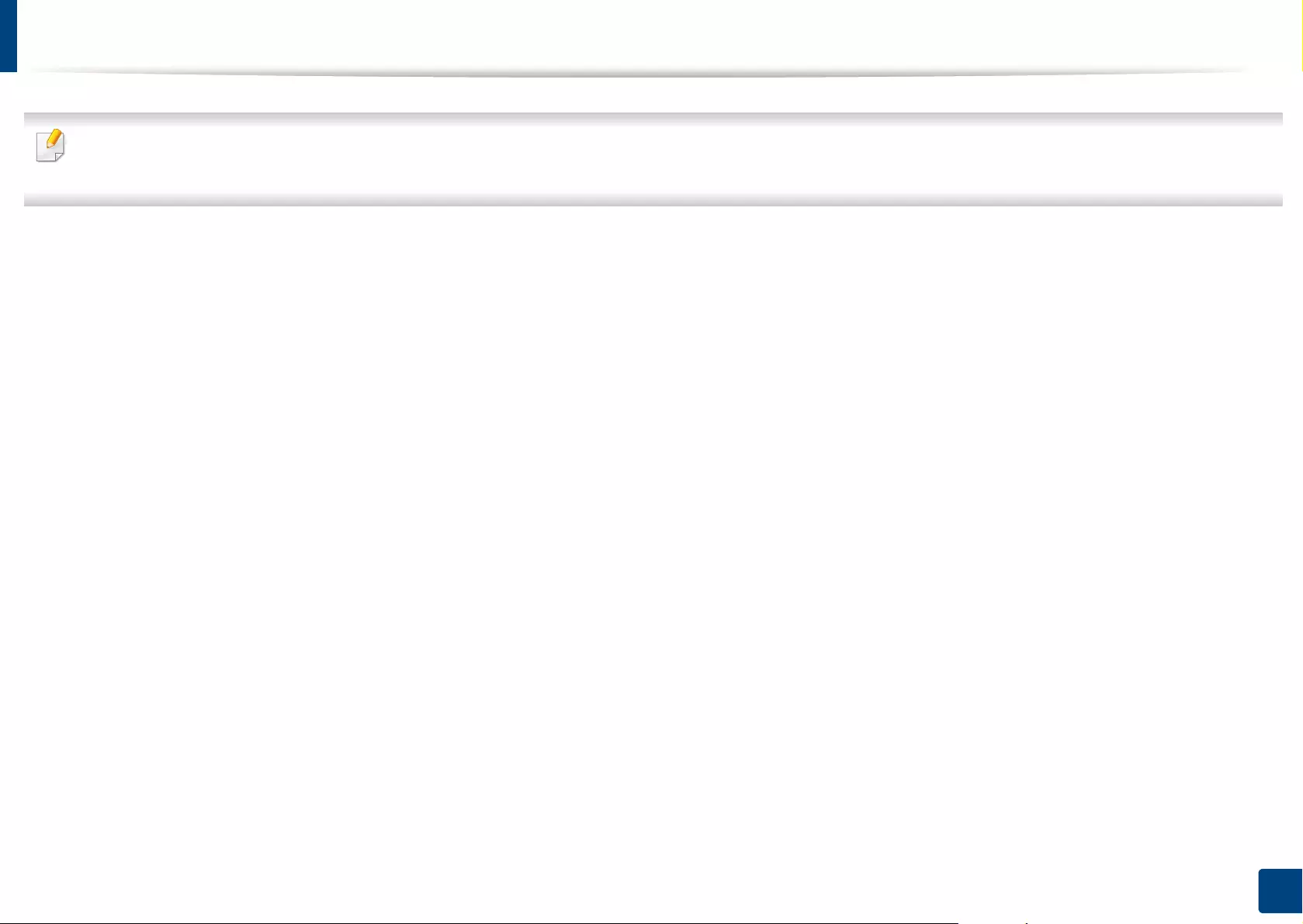
278
13. Useful Tools
Using Samsung Easy Document Creator
• Available for Windows and Mac OS users only.
•Windows
® XP Service Pack 3 or higher and Internet Explorer 6.0 or higher is the minimum requirement for Samsung Easy Document Creator.
Samsung Easy Document Creator is an application to help users scan, compile, and save documents in multiple formats, including .epub format. These documents
can be shared via social networking sites or fax. Whether you’re a student needing to organize research from the library or a stay-at-home mom sharing scanned
pictures from last year’s birthday party, Samsung Easy Document Creator will provide you with the necessary tools.
The Samsung Easy Document Creator provides features mentioned below:
•Scan: Use for scanning pictures or documents.
•Text Converting Scan(Windows only): Use for scanning documents that need to be saved in an editable text format.
•Document Conversion: Provides the ability to convert existing files into multiple formats.
•Fax: Provides the ability to directly fax a document from Easy Document Creator if the Samsung Network PC fax driver is installed.
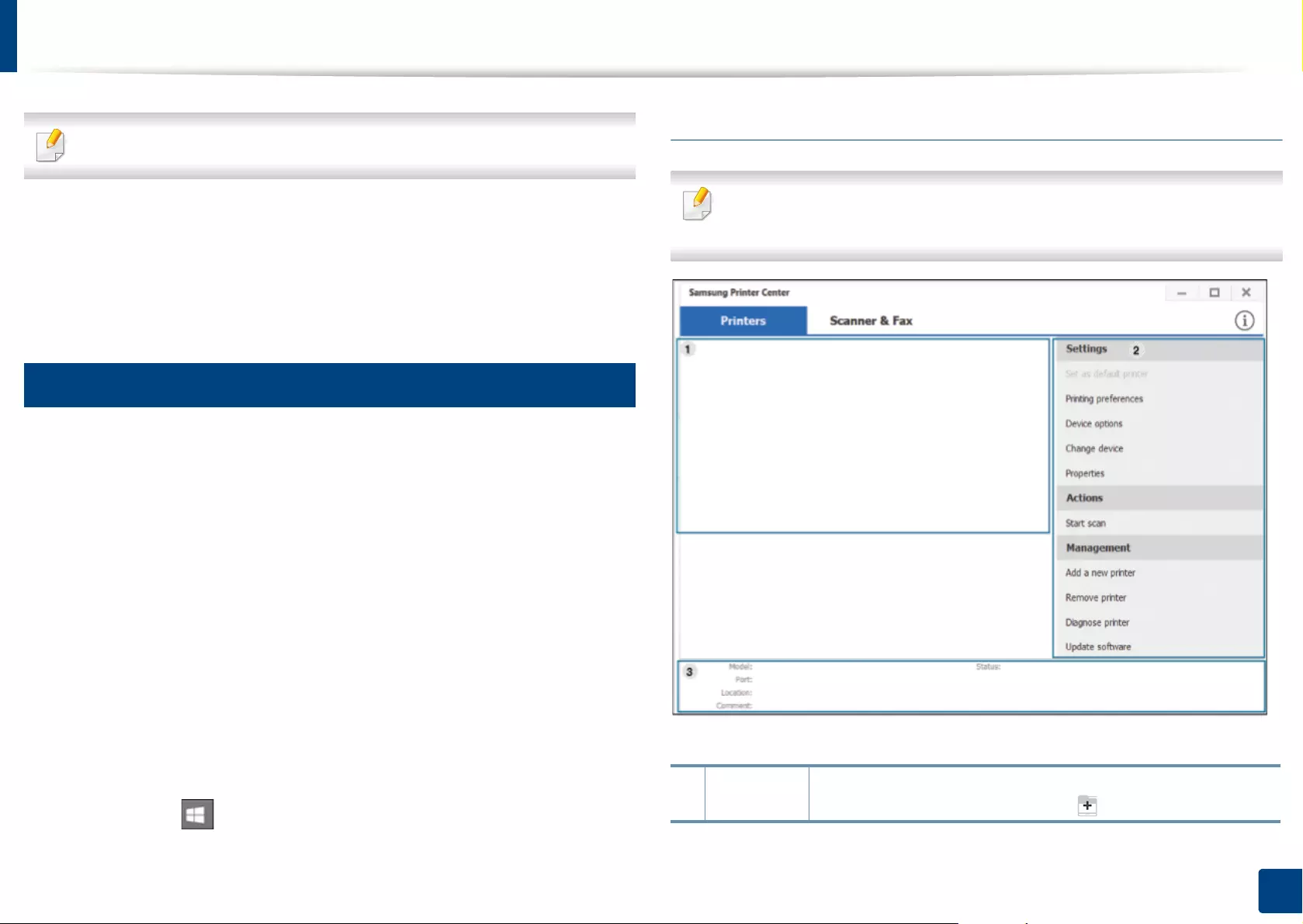
279
13. Useful Tools
Using Samsung Printer Center
Available for Windows users only.
The Samsung Printer Center allows you to manage all the printer drivers
installed on your computer from a single integrated application. You can use the
Samsung Printer Center to add and remove printer drivers, check the status of
printers, update printer software, and configure printer driver settings.
10
Understanding Samsung Printer Center
To open the program:
For Windows,
Select Start > Programs or All Programs > Samsung Printers > Samsung
Printer Center.
• For Windows 8
From the Charms, select Search > Apps > Samsung Printers > Samsung
Printer Center.
• Windows 10 / Windows Server 2016
From task bar, type in Samsung Printers in Search input area. Press the
Enter key and then select Samsung Printer Center.
OR
From the Start ( ) icon, select All apps > Samsung Printers> Samsung
Printer Center.
Printers tab
The screenshot may differ depending on operating system, model, or
options.
1Printer list Displays the printer drivers installed on your computer. To add
a printer driver to the list, click the button.
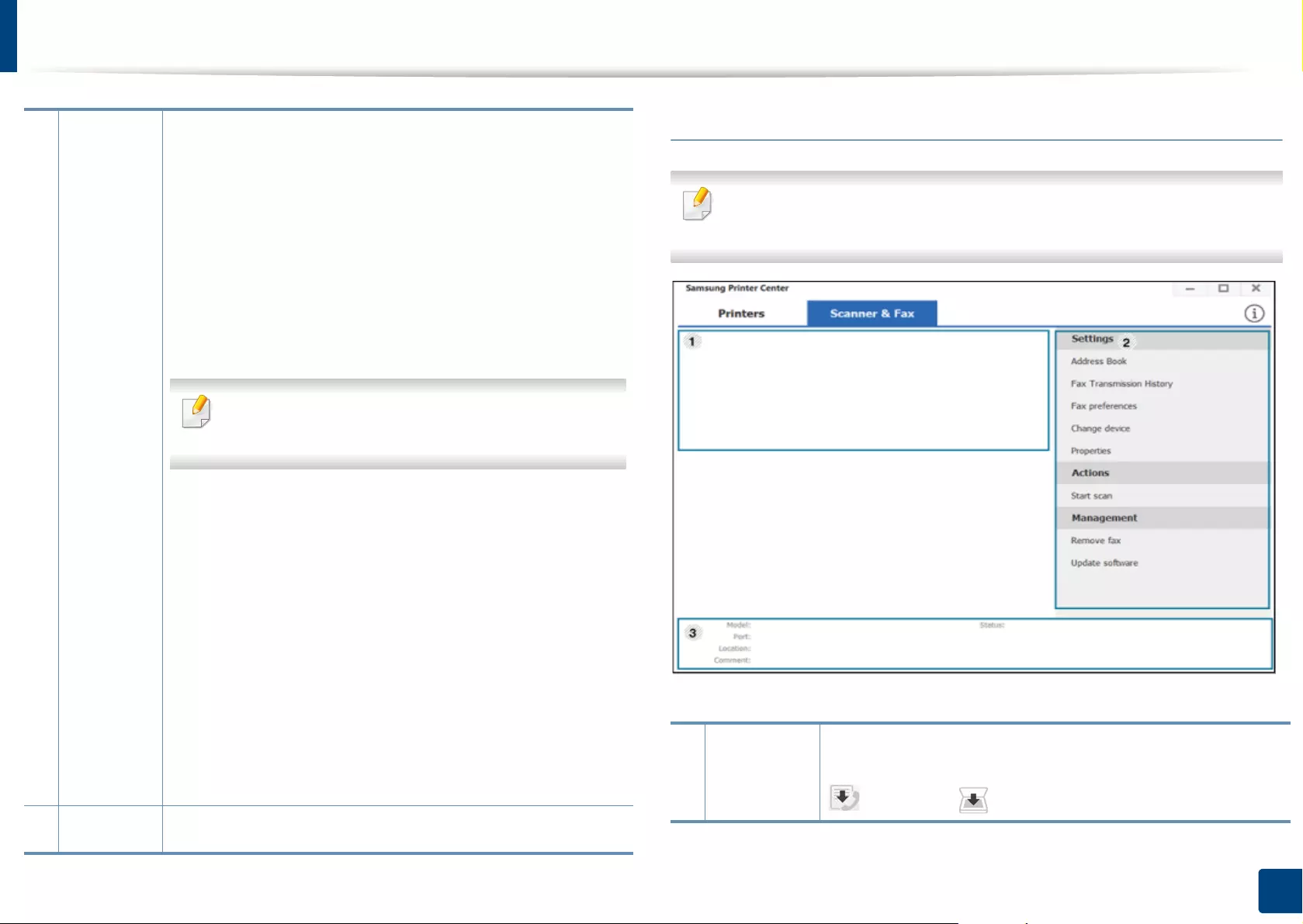
Using Samsung Printer Center
280
13. Useful Tools
Scanner & Fax Tab
•
The screenshot may differ depending on operating system, model, or option.
•
Available for multifunction products only.
2
Quick links
Displays links to various printer driver management functions. The
quick links in the
Printers
tab link to the following functions:
•
Settings:
Allows you to configure the settings for individual
printer driver
.
-
Set as default printer:
Sets the selected printer driver as the
default printer. If the selected printer driver is already set as the
default printer, then this option is not activated.
-
Printing preferences:
Allows you to configure the default
print settings.
-
Device options:
Allows you to configure advanced options,
such as the settings for optional devices and additional
features.
The option allows you to modify the
Printer Status
and
Stylish User Interface
settings.
-
Change device:
Allows you to change the device into another
device.
-
Properties:
Allows you to configure the printer driver
properties, such as the name of the printer driver and its
location, or add comments about the printer driver.
•
Actions:
Allows you to use the scan feature (this option is enabled
only if the selected device supports the scan feature).
•
Management:
Allows you to manage the devices registered in
the program.
-
Add a new printer / Remove printer:
Adds a new device or
removes an existing device.
-
Diagnose printer:
Diagnoses problems in the selected device
and suggests solutions.
-Update software: Downloads and applies the
applicable software updates.
3
Printer
information
Provides general information about the selected device, such
as its model, IP address, port number, and status.
1
Printer list Displays the fax and scanner driver installed on your
computer. To add a fax or scanner driver to the list, click the
(Add Fax) or (Add Scanner) button.
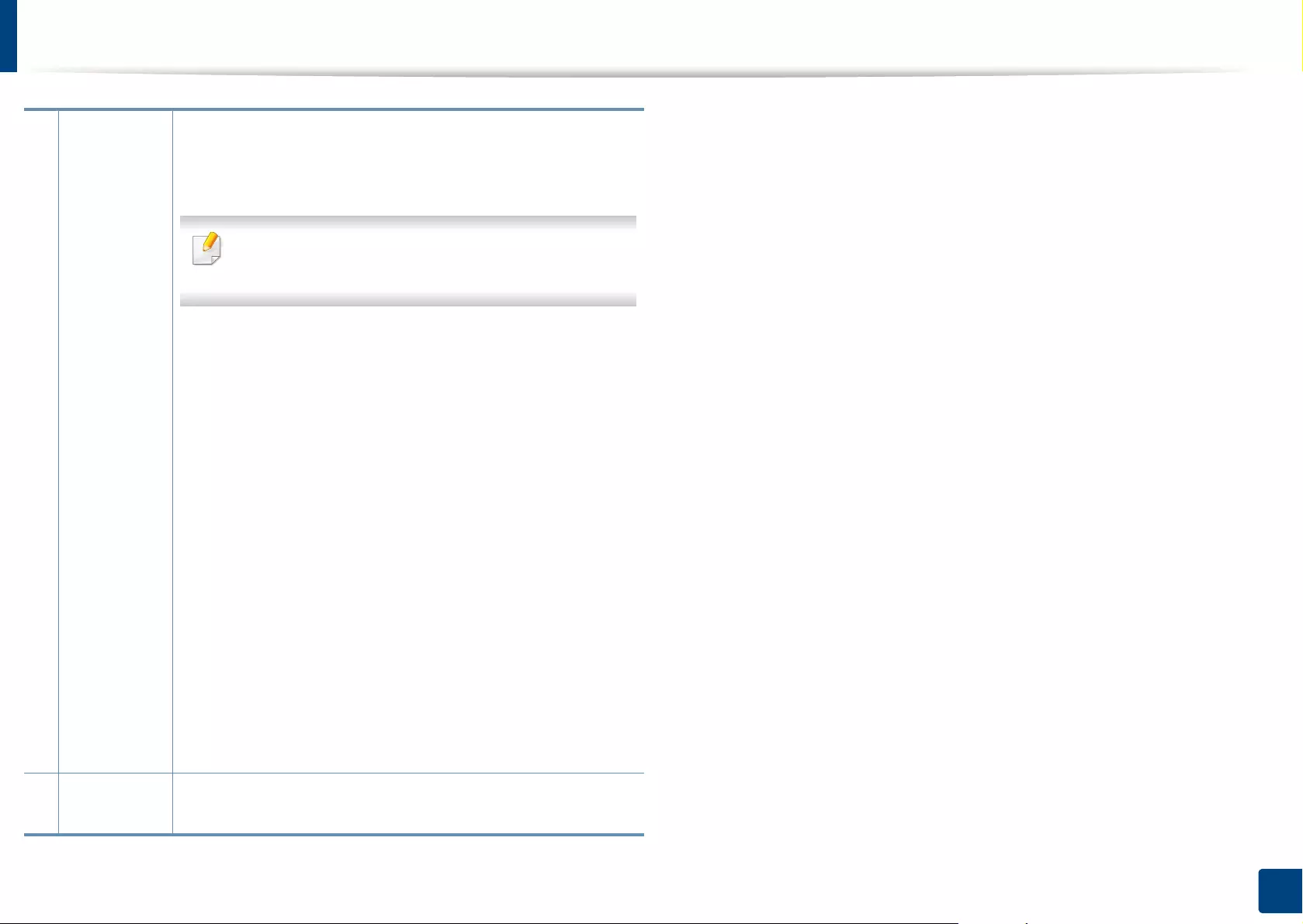
Using Samsung Printer Center
281
13. Useful Tools
2
Quick links Displays links to the functions available for managing fax or
scanner drivers. The quick links in the Scanner & Fax tab offer
the following features:
To use this feature, the scanner driver and fax driver
must be installed on the computer.
•Settings: Allows you to configure the settings for fax or
scanner dirvers.
-Address Book (fax only): Opens the Address Book.
-Fax Transmission History (fax only): Opens the fax
transmission history.
-Fax preferences (fax only): Allows you to configure the
default fax settings.
-Change device: Allows you to change the devices into
another device.
-Properties: Allows you to configure the properties of a
device, such as location and add comments about the
device.
•Actions: Allows you to use the scan feature.
•Management: Allows you to manage the devices
registered in the program.
-Remove fax or Remove scan: Removes the selected fax
or scan driver.
-Update software: Downloads and applies the
applicable software updates.
3
Printer
information
Provides general information about the selected device, such
as the model, IP address, port number, and machine status.
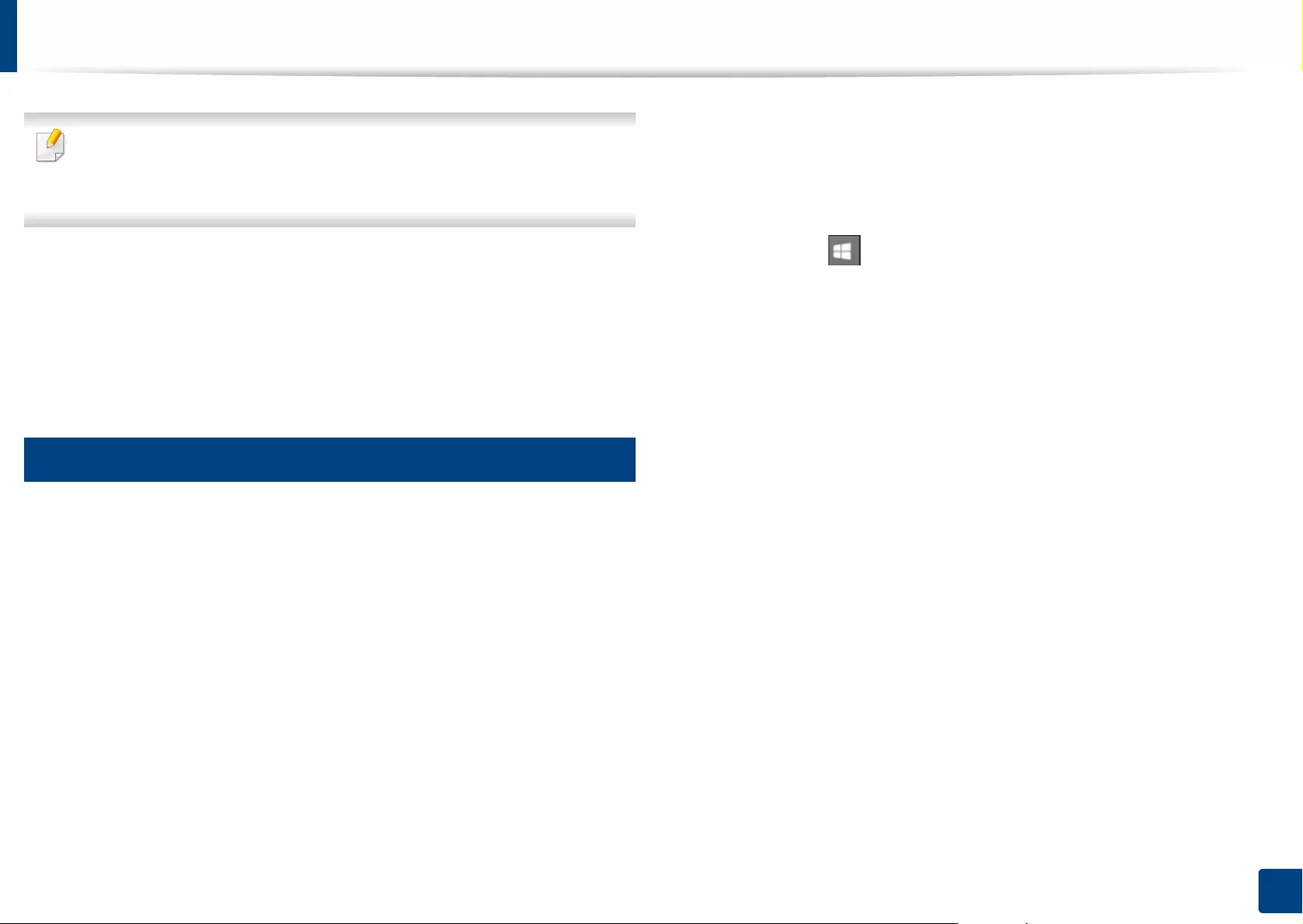
282
13. Useful Tools
Using Samsung Easy Printer Manager
• Available for Windows and Mac OS users only.
• For Windows, Internet Explorer 6.0 or higher is the minimum
requirement for Samsung Easy Printer Manager.
Samsung Easy Printer Manager is an application that combines Samsung
machine settings into one location. Samsung Easy Printer Manager combines
device settings as well as printing environments, settings/actions and
launching. All of these features provide a gateway to conveniently use your
Samsung machine.
11
Understanding Samsung Easy Printer Manager
To open the program:
For Windows,
Select Start > Programs or All Programs > Samsung Printers > Samsung
Easy Printer Manager.
• For Windows 8
From the Charms, select Search > Apps > Samsung Printers > Samsung
Easy Printer Manager.
• Windows 10 / Windows Server 2016
From task bar, type in Samsung Printers in Search input area. Press the
Enter key and then select Samsung Easy Printer Manager.
OR
From the Start ( ) icon, select All apps > Samsung Printers> Samsung
Easy Printer Manager.
For Mac,
Open the Applications folder > Samsung folder > Samsung Easy Printer
Manager.
The Samsung Easy Printer Manager interface is comprised of various basic
sections as described in the table that follows:
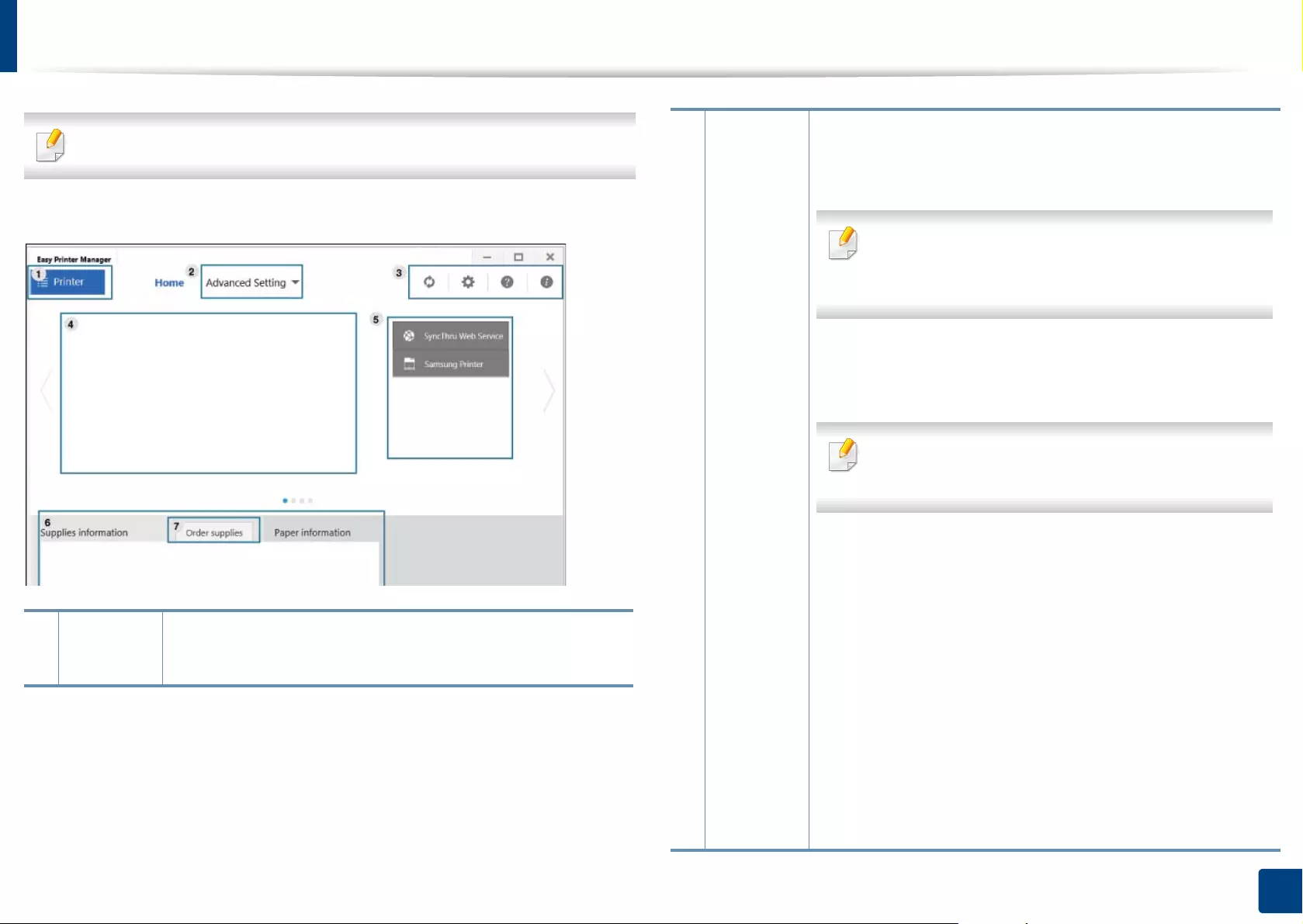
Using Samsung Easy Printer Manager
283
13. Useful Tools
The screenshot may differ depending on operating system, model, or option.
1
Printer list The Printer list displays printers installed on your computer
and network printers added by network discovery (Windows
only).
2Advanced
Setting
The advanced user interface is intended to be used by the
person responsible for managing the network and
machines.
Some menus may not appear in the display
depending on options or models. If so, it is not
applicable to your machine.
•Device Settings: You can configure various machine
settings such as machine setup, paper, layout,
emulation, network, and print information.
If you connect your machine to a network, the
SyncThru™ Web Service icon is enabled.
•Scan to PC Settings: This menu includes settings to create
or delete scan to PC profiles.
-Scan Activation: Determines whether or not scanning
is enabled on the device.
-Basic tab: Contains settings related general scan and
device settings.
•Alert Settings (Windows only): This menu includes
settings related to error alerting.
-Printer Alert: Provides settings related to when alerts
will be received.
-Email Alert: Provides options relating to receiving alerts
via email.
-Alert History: Provides a history of device and toner
related alerts.
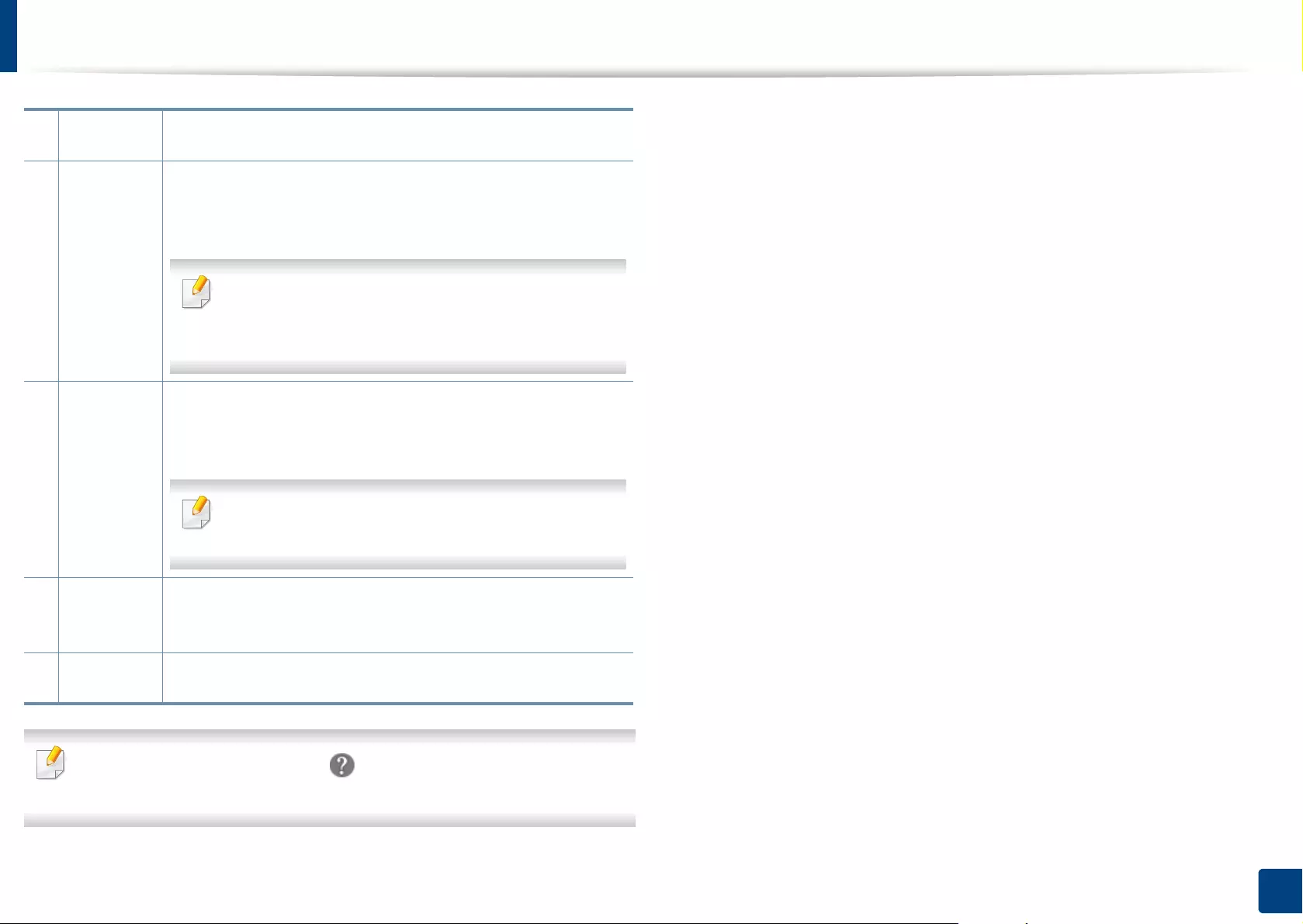
Using Samsung Easy Printer Manager
284
13. Useful Tools
Select the Help menu or click the button from the window and click on
any option you want to know about.
3
Application
information
Includes links for changing to the refresh, preference setting,
help, and about.
4
Printer
information
This area gives you general information about your machine.
You can check information, such as the machine’s model
name, IP address (or Port name), and machine status.
This button opens the Troubleshooting Guide when
an error occurs. You can directly open the
troubleshooting section in the user’s guide.
5
Quick links Displays Quick links to machine specific functions. This
section also includes links to applications in the advanced
settings.
If you connect your machine to a network, the
SyncThru™ Web Service icon is enabled.
6
Contents
area
Displays information about the selected machine, remaining
toner level, and paper. The information will vary based on the
machine selected. Some machines do not have this feature.
7Order
supplies
Click on the Order button from the supply ordering window.
You can order replacement toner cartridge(s) from online.
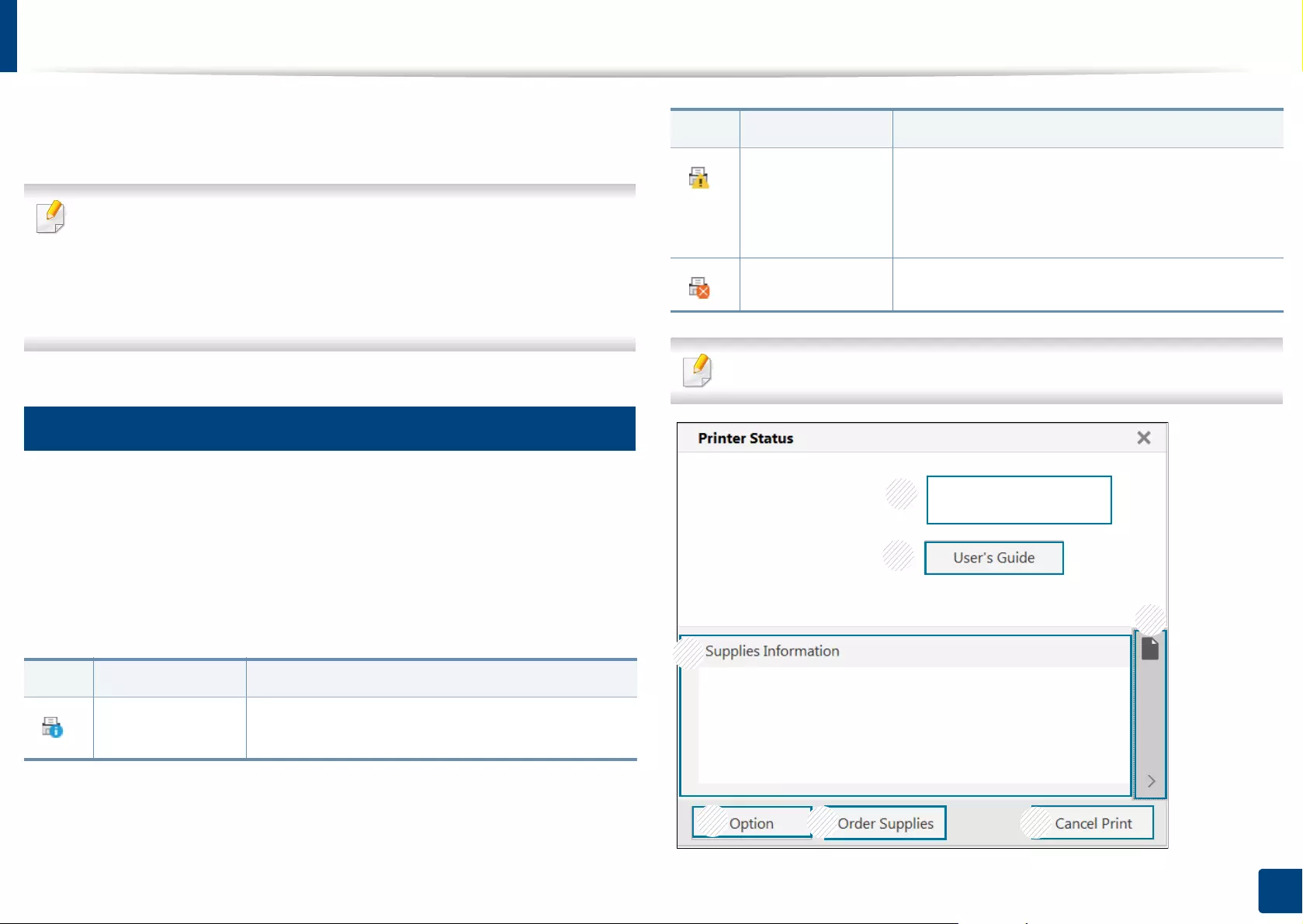
285
13. Useful Tools
Using Samsung Printer Status
The Samsung Printer Status is a program that monitors and informs you of the
machine status.
• The Samsung Printer Status window and its contents shown in this user’s
guide may differ depending on the machine or operating system in use.
• Check the operating system(s) that are compatible with your machine
(see "System requirements" on page 402).
• Available for Windows OS users only.
12
Samsung Printer Status overview
If an error occurs while operating, you can check the error from the Samsung
Printer Status.
You can also launch Samsung Printer Status manually. Go to the Printing
Preferences and click Printer Status button.
These icons appear on the Windows task bar:
The screenshot may differ depending on operating system, model, or option.
Icon Mean Description
Normal The machine is in ready mode and experiencing no
errors or warnings.
Warning The machine is in a state where an error might
occur in the future. For example, it might be in
toner low status, which may lead to toner empty
status.
Error The machine has at least one error.
Icon Mean Description
1
3
2
7
456

Using Samsung Printer Status
286
13. Useful Tools
1
Device
Information
You can view the device information.
2
User’s Guide You can view the online User’s Guide.
This button opens the Troubleshooting Guide
when an error occurs. You can directly open the
troubleshooting section in the user’s guide.
3
Supplies
Information
You can view the percentage of toner remaining in
each toner cartridge. The machine and the number of
toner cartridge(s) shown in the above window may
differ depending on the machine in use. Some
machines do not have this feature.
4
Option You can set printing job alert related settings.
5
Order Supplies You can order replacement toner cartridge(s) from
online.
6
Cancel Print
or
Close
•Cancel Print : If print job is waiting in the print
queue or printer, cancel all user's print jobs in the
print queue or the printer.
•Close : Depending on the status of the machine or
the supported functions, the Close button may
appear to close the status window.
7Toner/Paper
Information
This button areas for paper and toner info will be
available based on the device.

287
13. Useful Tools
Using Samsung Printer Experience
Samsung Printer Experience is a Samsung application that combines
Samsung machine settings and machine management into one location. You
can set device settings, order supplies, open troubleshooting guides, visit
Samsung’s website, and check connected machine information. This application
will be automatically downloaded from the Windows Store if the machine is
connected to a computer with an Internet connection.
Available for Windows 8 or higher users only.
13
Understanding the Samsung Printer Experience
To open the application,
From the Start screen or Start ( ) icon, select the Samsung Printer
Experience () tile.
The Samsung Printer Experience interface comprises various useful features as
described in the following table:
The screenshot may differ depending on operating system, model, or option.
1
Printer
Information
This area gives you general information about your
machine. You can check information, such as the
machine’s status, location, IP address, and remaining
toner level.
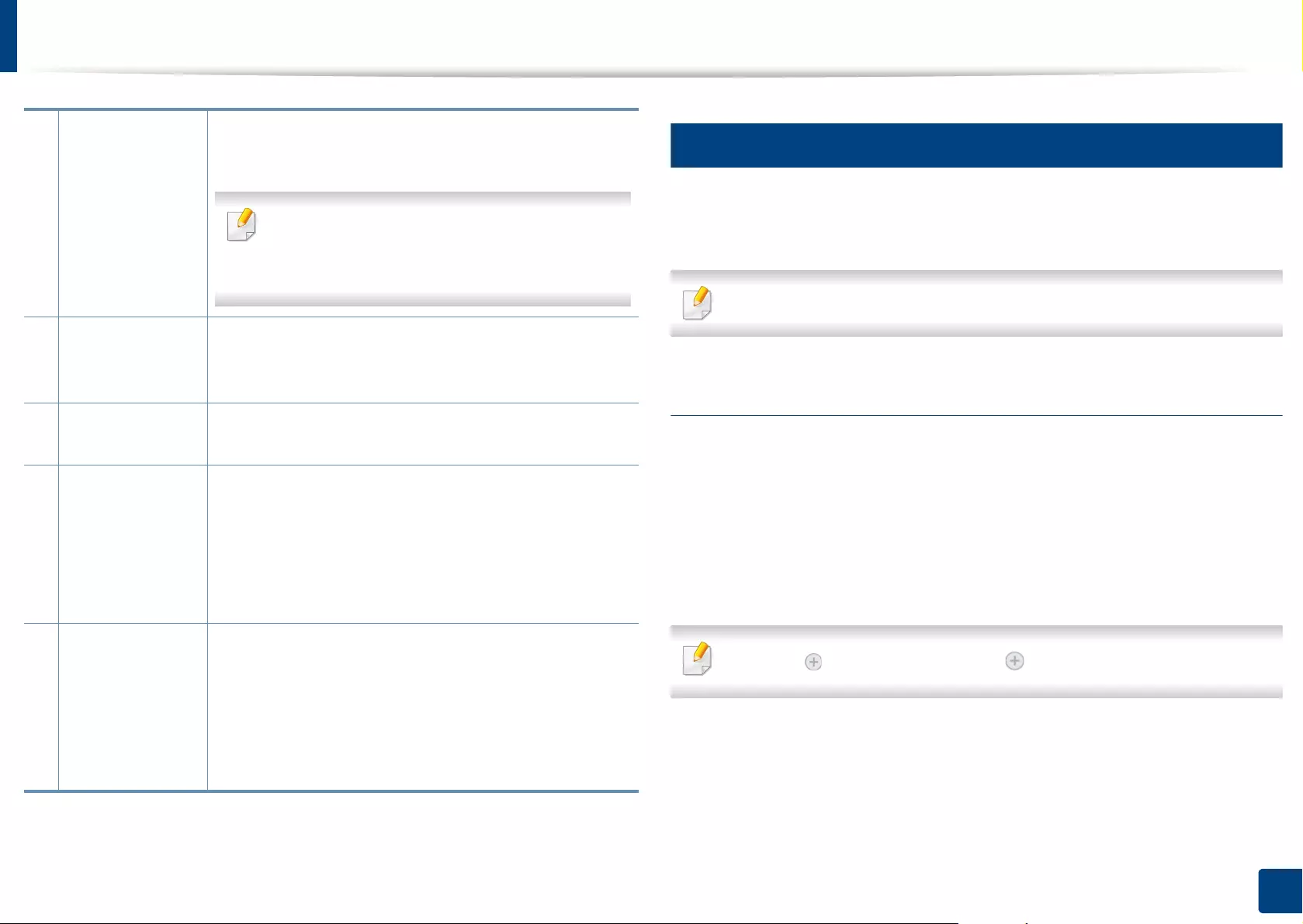
Using Samsung Printer Experience
288
13. Useful Tools
14
Adding/Deleting Printers
If you do not have any printer added to the Samsung Printer Experience, or if
you want to add/delete a printer, follow the instructions below.
You can only add/delete network connected printers.
Adding a printer
1Right-click the Samsung Printer Experience page and select Settings.
2 Select Add Printer
3 Select the printer you want to add.
You can see the added printer.
If you see mark, you can also click mark to add printers.
2User’s Guide You can view the online User’s Guide. You need to be
connected to the Internet to use this feature.
This button opens the Troubleshooting Guide
when an error occurs. You can directly open the
troubleshooting section in the user’s guide.
3
Order
Supplies
Click on this button to order replacement toner
cartridges online. You need to be connected to the
Internet to use this feature.
4Visit Samsung Links to Samsung printer website. You need to be
connected to the Internet to use this feature.
5
Printer Settings You can configure various machine settings such as
machine setup, paper, layout, emulation, networking,
and print information through SyncThru™ Web Service.
Your machine needs to be connected to a network. This
button will be disabled if your machine is connected via
USB cable.
6
Device List &
Latest Scanned
Image
The scan list displays devices that supports Samsung
Printer Experience. Under the device, you can see the
latest scanned images. Your machine needs to be
connected to a network to scan from here.
This section is for the users with multi-functional
printers.
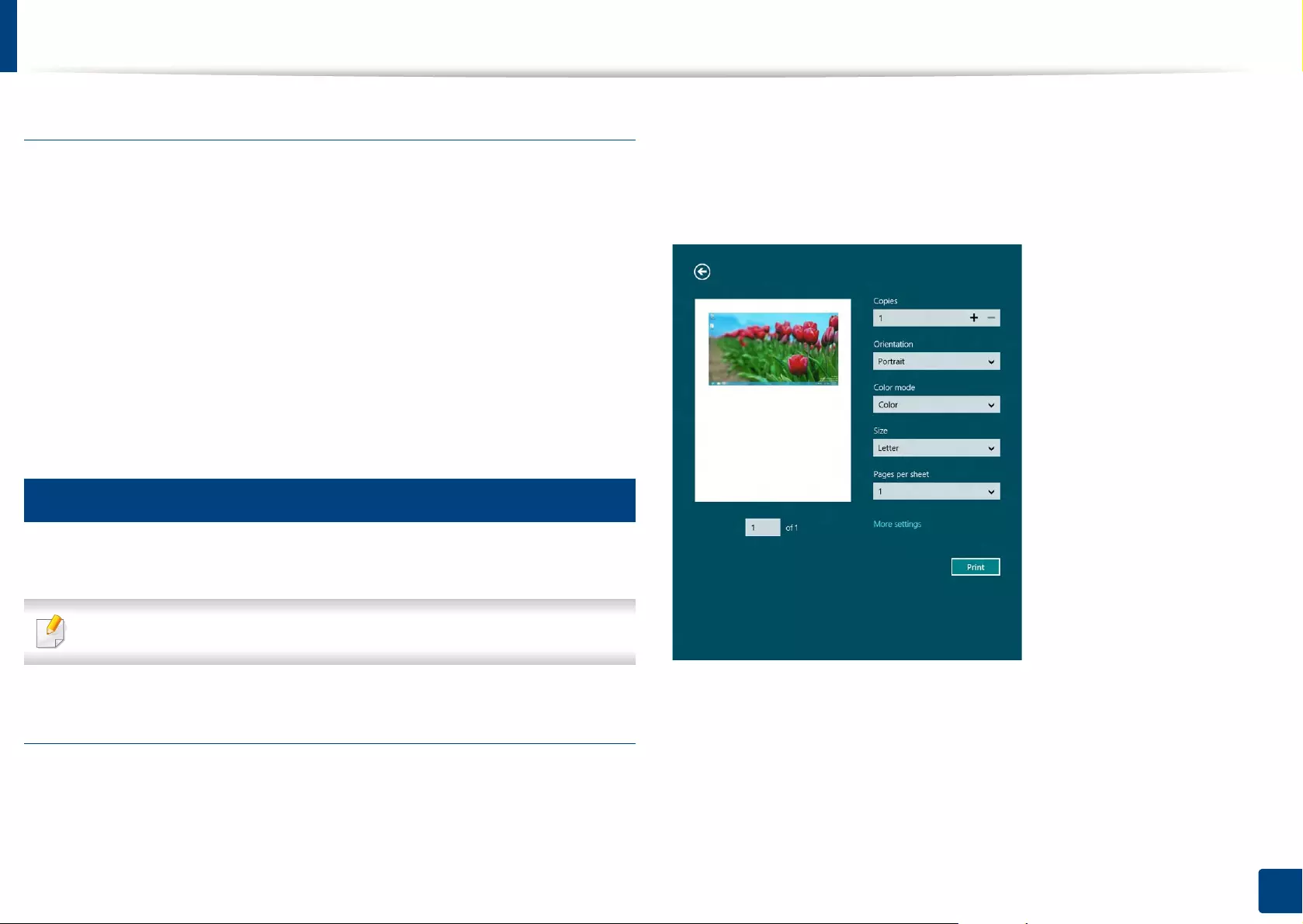
Using Samsung Printer Experience
289
13. Useful Tools
Deleting a printer
1Right-click the Samsung Printer Experience page, and then click
Settings.
2 Select Remove Printer.
3 Select the printer you want to delete.
4 Click Yes.
You can see that the selected printer is removed from the screen.
15
Printing from Windows 8
This section explains common printing tasks from the Start screen.
The screenshot may differ depending on operating system, model, or option.
Basic printing
1Open the document to print.
2 Select Print from the File menu.
3 Select your printer from the list
4 Select the printer settings, such as the number of copies and orientation.
5 Click the Print button to start the print job.
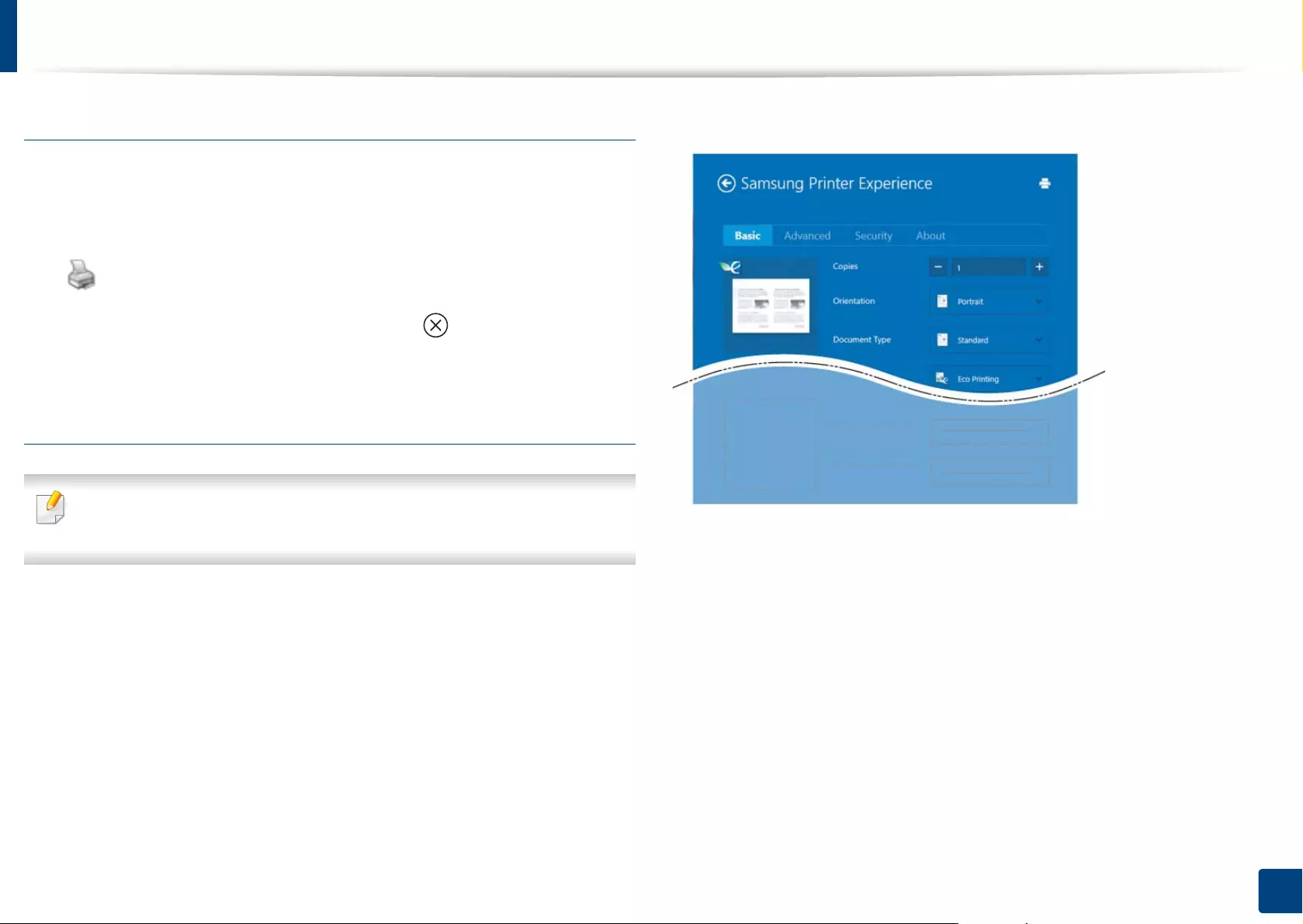
Using Samsung Printer Experience
290
13. Useful Tools
Cancelling a print job
If the printing job is waiting in the print queue or print spooler, cancel the job as
follows:
• You can access this window by simply double-clicking the machine icon
( ) in the Windows task bar.
• You can also cancel the current job by pressing (Stop) button on the
control panel.
Opening more settings
The screen may appear somewhat different depending on the model or
options.
You can set up more printing parameters.
1Open the document you want to print.
2 Select Print from the File menu.
3 Select your printer from the list
4 Click More settings.
Basic tab
Basic
This option allows you to choose the basic printing settings such as copies,
orientation, and document type.
Eco settings
This option allows you to choose multiple pages per side to save media.
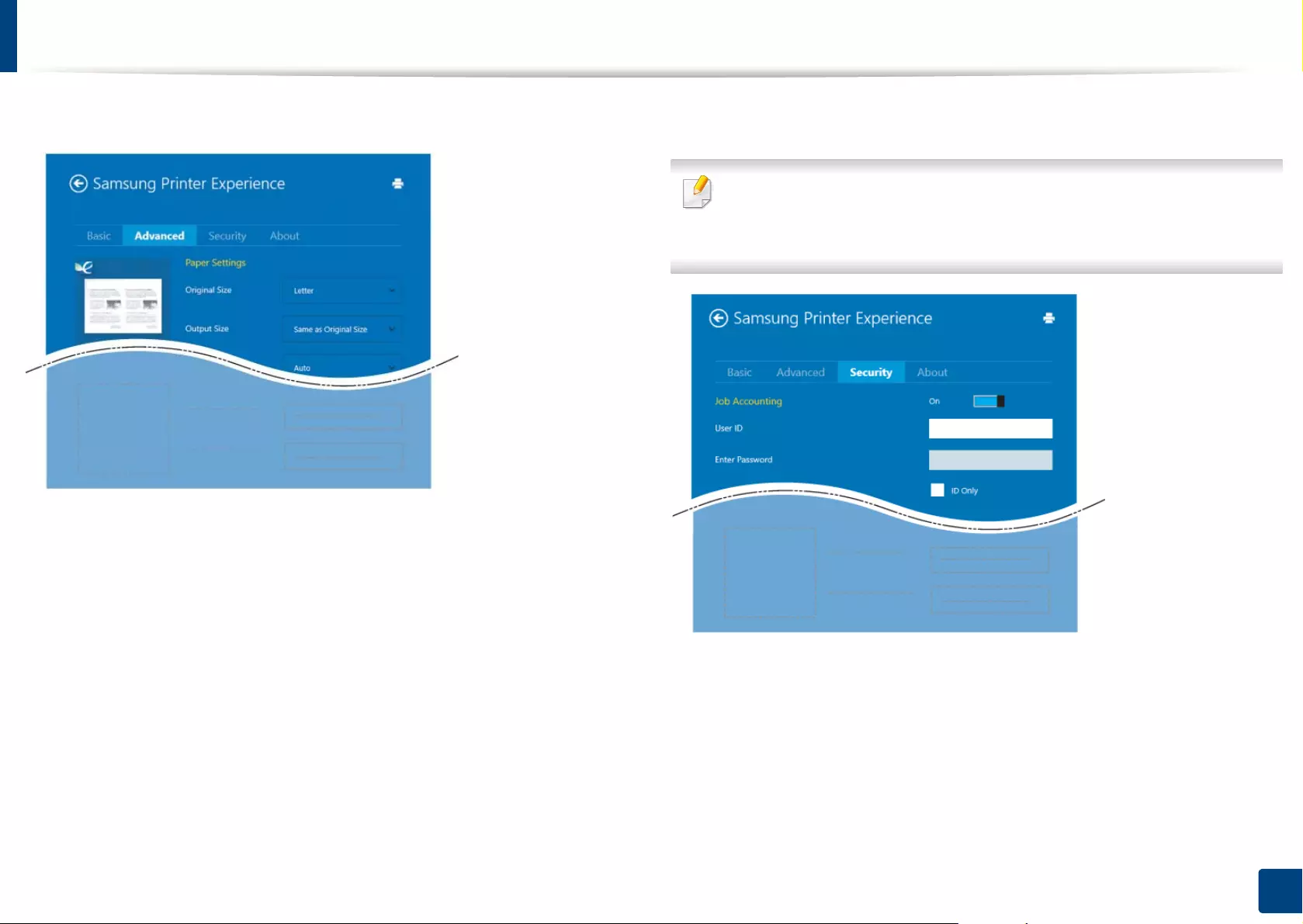
Using Samsung Printer Experience
291
13. Useful Tools
Advanced tab
Paper settings
This option allows you to set the basic paper handling specifications.
Layout settings
This option allows you to set the various ways to layout your documents.
Security tab
Some features may not be available depending on the model or options. If
this tab is not shown or disabled, it means that this features are not
supported.
Job Accounting
This option allows you to print with the given permission.
Confidential Printing
This option is used for printing confidential documents. You need to enter a
password to print using it.
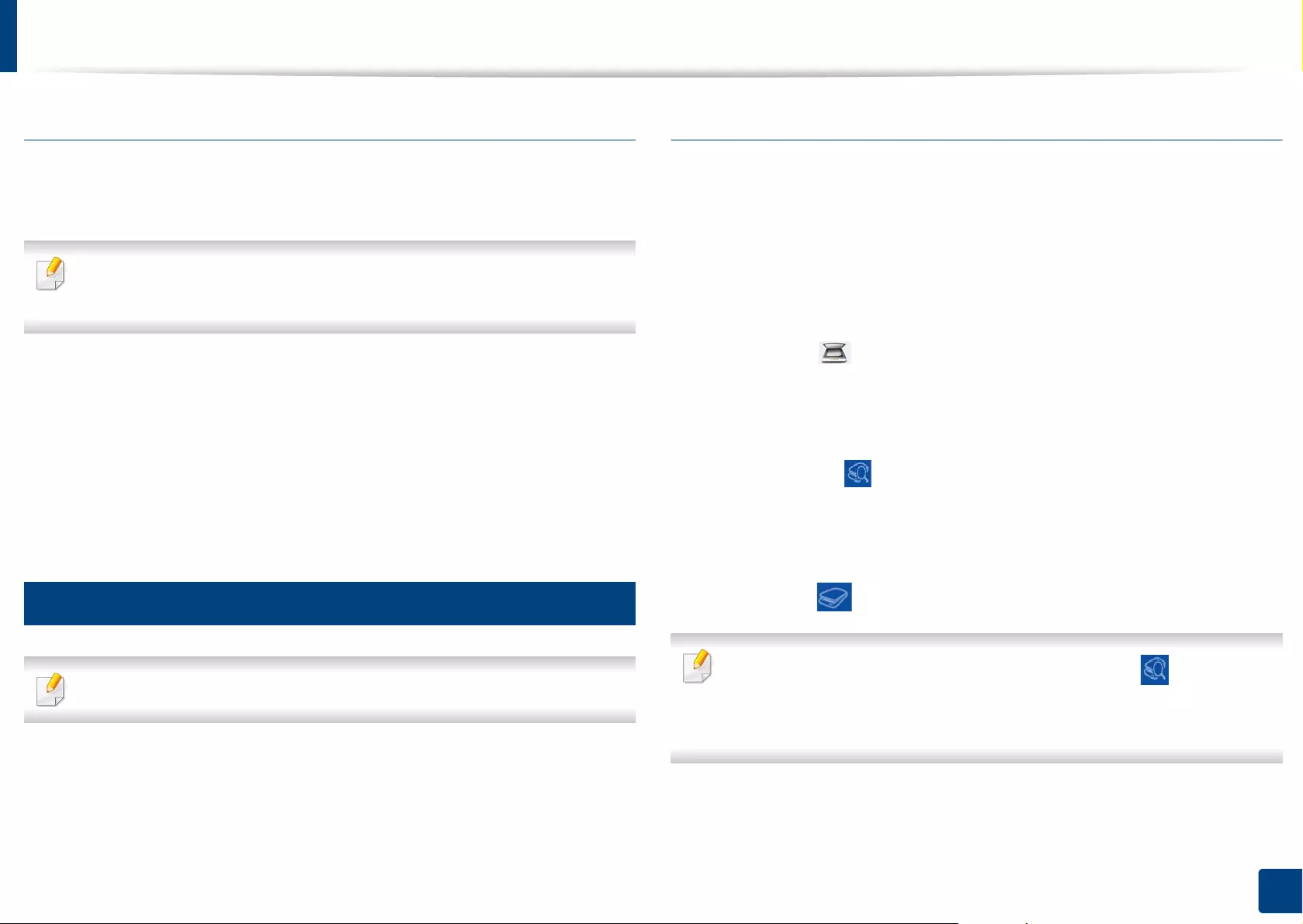
Using Samsung Printer Experience
292
13. Useful Tools
Using the sharing feature
Samsung Printer Experience allows you to print from other applications
installed on the computer using the sharing feature.
This feature is only available for printing jpeg, bmp, tiff, gif, and png file
formats.
1Select the content you want to print from other application.
2 Click Share or press Window key + H.
3 Select the printer settings, such as the number of copies and orientation.
4 Click the Print button to start the print job.
16
Scanning from Windows 8
This section is for the users with multi-functional printers.
Scanning with your machine lets you turn pictures and text into digital files that
can be stored on your computer.
Scanning from Samsung Printer Experience
The most frequently used printing menus are displayed for quick scanning.
1Place a single document face down on the document glass, or load the
documents face up into the document feeder.
2 Click the Samsung Printer Experience tile on the Start screen.
3 Click Scan ().
4 Set up the scanning parameters such as image type, document size, and
resolution.
5 Click Prescan ( ) to check the image.
6 Adjust the prescanned image with scanning operation functions such as
rotate and mirror.
7 Click Scan ( )and save the image.
• When you place the originals in the RADF, Prescan ( ) is not
available.
• You can skip step 5, if the Prescan option is selected.
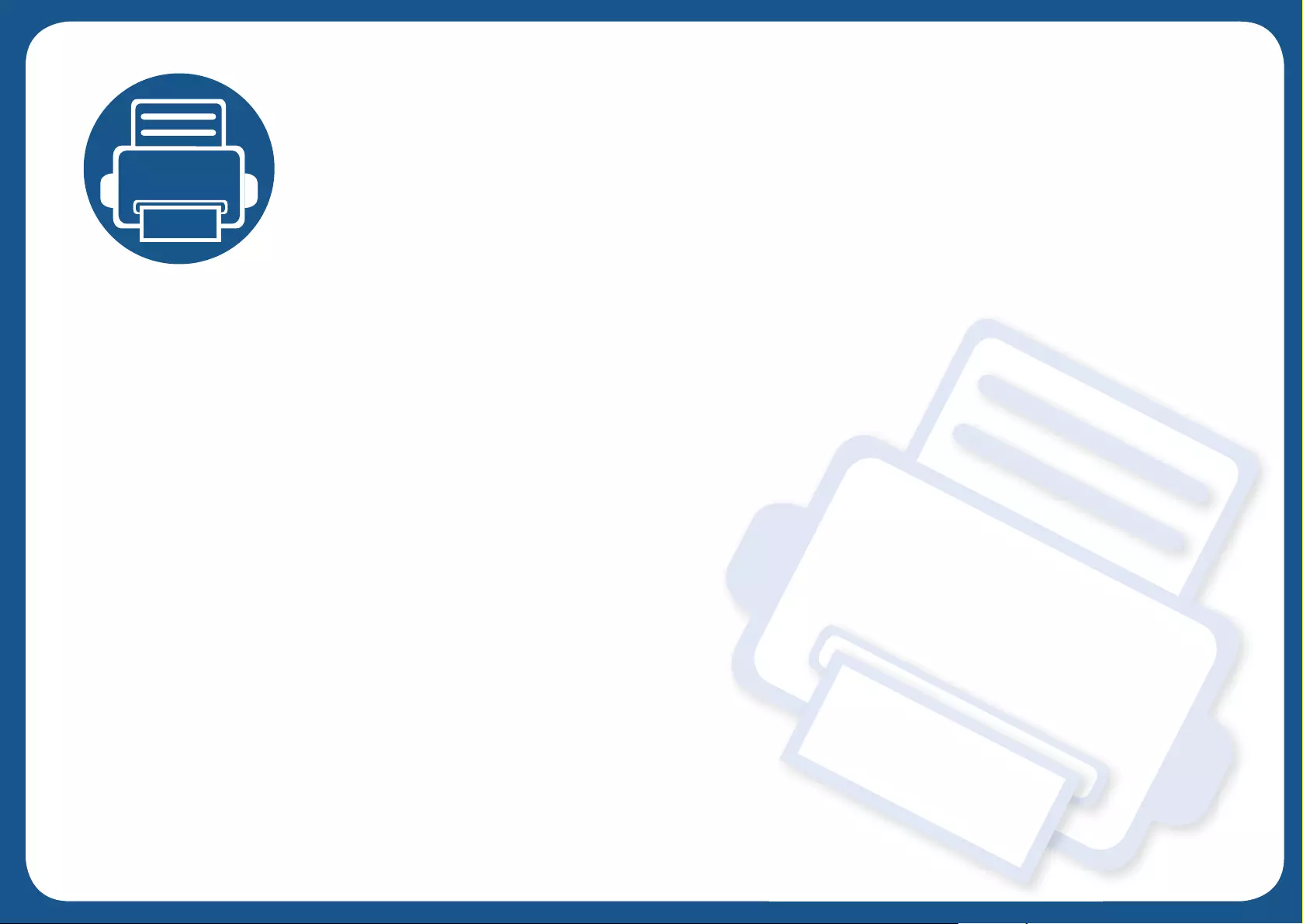
14.Maintenance
This chapter provides information for maintaining your machine.
This chapter includes:
• Ordering supplies and accessories 294
• Available supplies 295
• Available accessories 296
• Available maintenance parts 298
• Storing the toner cartridge 299
• Redistributing toner 300
• Replacing the toner cartridge 303
• Replacing the imaging unit 306
• Replacing the waste toner container 310
• Installing accessories 313
• Checking the supplies life 315
• Cleaning the machine 316
• Tips for storing the machine, supplies, and paper 334
• Tips for moving the machine 335
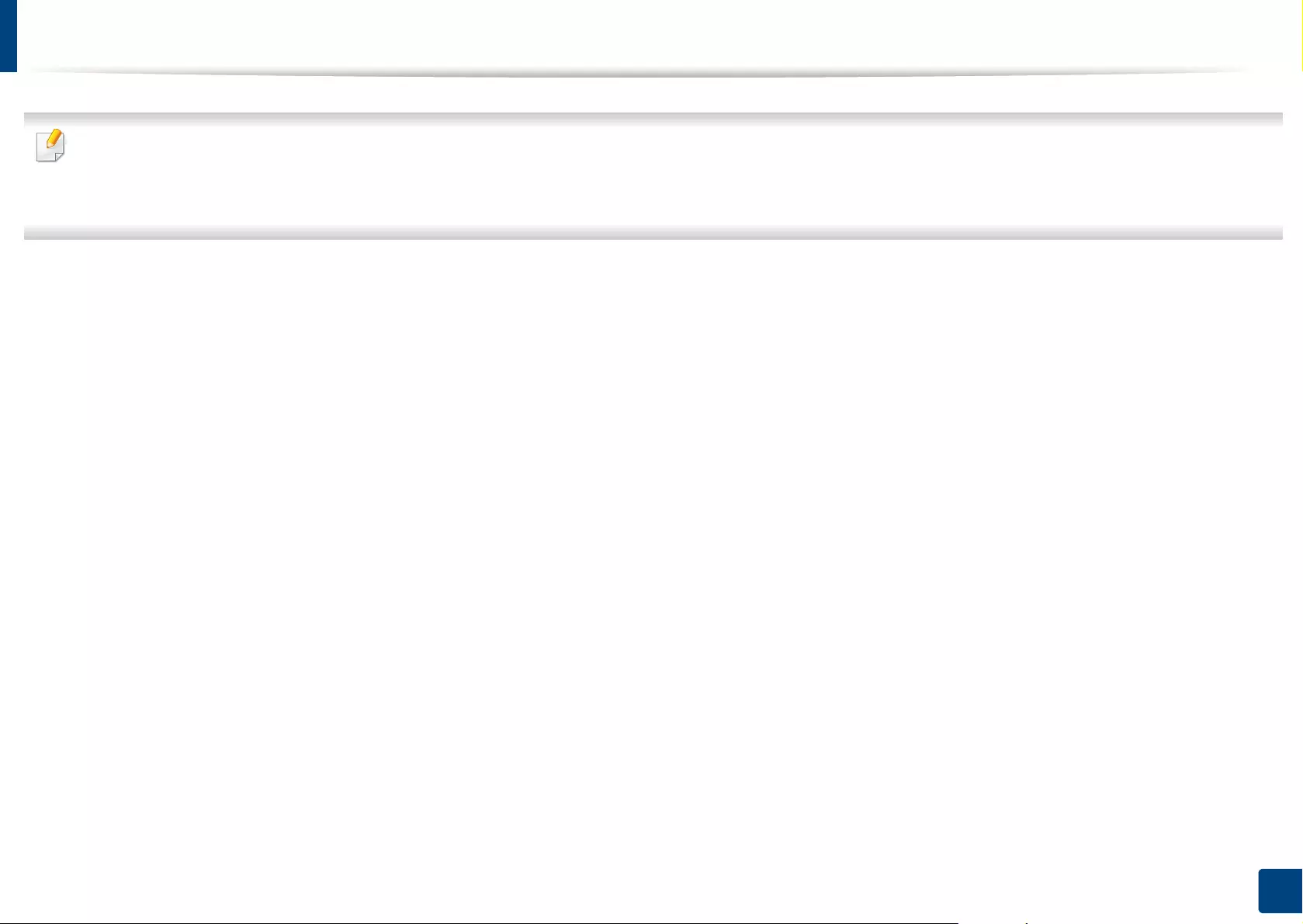
294
14. Maintenance
Ordering supplies and accessories
Available accessories may differ from country to country. Contact your sales representatives to obtain the list of available supplies, and maintenance parts.
• See "Available supplies" on page 295.
• See "Available accessories" on page 296.
To order Samsung-authorized supplies, accessories, and maintenance parts, contact your local Samsung dealer or the retailer where you purchased your machine.
You can also visit www.samsung.com/supplies, and then select your country/region to obtain the contact information for service.
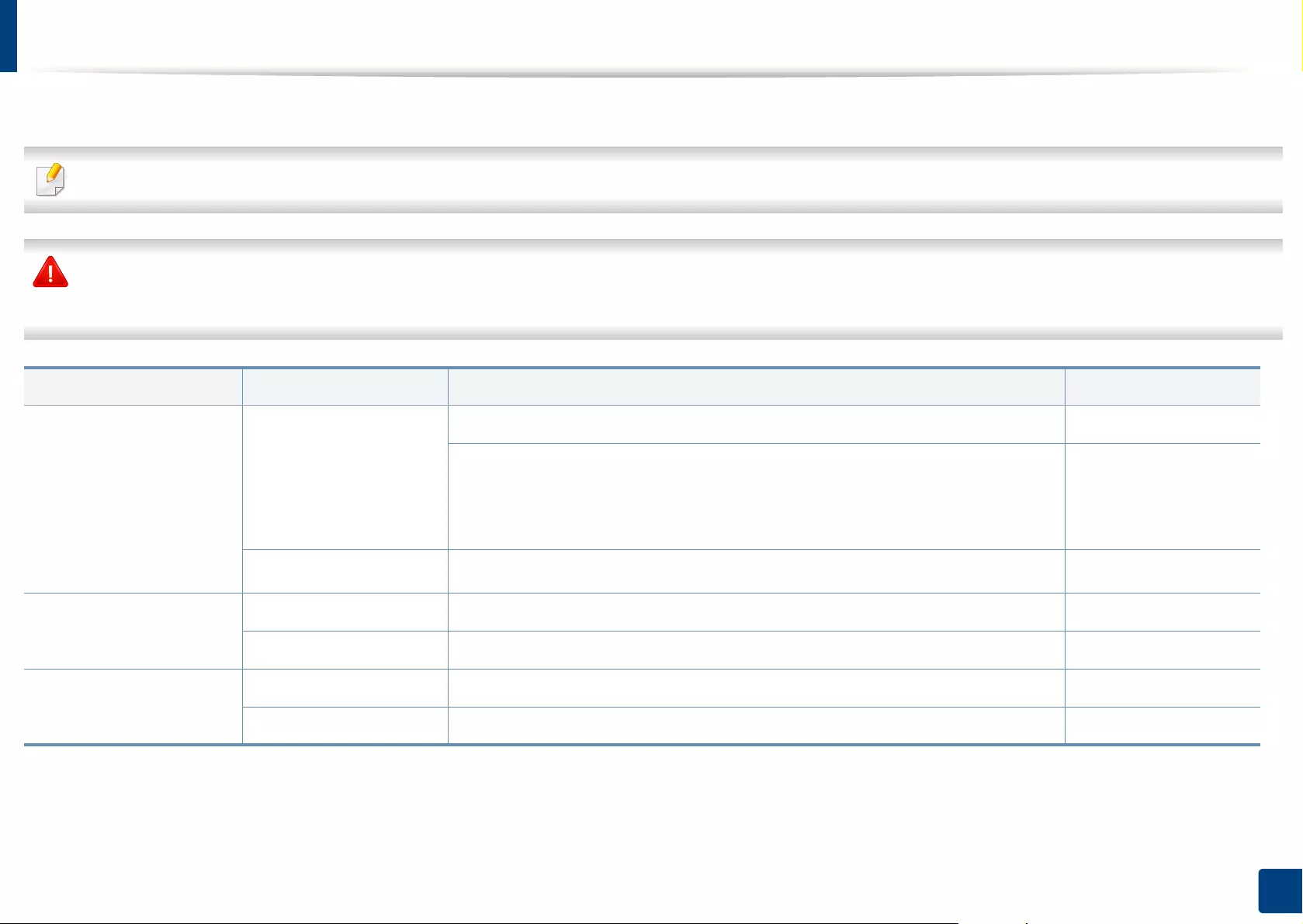
295
14. Maintenance
Available supplies
When supplies reach their lifespan, you can order the following types of supplies for your machine.
Depending on the options and job mode used, the toner cartridge’s lifespan may differ.
When purchasing new toner cartridges or other supplies, these must be purchased in the same country as the machine you are using. Otherwise, new toner
cartridges or other supplies will be incompatible with your machine due to different configurations of toner cartridges and other supplies according to the specific
country conditions.
Type Model Average yield Part name
Toner cartridge X322x/ X328x seriesa
a. Declared yield value using pages with 5% coverage.
Average continuous black cartridge yield: Approx. 20,000 standard pages CLT-K804S (Black)
Average continuous colored cartridge yield: Approx. 15,000 standard pages
(Cyan/Magenta/Yellow)
CLT-C804S (Cyan)
CLT-M804S (Magenta)
CLT-Y804S (Yellow)
K325x/ K330x seriesb
b. Declared yield value using pages with 6% coverage.
Average continuous black cartridge yield: Approx. 25,000 standard pages MLT-D704S (Black)
Imaging unit X322x/ X328x series Approx. 50,000 pages CLT-R804
K325x/ K330x series Approx. 100,000 pages MLT-R704
Waste toner container X322x/ X328x series Approx. 33,700 pages CLT-W808
K325x/ K330x series Approx. 100,000 pages MLT-W708
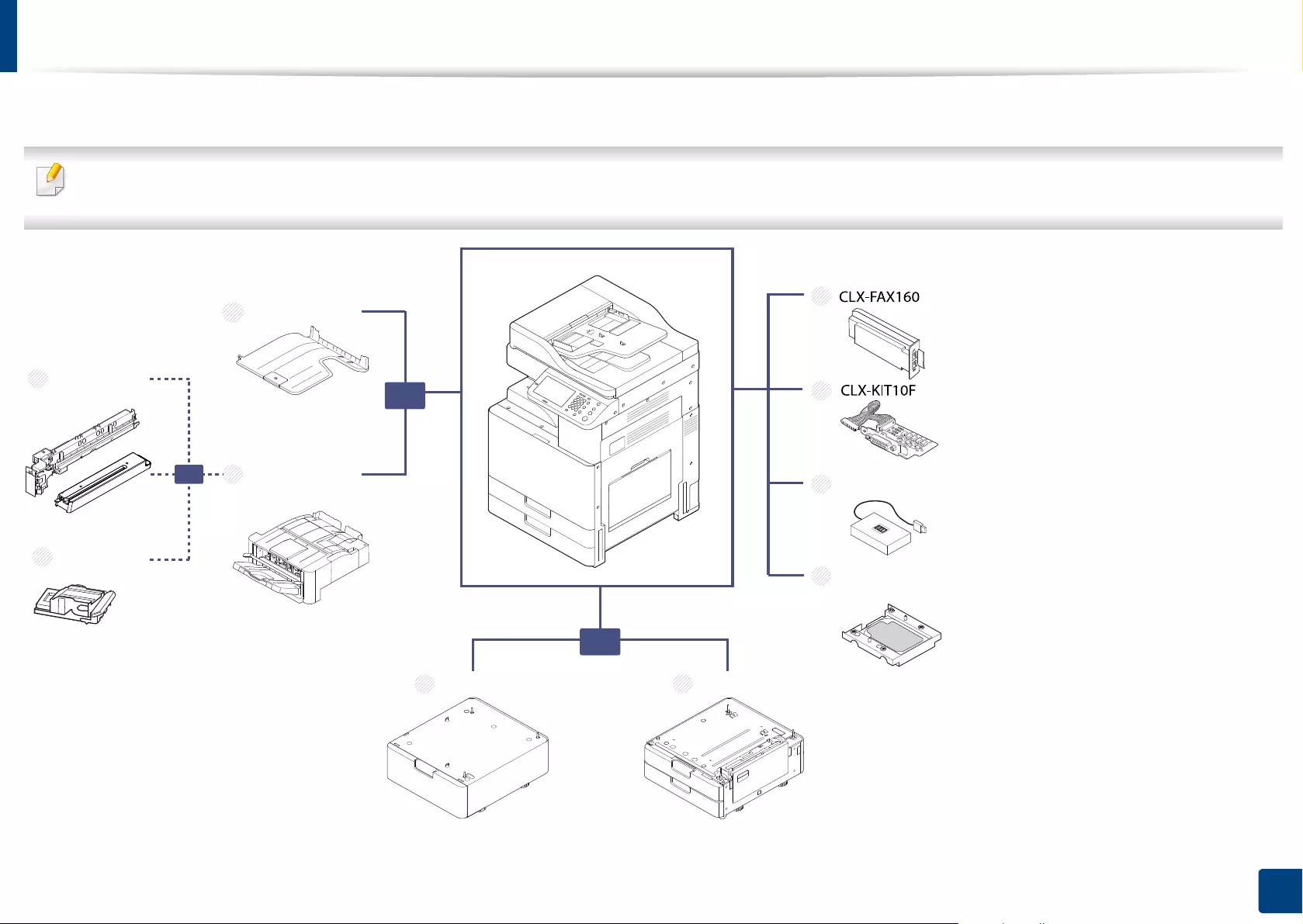
296
14. Maintenance
Available accessories
You can purchase and install accessories to enhance your machine’s performance and capacity.
If the installation guide for the optional accessory does not include information about how to install the accessory in your printer model, then visit the Samsung
website (www.samsung.com) and search for your printer model for information about how to install the accessory.
SL-NWE001X
SL-PFP502D
SL-DSK502T
SL-FIN501L
* X328x / K330x series only
SL-HPU501x
1
2
3
5
4
SCX-HDK471
* K325x / K330x series only
6
7
8
SCX-STP000
9
OR
+
10
SL-JSP500S
OR
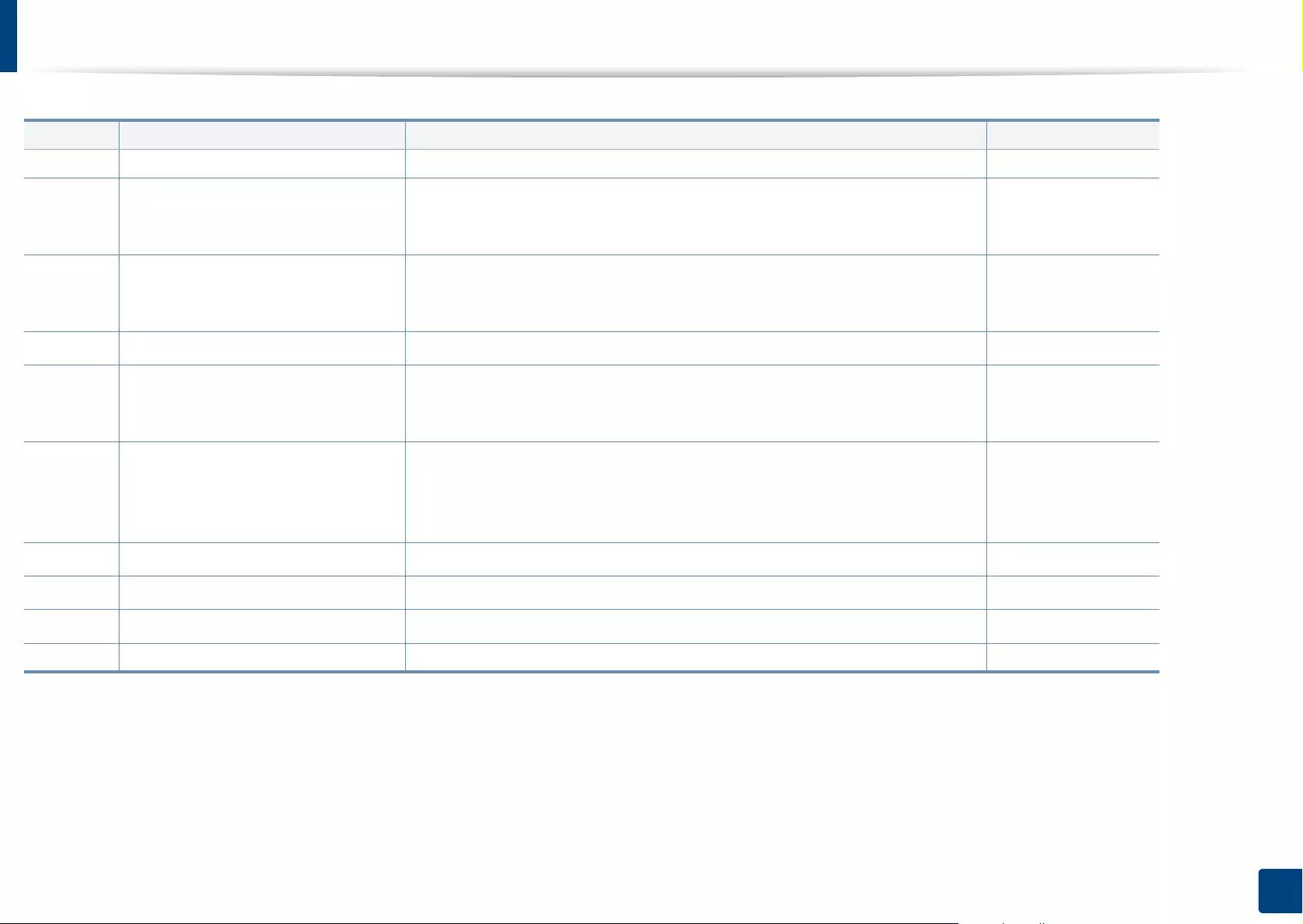
Available accessories
297
14. Maintenance
No. Accessory Function Part name
1Fax Kit This fax kit allows you to use your machine as a fax. CLX-FAX160
2FDI(Foreign Device Interface) Kit This card is installed inside the machine to allow a third party device such as
a coin operated device or a card reader. Those devices allow the pay for-print
service on your machine.
CLX-KIT10F
3Wireless/NFC Kit To purchase the Wireless/NFC kit, contact the retailer or distributor where you
purchased the machine. Only authorized service providers, distributors, or
retailers are permitted to install the Wireless/NFC kit.
SL-NWE001X
4Mass Storage Device (Hard disk)a
a. K325x/ K330x series only.
This hard disk kit will help the machine to be used in various ways. SCX-HDK471
5Dual Cassette Feeder If you are experiencing frequent Paper Source problems, you can attach an
additional tray. The optional tray can hold up to 1,040 sheets. You can print
documents in various sizes and types of print materials in the tray.
SL-PFP502D
6Cabinet Stand You can place the machine on the ergonomically-designed cabinet which lets
you reach the machine conveniently. Also, you can easily move the cabinet
with its wheels, if necessary, and store miscellaneous items like papers into
the cabinet.
SL-DSK502T
7Finisherb
b. K330x/ X328x series only.
This finisher allows you to sort, group and staple printouts. SL-FIN501L
8Hole Punch Kitc
c. This accessory is available only when the optional finisher is installed.
This kit allows you to punch holes for filing the printouts. SL-HPU501x
9Staple Cartridgec
3 x 5,000 staples per package, covers maximum thickness of 50 sheets, 1 staple position.
SCX-STP000
10 Job Separator This job separator allows you to sort the printouts. SL-JSP500S
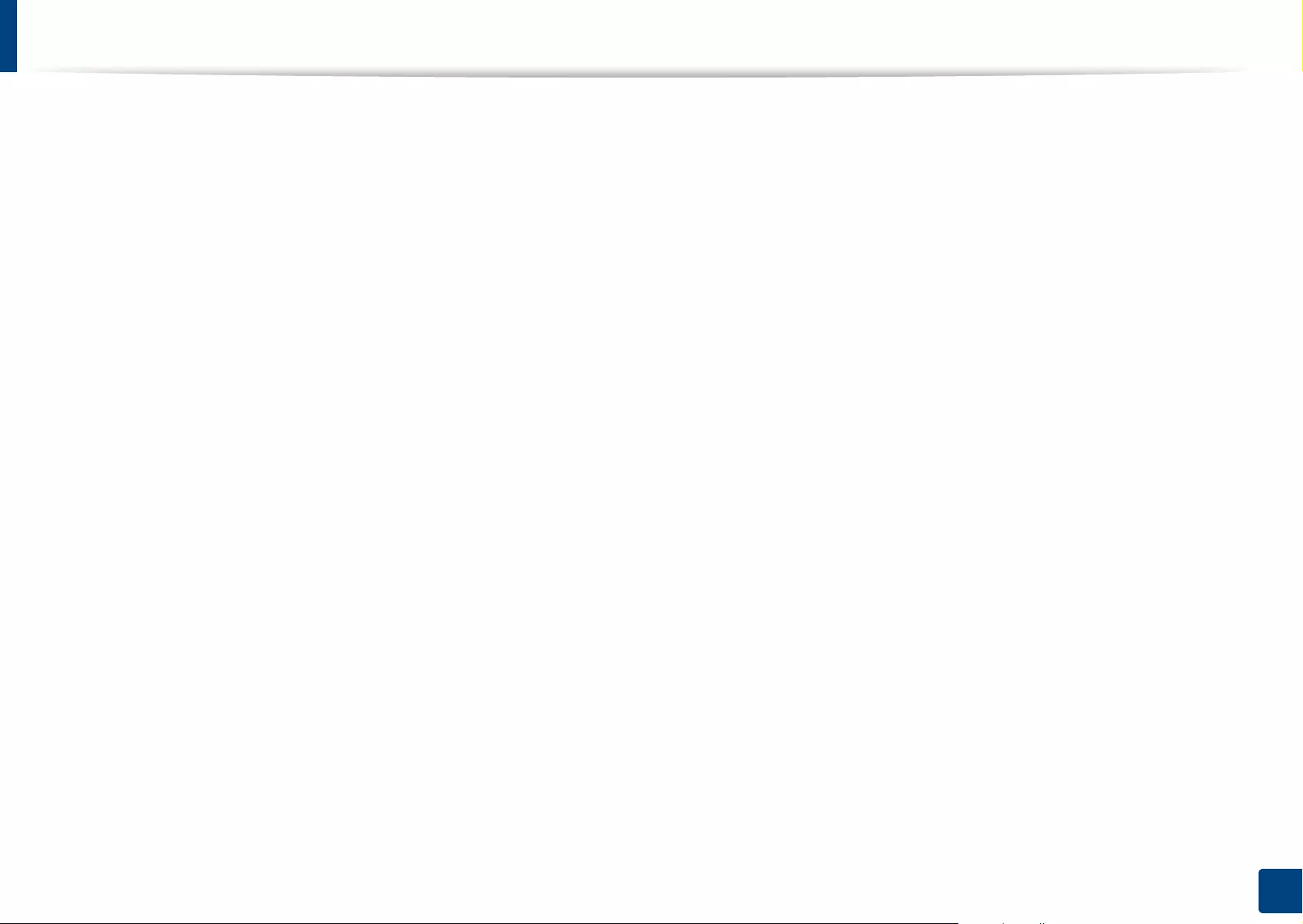
298
14. Maintenance
Available maintenance parts
You need to replace the maintenance parts at specific intervals to keep the machine in the best condition and avoid print quality and paper feeding problems
resulting from the worn-out parts. Maintenance parts are mostly rollers, belts and pads. However, the replacement period and parts may differ depending on the
model. Replacing maintenance parts can be performed only by an authorized service provider, dealer, or the retailer where you bought the machine. To purchase
maintenance parts, contact the retailer where you bought the machine. The replacement period for the maintenance parts is informed by the "Samsung Printer
Status" program. Or on the UI (User Interface) if your machine supports a display screen. The replacement period varies based on the application software, paper type,
paper size, and job complexity.
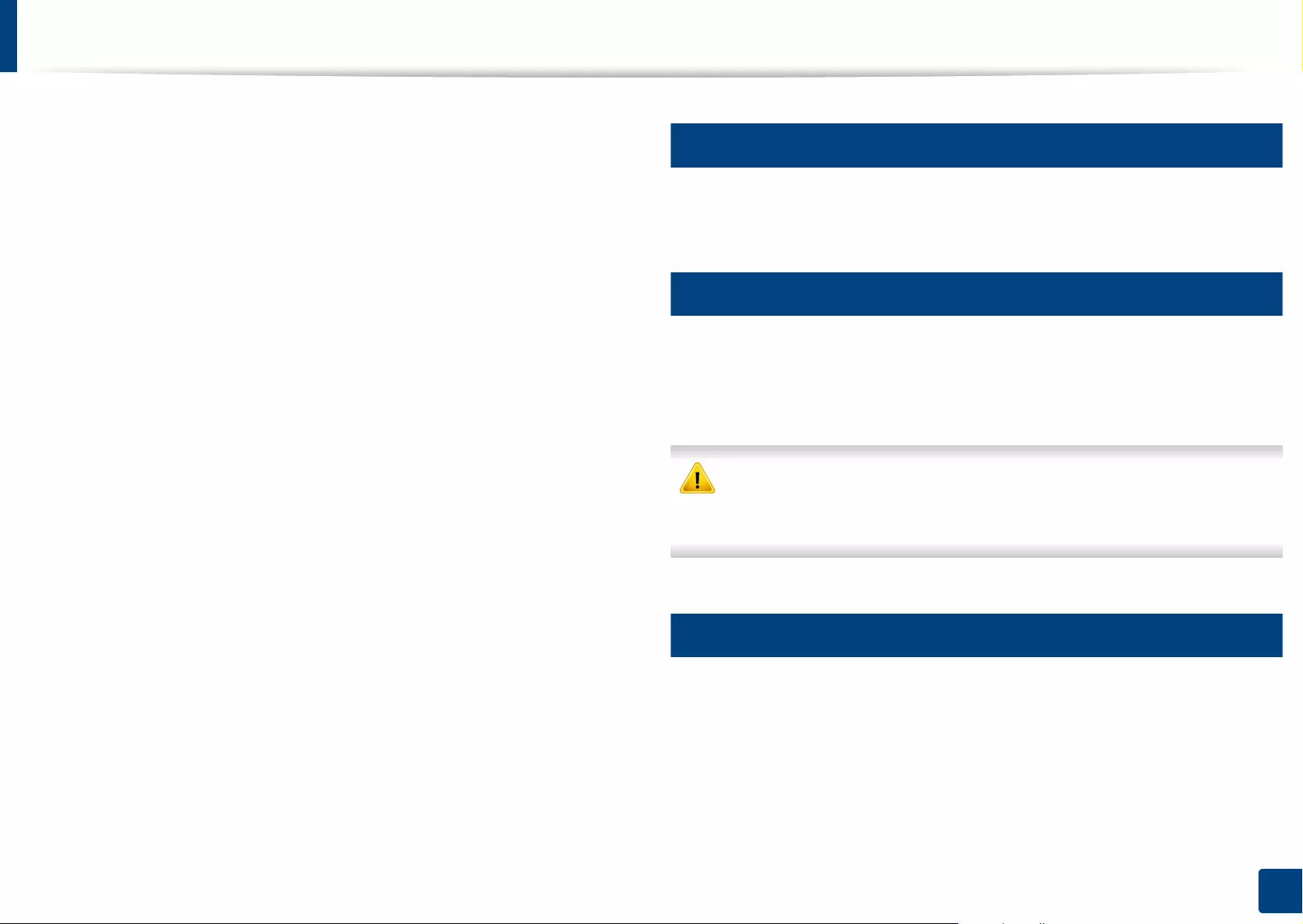
299
14. Maintenance
Storing the toner cartridge
Toner cartridges contain components that are sensitive to light, temperature
and humidity. Samsung suggests users follow these recommendations to
ensure optimal performance, highest quality, and longest life from your new
Samsung toner cartridge.
Store the cartridge in the same environment in which the printer will be used.
This should be in controlled temperature and humidity conditions. The toner
cartridge should remain in its original and unopened package until installation
– if original packaging is not available, cover the top opening of the cartridge
with paper and store in a dark cabinet.
Opening the cartridge package prior to use dramatically shortens its useful shelf
and operating life. Do not store on the floor. If the toner cartridge is removed
from the printer, follow the instructions below to store the toner cartridge
properly.
• Store the cartridge inside the protective bag from the original package.
• Store lying flat (not standing on end) with the same side facing up as if it
were installed in the machine.
• Do not store consumables in any of the following conditions:
- Temperature greater than 40 °C (104 °F).
- Humidity range less than 20% or greater than 80%.
- An environment with extreme changes in humidity or temperature.
- Direct sunlight or room light.
- Dusty places.
- A car for a long period of time.
- An environment where corrosive gases are present.
- An environment with salty air.
1
Handling instructions
• Do not expose the cartridge to unnecessary vibrations or shock.
2
Toner cartridge usage
Samsung Electronics does not recommend or approve the use of non-Samsung
brand toner cartridges in your printer including generic, store brand, refilled, or
remanufactured toner cartridges.
Samsung’s printer warranty does not cover damage to the machine caused
by the use of refilled, remanufactured, or non-Samsung brand toner
cartridges.
3
Estimated cartridge life
Estimated cartridge life (the life of the toner cartridge yield) depends on the
amount of toner that print jobs require. The actual print yield may vary
depending on the print density of the pages you print on, operating
environment, percentage of image area, printing interval, media type and/or
media size. For example, if you print a lot of graphics, the consumption of the
toner is higher and you may need to change the cartridge more often.
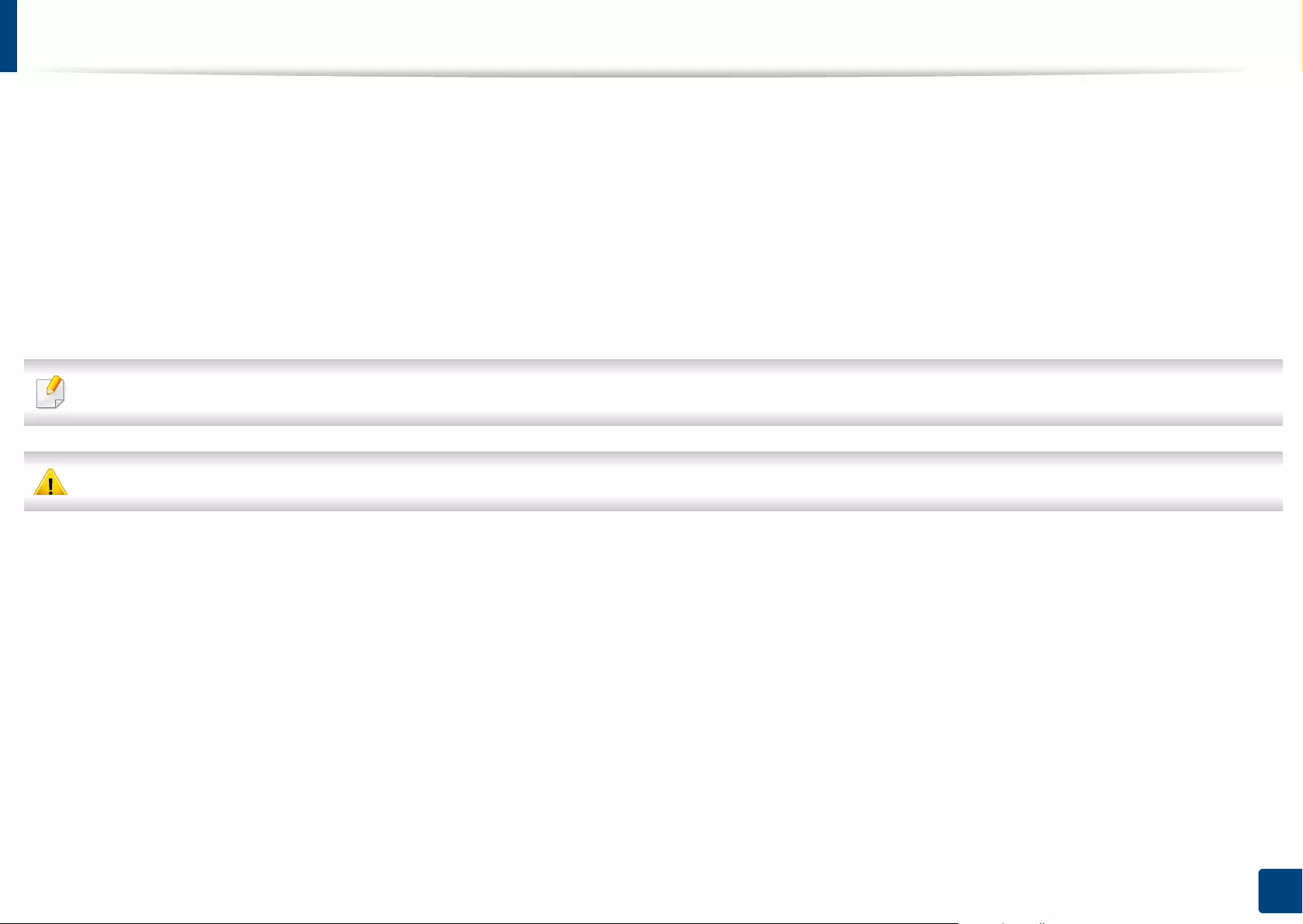
300
14. Maintenance
Redistributing toner
When the toner cartridge is near the end of its life:
• White streaks or light printing occurs and/or density varies from side to side.
• The Status LED blinks orange. The toner-related message saying that the toner is low may appear on the display.
• The computer’s Samsung Printing Status program window appears on the computer telling you which toner cartridge is low on toner (see "Using Samsung
Printer Status" on page 285).
If this happens, you can temporarily improve print quality by redistributing the remaining toner in the cartridge. In some cases, white streaks or light printing will still
occur even after you have redistributed the toner.
Illustrations on this user’s guide may differ from your machine depending on its options or models. Check your machine type (see "Machine overview" on page 20).
• If toner gets on your clothing, wipe it off with a dry cloth and wash clothing in cold water. Hot water sets toner into fabric.

Redistributing toner
301
14. Maintenance
4
X322x/ X328x series
2
1
2
1
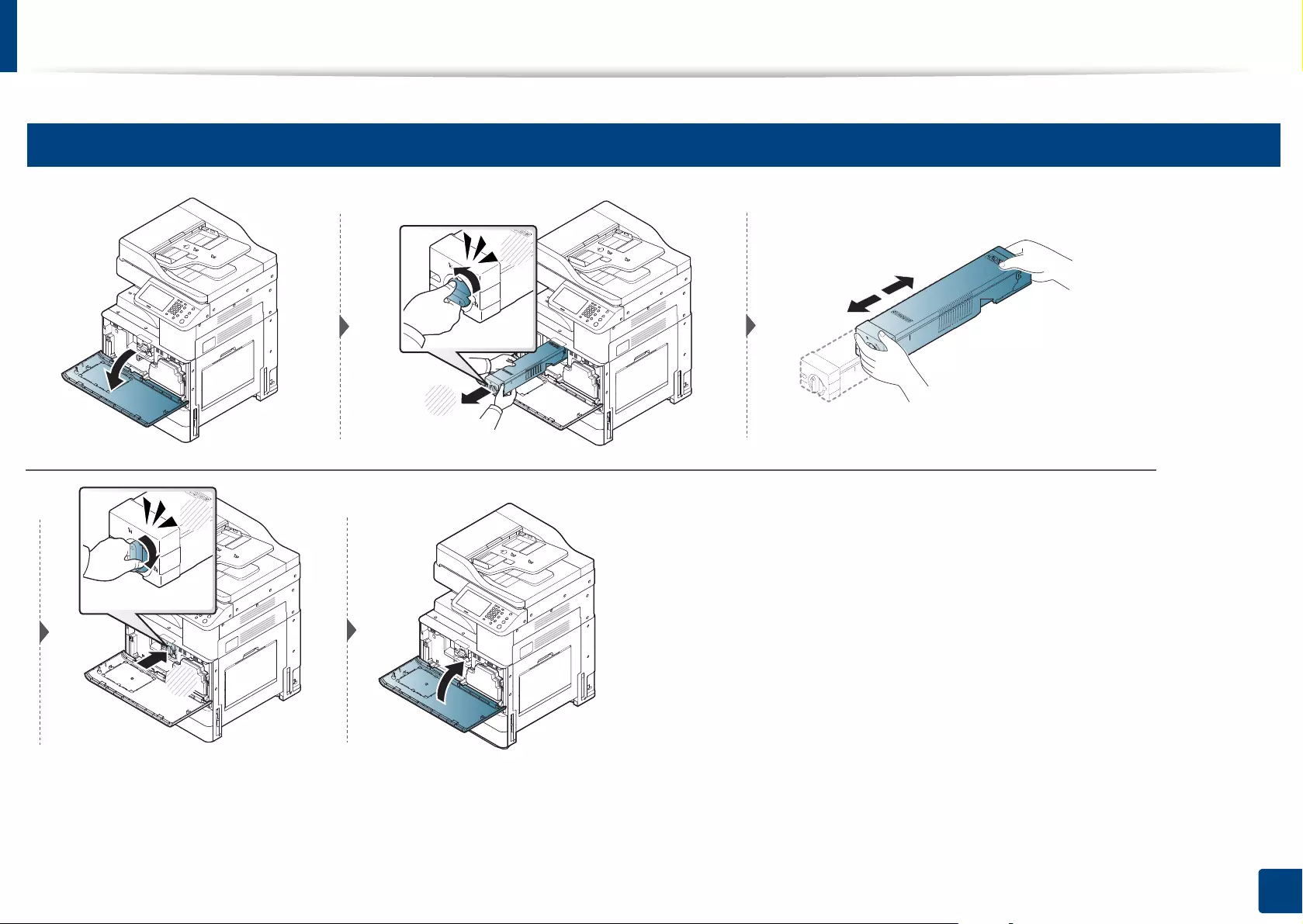
Redistributing toner
302
14. Maintenance
5
K325x/ K330x series
2
1
2
1
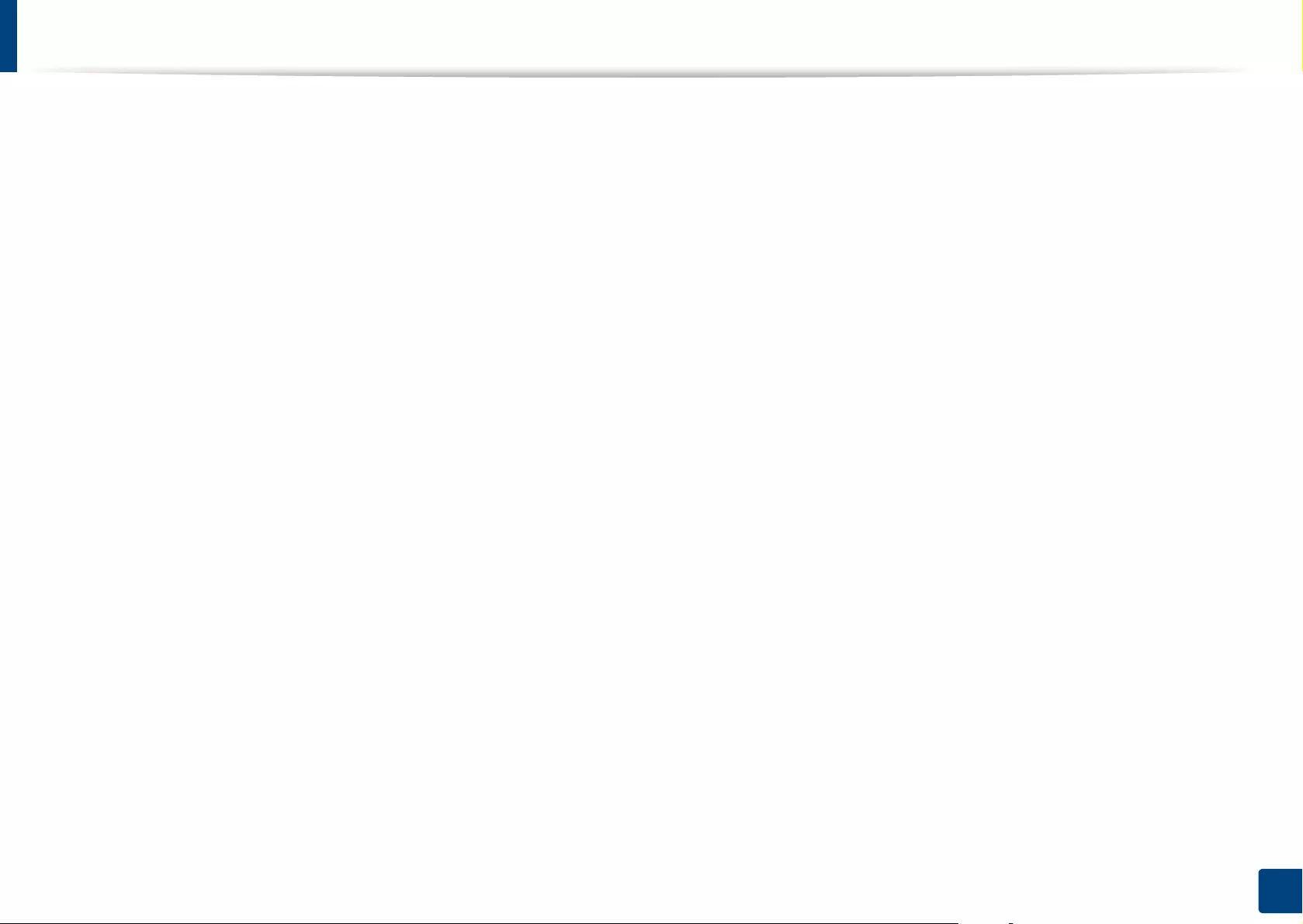
303
14. Maintenance
Replacing the toner cartridge
When the toner cartridge is totally empty:
• The status LED turns orange on and the display screen shows the error message of replacing toner.
• The machine stops printing and incoming faxes are saved in memory.
However, when the toner cartridge is empty, but you can still print black-and-white print jobs (The submitted job must be in black and white).
• Check the type of the toner cartridge for your machine (see "Available supplies" on page 295).
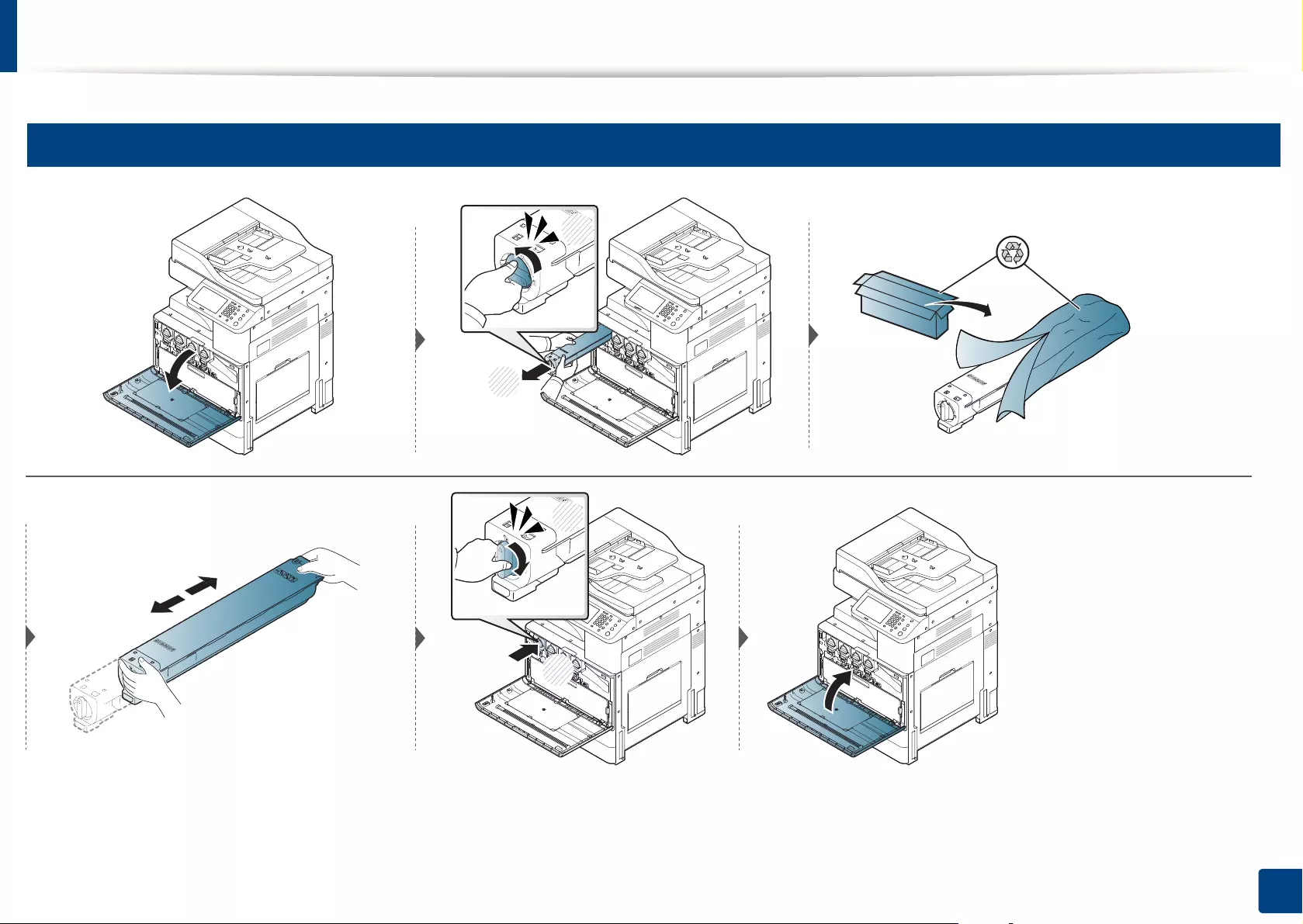
Replacing the toner cartridge
304
14. Maintenance
6
X322x/ X328x series
2
1
2
1

Replacing the toner cartridge
305
14. Maintenance
7
K325x/ K330x series
2
1
2
1
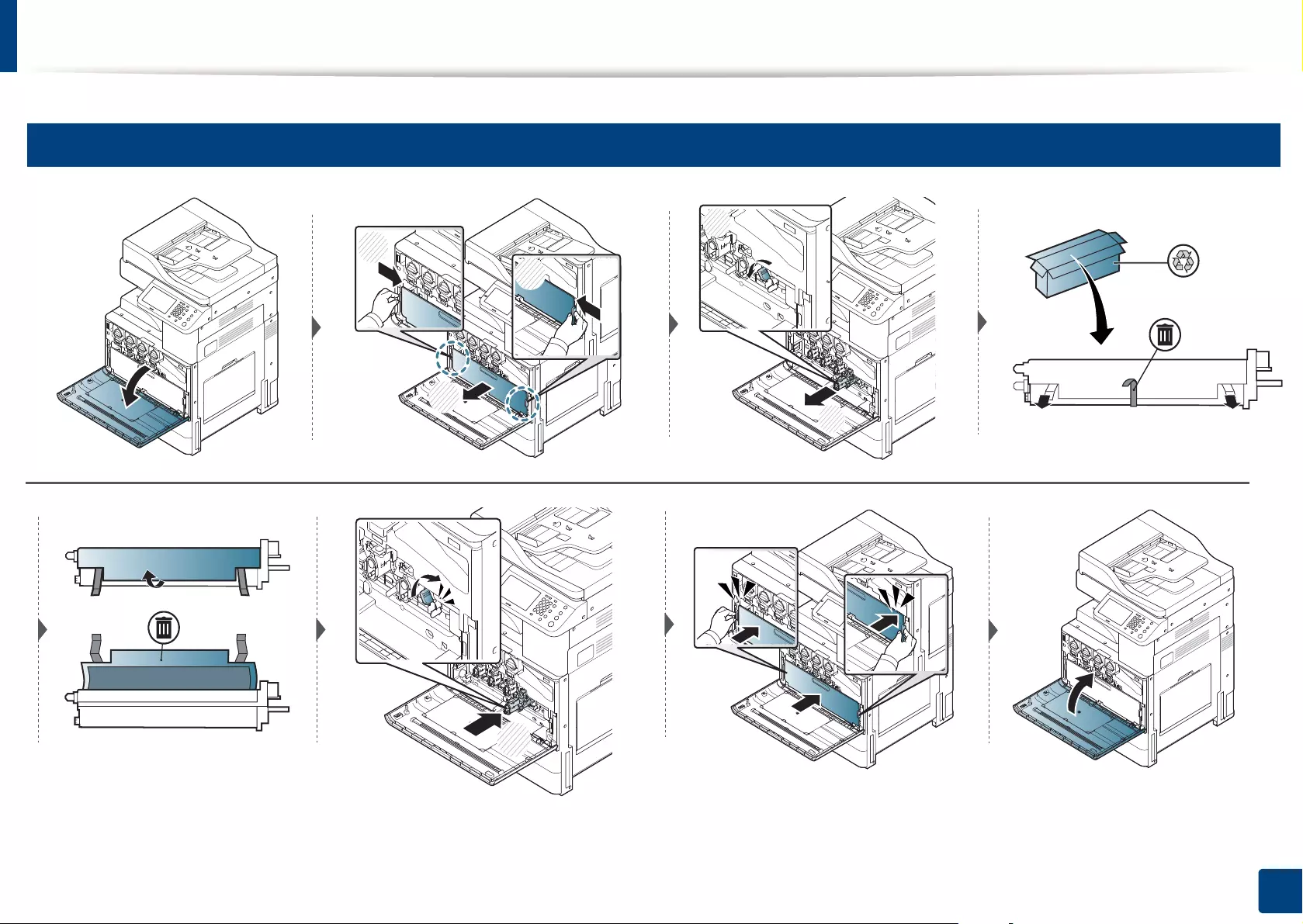
Replacing the imaging unit
307
14. Maintenance
8
X322x/ X328x series
1
2
1
2
2
1
1
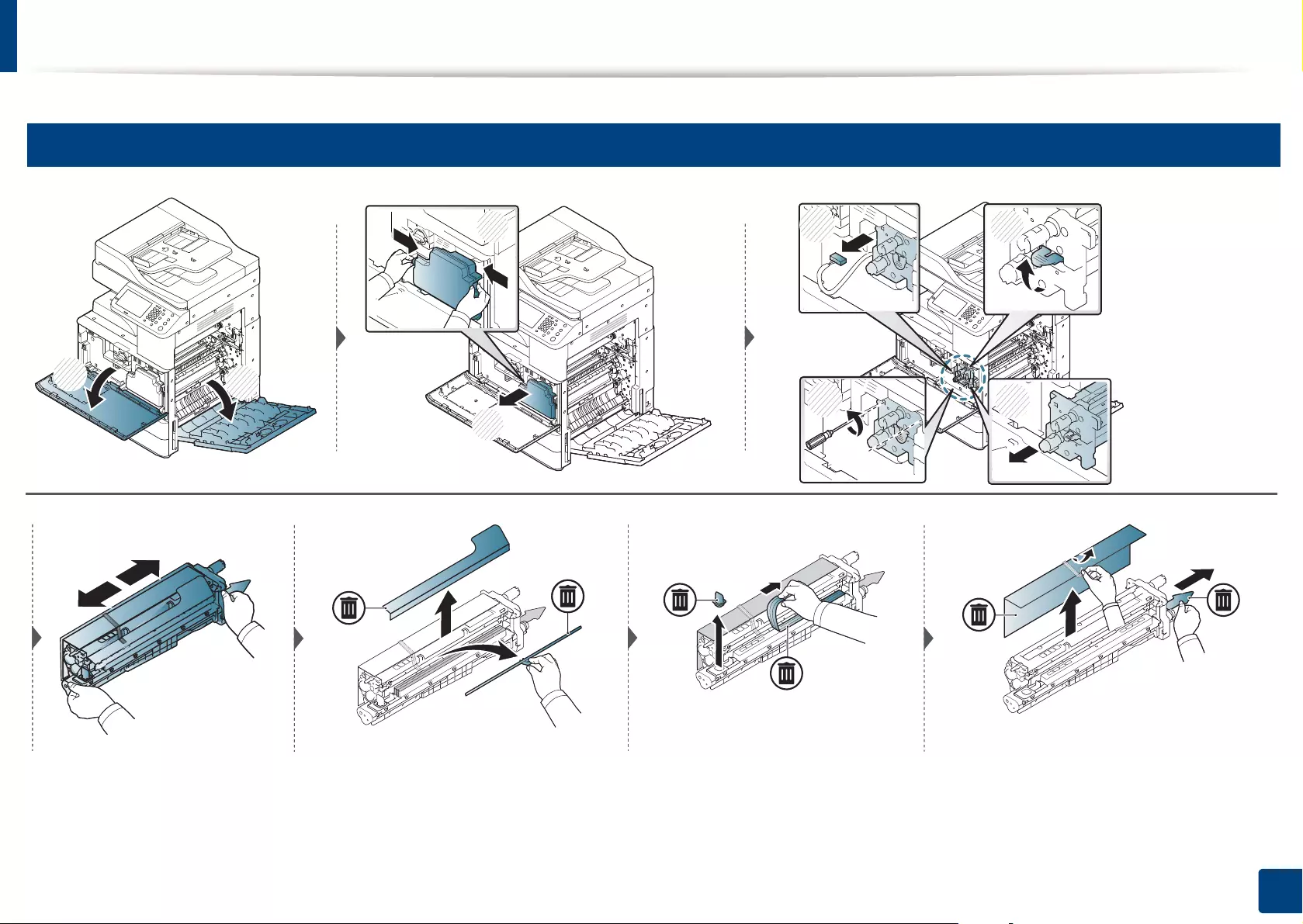
Replacing the imaging unit
308
14. Maintenance
9
K325x/ K330x series
12
2
3
4
11
2
1
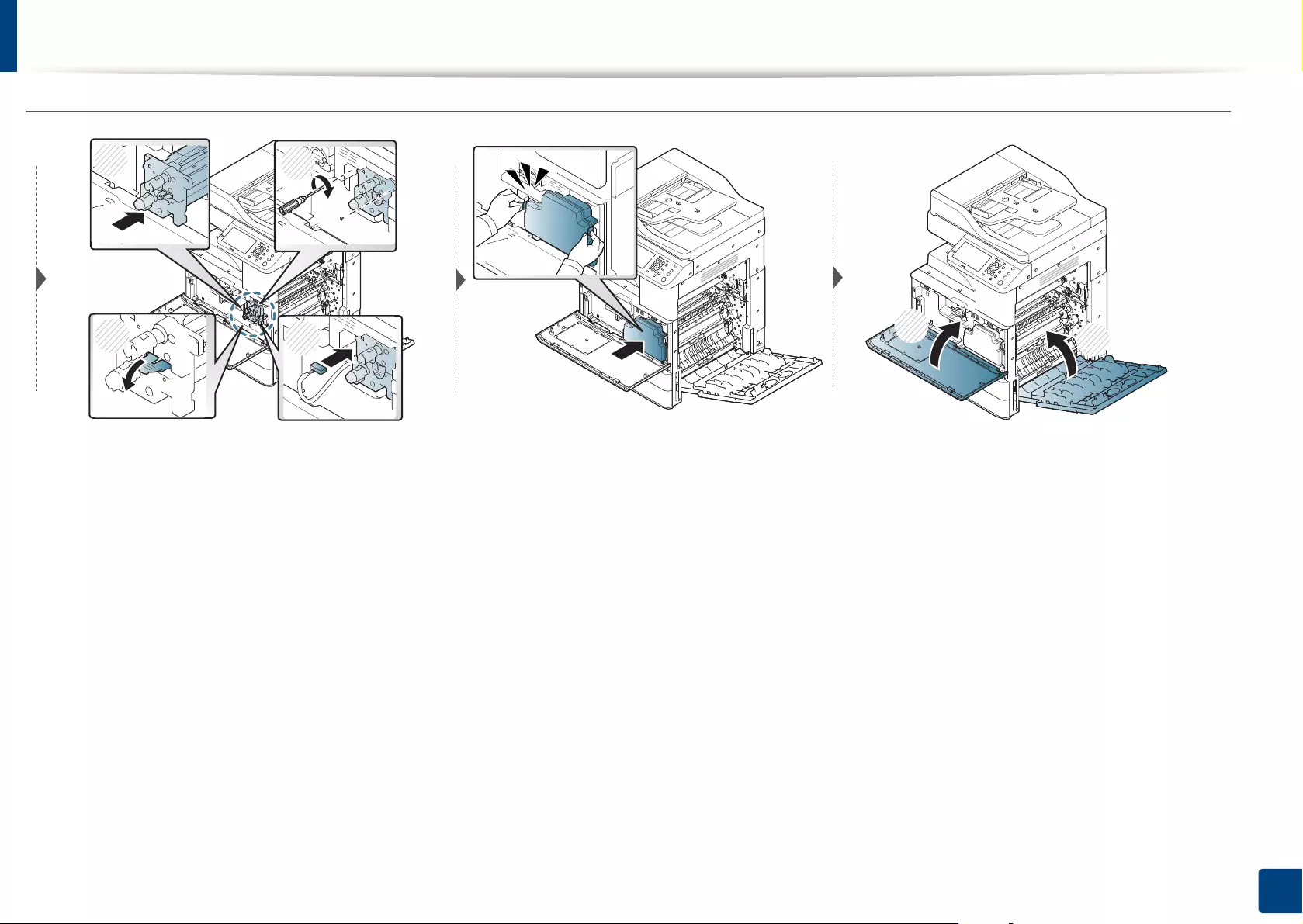
Replacing the imaging unit
309
14. Maintenance
1
2
1
4
2
3
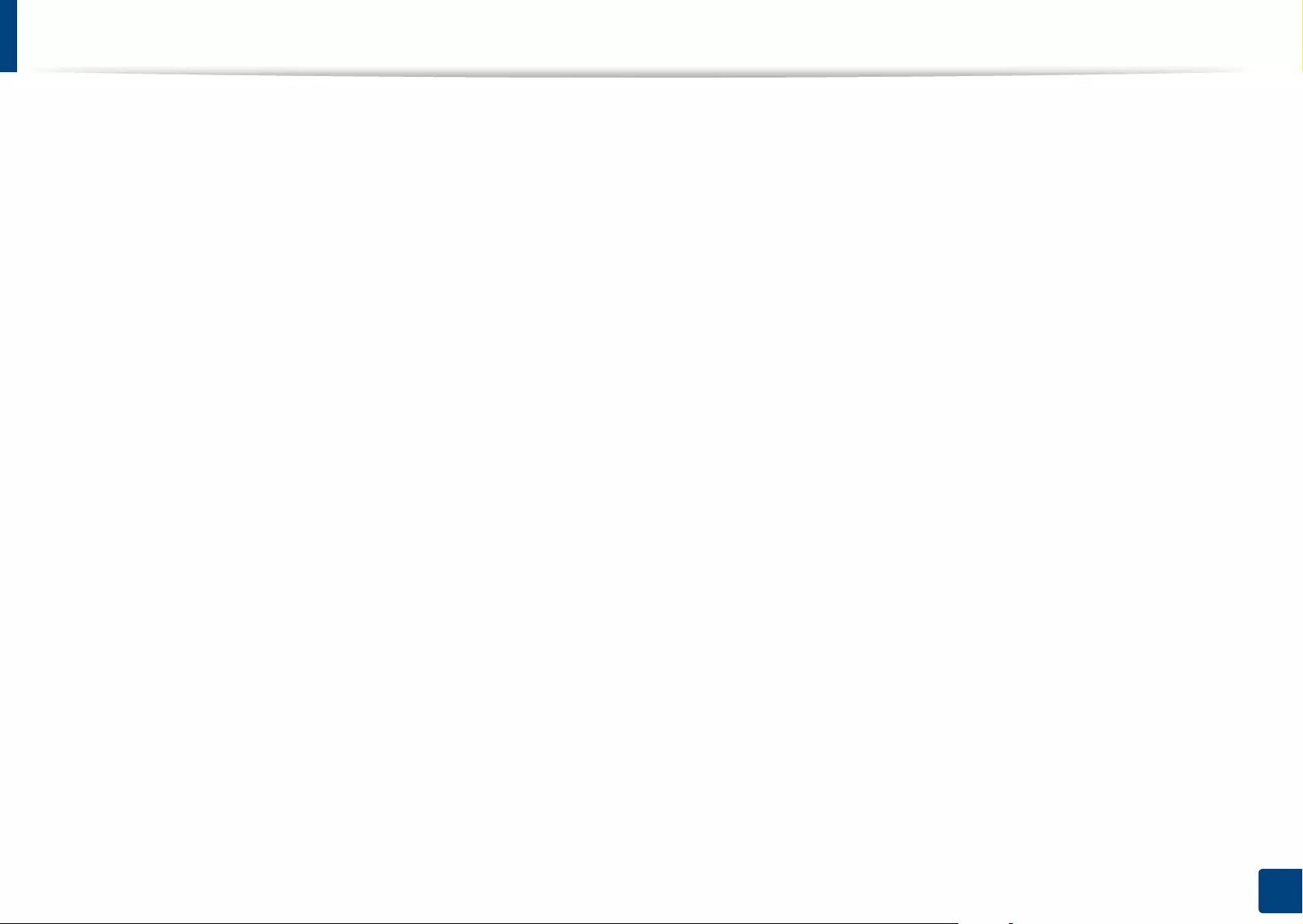
310
14. Maintenance
Replacing the waste toner container
When the waste toner container is totally empty:
• The status LED turns orange on and the display screen shows the error message of replacing waste toner container.
• Check the type of the waste toner container for your machine ("Available supplies" on page 295).
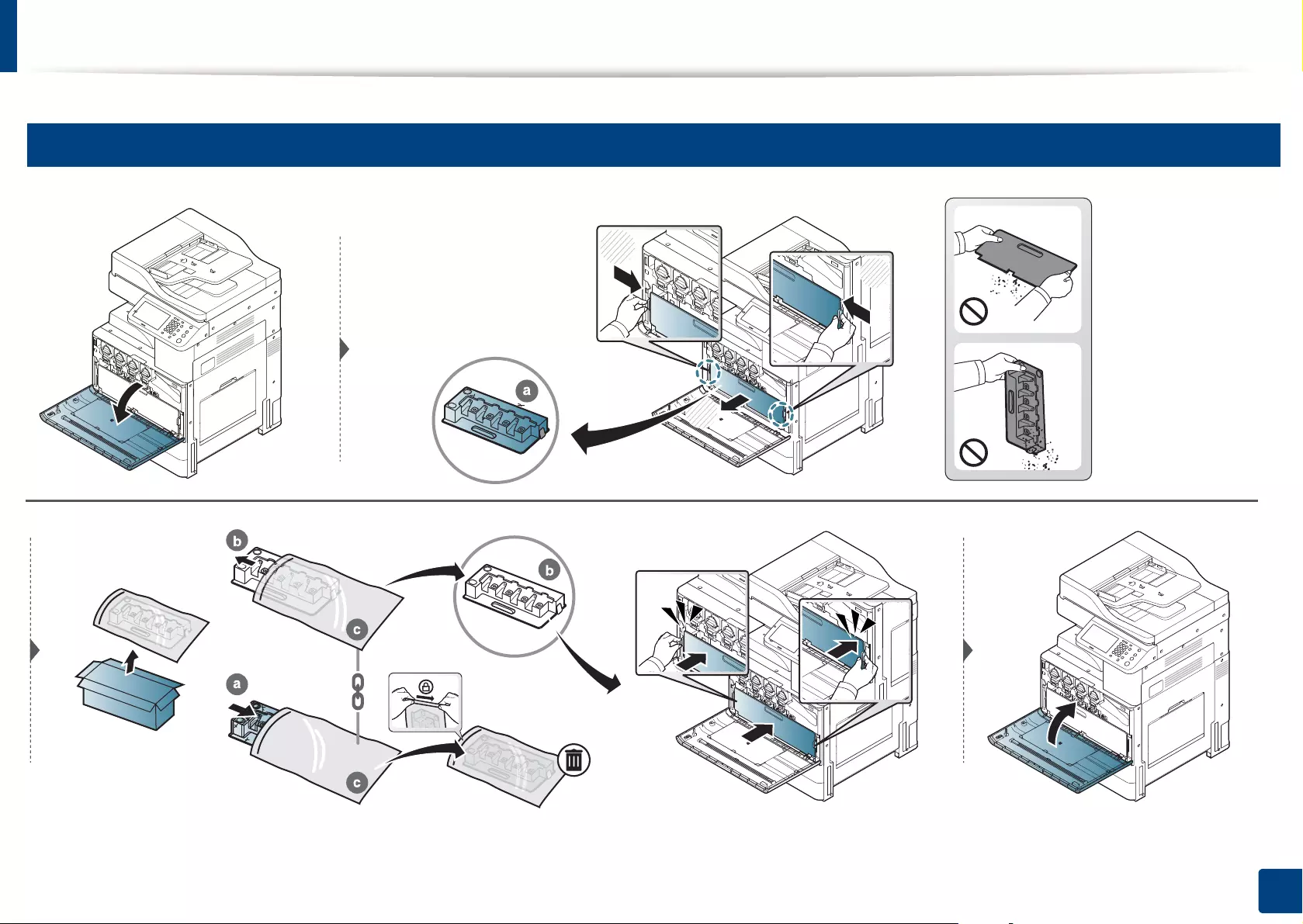
Replacing the waste toner container
311
14. Maintenance
10
X322x/ X328x series
1
2
1
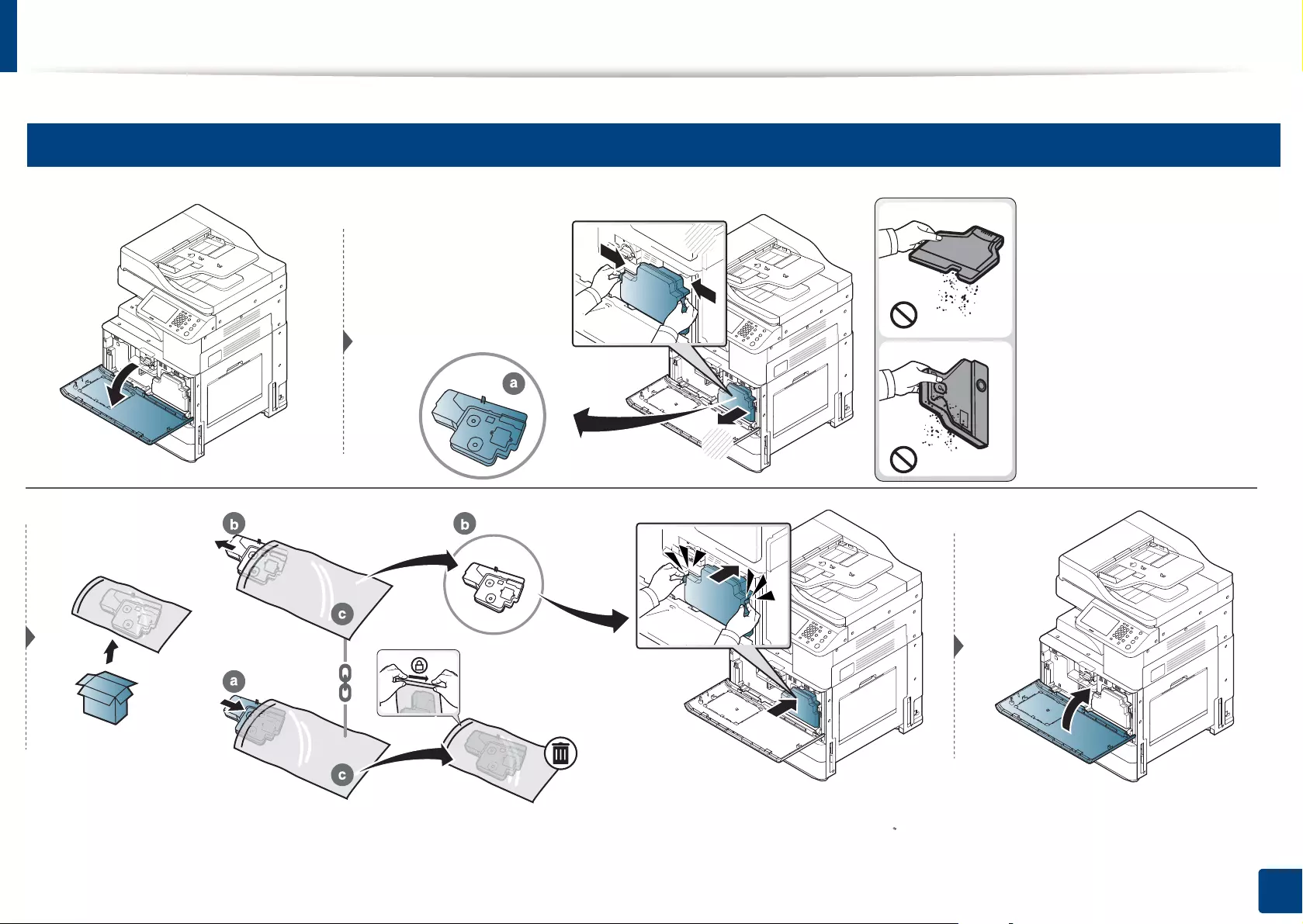
Replacing the waste toner container
312
14. Maintenance
11
K325x/ K330x series
2
1
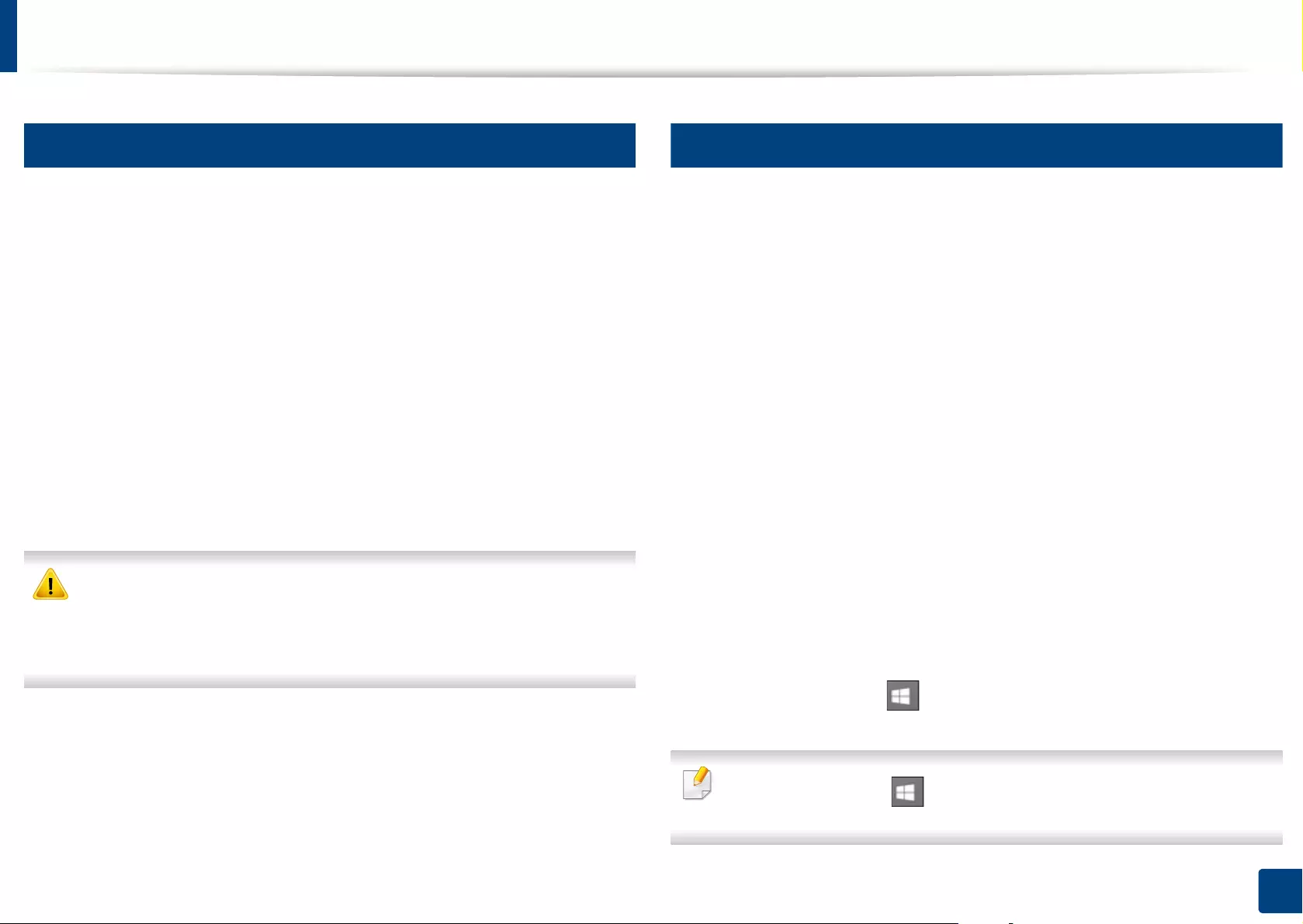
313
14. Maintenance
Installing accessories
12
Precautions
• Disconnect the power cord
Never remove the control board cover while the power is turned on.
To avoid the possibility of an electrical shock, always disconnect the power
cord when installing or removing ANY internal or external accessories.
• Discharge static electricity
The control board and internal accessories (network interface card or
memory module) are sensitive to static electricity. Before installing or
removing any internal accessories, discharge static electricity from your
body by touching something metal, such as the metal back plate on any
device plugged into a grounded power source. If you walk around before
finishing the installation, repeat this procedure to discharge any static
electricity again.
When installing accessories, the battery inside the machine is a service
component. Do not change it by yourself. There is a risk of an explosion if
battery is replaced by an incorrect type. Dispose used batteries according to
the instructions.
13
Setting Device Options
When you install the optional devices such as optional tray, memory, etc, this
machine automatically detects and sets the optional devices. If you cannot use
the optional devices you installed in this driver, you can set the optional devices
in Device Options.
1For Windows XP Service Pack 3/Server 2003, from the Start menu, select
Printer and Faxes.
• For Windows Server 2008/Vista, from the Start menu, select Control
Panel > Hardware and Sound > Printers.
• For Windows 7, from the Start menu, select Control Panel > Devices
and Printers.
For Widows 8, from the Charms, select Search > Settings > Control
Panel > Devices and Printers.
• For Windows Server 2008 R2, select Control Panel > Hardware >
Devices and Printers.
• For Windows 10 / Windows Server 2016
From task bar, type in Devices and Printers in Search input area.
Press the Enter key.
OR
From the Start ( ) icon, select Settings > Devices > Printers &
scanners >Devices and Printers.
Right-click the Start ( ) icon, you can select Control Panel > Devices
and Printers.
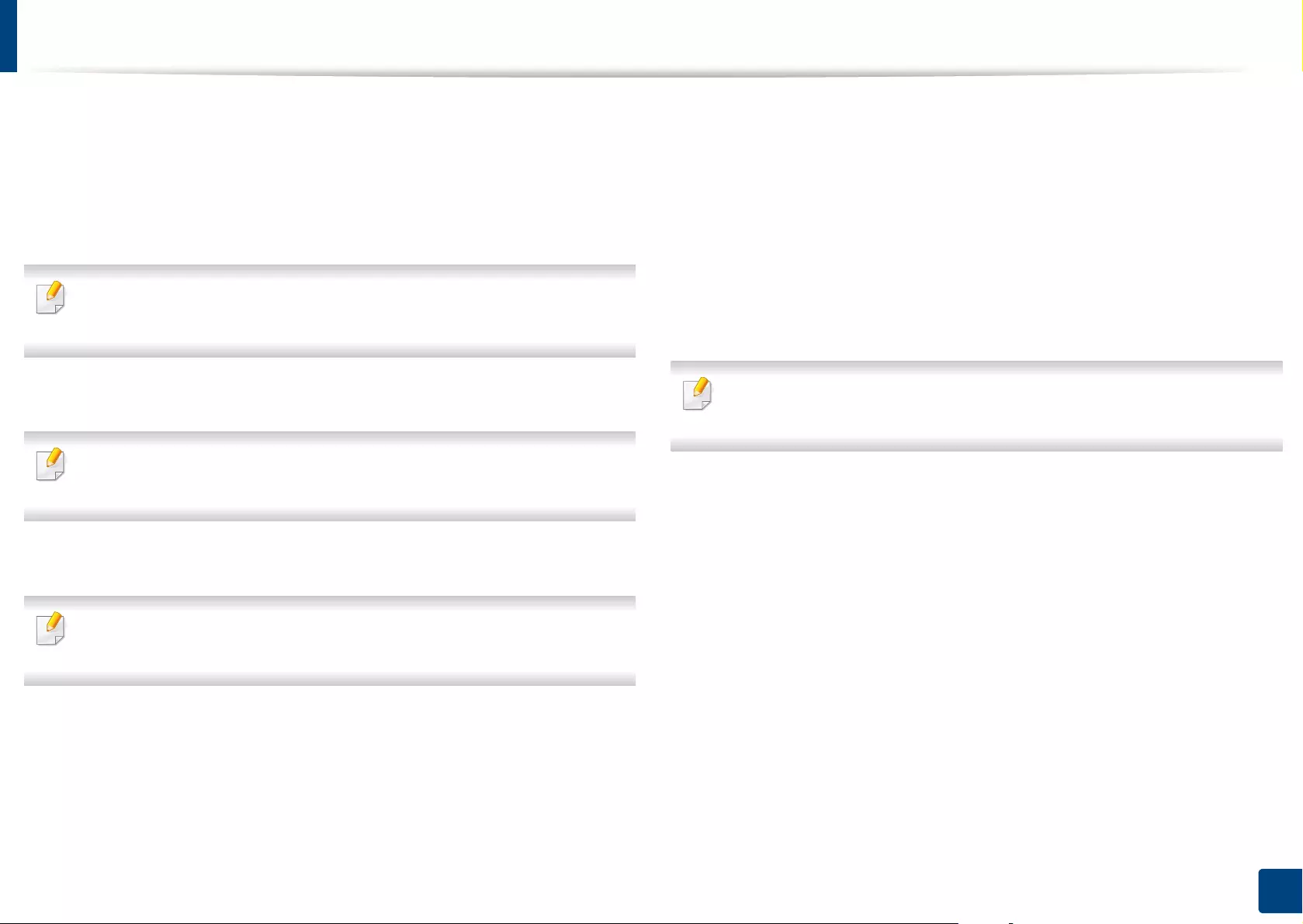
Installing accessories
314
14. Maintenance
2 Right-click your machine.
3 For Windows XP/2003/2008/Vista, press Properties.
For Windows 7, Windows 8, and Windows Server 2008 R2, from context
menus, select the Printer properties.
If Printer properties item has ▶ mark, you can select other printer drivers
connected with selected printer.
4 Select Device Options.
The Properties window may differ depending on the driver or operating
system you are using.
5 Select the appropriate option.
Some menus may not appear in the display depending on options or
models. if so, it is not applicable to your machine.
•Tray Options: Select the optional tray you installed. You can select
the tray.
•Storage Options: Select the optional memory you installed. If this
feature is checked, you can select the Print Mode.
•Advanced Features: You can select the Printer Status and Stylish
User Interface.
•Admin Job Accounting: Allows you to associate user and account
identification information with each document you print.
-User permission: If you check this option, only users with user
permission can start a print job.
-Group permission: If you check this option, only groups with
group permission can start a print job.
If you want to encrypt job accounting password, check Job Accounting
Password Encryption.
•Custom Paper Size Settings: You can specify custom paper size.
6 Click OK until you exit the Properties or Printer properties window.
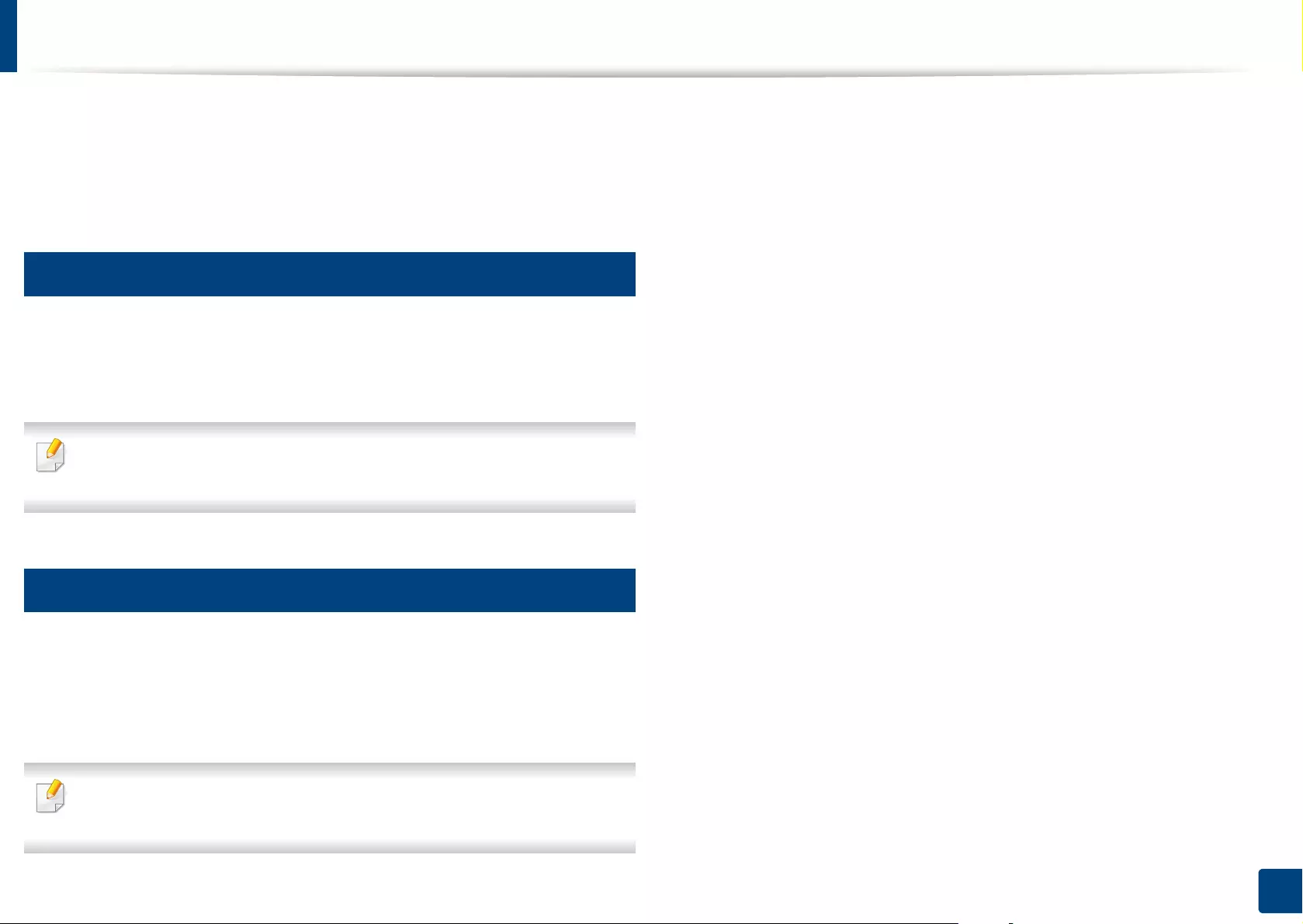
315
14. Maintenance
Checking the supplies life
Check remaining life of the supplies and prepare the supplies in advance.
You can also print the supplies life report. Select Supplies Information in the
Report feature (see "Other settings" on page 249).
14
From the machine
1Press Machine Setup > Others > Supplies Life from the display screen.
2 Check the supplies life.
We recommend you prepare new supplies or those that you have used over
90% of their average yield.
15
From the SyncThru™ Web Service
1From the SyncThru™ Web Service, select the Information tab >
Supplies.
2 Check the remaining percentage.
We recommend you prepare new supplies if the remaining percentage is
less than 10%.
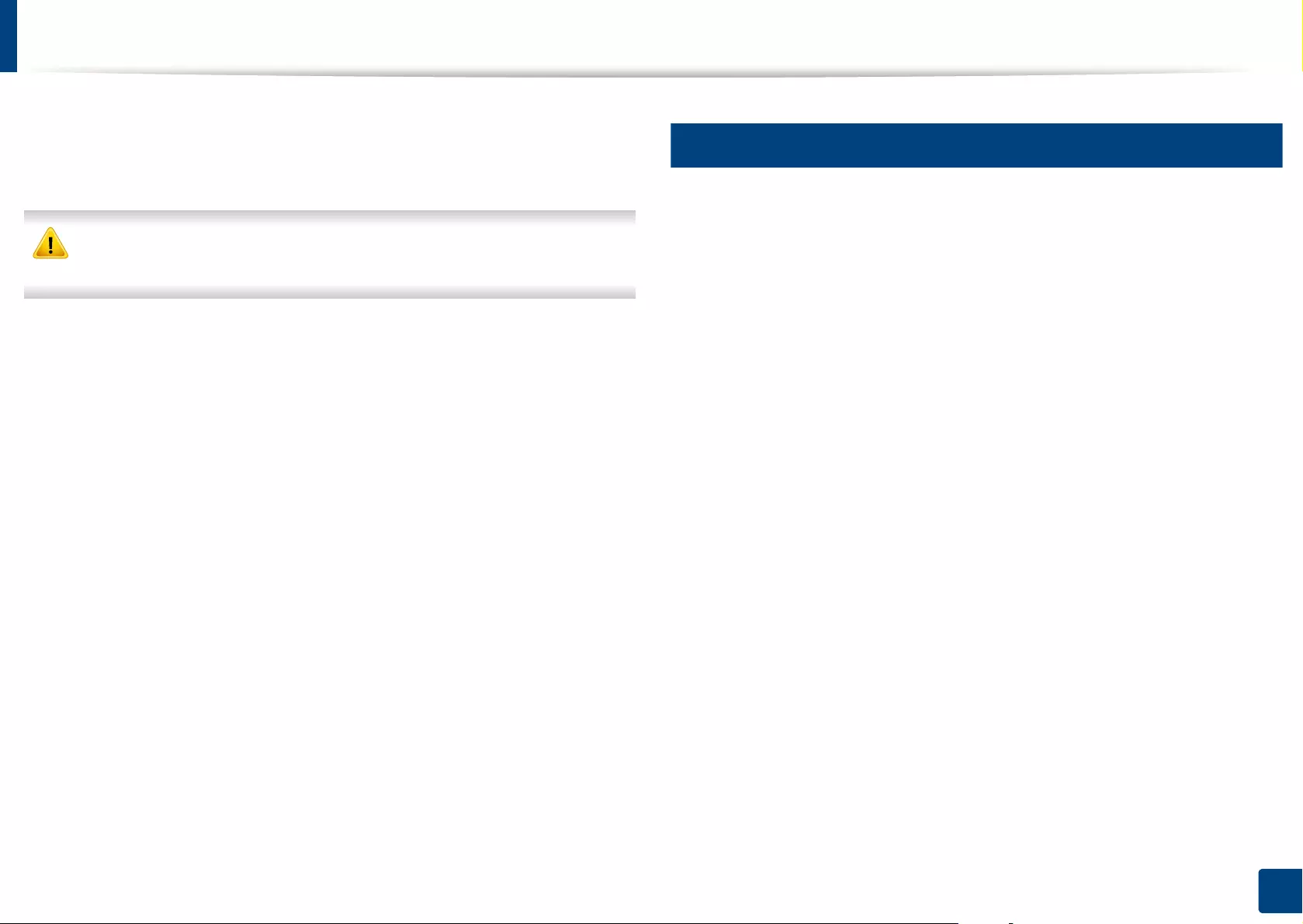
316
14. Maintenance
Cleaning the machine
If printing quality problems occur or if you use your machine in a dusty
environment, you need to clean your machine regularly to keep the best
printing condition and use your machine longer.
Read the following precautions before cleaning the machine: any damages
due to user’s mis-handling is not covered by the warranty:
• Turn the machine’s power off and unplug all the power cords.
• Do not disassemble the machine without following the instructions in this
guide.
• Do not clean the machine with cleaning materials containing large amounts
of alcohol, solvent, or other strong substances. They can discolor or distort
the cabinet.
• Do not use a vacuum cleaner to clean the toner dust, we recommend you
use a cloth or tissue dampened with water to clean it. If you use a vacuum
cleaner, toner blows into the air and might be harmful to you.
• When using a dampened cloth, be careful not to drip any water into the
machine: it might cause an electric shock.
• For more safety issues, refer to the safety information chapter in the User’s
Guide.
16
Cleaning the outside or display screen
Clean the machine cabinet or the display screen with a soft, lint-free cloth.
Dampen the cloth slightly with water, but be careful not to let any water drip
onto or into the machine.
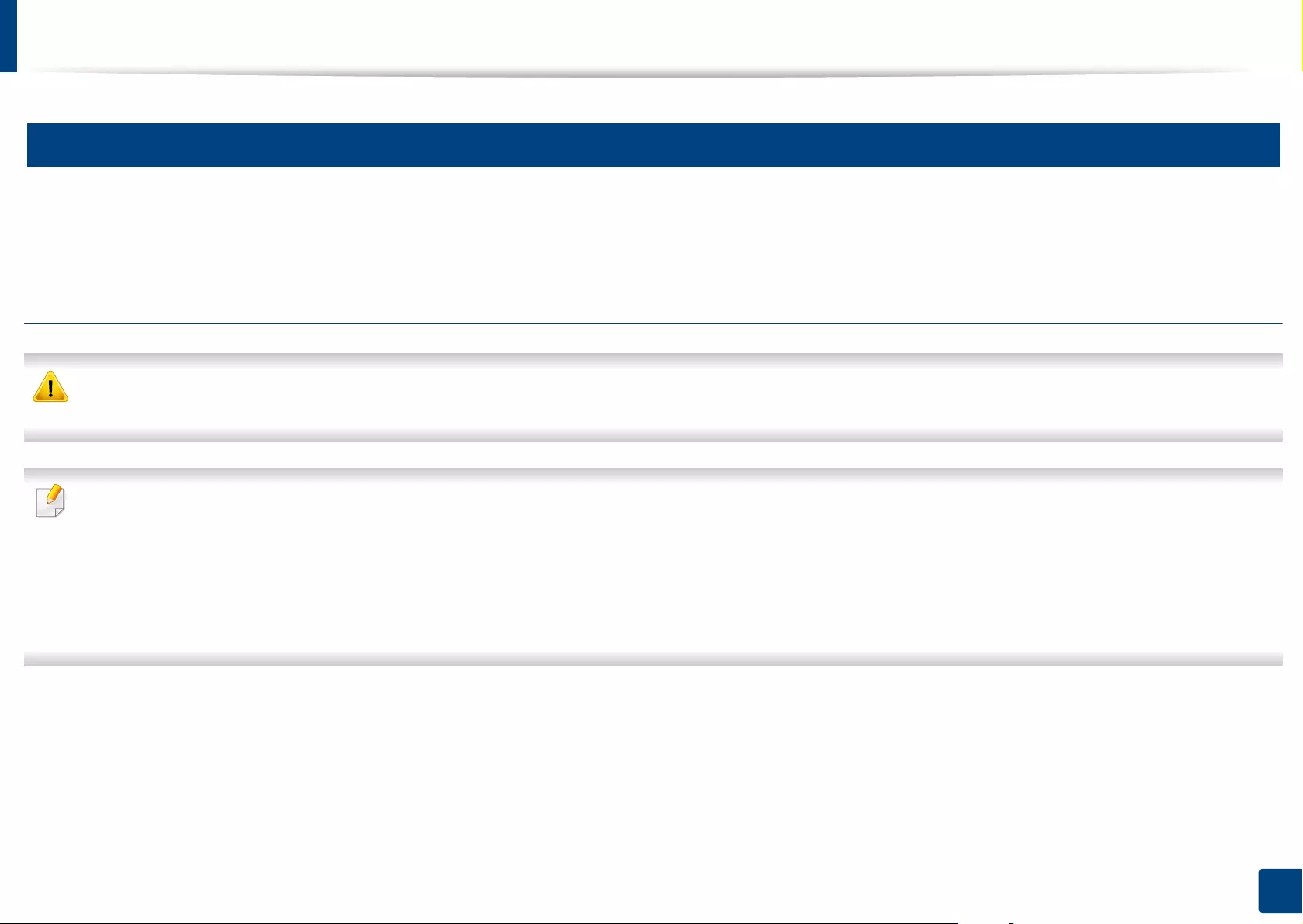
Cleaning the machine
317
14. Maintenance
17
Cleaning the inside
During the printing process, paper, toner, and dust particles can accumulate inside the machine. These accumulations can cause print quality problems, such as toner
specks or smearing. Cleaning the inside of the machine clears and reduces printing quality problems.
Toner cartridge area
Use a dry lint free cloth when cleaning the inside of the machine, be careful not to damage the transfer roller or any other inside parts. Do not use solvents such as
benzene or thinner. Printing quality problems can occur and cause damage to the machine.
• Use a dry lint-free cloth to clean the machine.
• Turn the machine off and unplug the power cord. Wait for the machine to cool down. If your machine has a power switch, turn the power switch off before
cleaning the machine.
• If the front door is not completely closed, the machine will not operate.
• Illustrations on this user’s guide may differ from your machine depending on its options or models. Check your machine type (see "Machine overview" on page
20).
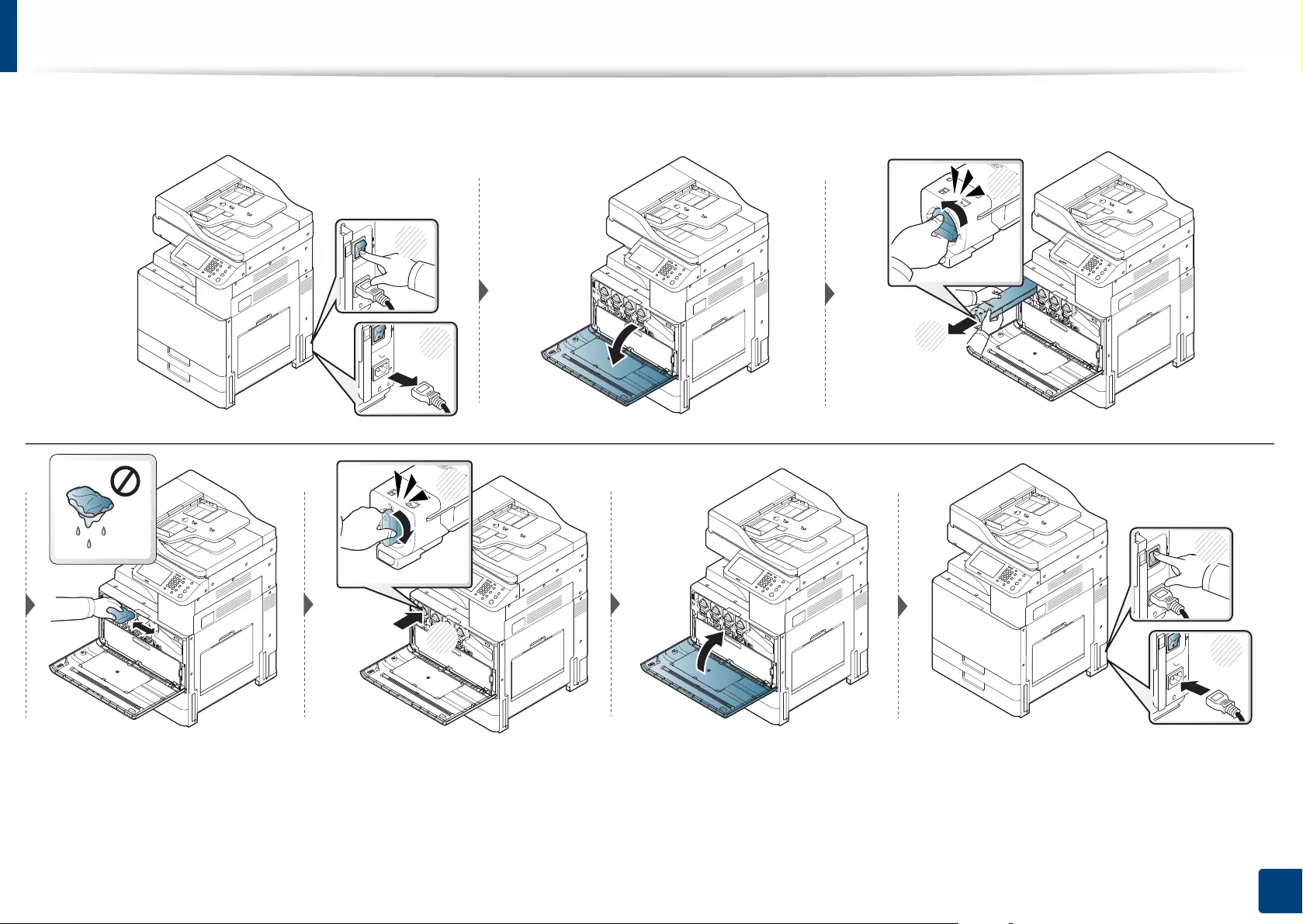
Cleaning the machine
318
14. Maintenance
X322x/ X328x series
2
1
2
1
2
1
2
1
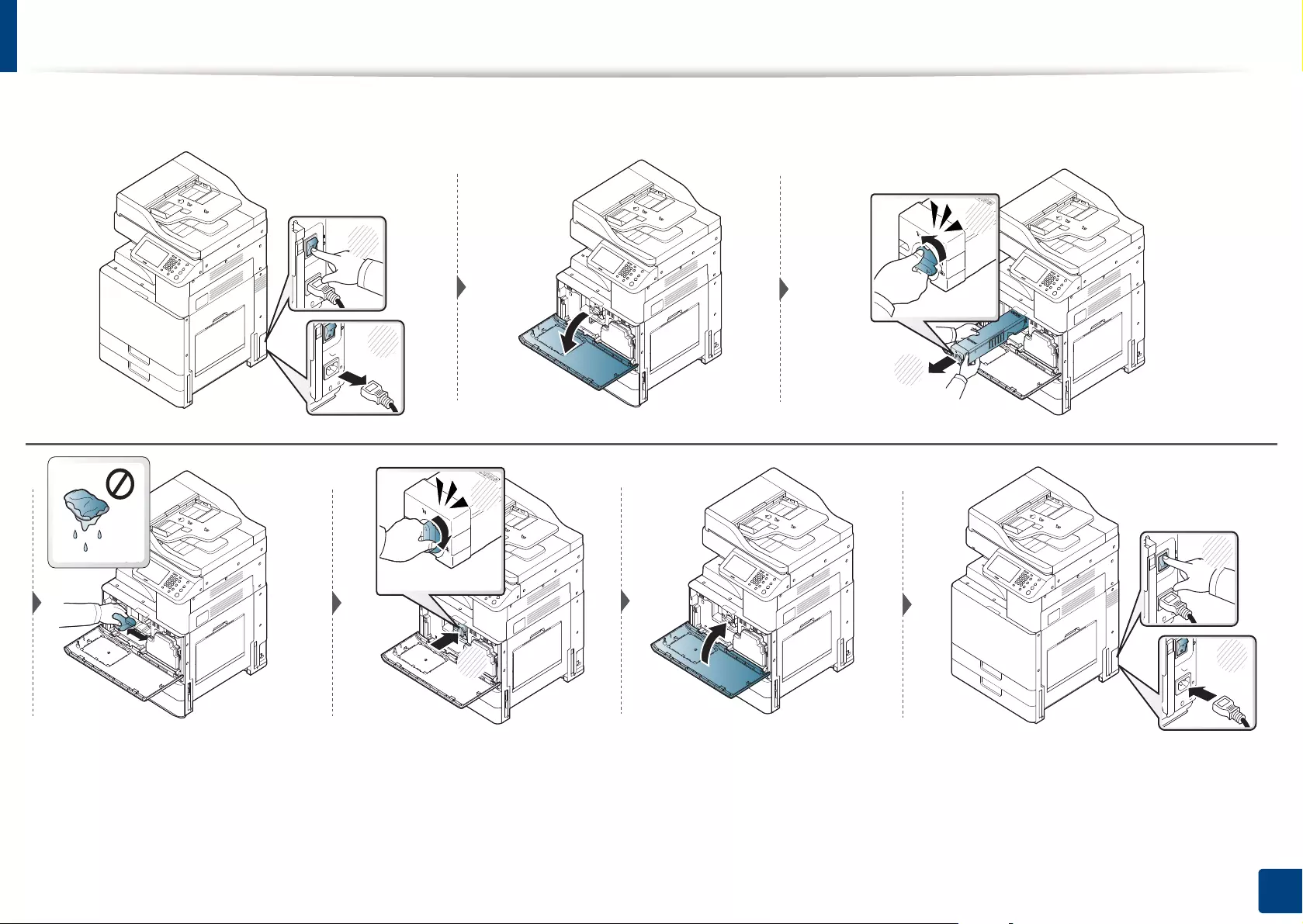
Cleaning the machine
319
14. Maintenance
K325x/ K330x series
2
1
2
1
2
1
2
1
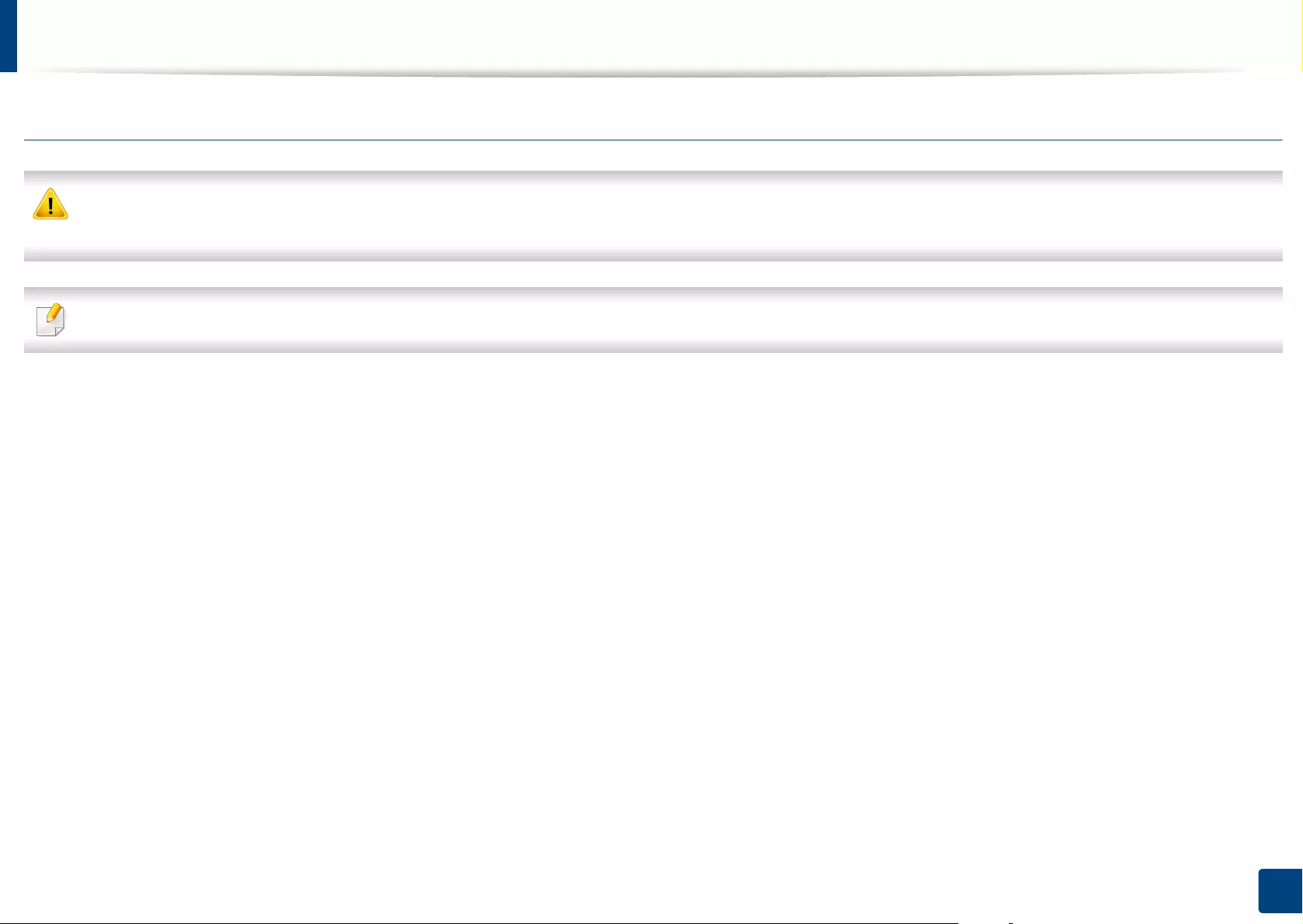
Cleaning the machine
320
14. Maintenance
Cleaning the imaging unit area
• To prevent damage to the imaging unit, do not expose it to light for more than a few minutes. Cover it with a piece of paper, if necessary.
• Do not touch the green surface underside of the imaging unit.
If the front door is not completely closed, the machine will not operate.
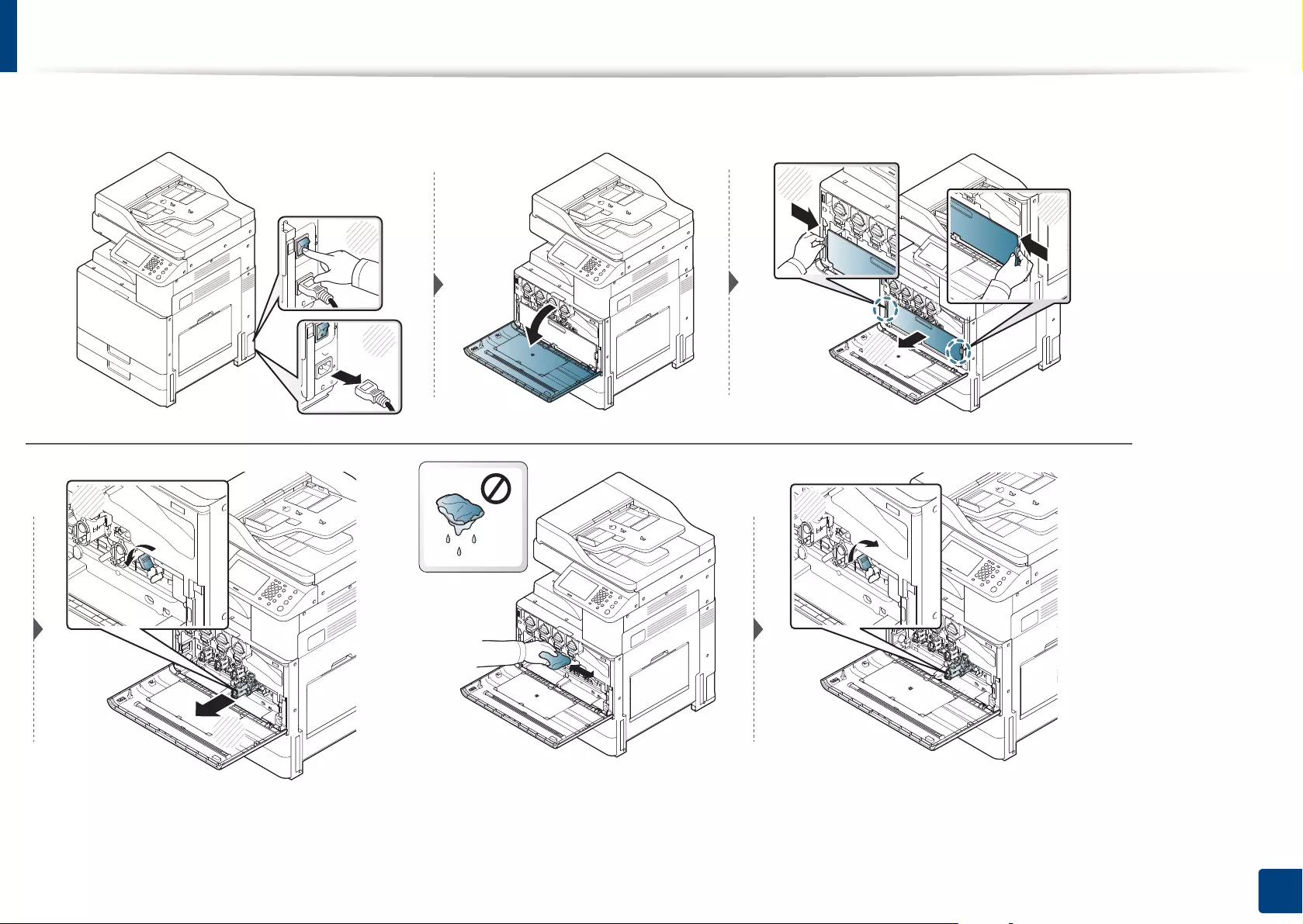
Cleaning the machine
321
14. Maintenance
X322x/ X328x series
2
2
1
1
1
1
2
1
2

Cleaning the machine
322
14. Maintenance
2
1
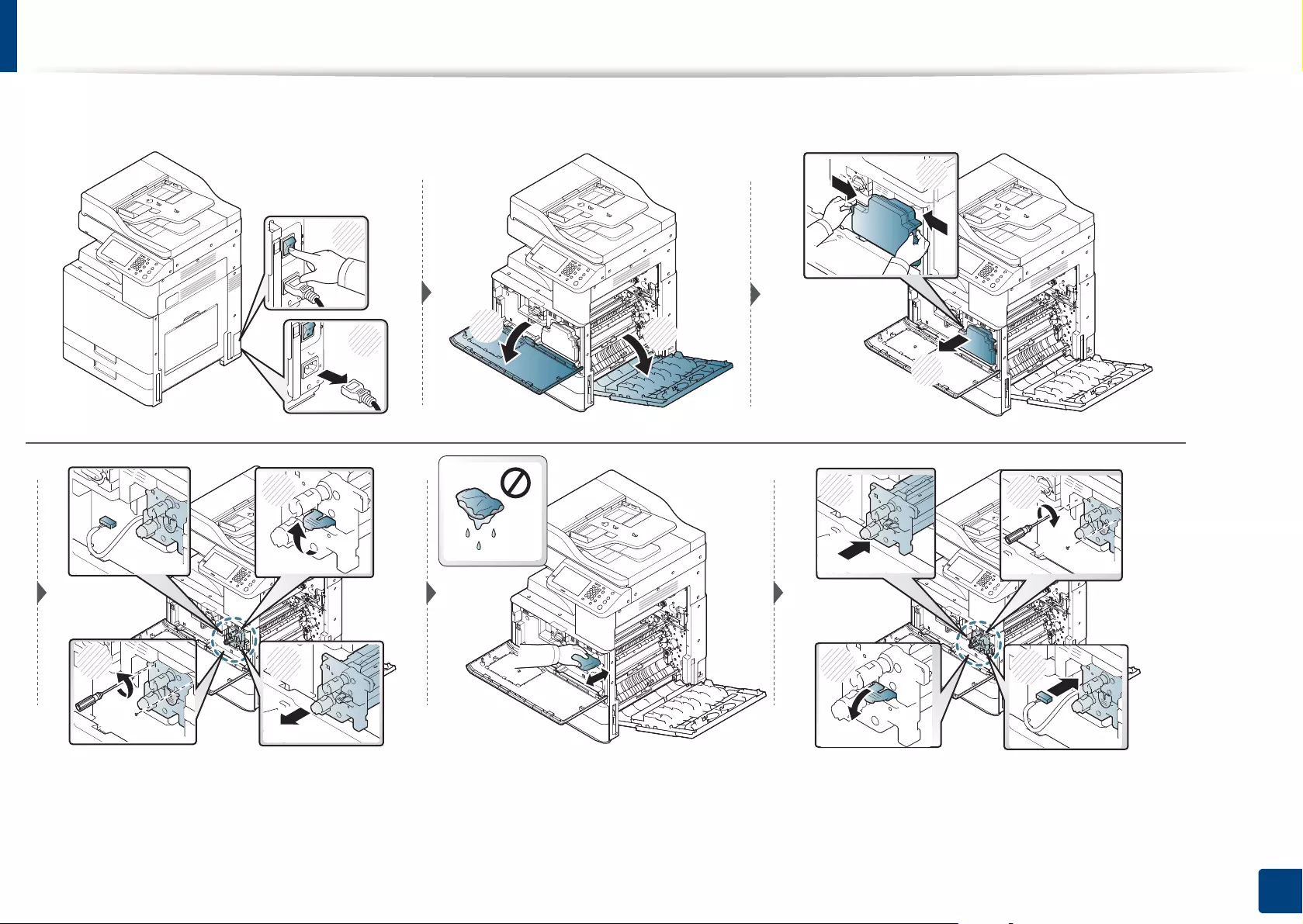
Cleaning the machine
323
14. Maintenance
K325x/ K330x series
3
4
1
2
1
12
2
1
2
1
4
2
3
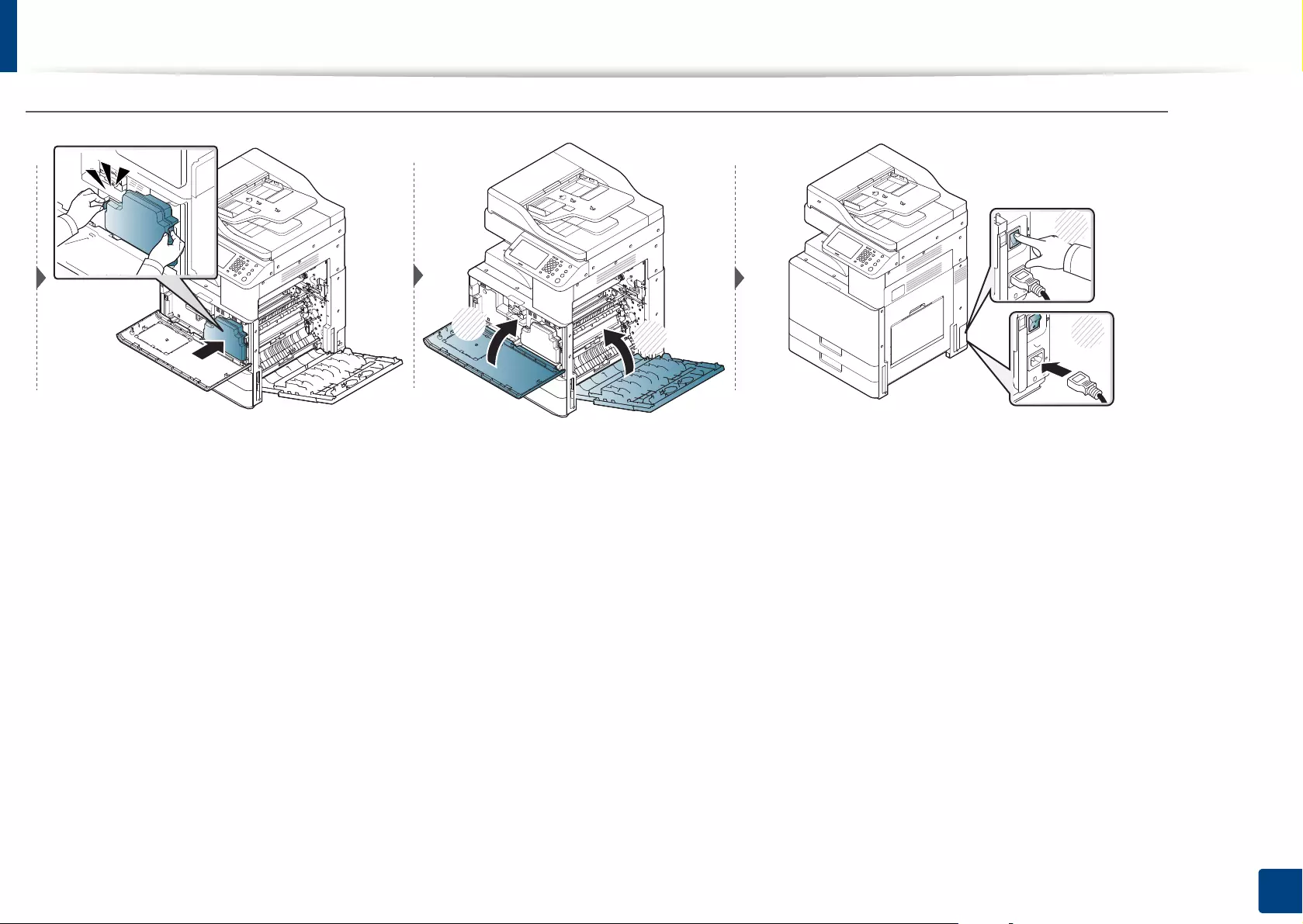
Cleaning the machine
324
14. Maintenance
2
1
1
21
2
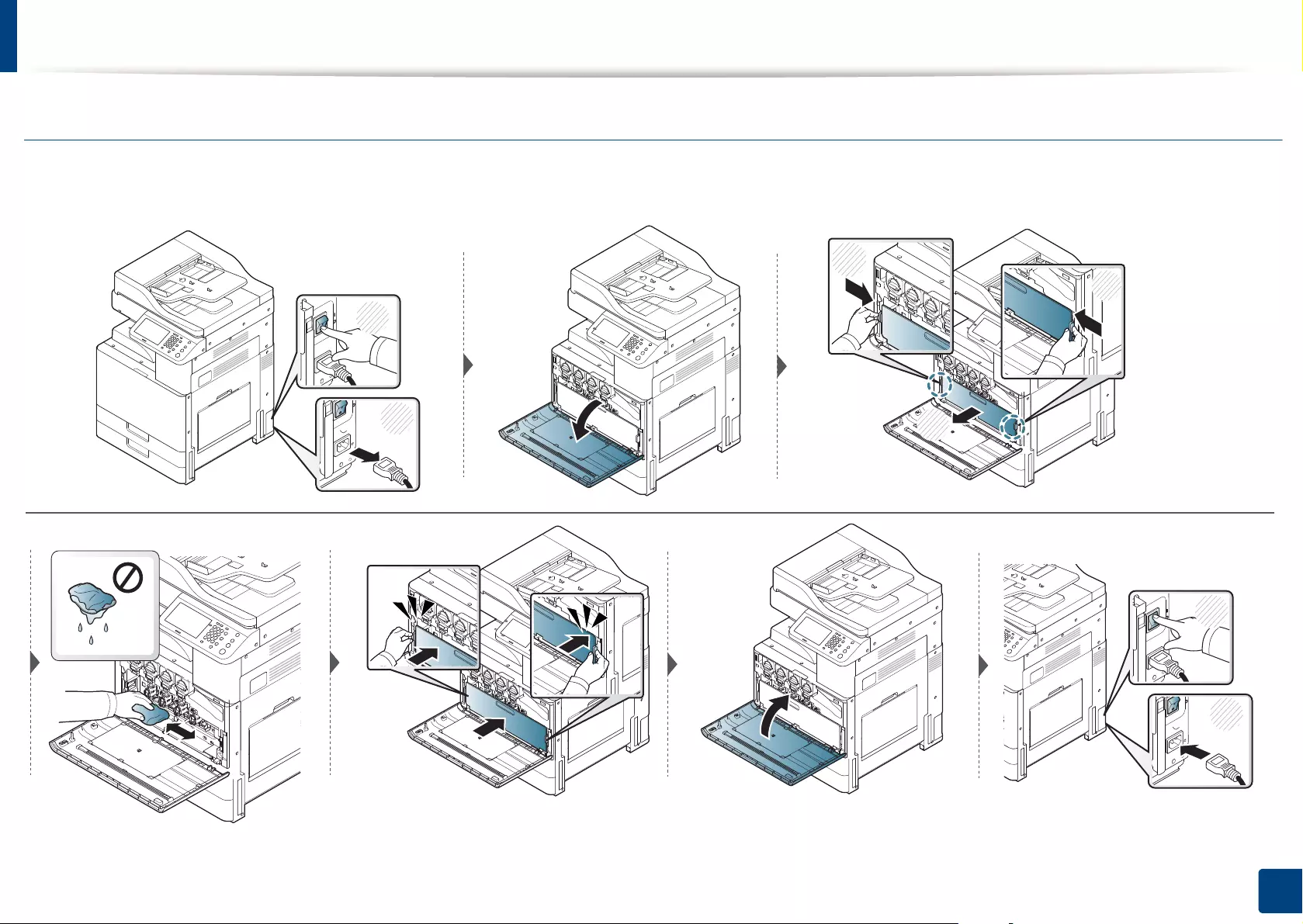
Cleaning the machine
325
14. Maintenance
Cleaning the waste toner container area
X322x/ X328x series
2
1
2
1
1
2
1
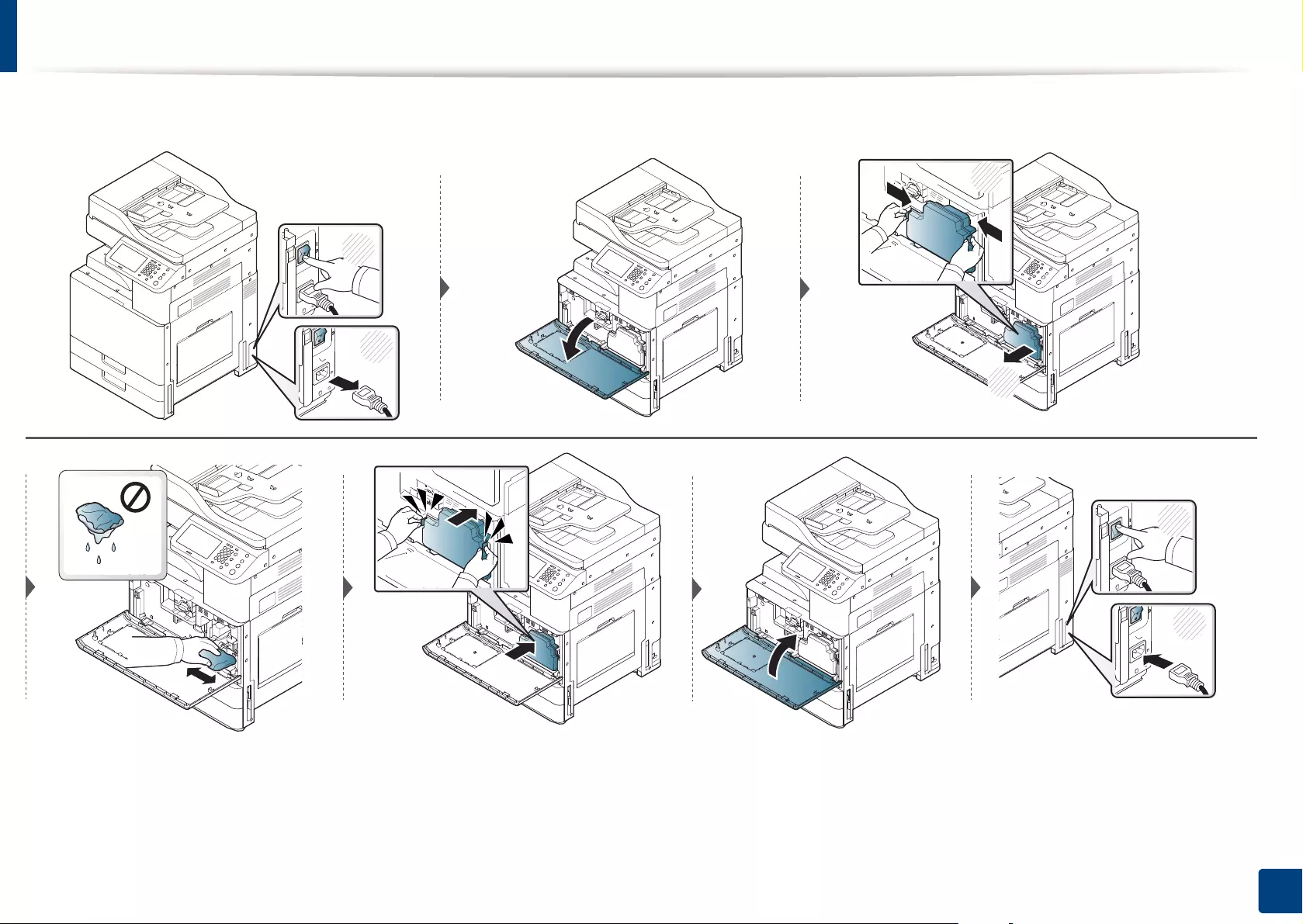
Cleaning the machine
326
14. Maintenance
K325x/ K330x series
2
1
2
1
2
1
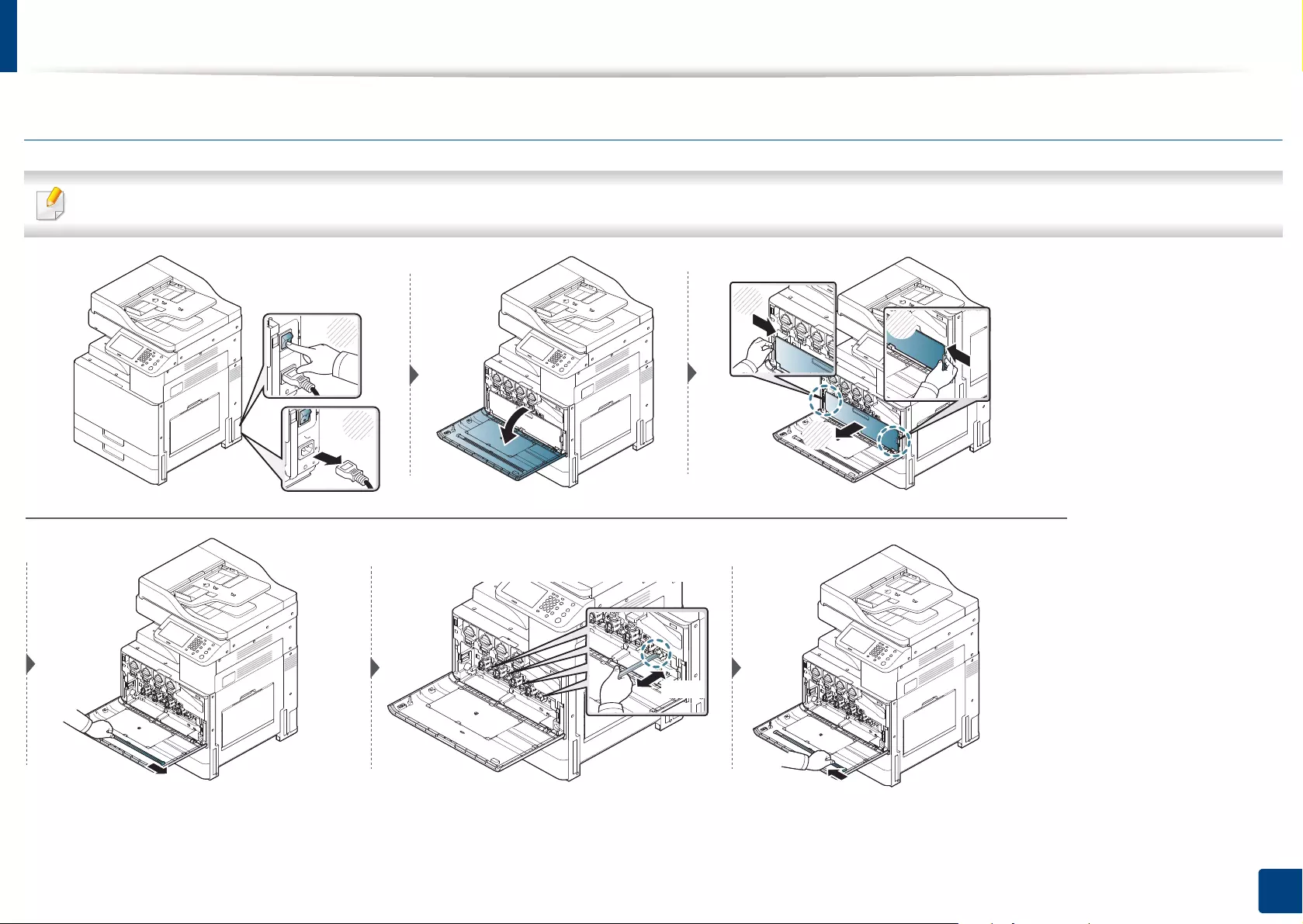
Cleaning the machine
327
14. Maintenance
Cleaning the LSU window(X322x/ X328x series only)
If the front door is not completely closed, the machine will not operate.
2
11
2
1
4 ~ 5
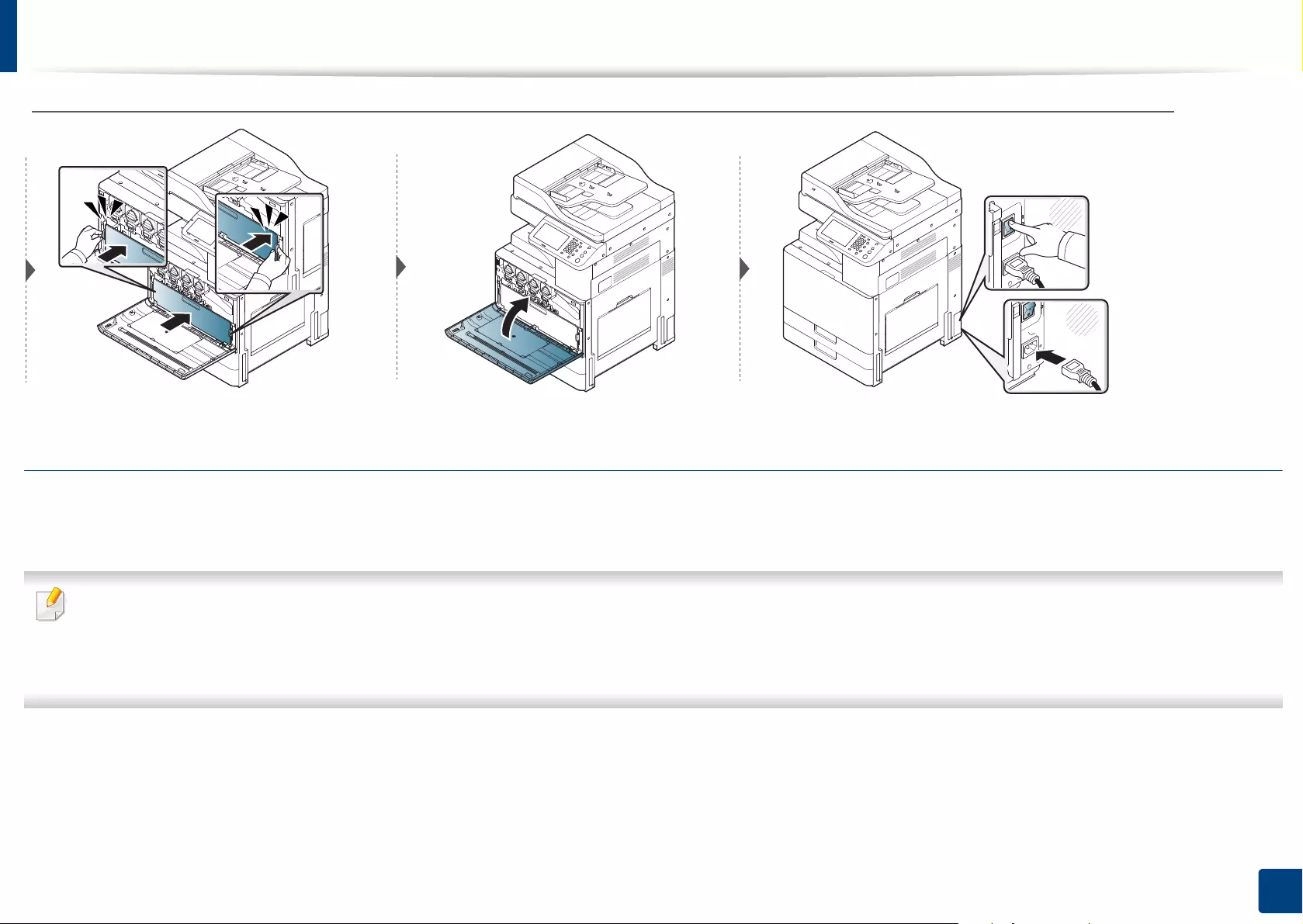
Cleaning the machine
328
14. Maintenance
Cleaning the scan unit
Keeping the scan unit clean helps to ensure the best possible copy quality. We suggest that you clean the scan unit at the start of each day and during the day, as
needed.
• Turn the machine off and unplug the power cord. Wait for the machine to cool down. If your machine has a power switch, turn the power switch off before
cleaning the machine.
• Illustrations on this user’s guide may differ from your machine depending on its options or models. Check your machine type (see "Machine overview" on page
20).
1Prepare a soft, lint-free cloth.
2 Open the scanner lid.
2
1
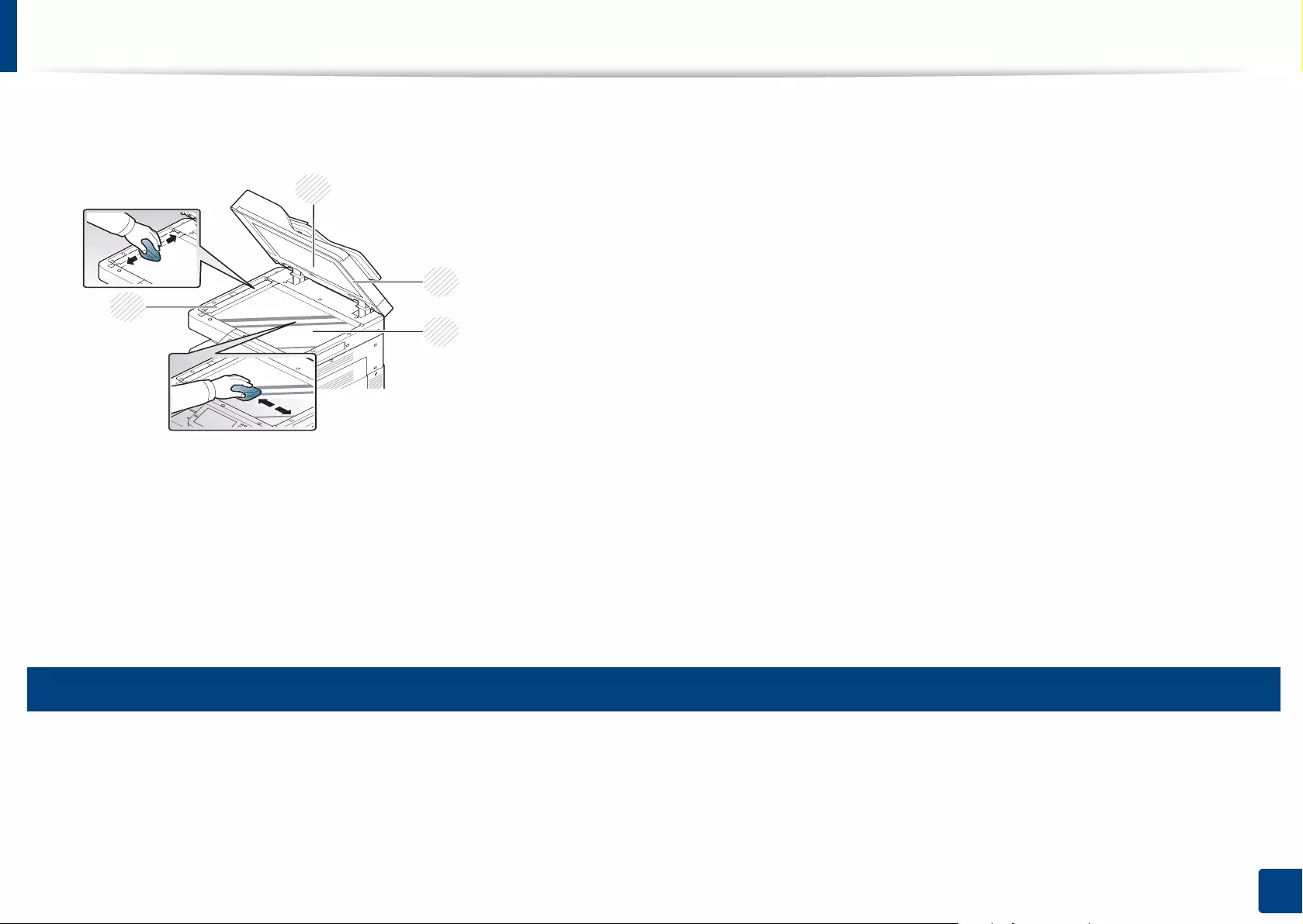
Cleaning the machine
329
14. Maintenance
3 Wipe the surface of the scanner glass and the document feeder glass with the cloth until it is clean and dry. Wipe the underside of the scanner lid and white
sheet until it is clean and dry.
1 Scanner lid
2 Scanner glass
3 White sheet
4 Document feeder glass
4 Close the scanner lid.
18
Cleaning the chargers of imaging unit
The paper dust stick and the chargers of the imaging unit will need to be cleaned after a specified number of paper is printed out. When the message that demands
you to clean the chargers of the imaging unit appears, you have to clean the paper dust stick first. Then clean the chargers. The time when the message appears
depends on environmental factors like altitude, temperature, humidity, and so on. You need to clean the charger to maintain printing quality. If cleaning is done, the
message will disappear automatically.
3
4
1
2
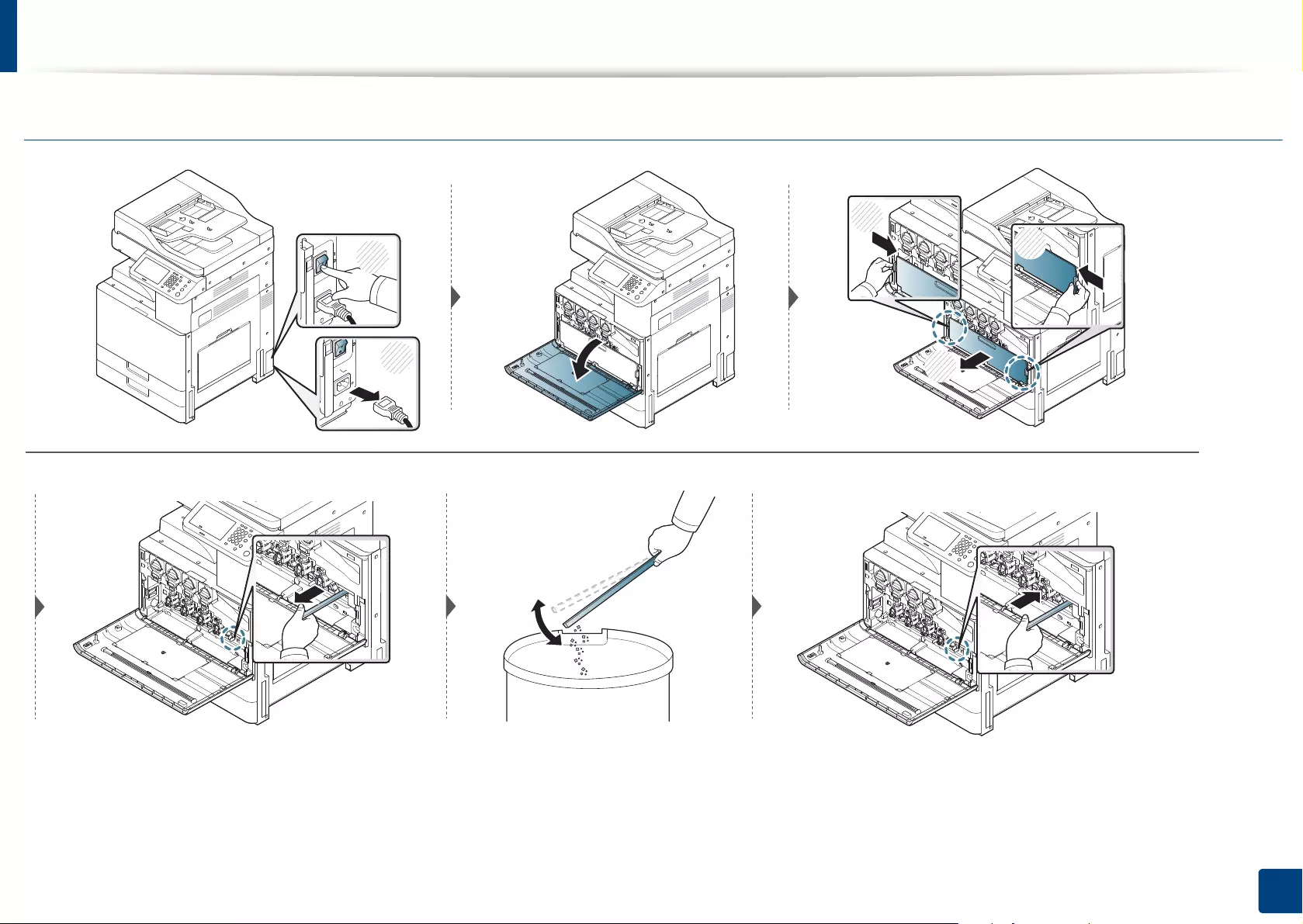
Cleaning the machine
330
14. Maintenance
X322x/ X328x series
2
11
2
1
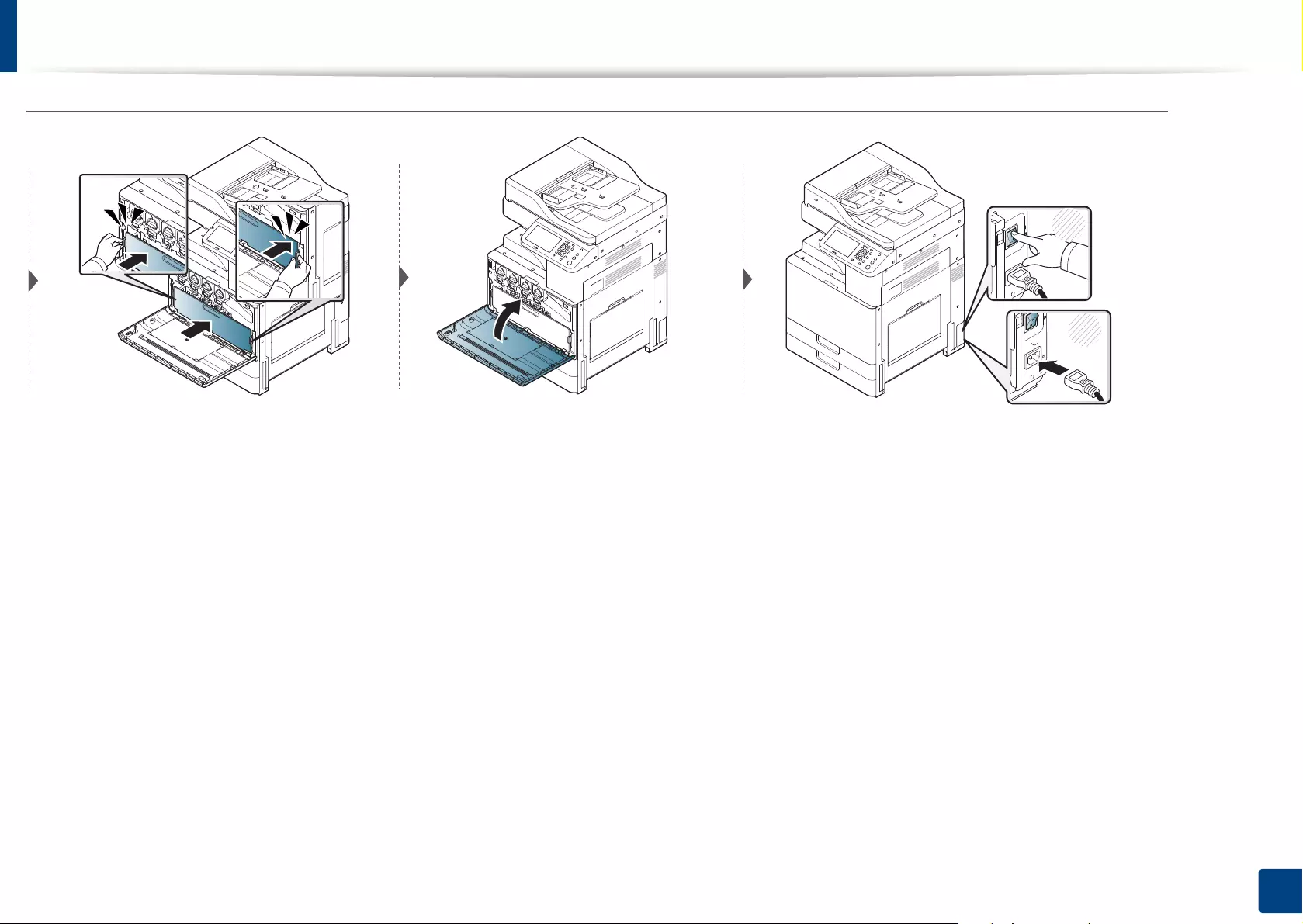
Cleaning the machine
331
14. Maintenance
2
1
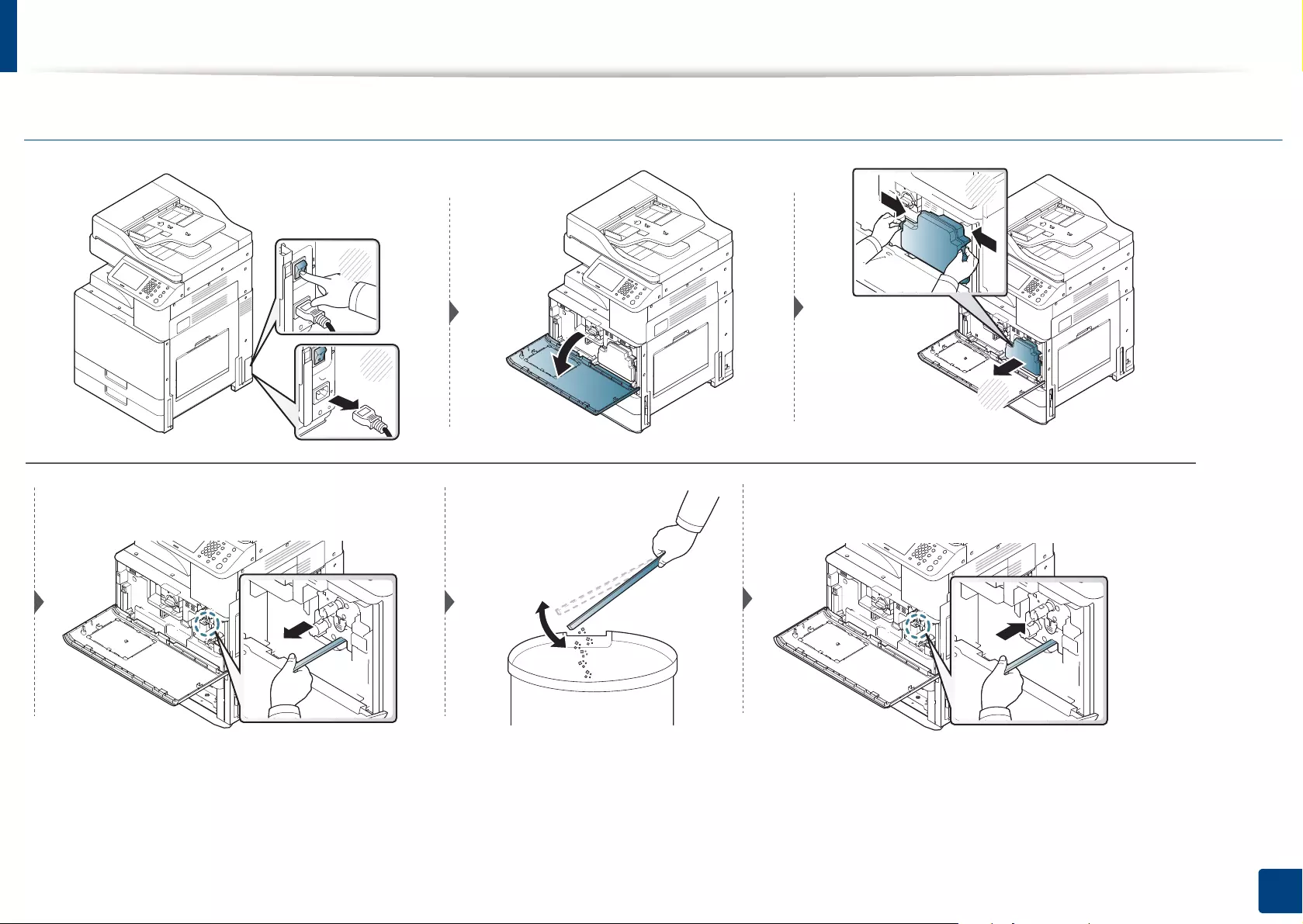
Cleaning the machine
332
14. Maintenance
K325x/ K330x series
2
1
2
1
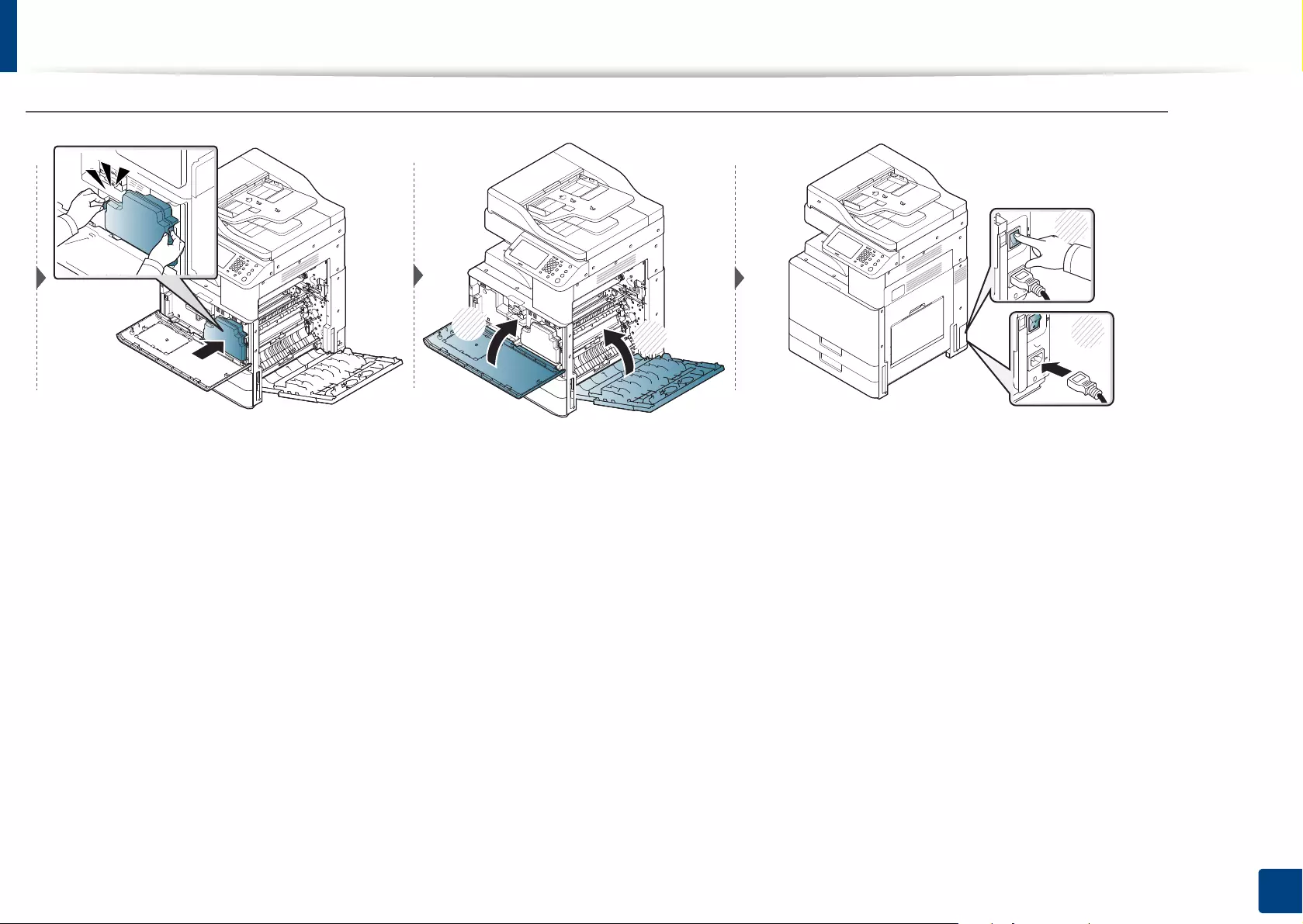
Cleaning the machine
333
14. Maintenance
2
1
1
21
2
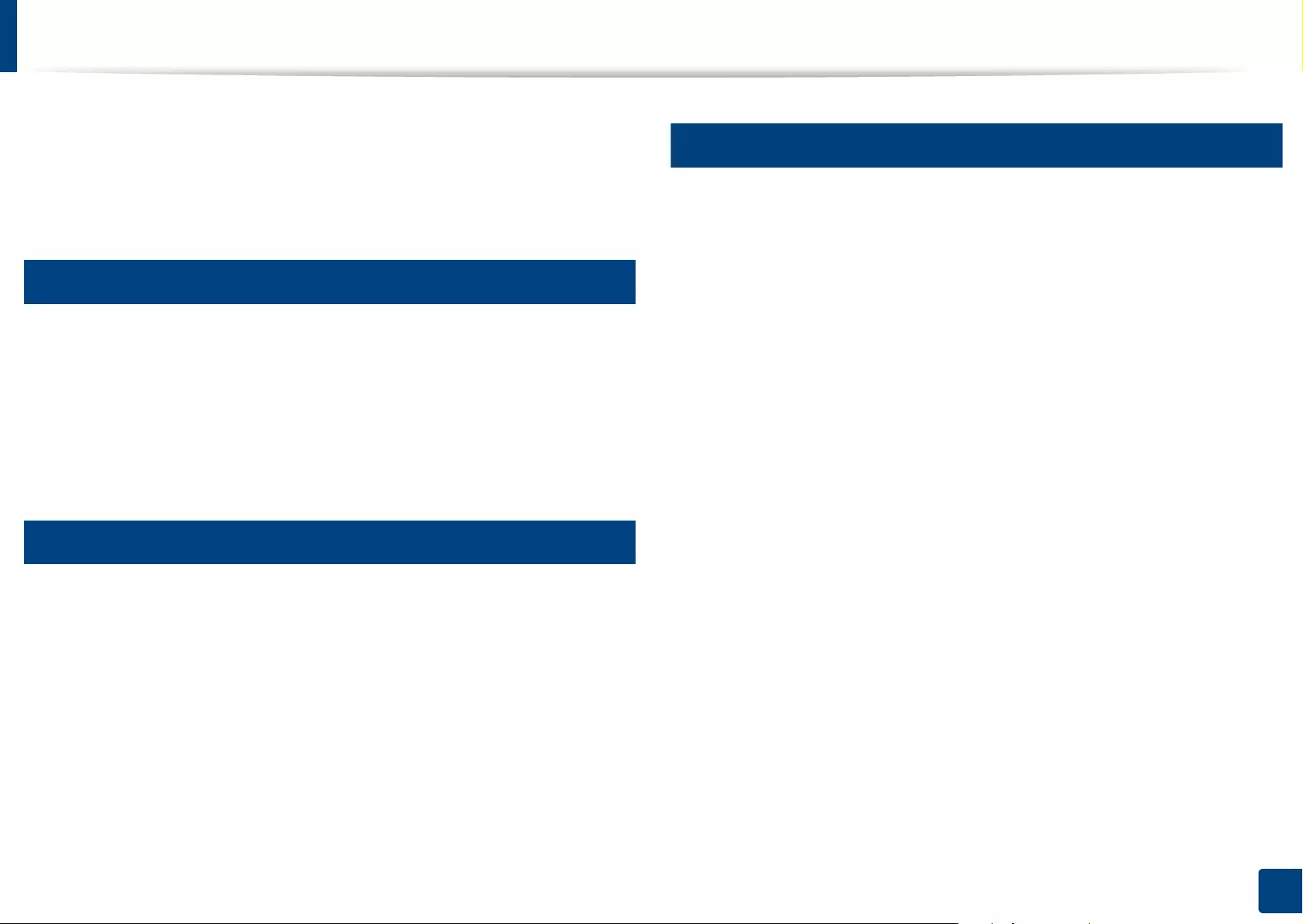
334
14. Maintenance
Tips for storing the machine, supplies, and paper
• Keep them in a cool place with no humidity.
• Keep them covered so that dusts cannot be accumulated.
• Keep them out of water.
19
Machine
• When moving the machine, do not tilt or turn it upside down. Otherwise, the
inside of the machine may be contaminated by toner, which can cause
damage to the machine or reduce print quality.
• When moving the machine, make sure at least four people are holding the
machine securely.
20
Toner cartridge/ Imaging unit
To get the best, print quality from the toner cartridge, keep the following
guidelines in mind:
• Do not remove the toner cartridge from its package until it’s ready to use.
• Do not refill the toner cartridge. The machine warranty does not cover
damage caused by using a refilled cartridge.
• Store toner cartridges in the same environment as your machine.
• Keep it in a stable place so the toner dust is not slanted to one side.
21
Paper
• Store print media in its ream wrapper until you are ready to use it.
• Place cartons on pallets or shelves, not on the floor.
• Do not place heavy objects on top of the paper, whether it is packed or
unpacked.
• Keep it away from moisture or other conditions that can cause it to wrinkle
or curl.
• Keep it in a temperatures between 15 °C ~30 °C and humidity between 10 %
~ 70 %.
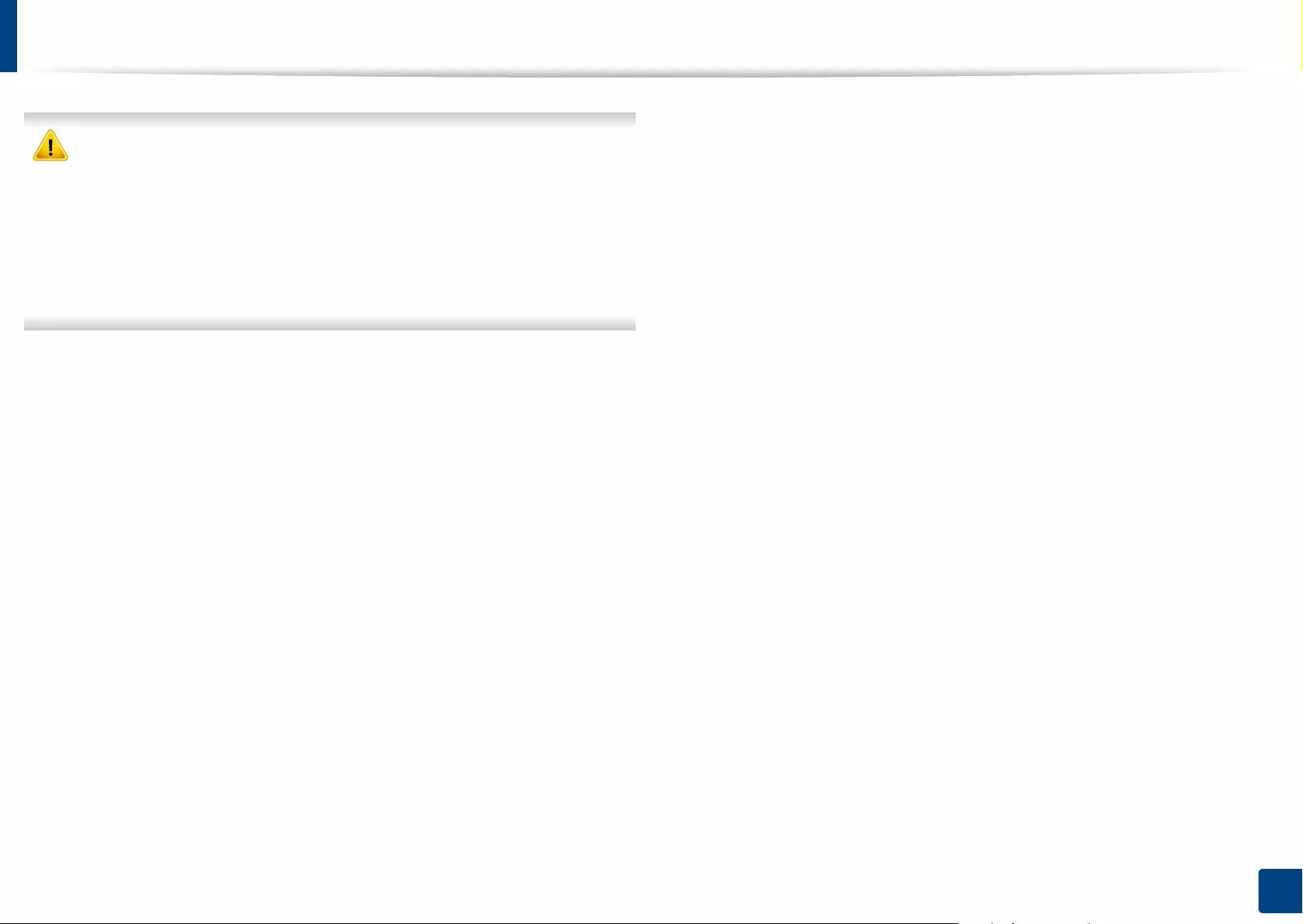
335
14. Maintenance
Tips for moving the machine
Use safe lifting and handling techniques. If you need to move this machine,
you need at least four people. Use the lifting handles, as shown below. If less
than four people attempt to lift the machine, it can lead to back injury.
• When moving the machine, do not subject the control panel to hard
impacts as this may damage the screen or border of the control panel.
• The warranty does not cover damage from falls or impacts due to the
intentional or unintentional actions of the user.
• Do not tilt or turn it upside down. Otherwise, the inside of the machine may
be contaminated by toner, which can cause damage to the machine or bad
print quality.
• Make sure at least four people are holding the machine securely.
• Lock the scanner lock.
•Moving long distances using a truck:
-Remove the finisher, optional trays, or desk and inner imaging unit and
toner cartridges.
-Fasten the scanner locking screw and the finisher locking screws.
-Tape trays and RADF cover.
•Moving short distances (e.g. moving between floors) to prevent
damage from vibration:
- Remove the finisher.
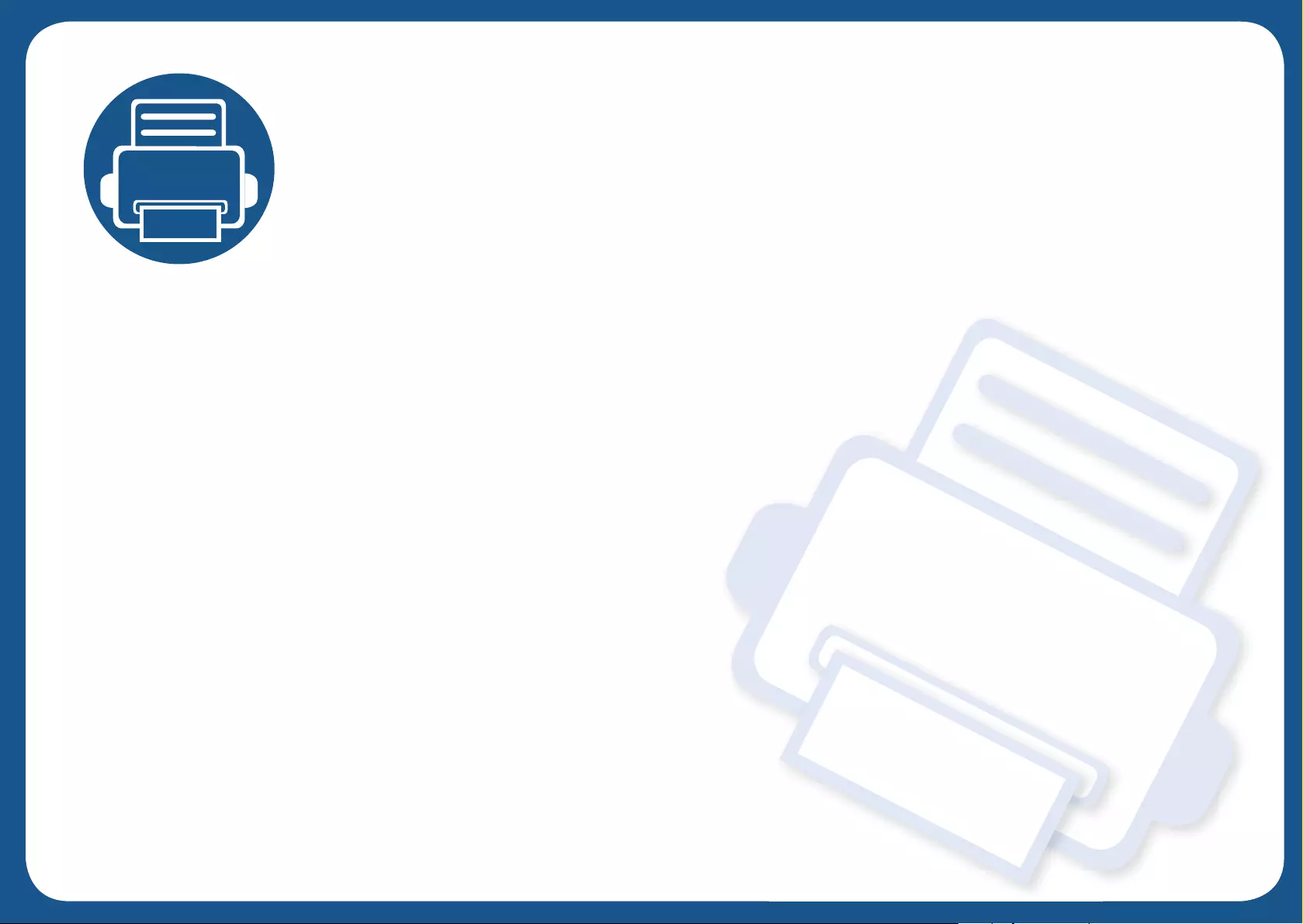
15.Troubleshooting
This chapter gives helpful information for what to do if you encounter an error. If you cannot find a solution in the
User's Guide or the problem persists, call for service.
This chapter includes:
• Tips for avoiding paper jams 337
• Clearing paper jams 338
• Understanding display messages 367
• Paper feeding problems 378
• Power and cable connecting problems 379
• Solving other problems 380
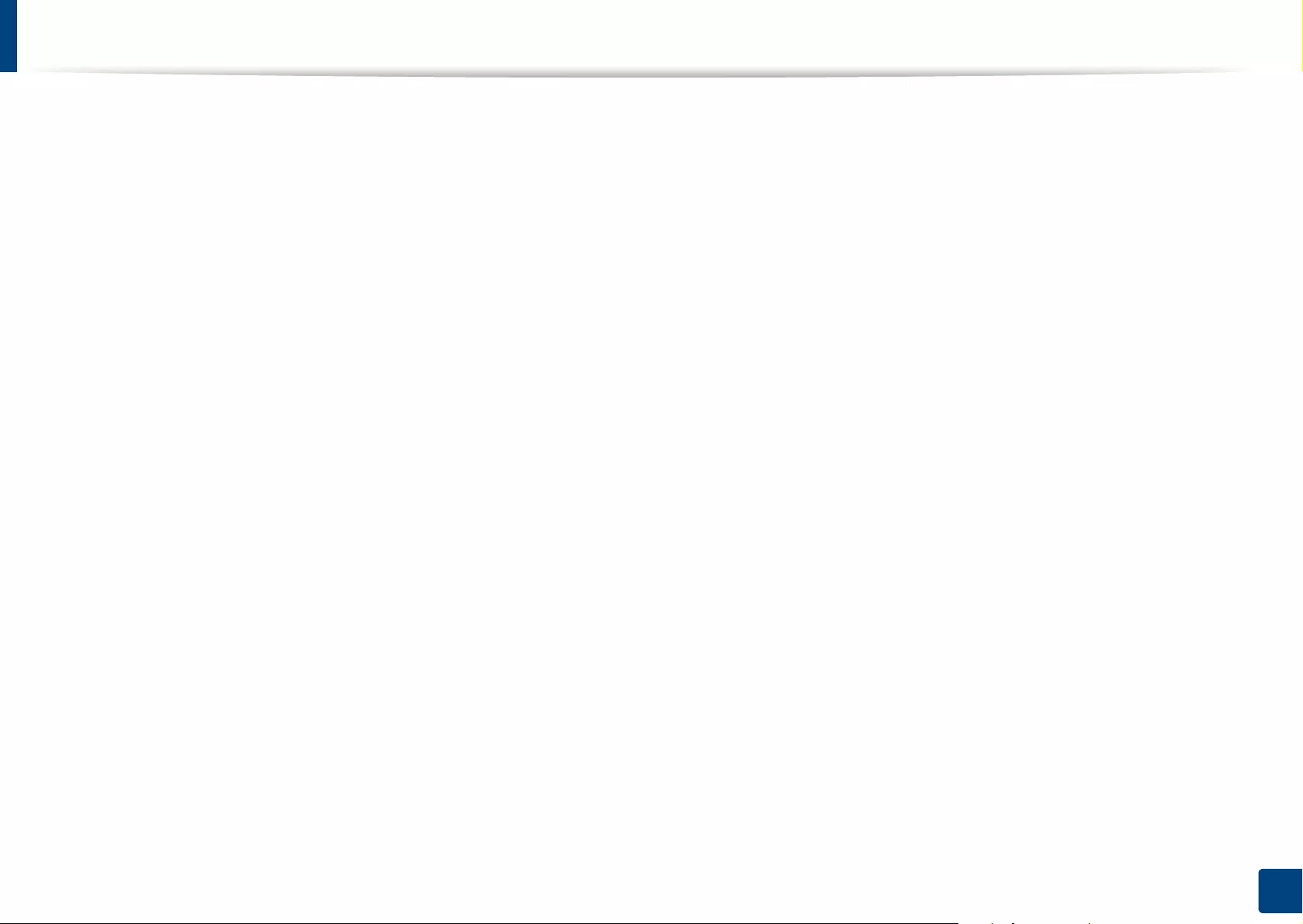
337
15. Troubleshooting
Tips for avoiding paper jams
By selecting the correct medias, most paper jams can be avoided. To avoid paper jams, refer to the following guidelines:
• Ensure that the adjustable guides are positioned correctly (see "Tray overview" on page 76).
• Do not remove paper from the tray while your machine is printing.
• Flex, fan, and straighten paper before loading.
• Do not use creased, damp, or highly curled paper.
• Do not mix paper type and size in a tray.
• Use only recommended print media (see "Print media specifications" on page 399).
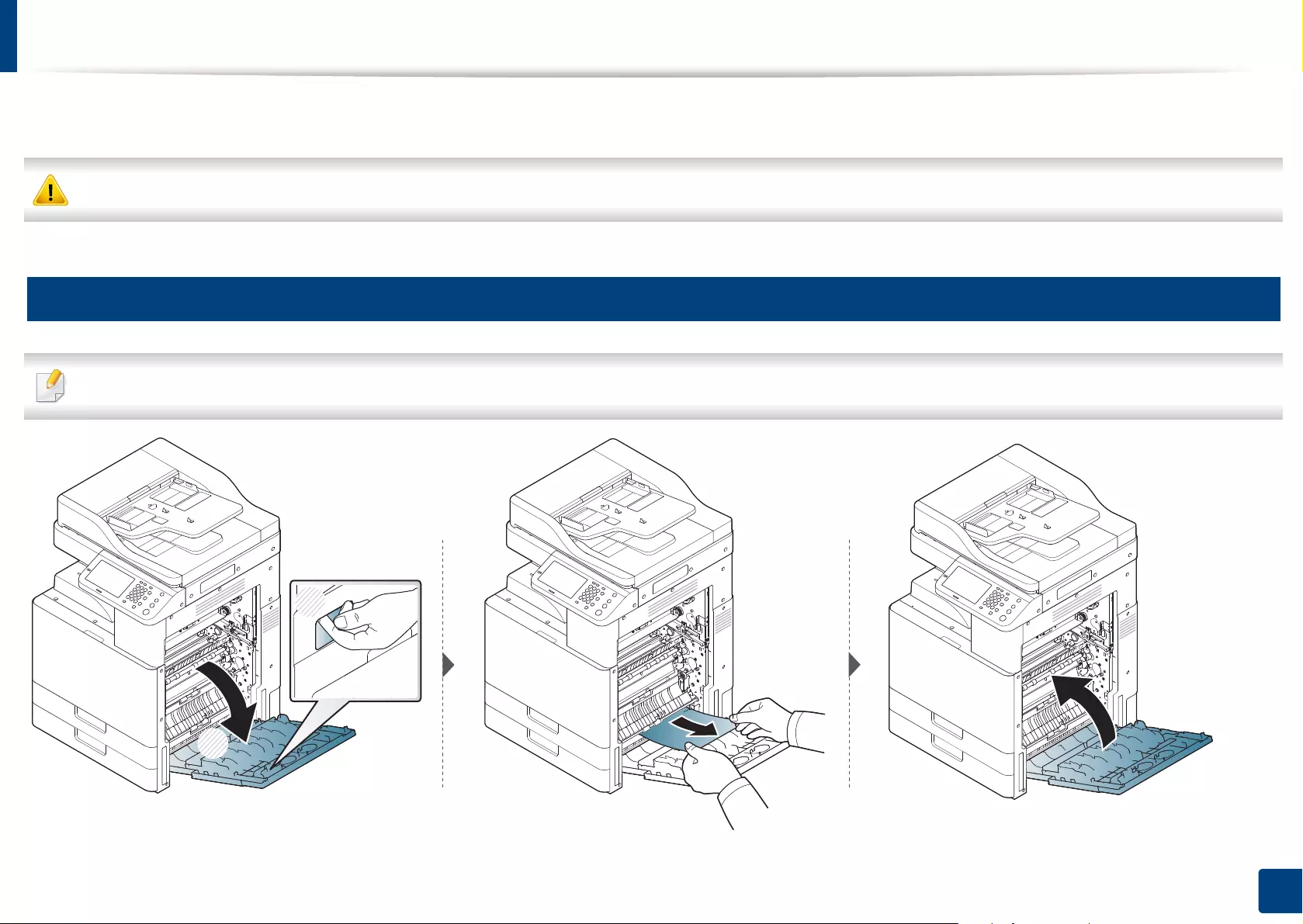
338
15. Troubleshooting
Clearing paper jams
When a paper jam occurs, a warning message appears on the display screen.
To avoid tearing the paper, pull the jammed paper out slowly and gently. Follow the instructions in the following sections to clear the jam.
1
In tray1, 2
Illustrations on this user’s guide may differ from your machine depending on its options or models. Check your machine type (see "Machine overview" on page 20).
1
2
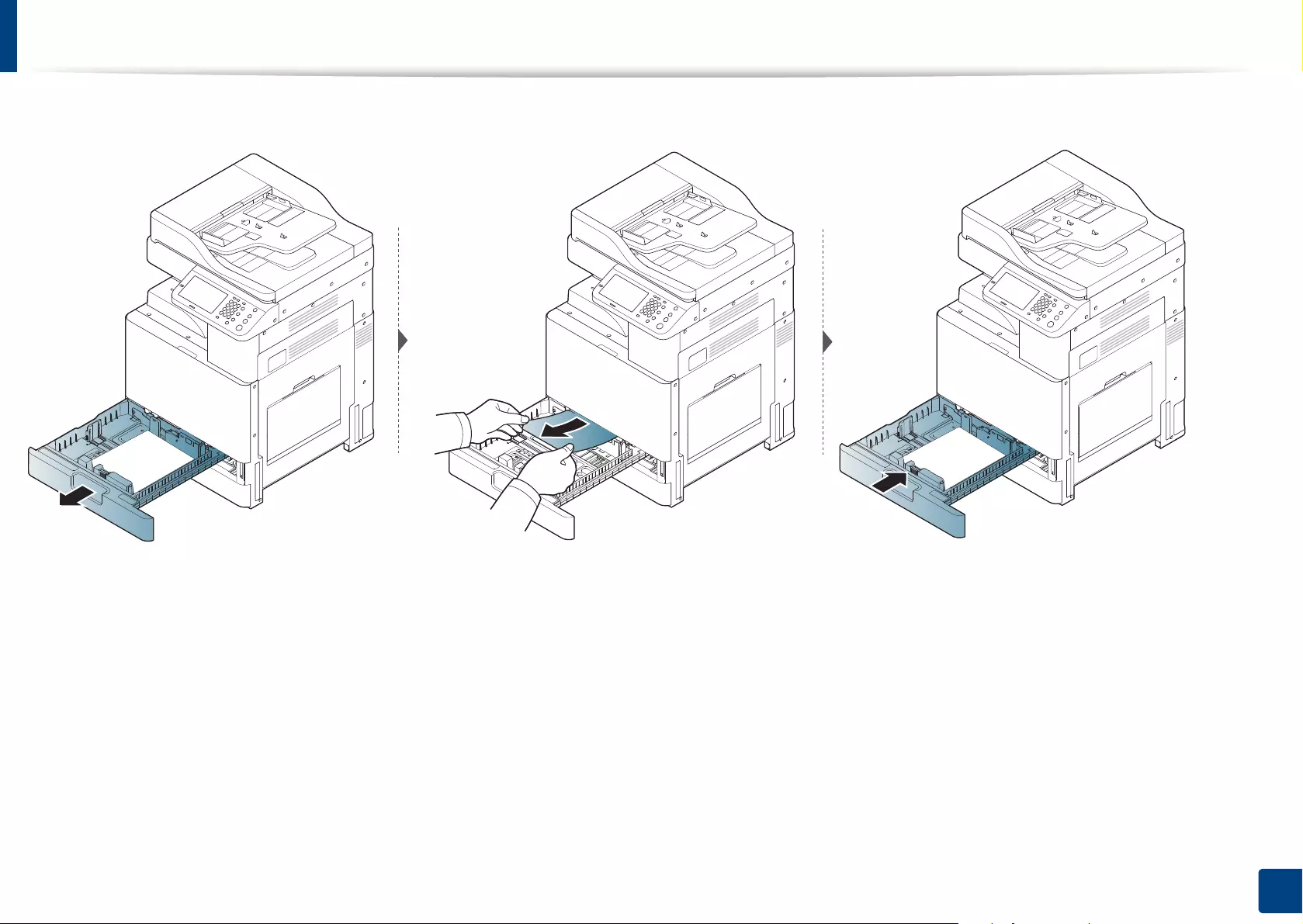
Clearing paper jams
339
15. Troubleshooting
If you do not see the paper in this area, stop and go to next step:
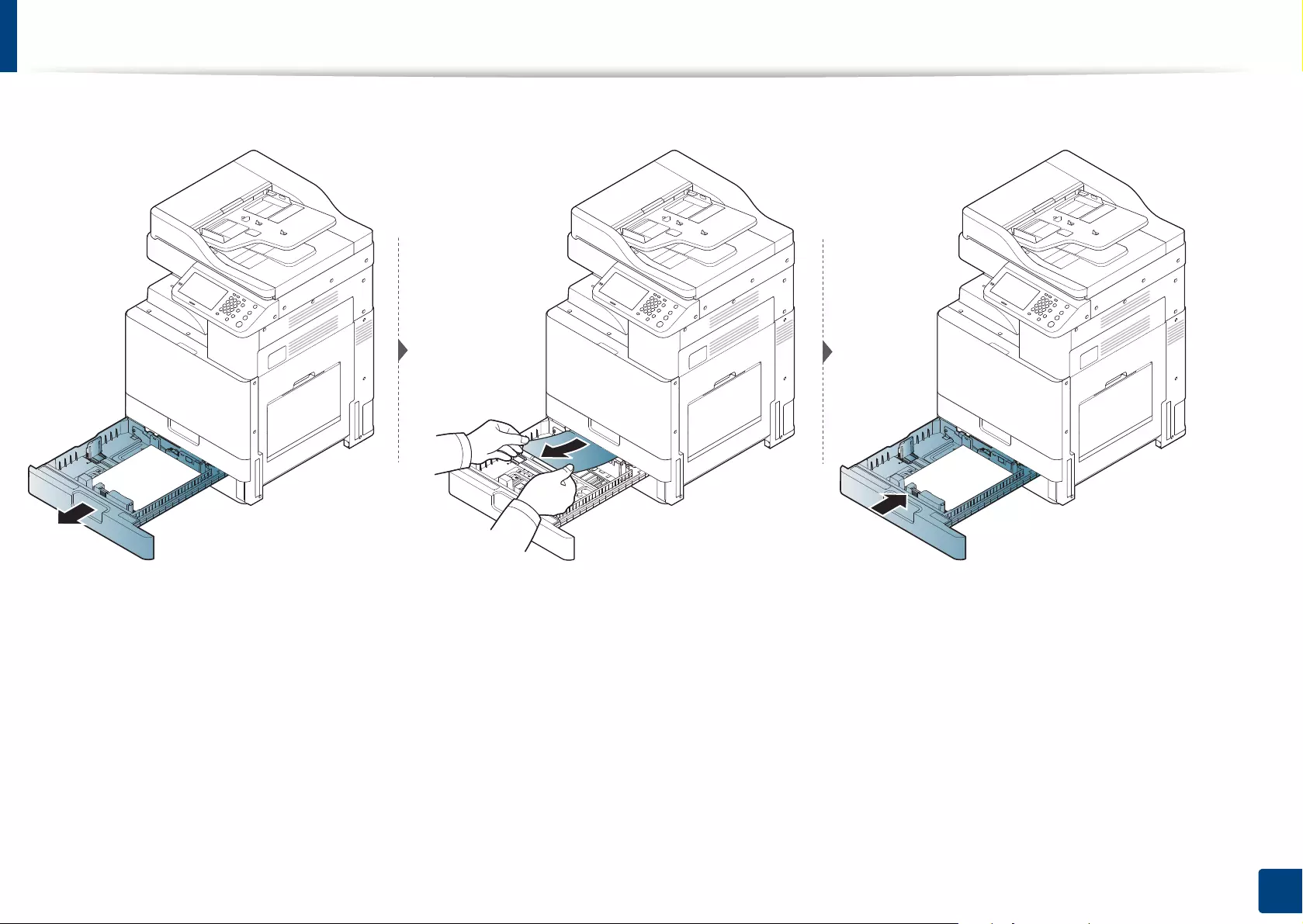
Clearing paper jams
340
15. Troubleshooting
If you do not see the paper in this area, stop and go to next step:
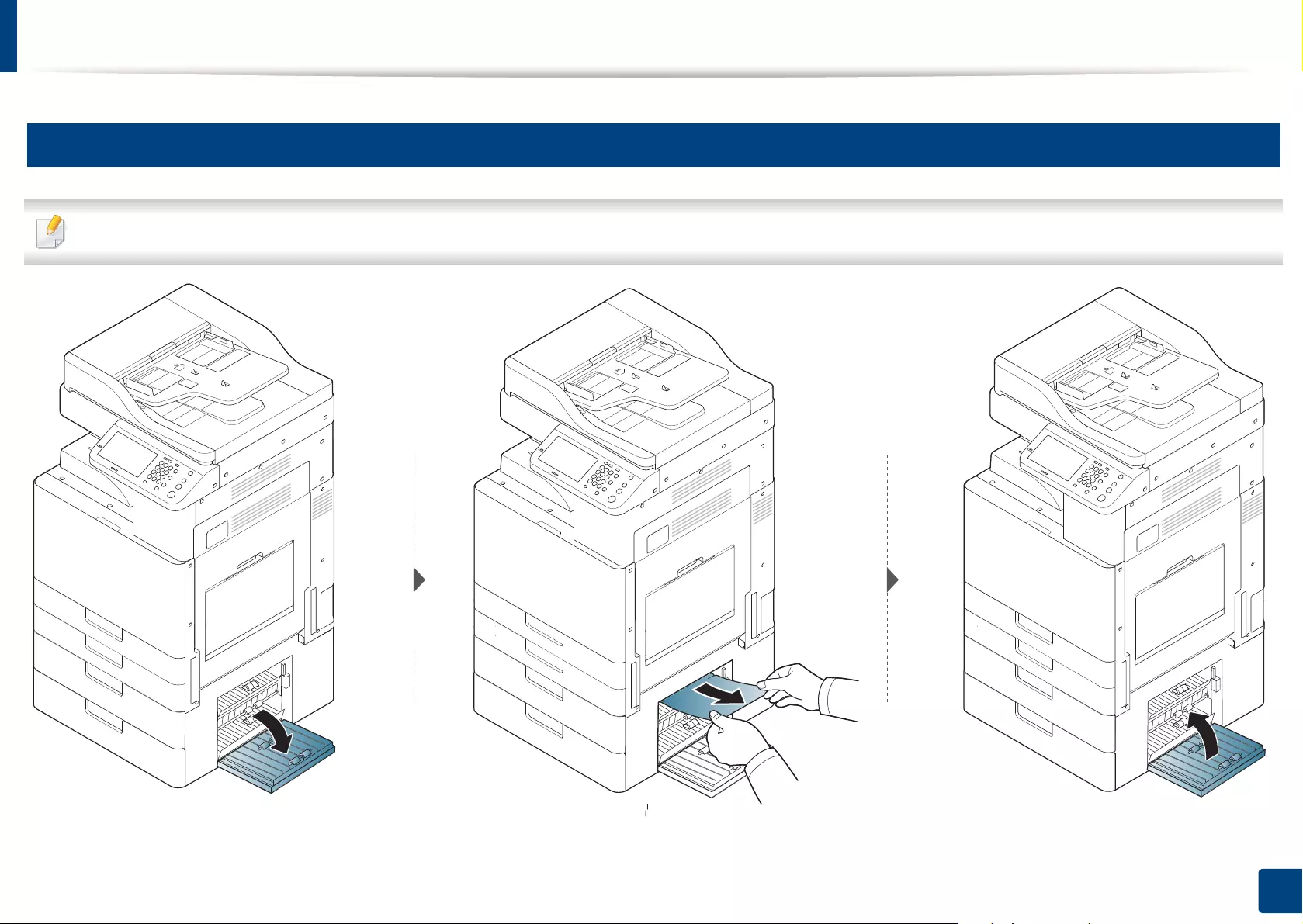
Clearing paper jams
341
15. Troubleshooting
2
In optional trays
The procedure is same for all optional trays.
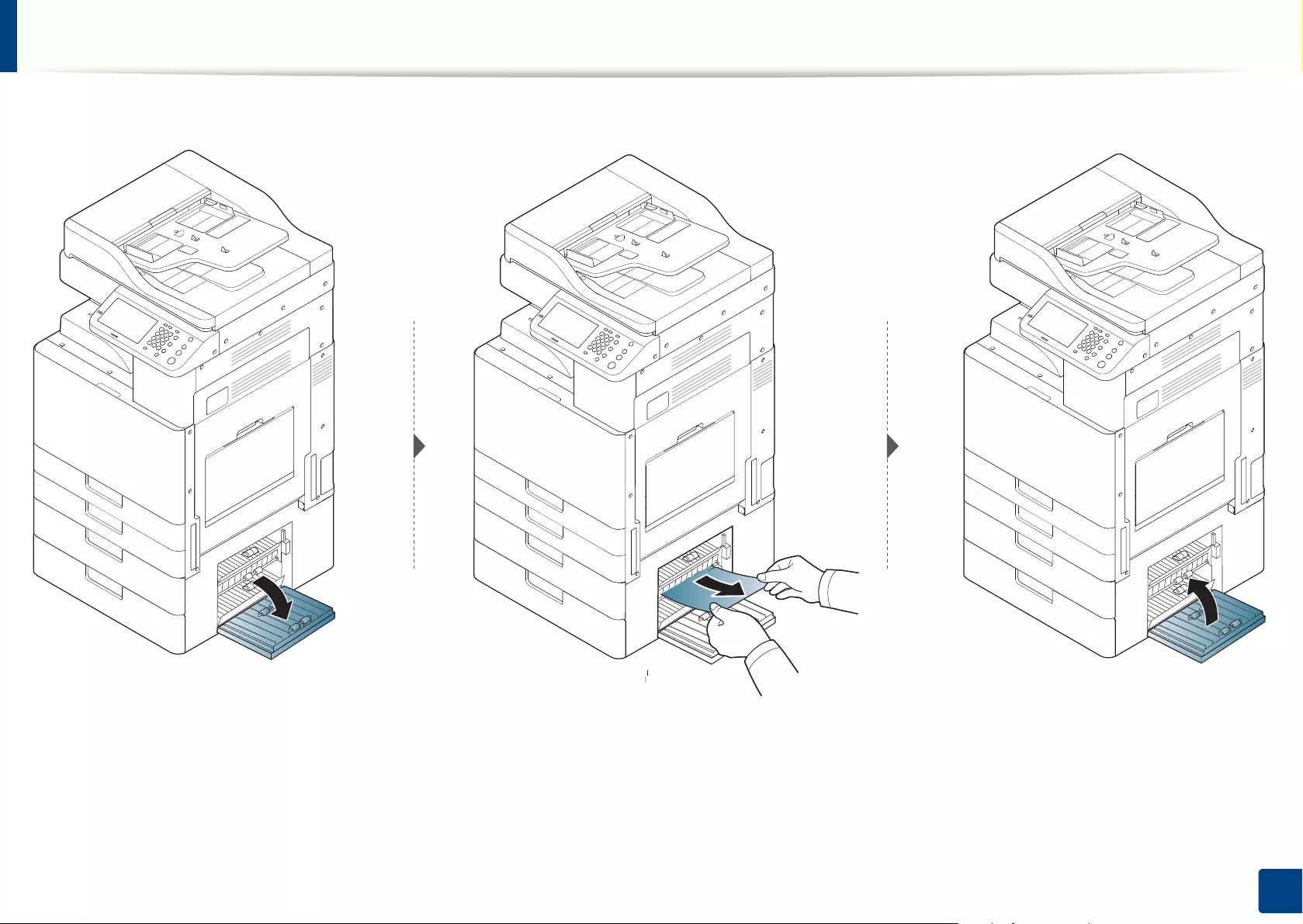
Clearing paper jams
342
15. Troubleshooting
If you do not see the paper in this area, stop and go to next step:
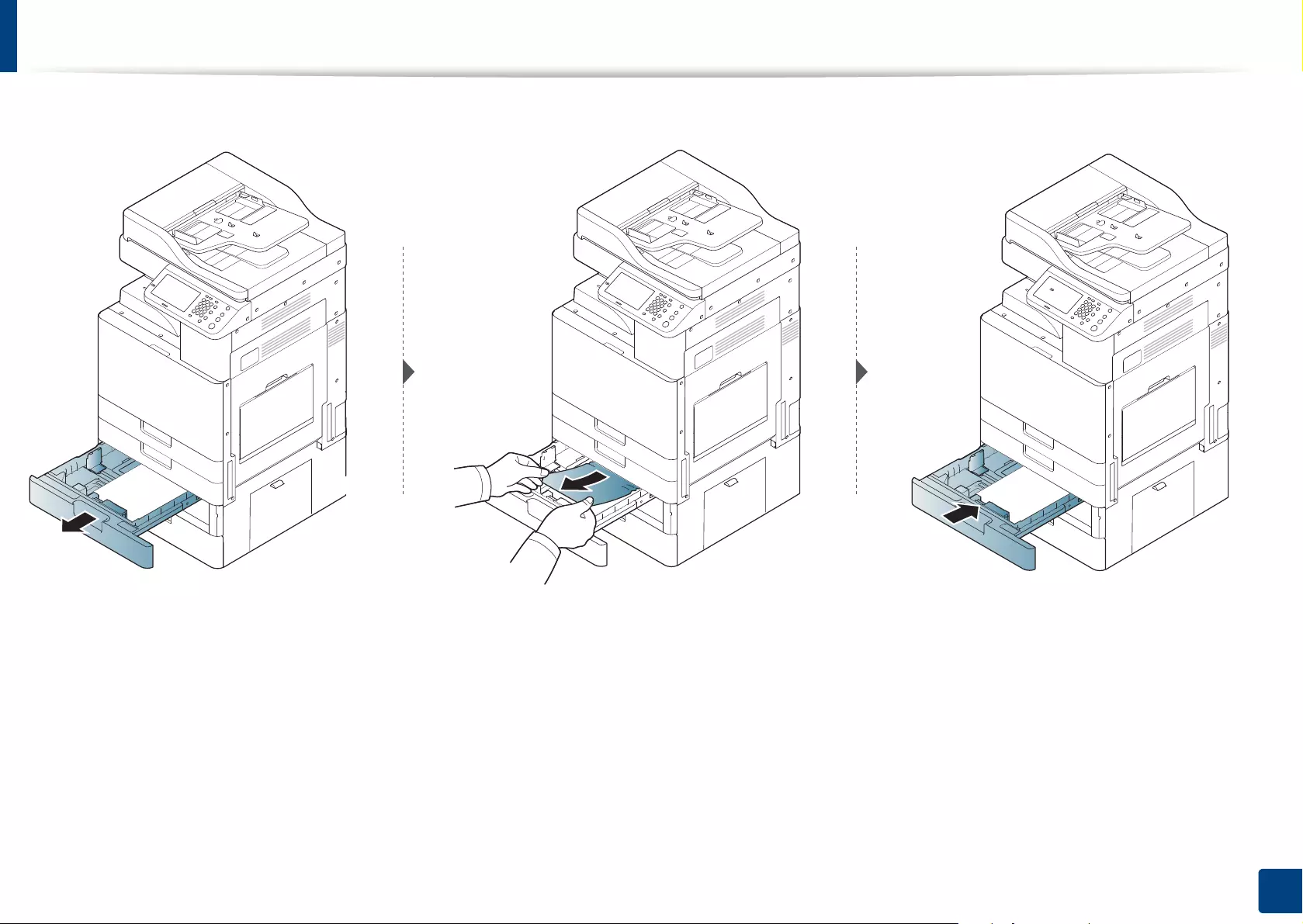
Clearing paper jams
343
15. Troubleshooting
If you do not see the paper in this area, stop and go to next step:
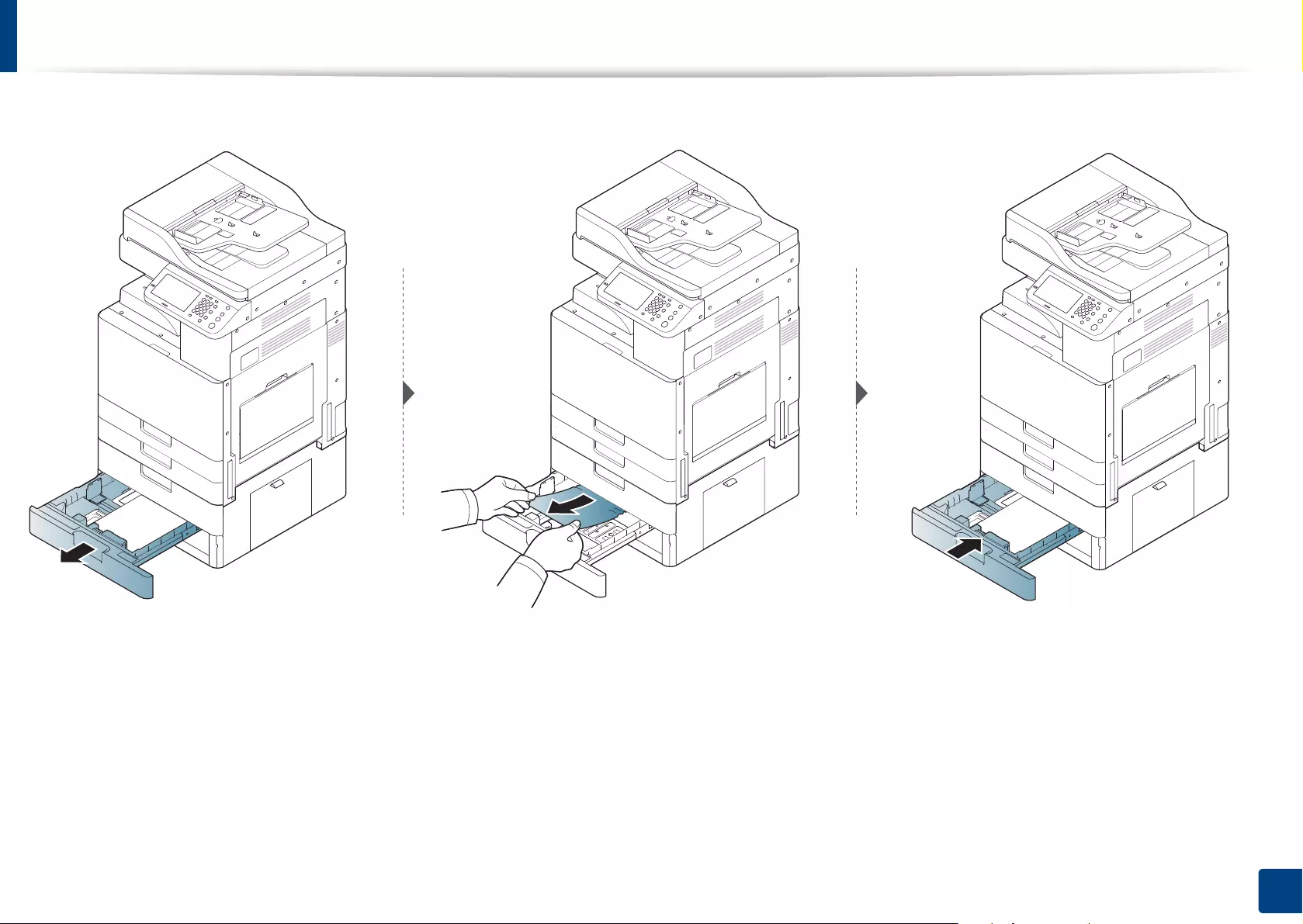
Clearing paper jams
344
15. Troubleshooting
If you do not see the paper in this area, stop and go to next step:
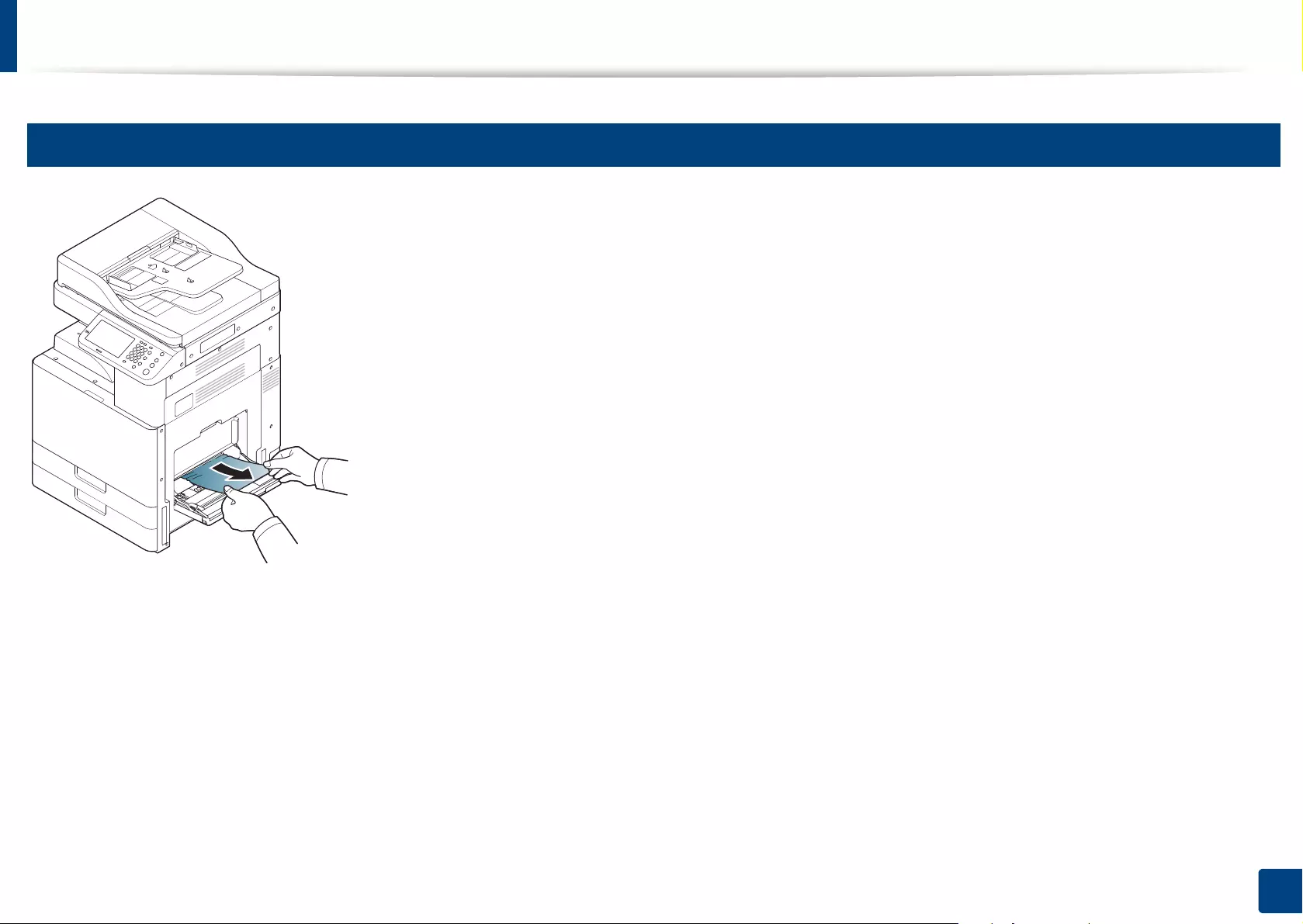
Clearing paper jams
345
15. Troubleshooting
3
In the multi-purpose tray
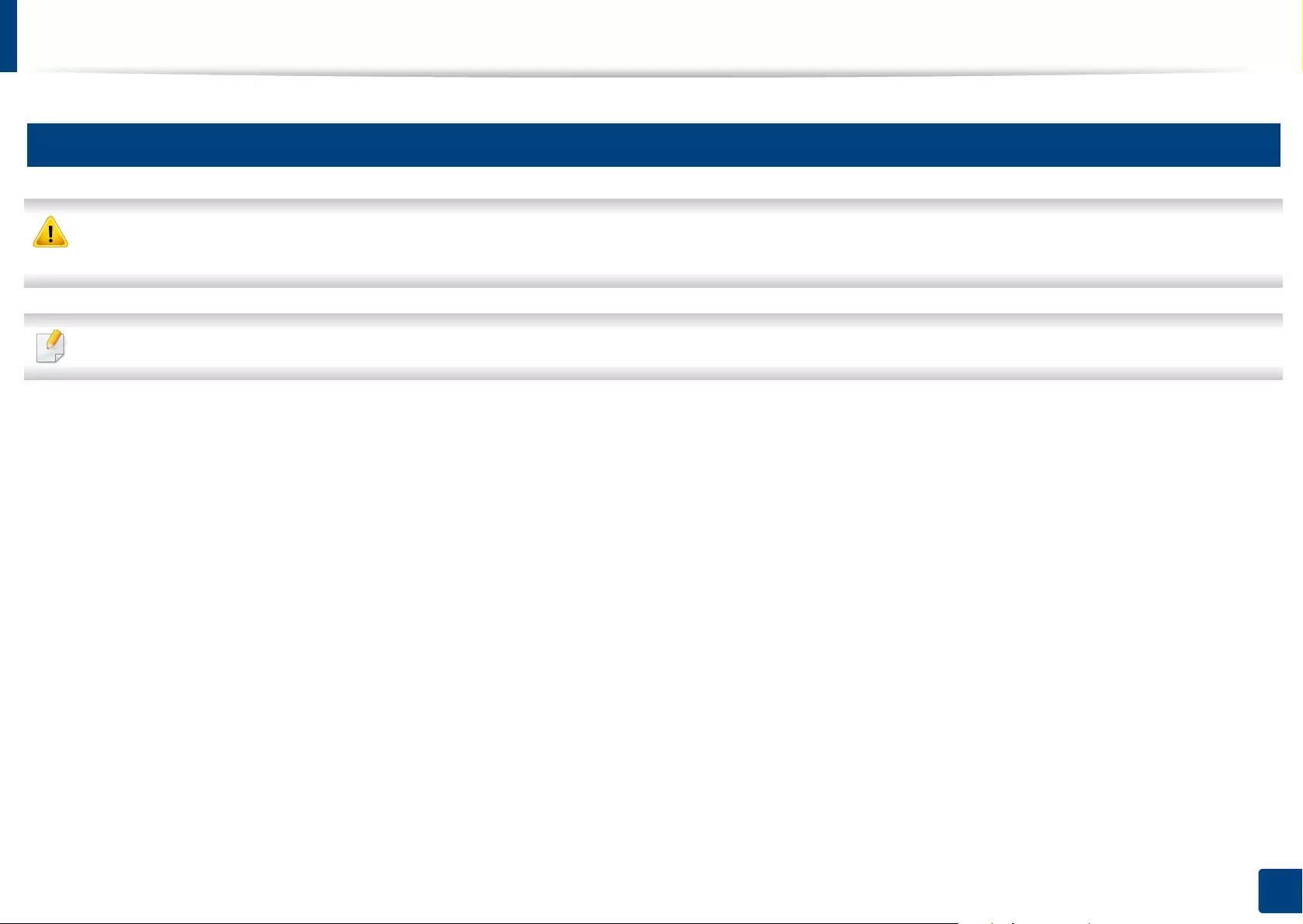
Clearing paper jams
346
15. Troubleshooting
4
Inside the machine
The fuser area is hot. Turn the machine off and let the machine cool before removing paper from the Fuser Unit area. Failure to take care when removing paper from
this area may cause injury.
Illustrations on this user’s guide may differ from your machine depending on its options or models. Check your machine type (see "Machine overview" on page 20).
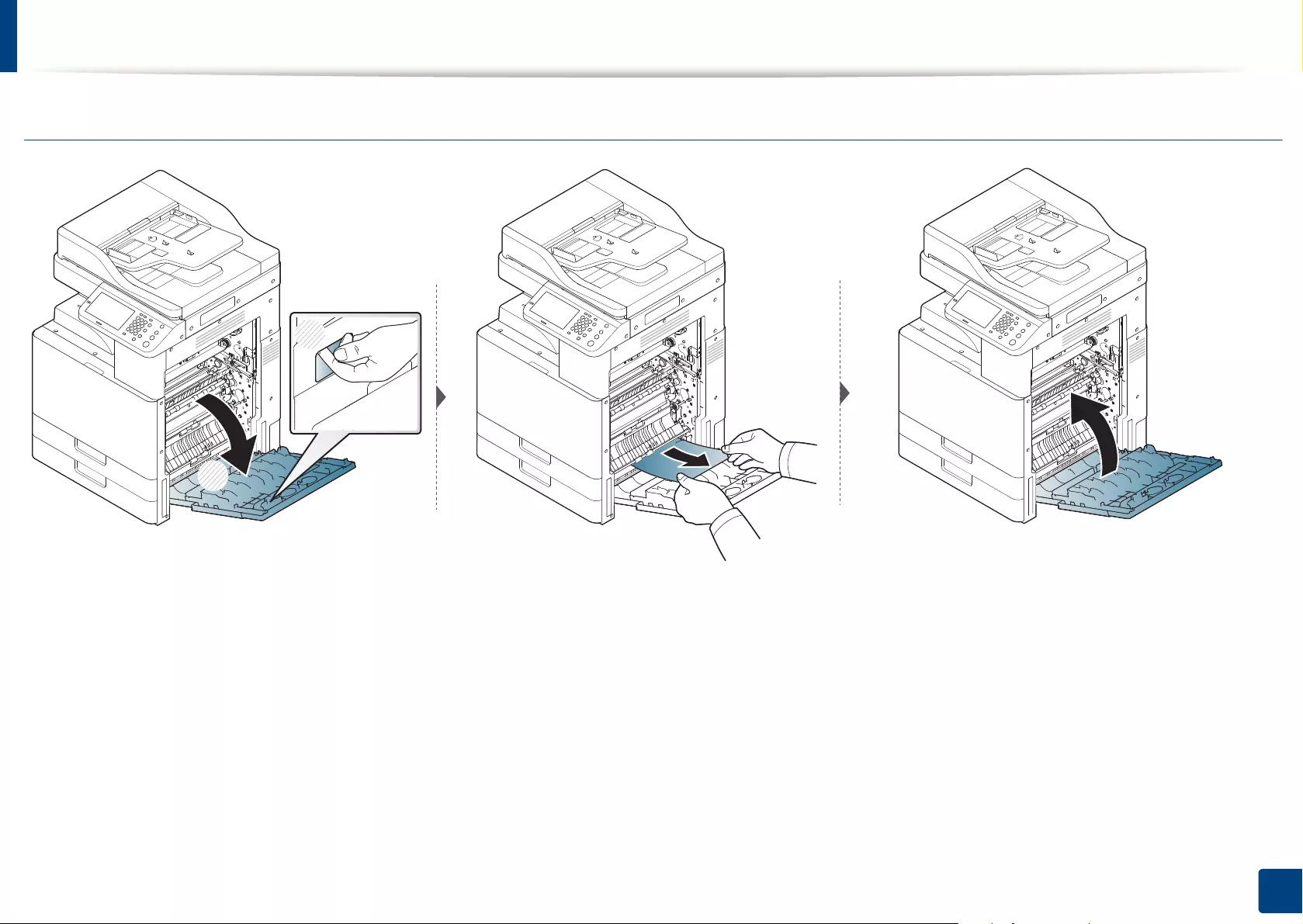
Clearing paper jams
347
15. Troubleshooting
Jam feed 1, Jam feed 2
1
2
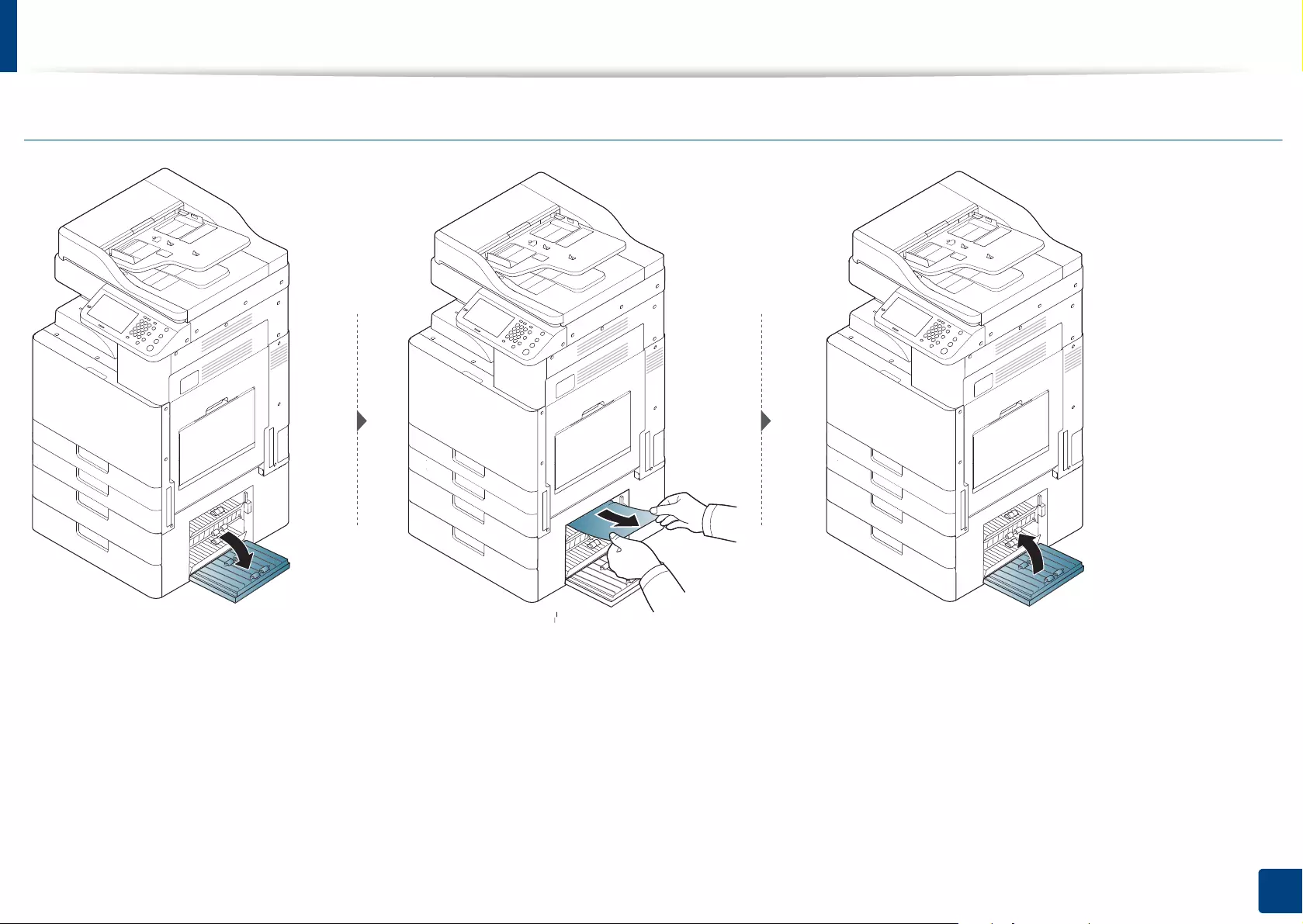
Clearing paper jams
348
15. Troubleshooting
Jam feed 3, Jam feed 4 (Optional device only)
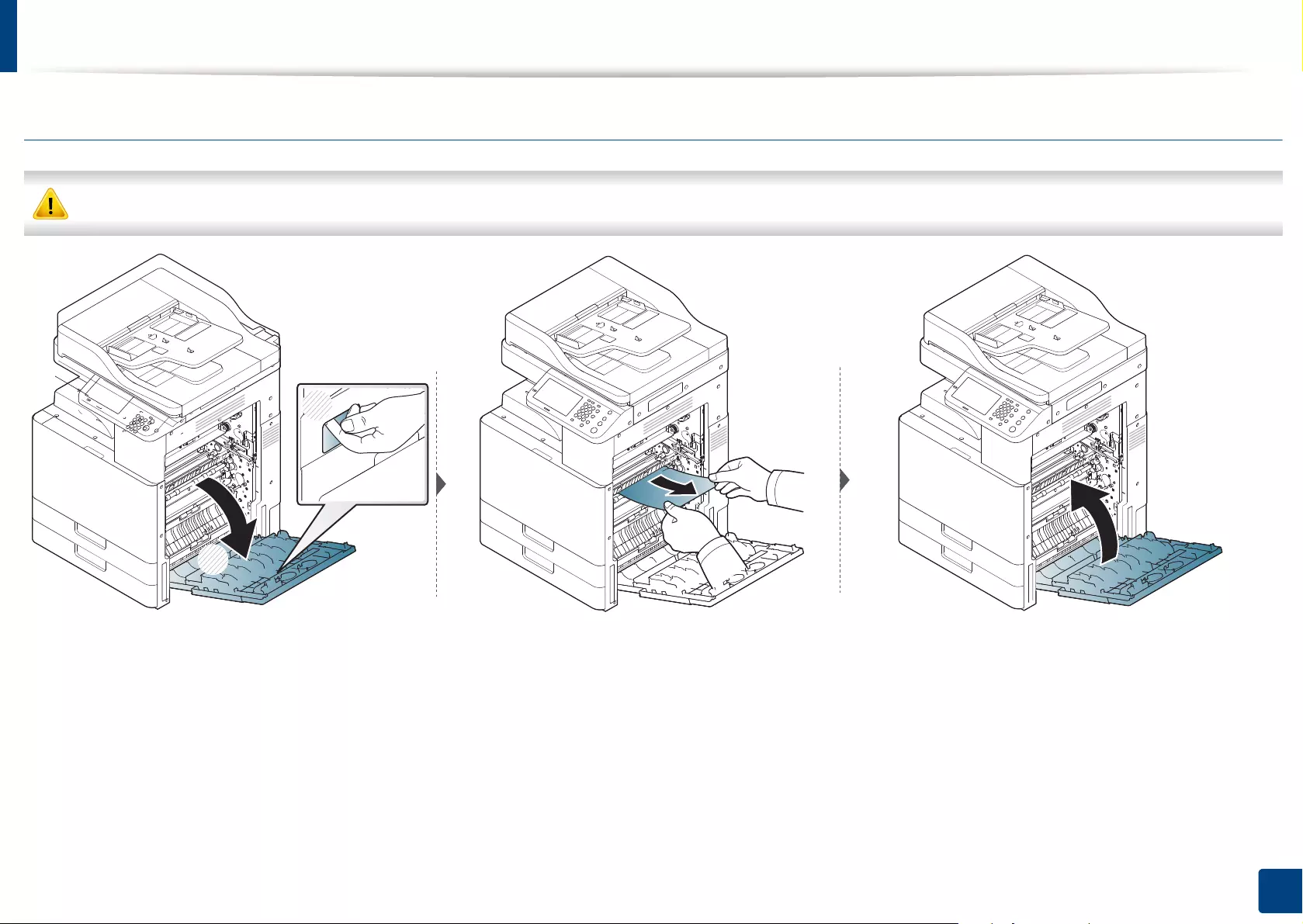
Clearing paper jams
349
15. Troubleshooting
Jam at the fuser area
The fuser area is hot. Take care when removing paper from the machine.
1
2
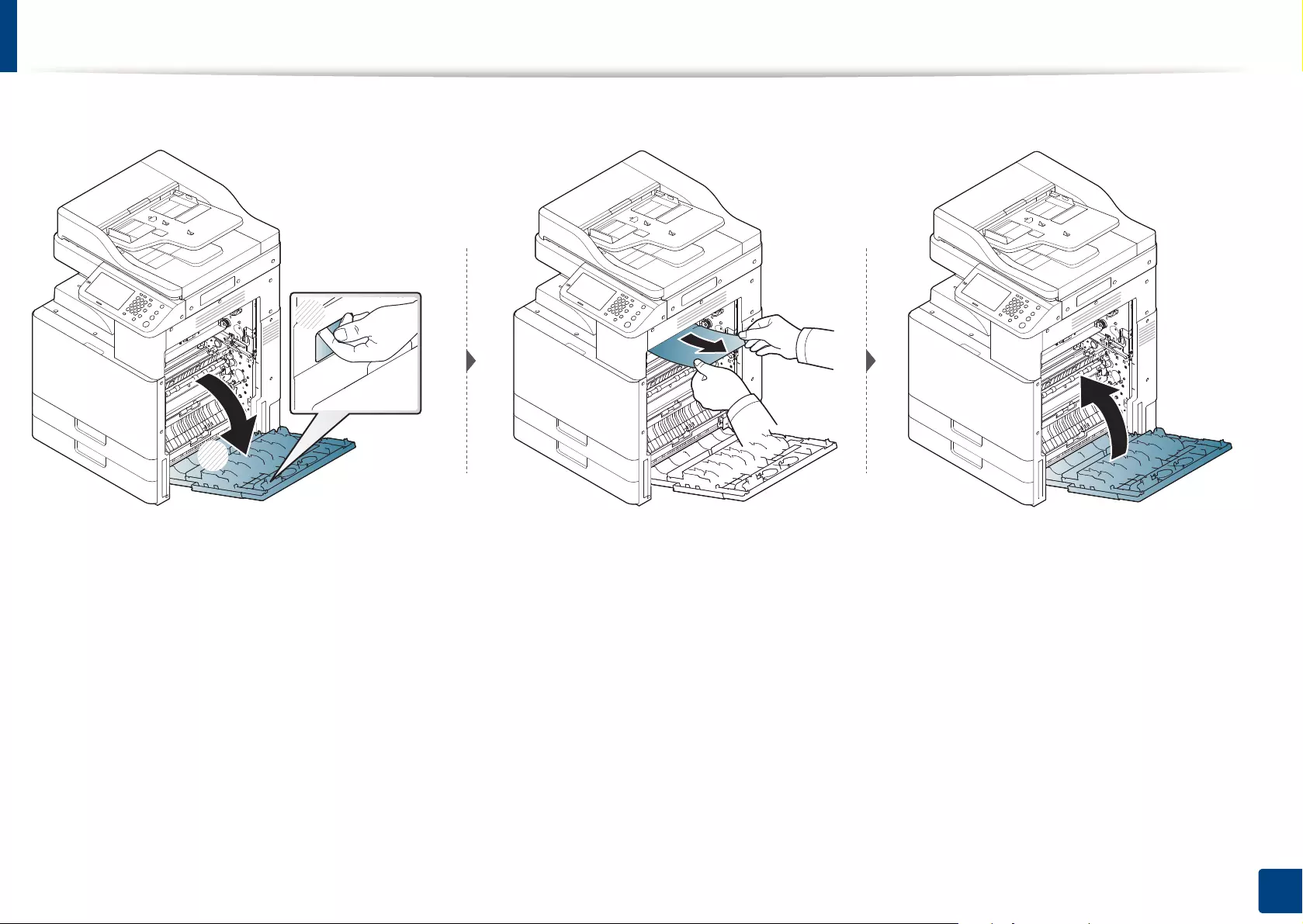
Clearing paper jams
350
15. Troubleshooting
If you do not see the paper in this area, stop and go to next step:
1
2
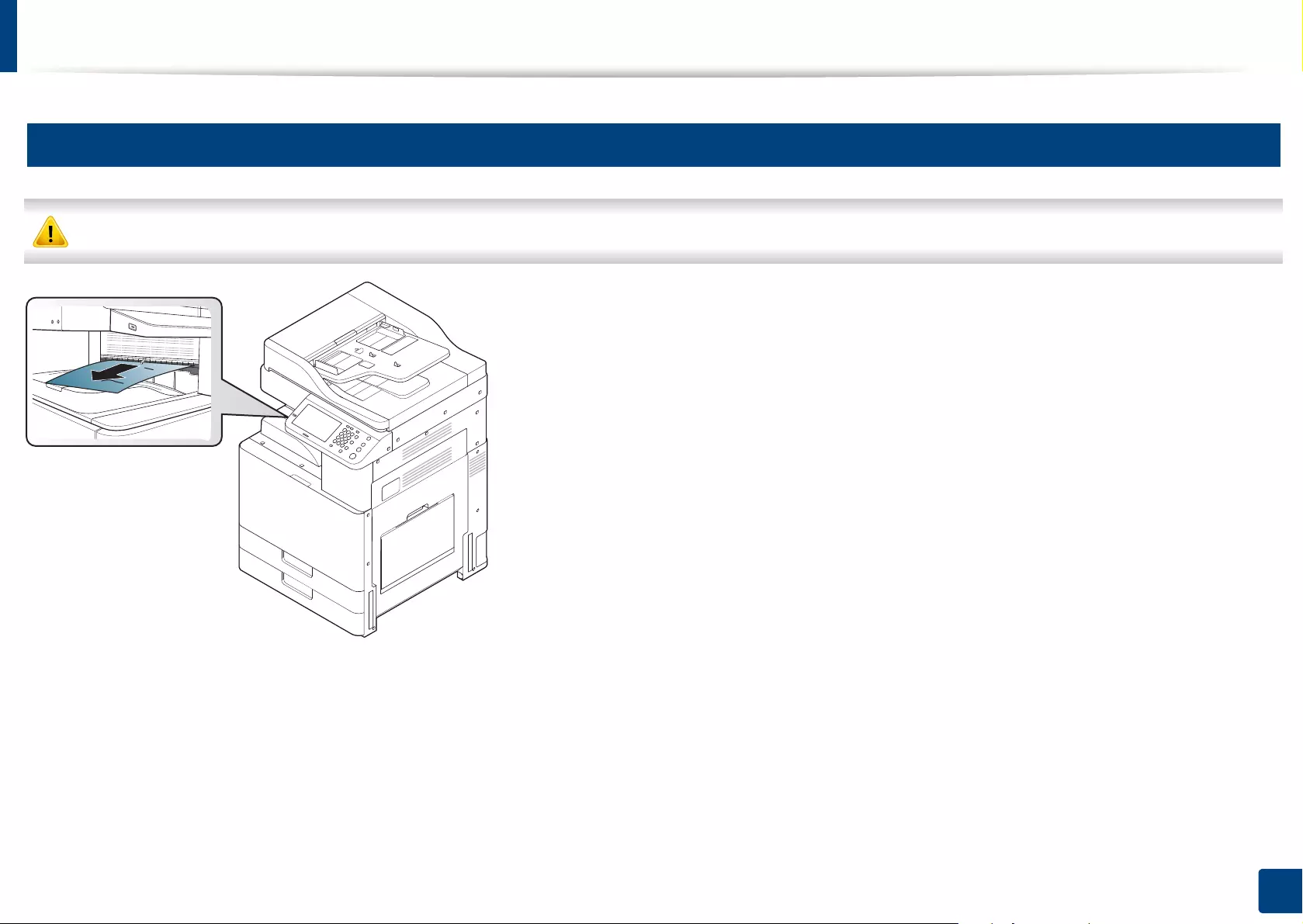
Clearing paper jams
351
15. Troubleshooting
5
In the exit area
The fuser area is hot. Take care when removing paper from the machine.
If you do not see the paper in this area, stop and go to next step:
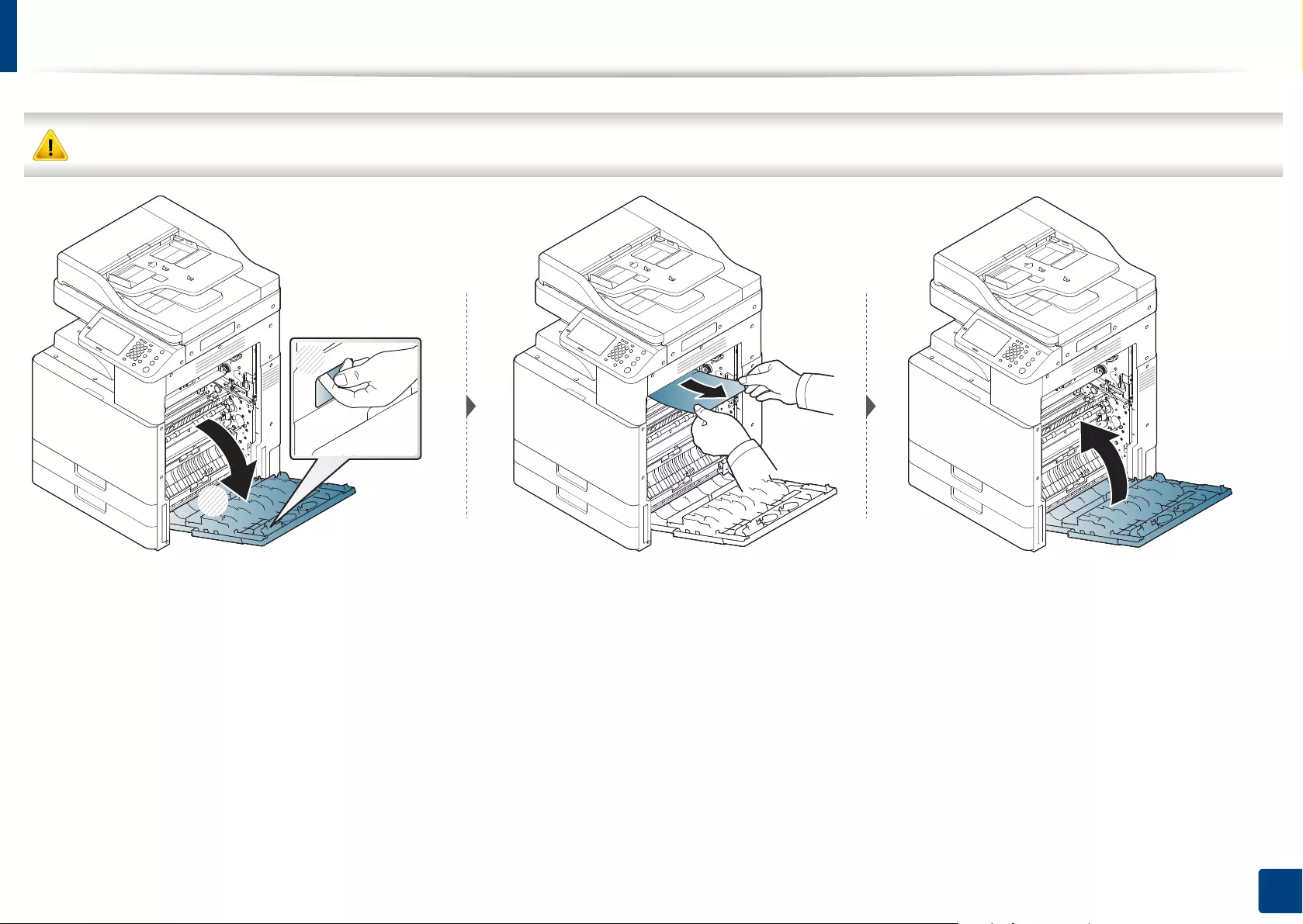
Clearing paper jams
352
15. Troubleshooting
The fuser area is hot. Take care when removing paper from the machine.
1
2
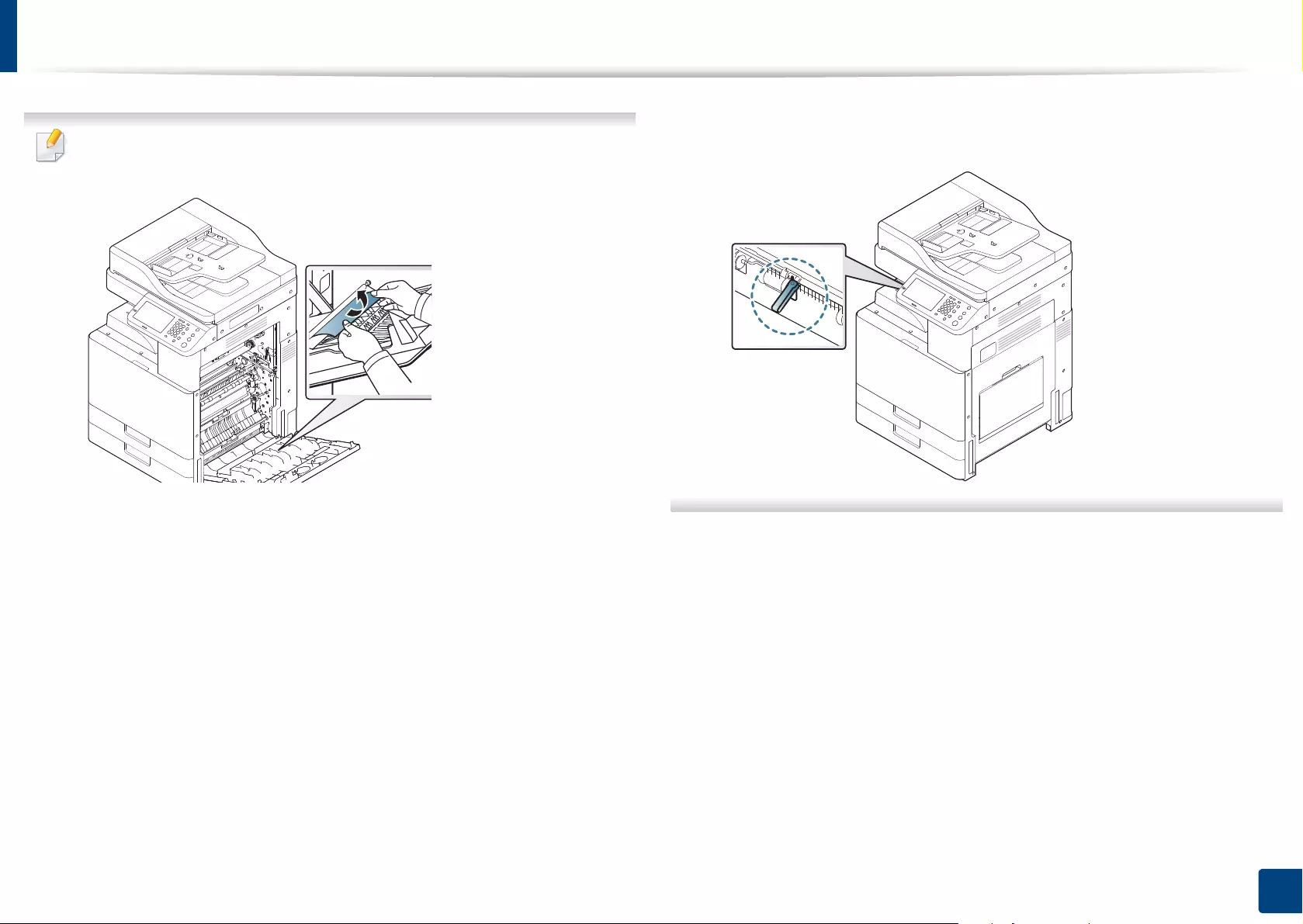
Clearing paper jams
353
15. Troubleshooting
If the optional Finisher is installed, remove the jammed paper as shown
below.
If this paper jam persists, make sure the bin full sensor is unfolded. The bin
full sensor is located in front of the output tray.
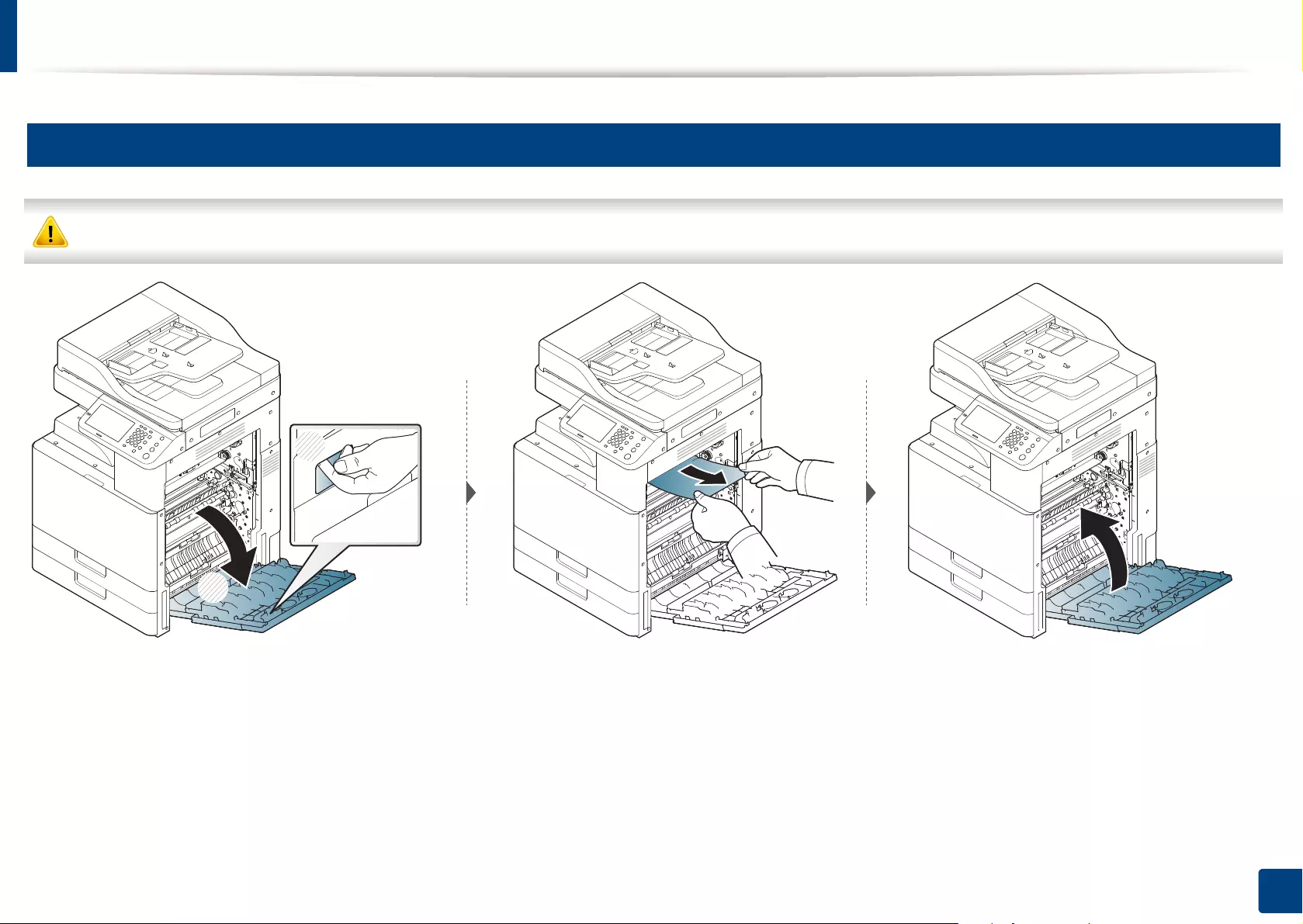
Clearing paper jams
354
15. Troubleshooting
6
In the duplex unit area
The fuser area is hot. Take care when removing paper from the machine.
1
2
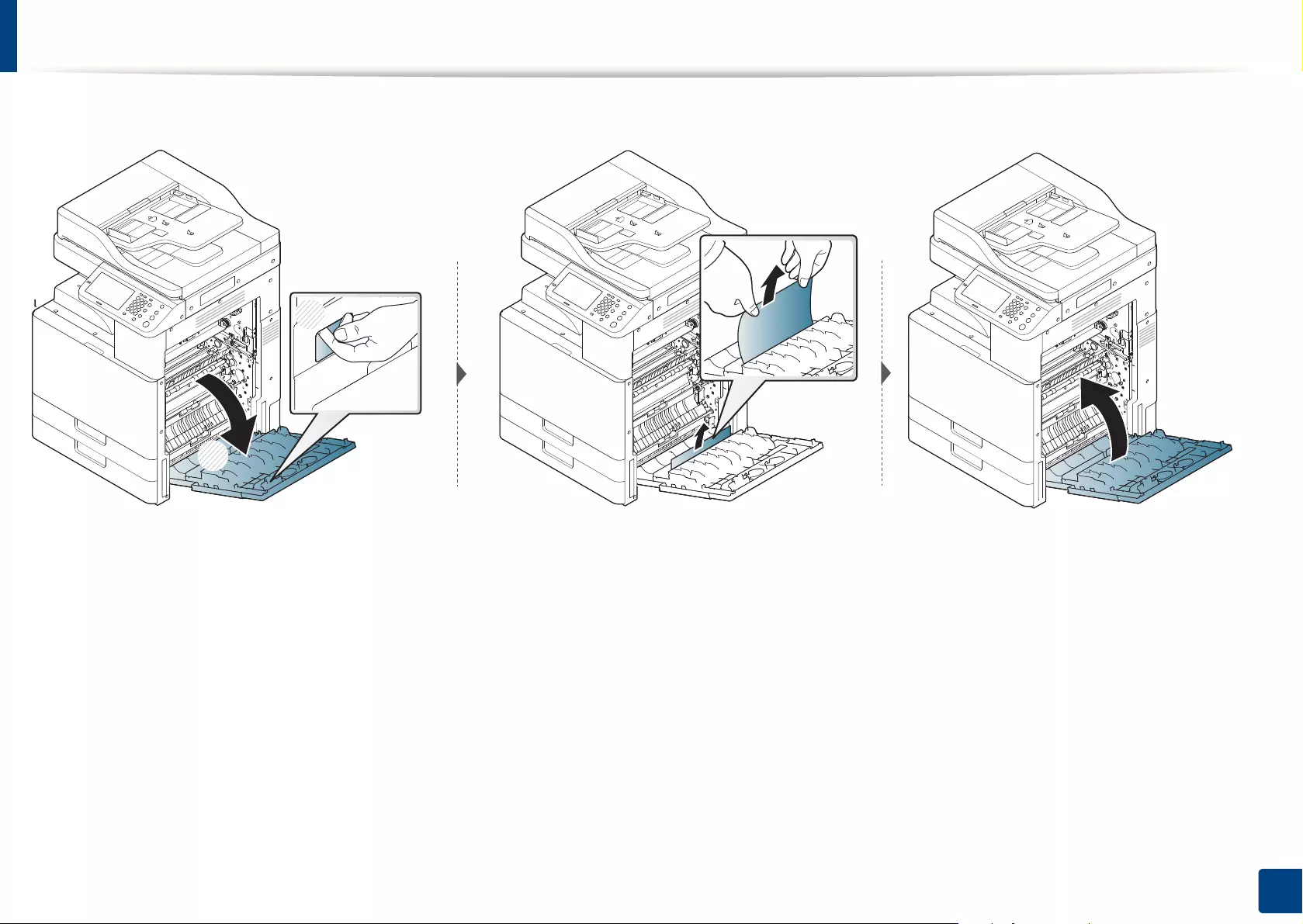
Clearing paper jams
355
15. Troubleshooting
If you do not see the paper in this area, stop and go to next step:
1
2
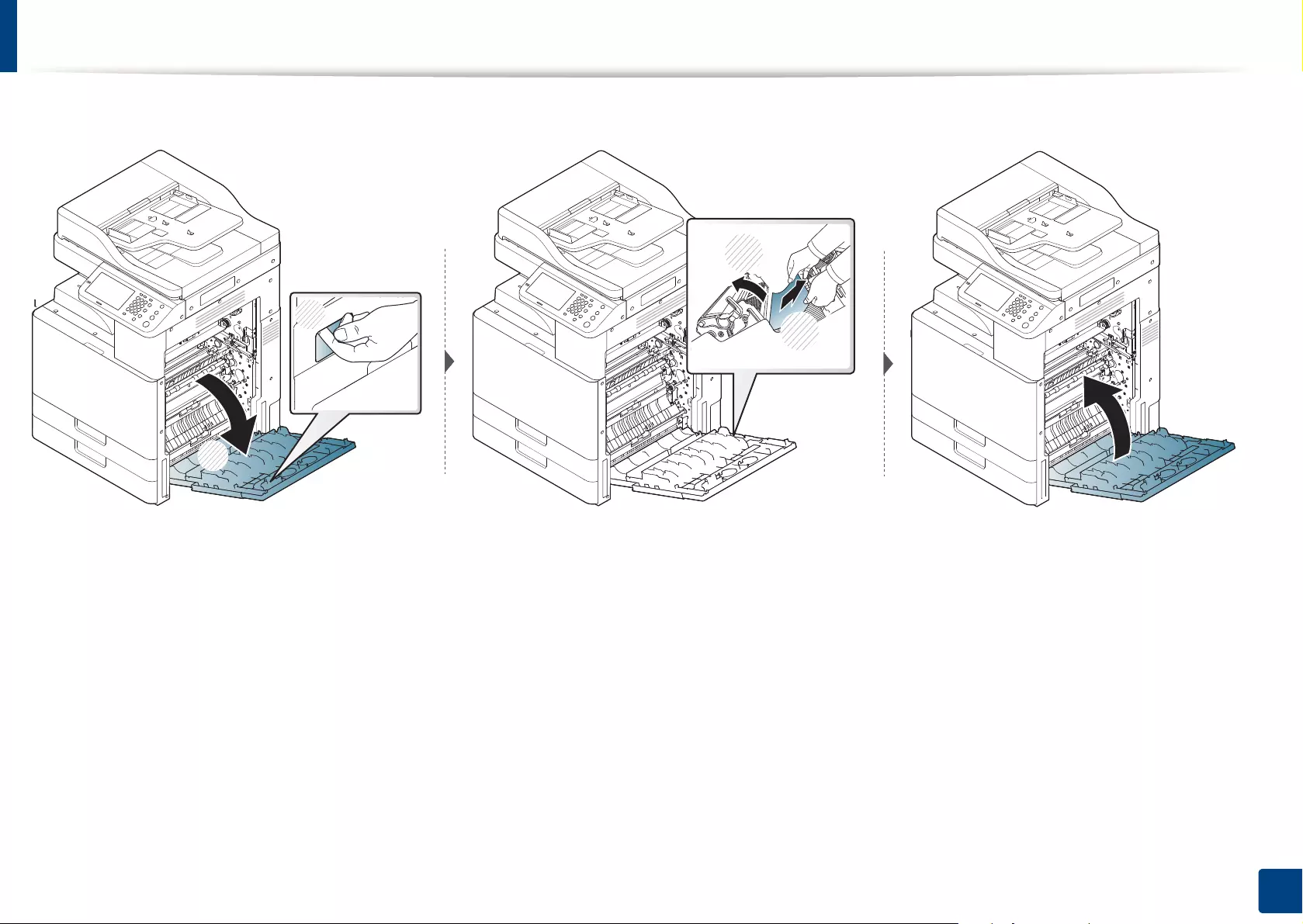
Clearing paper jams
356
15. Troubleshooting
If you do not see the paper in this area, stop and go to next step:
1
2
1
2
1
2
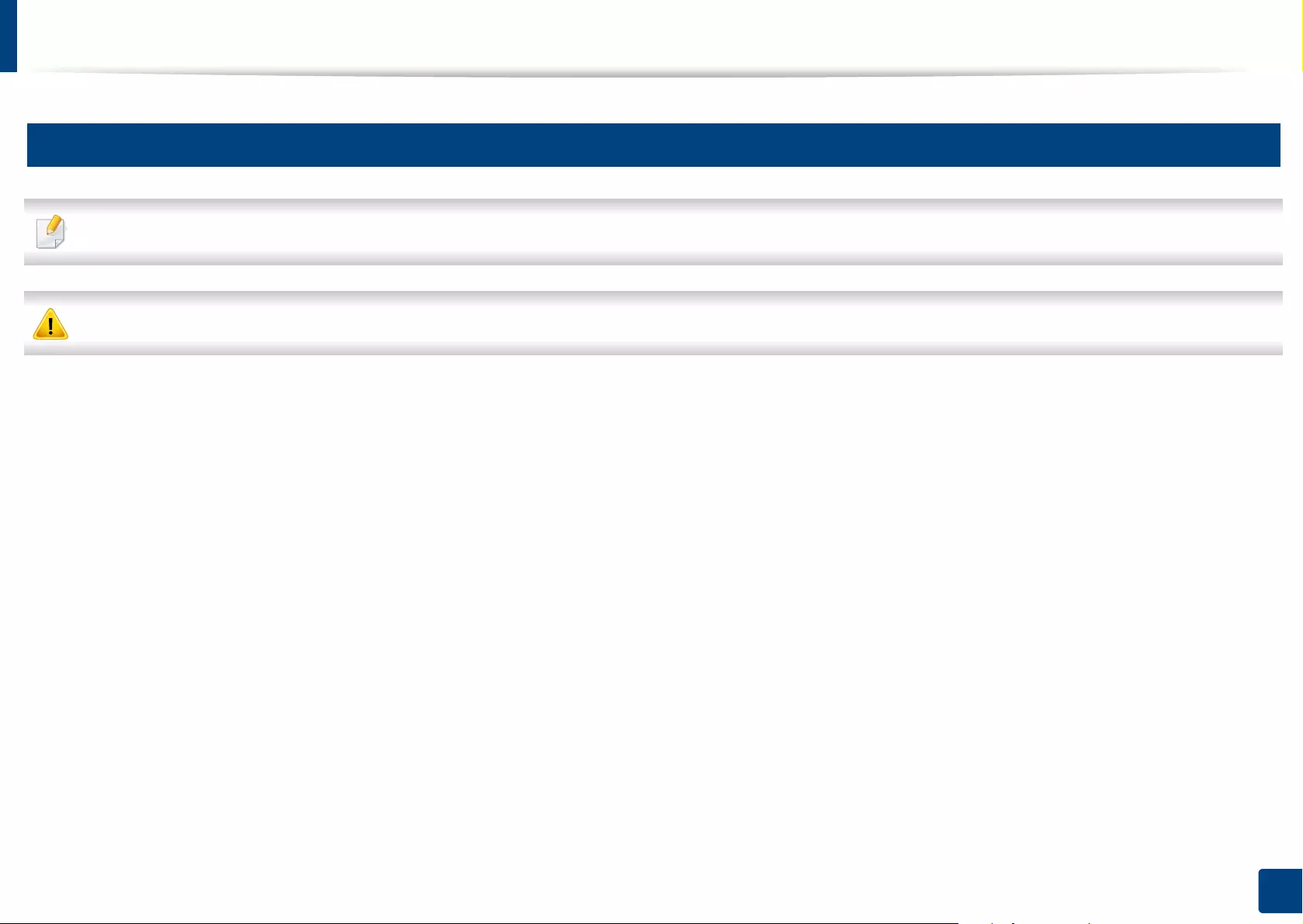
Clearing paper jams
357
15. Troubleshooting
7
Clearing original document jams
To prevent document jams, use the scanner glass for thick, thin or mixed paper originals.
To avoid tearing the document, remove the jammed document slowly and carefully.
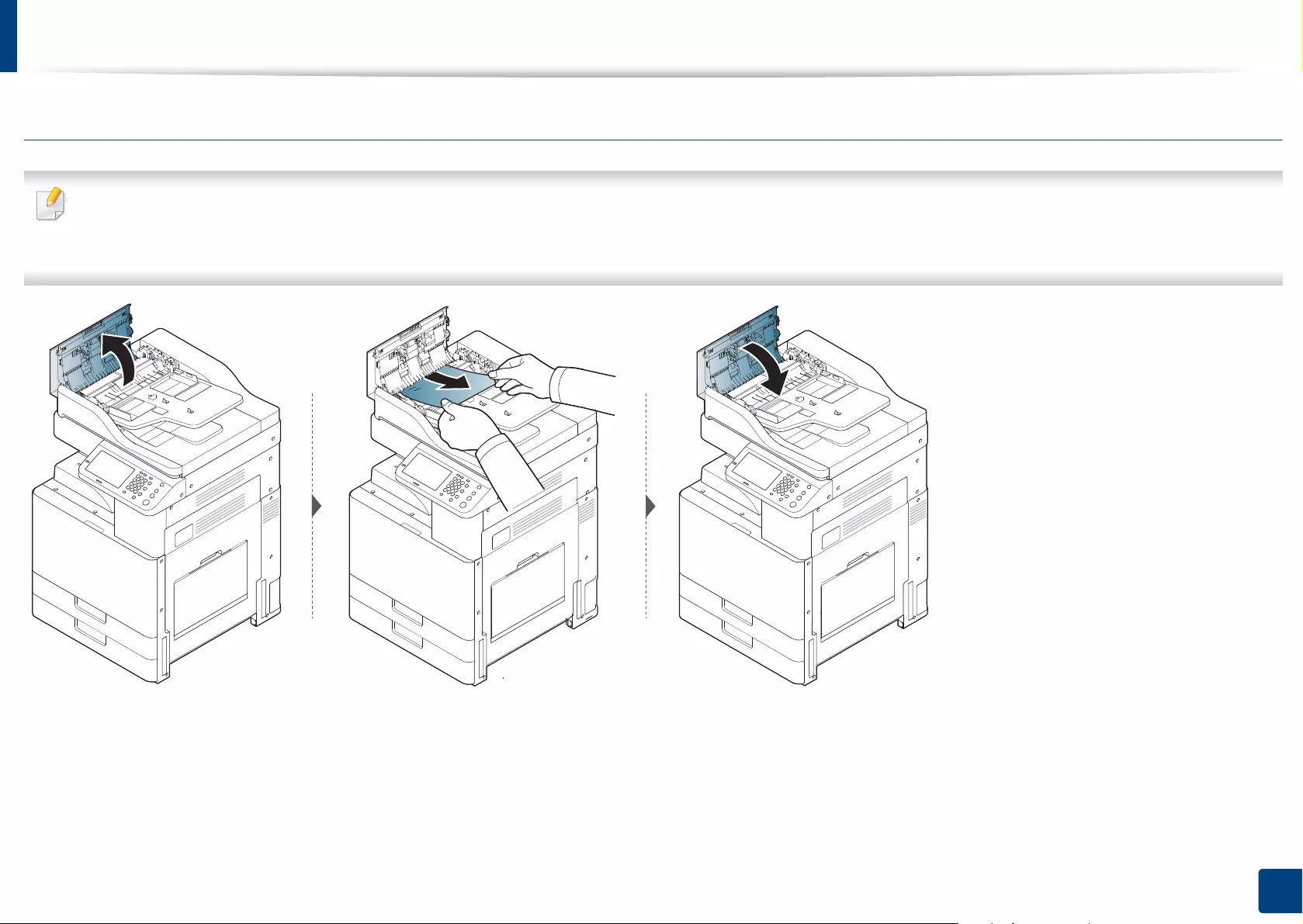
Clearing paper jams
358
15. Troubleshooting
Original paper jam in front of scanner
• Illustrations in this user’s guide may differ from your machine depending on the model and options installed. Check your machine type (see "Machine overview"
on page 20).
• This troubleshooting may not be available depending on model or optional goods (see "Variety feature" on page 11).
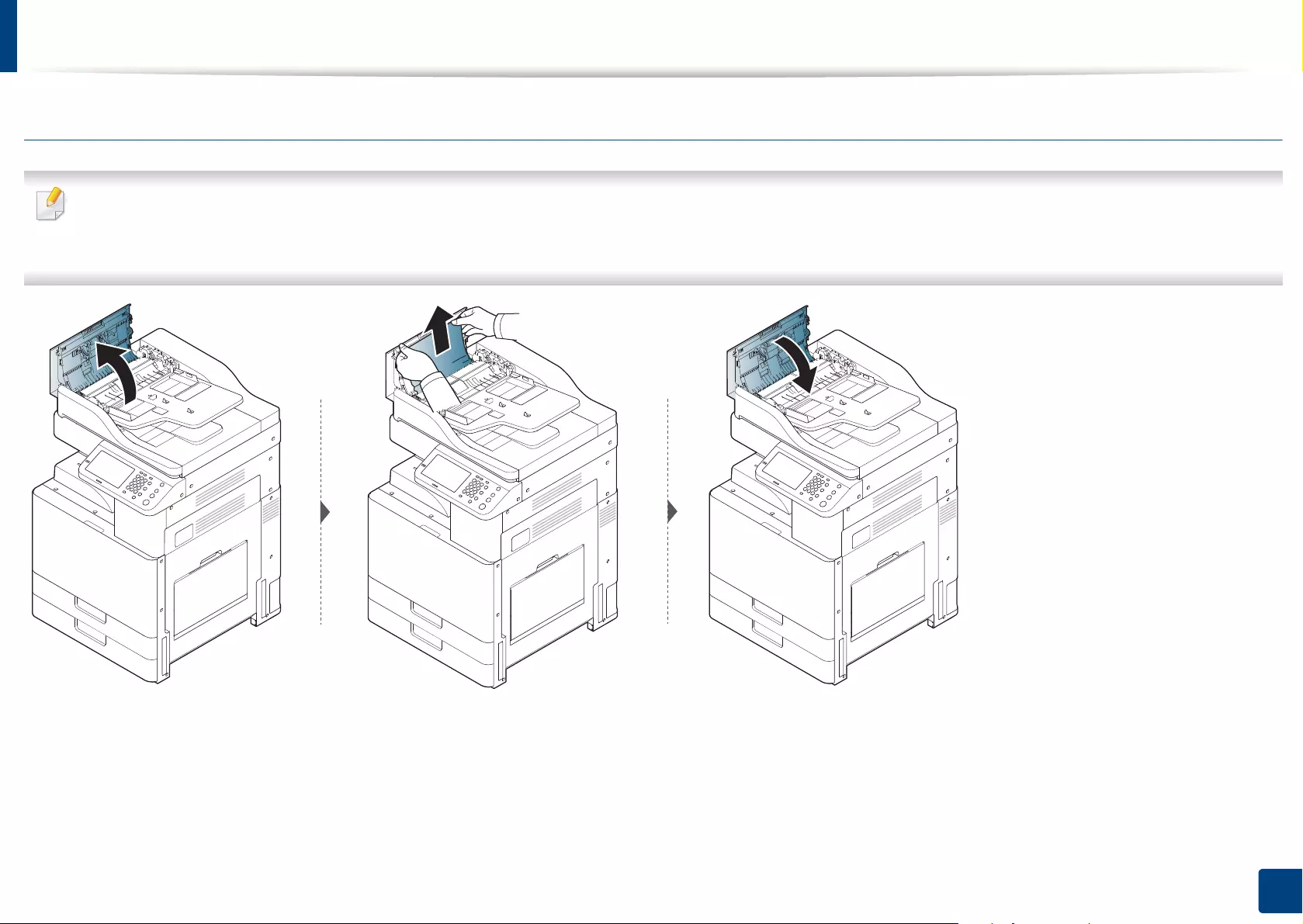
Clearing paper jams
359
15. Troubleshooting
Original paper jam inside of scanner
• Illustrations in this user’s guide may differ from your machine depending on the model and options installed. Check your machine type (see "Machine overview"
on page 20).
• This troubleshooting may not be available depending on model or optional goods (see "Variety feature" on page 11).
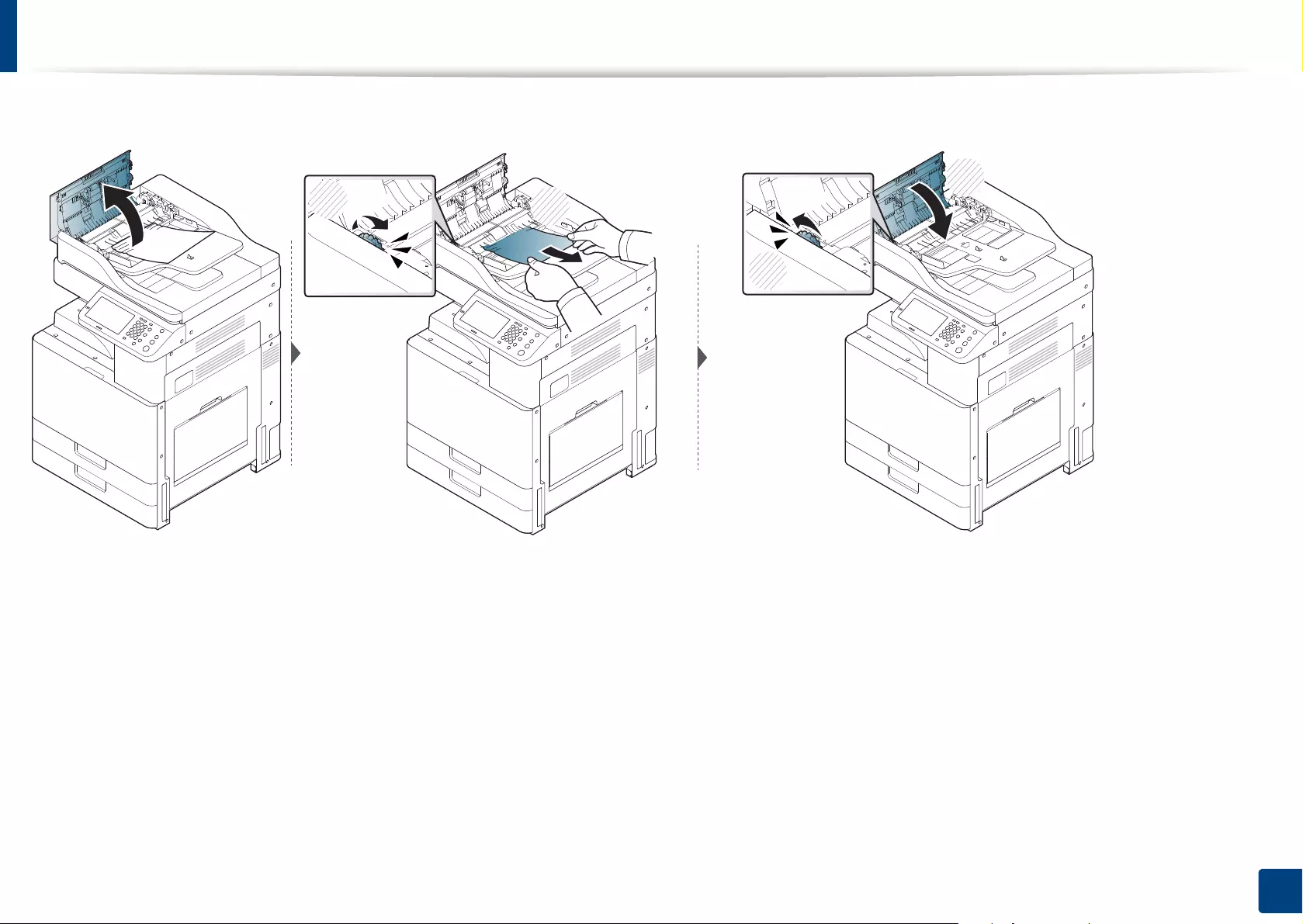
Clearing paper jams
360
15. Troubleshooting
If you do not see the paper in this area, stop and go to next step:
12
1
2
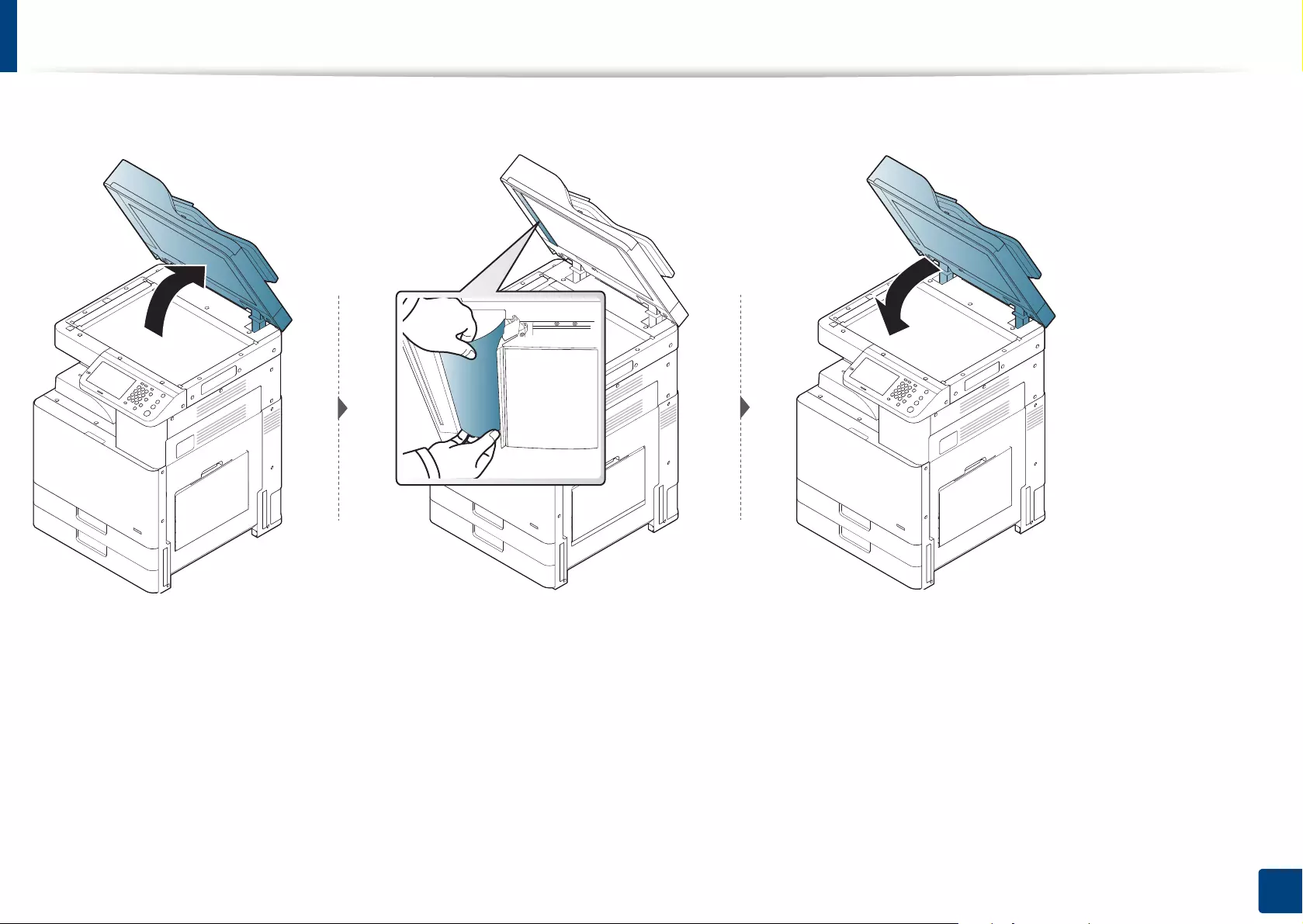
Clearing paper jams
361
15. Troubleshooting
If you do not see the paper in this area, stop and go to next step:
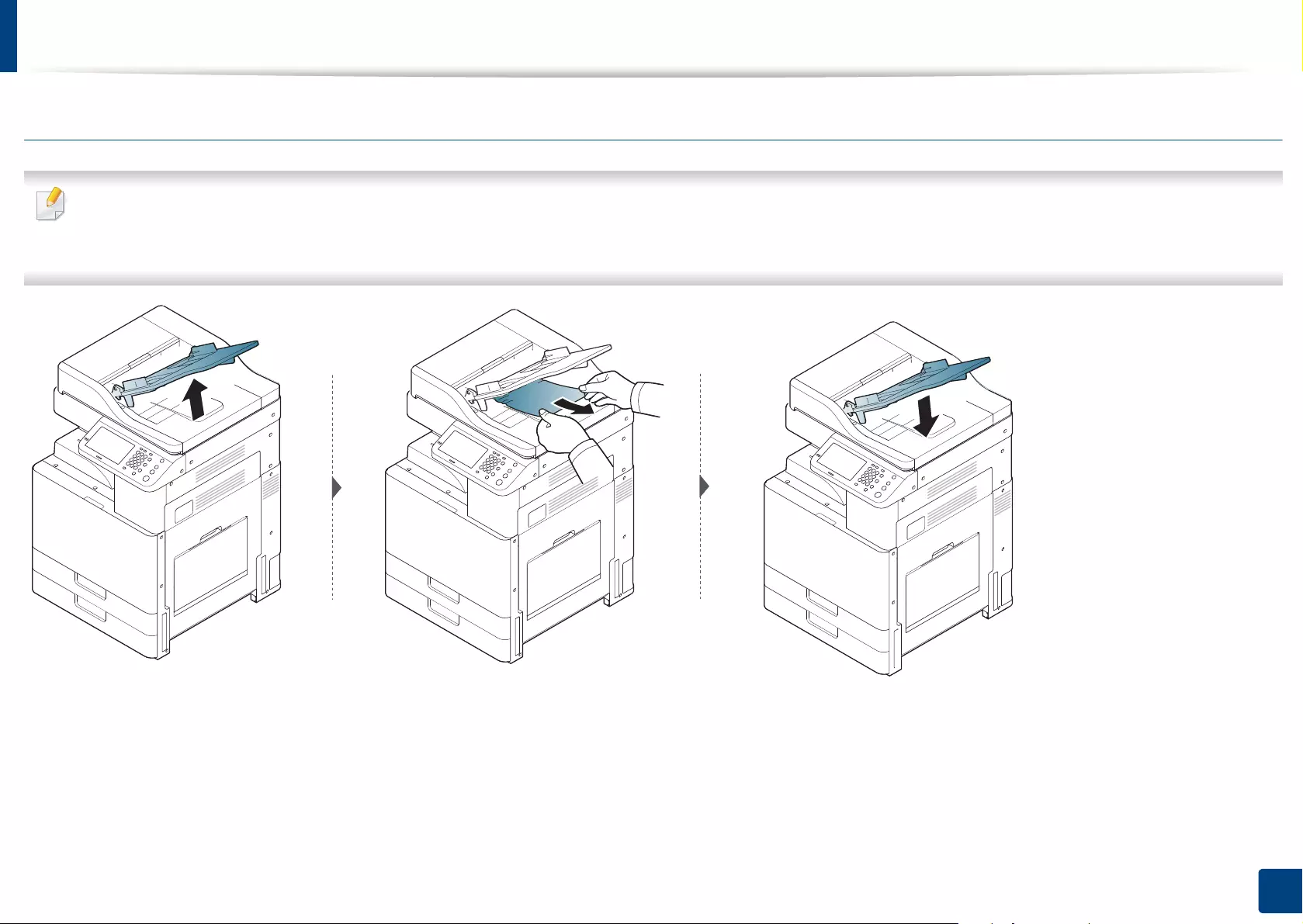
Clearing paper jams
362
15. Troubleshooting
Original paper jam in exit area of scanner
• Illustrations in this user’s guide may differ from your machine depending on the model and options installed. Check your machine type (see "Machine overview"
on page 20).
• This troubleshooting may not be available depending on model or optional goods (see "Machine overview" on page 20).
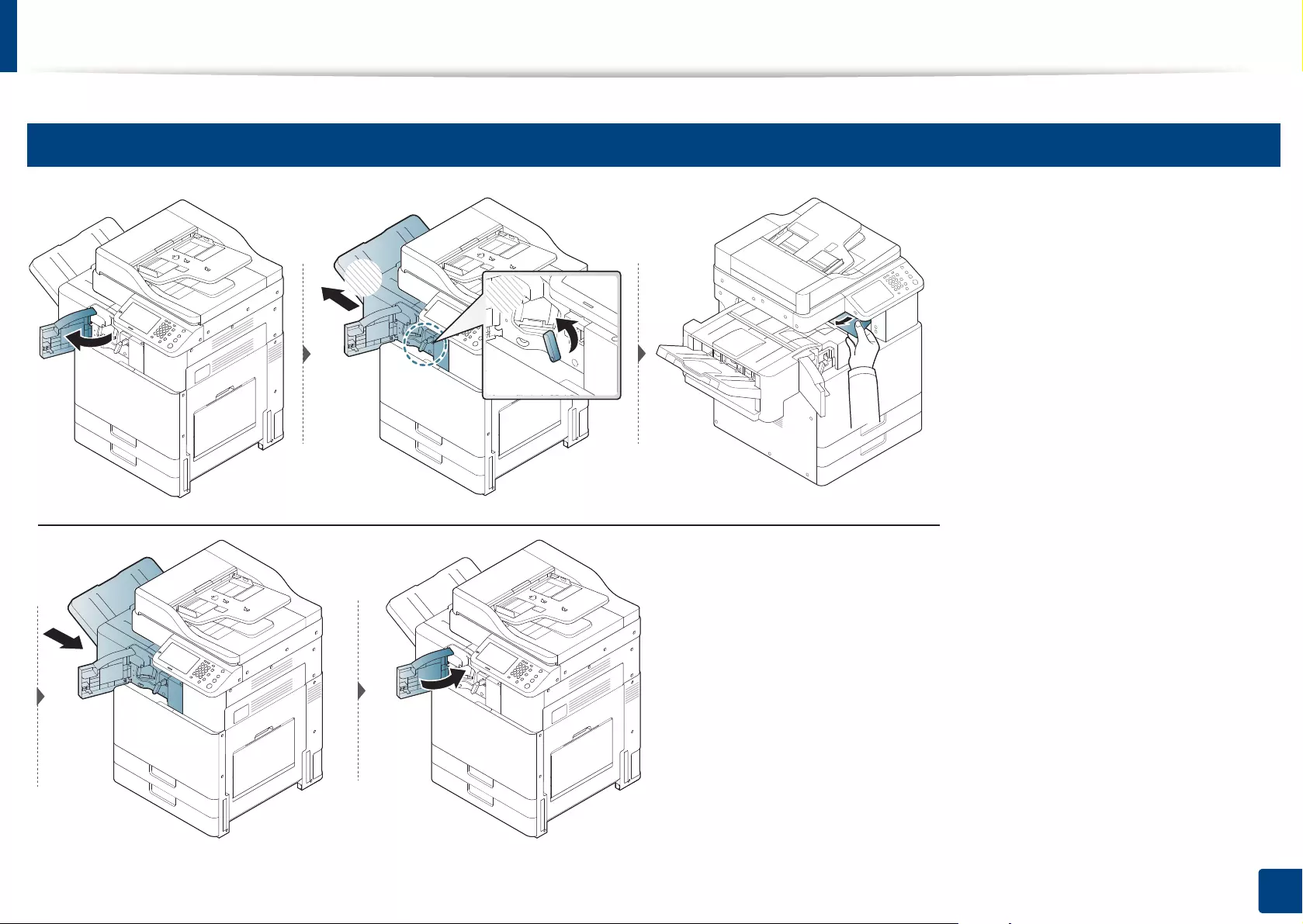
Clearing paper jams
363
15. Troubleshooting
8
In the optional finisher area
1
2
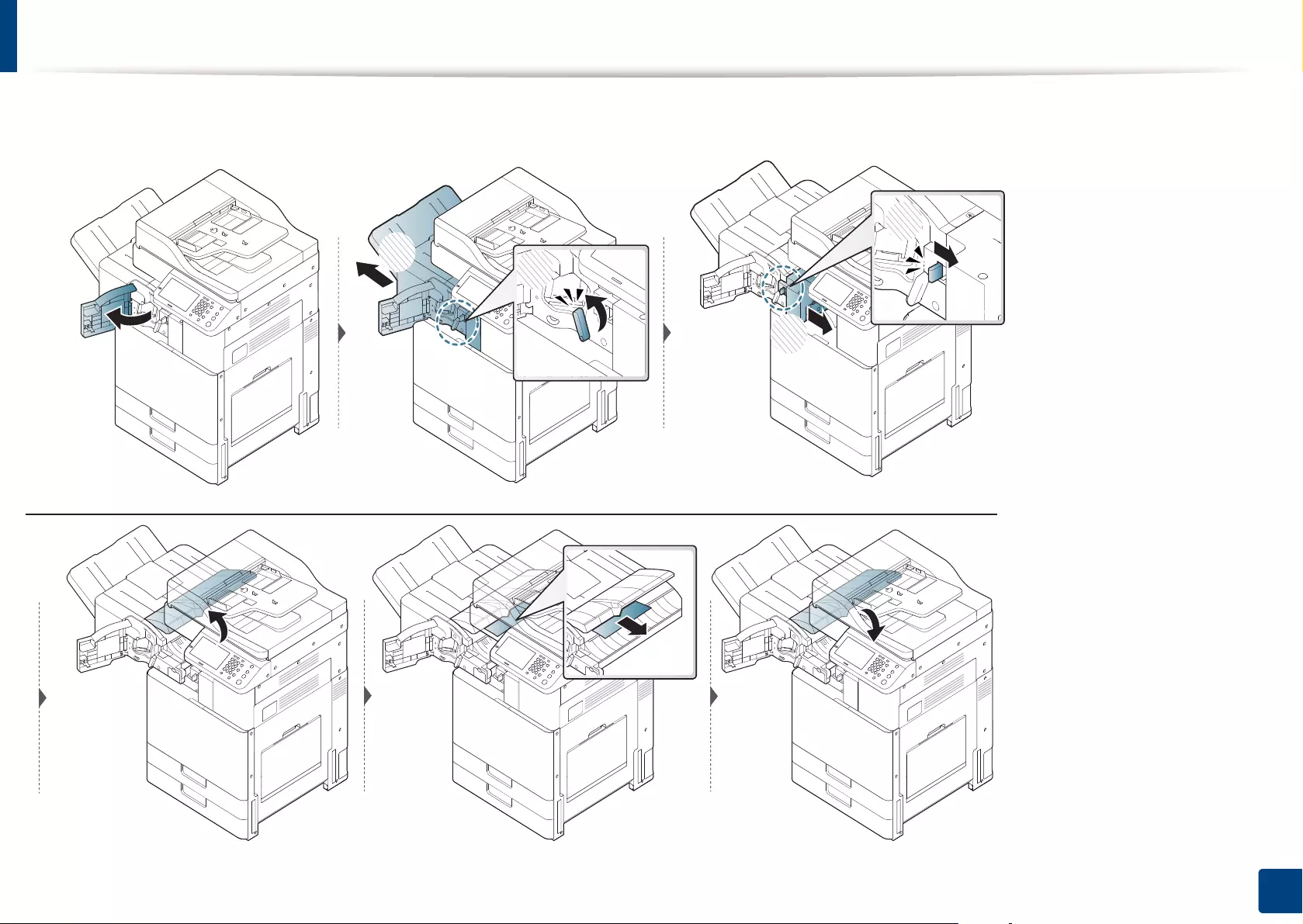
Clearing paper jams
364
15. Troubleshooting
If you do not see the paper in this area, stop and go to next step:
1
2
1
2
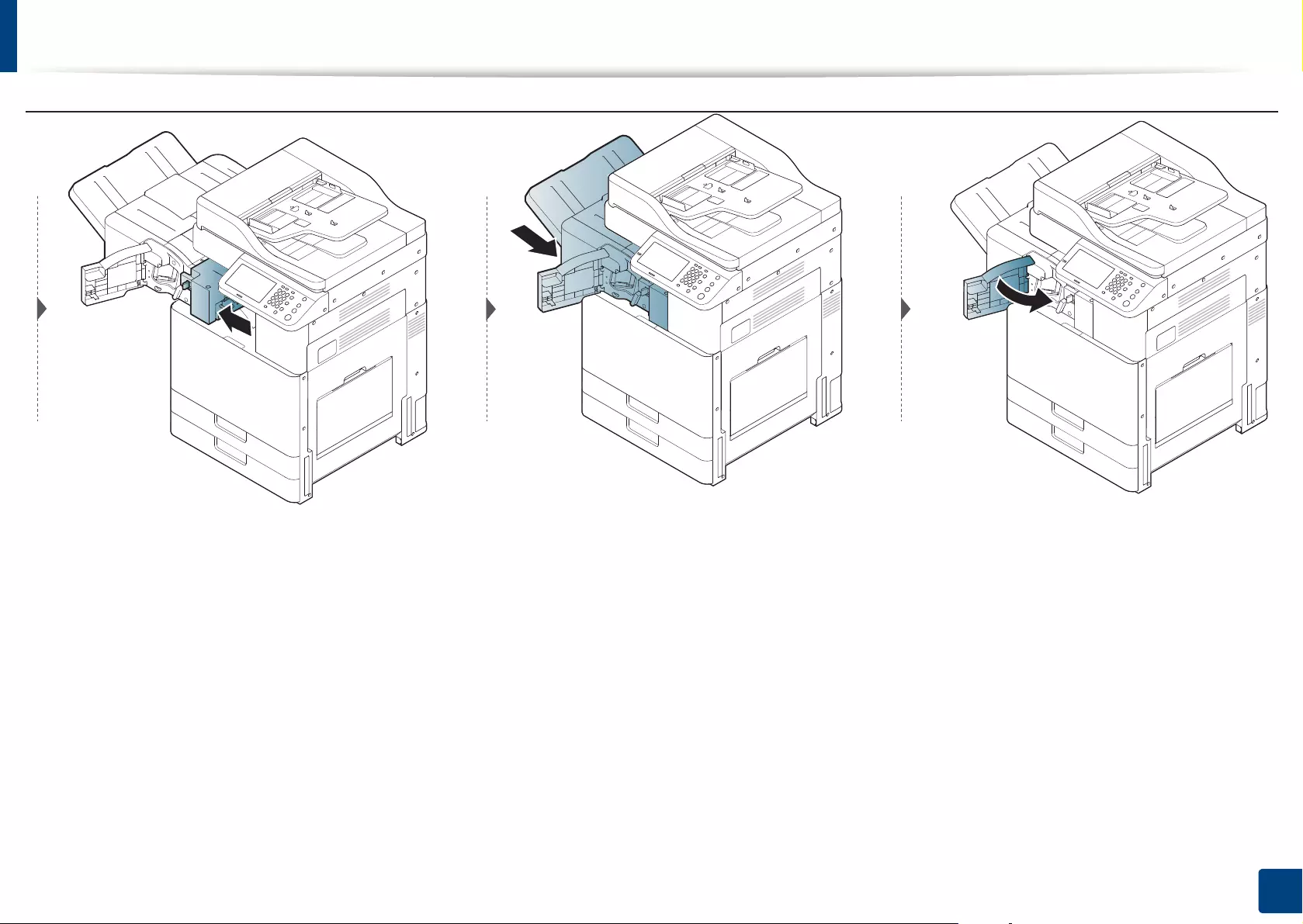
Clearing paper jams
365
15. Troubleshooting
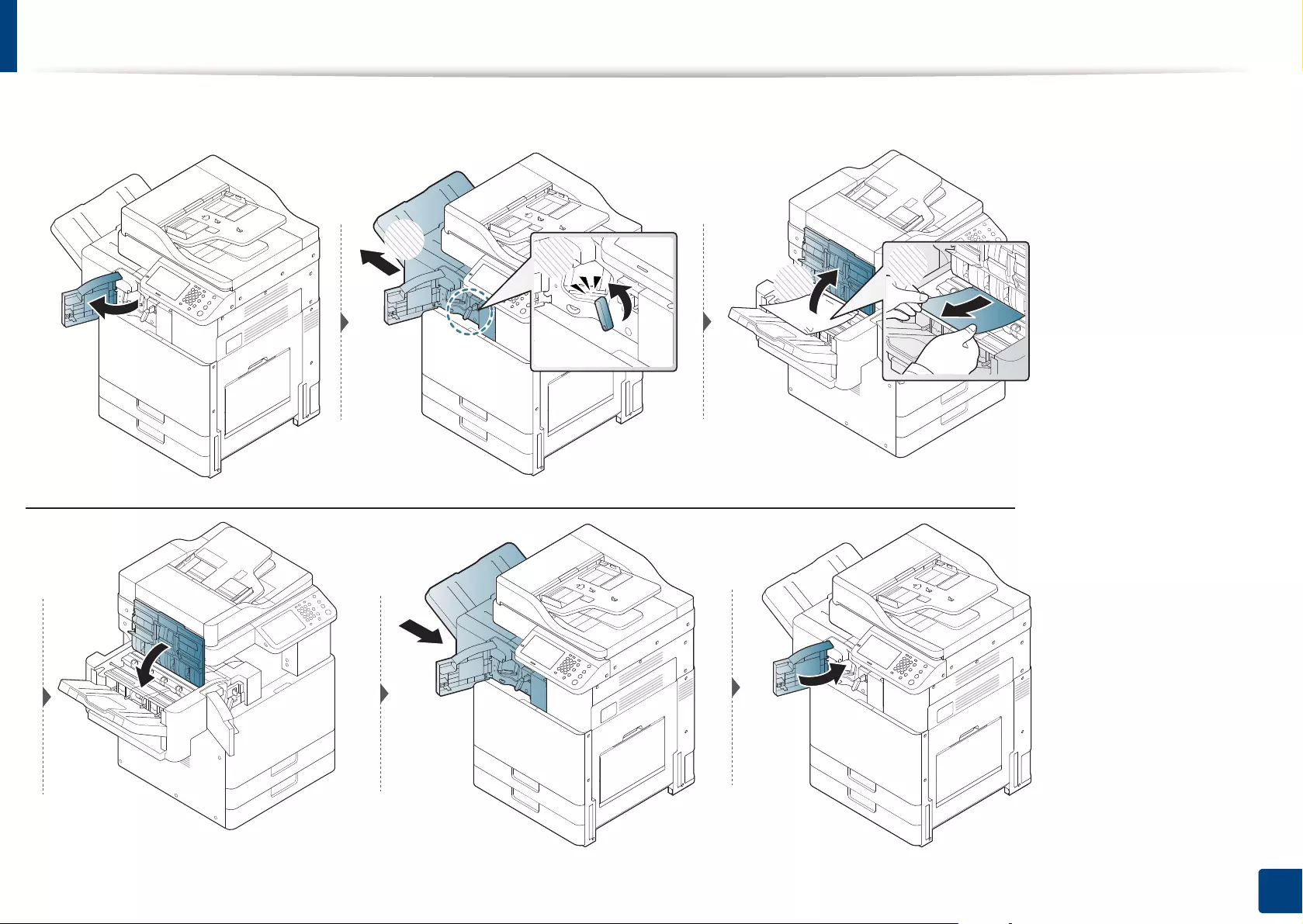
Clearing paper jams
366
15. Troubleshooting
If you do not see the paper in this area, stop and go to next step:
1
2
12
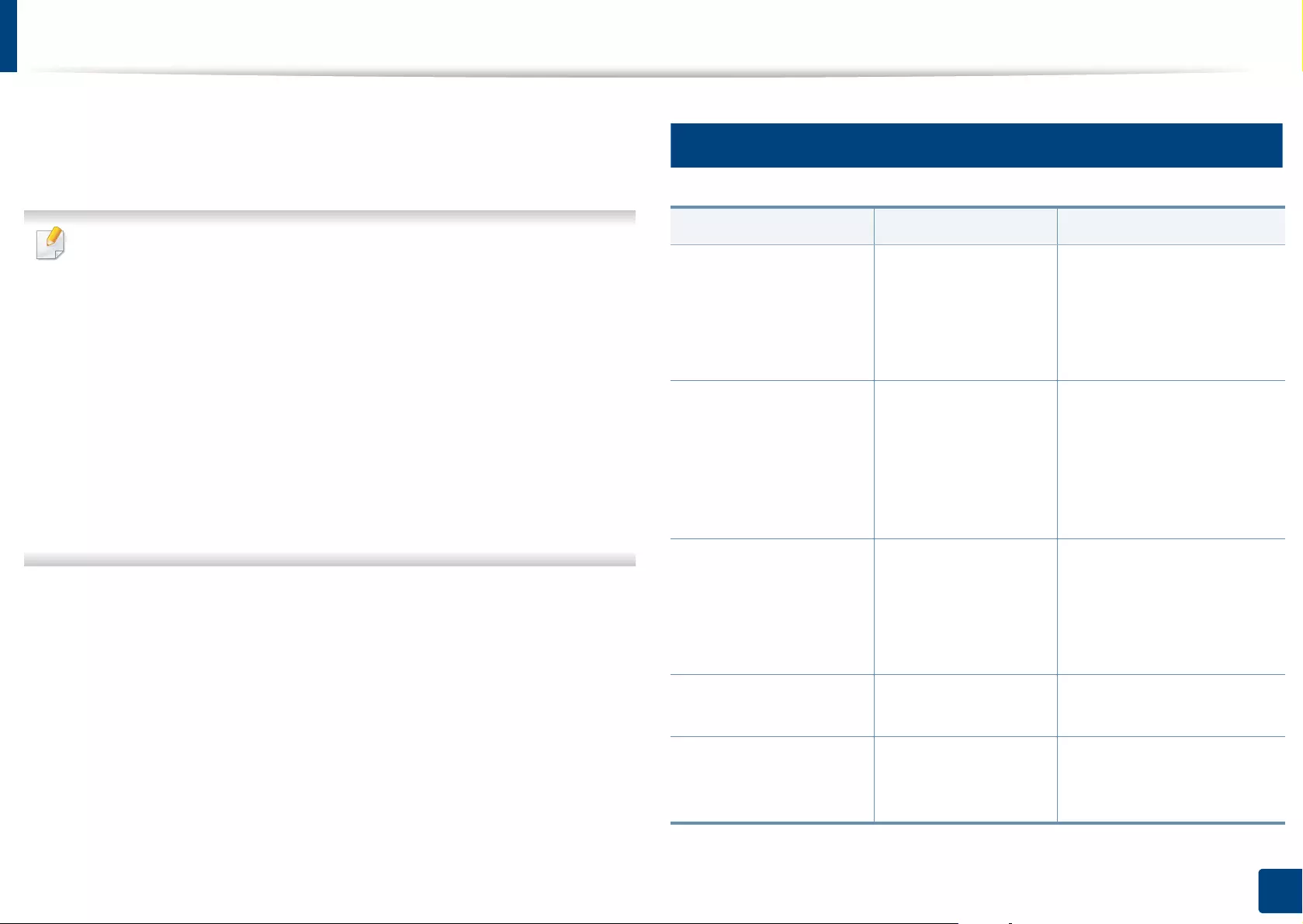
367
15. Troubleshooting
Understanding display messages
Messages appear on the control panel display to indicate the machine’s status
or errors. Refer to the tables below to understand the messages’ and their
meaning, and correct the problem, if necessary.
• You can resolve the error with the guideline from the computer’s
Printing Status program window (see "Using Samsung Printer Status" on
page 285).
• If a message is not in the table, reboot the power and try the printing job
again. If the problem persists, call a service representative.
• When you call for service, provide the service representative with the
contents of display message.
• Some messages may not appear on the display depending on the
options or models.
• [error number] indicates the error number.
• [tray type] indicates the tray number.
• [color] indicates the color of toner.
9
Paper Jam-related messages
Message Meaning Suggested solutions
•Original paper jam
inside the scanner
•Original paper jam in
the exit area of
scanner
The loaded original
document has
jammed in document
feeder.
Clear the jam (see "Clearing
original document jams" on
page 357).
•Paper jam at the top
of duplex path
•Paper jam at the
bottom of duplex
path
Paper has jammed
during duplex
printing. This is
applicable only to
machines with this
feature.
Clear the jam (see "Clearing
paper jams" on page 338).
•Paper jam inside of
machine
•Paper jam inside of
machine. Please
remove the paper
Paper has jammed
inside the machine.
Clear the jam (see "Inside the
machine" on page 346).
Paper jam in exit area Paper has jammed in
the paper exit area.
Clear the jam (see "In the exit
area" on page 351).
Paper jam in MP tray Paper has jammed in
the multi-purpose
tray.
Clear the jam (see "Clearing
paper jams" on page 338).
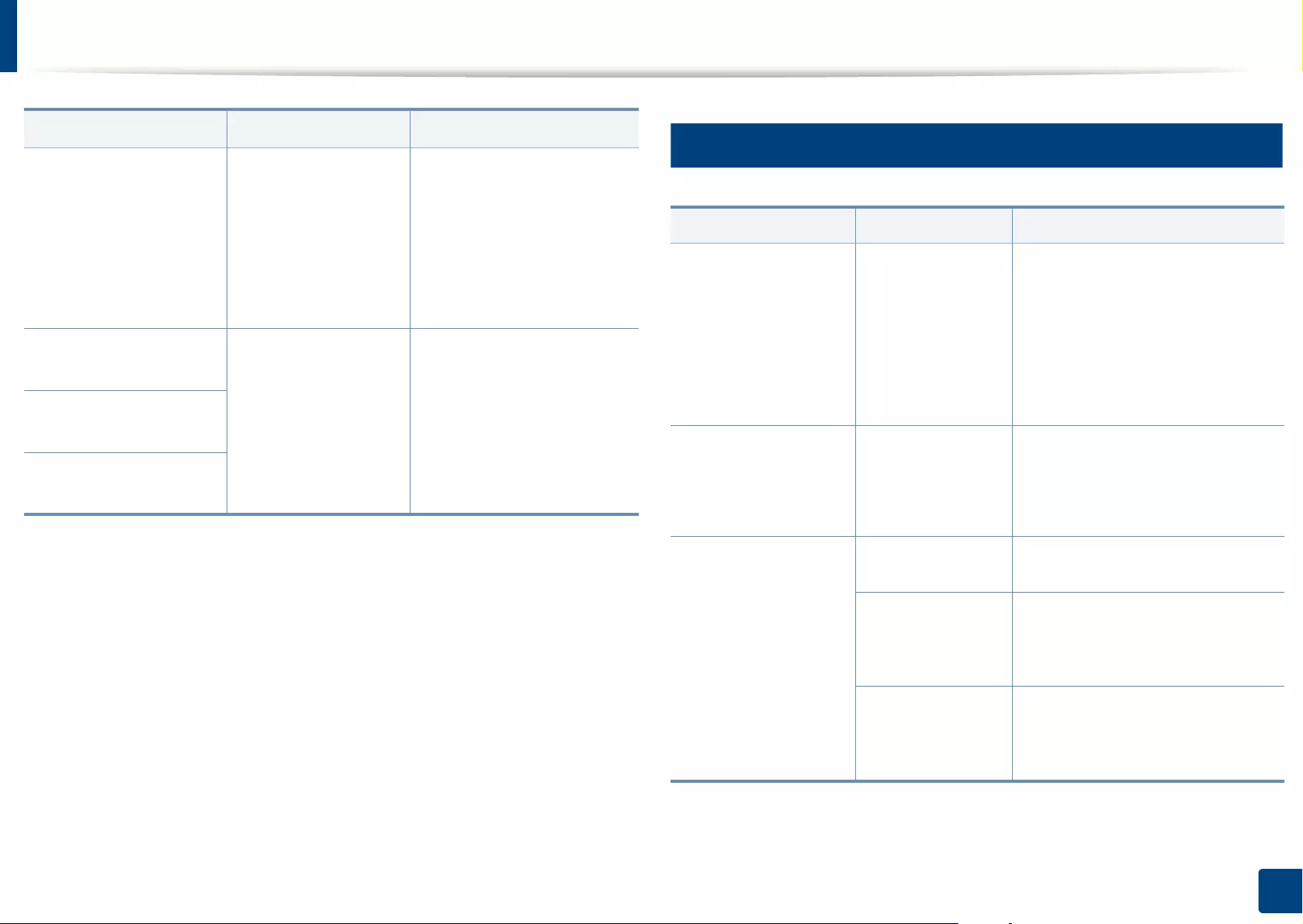
Understanding display messages
368
15. Troubleshooting
10
Toner-related messages
•Paper jam in [Tray
number]
•Paper jam in [tray
number]. Please
open the door and
remove paper, then
close the door.
Paper has jammed in
the tray.
Clear the jam (see "Clearing
paper jams" on page 338).
Paper jam at exit of
finisher
Paper has jammed
during finishing.
Clear the jam (see "In the
optional finisher area" on
page 363).
Paper jam in front of
finisher
Paper jam inside of
finisher
Message Meaning Suggested solutions
Message Meaning Suggested solutions
Did not supply
enough [color] toner.
Remove seal tape of
[color] toner
cartridge or shake it.
Call for service if the
problem persists
The machine
cannot detect a
toner cartridge. Or
not removed seal
tape of toner
cartridge.
Remove the sealing tape from the
toner cartridge. Refer to Quick
Install Guide.
[color] toner
cartridge is not
compatible. Check
users guide
The toner cartridge
you have installed is
not for your
machine.
Install a genuine Samsung toner
cartridge designed for your
machine (see "Available supplies" on
page 295).
•Toner cartridge is
not installed.
Install the
cartridge
•[color] toner
cartridge is not
installed. Install it
A toner cartridge is
not installed.
Reinstall the toner cartridge.
A toner cartridge is
not being detected
Reinstall the toner cartridge two or
three times to confirm it is seated
properly. If the problem persists,
please call for service.
Not removed
protective film from
toner.
Remove the protective film from the
toner cartridge. Refer to Quick
Installation Guide provided with your
machine.
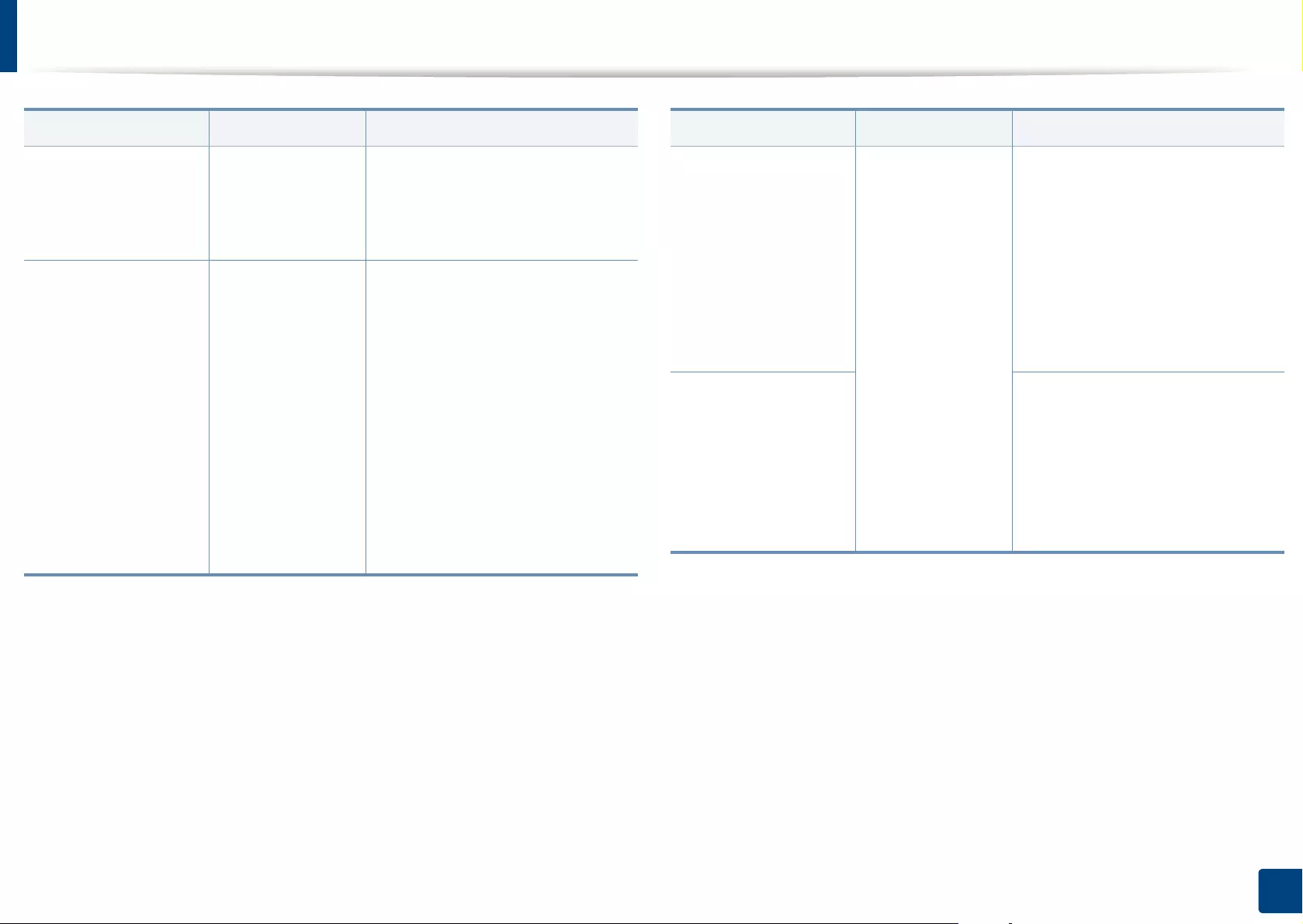
Understanding display messages
369
15. Troubleshooting
Prepare new [color]
toner cartridge
The estimated life of
the toner cartridge
is close.
Prepare a new toner cartridge for a
replacement. You may temporarily
increase the printing quality by
redistributing the toner (see
"Redistributing toner" on page 300).
•Replace with new
[color] toner
cartridge
•End of life,
Replace with new
[color] toner
cartridge
The indicated toner
cartridge has almost
reached its
estimated cartridge
lifea.
• You can choose Stop or
Continue as shown on the
control panel. If you select Stop,
the printer stops printing. If you
select Continue, the printer
keeps printing but the printing
quality cannot be guaranteed.
• Replace the toner cartridge for the
best print quality when this
message appears. Using a
cartridge beyond this stage can
result in printing quality issues (see
"Replacing the toner cartridge" on
page 303).
Message Meaning Suggested solutions
•Shake [color]
toner cartridge
and then install
•Shake [color]
toner cartridge
and then install.
Call for service if
the problem
persists
Small amount of
toner is left in the
indicated
cartridge.
• You may temporarily increase
the printing quality by
redistributing the toner (see
"Redistributing toner" on page
300).
• If the problem persists, call for
service.
Shake [color] toner
cartridge and then
install. Replace toner
cartridge if the
problem persists
• You may temporarily increase
the printing quality by
redistributing the toner (see
"Redistributing toner" on page
300).
• If the problem persists, replace
toner cartridge.
a. Estimated cartridge life means the expected or estimated cartridge life, which indicates
the average capacity of print-outs and is designed pursuant to ISO/IEC 19752 (K325x/
K330x series) or ISO/IEC 19798 (X322x/ X328x series) (see "Available supplies" on page 295).
The number of pages may be affected by operating environment, percentage of image
area, printing interval, media, percentage of image area, and media size. Some amount of
toner may remain in the cartridge even when replace new cartridge appears and the
machine stops printing.
Message Meaning Suggested solutions
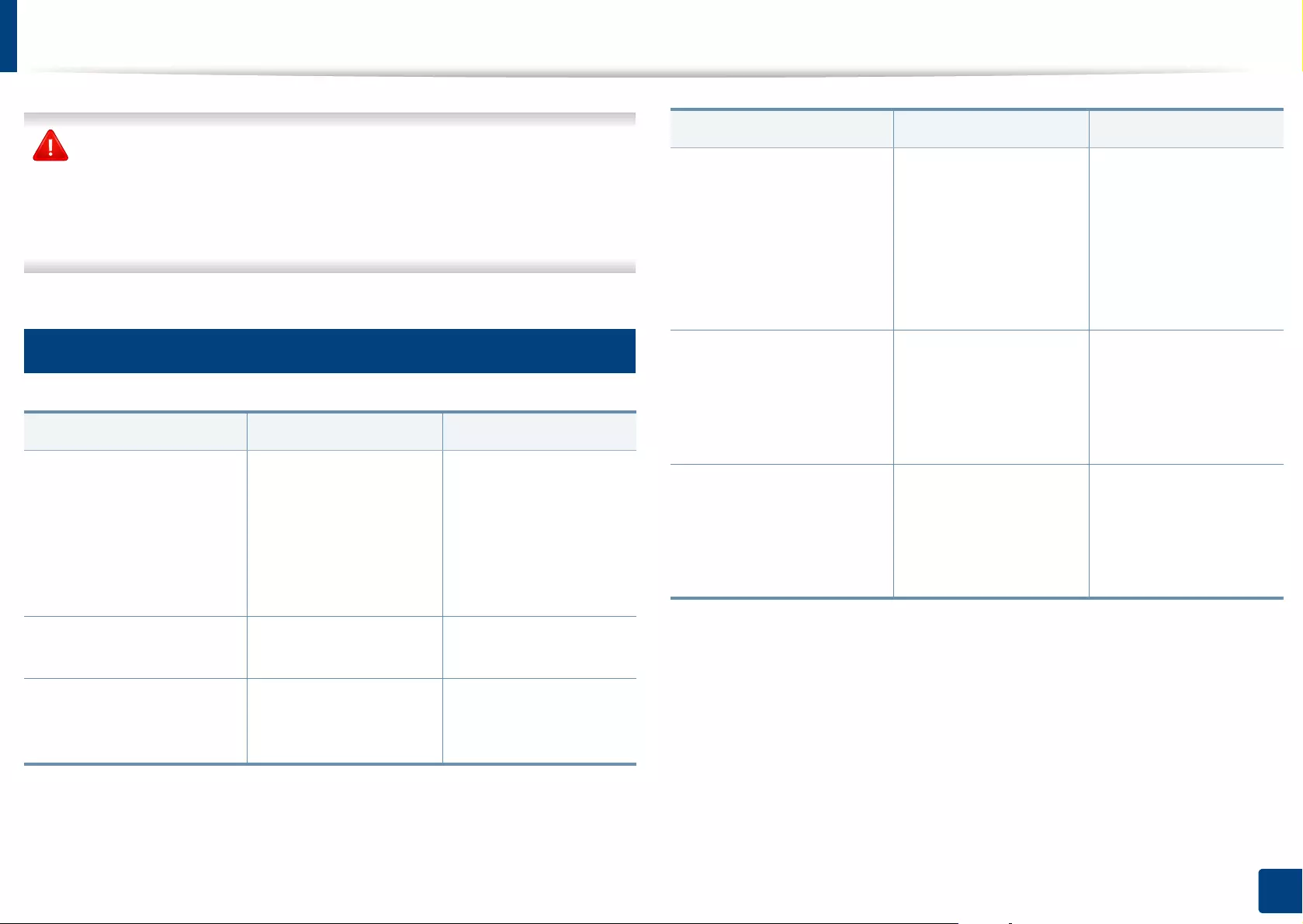
Understanding display messages
370
15. Troubleshooting
Samsung does not recommend using a non-genuine Samsung toner
cartridge such as refilled or remanufactured. Samsung cannot guarantee a
non-genuine Samsung toner cartridge's quality. Service or repair required
as a result of using non-genuine Samsung toner cartridges will not be
covered under the machine warranty.
11
Tray-related messages
Message Meaning Suggested solutions
•Paper is empty in [tray
number]. Load paper
•Paper is empty in MP
tray. Load paper
•Paper is empty in all
tray. Load paper
There is no paper in the
indicated tray.
Load paper in the tray
(see "Loading paper in
the tray" on page 76).
Paper is low in [tray
number]. Load paper
Running out of paper in
the tray.
Load paper in the tray.
[Tray number] cassette is
pulled out. Insert it
properly
The tray is not securely
latched.
Close the tray until it
locks into place.
•[Tray number] Paper
Mismatch
•MP Tray Paper
Mismatch
The paper size specified
in the printer properties
does not match the
paper loaded in the tray.
Select Continue to
proceed with the print
job with the incorrect
paper, or select Cancel
to stop the print job and
load the correct paper in
the tray.
Tray Failure: [error
number]. Pull [tray
number] out and insert it.
Call for service if the
problem persists
The tray is not securely
connected.
Reinstall the tray. If the
problem persists, call for
service.
Tray Failure: [error
number]. Check tray 3
connection and turn off
then on. Call for service if
the problem persists
The tray is not securely
connected.
Reinstall the tray. If the
problem persists, call for
service.
Message Meaning Suggested solutions
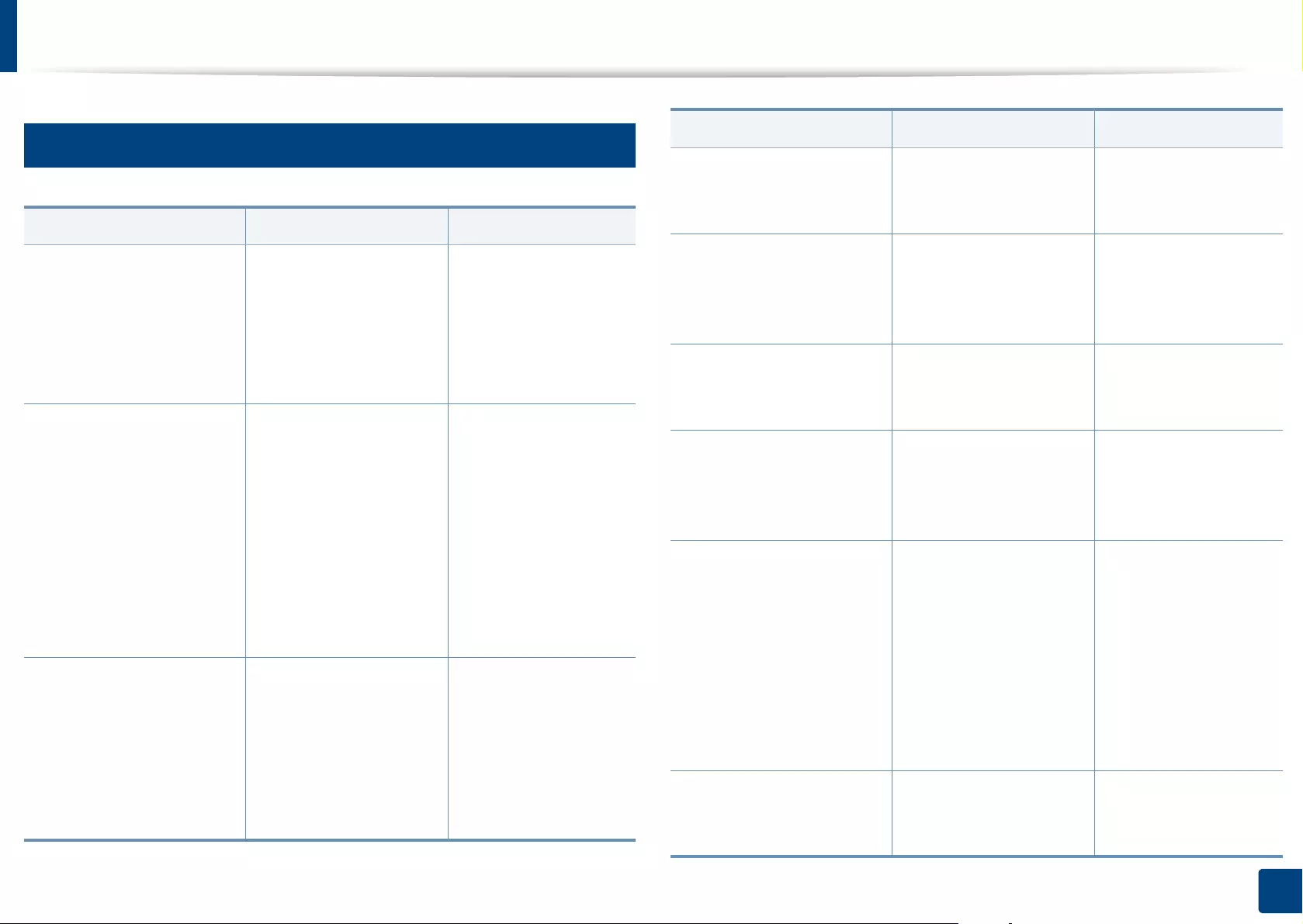
Understanding display messages
371
15. Troubleshooting
12
Network-related messages
Message Meaning Suggested solutions
802.1x authentication
failed. Please Contact the
System Administrator
Fail to authenticate. Check the network
authentication
protocol. If the
problem persists,
contact your network
administrator.
Can not find a wireless
network. Please check the
wireless environment
The machine cannot find
the wireless network.
Check the status of the
wireless router or
access point, including
its configuration and
power connections, as
well as any devices that
may affect wireless
communication. If the
problem persists,
please call for service.
Failed to connect to Wi-Fi
Direct. Turn off your
mobile device and turn it
on
The machine failed to
connect via Wi-Fi Direct.
Turn the Wi-Fi Direct
feature off and then
back on or reboot the
machine or mobile
device. If the problem
persists, please call for
service.
Failed connection to WPS.
Try again or set up other
wireless connection
The machine failed to
connect via WPS.
Check the WPS settings
(see "Using the WPS
menu" on page 59).
MSOK System Failure:
[error number]. Turn off
then on
There is a problem in the
engine system.
Turn the machine off
and back on again. If
the problem persists,
call for service.
Network cable is
disconnected. Check it
The machine is not
connected with a
network cable.
Connect the machine
to the network with a
network cable.
Network Failure:[error
number]. Turn off then
on. Call for service if the
problem persists
There is a problem in the
network system.
Turn the machine off
and back on again. If
the problem persists,
call for service.
Not connected from the
wireless AP. If you do not
reconnect automatically,
check the wireless
settings
The machine failed to
connect to the wireless
AP(access point or
wireless router).
Check the status of the
access point, including
its configuration and
power connections, as
well as any devices that
may affect wireless
communication. If the
problem persists,
please call for service.
This IP address conflicts
with that of other system.
Check it
The network IP address
you have set is being
used by someone else.
Check the IP address
and reset it if necessary.
Message Meaning Suggested solutions

Understanding display messages
372
15. Troubleshooting
13
Misc. messages
Video System Failure:
[error number]. Turn off
then on
There is a problem in the
CPU.
Turn the machine off
and back on again. If
the problem persists,
call for service.
Wi-Fi Direct is not ready.
Turn off then on. Call for
service if the problem
persists
The machine failed to
initialize the Wi-Fi Direct
connection.
Reboot the machine to
initialize the wireless
settings. If the problem
persists, please call for
service.
Wireless security settings
are incorrect. Please
change the settings
• The wireless network
options are
configured incorrectly
for the security
method.
• The password entered
in the wireless
security options is
incorrect.
• The machine does not
support the security
method used by the
access point or
wireless router.
• The access point or
wireless router has
malfunctioned.
Reconfigure the
wireless options in the
machine, SWS, access
point, or wireless
router. The WPA2-PSK/
AES security method is
recommended. If the
problem persists,
please call for service.
Message Meaning Suggested solutions
Message Meaning Suggested solutions
•[color] Developer
Failure: [error
number]. Turn off then
on
•[color] Developer
Failure: [error
number]. Turn off then
on. Please call for
service if the problem
persists
There is a problem in the
developer.
Unplug the power cord
and plug it back in. If
the problem persists,
call for service.
[color] imaging unit is not
compatible. Check users
guide
The imaging unit you
have installed is not for
your machine.
Install a Samsung-
genuine imaging unit,
designed for your
machine (see
"Available supplies" on
page 295).
•[color] imaging unit is
not installed. Install it
•Imaging unit is not
installed. Install the
unit
The imaging unit is not
installed or the imaging
unit is not properly
installed.
Install the imaging unit.
If it is already installed,
try to reinstall the
imaging unit. If the
problem persists, call
for service.
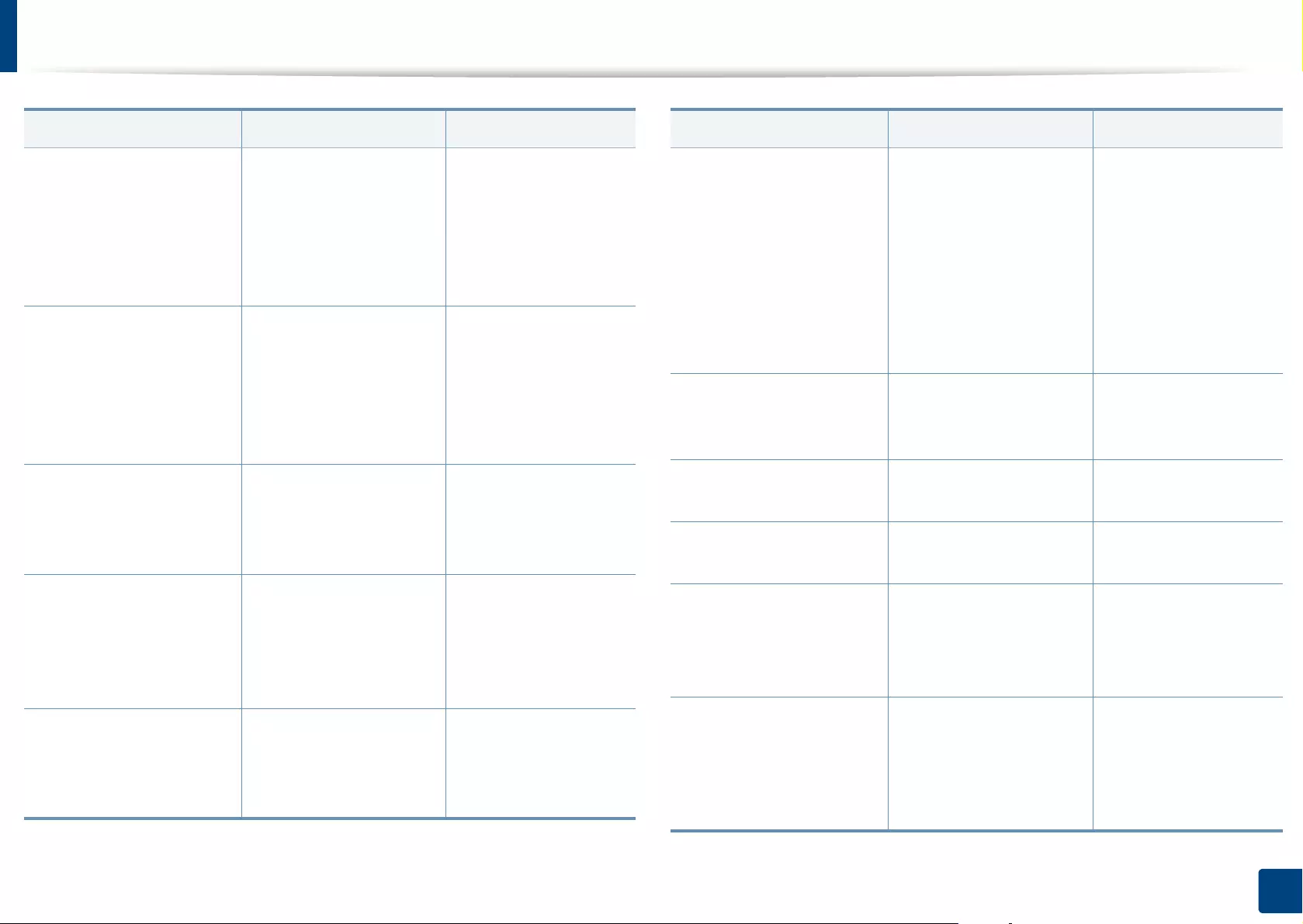
Understanding display messages
373
15. Troubleshooting
[color] Imaging Unit
Failure: [error number].
Install [color] imaging
unit again
The imaging unit is not
installed.
Install the imaging unit.
If it is already installed,
try to reinstall the
imaging unit. If the
problem persists, call
for service.
End of life. Replace with
new [color] imaging unit
The indicated imaging unit
has almost reached its
estimated cartridge lifea.
Replace the imaging
unit with a Samsung-
genuine imaging unit
(see "Replacing the
imaging unit" on page
306).
Engine System
Failure[error number]:
Turn off then on
There is a problem in the
engine system.
Unplug the power cord
and plug it back in. If
the problem persists,
call for service.
Fan Failure: [error
number]. Open the door,
then close it. Call for
service if the problem
persists
There is a problem in the
fan.
Open the door, then
close it. If the problem
persists, call for service.
Fan Failure: [error
number]. Turn off then
on. Call for service if the
problem persists
There is a problem in the
fan.
Unplug the power cord
and plug it back in. If
the problem persists,
call for service.
Message Meaning Suggested solutions
•Finisher Failure: [error
number]. Open the
finisher door, then
close it. Turn off then
on if the problem
persists
•Finisher Failure: [error
number]. Check
finisher
There is a problem in the
finisher system.
Open the door, then
close it. If the problem
persists, call for service.
Finisher is pulled out.
Insert it properly
The finisher is not
securely connected.
Reinstall the finisher. If
the problem persists,
call for service.
Finisher jam door is open.
Close it
The finisher door is not
securely latched.
Close the door until it
locks into place.
Finisher stapler door is
open. Close it
The finisher stapler door
is not securely latched.
Close the door until it
locks into place.
•Front door is open.
Close it
•Right door is open.
Close it
The front door or right
door is not securely
latched.
Close the door until it
locks into place.
Fuser unit is not
compatible. Check user’s
guide.
The fuser unit you have
installed is not for your
machine.
Install a Samsung-
genuine fuser unit,
designed for your
machine, call for
service.
Message Meaning Suggested solutions
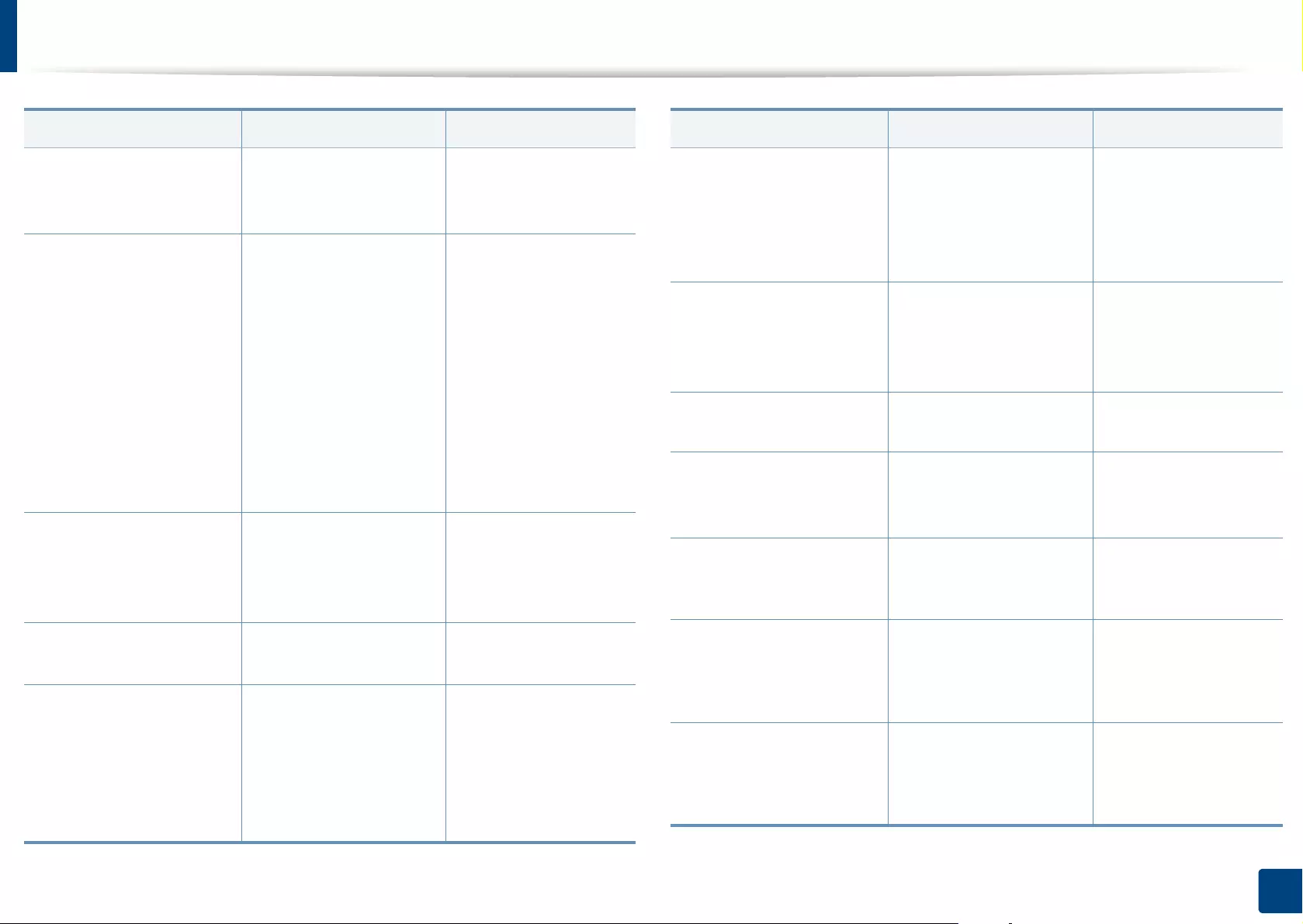
Understanding display messages
374
15. Troubleshooting
Fuser unit is not installed.
Install it
The fuser unit is not
properly installed.
Reinstall the fuser unit.
If the problem persists,
call for service.
•Fuser Unit Failure:
[error number]. Turn
off then on. Call for
service if the problem
persists
•Fuser Unit Failure:
[error number]. Turn
off then on
•Fuser Failure: [error
number]. Turn off then
on
There is a problem in the
fuser unit.
Unplug the power cord
and plug it back in. If
the problem persists,
call for service.
HDD System Failure:
[error number]. Turn off
then on. Call for service if
the problem persists
There is a problem in the
HDD system.
Unplug the power cord
and plug it back in. If
the problem persists,
call for service.
Hole punch hopper is full.
Remove waste of hopper
The hole punch hopper is
full.
Remove a waste of
hooper.
Hole punch hopper is not
installed. Install hopper
The hole punch hopper is
not installed.
Install the hole punch
hopper. If it is already
installed, try to reinstall
the hole punch hopper.
If the problem persists,
call for service.
Message Meaning Suggested solutions
Imaging uint requires
chargers cleaning. Clean
the unit
The imaging unit requires
charger cleaning.
Cleaning the chargers
of imaging unit (see
"Cleaning the chargers
of imaging unit" on
page 329).
Imaging Unit Failure:
[error number]. Please
turn off then on
There is a problem in the
imaging unit.
Turn the machine off
and back on again. If
the problem persists,
call for service.
Inner output tray is full.
Remove printed media
Inner output tray is full. Remove printed media.
Input System Failure:
[error number]. Pull [Tray
number] out and insert it
There is a problem in the
tray.
Open and close the
tray. If the problem
persists, call for service.
LSU Failure: [error
number]. Please turn off
then on
There is a problem in the
LSU.
Unplug the power cord
and plug it back in.
LSU Failure: [error
number]. Turn off then
on. Call for service if the
problem persists
There is a problem in the
LSU.
Unplug the power cord
and plug it back in. If
the problem persists,
call for service.
Motor Failure: [error
number]. Turn off then
on. Call for service if the
problem persists
There is a problem in the
motor system.
Unplug the power cord
and plug it back in. If
the problem persists,
call for service.
Message Meaning Suggested solutions
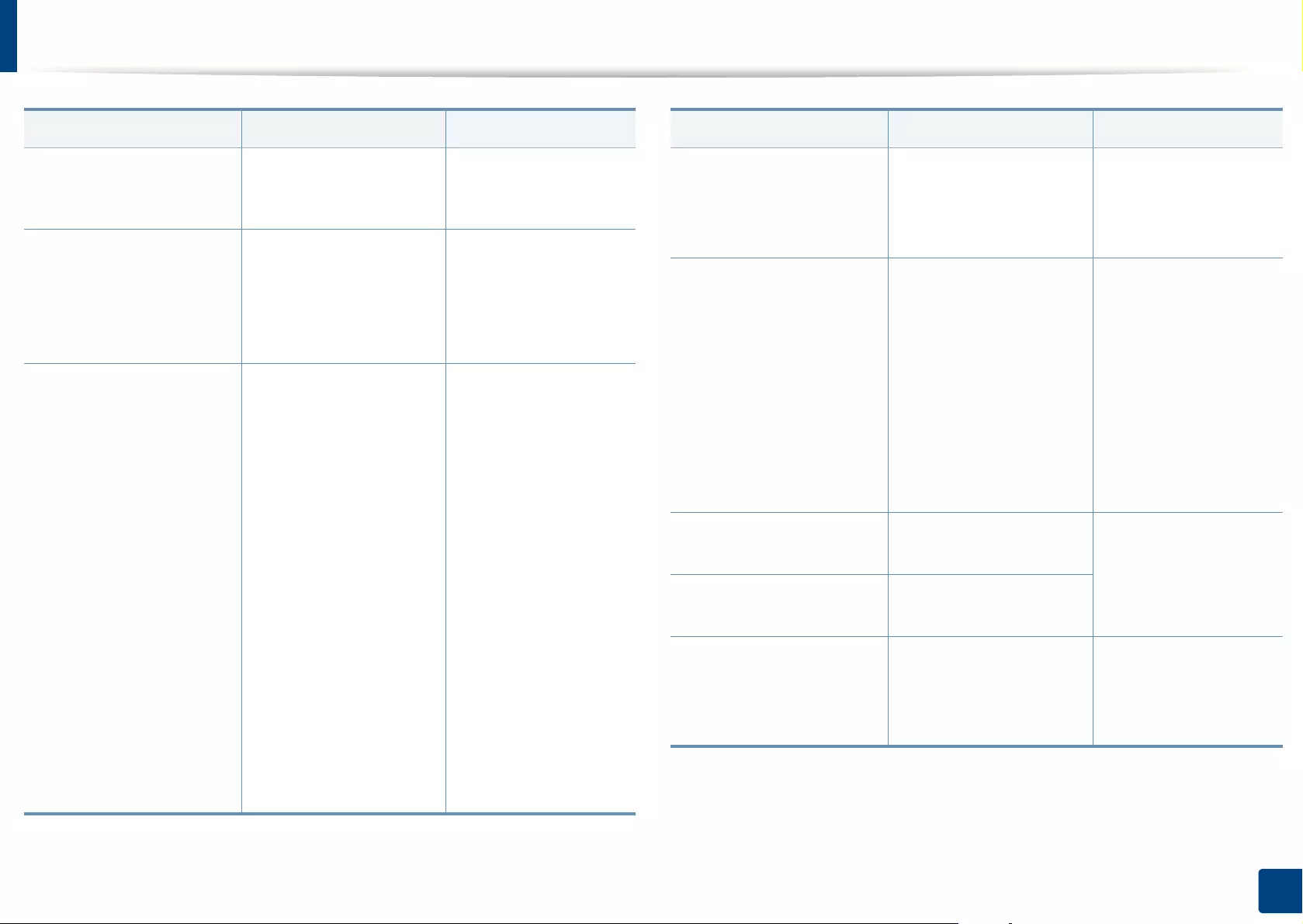
Understanding display messages
375
15. Troubleshooting
Output tray(face down) is
full. Remove printed
media
Output tray is full. Remove printed media.
Prepare new [color]
imaging unit
The estimated lifea of the
imaging unit is close.
Prepare a new imaging
unit for a replacement
(see "Replacing the
imaging unit" on page
306).
Replace with new [color]
developer unit
The life of the developer
unit expires totally.
• You can choose
Stop or Continue as
shown on the
control panel. If you
select Stop, the
printer stops
printing. If you
select Continue, the
printer keeps
printing but the
printing quality
cannot be
guaranteed.
• Replace the
developer unit with
a new one. If the
problem persists,
please call for
service.
Message Meaning Suggested solutions
Replace with new fuser
unit
The life of the transfer
roller expires totally.
Replace the fuser unit
with a new one. If the
problem persists,
please call for service.
Replace with new [color]
imaging unit
The indicated imaging unit
has almost reached its
estimated cartridge lifea.
Replace the imaging
unit for the best print
quality when this
message appears.
Using a imaging unit
beyond this stage can
result in printing
quality issues (see
"Replacing the imaging
unit" on page 306)
Prepare new transfer belt
unit
The life of the transfer
belt will be expired soon.
Replace the transfer
belt with a new one. If
the problem persists,
please call for service.
Replace with new
Transfer belt unit
The life of the transfer
belt has expired.
Replace with new
transfer roller
The life of the transfer
roller expires totally.
Replace the transfer
roller with a Samsung-
genuine transfer roller,
call for service.
Message Meaning Suggested solutions
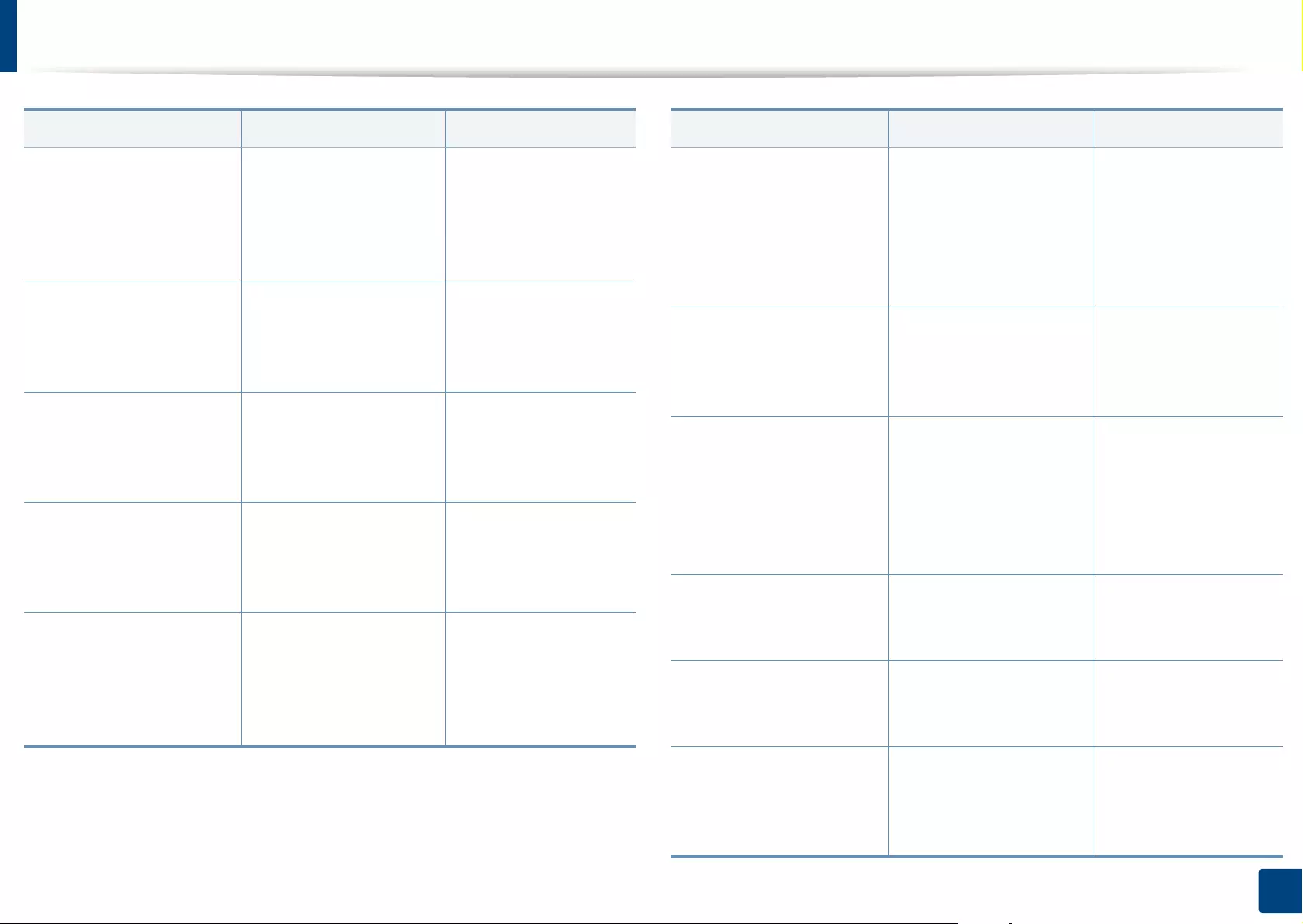
Understanding display messages
376
15. Troubleshooting
Scanner locked or
another problem
occurred
The CCD (Charged
Couple Device) lock has
been locked.
Unlock the CCD lock .
Or turn the machine off
and back on again. If
the problem persists,
call for service.
Scan System Failure:
[error number]. Turn off
then on
There is a problem in the
scan system.
Turn the machine off
and back on again. If
the problem persists,
call for service.
Sensor Failure: [error
number]. Turn off then
on. Call for service if the
problem persists
There is a problem in the
sensor.
Unplug the power cord
and plug it back in. If
the problem persists,
call for service.
Staple cartridge is empty.
Replace it
Small amount of staple
cartridge is left. The
estimated life of staple
cartridge is close.
Prepare a new staple
cartridge for a
replacement.
•Staple cartridge is low.
Prepare it
•Staple cartridge is low.
Replace it
The staple cartridge has
reached the end of its
lifespan.
This message appears
when the staple
cartridge is completely
empty. Prepare the
staple cartridge.
Message Meaning Suggested solutions
Staple cartridge not
install. Install it
The staple cartridge is not
installed or the staple
cartridge is not properly
installed.
Install the staple
cartridge. If it is already
installed, try to reinstall
the staple cartridge. If
the problem persists,
call for service.
The temperature of this
machine is too low.
Please wait for a while to
warm up
The temperature of this
machine is too low.
Wait for a while to
warm up.
There has been a
problem with fax modem
card. Install again. Call
for service if the problem
persists
There is a problem in the
fax modem card.
Install the fax modem
card. If it is already
installed, try to reinstall
the fax modem card. If
the problem persists,
call for service.
The ACR sensor is dirty.
Please clean it with soft
cloth or paper
The ACR sensor is dirty. Clean ACR sensor with
soft cloth or paper.
The CTD sensor is dirty.
Please clean it with soft
cloth or paper
The CTD sensor is dirty. Clean CTD sensor with
soft cloth or paper.
Too much paper in
finisher stacker. Remove
printed paper
The finisher stacker is full. Remove printouts from
the finisher stacker, the
machine resumes
printing.
Message Meaning Suggested solutions
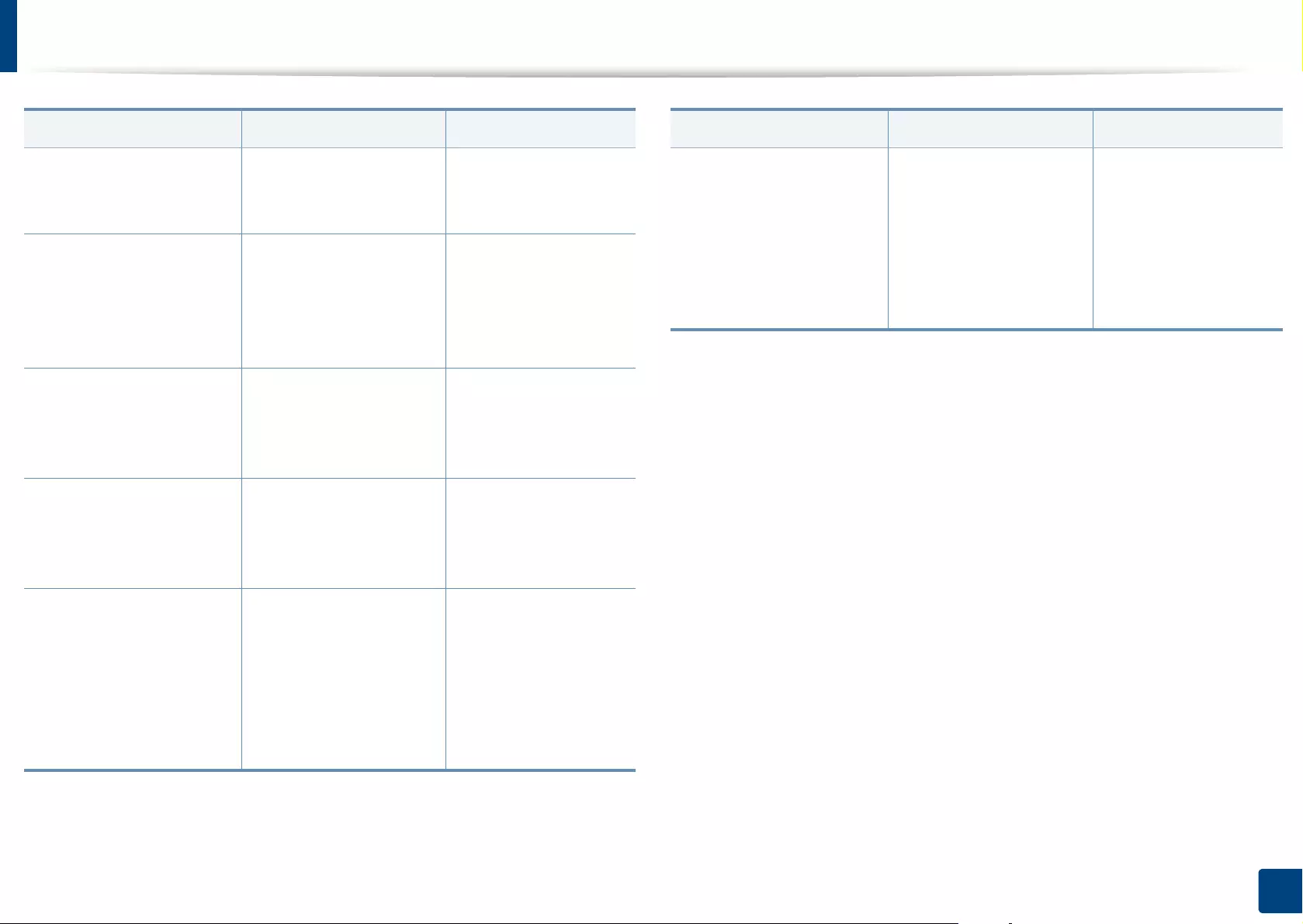
Understanding display messages
377
15. Troubleshooting
Top door of scanner is
open
The document feeder
door is not securely
latched.
Close the door until it
locks into place.
Transfer belt cleaning
unit is worn. Replace with
new one
The life of the transfer
belt cleaning unit expires
totally.
Replace the transfer
belt cleaning unit with
a Samsung-genuine
transfer belt cleaning
unit, call for service.
UI System Failure: [error
number]. Turn off then
on. Call for service if the
problem persists
There is a problem in the
UI system.
Unplug the power cord
and plug it back in. If
the problem persists,
call for service.
Waste toner container is
almost full. Order new
one
The waste toner
container is almost full.
Prepare a waste toner
container with a
Samsung-genuine
waste toner container.
Waste toner container is
full. Replace it
The waste toner
container is full and the
printer will stop printing
until a new waste toner
container is placed into
the printer.
Replace a waste toner
container with a
Samsung-genuine
waste toner container
(see "Replacing the
waste toner container"
on page 310).
Message Meaning Suggested solutions
Waste toner container is
not installed. Install it
The waste toner
container is not installed.
Install the waste toner
container. If it is already
installed, try to reinstall
the waste toner
container. If the
problem persists, call
for service.
a. Estimated cartridge life means the expected or estimated cartridge life, which indicates
the average capacity of print-outs and is designed pursuant to ISO/IEC 19752 (K325x/
K330x series) or ISO/IEC 19798 (X322x/ X328x series) (see "Available supplies" on page 295).
The number of pages may be affected by operating environment, percentage of image
area, printing interval, media, percentage of image area, and media size. Some amount
of toner may remain in the cartridge even when replace new cartridge appears and the
machine stops printing.
Message Meaning Suggested solutions
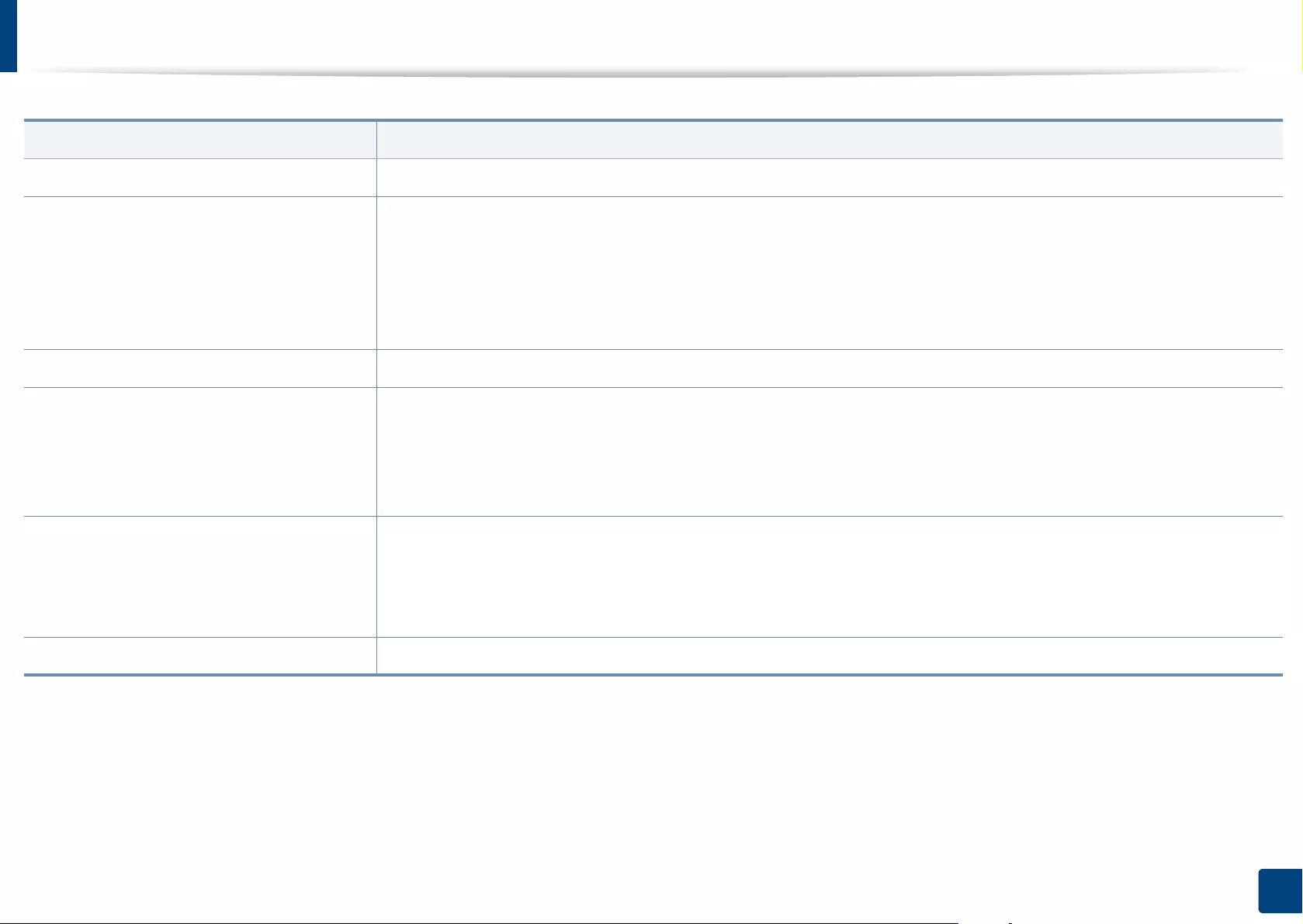
378
15. Troubleshooting
Paper feeding problems
Condition Suggested solutions
Paper jams during printing. Clear the paper jam.
Paper sticks together. • Check the maximum paper capacity of the tray.
• Make sure that you are using the correct type of paper.
• Remove paper from the tray and flex or fan the paper.
• Humid conditions may cause some paper to stick together. Flex or fan the edge of the paper stack to separate the
pages before loading papers.
Multiple sheets of paper do not feed. Different types of paper may be stacked in the tray. Load paper of only one type, size, and weight.
Paper does not feed into the machine. • Remove any obstructions from inside the machine.
• Paper has not been loaded correctly. Remove paper from the tray and reload it correctly.
• There is too much paper in the tray. Remove excess paper from the tray.
• The paper is too thick. Use only paper that meets the specifications required by the machine.
The paper keeps jamming. • There is too much paper in the tray. Remove excess paper from the tray. If you are printing on special materials, use the
manual feeding in tray.
• An incorrect type of paper is being used. Use only paper that meets the specifications required by the machine.
• There may be debris inside the machine. Open the front door and remove any debris.
Envelopes skew or fail to feed correctly. Ensure that the paper guides are against both sides of the envelopes.
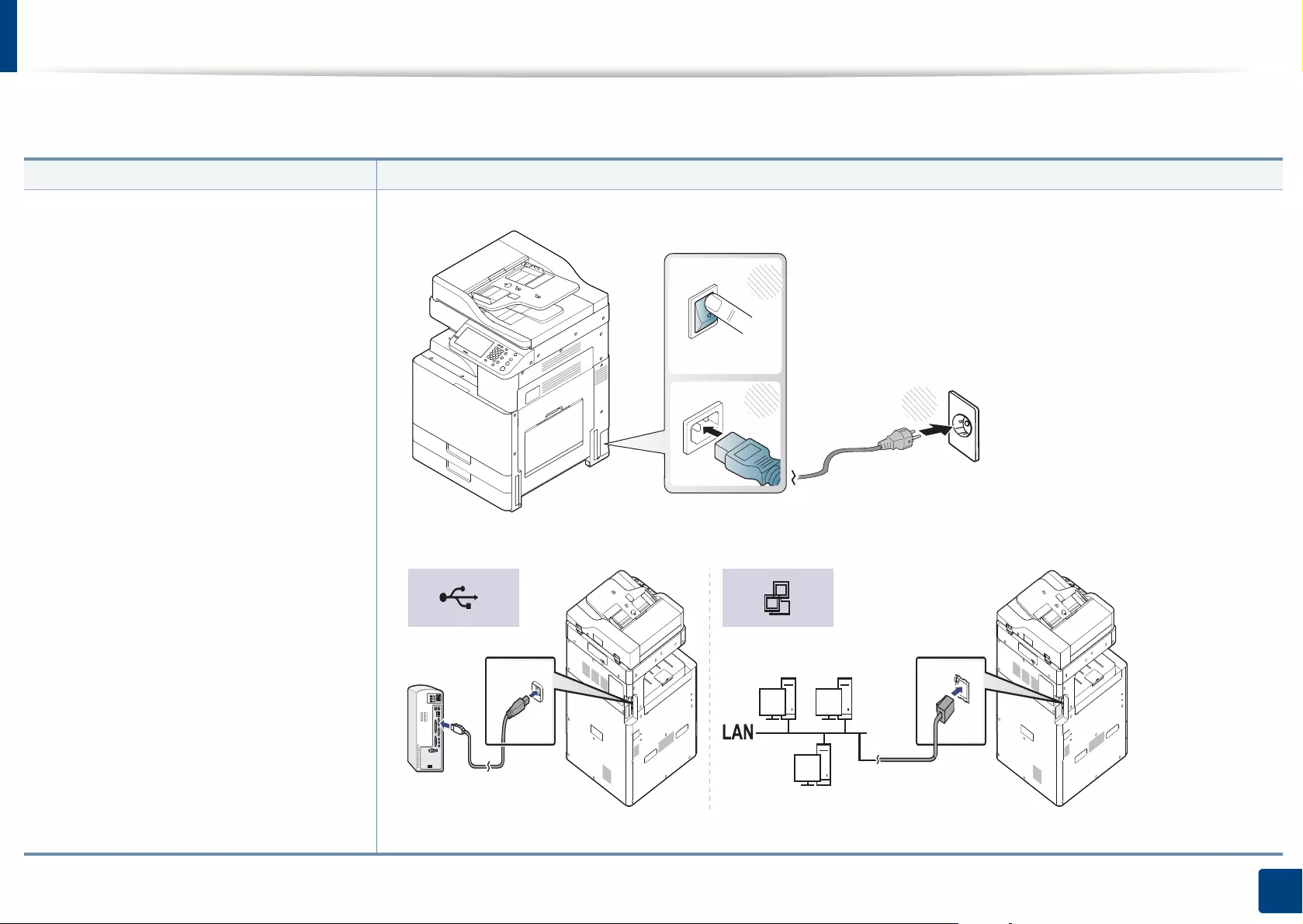
379
15. Troubleshooting
Power and cable connecting problems
Reboot the power. If the problem persists, please call for service.
Condition Suggested solutions
The machine is not receiving power,
or the connection cable between the
computer and the machine is not
connected properly.
1 Connect the machine to the electricity supply first.
2 Check the USB cable or network cable in the machine’s rear.
3 Disconnect the USB cable or network cable in the machine’s rear and then, reconnect it.
12
3
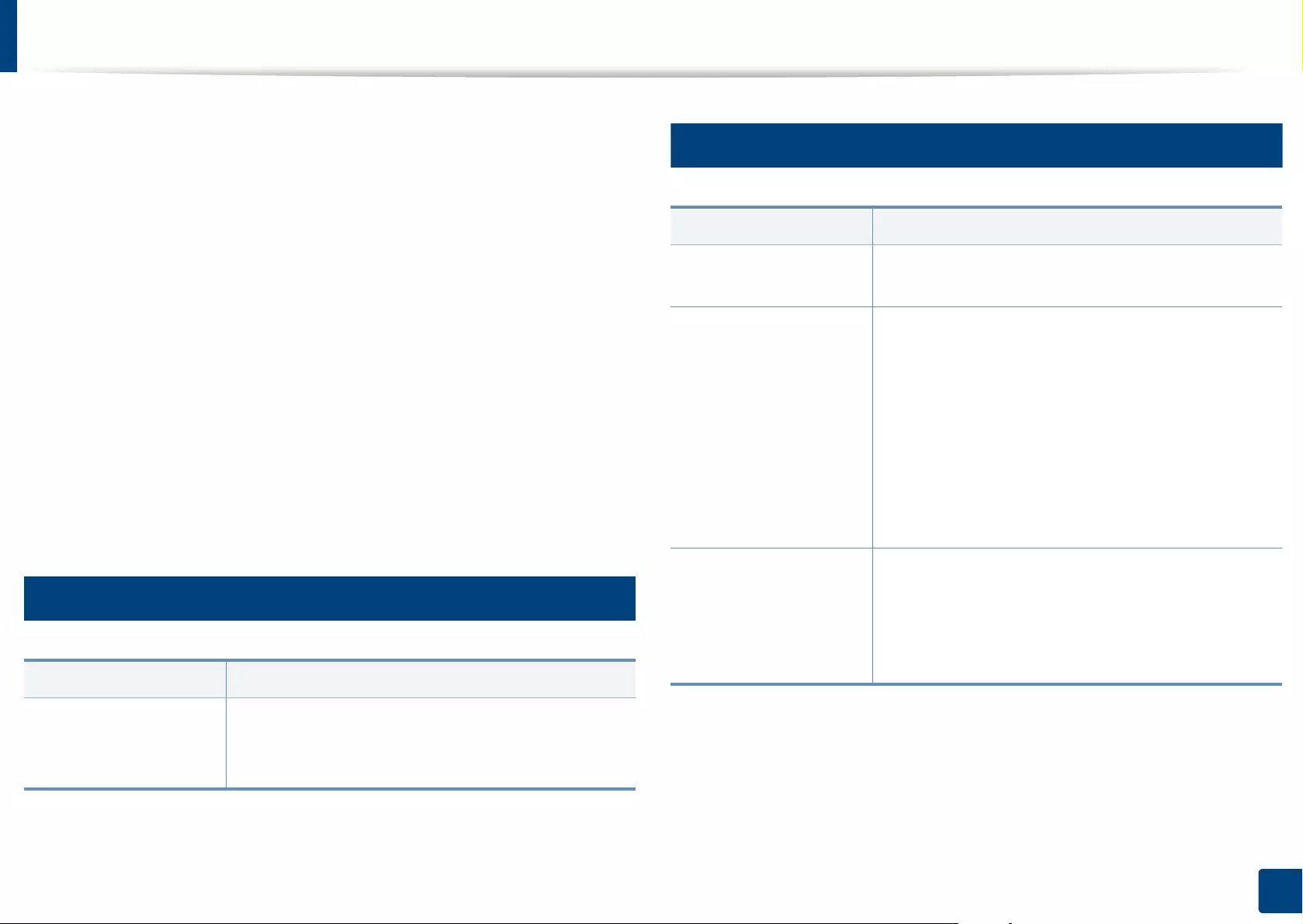
380
15. Troubleshooting
Solving other problems
The following chart lists some trouble conditions that may occur and the
recommended solutions. Follow the suggested solutions until the problem is
corrected. If the problem persists, contact a service representative.
Other problems include:
• See "Display screen problem" on page 380.
• See "Paper feeding problems" on page 380.
• See "Printing problems" on page 381.
• See "Printing quality problems" on page 384.
• See "Copying problems" on page 389.
• See "Scanning problems" on page 390.
• See "Fax problems (optional)" on page 391.
• See "Operating system problems" on page 392.
14
Display screen problem
15
Paper feeding problems
Condition Suggested solutions
The display screen does
not show anything.
• Adjusts the brightness of the display screen.
• Turn the machine off and then back on. If the
problem persists, please call for service.
Condition Suggested solutions
Paper jams during
printing.
Clear the paper jam (see "Clearing paper jams" on
page 338).
Paper sticks together. • Check the maximum paper capacity of the tray (see
"Print media specifications" on page 399).
• Make sure that you are using the correct type of
paper (see "Print media specifications" on page
399).
• Remove paper from the tray and flex or fan the
paper.
• Humid conditions may cause some paper to stick
together. Try a fresh ream of paper.
Multiple sheets of
paper do not feed.
• Different types of paper may be stacked in the tray.
Load paper of only one type, size, and weight.
• If multiple sheets have caused a paper jam, clear
the paper jam (see "Clearing paper jams" on page
338).
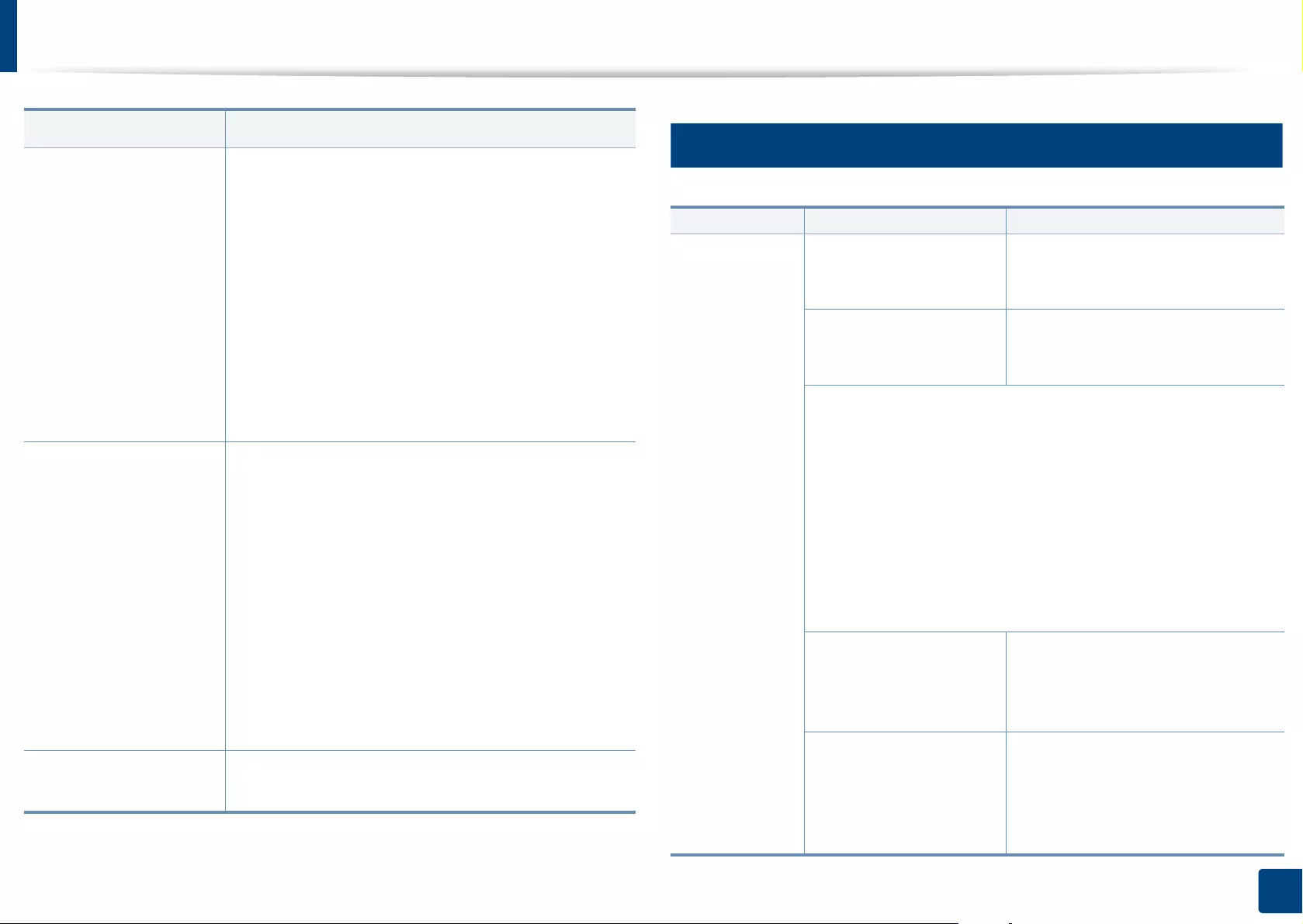
Solving other problems
381
15. Troubleshooting
16
Printing problems
Paper does not feed
into the machine.
• Remove any obstructions from inside the machine.
• Paper has not been loaded correctly. Remove
paper from the tray and reload it correctly.
• There is too much paper in the tray. Remove excess
paper from the tray.
• The paper is too thick. Use only paper that meets
the specifications required by the machine (see
"Print media specifications" on page 399).
• If an original does not feed into the machine, the
RADF rubber pad may require to be replaced.
Contact a service representative.
The paper keeps
jamming.
• There is too much paper in the tray. Remove excess
paper from the tray. If you are printing on special
materials, use the multi-purpose tray.
• An incorrect type of paper is being used. Use only
paper that meets the specifications required by the
machine (see "Print media specifications" on page
399).
• There may be debris inside the machine. Open the
front door and remove any debris.
• If an original does not feed into the machine, the
RADF rubber pad may need to be replaced.
Contact a service representative.
Envelopes skew or fail
to feed correctly.
Ensure that the paper guides are against both sides of
the envelopes.
Condition Suggested solutions
Condition Possible cause Suggested solutions
The machine
does not print.
The machine is not
receiving power.
Check the power cord connections.
Check the power switch and the
power source.
The machine is not
selected as the default
machine.
Select your machine as your default
machine in your Windows.
Check the machine for the following:
• The front door is not closed. Close the front door.
• Paper is jammed. Clear the paper jam (see "Clearing paper
jams" on page 338).
• No paper is loaded. Load paper (see "Loading paper in the
tray" on page 76).
• The toner cartridge or the imaging unit is not installed.
Install the toner cartridge or imaging unit.
If a system error occurs, contact your service representative.
The connection cable
between the computer
and the machine is not
connected properly.
Disconnect the machine cable and
reconnect it.
The connection cable
between the computer
and the machine is
defective.
If possible, attach the cable to
another computer that is working
properly and print a job. You can
also try using a different machine
cable.

Solving other problems
382
15. Troubleshooting
The machine
does not print.
The port setting is
incorrect.
Check the Windows printer setting
to make sure that the print job is
sent to the correct port. If the
computer has more than one port,
make sure that the machine is
attached to the correct one.
The machine may be
configured incorrectly.
Check the Printing Preferences to
ensure that all of the print settings
are correct (see "Opening printing
preferences" on page 96).
The printer driver may be
incorrectly installed.
Repair the machine software.
The machine is
malfunctioning.
Check the display message on the
control panel to see if the machine
is indicating a system error. Contact
a service representative.
The document size is so
big that the hard disk
space of the computer is
insufficient to access the
print job.
If printing GUI, make more hard disk
space available for your print job
and try printing the document
again.
The machine
selects print
materials from
the wrong
paper source.
The paper option that
was selected in the
Printing Preferences
may be incorrect.
For many software applications, the
paper source selection is found
under the Paper tab within the
Printing Preferences. Select the
correct paper source. See the
printer driver help screen (see
"Opening printing preferences" on
page 96).
Condition Possible cause Suggested solutions
A print job is
extremely
slow.
The job may be very
complex.
Reduce the complexity of the page
or try adjusting the print quality
settings.
Half the page
is blank.
The page orientation
setting may be incorrect.
Change the page orientation in
your application. See the printer
driver help screen.
The paper size and the
paper size settings do
not match.
Ensure that the paper size in the
printer driver settings matches the
paper in the tray. Or, ensure that the
paper size in the printer driver
settings matches the paper
selection in the software
application settings you use.
Condition Possible cause Suggested solutions
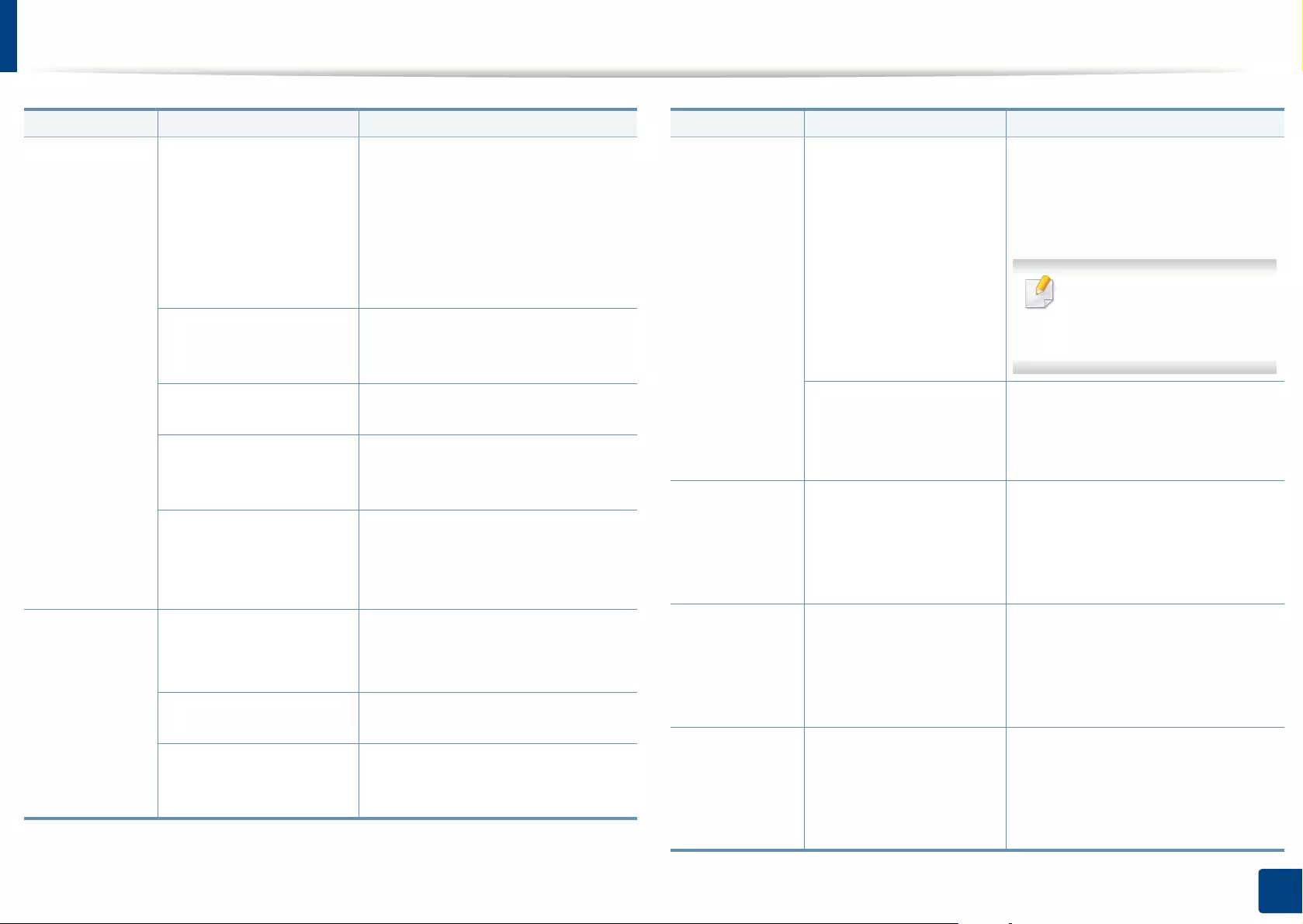
Solving other problems
383
15. Troubleshooting
The machine
prints, but the
text is wrong,
garbled, or
incomplete.
The machine cable is
loose or defective.
Disconnect the machine cable and
reconnect. Try a print job that you
have already printed successfully. If
possible, attach the cable and the
machine to another computer that
you know works and try a print job.
Finally, try a new machine cable.
The wrong printer driver
was selected.
Check the application’s printer
selection menu to ensure that your
machine is selected.
The software application
is malfunctioning.
Try printing a job from another
application.
The operating system is
malfunctioning.
Exit Windows and reboot the
computer. Turn the machine off
and back on again.
If you are in a DOS
environment, the font
setting for your machine
may be set incorrectly.
Change the language setting.
Pages print,
but they are
blank.
The toner cartridge is
defective or out of toner.
Redistribute the toner, if necessary.
If necessary, replace the toner
cartridge.
The file may have blank
pages.
Check the file to ensure that it does
not contain blank pages.
Some parts, such as the
controller or the board,
may be defective.
Contact a service representative.
Condition Possible cause Suggested solutions
The machine
does not print
PDF file
correctly.
Some parts of
graphics, text,
or illustrations
are missing.
Incompatibility between
the PDF file and the
Acrobat products.
Printing the PDF file as an image
may enable the file to print. Turn on
Print As Image from the Acrobat
printing options.
It will take longer to print
when you print a PDF file as
an image.
If the PDF file is missing
fonts and/or images/
objects because set on
Interactive mode.
Try printing a job from Printer
Driver.
The print
quality of
photos is not
good. Images
are not clear.
The resolution of the
photo is very low.
Reduce the photo size. If you
increase the photo size in the
software application, the resolution
will be reduced.
Before
printing, the
machine emits
vapor near the
output tray.
Using damp paper can
cause vapor during
printing.
This is not a problem. Just keep
printing. Try a fresh ream of paper.
The machine
does not print
special- sized
paper, such as
billing paper.
Paper size and paper size
setting do not match.
Set the correct paper size in the
Custom Paper List in the Paper tab
in the Printing Preferences (see
"Paper Options" on page 98).
Condition Possible cause Suggested solutions
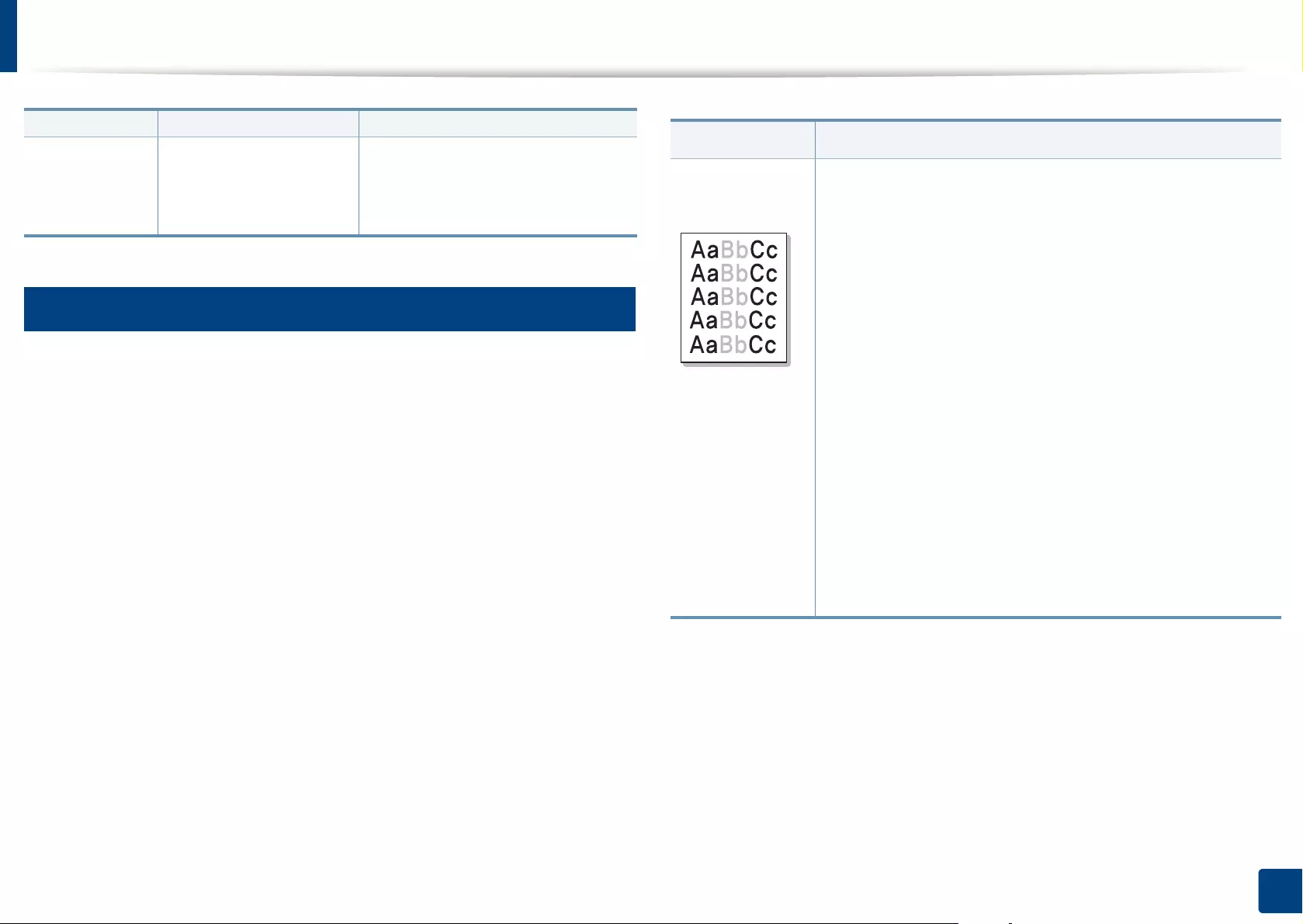
Solving other problems
384
15. Troubleshooting
17
Printing quality problems
If the inside of the machine is dirty or paper has been loaded improperly, there
might be a reduction in print quality. See the table below to clear the problem.
Your machine
has an odd
smell during
initial use.
The oil used to protect
the fuser is evaporating.
After printing about 100 color
pages, there will be no more smell.
It is a temporary issue.
Condition Possible cause Suggested solutions
Condition Suggested Solutions
Light or faded
print
• If a vertical white streak or faded area appears on the page,
the toner supply is low. You may be able to temporarily
extend the toner cartridge life. If this does not improve the
print quality, install a new toner cartridge.
• The color tone might not be adjusted. Adjust the color
tone.
• The paper may not meet paper specifications; for example,
the paper may be too moist or rough (see "Print media
specifications" on page 399).
• If the entire page is light, the print resolution setting is too
low or the toner save mode is on. Adjust the print
resolution and turn the toner save mode off. See the help
screen of the printer driver.
• A combination of faded or smeared defects may indicate
that the toner cartridge needs cleaning. Contact a service
representative.
• The surface of the LSU part inside the machine may be
dirty. Clean the LSU, contact a service representative.
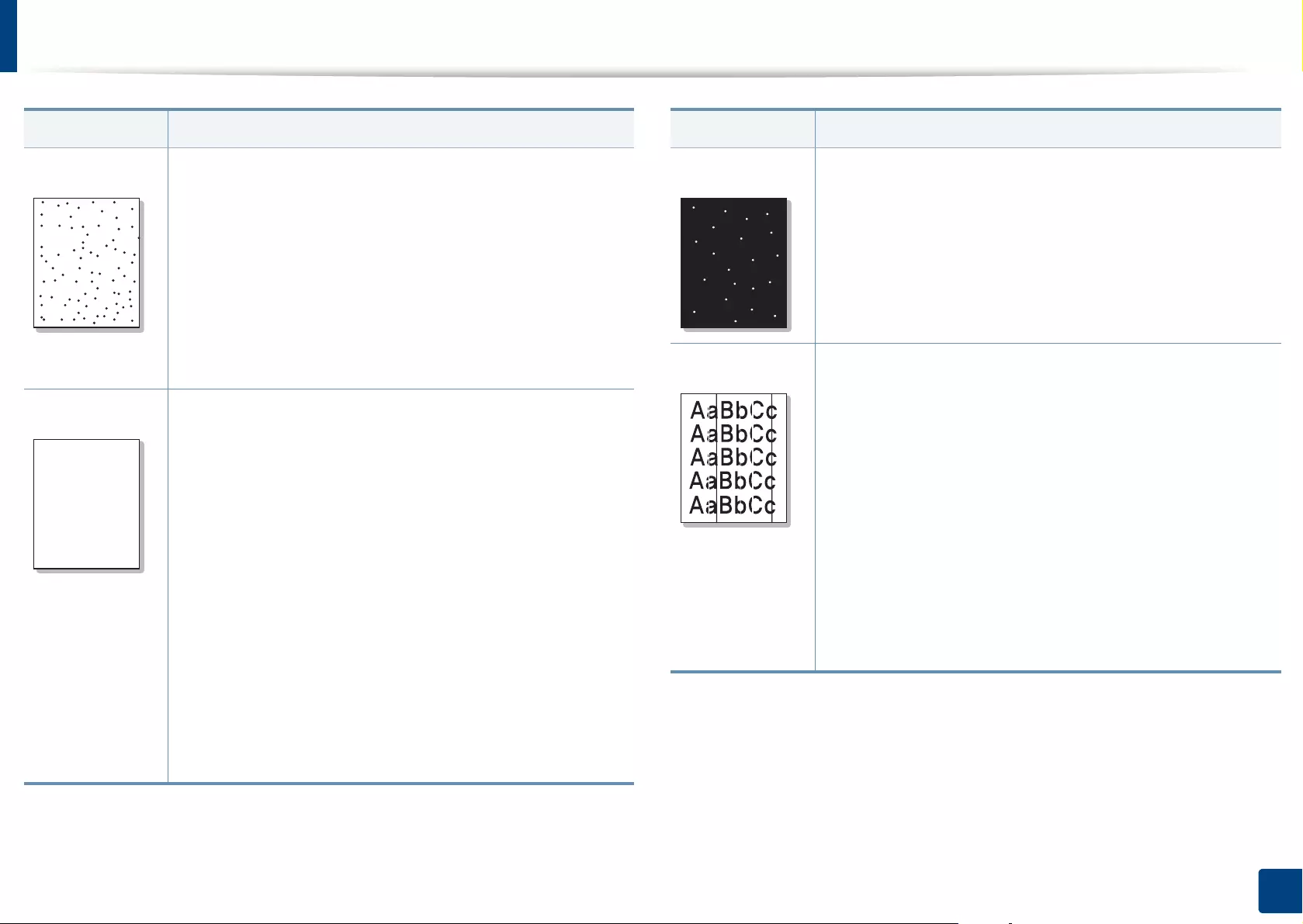
Solving other problems
385
15. Troubleshooting
Toner specks • The paper may not meet specifications; for example, the
paper may be too moist or rough (see "Print media
specifications" on page 399).
• The transfer roller may be dirty. Clean the inside of your
machine. Contact a service representative.
• The paper path may need cleaning. Contact a service
representative.
• Check the location of the machine. If the area is not well-
ventilated, this problem may occur.
Dropouts If faded areas, generally rounded, occur randomly on the
page:
• A single sheet of paper may be defective. Try reprinting
the job.
• The moisture content of the paper is uneven or the paper
has moist spots on its surface. Try a different brand of
paper (see "Print media specifications" on page 399).
• The paper lot is bad. The manufacturing processes can
cause some areas to reject toner. Try a different kind or
brand of paper.
• Change the printer option and try again. Go to Printing
Preferences, click Paper tab, and set type to thick paper
(see "Opening printing preferences" on page 96).
• If these steps do not correct the problem, contact a service
representative.
Condition Suggested Solutions
AaBbCc
AaBbCc
AaBbCc
AaBbCc
AaBbCc
AaBbC
AaBbC
AaBbC
AaBbC
AaBbC
White Spots If white spots appear on the page:
• The paper is too rough and a lot of dirt from a paper falls to
the inner devices within the machine, so the transfer roller
may be dirty. Clean the inside of your machine. Cleaning
the inside or contact a service representative.
• The paper path may need cleaning. Cleaning the inside or
contact a service representative.
Vertical lines If black vertical streaks appear on the page:
• The drum inside the printer has probably been scratched.
Remove the imaging unit and install a new one. Contact a
service representative.
If white vertical streaks appear on the page:
• The surface of the LSU part inside the machine may be
dirty. Cleaning the inside or contact a service
representative.
If vertical streaks appear on the page:
• The surface of the scanner glass and its white sheet may be
dirty. Cleaning the inside or contact a service
representative.
Condition Suggested Solutions
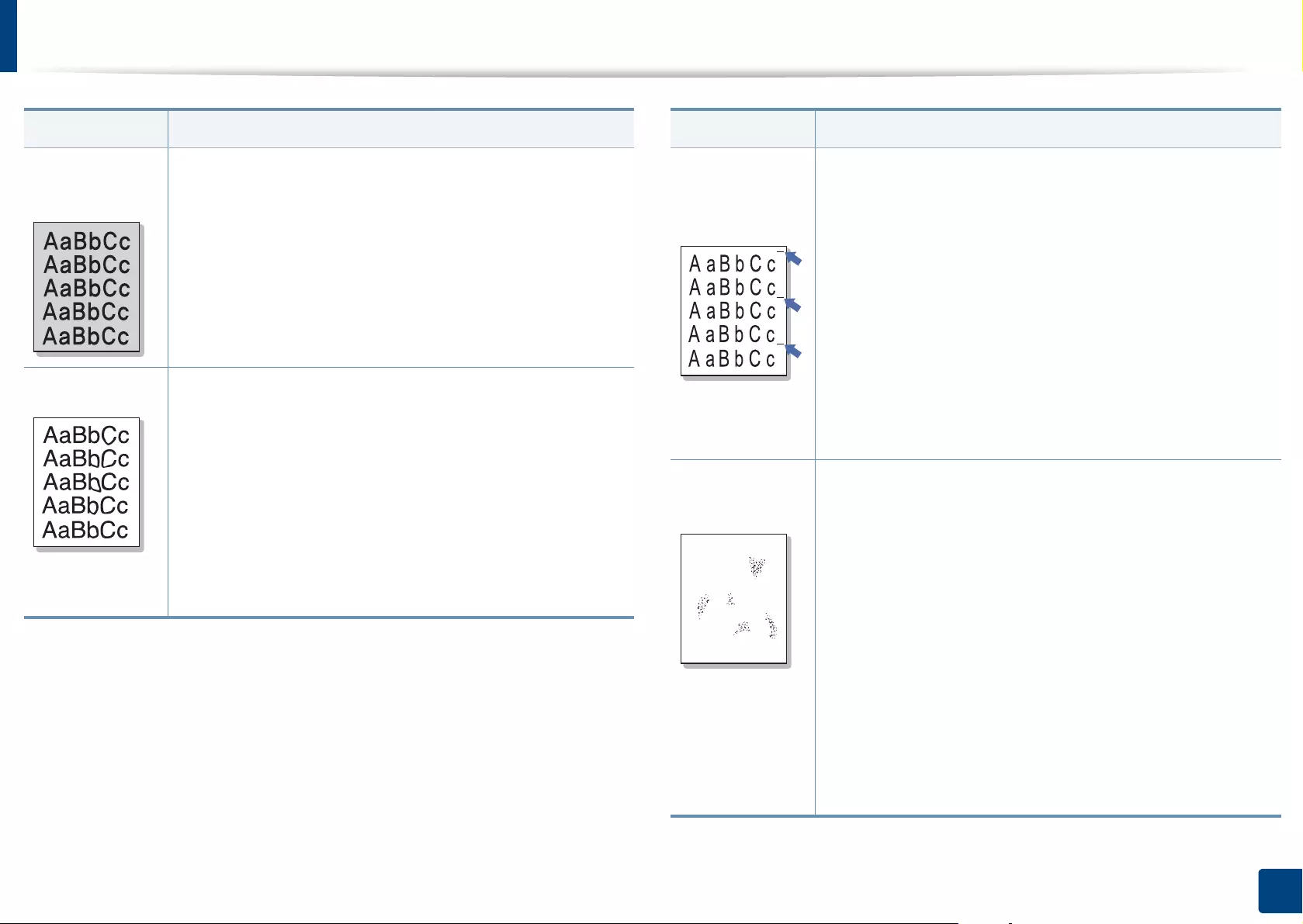
Solving other problems
386
15. Troubleshooting
Color or Black
background
If the amount of background shading becomes unacceptable:
• Change the image transfer belt if it has reached its lifespan.
Contact a service representative.
• Check the environmental conditions: very dry conditions
(low humidity) or a high level of humidity (higher than 80%
RH) can increase the amount of background shading.
• Remove the old toner cartridge and install a new one.
Toner smear If toner smears on the page:
• Clean the inside of the machine. Cleaning the inside or
contact a service representative.
• Check the paper type and quality (see "Print media
specifications" on page 399).
• Remove the imaging unit and install a new one. Contact a
service representative.
• Change the image transfer belt if it has reached its lifespan.
Contact a service representative.
Condition Suggested Solutions
Vertical
repetitive
defects
If marks repeatedly appear on the printed side of the page at
even intervals:
• The imaging unit may be damaged. If a repetitive mark
occurs on the page, run a cleaning sheet through several
times to clean the imaging unit. Cleaning the inside. If you
still have the same problems, remove the imaging unit and
install a new one. Contact a service representative.
• Parts of the machine may have toner on them. If the
defects occur on the back of the page, the problem will
likely correct itself after a few more pages.
• The fusing assembly may be damaged. Contact a service
representative.
Background
scatter
Background scatter results from bits of toner randomly
distributed on the printed page.
• The paper may be too damp. Try printing with a different
batch of paper. Do not open packages of paper until
necessary so that the paper does not absorb too much
moisture.
• If background scatter occurs on an envelope, change the
printing layout to avoid printing over areas that have
overlapping seams on the reverse side. Printing on seams
can cause problems.
• If background scatter covers the entire surface area of a
printed page, adjust the print resolution through your
software application or in Printing Preferences (see
"Opening printing preferences" on page 96).
Condition Suggested Solutions
A
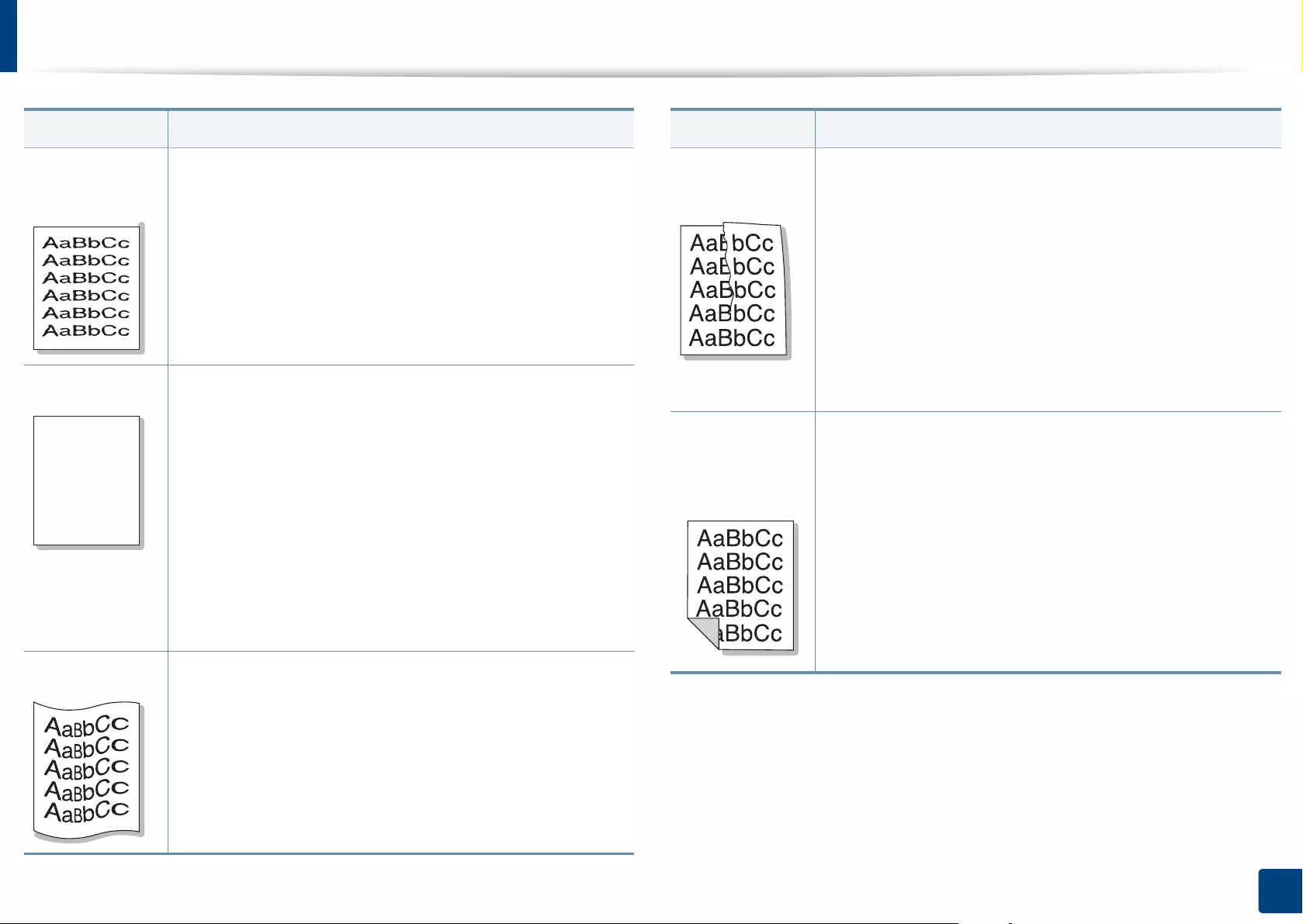
Solving other problems
387
15. Troubleshooting
Misformed
characters
• If characters are improperly formed and producing hollow
images, the paper stock may be too slick. Try different
paper (see "Print media specifications" on page 399).
• If characters are improperly formed and producing a wavy
effect, the scanner unit may need service. Cleaning the
scan unit or contact a service representative.
Page skew • Ensure that the paper is loaded properly.
• Check the paper type and quality (see "Print media
specifications" on page 399).
• Ensure that the paper or other material is loaded correctly
and the guides are not too tight or too loose against the
paper stack.
• Ensure that the standard tray right bottom door, dual
cassette feeder right bottom door or high capacity feeder
right bottom door is securely closed. If the bottom doors
are not completely closed, open and close the bottom
doors.
Curl or wave • Ensure that the paper is loaded properly.
• Check the paper type and quality. Both high temperature
and humidity can cause paper curl (see "Print media
specifications" on page 399).
• Turn the stack of paper over in the tray. Also try rotating
the paper 180° in the tray.
Condition Suggested Solutions
AaBbC
AaBbC
AaBbC
AaBbC
AaBbCc
Wrinkles or
creases
• Ensure that the paper is loaded properly.
• Check the paper type and quality (see "Print media
specifications" on page 399).
• Turn the stack of paper over in the tray. Also try rotating
the paper 180° in the tray.
• Ensure that the standard tray right bottom door, dual
cassette feeder right bottom door or high capacity feeder
right bottom door is securely closed. If the bottom doors
are not completely closed, open and close the bottom
doors.
Back of
printouts are
dirty
Check for leaking toner. Clean the inside of the machine.
Cleaning the inside or contact a service representative.
Condition Suggested Solutions
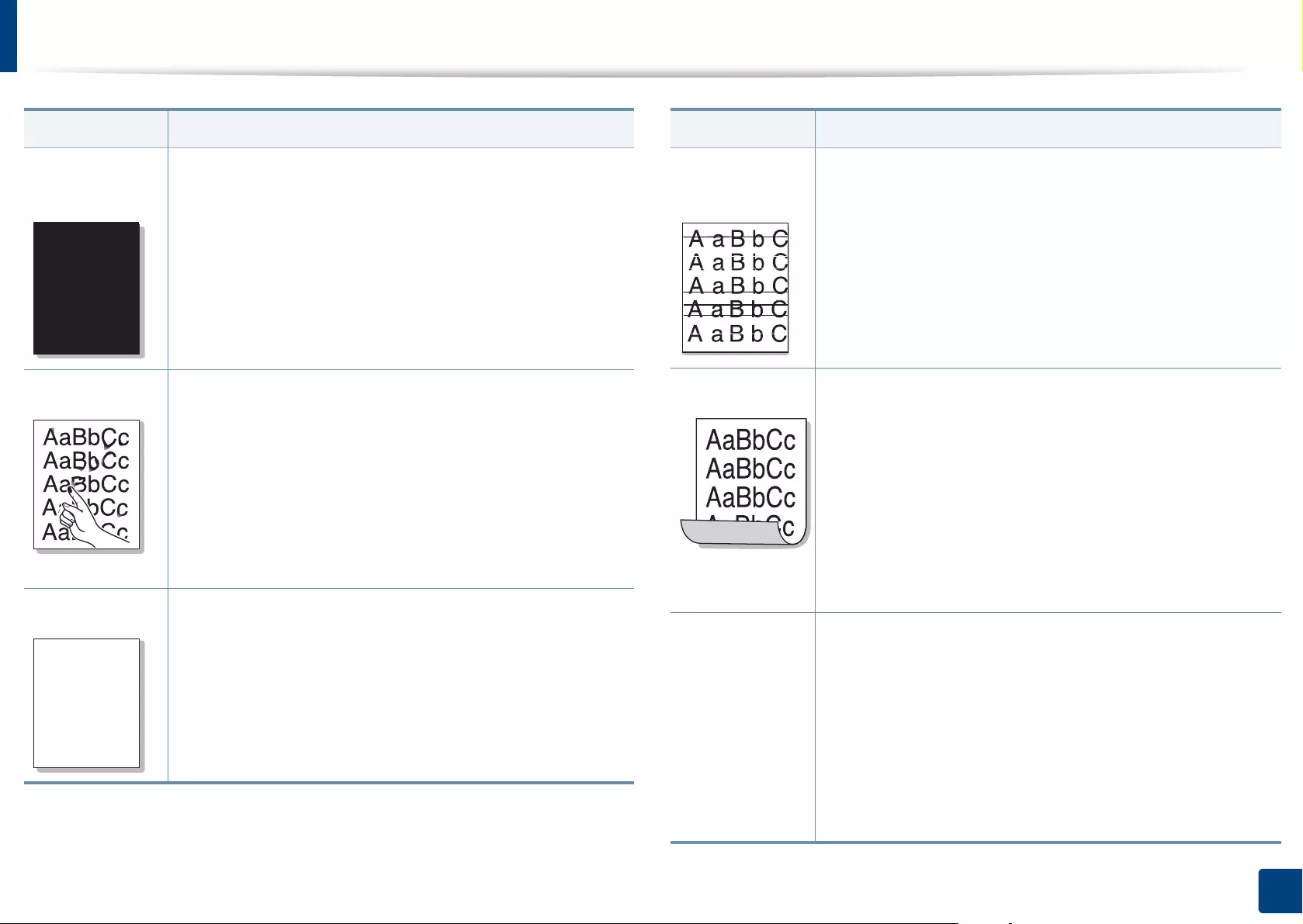
Solving other problems
388
15. Troubleshooting
Solid Color or
Black pages
• The imaging unit may not be installed properly. Remove
the imaging unit and reinsert it.
• The imaging unit may be defective and need replacing.
Remove the imaging unit and install a new one. Contact a
service representative.
• The machine may require repair. Contact a service
representative.
Loose toner • Clean the inside of the machine. Cleaning the inside or
contact a service representative.
• Check the paper type and quality (see "Print media
specifications" on page 399).
• Remove the imaging unit and install a new one. Contact a
service representative.
• If the problem persists, the machine may require repair.
Contact a service representative.
Character Voids Character voids are white areas within parts of characters that
should be solid black:
• You may be printing on the wrong surface of the paper.
Remove the paper and turn it around.
• The paper may not meet paper specifications (see "Print
media specifications" on page 399).
Condition Suggested Solutions
A
A
Horizontal
stripes
If horizontally aligned black streaks or smears appear:
• The imaging unit may be installed improperly. Remove the
imaging unit and reinsert it.
• The imaging unit may be defective. Remove the imaging
unit and install a new one. Contact a service
representative.
• If the problem persists, the machine may require repair.
Contact a service representative.
Curl If the printed paper is curled or paper does not feed into the
machine:
• Turn the stack of paper over in the tray. Also try rotating
the paper 180° in the tray.
• Change the printer option and try again. Go to Printing
Preferences, click Paper tab, and set type to thin paper
(see "Opening printing preferences" on page 96).
• In high humidity areas, do not leave paper in the machine
for extended periods of time.
An unknown
image
repetitively
appears on a
few sheets or
loose toner,
light print, or
contamination
occurs.
Your machine is probably being used at an altitude of 1,000 m
(3,281 ft) or above.
The high altitude may affect the print quality, such as loose
toner or light imaging. Change the correct altitude setting to
your machine.
Condition Suggested Solutions
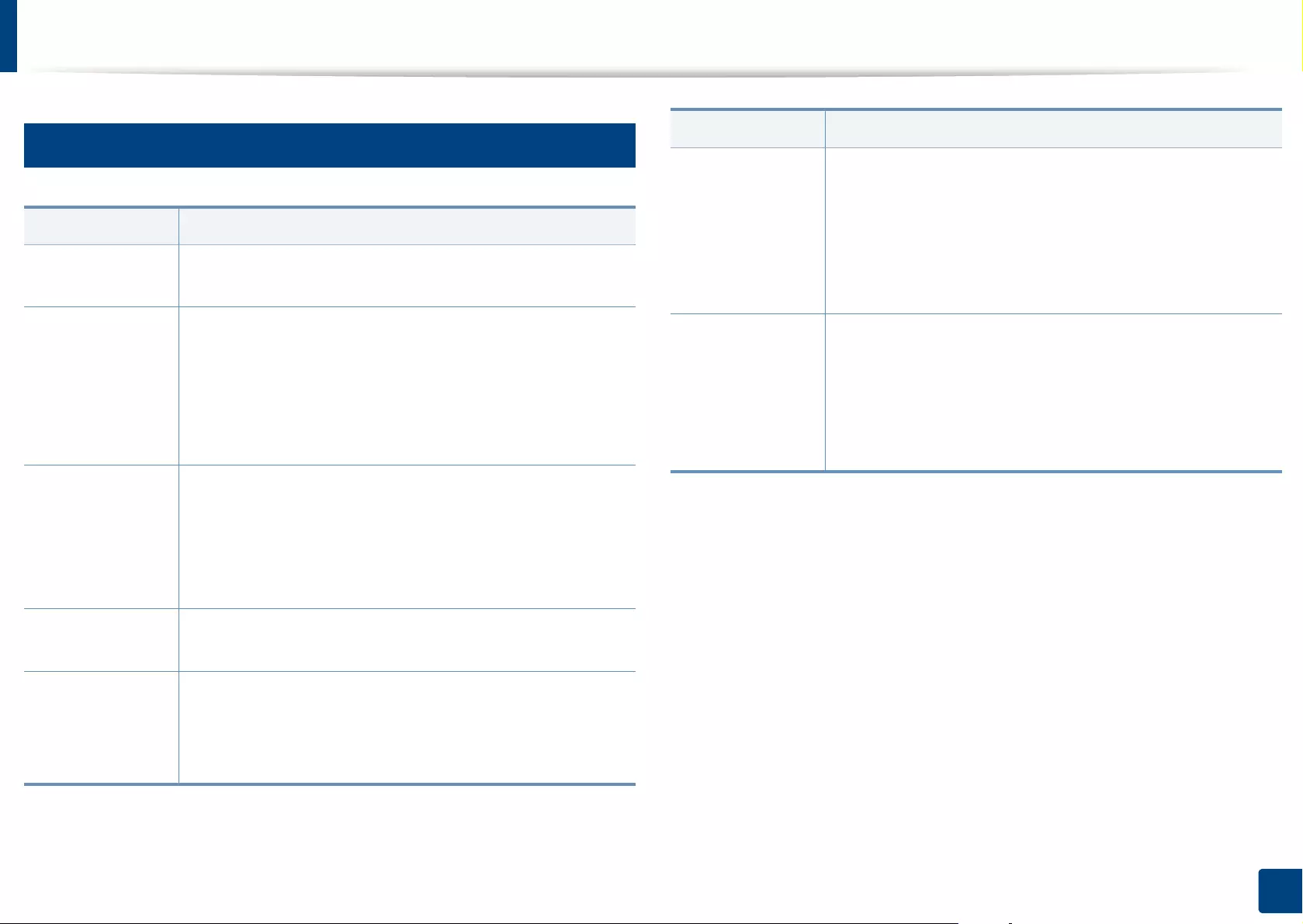
Solving other problems
389
15. Troubleshooting
18
Copying problems
Condition Suggested solution
Copies are too
light or too dark
Adjust the darkness in the copy to lighten or darken the
background of the copies.
Smears, lines,
marks, or spots
appear on copies.
• If the defects appear on the original, decrease the
darkness in the copy to lighten the background of your
copies.
• If there are no defects on the original, clean the scan unit.
Cleaning the scan unit or contact a service
representative.
Copy image is
skewed.
• Ensure that the original is face down on the scanner glass
or face up in the RADF.
• Check that the copy paper is loaded correctly.
• If the problem persists, the machine may require repair.
Contact a service representative.
Blank copies
print out.
Ensure that the original is face down on the scanner glass or
face up in the RADF.
Image rubs off
the copy easily.
• Replace the paper in the tray with paper from a new
package.
• In high humidity areas, do not leave paper in the machine
for extended periods of time.
Frequent copy
paper jams occur.
• Fan the stack of paper, then turn it over in the tray.
Replace the paper in the tray with a fresh supply. Check/
adjust the paper guides, if necessary.
• Ensure that the paper is the proper paper weight.
• Check for copy paper or pieces of copy paper remaining
in the machine after a paper jam has been cleared.
Toner cartridge
produces fewer
copies than
expected before
running out of
toner.
• Your originals may contain pictures, solids, or heavy lines.
For example, your originals may be forms, newsletters,
books, or other documents that use more toner.
• The RADF may be left open while copies are being made.
• The machine may be turned on and off frequently.
Condition Suggested solution
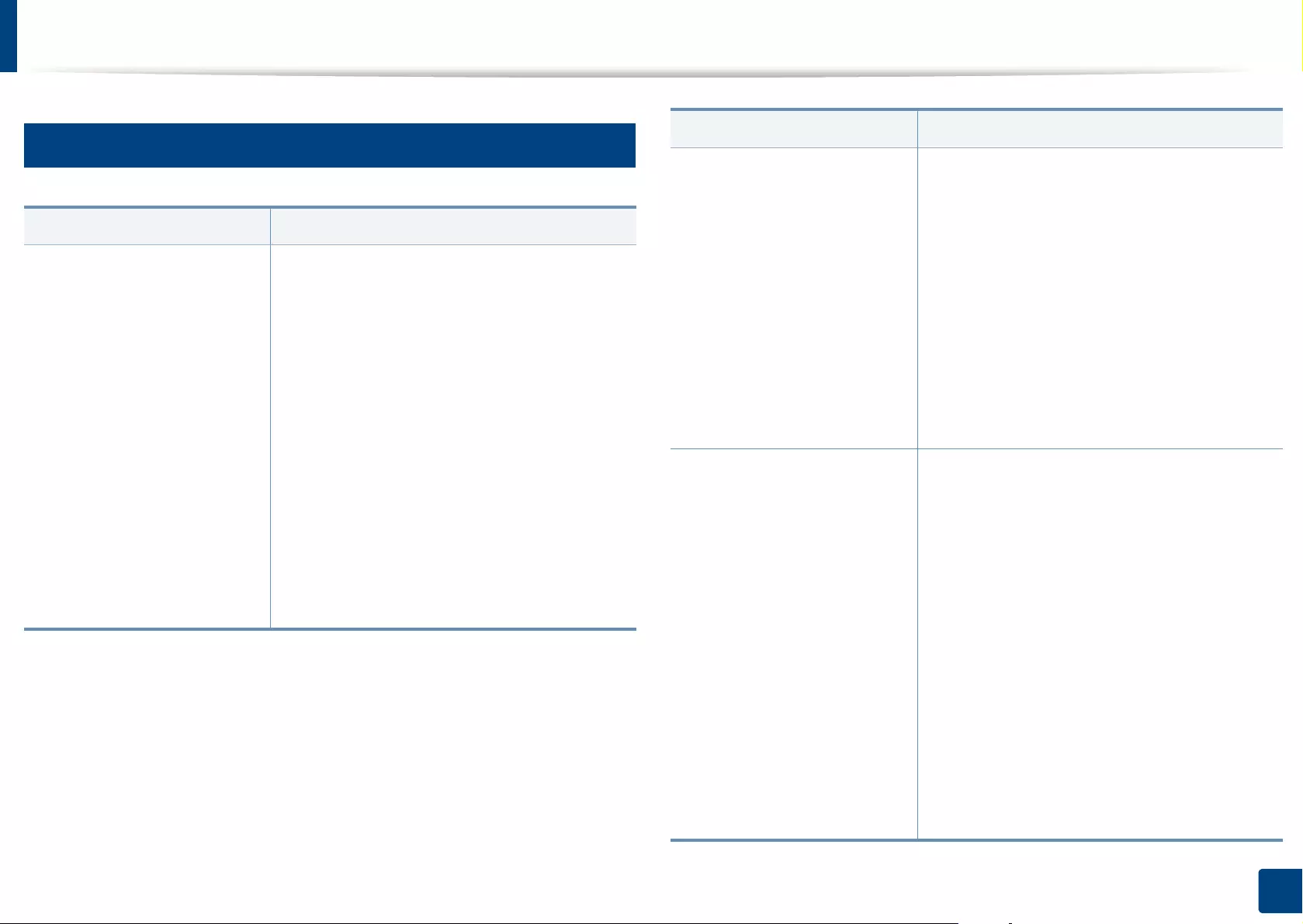
Solving other problems
390
15. Troubleshooting
19
Scanning problems
Condition Suggested solutions
The scanner does not work. • Make sure that you place the original to be
scanned face down on the scanner glass, or
face up in the RADF.
• There may not be enough available memory
to hold the document you want to scan. Try
the Prescan function through scan programs
to see if that works. Try lowering the scan
resolution rate.
• Check that the machine cable is connected
properly.
• Make sure that the machine cable is not
defective. Switch the cable with a known
good cable. If necessary, replace the cable.
• Check that the scanner is configured
correctly.
The unit scans very slowly. • Check if the machine is printing received
data. If so, scan the document after the
received data has been printed.
• Graphics are scanned more slowly than text.
• Communication speed slows in scan mode
because of the large amount of memory
required to analyze and reproduce the
scanned image. Set your computer to the
ECP printer mode through BIOS setting. It
will help to increase the speed. For details
about how to set BIOS, refer to your
computer user’s guide.
Message appears on your
computer screen:
•Device can’t be set to the
H/W mode you want.
•Port is being used by
another program.
•Port is Disabled.
•Scanner is busy receiving
or printing data. When the
current job is completed,
try again.
•Invalid handle.
•Scanning has failed.
• There may be a copying or printing job in
progress. Try your job again when that job is
finished.
• The selected port is currently being used.
Restart your computer and try again.
• The machine cable may be improperly
connected or the power may be off.
• The scanner driver is not installed or the
operating environment is not set up
properly.
• Ensure that the machine is properly
connected and the power is on, then restart
your computer.
• The USB cable may be improperly connected
or the power may be off.
Condition Suggested solutions
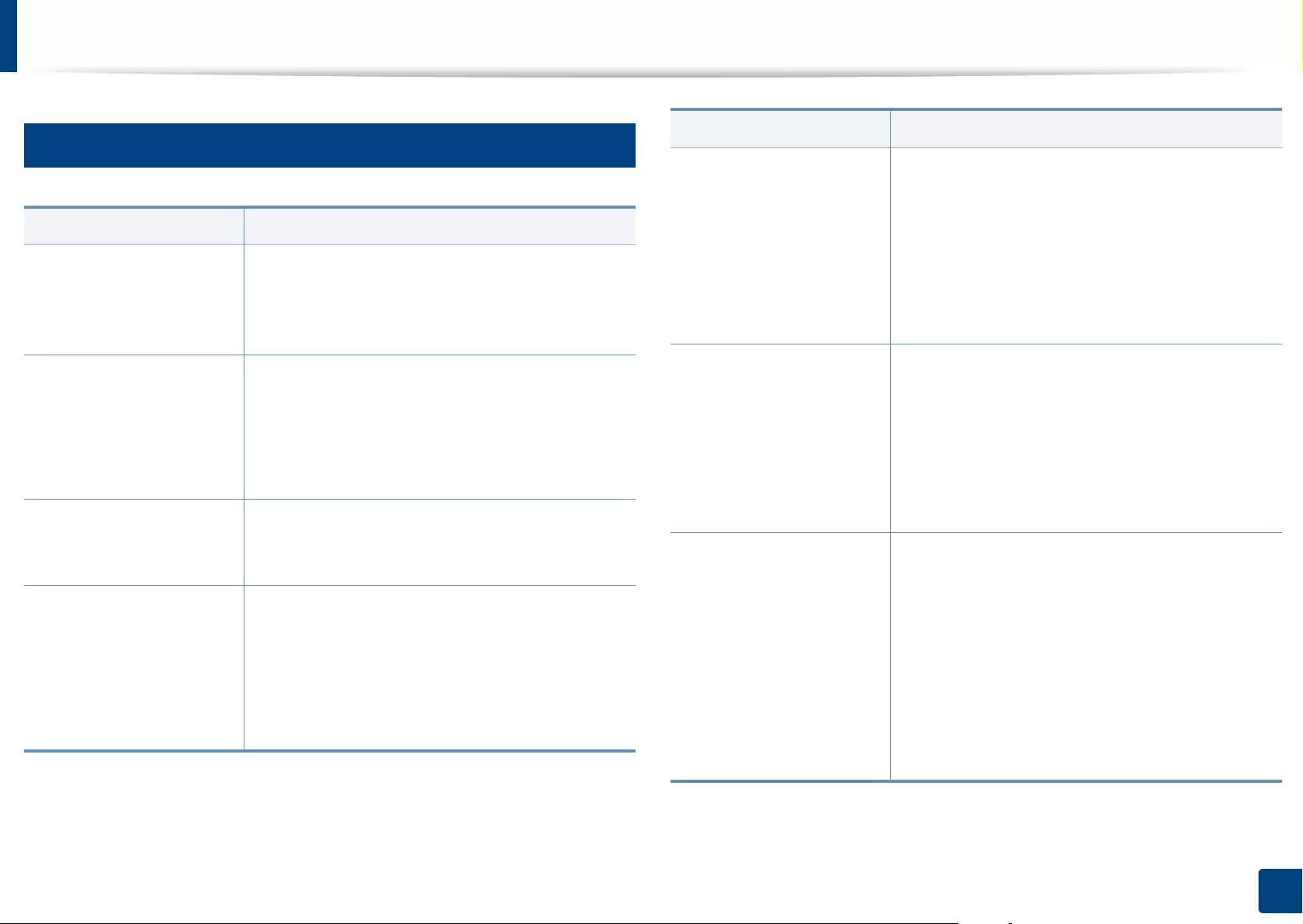
Solving other problems
391
15. Troubleshooting
20
Fax problems (optional)
condition suggested solutions
The machine is not
working, there is no
display, or the buttons
are not working.
• Unplug the power cord and plug it in again.
• Ensure that there is power being supplied to the
electrical outlet.
No dial tone sounds. • Check that the phone line is properly connected.
• Check that the phone socket on the wall is
working by plugging in another phone.
• Find the optimal line for communication (see
"Fax Settings" on page 254).
The numbers stored in
memory do not dial
correctly.
Make sure that the numbers are stored in memory
correctly.
The original does not feed
into the machine.
• Make sure that the paper is not wrinkled and you
are inserting it in correctly. Check that the
original is the right size, not too thick or thin.
• Make sure that the RADF is firmly closed.
• The RADF rubber pad may need to be replaced.
Contact a service representative.
Faxes are not received
automatically.
• The receiving mode should be set to fax.
• Make sure that there is paper in the tray.
• Check to see if the display shows any error
message. If it does, clear the problem
• Find the optimal line for communication. To
check that, see Smart Fax Diagnostics menu
(see "Fax Settings" on page 254).
The machine does not
send.
• Make sure that the original is loaded in the RADF
or on the scanner glass.
• Check the recipient’s fax machine (if it has a
problem).
• Find the optimal line for communication. To
check that, see Smart Fax Diagnostics menu
(see "Fax Settings" on page 254).
The incoming fax has
blank spaces or is of poor-
quality.
• The fax machine sending you the fax may be
faulty.
• A noisy phone line can cause line errors.
• Check your machine by making a copy.
• The toner cartridge may be empty. Replace the
toner cartridge.
• Find the optimal line for communication. To
check that, see Smart Fax Diagnostics menu
(see "Fax Settings" on page 254).
condition suggested solutions
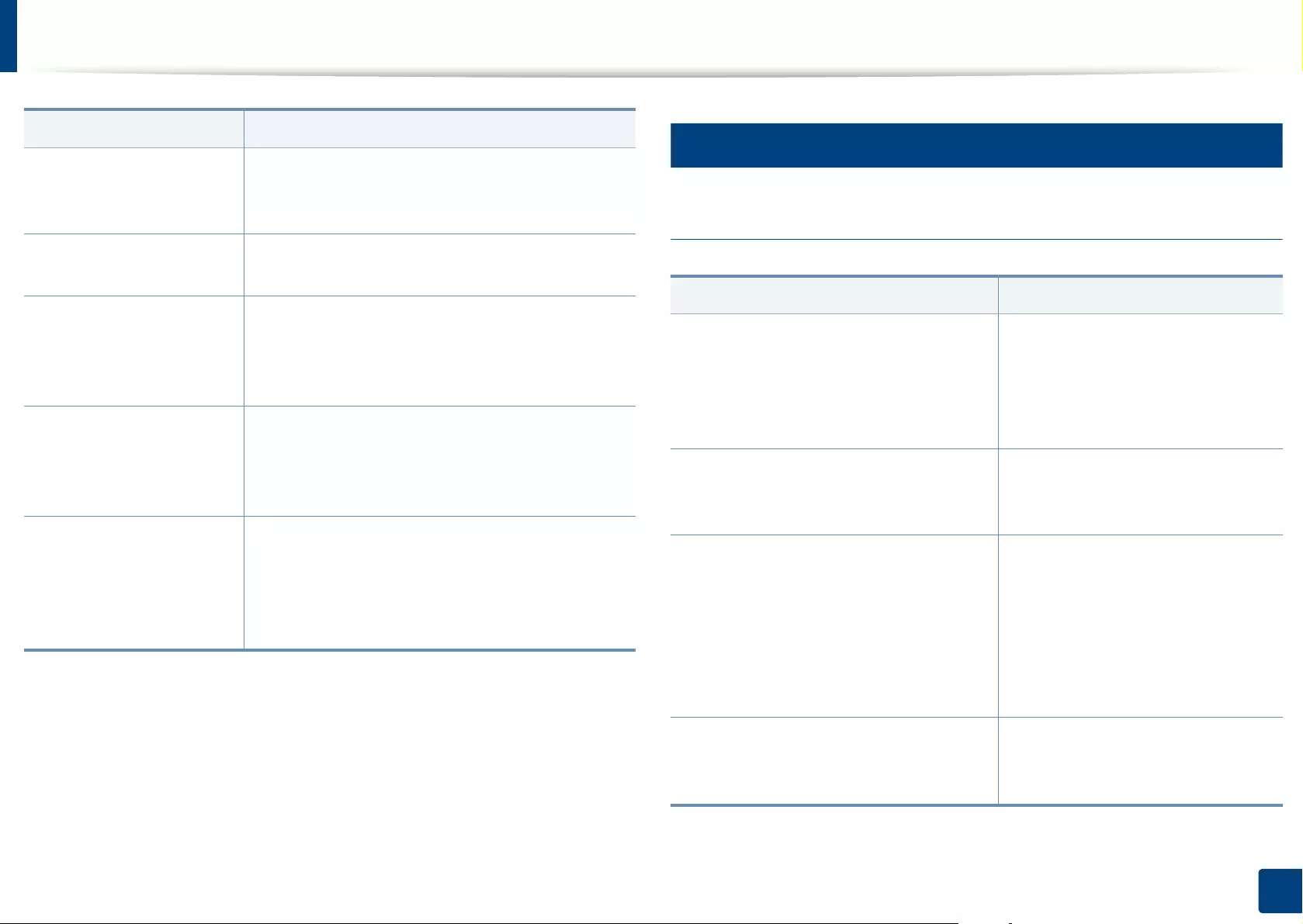
Solving other problems
392
15. Troubleshooting
21
Operating system problems
Common Windows problems
Some of the words on an
incoming fax are
stretched.
The fax machine sending the fax had a temporary
document jam.
There are lines on the
originals you sent.
Check your scan unit for marks and clean it.
Cleaning the scan unit.
The machine dials a
number, but the
connection with the other
fax machine fails.
The other fax machine may be turned off, out of
paper, or cannot answer incoming calls. Speak with
the other machine operator and ask her/him to
solve out the problem.
Faxes do not store in
memory.
There may not be enough memory space to store
the fax. If the display indicating the memory status
shows, delete any faxes you no longer need from
the memory, and then try to store the fax again.
Blank areas appear at the
bottom of each page or
on other pages, with a
small strip of text at the
top
You may have chosen the wrong paper settings in
the user option setting.
condition suggested solutions
Condition Suggested solutions
“File in Use” message appears during
installation.
Exit all software applications.
Remove all software from the
startup group, then restart
Windows. Reinstall the printer
driver.
“General Protection Fault”, “Exception
OE”, “Spool 32”, or “Illegal Operation”
messages appear.
Close all other applications, reboot
Windows and try printing again.
“Fail To Print”, “A printer timeout error
occurred” message appear.
These messages may appear during
printing. Just keep waiting until the
machine finishes printing. If the
message appears in ready mode or
after printing has completed, check
the connection and/or whether an
error has occurred.
Samsung Printer Experience is not
shown when you click more settings.
Samsung Printer Experience is not
installed. Download the app from
the Windows Store and install it.
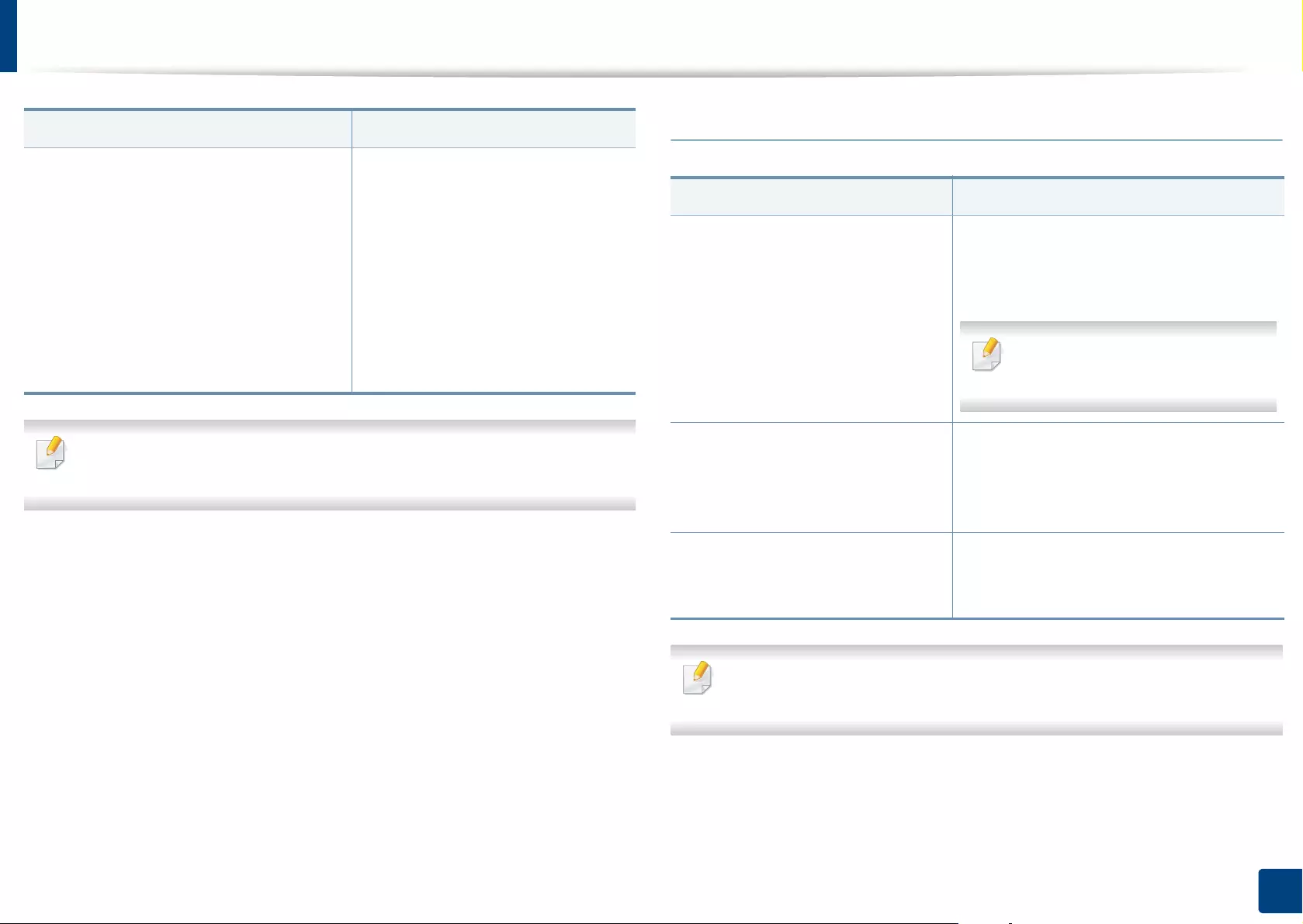
Solving other problems
393
15. Troubleshooting
Refer to the Microsoft Windows User’s Guide that came with your computer
for further information on Windows error messages.
Common Mac problems
Refer to the Mac User’s Guide that came with your computer for further
information on Mac error messages.
Machine information is not displayed
when you click the device in the Devices
and Printers.
Check the Printer properties. Click
the Ports tab.
(Control Panel > Devices and
Printers > Right-click on your
printer icon and select Printer
properties)
If the port is set to File or LPT,
uncheck them and select TCP/IP,
USB, or WSD.
Condition Suggested solutions
Condition Suggested solutions
The machine does not print PDF
files correctly. Some parts of
graphics, text, or illustrations are
missing.
Printing the PDF file as an image may
enable the file to print. Turn on Print As
Image from the Acrobat printing options.
It will take longer to print when you
print a PDF file as an image.
Some letters are not displayed
normally during cover page
printing.
Mac OS cannot create the font while
printing the cover page. The English
alphabet and numbers are displayed
normally on the cover page.
When printing a document in Mac
with Acrobat Reader 6.0 or
higher, colors print incorrectly.
Make sure that the resolution setting in
your machine driver matches the one in
Acrobat Reader.
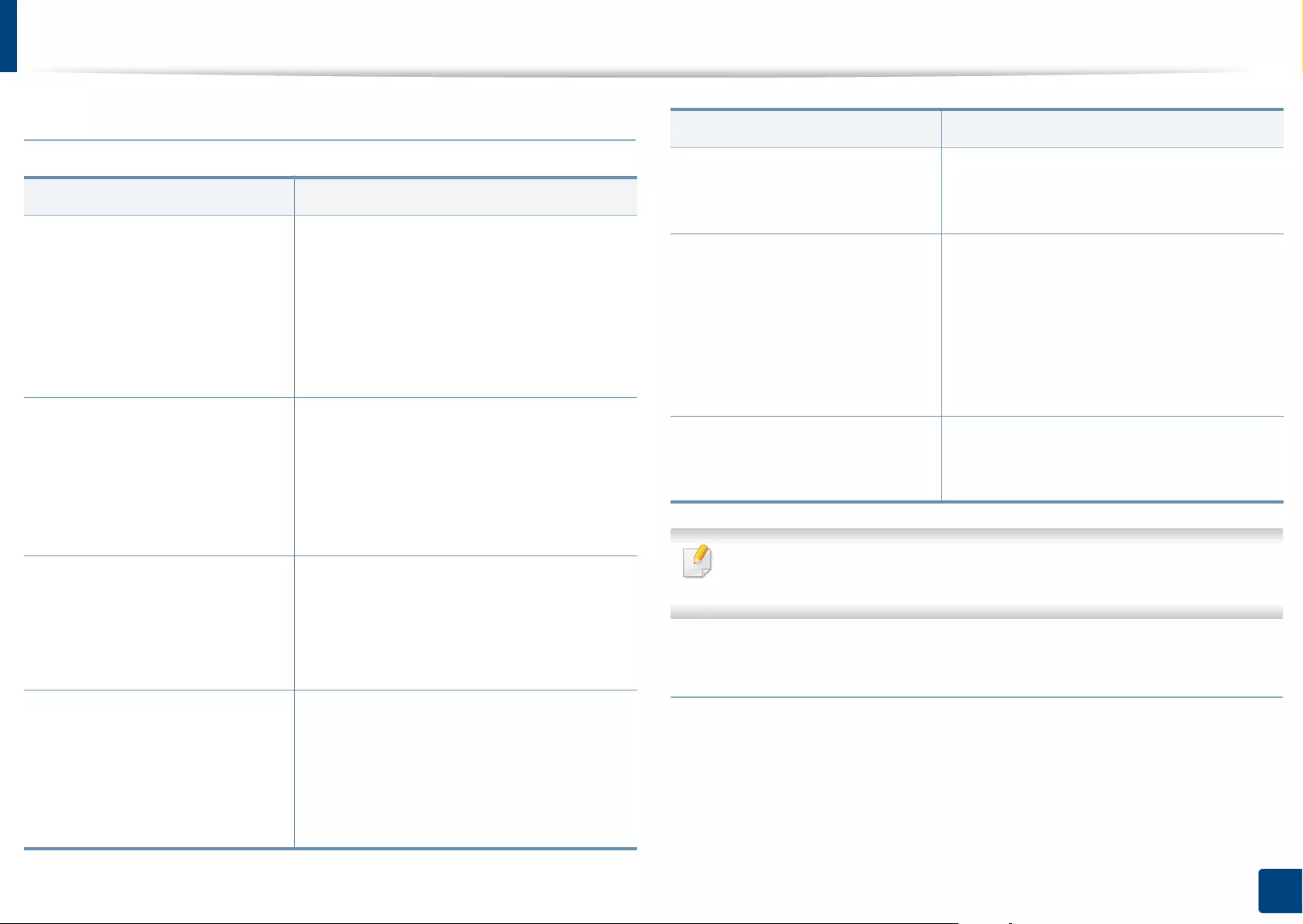
Solving other problems
394
15. Troubleshooting
Common Linux problems
Refer to the Linux User’s Guide that came with your computer for further
information on Linux error messages.
Common PostScript problems
The following situations are PS language specific and may occur when several
printer languages are used.
Condition Suggested solutions
There is no xsane nor simple-
scan application on my Linux
machine.
For some Linux distributions, there might be
no default scan application. To use scan
features, install one of scan applications
using download center supplied by the
OS(ex. Ubuntu Software Center for Ubuntu,
Install/Remove Software for openSUSE,
Software for Fedora).
Scanner can not be found via
network.
For some Linux distributions, strong firewall
is enabled and it may block our installer from
opening the necessary port for searching
network devices. In such a case, open the
snmp port - 22161 manually or disable the
firewall temporarily while using the device.
When printing more than one
copy, the second copy does not
print.
The problem occurs on Ubuntu 12.04 due to
the problem in standard CUPS filter
'pdftops'. Update 'cups-filters' package to
version 1.0.18 to fix the problem ('pdftops' is
a part of 'cups-filters' package).
Unchecking the collate option in
the Print Dialog does not work.
For some distributions, GNOME Print Dialog
has an issue handling the collate option. As
workaround, set the default value of collate
option to False using the system's printing
utility(execute "system-config-printer" in the
Terminal program).
Printing always works with
duplex.
This duplex issue was in Ubuntu 9.10 CUPS
package. Update CUPS version to 1.4.1-
5ubuntu2.2.
Printer is not added through
system's printing utility.
The problem occurs on Debian 7 due to the
defect in 'system-config-printer' package of
the Debian 7 (http://bugs.debian.org/cgi-
bin/bugreport.cgi?bug=662813 in Debian
bug tracking system). Please use another
way to add printer (CUPS WebUI for
example)
Paper size and orientation are
disabled in the Print Dialog
when opening text files.
The problem occurs on Fedora 19 and it's
related to 'leafpad' text editor on Fedora 19.
Please use other text editors like 'gedit'.
Condition Suggested solutions
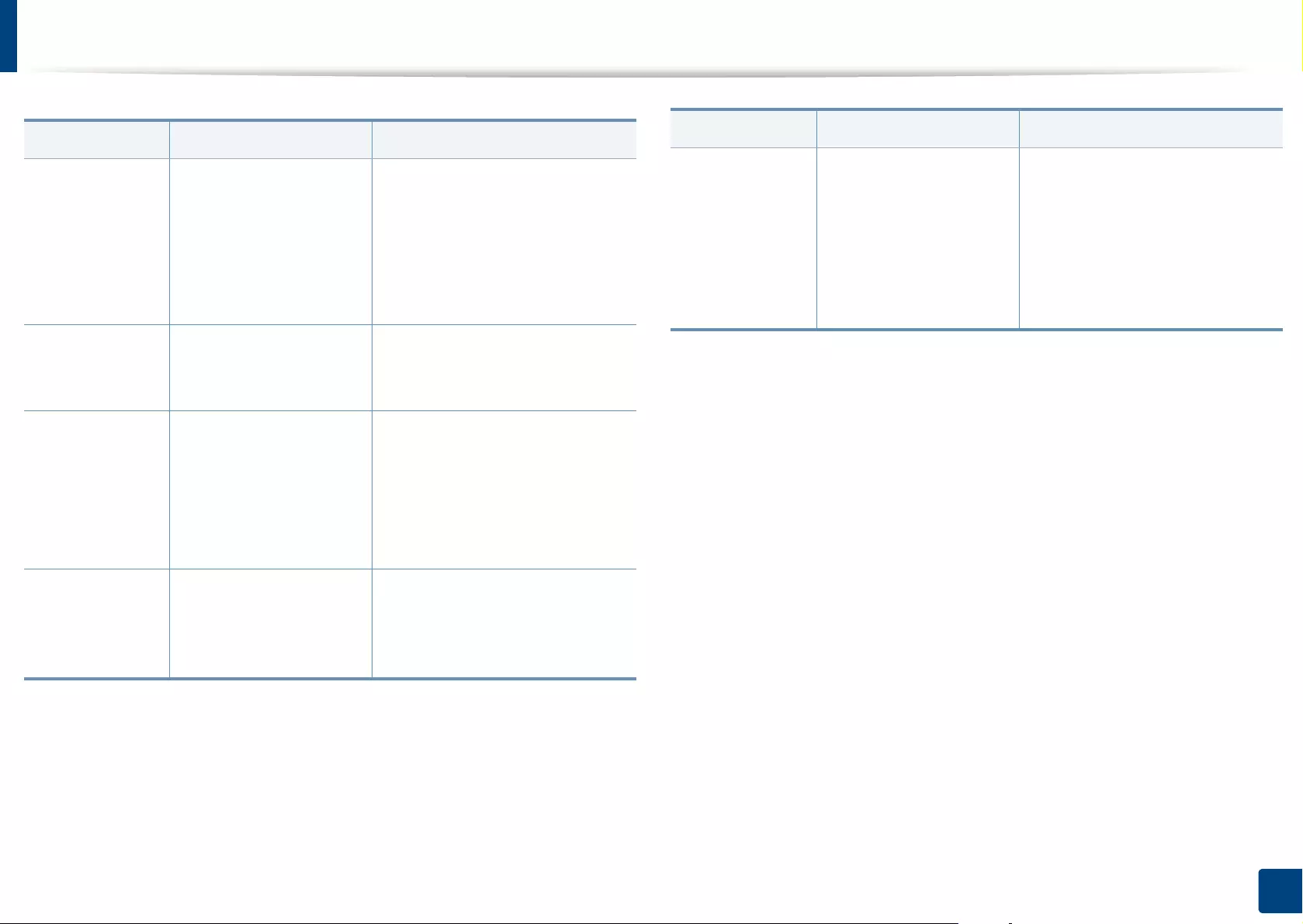
Solving other problems
395
15. Troubleshooting
Problem Possible cause Solution
The PostScript
file cannot be
printed
The PostScript driver may
not be installed correctly.
• Install the PostScript driver.
• Print a configuration page and
verify that the PS version is
available for printing.
• If the problem persists, contact
a service representative.
Limit Check
Error report
prints
The print job was too
complex.
You might need to reduce the
complexity of the page or install
more memory.
A PostScript
error page
prints
The print job may not be
PostScript.
Make sure that the print job is a
PostScript job. Check to see
whether the software application
expected a setup or PostScript
header file to be sent to the
machine.
The optional
tray is not
selected in the
driver
The printer driver has not
been configured to
recognize the optional
tray.
Open the PostScript driver
properties, select the Device
Options tab, and set the tray
option.
When printing a
document in
Mac with
Acrobat Reader
6.0 or higher,
colors print
incorrectly
The resolution setting in
the printer driver may
not be matched with the
one in Acrobat Reader.
Make sure that the resolution
setting in your printer driver
matches the one in Acrobat
Reader.
Problem Possible cause Solution
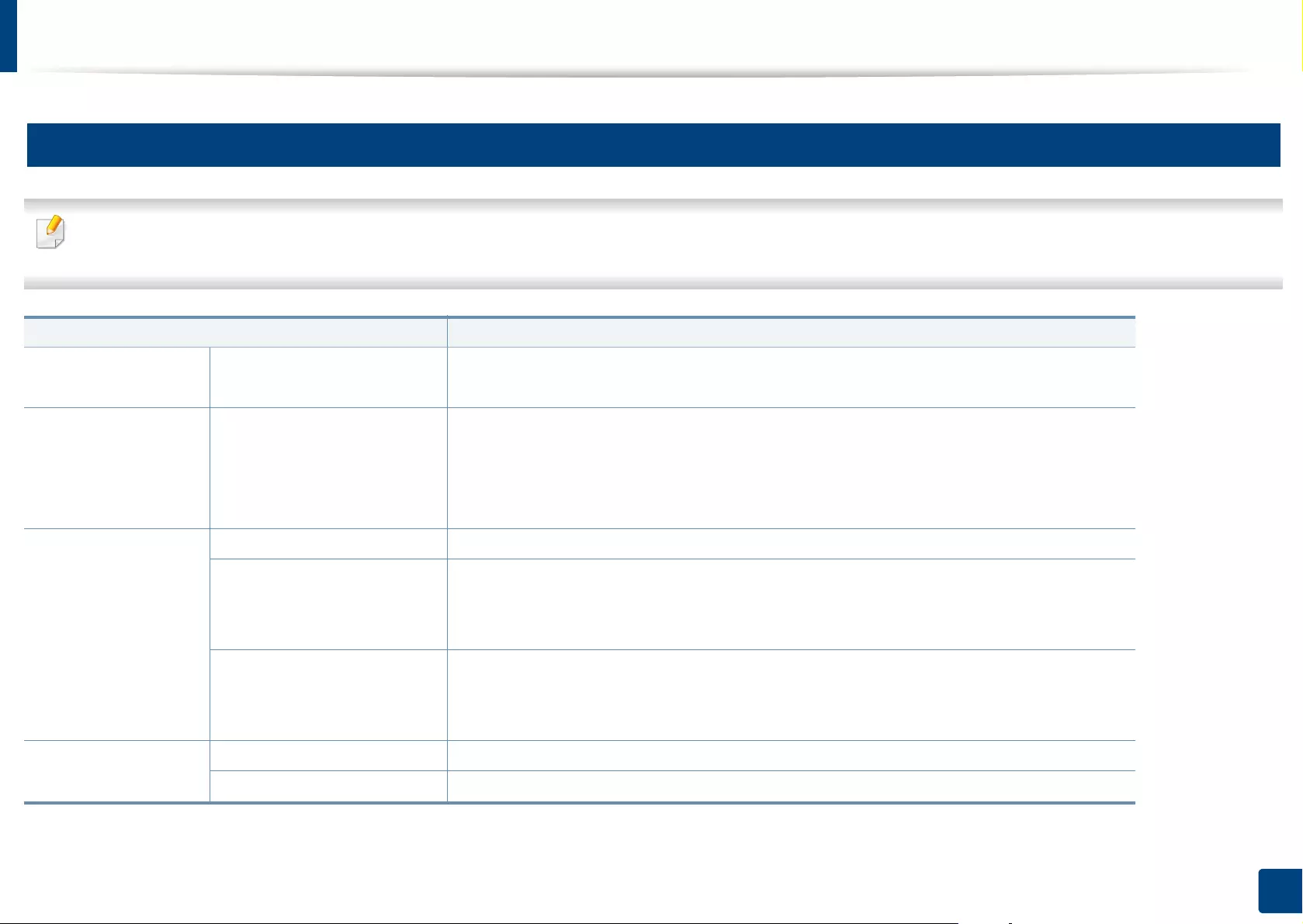
397
16. Appendix
Specifications
1
General specifications
These specifications are subject to change without notice. To see additional specifications and information about changes to the specifications, please visit,
www.samsung.com.
Items Description
DimensionaWidth x Depth x Height •X322x/ X328x series: 566 x 620 x 870 mm (22.28 x 24.41 x 34.25 inches)
•K325x/ K330x series: 566 x 620 x 820 mm (22.28 x 24.41 x 32.28 inches)
WeightaMachine with consumables •X322x series: 78.20 kg (172.40 lbs)
•X328x series: 78.70 kg (173.50 lbs)
•K325x series: 58.30 kg (128.53 lbs)
•K330x series: 59.00 kg (130.07 lbs)
Noise levelb cReady mode 30 dB (A)
Print mode •X322x series: 48 dB (A)
•X328x/ K325x series: 50 dB (A)
•K330x series: 51 dB (A)
Copy mode •X322x/ K325x series: 53 dB (A)
•X328x series: 54 dB (A)
•K330x series: 55 dB (A)
Temperature Operation 10 to 30 °C (50 to 86 °F)
Storage (packed) -20 to 40 °C (-4 to 104 °F)
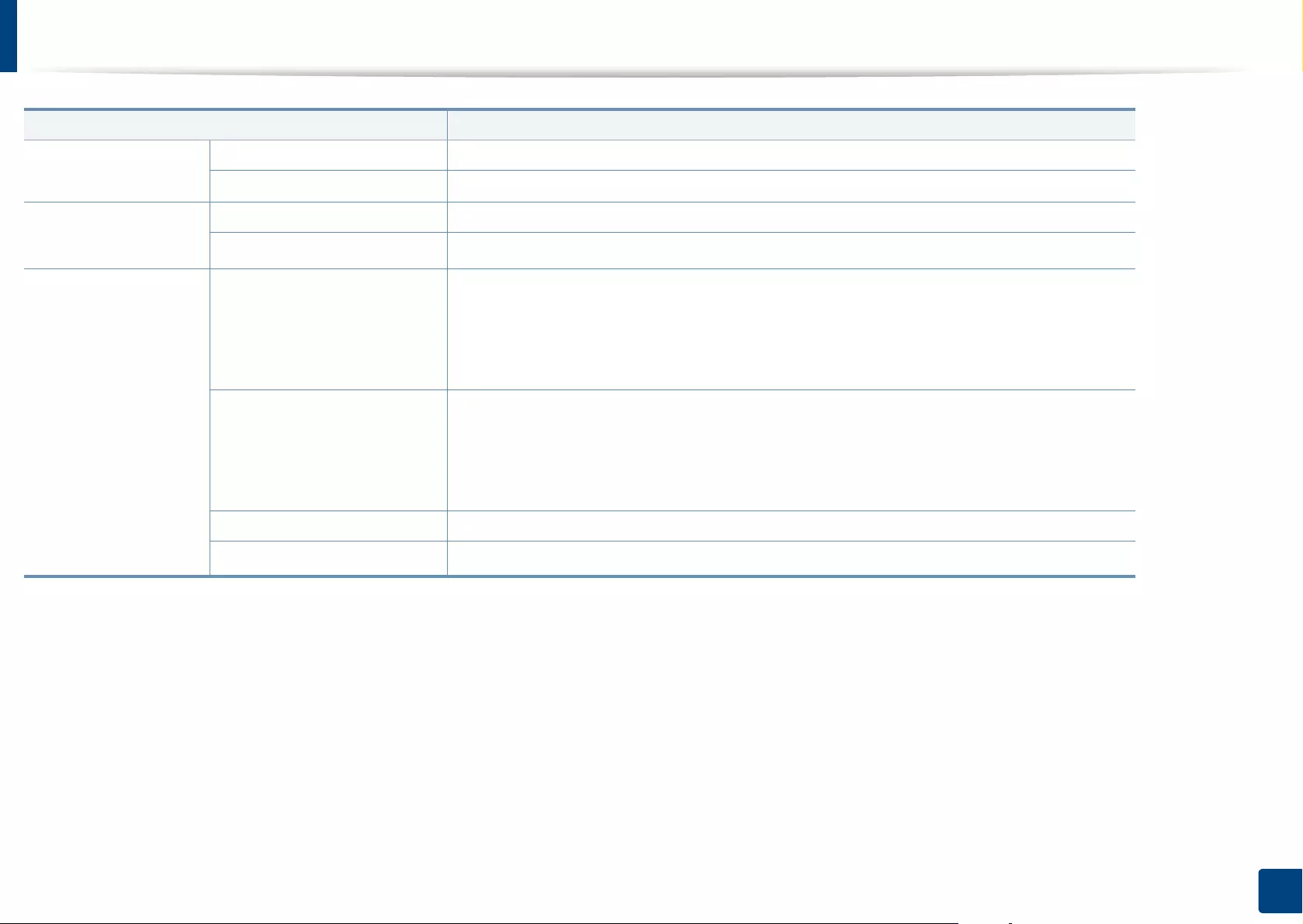
Specifications
398
16. Appendix
Humidity Operation 20 to 80% RH
Storage (packed) 10 to 90% RH
Power ratingd110 volt models AC 110 - 127 V
220 volt models AC 220 - 240 V
Power consumptioneAverage operating mode •X322x series: Less than 480 W
•X328x series: Less than 560 W
•K325x series: Less than 550 W
•K330x series: Less than 590 W
Ready mode •X322x series: Less than 60 W
•X328x series: Less than 60 W
•K325x series: Less than 100 W
•K330x series: Less than 100 W
Power save mode Less than 1.5 W
Power off modefLess than 0 W
a. Dimensions and weight are measured without other accessories and toner cartridges.
b. Sound Pressure Level, ISO 7779. Configuration tested: basic machine installation, A4 paper, simplex printing.
c. China only: If the equipment's noise is louder than 63 dB (A), the equipment should be placed in region of relatively independent advice.
d. See the rating label on the machine for the correct voltage (V), frequency (hertz) and of current (A) for your machine.
e. The power consumption may be affected by the machine’s status, setting conditions, operating environment, and measuring equipment and method the country uses.
f. Power consumption can be completely avoided only when the power cable is not connected.
Items Description
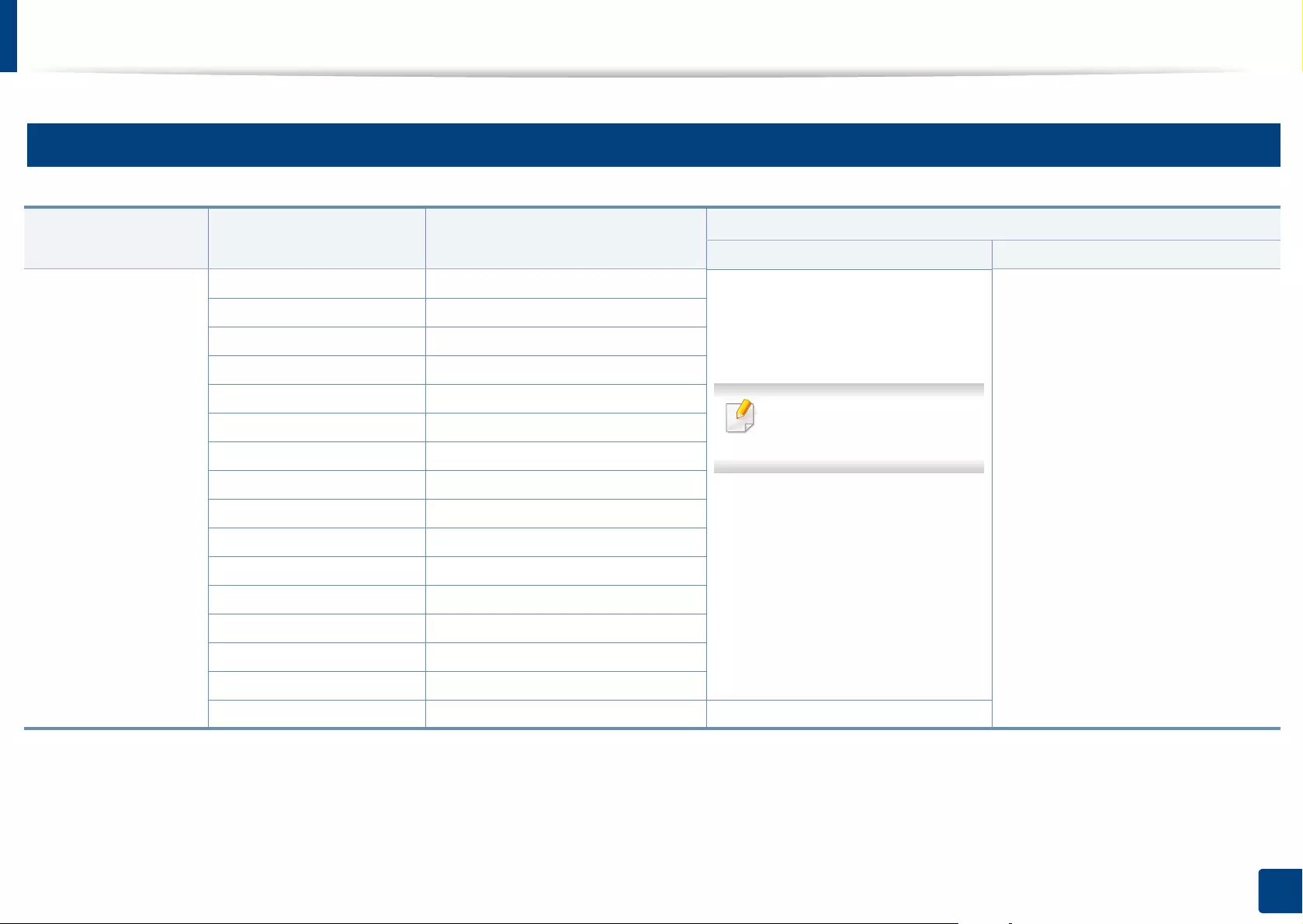
Specifications
399
16. Appendix
2
Print media specifications
Type Size Dimensions Print media weight/Capacity (Simplex)a
Tray1,2,3,4 Multipurpose tray
Plain paper Letter 216 x 279 mm (8.5 x 11 inches) 70 to 90 g/m2 (19 to 24 lb bond)
• 520 sheets of 80g/m2 (20 lb bond)
for each tray
A3, Ledger and 8K are not
supported in Tray1.
70 to 90 g/m2 (19 to 24 lb bond)
• 100 sheets of 80 g/m2 (20 lb bond)
Ledger 279 x 432 mm (11 x 17 inches)
Legal 216 x 356 mm (8.5 x 14 inches)
Executive 184 x 267 mm (7.25 x 10.5 inches)
Statement 140 x 216 mm (5.5 x 8.5 inches)
A3 297 x 420 mm (11.7 x 16.5 inches)
A4 210 x 297 mm (8.27 x 11.7 inches)
A5 148 x 210 mm (5.85 x 8.27 inches)
B4 257 x 364 mm (10.1 x 14.3 inches)
JIS B5 182 x 257 mm (7.16 x 10.11 inches)
ISO B5 176 x 250 mm (6.93 x 9.84 inches)
US Folio 216 x 330 mm (8.5 x 13 inches)
Oficio 216 x 343 mm (8.5 x 13.5 inches)
8K 270 x 390 mm (10.75 x 15.5 inches)
16K 195 x 270 mm (7.76 x 10.75 inches)
A6 105 x 148 mm (4.13 x 5.82 inches) Not available in tray1,2,3,4
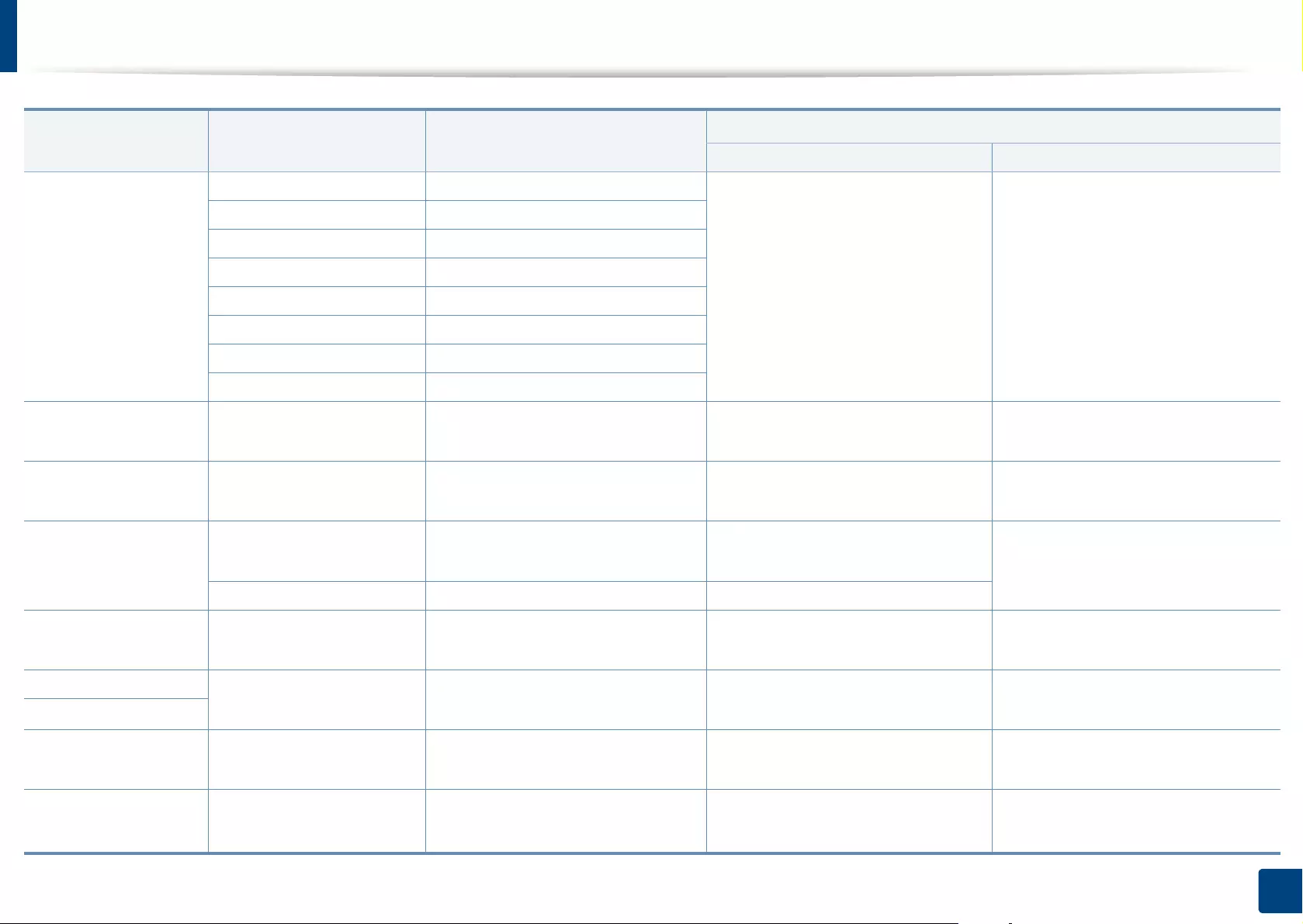
Specifications
400
16. Appendix
Envelope Letter, A4 Refer to the Plain paper section Not available in tray1,2,3,4 75 to 90 g/m2 (20 to 24 lb bond)
• 10 sheets
Envelope Monarch 98 x 191 mm (3.87 x 7.5 inches)
Envelope No. 10 105 x 241 mm (4.12 x 9.5 inches)
Envelope No. 9 98 x 225 mm (3.87 x 8.87 inches)
Envelope DL 110 x 220 mm (4.33 x 8.66 inches)
Envelope C5 162 x 229 mm (6.37 x 9.01 inches)
Envelope C6 114 x 162 mm (4.48 x 6.38 inches)
Envelope C4 229 x 324 mm (9.01 x 12.75 inches)
Thick paper Refer to the Plain paper
section
Refer to the Plain paper section 91 to 105 g/m2 (25 to 28 lb bond)
• 400 sheets for each tray
91 to 105 g/m2 (25 to 28 lb bond)
• 50 sheets
Thin paper Refer to the Plain paper
section
Refer to the Plain paper section 60 to 69 g/m2 (16 to 18 lb bond)
• 520 sheets
60 to 69 g/m2 (16 to 18 lb bond)
•100 sheets
Heavy weight paper Refer to the Plain paper
section
Refer to the Plain paper section 106 to 176 g/m2 (29 to 47 lb bond)
• 250 sheets
106 to 176 g/m2 (29 to 47 lb bond)
• 20 sheets
Postcard 4x6 101.6 x 152.4 mm (4 x 6 inches) -
Extra Heavy weight Refer to the Plain paper
section
Refer to the Plain paper section 177 to 220 g/m2 (47 to 59 lb bond)
• 200 sheets
Not available in multipurpose tray
Cotton Refer to the Plain paper
section
Refer to the Plain paper section 75 to 90 g/m2 (20 to 24 lb bond)
• 400 sheets
75 to 90 g/m2 (20 to 24 lb bond)
• 50 sheets
Colored / Pre-printed
Letter head / Hole
punched
Refer to the Plain paper
section
Refer to the Plain paper section 75 to 90 g/m2 (20 to 24 lb bond)
• 350 sheets
75 to 90 g/m2 (20 to 24 lb bond)
• 20 sheets
Recycled Refer to the Plain paper
section
Refer to the Plain paper section 60 to 90 g/m2 (16 to 24 lb bond)
• 400 sheets
60 to 90 g/m2 (16 to 24 lb bond)
•100 sheets
Type Size Dimensions Print media weight/Capacity (Simplex)a
Tray1,2,3,4 Multipurpose tray
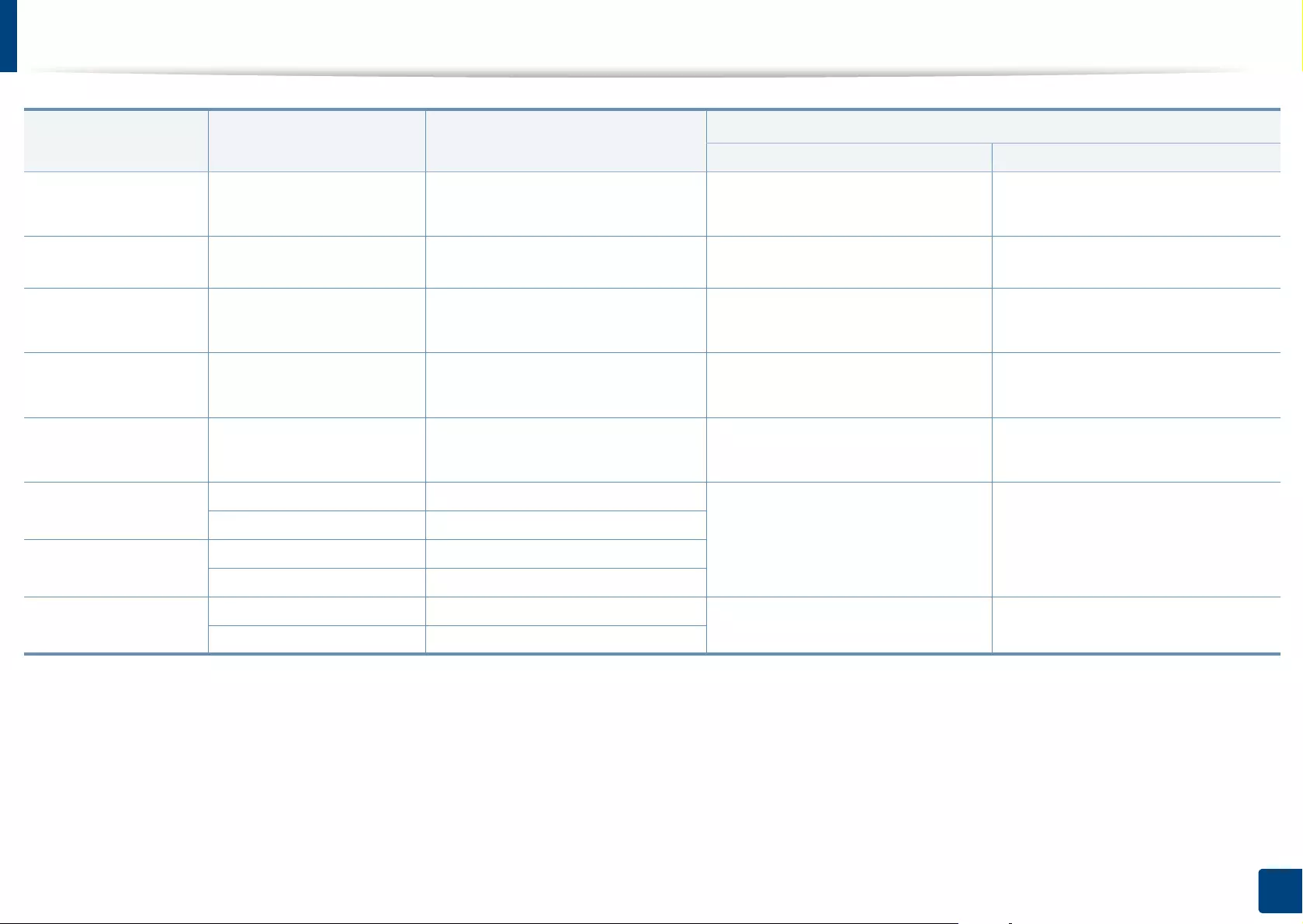
Specifications
401
16. Appendix
Bond Refer to the Plain paper
section
Refer to the Plain paper section 105 to 120g/m2 (28 to 32 lb bond)
• 350 sheets
105 to 120g/m2 (28 to 32 lb bond)
• 20 sheets
Archive Refer to the Plain paper
section
Refer to the Plain paper section - -
Thin cardstock Refer to the Plain paper
section
Refer to the Plain paper section 106 to 163 g/m2 (28 to 43 lb bond)
• 250 sheets
106 to 163 g/m2 (28 to 43 lb bond)
• 20 sheets
Thin glossy Refer to the Plain paper
section
Refer to the Plain paper section 106 to 163 g/m2 (28 to 43 lb bond)
• 50 sheets
106 to 163 g/m2 (28 to 43 lb bond)
• 10 sheets
LabelsbLetter, A4 Refer to the Plain paper section Not available in tray1,2,3,4 120 to 150 g/m2 (32 to 40 lb bond)
• 20 sheets
Tray 1 minimum size (custom) 148 x 210 mm (5.85 x 8.27 inches) 60 to 220 g/m2 (16 to 59 lb bond) -
maximum size (custom) 297 x 364 mm (11.7 x 14.3 inches)
Tray 2,3,4 minimum size (custom) 148 x 210 mm (5.85 x 8.27 inches)
maximum size (custom) 297 x 432 mm (11.7 x 17 inches)
Multipurpose tray minimum size (custom) 98 x 148 mm (3.87 x 5.82 inches) - 60 to 176 g/m2 (16 to 47 lb bond)
maximum size (custom) 297 x 432 mm (11.7x 17inches)
a. Maximum capacity may differ depending on media weight, thickness, and environmental conditions.
b. The smoothness of the labels used in this machine is 100 to 250 (sheffield). This means the numeric level of smoothness.
Type Size Dimensions Print media weight/Capacity (Simplex)a
Tray1,2,3,4 Multipurpose tray
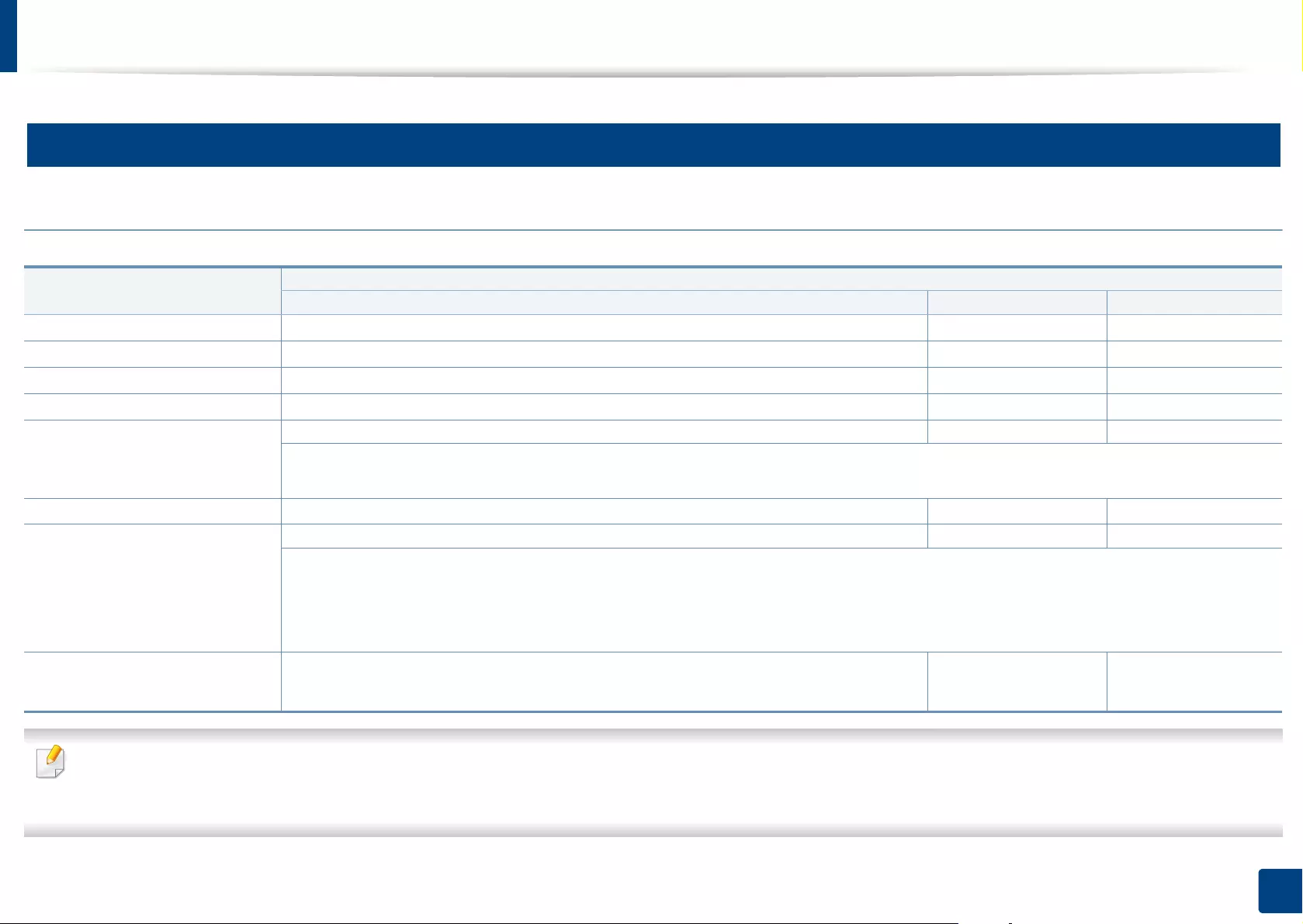
Specifications
402
16. Appendix
3
System requirements
Microsoft® Windows®
• Internet Explorer 6.0 or higher is the minimum requirement for all Windows operating systems.
• Users who have administrator rights can install the software.
•Windows Terminal Services is compatible with your machine.
Operating system Requirement (Recommended)
CPU RAM Free HDD space
Windows® XP Service Pack 3 Intel® Pentium® III 1 GHz (Pentium IV 2 GHz) 512 MB (1 GB) 1.5 GB
Windows Server® 2003 Intel® Pentium® III 1 GHz (Pentium IV 2 GHz) 512 MB (1 GB) 1.5 GB
Windows Server® 2008 Intel® Pentium® IV 1 GHz (Pentium IV 2 GHz) 512 MB (2 GB) 10 GB
Windows Vista®Intel® Pentium® IV 3 GHz 512 MB (1 GB) 15 GB
Windows® 7 Intel® Pentium® IV 1 GHz 32-bit or 64-bit processor or higher 1 GB (2 GB) 16 GB
• Support for DirectX® 9 graphics with 128 MB memory (to enable the Aero theme).
•DVD-R/W Drive
Windows Server® 2008 R2 Intel® Pentium® IV 1.4 GHz (x64) processors (2 GHz or faster) 512 MB (2 GB) 10 GB
Windows® 8
Windows® 8.1
Windows® 10
Windows® Server 2016
Intel® Pentium® IV 1 GHz 32-bit or 64-bit processor or higher 2 GB (2 GB) 20 GB
• Support for DirectX® 9 graphics with 128 MB memory (to enable the Aero theme).
•DVD-R/W Drive
Windows Server® 2012
Windows Server® 2012 R2
Intel® Pentium® IV 1.4 GHz (x64) processors (2 GHz or faster) 512 MB (2 GB) 32 GB
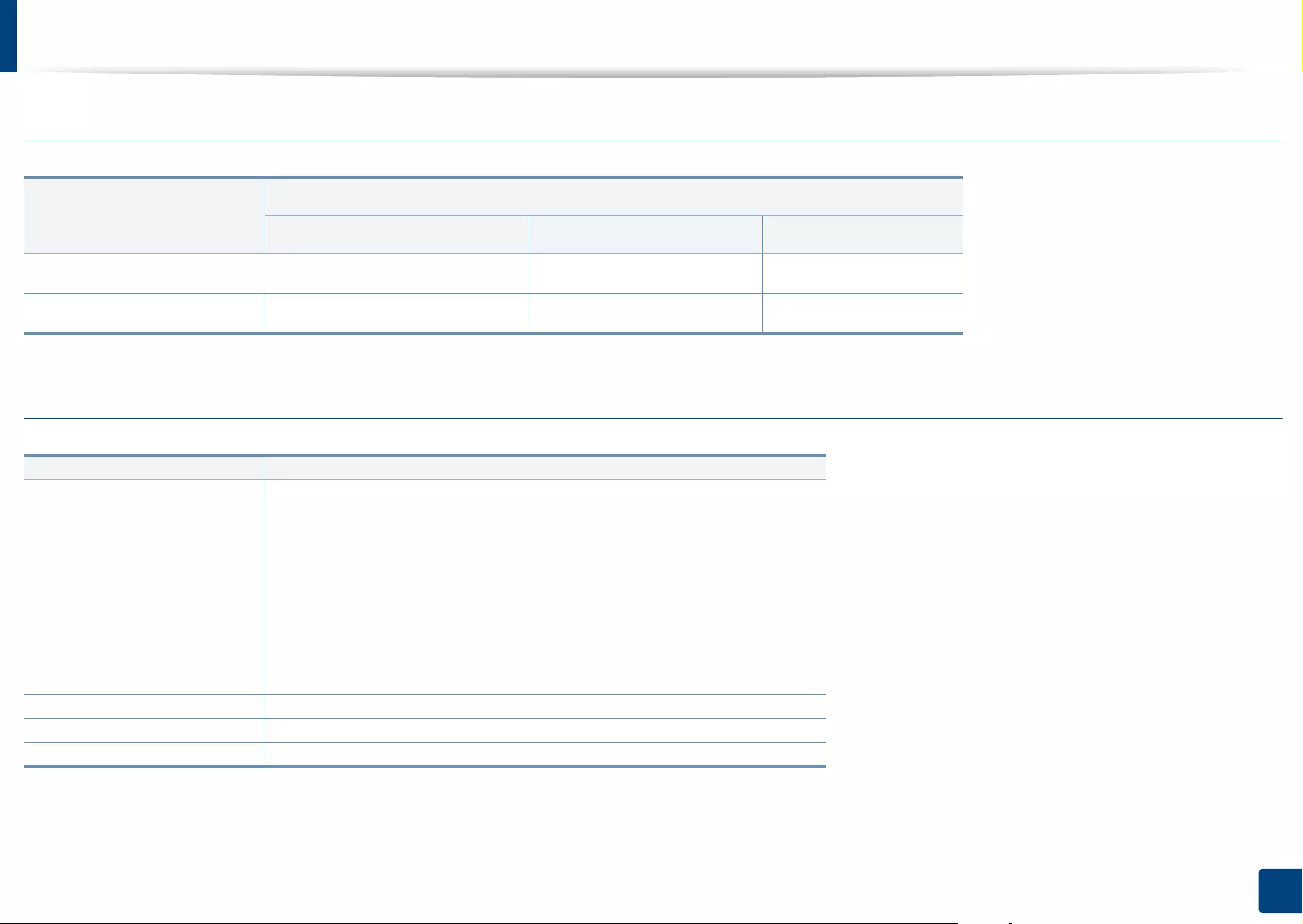
Specifications
403
16. Appendix
Mac
Linux
Operating system
Requirements (Recommended)
CPU RAM Free HDD space
Mac OS X 10.6 •Intel
® processors 1 GB (2 GB) 1 GB
Mac OS X 10.7-10.10 •Intel
® processors 2 GB 4 GB
Items Requirements
Operating system
Red Hat Enterprise Linux 5, 6, 7
Fedora 13, 14, 15, 16, 17, 18, 19, 20, 21, 22
OpenSUSE 11.3, 11.4, 12.1, 12.2, 12.3, 13.1, 13.2
Ubuntu 10.04, 10.10, 11.04, 11.10, 12.04, 12.10, 13.04, 13.10, 14.04, 14.10
SUSE Linux Enterprise Desktop 11, 12
Debian 6, 7, 8
Mint 13, 14, 15, 16, 17
CPU Pentium IV 2.4 GHz (Intel Core™ 2)
RAM 512 MB (1 GB)
Free HDD space 1 GB (2 GB)
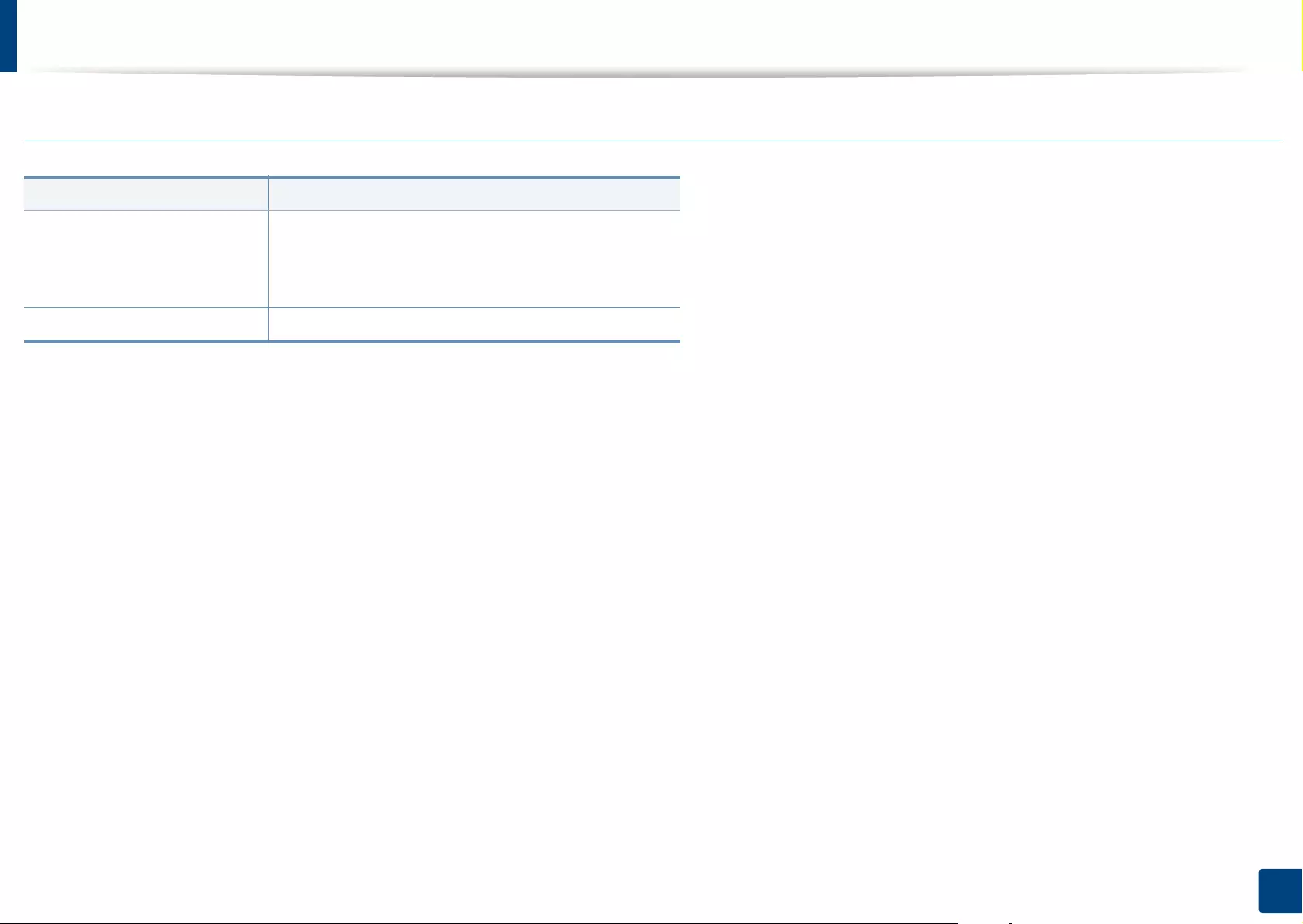
Specifications
404
16. Appendix
Unix
Items Requirements
Operating system
Sun Solaris 9, 10, 11 (x86, SPARC)
HP-UX 11.0, 11i v1, 11i v2, 11i v3 (PA-RISC, Itanium)
IBM AIX 5.1, 5.2, 5.3, 5.4, 6.1, 7.1 (PowerPC)
Free HDD space Up to 100 MB
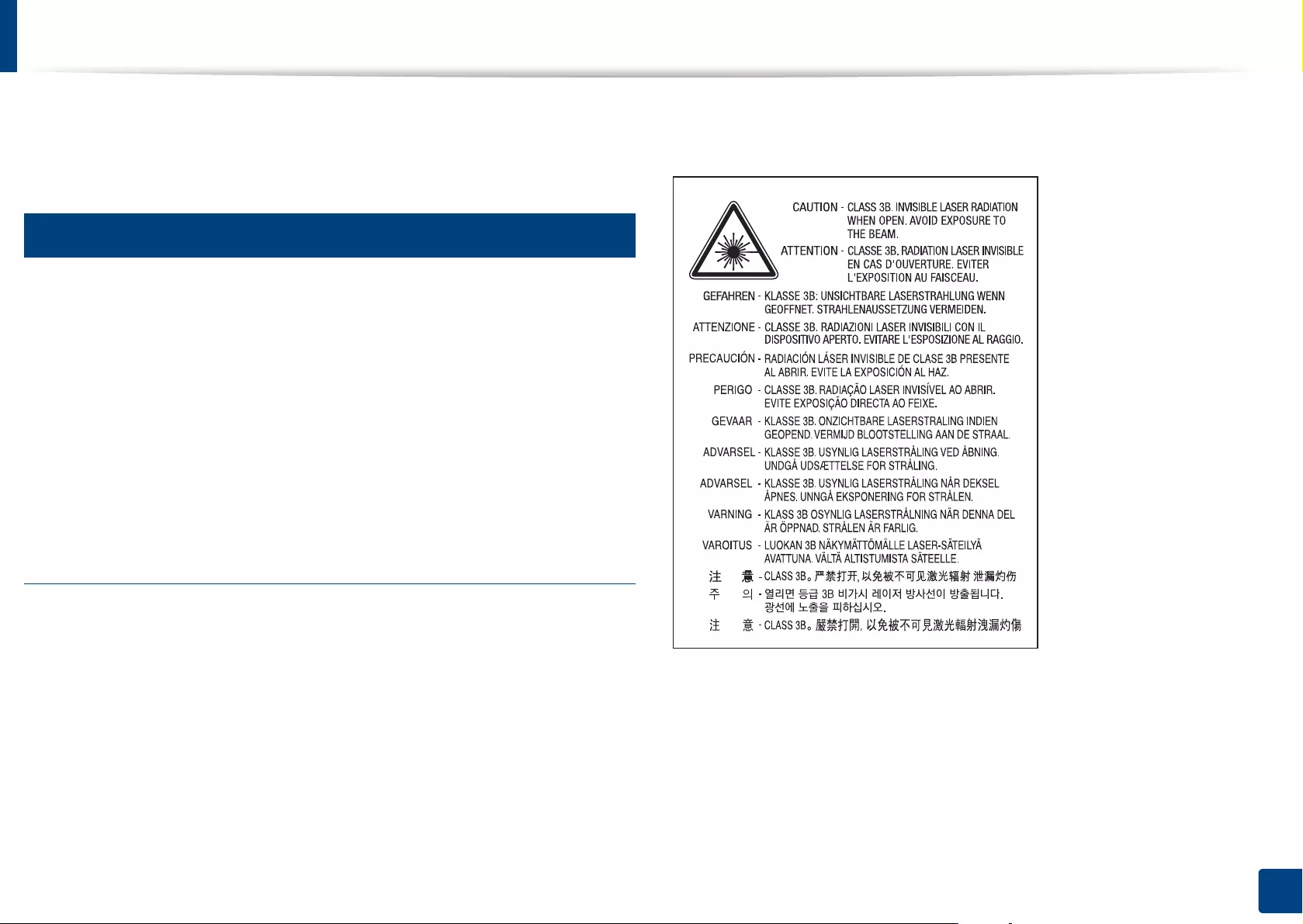
405
16. Appendix
Regulatory information
This machine is designed for a normal work environment and certified with
several regulatory statements.
4
Laser safety statement
The printer is certified in the U.S. to conform to the requirements of DHHS 21
CFR, chapter 1 Subchapter J for Class I (1) laser products, and elsewhere is
certified as a Class I laser product conforming to the requirements of IEC 60825-
1 : 2007.
Class I laser products are not considered to be hazardous. The laser system and
printer are designed so there is never any human access to laser radiation above
a Class I level during normal operation, user maintenance or prescribed service
condition.
Warning
Never operate or service the printer with the protective cover removed from
laser/scanner assembly. The reflected beam, although invisible, can damage
your eyes.
When using this product, these basic safety precautions should always be
followed to reduce risk of fire, electric shock, and injury to persons:
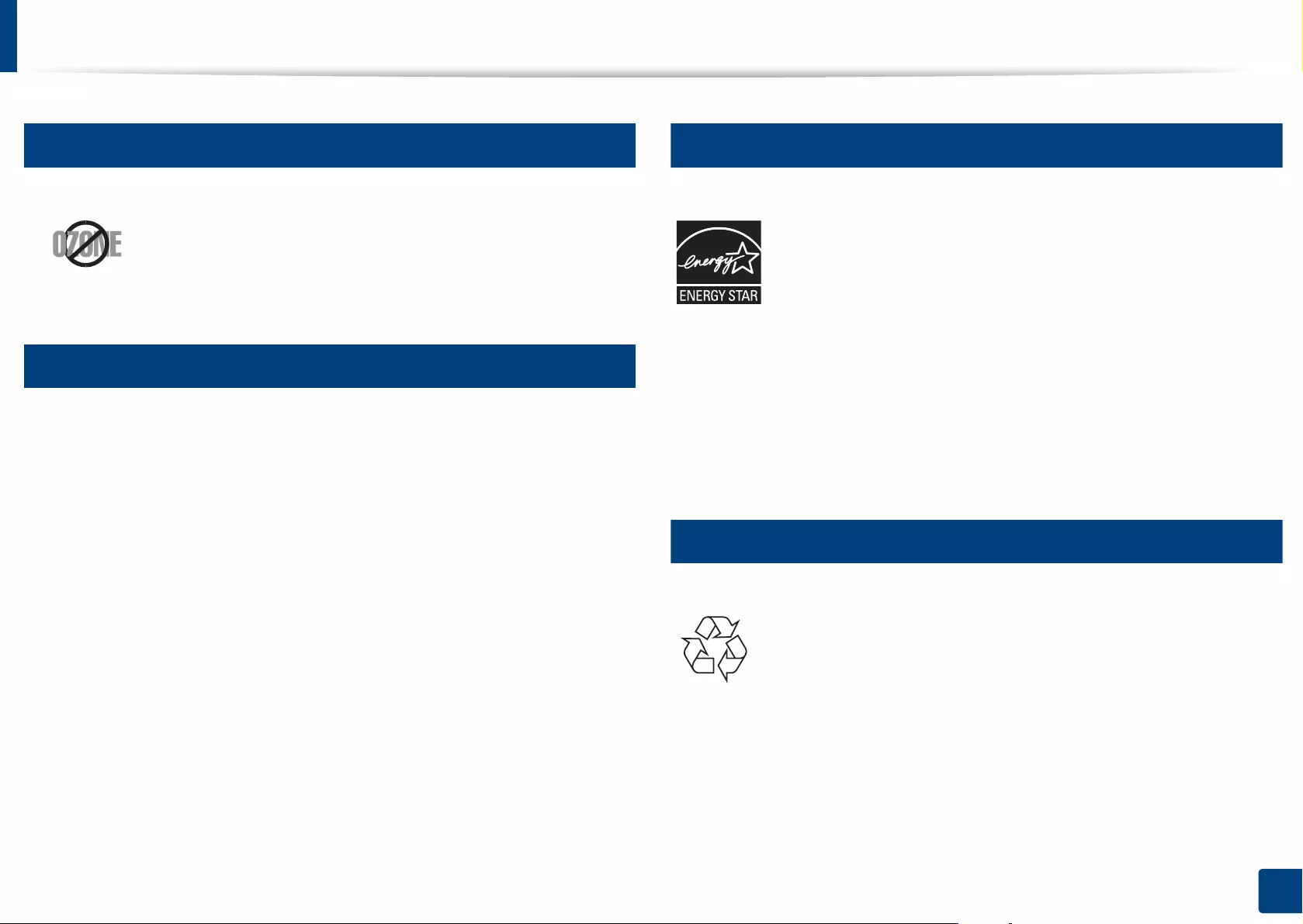
Regulatory information
406
16. Appendix
5
Ozone safety
6
Perchlorate warning
This Perchlorate warning applies only to primary CR (Manganese Dioxide)
Lithium coin cells in the product sold or distributed ONLY in California USA.
Perchlorate Material - special handling may apply.
See www.dtsc.ca.gov/hazardouswaste/perchlorate. (U.S.A. only)
7
Power saver
8
Recycling
This product’s ozone emission rate is under 0.1 ppm. Because
ozone is heavier than air, keep the product in a place with good
ventilation.
This printer contains advanced energy conservation technology that
reduces power consumption when it is not in active use.
When the printer does not receive data for an extended period of
time, power consumption is automatically lowered.
ENERGY STAR and the ENERGY STAR mark are registered U.S. marks.
For more information on the ENERGY STAR program see http://
www.energystar.gov
For ENERGY STAR certified models, the ENERGY STAR label will be on
your machine. Check if your machine is ENERGY STAR certified.
Recycle or dispose of the packaging material for this product in an
environmentally responsible manner.
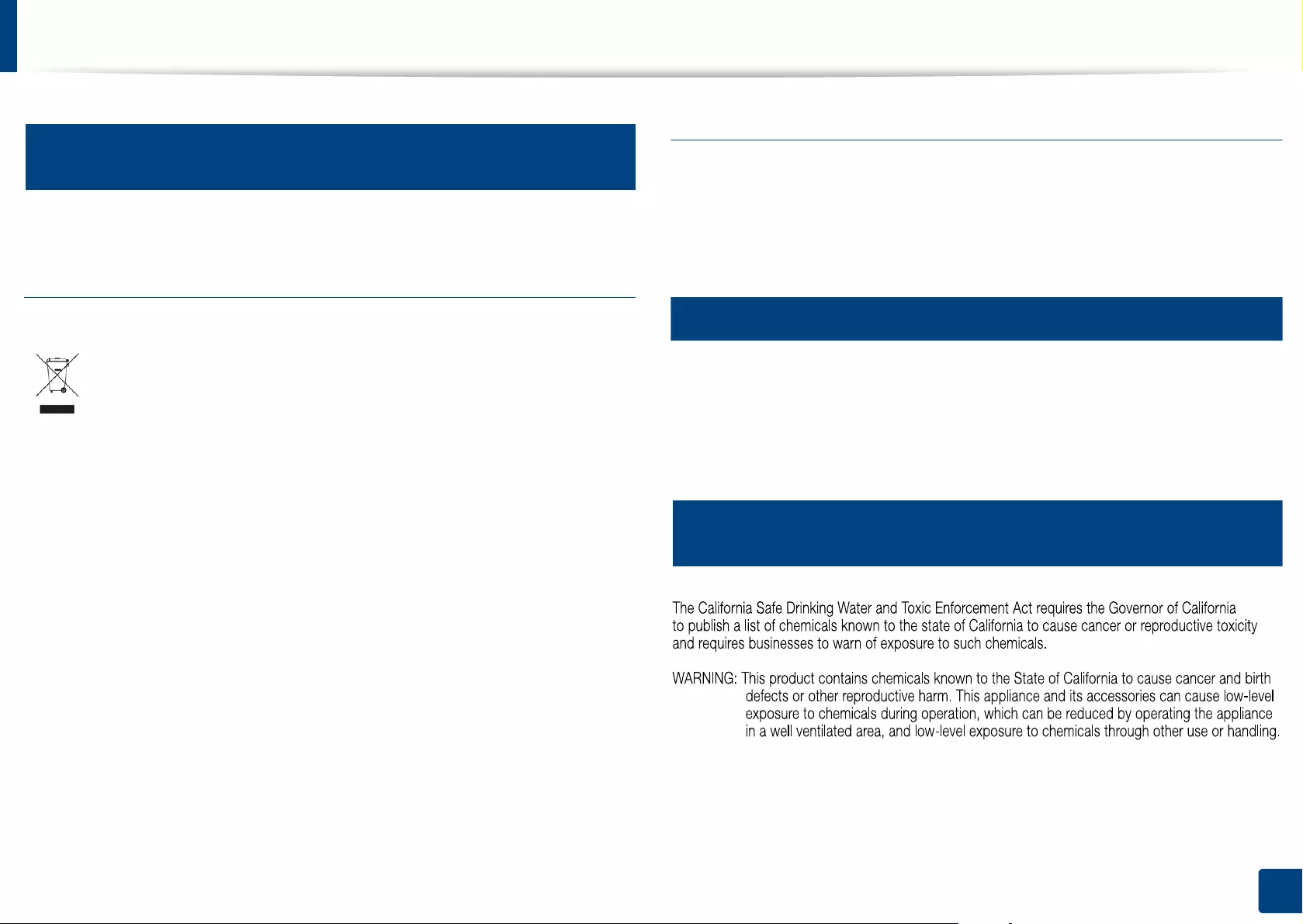
Regulatory information
407
16. Appendix
9
Correct disposal of this product (Waste electrical &
electronic equipment)
(Applicable in countries with separate collection
systems)
(The United States of America only)
Dispose unwanted electronics through an approved recycler. To find the nearest
recycling location, go to our website: www.samsung.com/recyclingdirect Or
call, (877) 278 - 0799
10
EU REACH SVHC Declaration
For information on Samsung’s environmental commitments and product
specific regulatory obligations e.g. REACH visit: www.samsung.com/uk/
aboutsamsung/samsungelectronics/corporatecitizenship/data_corner.html
11
State of California Proposition 65 Warning (USA
Only)
This marking on the product, accessories or literature indicates that the
product and its electronic accessories (e.g. charger, headset, USB cable)
should not be disposed of with other household waste at the end of
their working life. To prevent possible harm to the environment or
human health from uncontrolled waste disposal, please separate these
items from other s of waste and recycle them responsibly to promote the
sustainable reuse of material resources.
Household users should contact either the retailer where they
purchased this product, or their local government office, for details of
where and how they can take these items for environmentally safe
recycling.
Business users should contact their supplier and check the terms and
conditions of the purchase contract. This product and its electronic
accessories should not be mixed with other commercial wastes for
disposal.
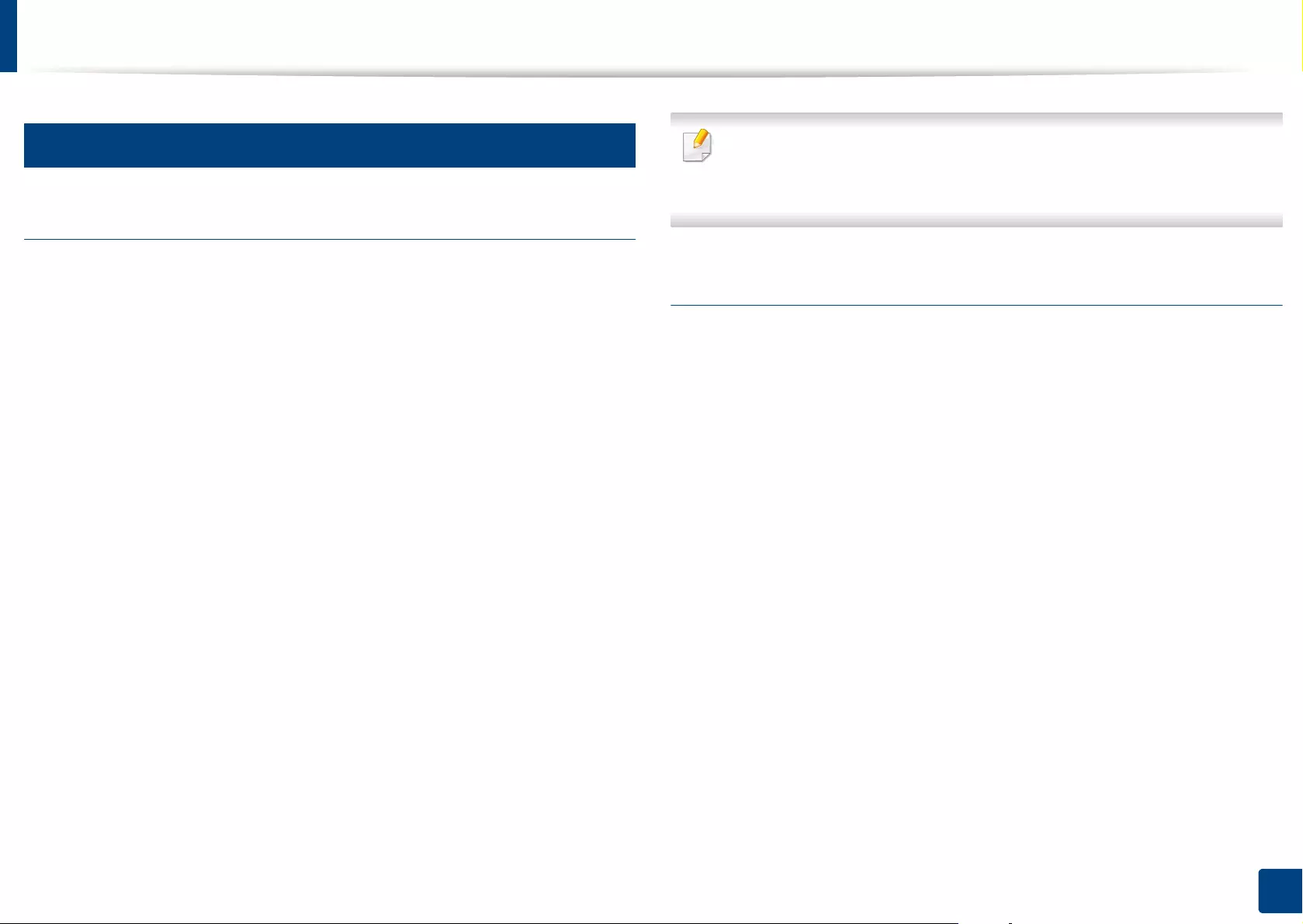
Regulatory information
408
16. Appendix
12
Radio frequency emissions
FCC information to the user
This device complies with Part 15 of the FCC Rules. Operation is subject to the
following two conditions:
• This device may not cause harmful interference, and
• This device must accept any interference received, including interference
that may cause undesired operation.
This equipment has been tested and found to comply with the limits for a Class
A digital device, pursuant to Part 15 of the FCC Rules. These limits are designed
to provide reasonable protection against harmful interference in a residential
installation. This equipment generates, uses and can radiate radio frequency
energy and, if not installed and used in accordance with the instructions, may
cause harmful interference to radio communications. However, there is no
guarantee that interference will not occur in a particular installation. If this
equipment does cause harmful interference to radio or television reception,
which can be determined by turning the equipment off and on, the user is
encouraged to try to correct the interference by one or more of the following
measures:
• Reorient or relocate the receiving antenna.
• Increase the separation between the equipment and receiver.
• Connect the equipment into an outlet on a circuit different from that to
which the receiver is connected.
• Consult the dealer or experienced radio TV technician for help.
Change or modifications not expressly approved by the manufacturer
responsible for compliance could void the user's authority to operate the
equipment.
Canadian radio interference regulations
This digital apparatus does not exceed the Class A limits for radio noise
emissions from digital apparatus as set out in the interference-causing
equipment standard entitled “Digital Apparatus”, ICES-003 of the Industry and
Science Canada.
Cet appareil numérique respecte les limites de bruits radioélectriques
applicables aux appareils numériques de Classe A prescrites dans la norme sur
le matériel brouilleur: “Appareils Numériques”, ICES-003 édictée par l’Industrie
et Sciences Canada.
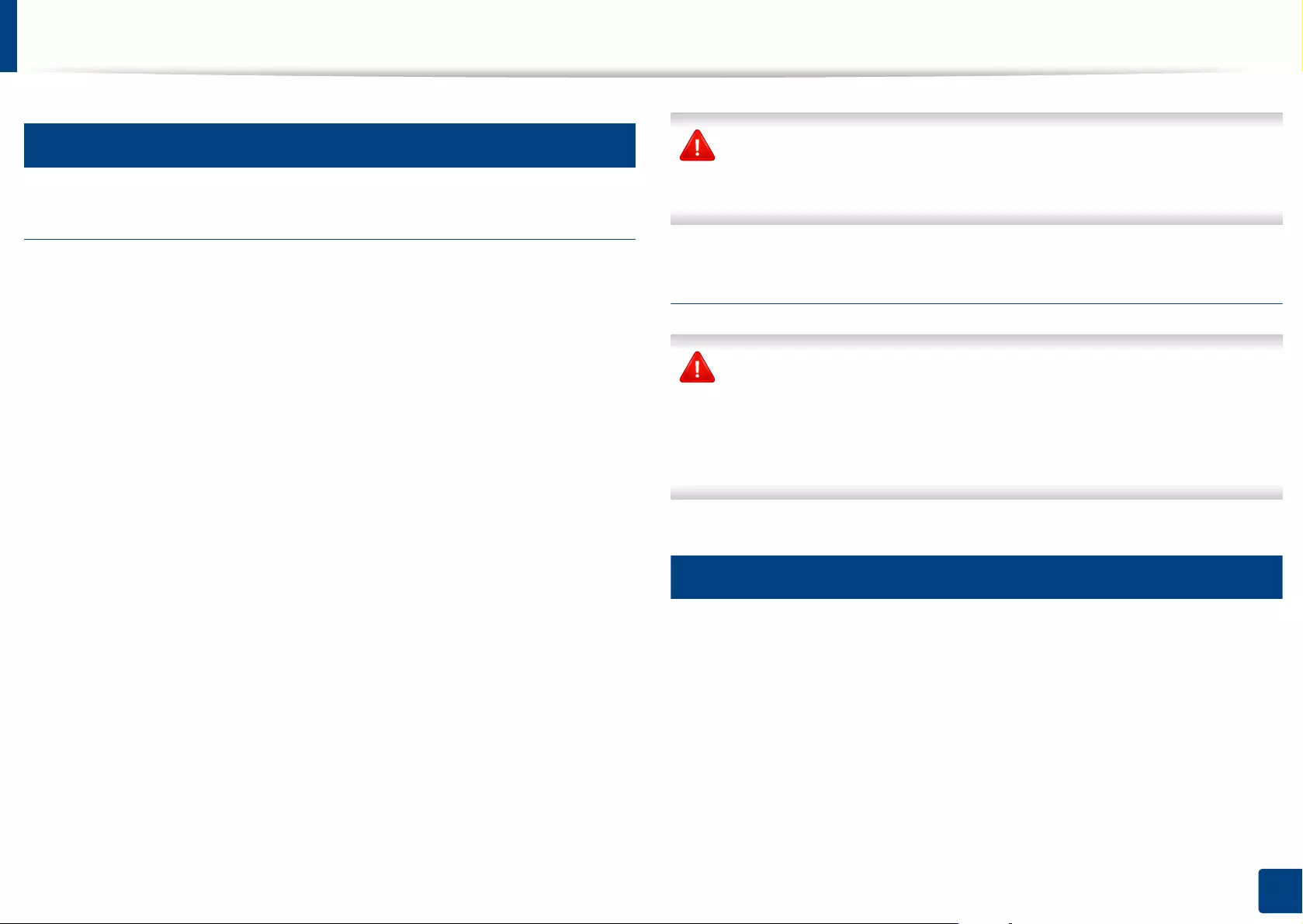
Regulatory information
409
16. Appendix
13
United States of America
Federal Communications Commission (FCC)
Intentional emitter per FCC Part 15
Low power, Radio LAN devices (radio frequency (RF) wireless communication
devices), operating in the 2.4 GHz/5 GHz Band, may be present (embedded) in
your printer system. This section is only applicable if these devices are present.
Refer to the system label to verify the presence of wireless devices.
Wireless devices that may be in your system are only qualified for use in the
United States of America if an FCC ID number is on the system label.
The FCC has set a general guideline of 20 cm (8 inches) separation between the
device and the body, for use of a wireless device near the body (this does not
include extremities). This device should be used more than 20 cm (8 inches)
from the body when wireless devices are on. The power output of the wireless
device (or devices), which may be embedded in your printer, is well below the
RF exposure limits as set by the FCC.
This transmitter must not be collocated or operation in conjunction with any
other antenna or transmitter.
Operation of this device is subject to the following two conditions: (1) This
device may not cause harmful interference, and (2) this device must accept any
interference received, including interference that may cause undesired
operation of the device.
Wireless devices are not user serviceable. Do not modify them in any way.
Modification to a wireless device will void the authorization to use it.
Contact manufacturer for service.
FCC Statement for Wireless LAN use:
While installing and operating this transmitter and antenna combination
the radio frequency exposure limit of 1 mW/cm2 may be exceeded at
distances close to the antenna installed. Therefore, the user must maintain
a minimum distance of 20 cm from the antenna at all times. This device
cannot be collocated with another transmitter and transmitting antenna.
14
RFID (Radio Frequency Interface Device)
RFID operation is subject to the following two conditions:(1) this device may not
cause interference, and (2) this device must accept any interference, including
interference that may cause undesired operation of the device. (U.S.A., France,
Taiwan only)
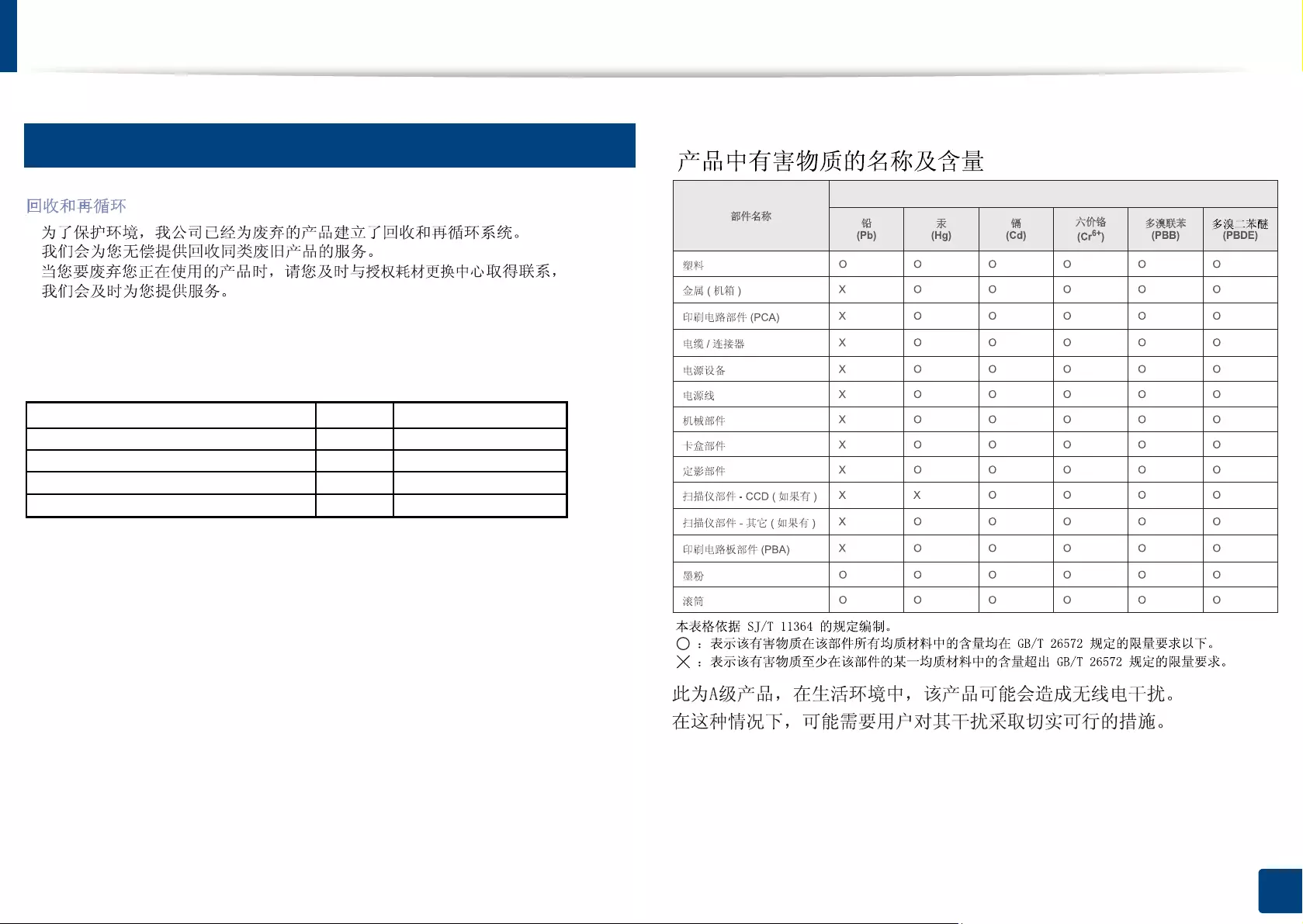
Regulatory information
410
16. Appendix
15
China only
Website: http://www.samsung.com/cn/support/location/
supportServiceLocation.do?page=SERVICE.LOCATION
襦襦愤縑趀爮闭
賉賉帞縑趀绌裎術賉縑聱 ポkW·hマ
MultiXpress X3220NR 1 1.60
MultiXpress X3280NR 1 2.10
MultiXpress K3250NR 2 1.70
MultiXpress K3300NR 2 2.27
蜷筨愤竖爮襔 GB 21521-2014
᳝ᆇ⠽䋼
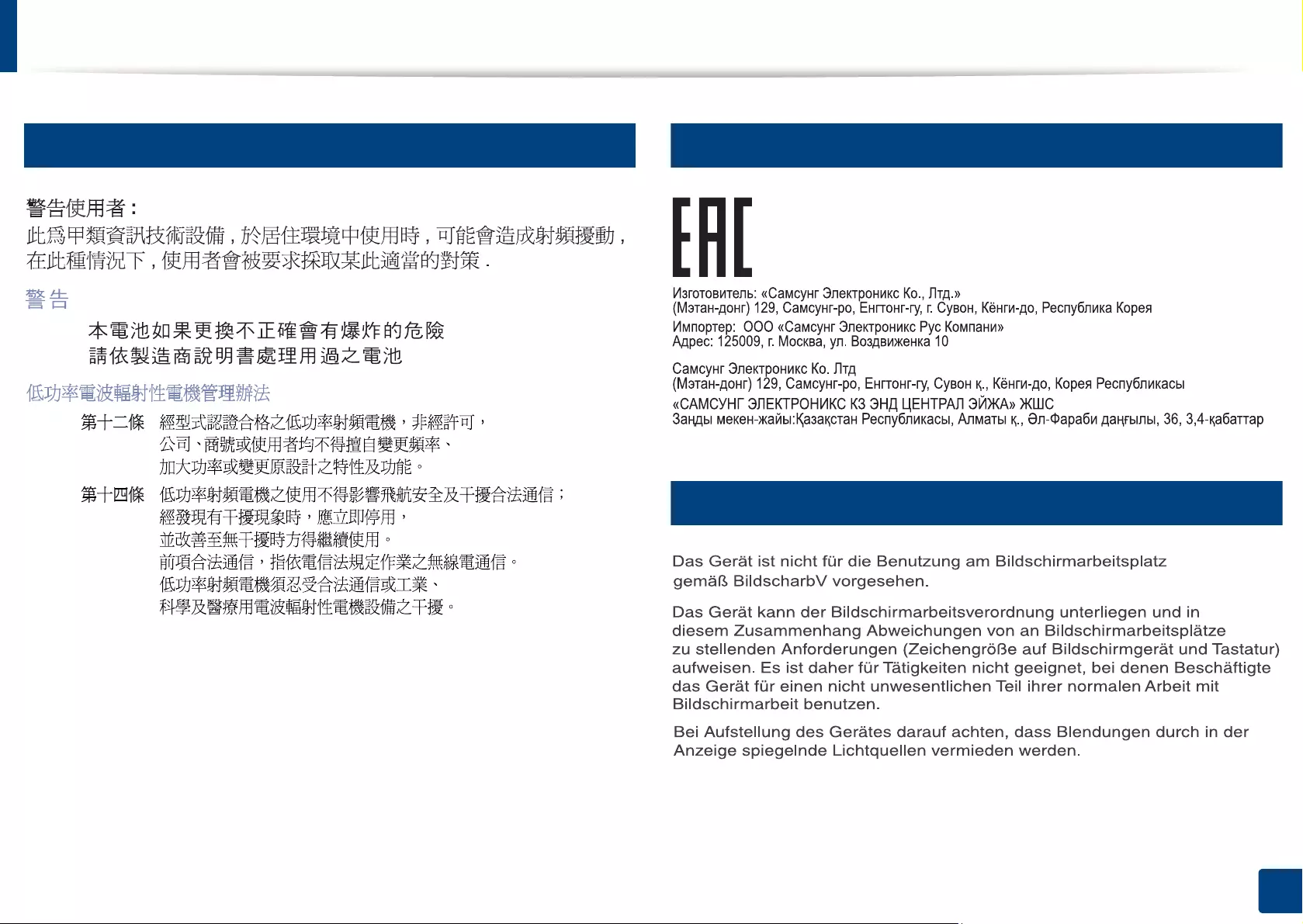
Regulatory information
411
16. Appendix
16
Taiwan only
17
Russia / Kazakhstan / Belarus only
18
Germany only
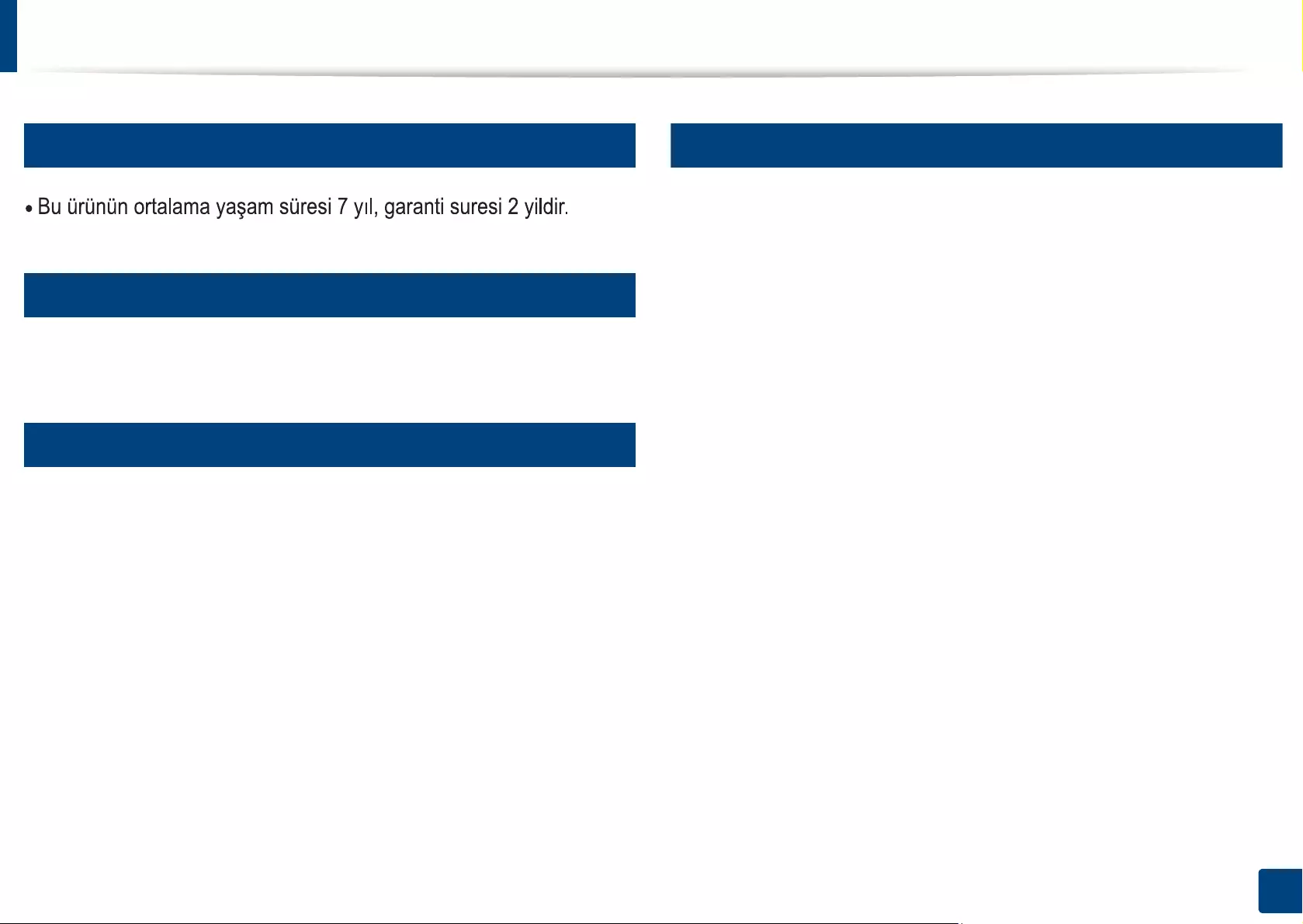
Regulatory information
412
16. Appendix
19
Turkey only
20
Thailand only
This telecommunication equipment conforms to NTC technical requirement.
21
Canada only
This product meets the applicable Industry Canada technical specifications. / Le
present materiel est conforme aux specifications techniques applicables
d’Industrie Canada.
The Ringer Equivalence Number (REN) is an indication of the maximum number
of devices allowed to be connected to a telephone interface. The termination of
an interface may consist of any combination of devices subject only to the
requirement that the sum of the RENs of all the devices not exceed five. / L’indice
d’equivalence de la sonnerie (IES) sert a indiquer le nombre maximal de
terminaux qui peuvent etre raccordes a une interface telephonique. La
terminaison d’une interface peut consister en une combinaison quelconque de
dispositifs, a la seule condition que la somme d’indices d’equivalence de la
sonnerie de tous les dispositifs n’excede pas cinq.
22
Fax Branding
The Telephone Consumer Protection Act of 1991 makes it unlawful for any
person to use a computer or other electronic device to send any message via a
telephone facsimile machine unless such message clearly contains in a margin
at the top or bottom of each transmitted page or on the first page of the
transmission the following information:
1 the date and time of transmission
2 identification of either business, business entity or individual sending the
message; and
3 telephone number of either the sending machine, business, business entity
or individual.
The Telephone Company may make changes in its communications facilities,
equipment operations or procedures where such action is reasonably required
in the operation of its business and is not inconsistent with the rules and
regulations in FCC Part 68. If such changes can be reasonably expected to render
any customer terminal equipment incompatible with telephone company
communications facilities, or require modification or alteration of such terminal
equipment, or otherwise materially affect its use or performance, the customer
shall be given adequate notice in writing, to allow the customer an opportunity
to maintain uninterrupted service.
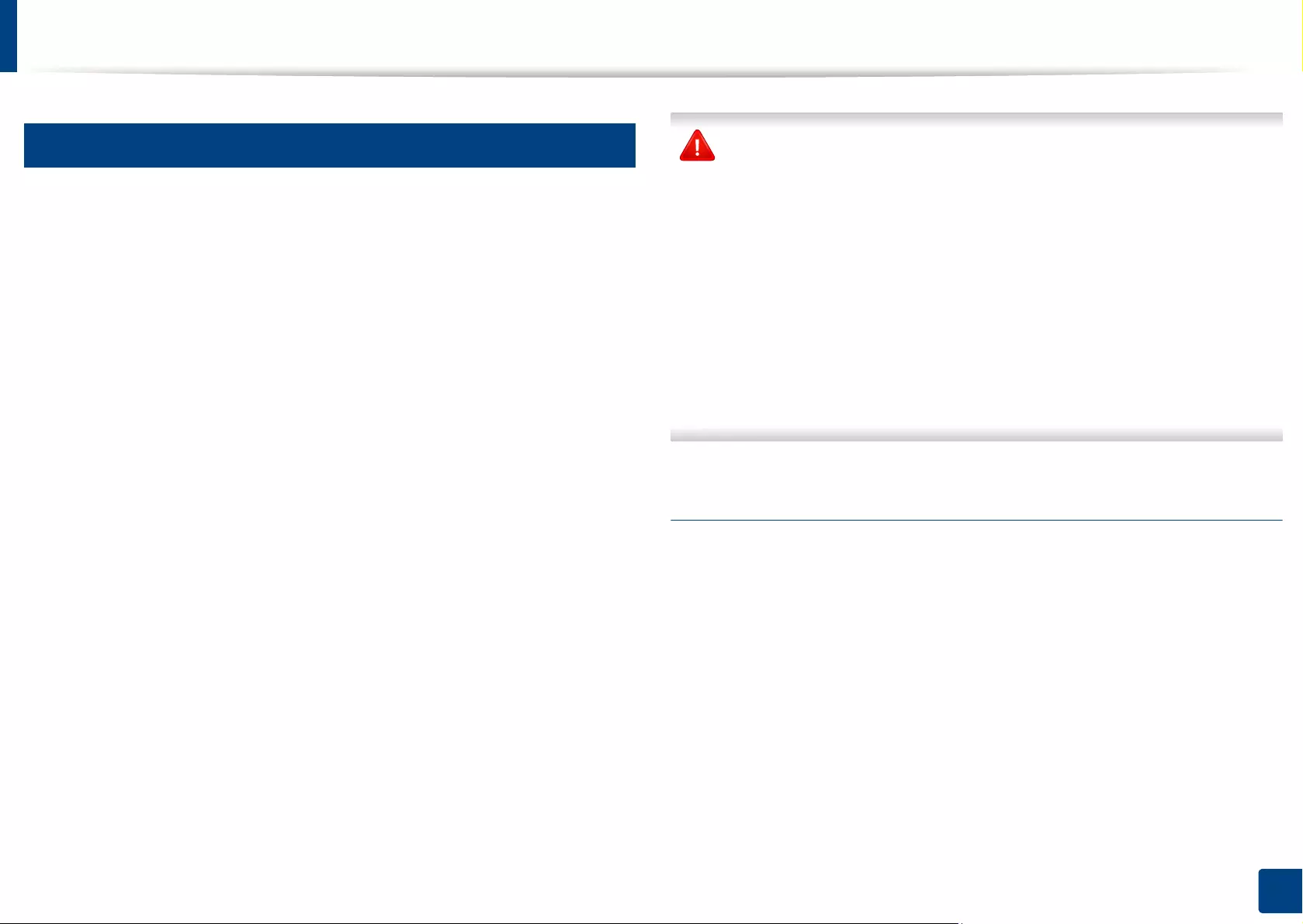
Regulatory information
413
16. Appendix
23
Ringer Equivalence Number
The Ringer Equivalence Number and FCC Registration Number for this machine
may be found on the label located on the bottom or rear of the machine. In some
instances you may need to provide these numbers to the telephone company.
The Ringer Equivalence Number (REN) is a measure of the electrical load placed
on the telephone line, and is useful for determining whether you have
“overloaded” the line. Installing several s of equipment on the same telephone
line may result in problems making and receiving telephone calls, especially
ringing when your line is called. The sum of all Ringer Equivalence Numbers of
the equipment on your telephone line should be less than five in order to assure
proper service from the telephone company. In some cases, a sum of five may
not be usable on your line. If any of your telephone equipment is not operating
properly, you should immediately remove it from your telephone line, as it may
cause harm to the telephone network.
The equipment complies with Part 68 of the FCC rules and the requirements
adopted by the ACTA. On the rear of this equipment is a label that contains,
among other information, a product identifier in the format US:AAAEQ##TXXXX.
If requested, this number must be provided to the telephone company.
FCC Regulations state that changes or modifications to this equipment not
expressly approved by the manufacturer could void the user’s authority to
operate this equipment. In the event that terminal equipment causes harm
to the telephone network, the telephone company should notify the
customer that service may be stopped. However, where prior notice is
impractical, the company may temporarily cease service, providing that
they:
a promptly notify the customer.
b give the customer an opportunity to correct the equipment problem.
c inform the customer of the right to bring a complaint to the Federal
Communication Commission pursuant to procedures set out in FCC
Rules and Regulations Subpart E of Part 68.
You should also know that:
• Your machine is not designed to be connected to a digital PBX system.
• If you intend to use a computer modem or fax modem on the same phone
line as your machine, you may experience transmission and reception
problems with all the equipment. It is recommended that no other
equipment, except for a regular telephone, share the line with your
machine.
• If your area experiences a high incidence of lightning or power surges, we
recommend that you install surge protectors for both the power and the
telephone lines. Surge protectors can be purchased from your dealer or
telephone and electronic specialty stores.
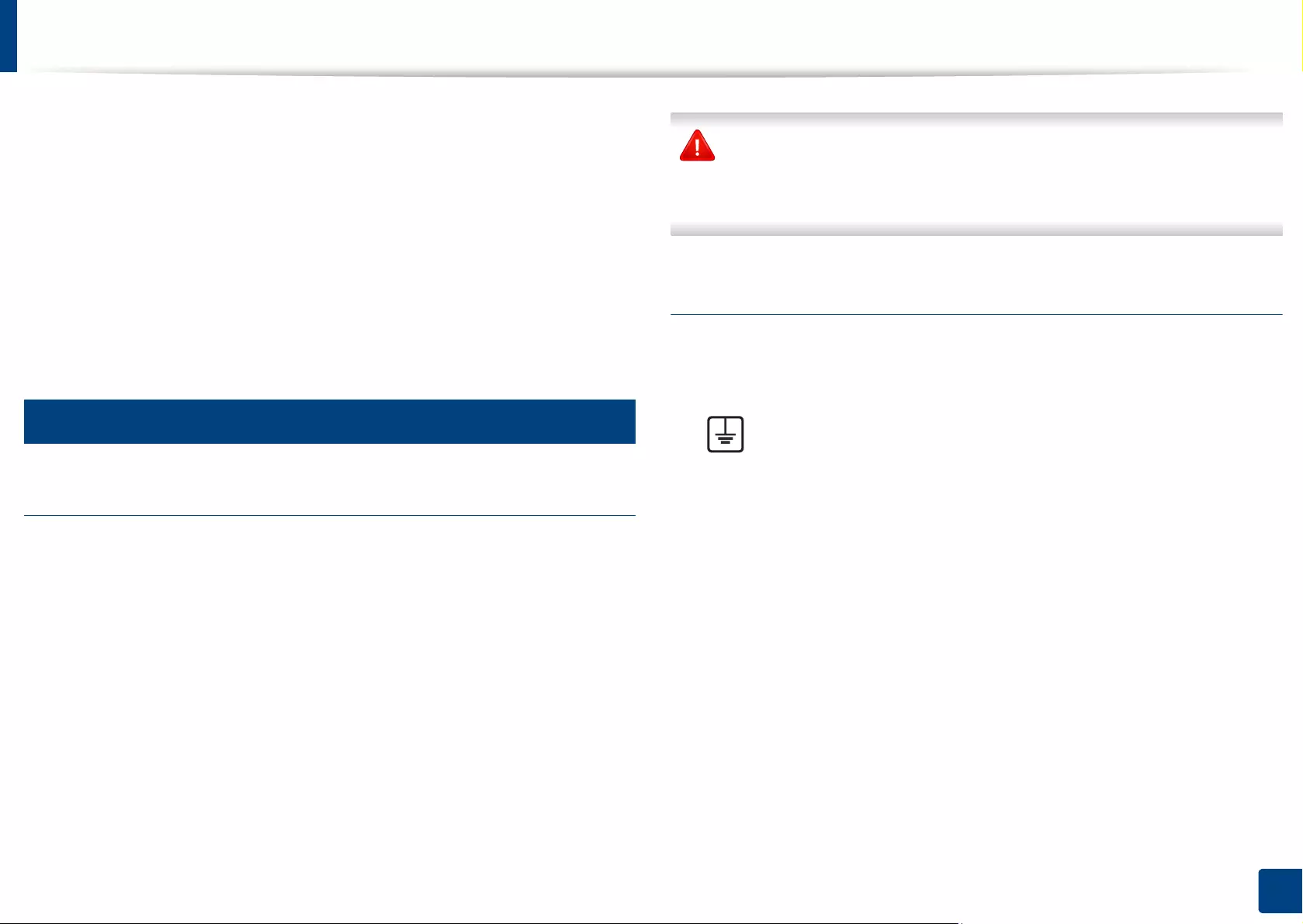
Regulatory information
414
16. Appendix
• When programming emergency numbers and/or making test calls to
emergency numbers, use a non-emergency number to advise the
emergency service dispatcher of your intentions. The dispatcher will give
you further instructions on how to actually test the emergency number.
• This machine may not be used on coin service or party lines.
• This machine provides magnetic coupling to hearing aids.
You may safely connect this equipment to the telephone network by means of
a standard modular jack, USOC RJ-11C.
24
Replacing the Fitted Plug (for UK Only)
Important
The mains lead for this machine is fitted with a standard (BS 1363) 13 amp plug
and has a 13 amp fuse. When you change or examine the fuse, you must re-fit
the correct 13 amp fuse. You then need to replace the fuse cover. If you have lost
the fuse cover, do not use the plug until you have another fuse cover.
Contact the people from you purchased the machine.
The 13 amp plug is the most widely used in the UK and should be suitable.
However, some buildings (mainly old ones) do not have normal 13 amp plug
sockets. You need to buy a suitable plug adaptor. Do not remove the moulded
plug.
If you cut off the moulded plug, get rid of it straight away.
You cannot rewire the plug and you may receive an electric shock if you
plug it into a socket.
Important warning:
If the wires in the mains lead do not match the colors marked in your plug, do
the following:
You must connect the green and yellow wire to the pin marked by the letter “E”
or by the safety ‘Earth symbol’ or colored green and yellow or green.
You must connect the blue wire to the pin which is marked with the letter “N” or
colored black.
You must connect the brown wire to the pin which is marked with the letter “L”
or colored red.
You must have a 13 amp fuse in the plug, adaptor, or at the distribution board.
You must earth this machine.
The wires in the mains lead have the following color code:
•Green and Yellow: Earth
•Blue: Neutral
•Brown: Live
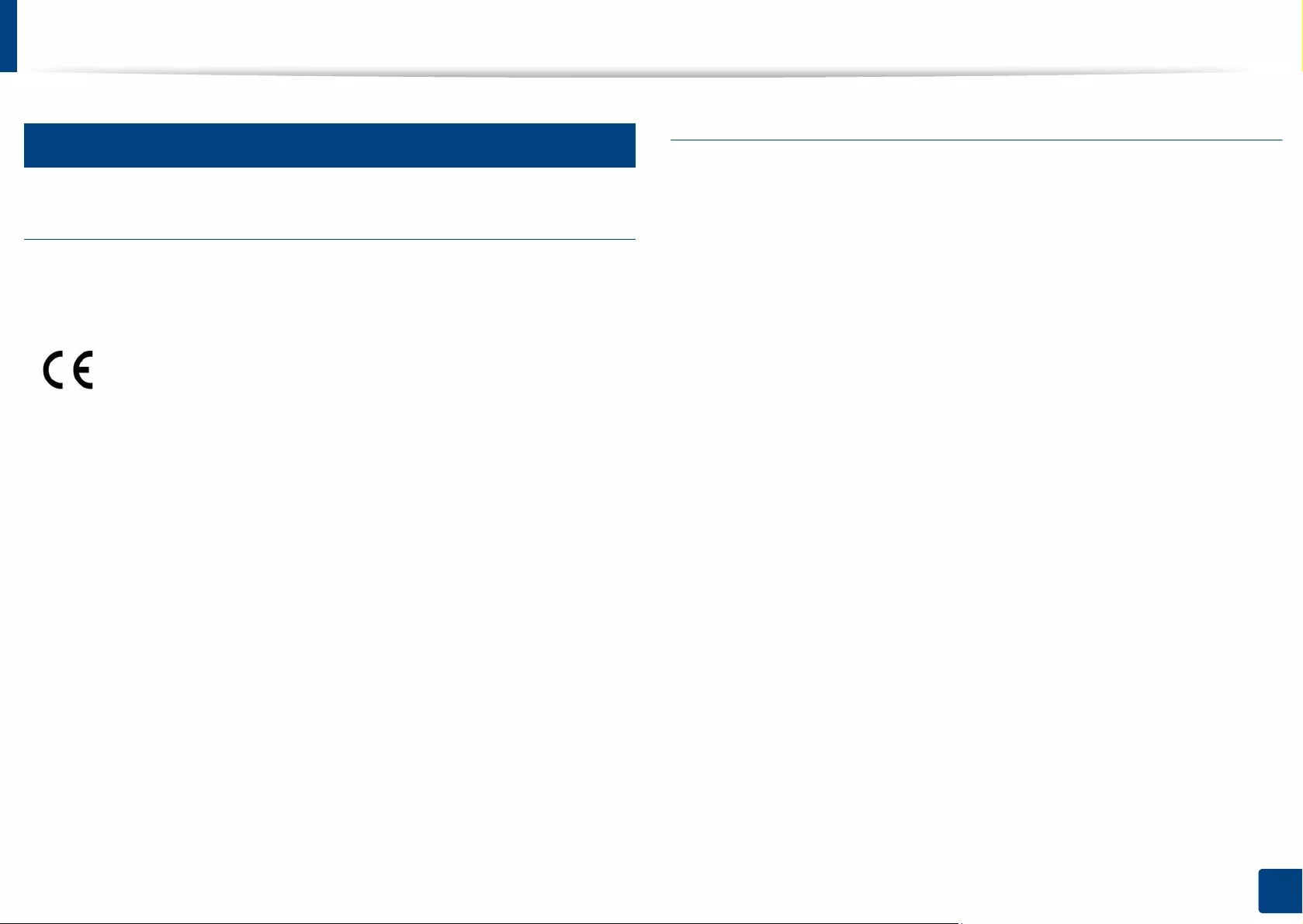
Regulatory information
415
16. Appendix
25
Declaration of conformity (European countries)
Approvals and Certifications
January 1, 1995: Council Directive 2006/95/EC Approximation of the laws of
the member states related to low voltage equipment.
January 1, 1996: Council Directive 2004/108/EC, approximation of the laws of
the Member States related to electromagnetic compatibility.
March 9, 1999: Council Directive 1999/5/EC on radio equipment and
telecommunications terminal equipment and the mutual recognition of their
conformity. A full declaration, defining the relevant Directives and referenced
standards can be obtained from your Samsung Electronics Co., Ltd.
representative.
EC Certification
Certification to 1999/5/EC Radio Equipment & Telecommunications Terminal
Equipment Directive (FAX)
This Samsung product has been self-certified by Samsung for pan-European
single terminal connection to the analogue public switched telephone network
(PSTN) in accordance with Directive 1999/5/EC. The product has been designed
to work with the national PSTNs and compatible PBXs of the European
countries:
In the event of problems, you should contact the Euro QA Lab of Samsung
Electronics Co., Ltd. in the first instance.
The product has been tested against TBR21. To assist in the use and application
of terminal equipment which complies with this standard, the European
Telecommunication Standards Institute (ETSI) has issued an advisory document
(EG 201 121) which contains notes and additional requirements to ensure
network compatibility of TBR21 terminals. The product has been designed
against, and is fully compliant with, all of the relevant advisory notes contained
in this document.
Hereby, Samsung Electronics, declares that this [X322x/ X328x
series, K325x/ K330x series] is in compliance with the essential
requirements and other relevant provisions of R&TTE Directive 1999/
5/EC.
The declaration of conformity may be consulted at
www.samsung.com, go to Support > Download center and enter
your printer (MFP) name to browse the EuDoC.
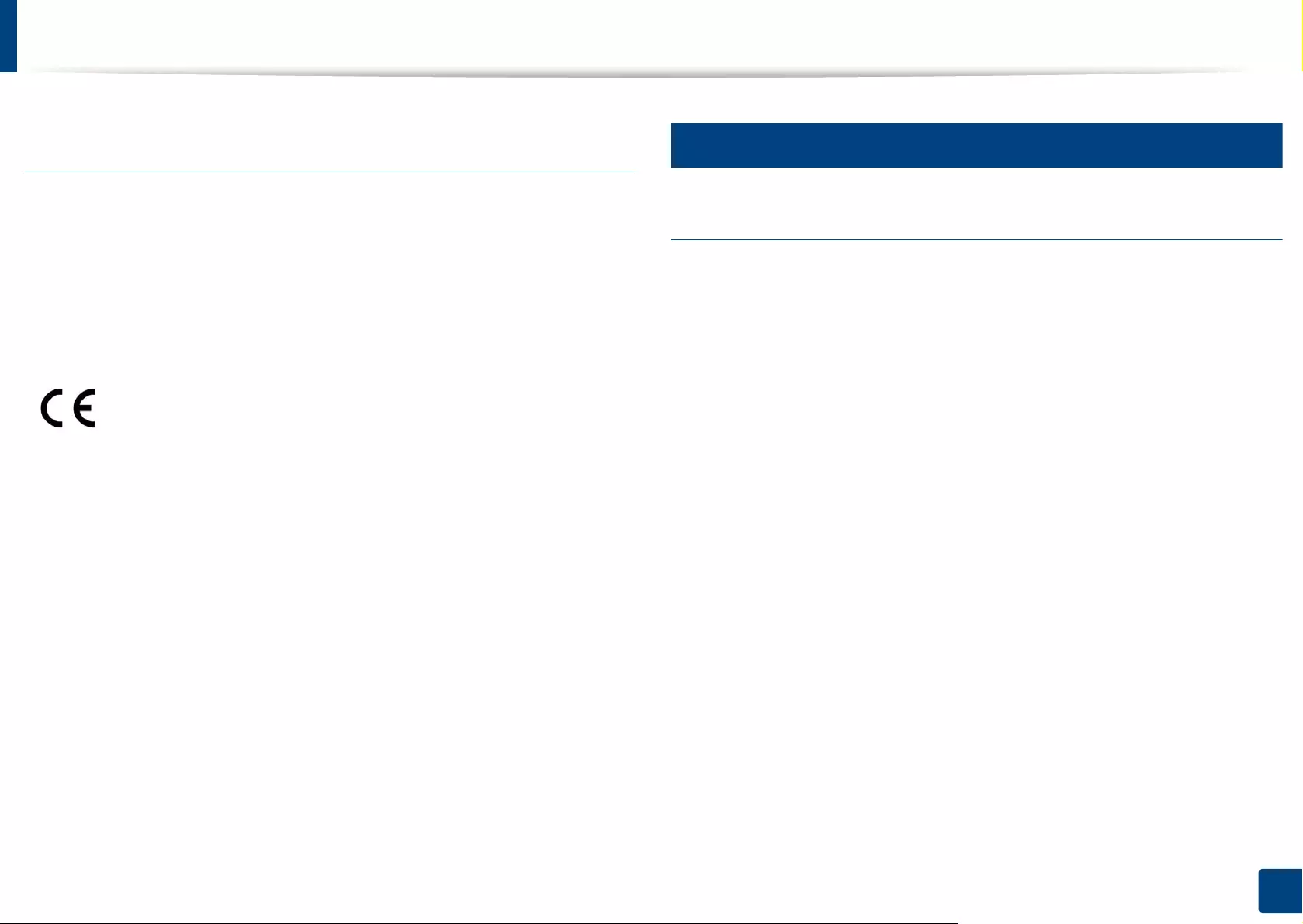
Regulatory information
416
16. Appendix
European radio approval information (for products
fitted with EU-approved radio devices)
Low power, Radio LAN type devices (radio frequency (RF) wireless
communication devices), operating in the 2.4 GHz/5 GHz band, may be present
(embedded) in your printer system which is intended for home or office use. This
section is only applicable if these devices are present. Refer to the system label
to verify the presence of wireless devices.
The power output of the wireless device or devices that may be embedded in
you printer is well below the RF exposure limits as set by the European
Commission through the R&TTE directive.
European states qualified under wireless approvals:
EU countries
European states with restrictions on use:
EU
In France, this equipment may only be used indoors.
EEA/EFTA countries
No limitations at this time
26
Regulatory compliance statements
Wireless guidance
Low power, Radio LAN devices (radio frequency (RF) wireless communication
devices), operating in the 2.4 GHz/5 GHz Band, may be present (embedded) in
your printer system. The following section is a general overview of
considerations while operating a wireless device.
Additional limitations, cautions, and concerns for specific countries are listed in
the specific country sections (or country group sections). The wireless devices in
your system are only qualified for use in the countries identified by the Radio
Approval Marks on the system rating label. If the country you will be using the
wireless device in, is not listed, contact your local Radio Approval agency for
requirements. Wireless devices are closely regulated and use may not be
allowed.
The power output of the wireless device or devices that may be embedded in
your printer is well below the RF exposure limits as known at this time. Because
the wireless devices (which may be embedded into your printer) emit less
energy than is allowed in radio frequency safety standards and
recommendations, manufacturer believes these devices are safe for use.
Regardless of the power levels, care should be taken to minimize human contact
during normal operation.
Wireless devices that may be in your system are only qualified for
use in the European Union or associated areas if a CE mark with a
Notified Body Registration Number and the Alert Symbol is on the
system label.
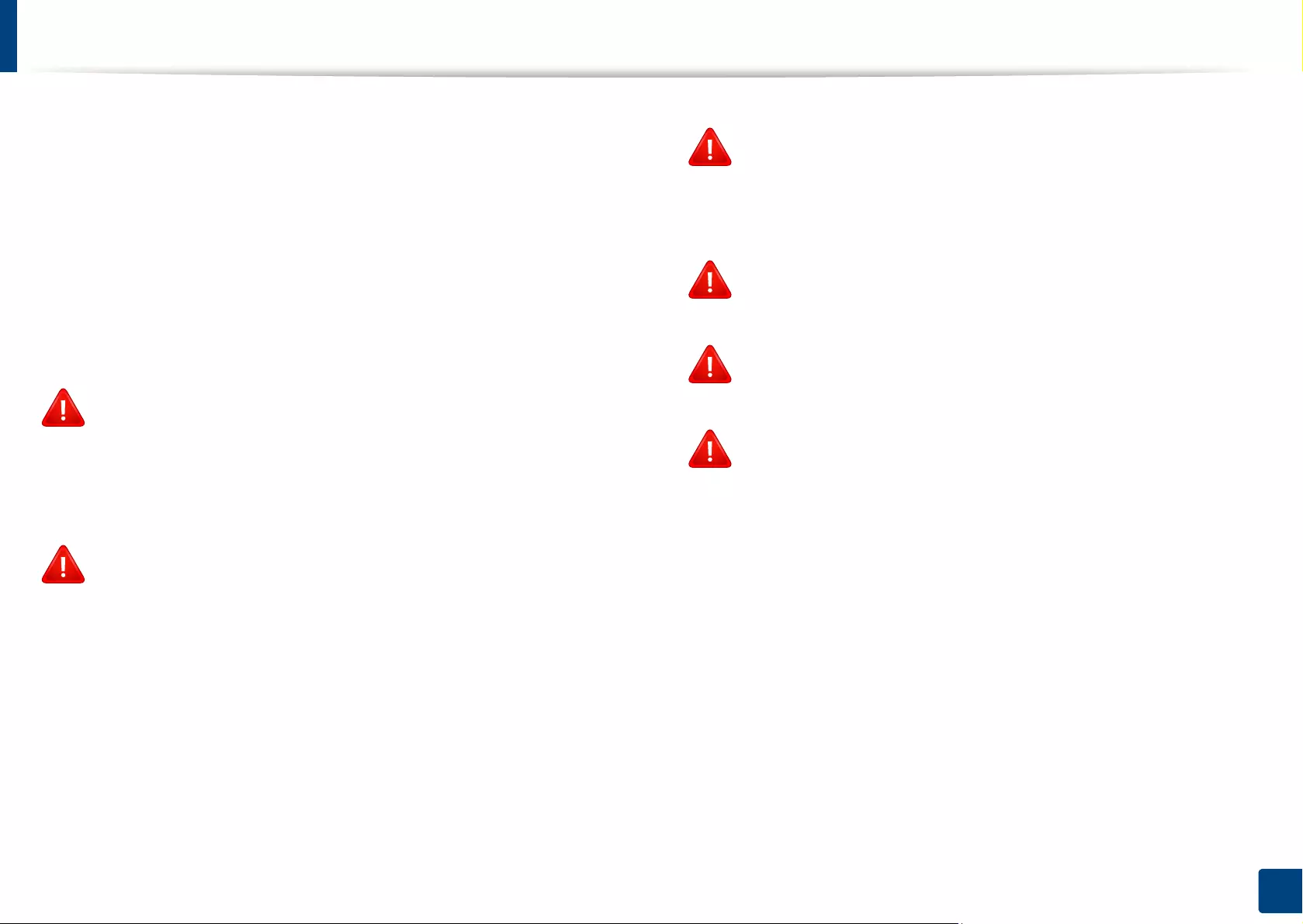
Regulatory information
417
16. Appendix
As a general guideline, a separation of 20 cm (8 inches) between the wireless
device and the body, for use of a wireless device near the body (this does not
include extremities) is typical. This device should be used more than 20 cm (8
inches) from the body when wireless devices are on and transmitting.
This transmitter must not be collocated or operation in conjunction with any
other antenna or transmitter.
Some circumstances require restrictions on wireless devices. Examples of
common restrictions are listed below:
Radio frequency wireless communication can interfere with
equipment on commercial aircraft. Current aviation regulations
require wireless devices to be turned off while traveling in an airplane.
IEEE 802.11 (also known as wireless Ethernet) and Bluetooth
communication devices are examples of devices that provide wireless
communication.
In environments where the risk of interference to other devices or
services is harmful or perceived as harmful, the option to use a wireless
device may be restricted or eliminated. Airports, Hospitals, and
Oxygen or flammable gas laden atmospheres are limited examples
where use of wireless devices may be restricted or eliminated. When in
environments where you are uncertain of the sanction to use wireless
devices, ask the applicable authority for authorization prior to use or
turning on the wireless device.
Every country has different restrictions on the use of wireless devices.
Since your system is equipped with a wireless device, when traveling
between countries with your system, check with the local Radio
Approval authorities prior to any move or trip for any restrictions on
the use of a wireless device in the destination country.
If your system came equipped with an internal embedded wireless
device, do not operate the wireless device unless all covers and shields
are in place and the system is fully assembled.
Wireless devices are not user serviceable. Do not modify them in any
way. Modification to a wireless device will void the authorization to
use it. Contact manufacturer for service.
Only use drivers approved for the country in which the device will be
used. See the manufacturer System Restoration Kit, or contact
manufacturer Technical Support for additional information.
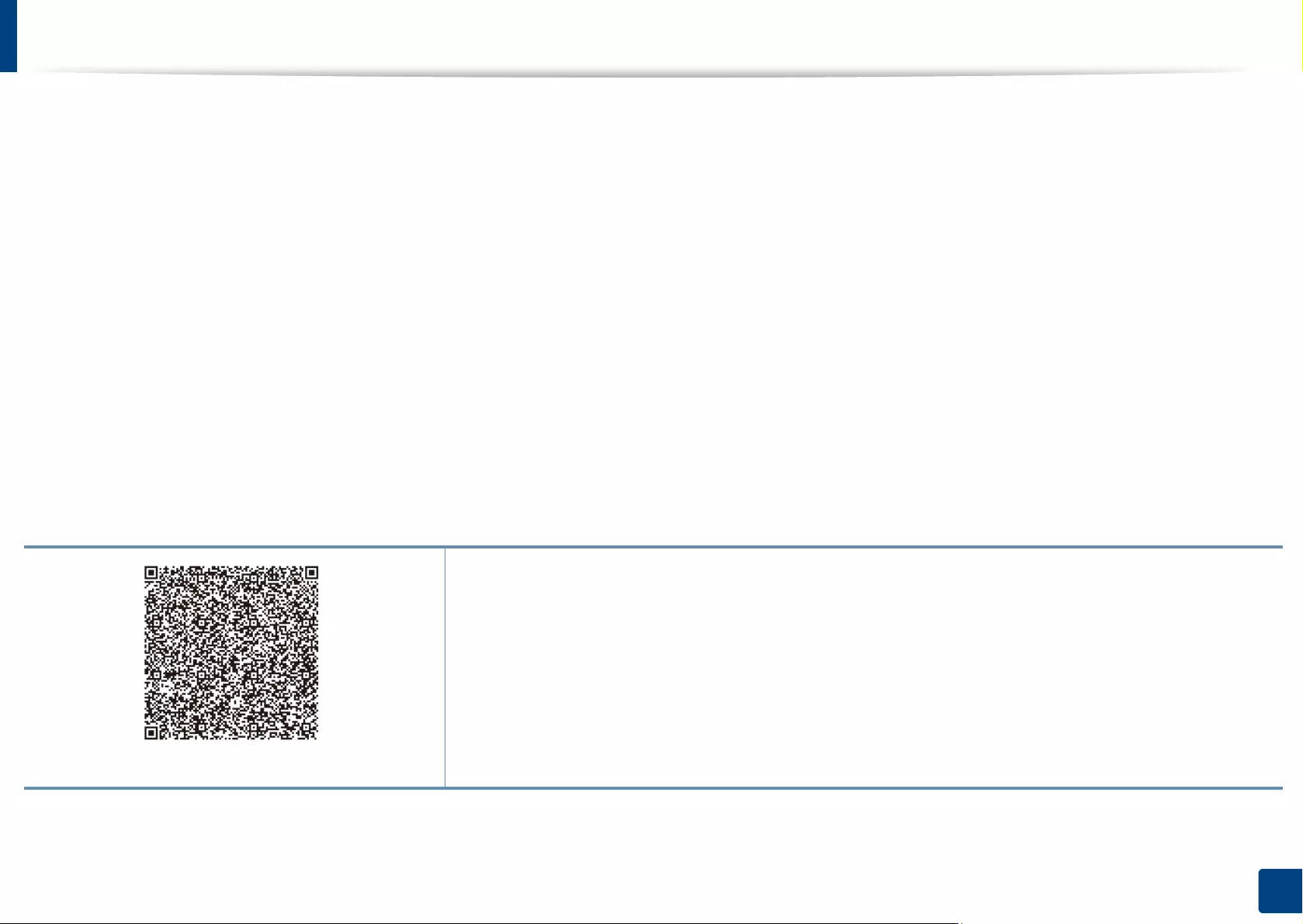
418
16. Appendix
Copyright
© 2015 Samsung Electronics Co., Ltd. All rights reserved.
This user’s guide is provided for information purposes only. All information included herein is subject to change without notice.
Samsung Electronics is not responsible for any direct or indirect damages, arising from or related to use of this user’s guide.
• Samsung and the Samsung logo are trademarks of Samsung Electronics Co., Ltd.
• Microsoft, Windows XP Service Pack 3, Windows Vista, Windows 7, Windows 8, Windows Server 2008 R2, Windows 10 and Windows Server 2016 are either
registered trademarks or trademarks of Microsoft Corporation.
• Microsoft, Internet Explorer, Excel, Word, PowerPoint, and Outlook are either registered trademarks or trademarks of Microsoft Corporation in the United States
and other countries.
• Google, Picasa, Google Cloud Print, Google Docs, Android and Gmail are either registered trademarks or trademarks of Google Inc.
• iPad, iPhone, iPod touch, Mac and Mac OS are trademarks of Apple Inc., registered in the U.S and other countries.
• AirPrint and the AirPrint logo are trademarks of Apple Inc.
• All other brand or product names are trademarks of their respective companies or organizations.
REV. 1.01
QR code
The software included in this product contains open source software. You may obtain the complete
corresponding source code for a period of three years after the last shipment of this product by sending an email
to mailto:oss.request@samsung.com. It is also possible to obtain the complete corresponding source code in a
physical medium such as a CD-ROM; a minimal charge will be required.
The following URL http://opensource.samsung.com/opensource/X3220_K3250_series/seq/0 leads to the
download page of the source code made available and open source license information as related to this
product. This offer is valid to anyone in receipt of this information.
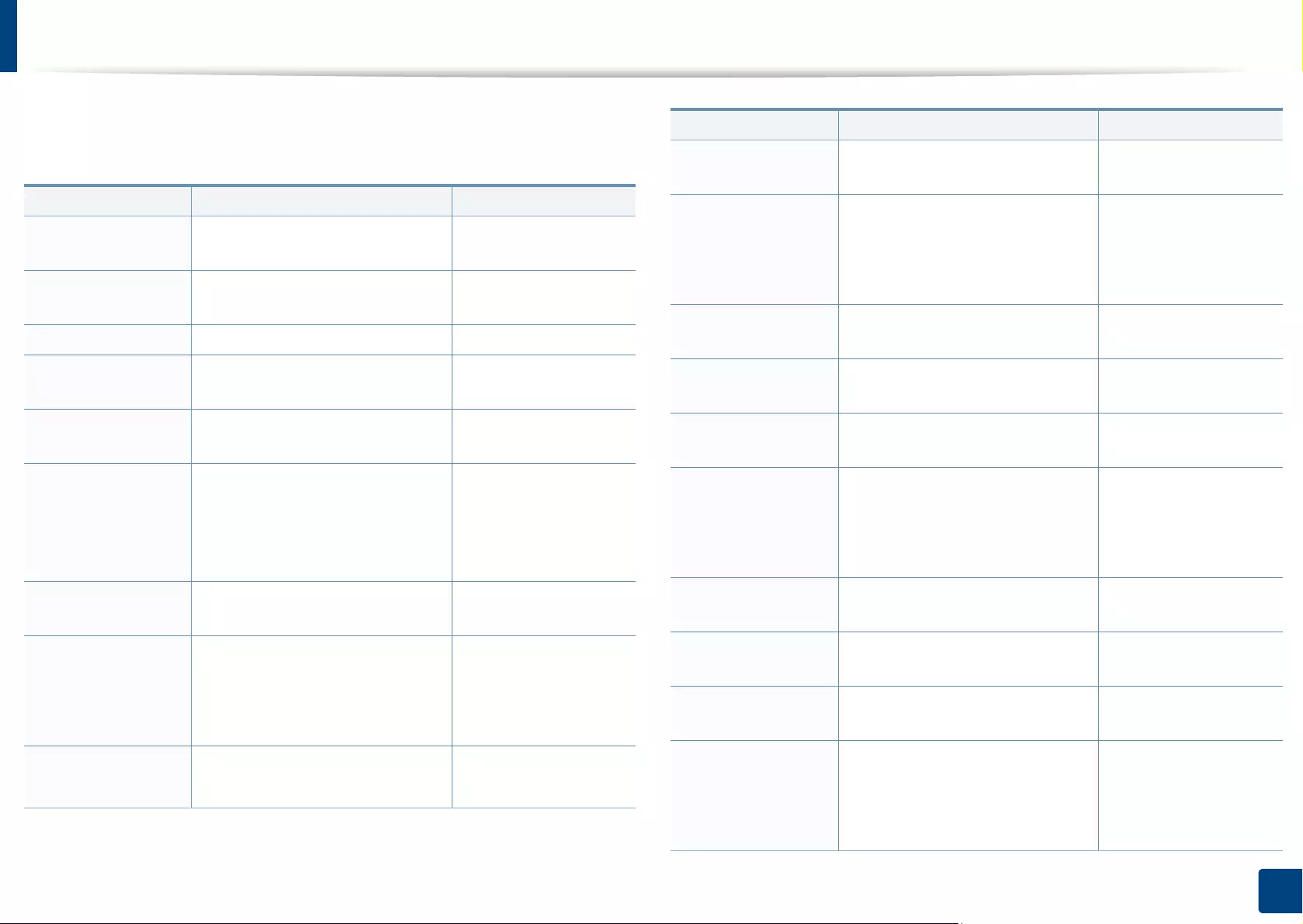
419
Contact SAMSUNG worldwide
Contact SAMSUNG worldwide
If you have any comments or questions regarding Samsung products, contact
the Samsung customer care center.
Country/Region Customer Care Center WebSite
ALGERIA 3004 (Toll Free) www.samsung.com/
n_africa/support
ANGOLA 917 267 864 www.samsung.com/
support
ARGENTINE 0800-555-SAM(7267) www.samsung.com/ar
ARMENIA 0-800-05-555 www.samsung.com/
support
AUSTRALIA 1300 362 603 www.samsung.com/
au/support
AUSTRIA
0800-SAMSUNG (0800-7267864)
[Only for Premium HA] 0800-
366661
[Only for Dealers] 0810-112233
www.samsung.com/
at/support
AZERBAIJAN 0-88-555-55-55 www.samsung.com/
support
BAHRAIN
8000-GSAM (8000-4726) www.samsung.com/
ae/support (English)
www.samsung.com/
ae_ar/support (Arabic)
BANGLADESH 0961-2300300
0800-0300300 (Toll free)
www.samsung.com/
in/support
BELARUS 810-800-500-55-500 www.samsung.com/
support
BELGIUM
02-201-24-18 www.samsung.com/
be/support (Dutch)
www.samsung.com/
be_fr/support (French)
BOLIVIA 800-10-7260 www.samsung.com/
cl/support
BOSNIA 055 233 999 www.samsung.com/
support
BOTSWANA 8007260000 www.samsung.com/
support
BRAZIL
0800-124-421 (Demais cidades e
regiões)
4004-0000 (Capitais e grandes
centros)
www.samsung.com/
br/support
BULGARIA 0800 111 31 , Безплатна
телефонна линия
www.samsung.com/
bg/support
BURUNDI 200 www.samsung.com/
support
CAMEROON 7095- 0077 www.samsung.com/
africa_fr/support
CANADA
1-800-SAMSUNG (726-7864) www.samsung.com/
ca/support(English)
www.samsung.com/
ca_fr/support (French)
Country/Region Customer Care Center WebSite
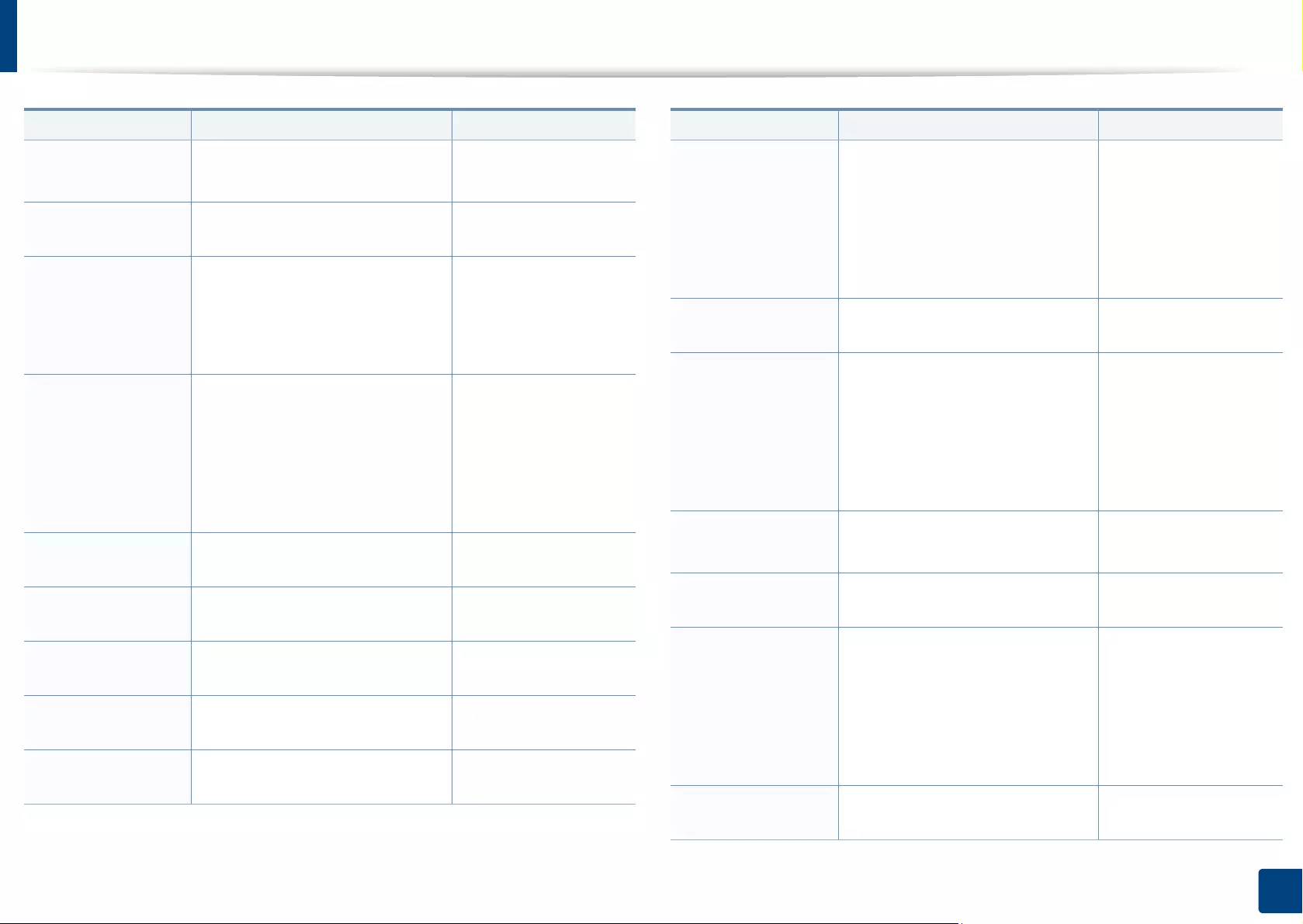
Contact SAMSUNG worldwide
420
Contact SAMSUNG worldwide
CHILE 800-SAMSUNG (726-7864)
[HHP] 02-24828200
www.samsung.com/
cl/support
CHINA 400-810-5858 www.samsung.com/
cn/support
COLOMBIA
Bogotá en el 600 12 72
Sin costo en todo el pais 01 8000
112 112
Y desde tu celular #726
www.samsung.com/
co
COSTA RICA
00-800-1-SAMSUNG (726-7864) www.samsung.com/
latin/support
(Spanish)
www.samsung.com/
latin_en/support
(English)
CROATIA 072 726 786 www.samsung.com/
hr/support
Cote D’ Ivoire 8000 0077 www.samsung.com/
africa_fr/support
CYPRUS 8009 4000 only from landline, toll
free
www.samsung.com/
gr/support
CZECH 800-SAMSUNG (800-726786) www.samsung.com/
cz/support
DENMARK 70 70 19 70 www.samsung.com/
dk/support
Country/Region Customer Care Center WebSite
DOMINICAN
REPUBLIC
1-800-751-2676 www.samsung.com/
latin/support
(Spanish)
www.samsung.com/
latin_en/support
(English)
DRC 499999 www.samsung.com/
support
ECUADOR
1-800-SAMSUNG (72-6786) www.samsung.com/
latin/support
(Spanish)
www.samsung.com/
latin_en/
support(English)
EGYPT 08000-7267864
16580
www.samsung.com/
eg/support
EIRE 0818 717100 www.samsung.com/
ie/support
EL SALVADOR
8000-SAMSUNG (726-7864) www.samsung.com/
latin/support
(Spanish)
www.samsung.com/
latin_en/support
(English)
ESTONIA 800-7267 www.samsung.com/
ee/support
Country/Region Customer Care Center WebSite
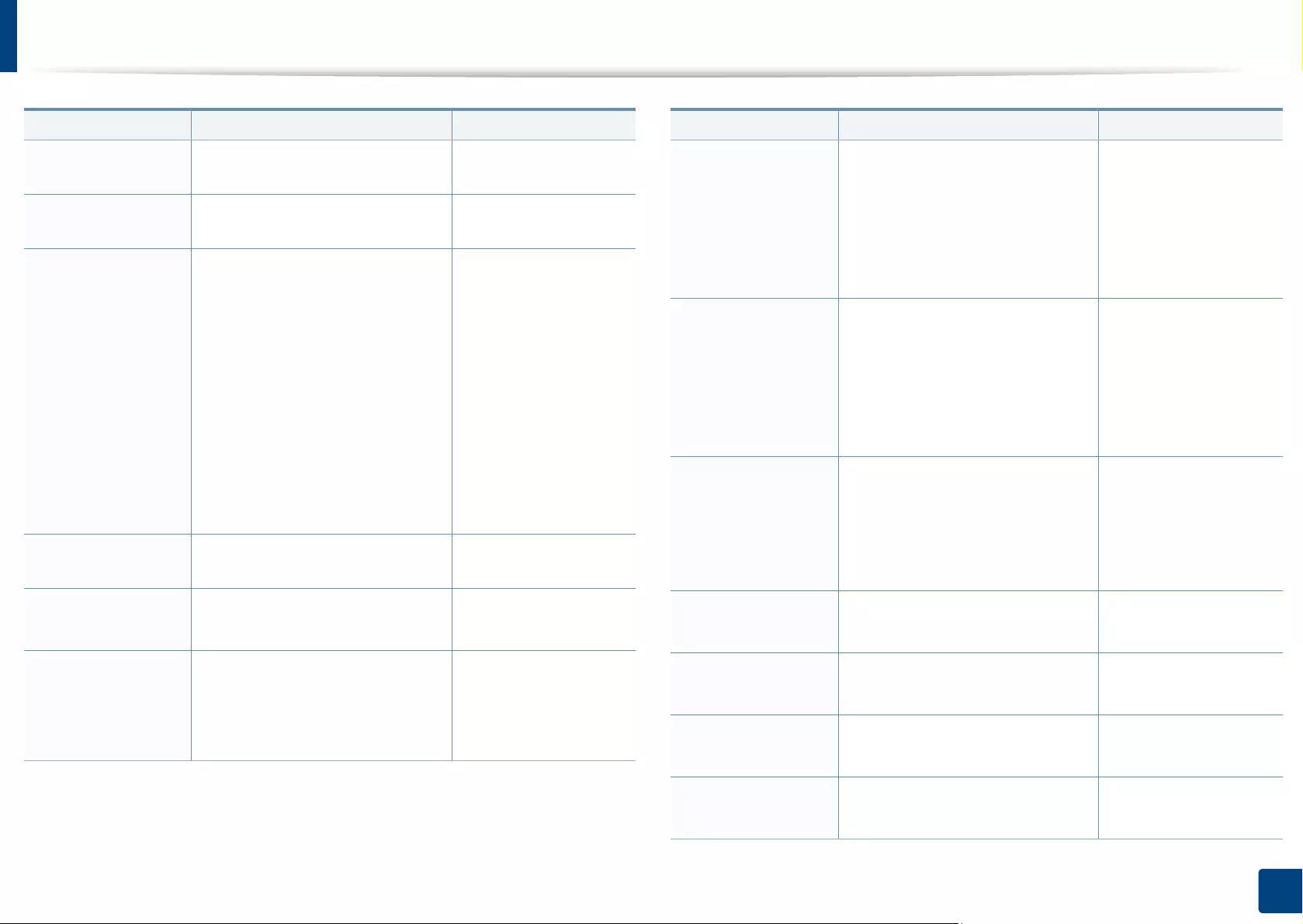
Contact SAMSUNG worldwide
421
Contact SAMSUNG worldwide
FINLAND 030-6227 515 www.samsung.com/fi/
support
FRANCE 01 48 63 00 00 www.samsung.com/
fr/support
GERMANY
0180 6 SAMSUNG bzw.
0180 6 7267864*
(*0,20 €/Anruf aus dem dt.
Festnetz, aus dem Mobilfunk
max. 0,60 €/Anruf)
[HHP] 0180 6 M SAMSUNG bzw.
0180 6 67267864*
(*0,20 €/Anruf aus dem dt.
Festnetz, aus dem Mobilfunk
max. 0,60 €/Anruf)
www.samsung.com/
de/support
GEORGIA 0-800-555-555 www.samsung.com/
support
GHANA 0800-10077
0302-200077
www.samsung.com/
africa_en/support
GREECE
80111-SAMSUNG (80111 726
7864) only from land line
(+30) 210 6897691 from mobile
and land line
www.samsung.com/
gr/support
Country/Region Customer Care Center WebSite
GUATEMALA
1-800-299-0033 www.samsung.com/
latin/support
(Spanish)
www.samsung.com/
latin_en/support
(English)
HONDURAS
800-2791-9111 www.samsung.com/
latin/support
(Spanish)
www.samsung.com/
latin_en/support
(English)
HONG KONG
3698 4698 www.samsung.com/
hk/support (Chinese)
www.samsung.com/
hk_en/support
(English)
HUNGARY 0680SAMSUNG (0680-726-786)
0680PREMIUM (0680-773-648)
www.samsung.com/
hu/support
INDIA 1800 3000 8282 - Toll Free
1800 266 8282 - Toll Free
www.samsung.com/
in/support
INDONESIA 021-56997777
08001128888
www.samsung.com/
id/support
IRAN 021-8255 [CE]
021-42132 [HHP]
www.samsung.com/
iran/support
Country/Region Customer Care Center WebSite
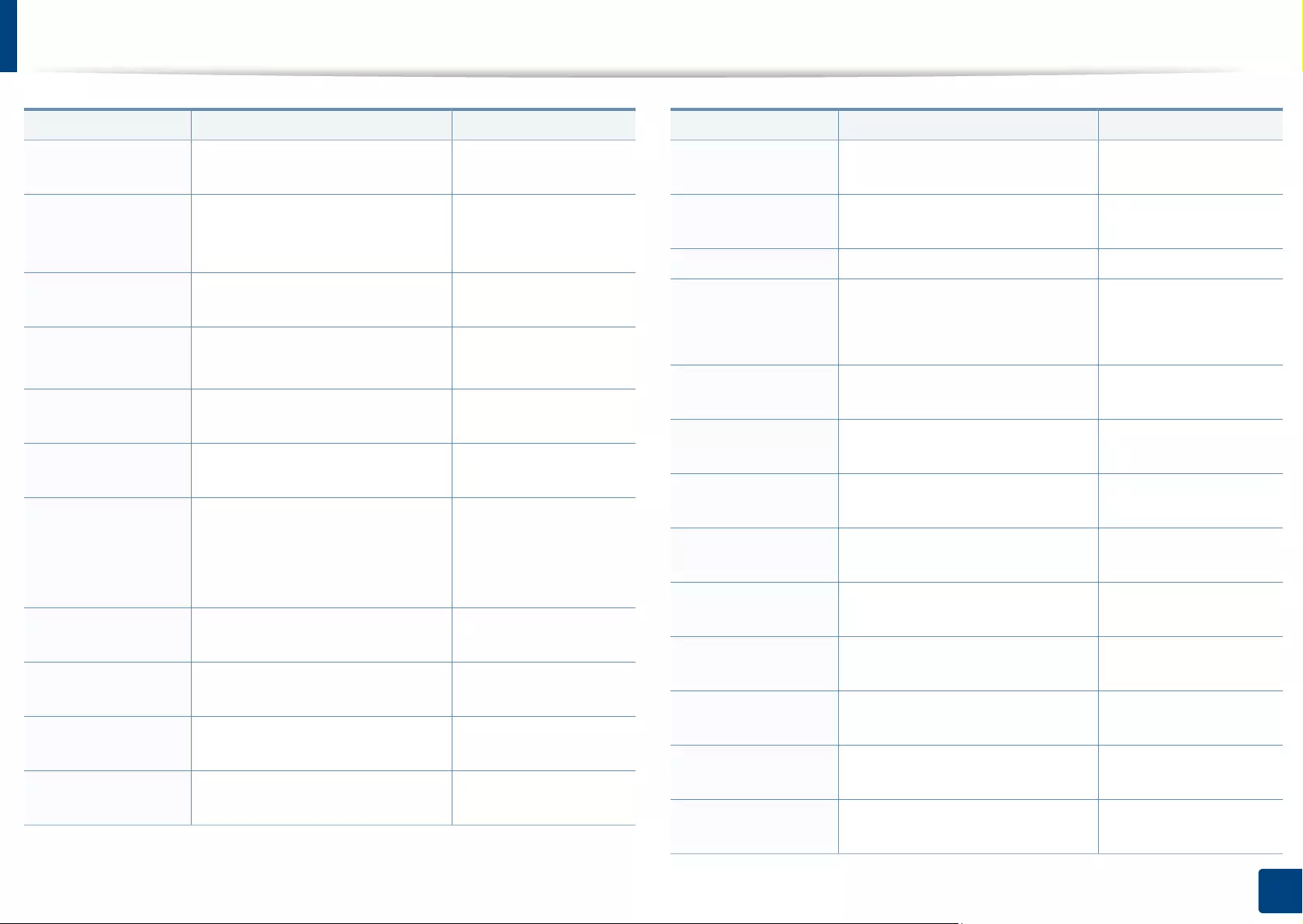
Contact SAMSUNG worldwide
422
Contact SAMSUNG worldwide
ITALIA 800-SAMSUNG (800.7267864) www.samsung.com/
it/support
JAMAICA
1-800-SAMSUNG (726-7864) www.samsung.com/
latin_en/support
(English)
JAPAN 0120-363-905 www.samsung.com/
jp/support
JORDAN 0800-22273
06 5777444
www.samsung.com/
Levant
KAZAKHSTAN 8-10-800-500-55-500 (GSM:
7799, VIP care 7700)
www.samsung.com/
kz_ru/support
KENYA 0800 545 545 www.samsung.com/
support
KUWAIT
183-CALL (183-2255) www.samsung.com/
ae/support (English)
www.samsung.com/
ae_ar/support (Arabic)
KYRGYZSTAN 00-800-500-55-500 (GSM: 9977) www.samsung.com/
support
LATVIA 8000-7267 www.samsung.com/
lv/support
LEBANON 961 1484 999 www.samsung.com/
Levant
LITHUANIA 8-800-77777 www.samsung.com/
lt/support
Country/Region Customer Care Center WebSite
LUXEMBURG 261 03 710 www.samsung.com/
be_fr/support
MACAU 0800 333 www.samsung.com/
support
MACEDONIA 023 207 777
MALAYSIA
1800-88-9999
603-77137477 (Overseas
contact)
www.samsung.com/
my/support
MAURITIUS 800 2550 www.samsung.com/
support
MEXICO 01-800-SAMSUNG (726-7864) www.samsung.com/
mx/support
MOLDOVA 0-800-614-40 www.samsung.com/
support
MONGOLIA +7-495-363-17-00 www.samsung.com/
support
MONTENEGRO 020 405 888 www.samsung.com/
support
MOROCCO 080 100 22 55 www.samsung.com/
n_africa/support
MOZAMBIQUE 847267864 / 827267864 www.samsung.com/
support
MYANMAR +95-01-2399-888 www.samsung.com/
support
NAMIBIA 08 197 267864 www.samsung.com/
support
Country/Region Customer Care Center WebSite
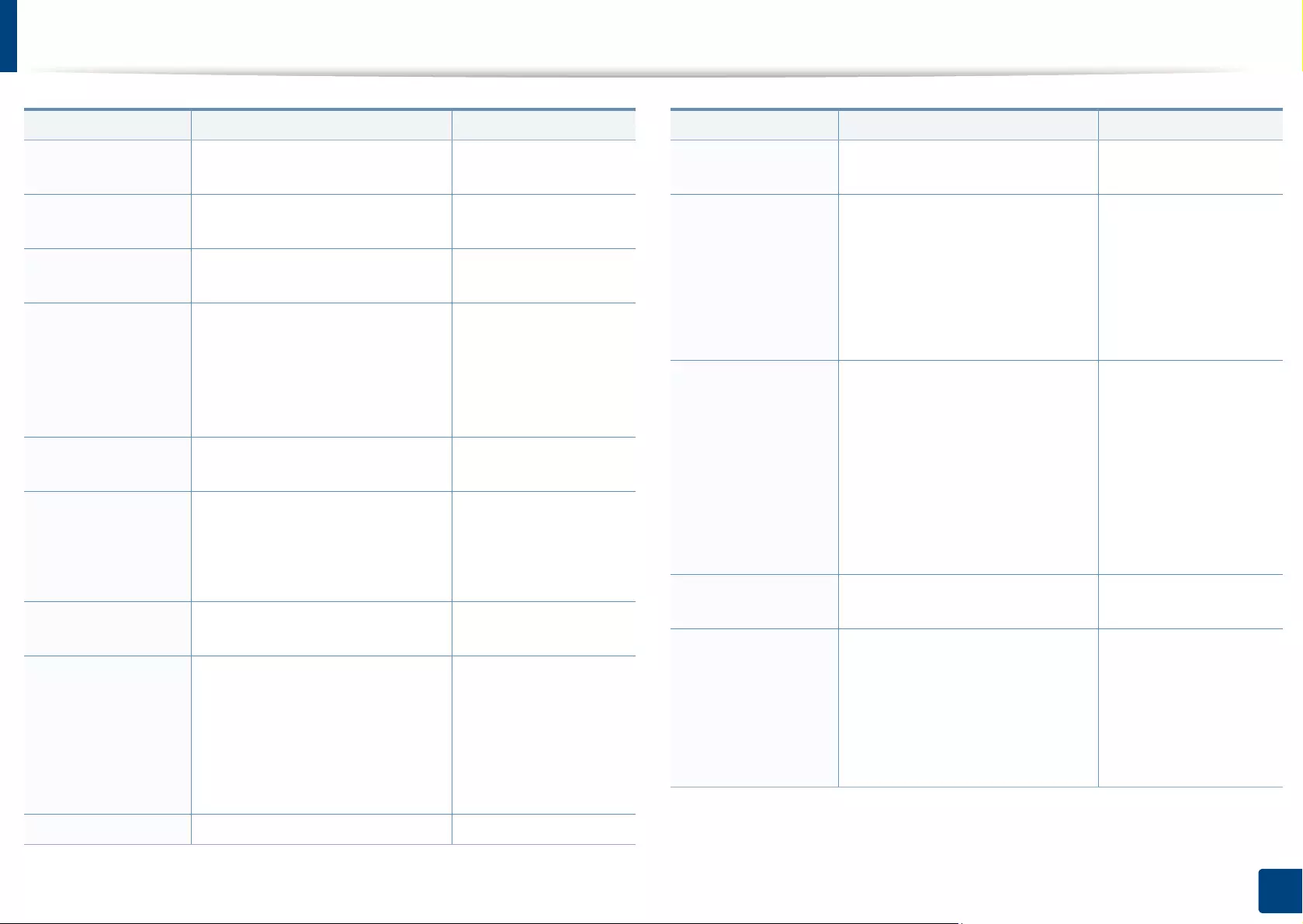
Contact SAMSUNG worldwide
423
Contact SAMSUNG worldwide
NIGERIA 0800-726-7864 www.samsung.com/
africa_en/support
NETHERLANDS 0900-SAMSUNG (0900-7267864)
(€ 0,10/Min)
www.samsung.com/
nl/support
NEW ZEALAND 0800 726 786 www.samsung.com/
nz/support
NICARAGUA
001-800-5077267 www.samsung.com/
latin/support(Spanish)
www.samsung.com/
latin_en/support
(English)
NORWAY 815 56480 www.samsung.com/
no/support
OMAN
800-SAMSUNG (800 - 726 7864) www.samsung.com/
ae/support (English)
www.samsung.com/
ae_ar/support (Arabic)
PAKISTAN 0800-Samsung (72678) www.samsung.com/
pk/support
PANAMA
800-0101 www.samsung.com/
latin/support
(Spanish)
www.samsung.com/
latin_en/support
(English)
PARAGUAY 0800-11-SAMS(7267) www.samsung.com/ar
Country/Region Customer Care Center WebSite
PERU 0800-777-08 www.samsung.com/
pe/support
PHILIPPINES
1-800-10-726-7864 [ PLDT Toll
Free ]
1-800-8-726-7864 [ Globe
Landline and Mobile ]
02- 422-2111 [ Standard Landline
]
www.samsung.com/
ph/support
POLAND
801-172-678* lub +48 22 607-93-
33*
Dedykowana infolinia do obsługi
zapytań dotyczących telefonów
komórkowych: 801-672-678* lub
+48 22 607-93-33*
* (koszt połączenia według taryfy
operatora)
www.samsung.com/
pl/support
PORTUGAL 808 20 7267 www.samsung.com/
pt/support
PUERTO RICO
1-800-682-3180 www.samsung.com/
latin/support
(Spanish)
www.samsung.com/
latin_en/support
(English)
Country/Region Customer Care Center WebSite
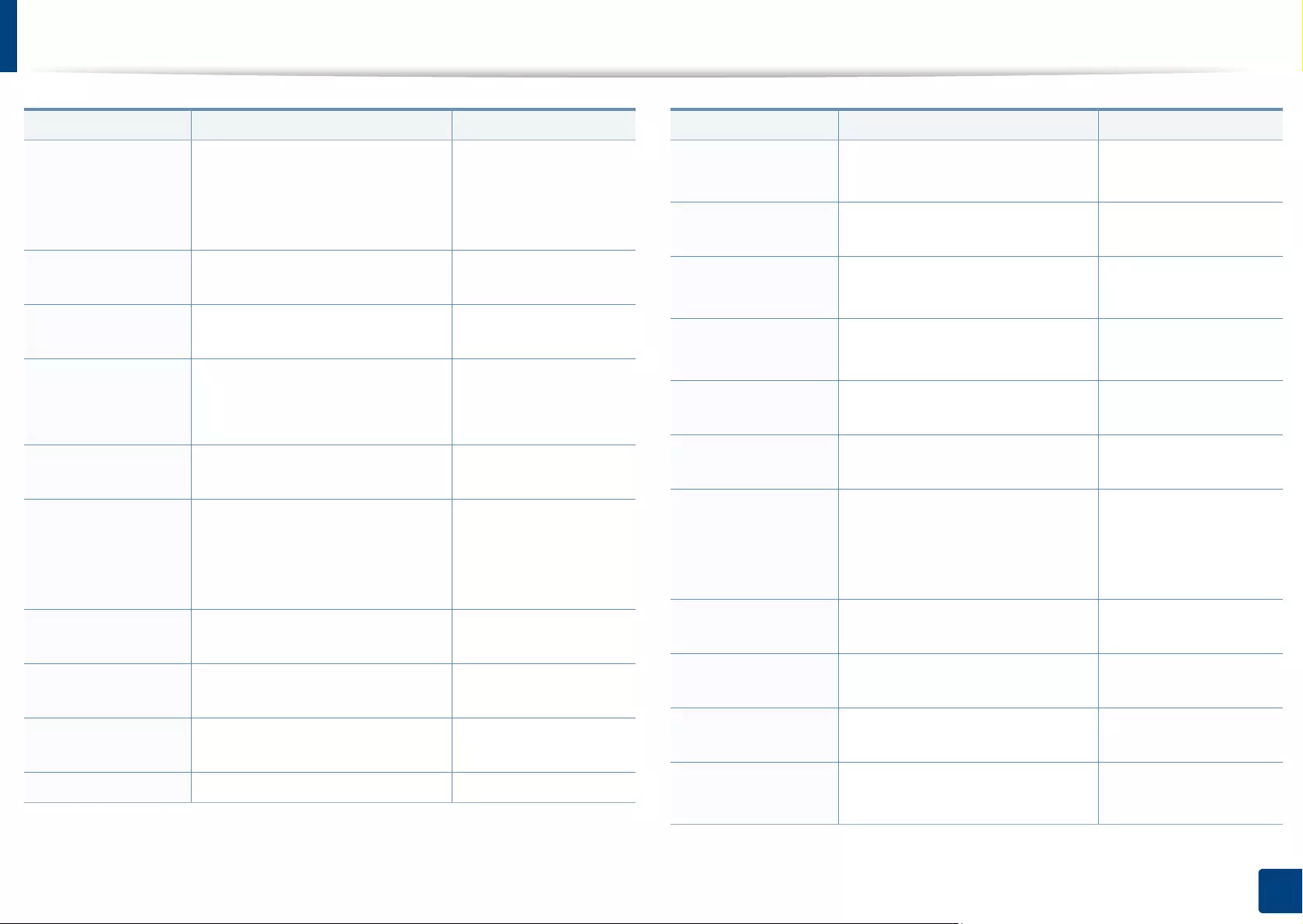
Contact SAMSUNG worldwide
424
Contact SAMSUNG worldwide
QATAR
800-CALL (800-2255) www.samsung.com/
ae/support (English)
www.samsung.com/
ae_ar/support (Arabic)
REUNION 0262 50 88 80 www.samsung.com/
support
RWANDA 9999 www.samsung.com/
support
ROMANIA
*8000 (apel in retea)
08008-726-78-64 (08008-
SAMSUNG) Apel GRATUIT
www.samsung.com/
ro/support
RUSSIA 8-800-555-55-55 (VIP care 8-800-
555-55-88)
www.samsung.com/
ru/support
SAUDI ARABIA
800 247 3457 (800 24/7 HELP) www.samsung.com/
sa/home
www.samsung.com/
sa_en
SENEGAL 800-00-0077 www.samsung.com/
africa_fr/support
SERBIA 011 321 6899 www.samsung.com/
rs/support
SINGAPORE 1800-SAMSUNG (726-7864) www.samsung.com/
sg/support
SLOVENIA 080 697 267 (brezplačna številka) www.samsung.com/si
Country/Region Customer Care Center WebSite
SLOVAKIA 0800 - SAMSUNG
(0800-726 786)
www.samsung.com/
sk/support
SOUTH AFRICA 0860 SAMSUNG (726 7864) www.samsung.com/
support
SPAIN 0034902172678
[HHP] 0034902167267
www.samsung.com/
es/support
SRI LANKA 0117540540
0115900000
www.samsung.com/
support
SUDAN 1969 www.samsung.com/
support
SWEDEN 0771 726 7864 (0771-SAMSUNG) www.samsung.com/
se/support
SWITZERLAND
0800 726 78 64 (0800-SAMSUNG) www.samsung.com/
ch/support (German)
www.samsung.com/
ch_fr/support (French)
SYRIA 18252273 www.samsung.com/
Levant
TAJIKISTAN 8-10-800-500-55-500 www.samsung.com/
support
TAIWAN 0800-329999 www.samsung.com/
tw/support
TANZANIA 0800 755 755
0685 889 900
www.samsung.com/
support
Country/Region Customer Care Center WebSite
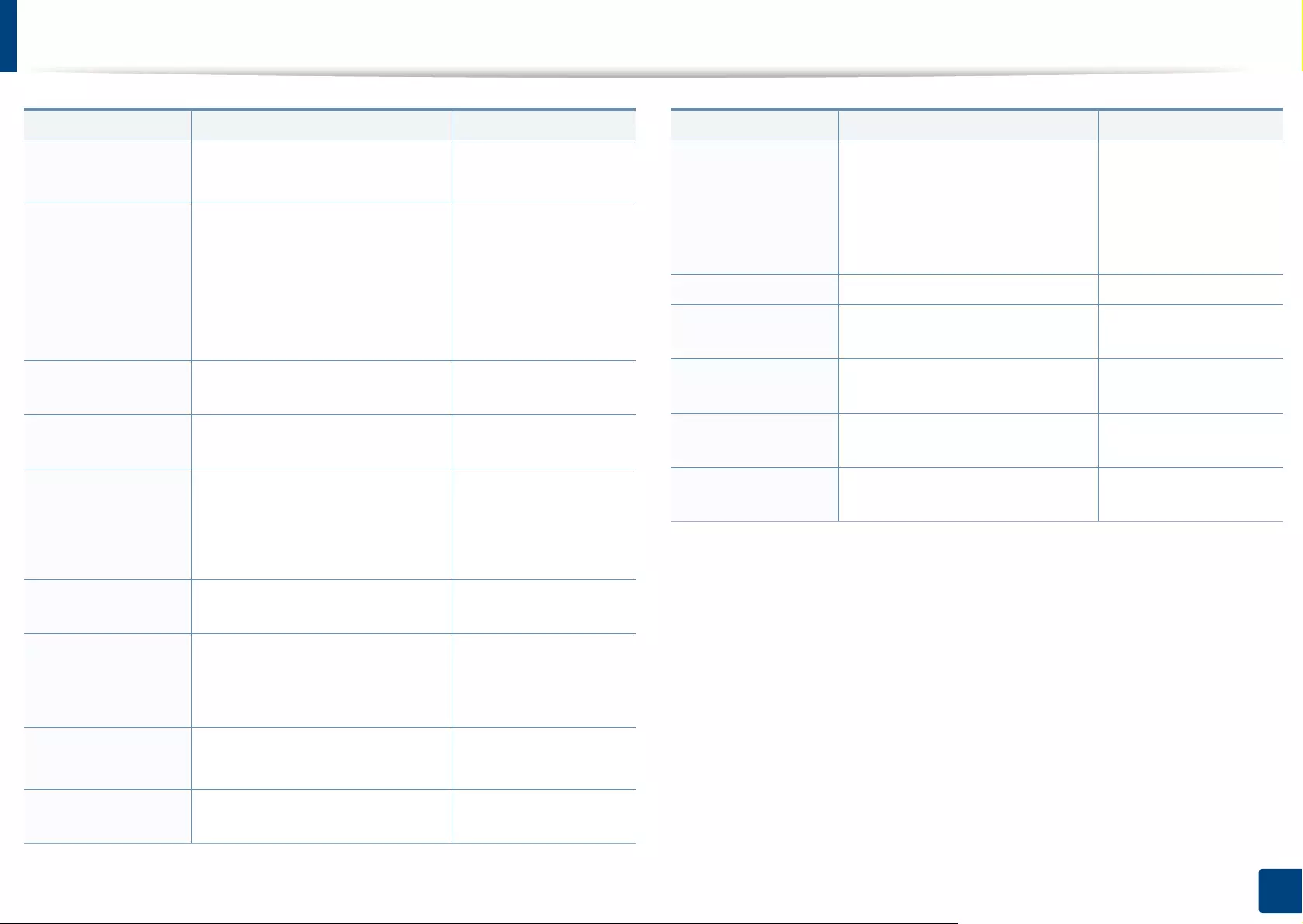
Contact SAMSUNG worldwide
425
Contact SAMSUNG worldwide
THAILAND 0-2689-3232,
1800-29-3232
www.samsung.com/
th/support
TRINIDAD &
TOBAGO
1-800-SAMSUNG (726-7864) www.samsung.com/
latin/support
(Spanish)
www.samsung.com/
latin_en/support
(English)
TURKEY 444 77 11 www.samsung.com/
tr/support
TUNISIA 80-1000-12 www.samsung.com/
n_africa/support
U.A.E
800-SAMSUNG (800 -726 7864) www.samsung.com/
ae/support (English)
www.samsung.com/
ae_ar/support (Arabic)
UK 0330 SAMSUNG (7267864) www.samsung.com/
uk/support
U.S.A
-Consumer
Electonics
1-800-SAMSUNG (726-7864) www.samsung.com/
us/support
U.S.A
-(Mobile Phones)
1-800-SAMSUNG (726-7864) www.samsung.com/
us/support
UGANDA 0800 300 300 www.samsung.com/
support
Country/Region Customer Care Center WebSite
UKRAINE
0-800-502-000 www.samsung.com/
ua/support (Ukrainian)
www.samsung.com/
ua_ru/support
(Russian)
URUGUAY 0800-SAMS(7267) www.samsung.com/ar
UZBEKISTAN 00-800-500-55-500 (GSM: 7799) www.samsung.com/
support
VENEZUELA 0-800-SAMSUNG (726-7864) www.samsung.com/
ve/support
VIETNAM 1800 588 889 www.samsung.com/
vn/support
ZAMBIA 0211 350370 www.samsung.com/
support
Country/Region Customer Care Center WebSite
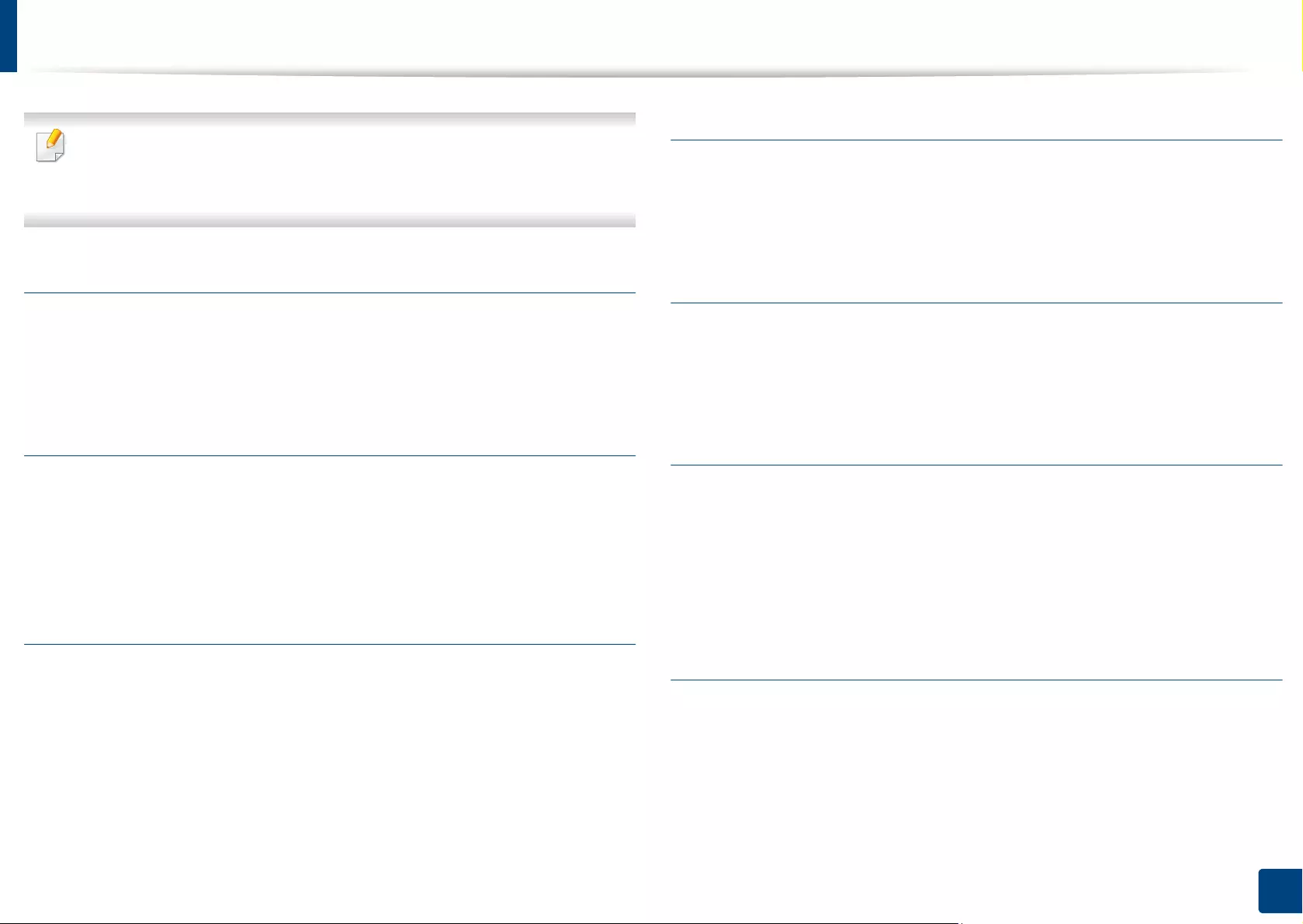
426
Glossary
Glossary
The following glossary helps you get familiar with the product by
understanding the terminologies commonly used with printing as well as
mentioned in this user’s guide.
802.11
802.11 is a set of standards for wireless local area network (WLAN)
communication, developed by the IEEE LAN/MAN Standards Committee (IEEE
802).
802.11b/g/n
802.11b/g/n can share same hardware and use the 2.4 GHz band. 802.11b
supports bandwidth up to 11 Mbps, 802.11n supports bandwidth up to 150
Mbps. 802.11b/g/n devices may occasionally suffer interference from
microwave ovens, cordless telephones, and Bluetooth devices.
Access point
Access Point or Wireless Access Point (AP or WAP) is a device that connects
wireless communication devices together on wireless local area networks
(WLAN), and acts as a central transmitter and receiver of WLAN radio signals.
ADF
An Automatic Document Feeder (ADF) is a scanning unit that will automatically
feed an original sheet of paper so that the machine can scan some amount of the
paper at once.
AppleTalk
AppleTalk is a proprietary suite of protocols developed by Apple, Inc for
computer networking. It was included in the original Mac (1984) and is now
deprecated by Apple in favor of TCP/IP networking.
BIT Depth
A computer graphics term describing the number of bits used to represent the
color of a single pixel in a bitmapped image. Higher color depth gives a broader
range of distinct colors. As the number of bits increases, the number of possible
colors becomes impractically large for a color map. 1-bit color is commonly
called as monochrome or black and white.
BMP
A bitmapped graphics format used internally by the Microsoft Windows
graphics subsystem (GDI), and used commonly as a simple graphics file format
on that platform.
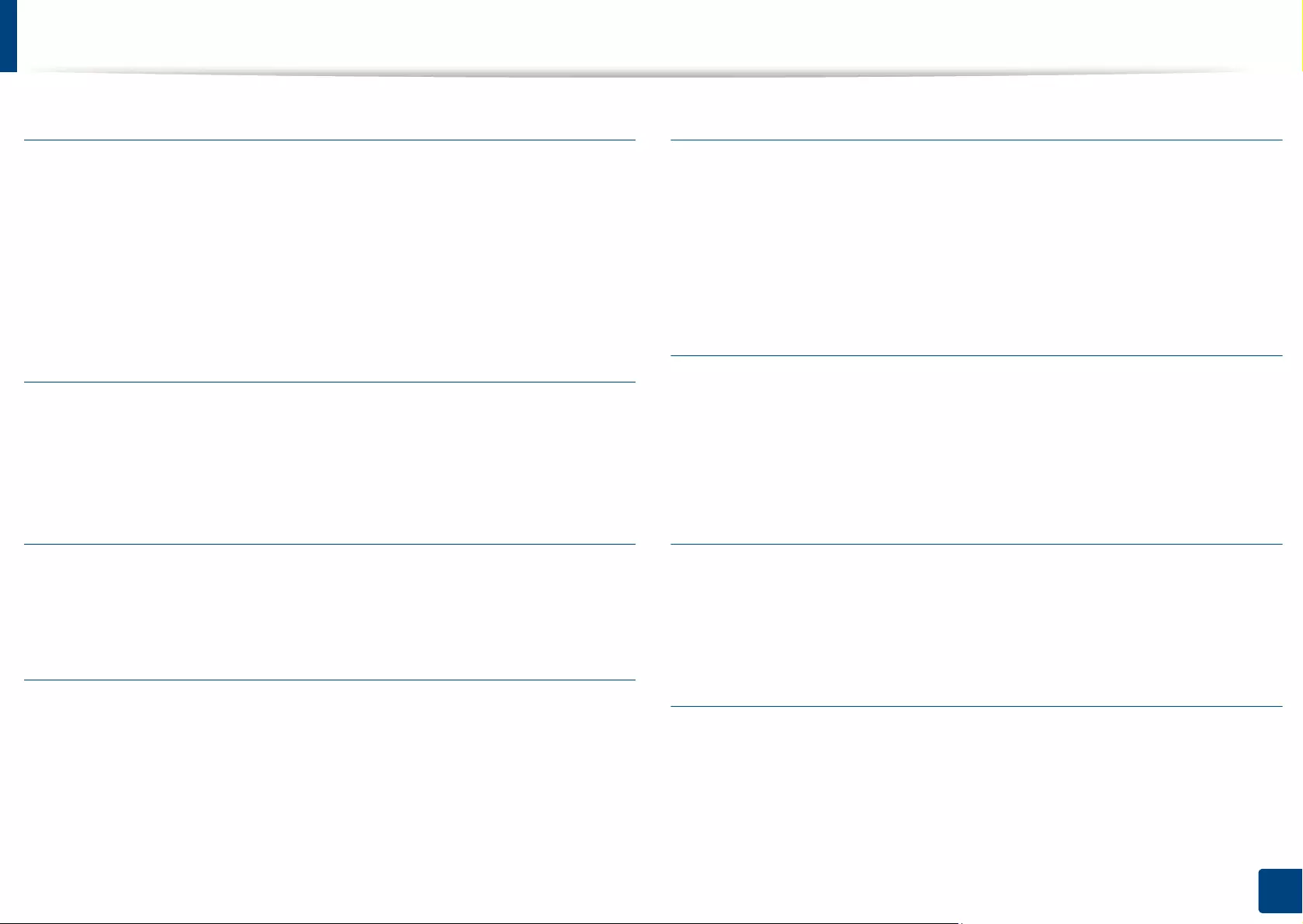
Glossary
427
Glossary
BOOTP
Bootstrap Protocol. A network protocol used by a network client to obtain its IP
address automatically. This is usually done in the bootstrap process of
computers or operating systems running on them. The BOOTP servers assign
the IP address from a pool of addresses to each client. BOOTP enables 'diskless
workstation' computers to obtain an IP address prior to loading any advanced
operating system.
CCD
Charge Coupled Device (CCD) is a hardware which enables the scan job. CCD
Locking mechanism is also used to hold the CCD module to prevent any damage
when you move the machine.
Collation
Collation is a process of printing a multiple-copy job in sets. When collation is
selected, the device prints an entire set before printing additional copies.
Control Panel
A control panel is a flat, typically vertical, area where control or monitoring
instruments are displayed. They are typically found in front of the machine.
Coverage
It is the printing term used for a toner usage measurement on printing. For
example, 5% coverage means that an A4 sided paper has about 5% image or text
on it. So, if the paper or original has complicated images or lots of text on it, the
coverage will be higher and at the same time, a toner usage will be as much as
the coverage.
CSV
Comma Separated Values (CSV). A type of file format, CSV is used to exchange
data between disparate applications. The file format, as it is used in Microsoft
Excel, has become a de facto standard throughout the industry, even among
non-Microsoft platforms.
DSDF
A Dual Scan Document Feeder (DSDF) is a scanning unit that will automatically
feed and turn over an original sheet of paper so that the machine can scan on
both sides of the paper.
Default
The value or setting that is in effect when taking a printer out of its box state,
reset, or initialized.
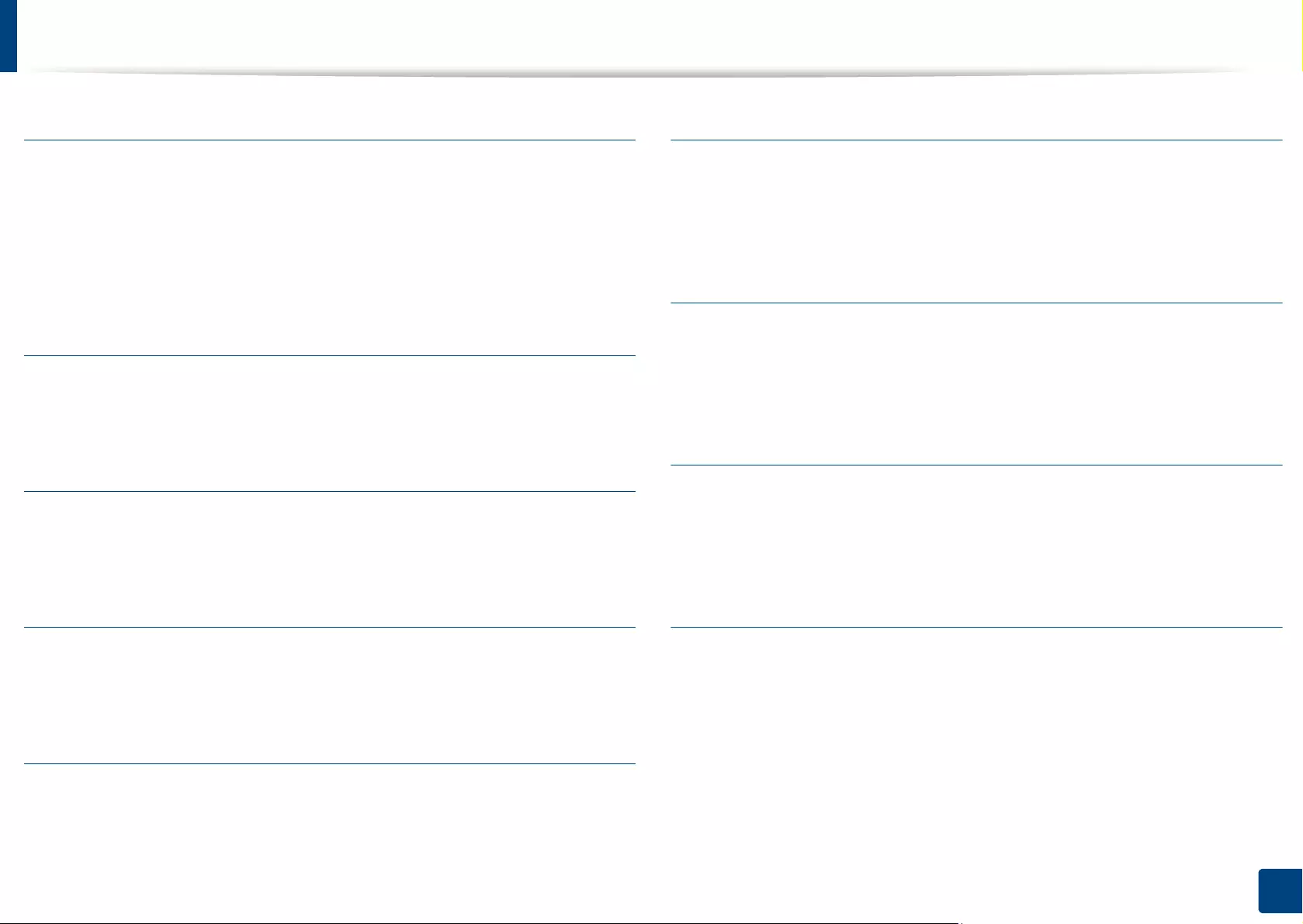
Glossary
428
Glossary
DHCP
A Dynamic Host Configuration Protocol (DHCP) is a client-server networking
protocol. A DHCP server provides configuration parameters specific to the DHCP
client host requesting, generally, information required by the client host to
participate on an IP network. DHCP also provides a mechanism for allocation of
IP addresses to client hosts.
DIMM
Dual Inline Memory Module (DIMM), a small circuit board that holds memory.
DIMM stores all the data within the machine like printing data, received fax data.
DLNA
The Digital Living Network Alliance (DLNA) is a standard that allows devices on
a home network to share information with each other across the network.
DNS
The Domain Name Server (DNS) is a system that stores information associated
with domain names in a distributed database on networks, such as the Internet.
Dot Matrix Printer
A dot matrix printer refers to a type of computer printer with a print head that
runs back and forth on the page and prints by impact, striking an ink-soaked
cloth ribbon against the paper, much like a typewriter.
DPI
Dots Per Inch (DPI) is a measurement of resolution that is used for scanning and
printing. Generally, higher DPI results in a higher resolution, more visible detail
in the image, and a larger file size.
DRPD
Distinctive Ring Pattern Detection. Distinctive Ring is a telephone company
service which enables a user to use a single telephone line to answer several
different telephone numbers.
Duplex
A mechanism that will automatically turn over a sheet of paper so that the
machine can print (or scan) on both sides of the paper. A printer equipped with
a Duplex Unit can print on both sides of paper during one print cycle.
Duty Cycle
Duty cycle is the page quantity which does not affect printer performance for a
month. Generally the printer has the lifespan limitation such as pages per year.
The lifespan means the average capacity of print-outs, usually within the
warranty period. For example, if the duty cycle is 48,000 pages per month
assuming 20 working days, a printer limits 2,400 pages a day.
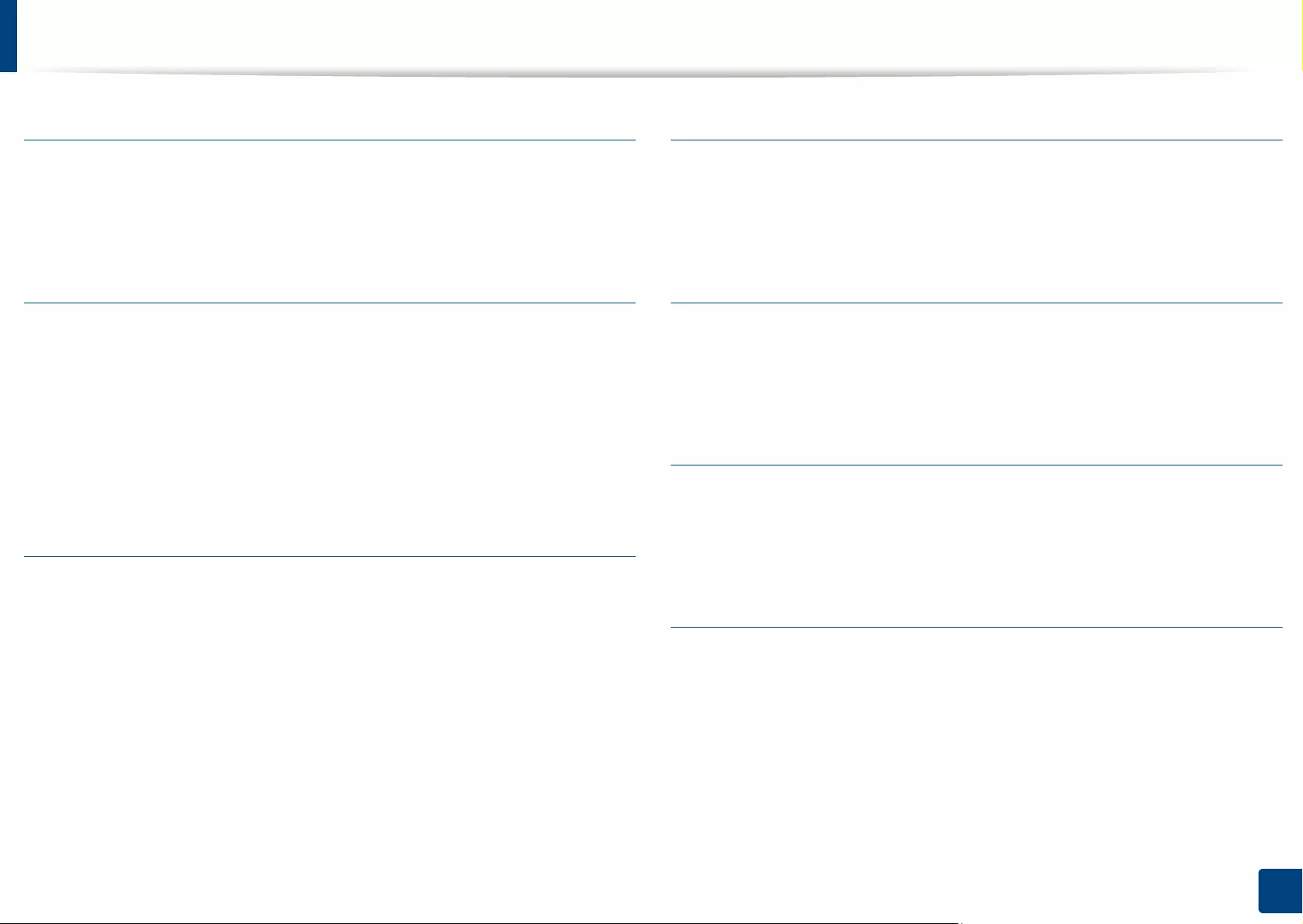
Glossary
429
Glossary
ECM
Error Correction Mode (ECM) is an optional transmission mode built into Class 1
fax machines or fax modems. It automatically detects and corrects errors in the
fax transmission process that are sometimes caused by telephone line noise.
Emulation
Emulation is a technique of one machine obtaining the same results as another.
An emulator duplicates the functions of one system with a different system, so
that the second system behaves like the first system. Emulation focuses on exact
reproduction of external behavior, which is in contrast to simulation, which
concerns an abstract model of the system being simulated, often considering its
internal state.
Ethernet
Ethernet is a frame-based computer networking technology for local area
networks (LANs). It defines wiring and signaling for the physical layer, and frame
formats and protocols for the media access control (MAC)/data link layer of the
OSI model. Ethernet is mostly standardized as IEEE 802.3. It has become the most
widespread LAN technology in use during the 1990s to the present.
EtherTalk
A suite of protocols developed by Apple Computer for computer networking. It
was included in the original Macintosh (1984) and is now deprecated by Apple
in favor of TCP/IP networking.
FDI
Foreign Device Interface (FDI) is a card installed inside the machine to allow a
third party device such as a coin operated device or a card reader. Those devices
allow the pay-for-print service on your machine.
FTP
A File Transfer Protocol (FTP) is a commonly used protocol for exchanging files
over any network that supports the TCP/IP protocol (such as the Internet or an
intranet).
Fuser Unit
The part of a laser printer that fuses the toner onto the print media. It consists of
a heat roller and a pressure roller. After toner is transferred onto the paper, the
fuser unit applies heat and pressure to ensure that the toner stays on the paper
permanently, which is why paper is warm when it comes out of a laser printer.
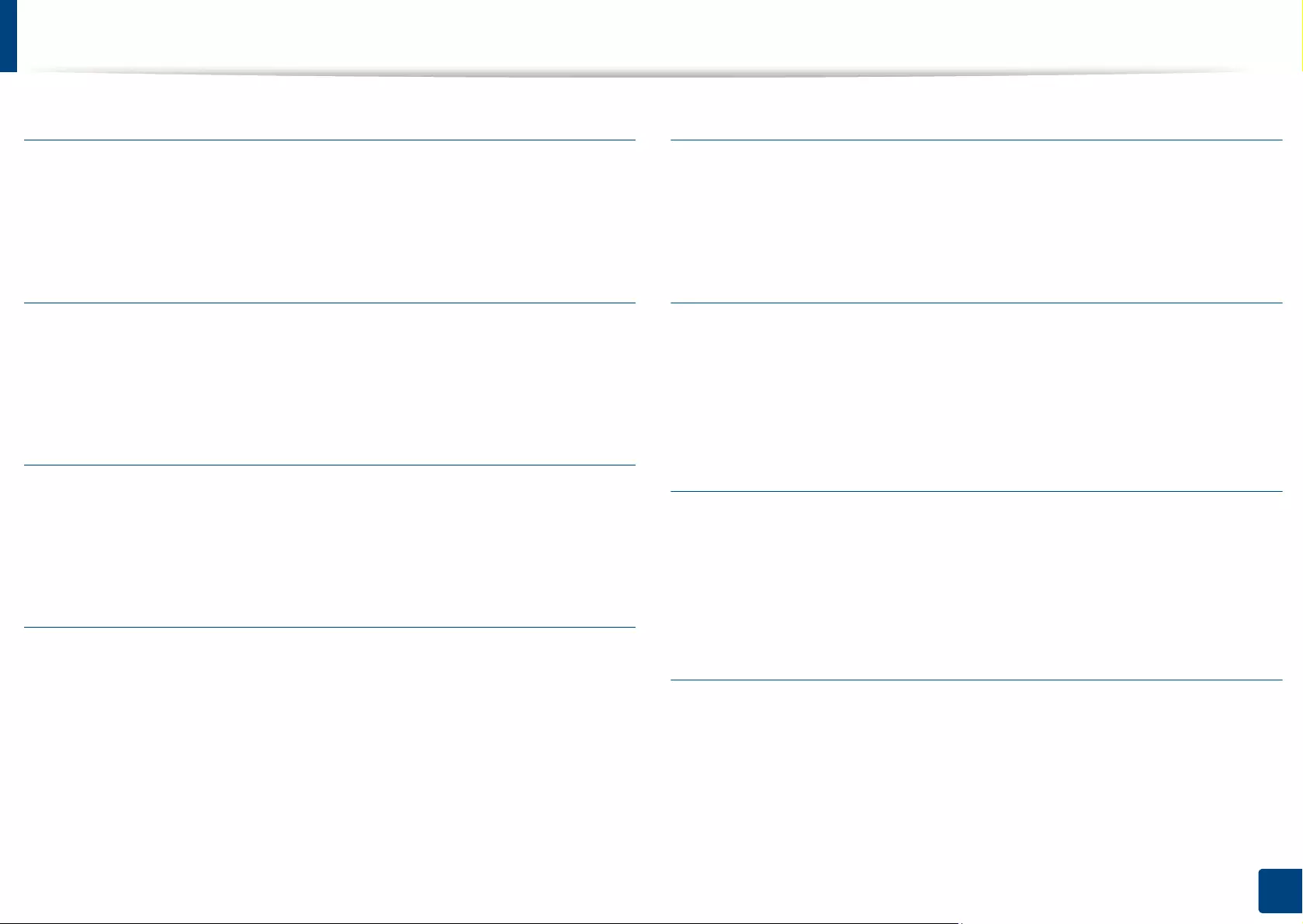
Glossary
430
Glossary
Gateway
A connection between computer networks, or between a computer network
and a telephone line. It is very popular, as it is a computer or a network that
allows access to another computer or network.
Grayscale
A shades of gray that represent light and dark portions of an image when color
images are converted to grayscale; colors are represented by various shades of
gray.
Halftone
An image type that simulates grayscale by varying the number of dots. Highly
colored areas consist of a large number of dots, while lighter areas consist of a
smaller number of dots.
Mass storage device (HDD, Hard disk)
Mass storage device (HDD, Hard disk), commonly referred to as a hard drive or
hard disk, is a non-volatile storage device which stores digitally-encoded data
on rapidly rotating platters with magnetic surfaces.
IEEE
The Institute of Electrical and Electronics Engineers (IEEE) is an international
non-profit, professional organization for the advancement of technology
related to electricity.
IEEE 1284
The 1284 parallel port standard was developed by the Institute of Electrical and
Electronics Engineers (IEEE). The term "1284-B" refers to a specific connector
type on the end of the parallel cable that attaches to the peripheral (for example,
a printer).
Intranet
A private network that uses Internet Protocols, network connectivity, and
possibly the public telecommunication system to securely share part of an
organization's information or operations with its employees. Sometimes the
term refers only to the most visible service, the internal website.
IP address
An Internet Protocol (IP) address is a unique number that devices use in order to
identify and communicate with each other on a network utilizing the Internet
Protocol standard.
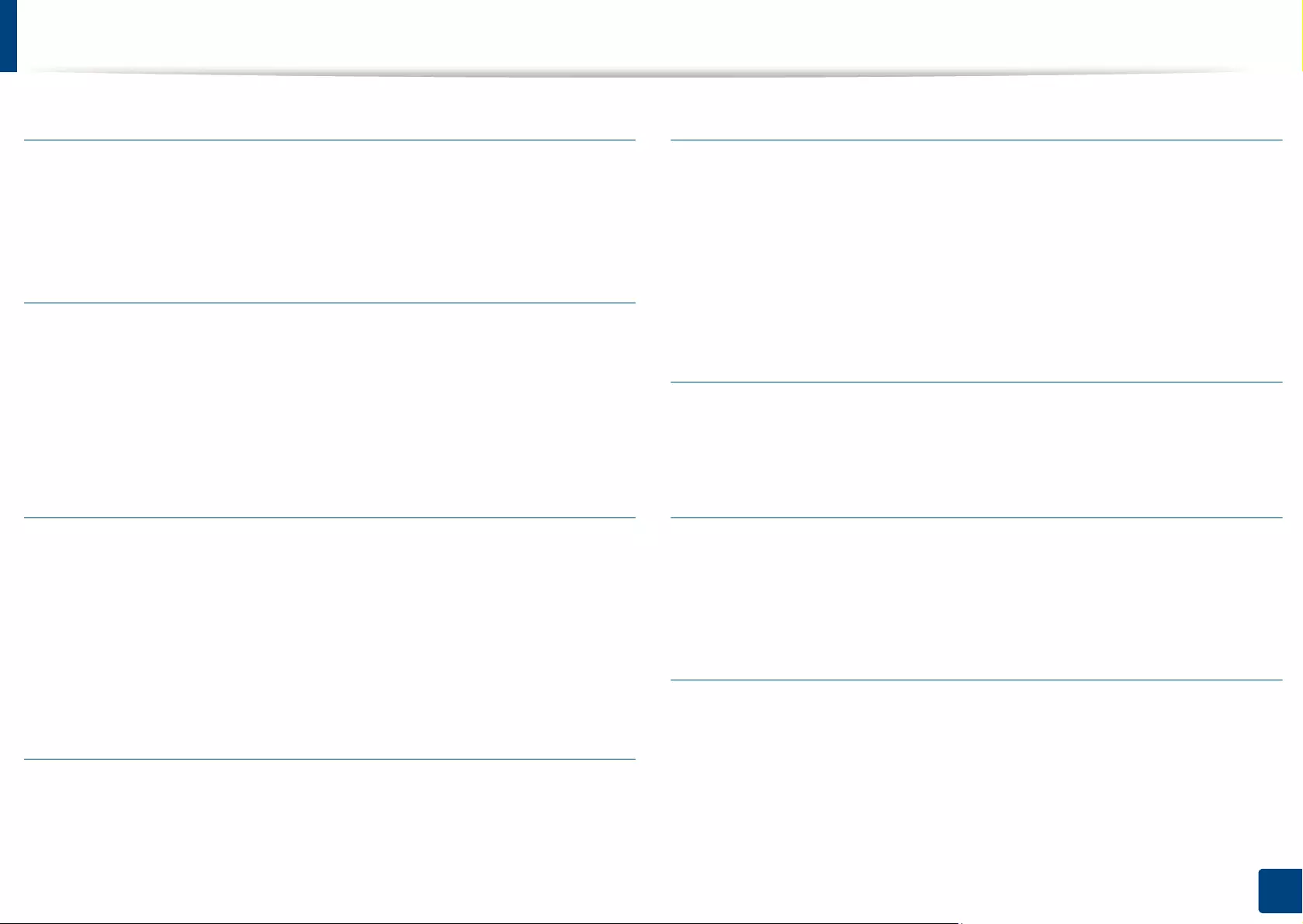
Glossary
431
Glossary
IPM
The Images Per Minute (IPM) is a way of measuring the speed of a printer. An IPM
rate indicates the number of single-sided sheets a printer can complete within
one minute.
IPP
The Internet Printing Protocol (IPP) defines a standard protocol for printing as
well as managing print jobs, media size, resolution, and so forth. IPP can be used
locally or over the Internet to hundreds of printers, and also supports access
control, authentication, and encryption, making it a much more capable and
secure printing solution than older ones.
IPX/SPX
IPX/SPX stands for Internet Packet Exchange/Sequenced Packet Exchange. It is a
networking protocol used by the Novell NetWare operating systems. IPX and
SPX both provide connection services similar to TCP/IP, with the IPX protocol
having similarities to IP, and SPX having similarities to TCP. IPX/SPX was
primarily designed for local area networks (LANs), and is a very efficient protocol
for this purpose (typically its performance exceeds that of TCP/IP on a LAN).
ISO
The International Organization for Standardization (ISO) is an international
standard-setting body composed of representatives from national standards
bodies. It produces world-wide industrial and commercial standards.
ITU-T
The International Telecommunication Union is an international organization
established to standardize and regulate international radio and
telecommunications. Its main tasks include standardization, allocation of the
radio spectrum, and organizing interconnection arrangements between
different countries to allow international phone calls. A -T out of ITU-T indicates
telecommunication.
ITU-T No. 1 chart
Standardized test chart published by ITU-T for document facsimile
transmissions.
JBIG
Joint Bi-level Image Experts Group (JBIG) is an image compression standard with
no loss of accuracy or quality, which was designed for compression of binary
images, particularly for faxes, but can also be used on other images.
JPEG
Joint Photographic Experts Group (JPEG) is a most commonly used standard
method of lossy compression for photographic images. It is the format used for
storing and transmitting photographs on the World Wide Web.
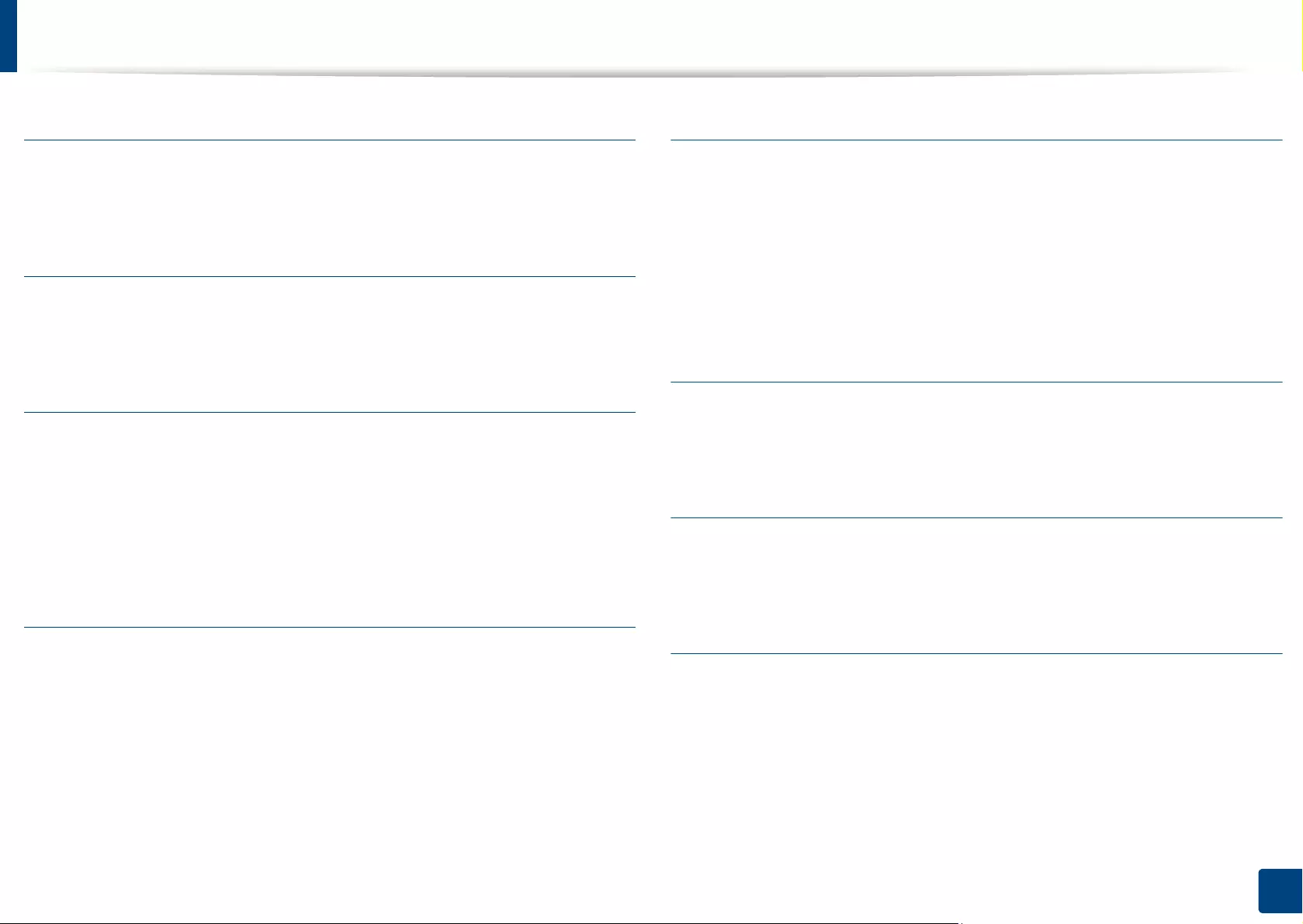
Glossary
432
Glossary
LDAP
The Lightweight Directory Access Protocol (LDAP) is a networking protocol for
querying and modifying directory services running over TCP/IP.
LED
A Light-Emitting Diode (LED) is a semiconductor device that indicates the status
of a machine.
Mac address
Media Access Control (MAC) address is a unique identifier associated with a
network adapter. MAC address is a unique 48-bit identifier usually written as 12
hexadecimal characters grouped in pairs (e. g., 00-00-0c-34-11-4e). This address
is usually hard-coded into a Network Interface Card (NIC) by its manufacturer,
and used as an aid for routers trying to locate machines on large networks.
MFP
Multi Function Peripheral (MFP) is an office machine that includes the following
functionality in one physical body, so as to have a printer, a copier, a fax, a
scanner and etc.
MH
Modified Huffman (MH) is a compression method for decreasing the amount of
data that needs to be transmitted between the fax machines to transfer the
image recommended by ITU-T T.4. MH is a codebook-based run-length
encoding scheme optimized to efficiently compress white space. As most faxes
consist mostly of white space, this minimizes the transmission time of most
faxes.
MMR
Modified Modified READ (MMR) is a compression method recommended by ITU-
T T.6.
Modem
A device that modulates a carrier signal to encode digital information, and also
demodulates such a carrier signal to decode transmitted information.
MR
Modified Read (MR) is a compression method recommended by ITU-T T.4. MR
encodes the first scanned line using MH. The next line is compared to the first,
the differences determined, and then the differences are encoded and
transmitted.
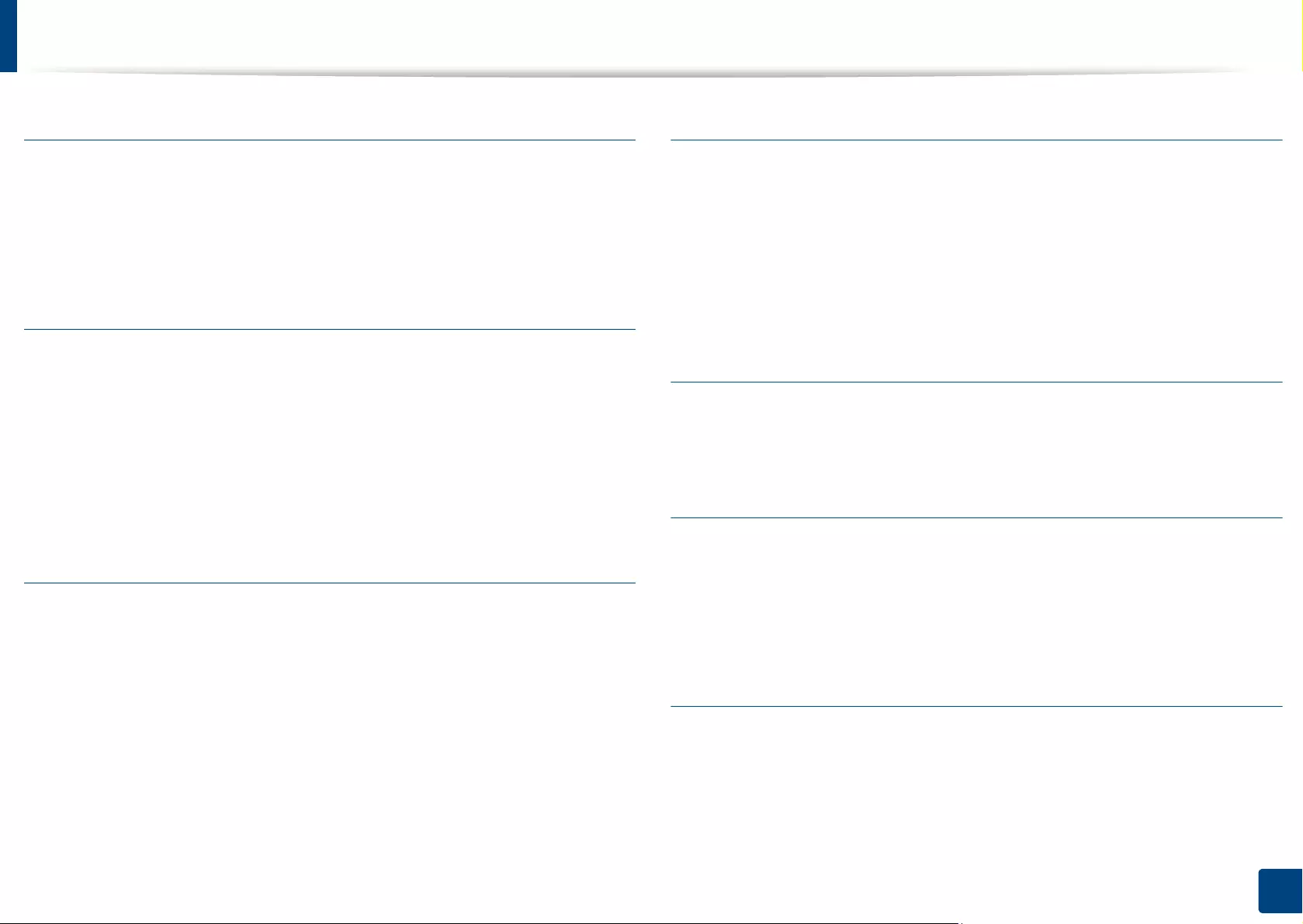
Glossary
433
Glossary
NetWare
A network operating system developed by Novell, Inc. It initially used
cooperative multitasking to run various services on a PC, and the network
protocols were based on the archetypal Xerox XNS stack. Today NetWare
supports TCP/IP as well as IPX/SPX.
OPC
Organic Photo Conductor (OPC) is a mechanism that makes a virtual image for
print using a laser beam emitted from a laser printer, and it is usually green or
rust colored and has a cylinder shape.
An imaging unit containing a drum slowly wears the drum surface by its usage
in the printer, and it should be replaced appropriately since it gets worn from
contact with the cartridge development brush, cleaning mechanism, and paper.
Originals
The first example of something, such as a document, photograph or text, etc,
which is copied, reproduced or translated to produce others, but which is not
itself copied or derived from something else.
OSI
Open Systems Interconnection (OSI) is a model developed by the International
Organization for Standardization (ISO) for communications. OSI offers a
standard, modular approach to network design that divides the required set of
complex functions into manageable, self-contained, functional layers. The layers
are, from top to bottom, Application, Presentation, Session, Transport, Network,
Data Link and Physical.
PABX
A private automatic branch exchange (PABX) is an automatic telephone
switching system within a private enterprise.
PCL
Printer Command Language (PCL) is a Page Description Language (PDL)
developed by HP as a printer protocol and has become an industry standard.
Originally developed for early inkjet printers, PCL has been released in varying
levels for thermal, dot matrix printer, and laser printers.
PDF
Portable Document Format (PDF) is a proprietary file format developed by
Adobe Systems for representing two dimensional documents in a device
independent and resolution independent format.
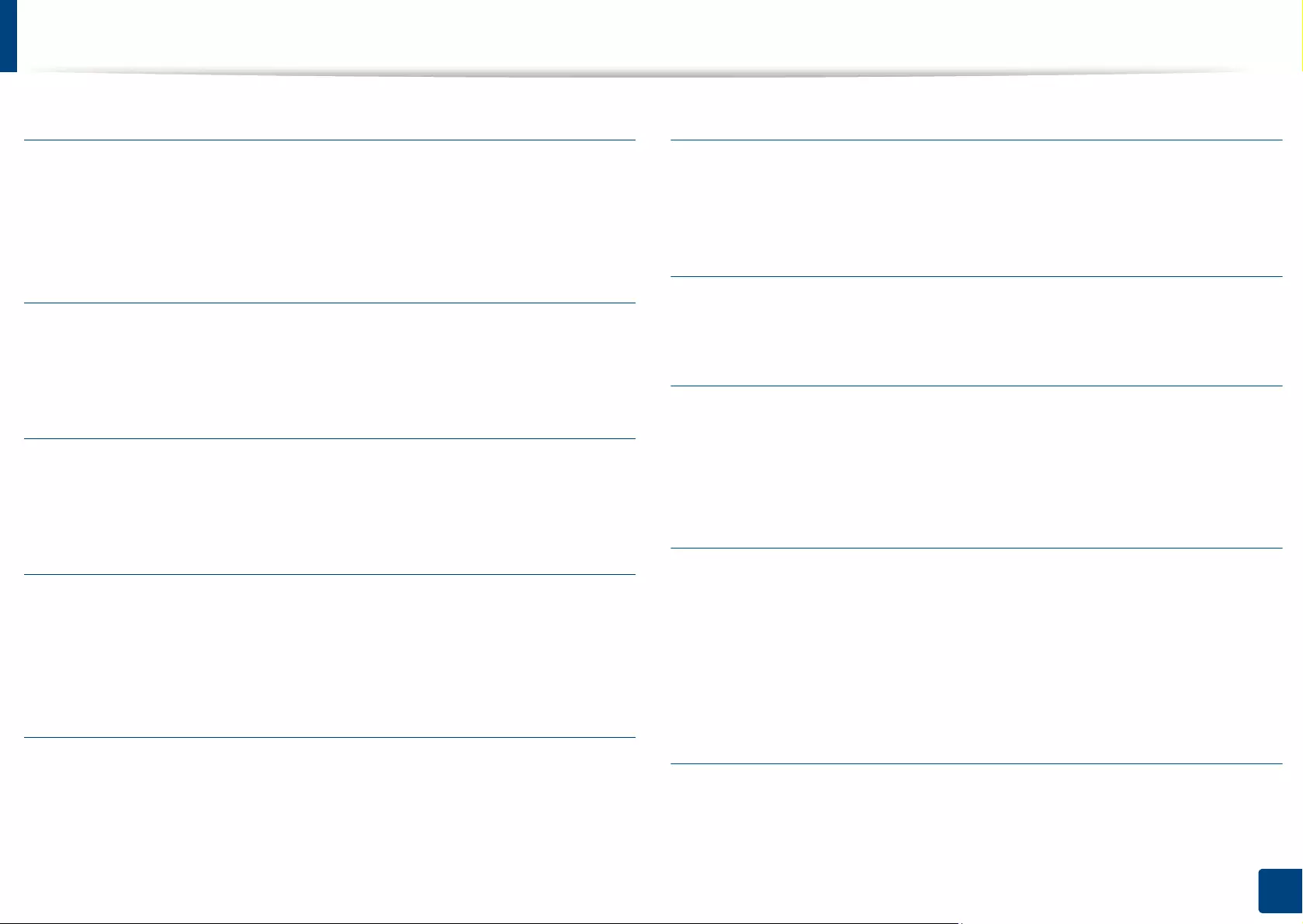
Glossary
434
Glossary
PostScript
PostScript (PS) is a page description language and programming language used
primarily in the electronic and desktop publishing areas. - that is run in an
interpreter to generate an image.
Printer Driver
A program used to send commands and transfer data from the computer to the
printer.
Print Media
The media like paper, envelopes, labels, and transparencies which can be used
in a printer, a scanner, a fax or, a copier.
PPM
Pages Per Minute (PPM) is a method of measurement for determining how fast
a printer works, meaning the number of pages a printer can produce in one
minute.
PRN file
An interface for a device driver, this allows software to interact with the device
driver using standard input/output system calls, which simplifies many tasks.
Protocol
A convention or standard that controls or enables the connection,
communication, and data transfer between two computing endpoints.
PS
See PostScript.
PSTN
The Public-Switched Telephone Network (PSTN) is the network of the world's
public circuit-switched telephone networks which, on industrial premises, is
usually routed through the switchboard.
RADIUS
Remote Authentication Dial In User Service (RADIUS) is a protocol for remote
user authentication and accounting. RADIUS enables centralized management
of authentication data such as usernames and passwords using an AAA
(authentication, authorization, and accounting) concept to manage network
access.
Resolution
The sharpness of an image, measured in Dots Per Inch (DPI). The higher the dpi,
the greater the resolution.
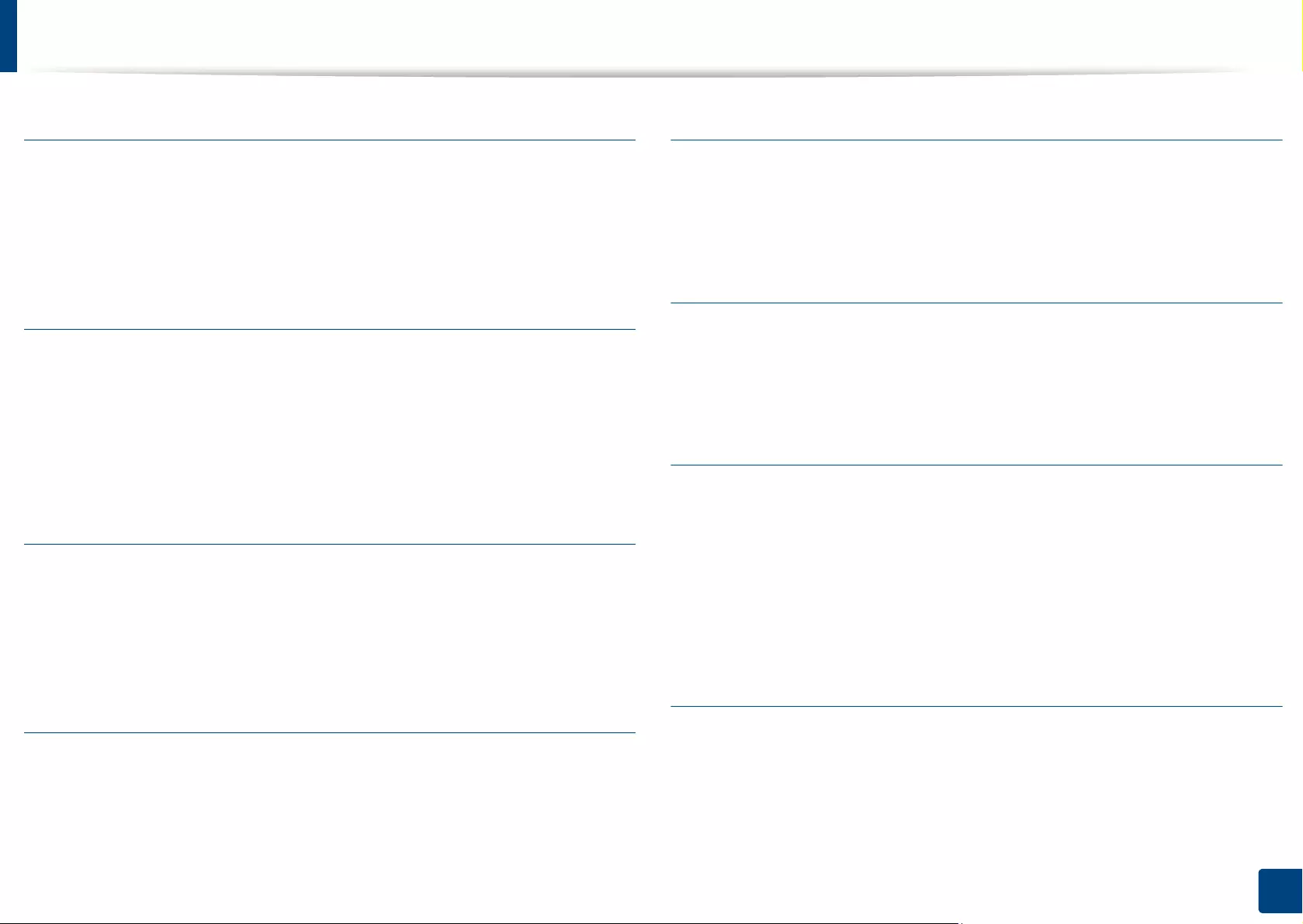
Glossary
435
Glossary
SMB
Server Message Block (SMB) is a network protocol mainly applied to share files,
printers, serial ports, and miscellaneous communications between nodes on a
network. It also provides an authenticated Inter-process communication
mechanism.
SMTP
Simple Mail Transfer Protocol (SMTP) is the standard for e-mail transmissions
across the Internet. SMTP is a relatively simple, text-based protocol, where one
or more recipients of a message are specified, and then the message text is
transferred. It is a client-server protocol, where the client transmits an email
message to the server.
SSID
Service Set Identifier (SSID) is a name of a wireless local area network (WLAN). All
wireless devices in a WLAN use the same SSID in order to communicate with
each other. The SSIDs are case-sensitive and have a maximum length of 32
characters.
Subnet Mask
The subnet mask is used in conjunction with the network address to determine
which part of the address is the network address and which part is the host
address.
TCP/IP
The Transmission Control Protocol (TCP) and the Internet Protocol (IP); the set of
communications protocols that implement the protocol stack on which the
Internet and most commercial networks run.
TCR
Transmission Confirmation Report (TCR) provides details of each transmission
such as job status, transmission result and number of pages sent. This report can
be set to print after each job or only after failed transmissions.
TIFF
Tagged Image File Format (TIFF) is a variable-resolution bitmapped image
format. TIFF describes image data that typically come from scanners. TIFF
images make use of tags, keywords defining the characteristics of the image that
is included in the file. This flexible and platform-independent format can be
used for pictures that have been made by various image processing
applications.
Toner Cartridge
A kind of bottle or container used in a machine like a printer which contains
toner. Toner is a powder used in laser printers and photocopiers, which forms
the text and images on the printed paper. Toner can be fused by by a
combination of heat/pressure from the fuser, causing it to bind to the fibers in
the paper.
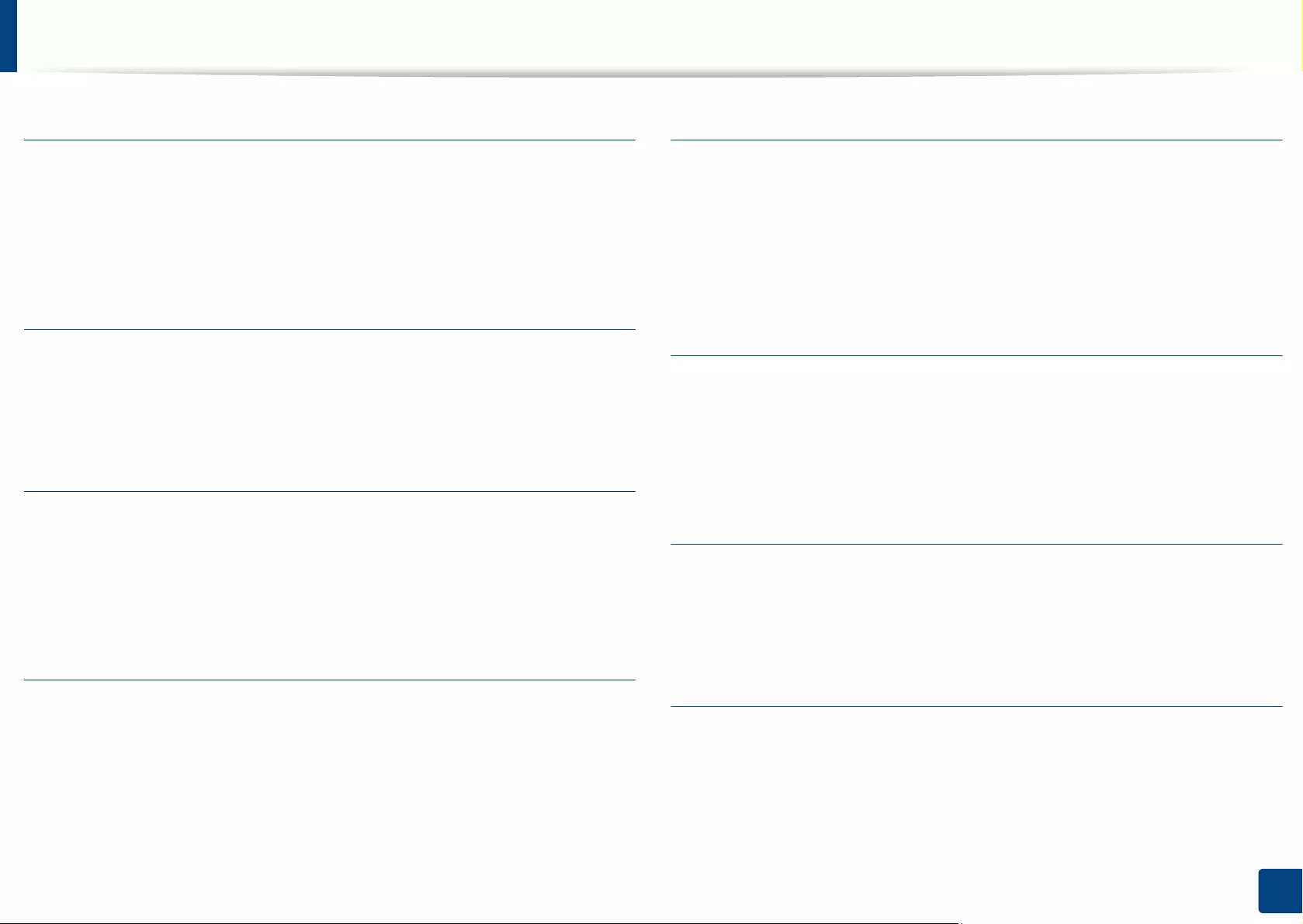
Glossary
436
Glossary
TWAIN
An industry standard for scanners and software. By using a TWAIN-compliant
scanner with a TWAIN-compliant program, a scan can be initiated from within
the program. It is an image capture API for Microsoft Windows and Apple
Macintosh operating systems.
UNC Path
Uniform Naming Convention (UNC) is a standard way to access network shares
in Window NT and other Microsoft products. The format of a UNC path is:
\\<servername>\<sharename>\<Additional directory>
URL
Uniform Resource Locator (URL) is the global address of documents and
resources on the Internet. The first part of the address indicates what protocol to
use, the second part specifies the IP address or the domain name where the
resource is located.
USB
Universal Serial Bus (USB) is a standard that was developed by the USB
Implementers Forum, Inc., to connect computers and peripherals. Unlike the
parallel port, USB is designed to concurrently connect a single computer USB
port to multiple peripherals.
Watermark
A watermark is a recognizable image or pattern in paper that appears lighter
when viewed by transmitted light. Watermarks were first introduced in Bologna,
Italy in 1282; they have been used by papermakers to identify their product, and
also on postage stamps, currency, and other government documents to
discourage counterfeiting.
WEP
Wired Equivalent Privacy (WEP) is a security protocol specified in IEEE 802.11 to
provide the same level of security as that of a wired LAN. WEP provides security
by encrypting data over radio so that it is protected as it is transmitted from one
end point to another.
WIA
Windows Imaging Architecture (WIA) is an imaging architecture that is originally
introduced in Windows Me and Windows XP. A scan can be initiated from within
these operating systems by using a WIA-compliant scanner.
WPA
Wi-Fi Protected Access (WPA) is a class of systems to secure wireless (Wi-Fi)
computer networks, which was created to improve upon the security features of
WEP.
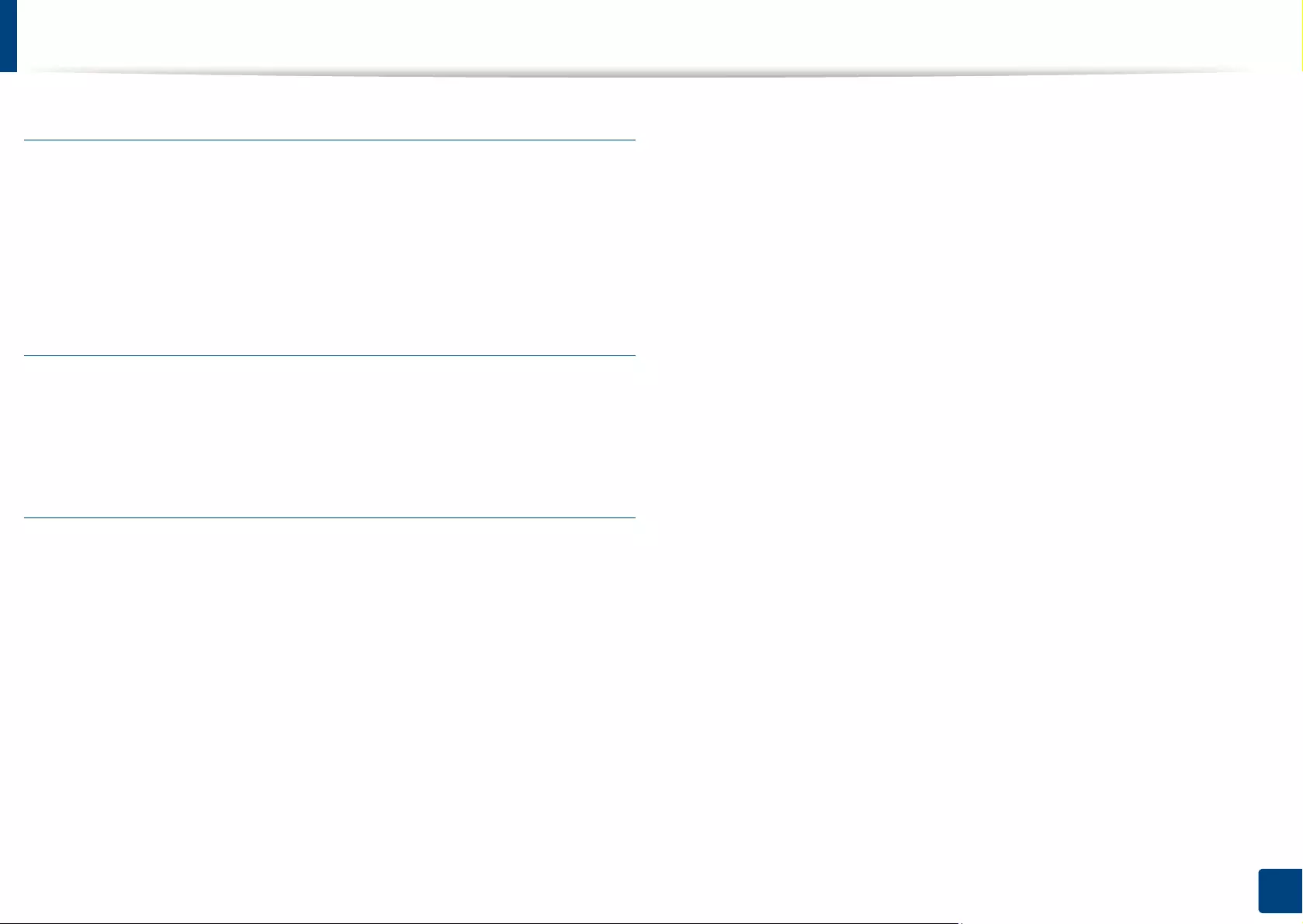
Glossary
437
Glossary
WPA-PSK
WPA-PSK (WPA Pre-Shared Key) is special mode of WPA for small business or
home users. A shared key, or password, is configured in the wireless access point
(WAP) and any wireless laptop or desktop devices. WPA-PSK generates a unique
key for each session between a wireless client and the associated WAP for more
advanced security.
WPS
The Wi-Fi Protected Setup (WPS) is a standard for establishing a wireless home
network. If your wireless access point supports WPS, you can configure the
wireless network connection easily without a computer.
XPS
XML Paper Specification (XPS) is a specification for a Page Description Language
(PDL) and a new document format, which has benefits for portable document
and electronic document, developed by Microsoft. It is an XML-based
specification, based on a new print path and a vector-based device-
independent document format.

438
Index
Index
A
accessories
installing 313
ordering 296
accounting 273
address book 258, 271
group 271
inividual 271
settings 258
SyncThru Web Service 198
adjustment
print area 248
AirPrint 219
AnyWeb Print 276
application
installing 251
authentication
login 243, 270
authority 273
B
booklet printing 106
booklets 106
buttons
Counter 31
ECO 32
Interrrupt 33
Interrupt 33
Job Status 32
C
certificate 272
cleaning
imaging unit area 320
imaging unit charger 329
inside 317
LSU window 327
outside 316
scan unit 328
toner area 317
waste toner bottle area 325
cleaning a machine 316
connect
printer cable 24
control panel 23
convention 13
copy
darkness 253, 254
duplex 252, 254, 257
ID Copy 253
Manual ID Copy 131
original type 253, 254
setting 252, 271
copying
basic copying 126
ID card copy 130
programs setting 142
understanding the copy screen 124
D
default paper selection
printing 262
default settings
setting a fax header 177
tray setting 89
device options 313
direct printing utility 113
display screen 23
displaying
IP address 45
displying

Index
439
Index
fax number 256
document box
understanding the document box screen
230
document feeder 73
driver installation 51
Unix 56
duplex printing
print 107
E
easy document creator 278
editing
group address 197
individual address 196
error correction mode 255
error message 367
ethernet 44
external authentication server 273
F
favorites settings, for printing 103
fax
address book 258, 271
forward 256
prefix dial 255
printing 256
secure receive 256
settings 254
toll save 256
fax receiving
changing the receive mode 184
in answering machine/fax 186
receiving in duplex 186
secure receiving 184
fax sending
delay sending 182
redialing the last number 181
resending automatically 181
sending a fax 177
fax, email
individual address 194
faxing
changing receiving mode 184
delaying a fax transmission 182
preparing to fax 172
printing sent fax report 190
programs setting 191
receiving 184
receiving a fax in memory 186
receiving in Tel mode 184
redialing the last number 181
sending 177
sending for both sided originals 186
setting the fax header 177
understanding the fax screen 175
features 7
print media feature 399
printer driver 93
filtering 273
IPv6 273
MAC 273
firmware 274
front view 1 20
front view 2 21
G
general icons 13
general settings 245
glossary 426
google cloud printing 225
group
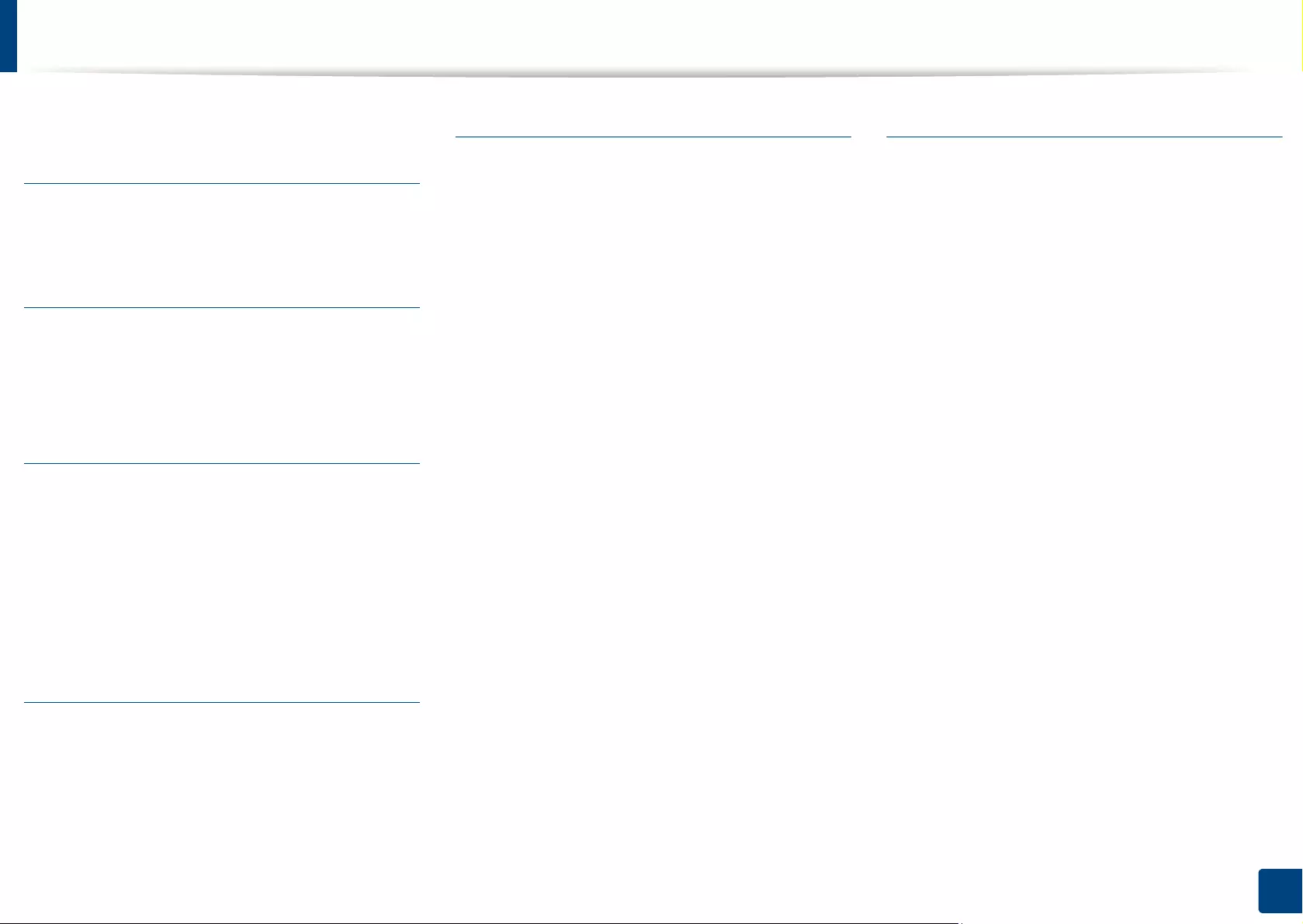
Index
440
Index
group address 196
H
hole-punching 253
HTTP settings 272
I
ID copy 130, 131
inner view 21
IPP settings 272
J
jam
clearing paper 338
tips for avoiding paper jams 337
JPEG
USB scanning memory device 163, 164,
195, 200
K
keyboard
understanding the keyboard 34
L
LED
interrupt button 33
machine status 27, 29
understanding the status LED 27
link 274
Linux
common Linux problems 394
driver installation for network connected 55
printer properties 120
printing 120
scanning 170
system requirements 404
using SetIP 47
linux scanning 170
loading
in the document feeder 73
originals on the scanner glass 72
paper in multi-purpose tray 81
paper in the tray1 76
special media 85
log 274
login 243, 270
LPR/LPD settings 272
M
Mac
common Mac problems 393
driver installation for network connected 55
driver reinstallation for USB cable connected
40
printing 118
system requirements 403
using SetIP 47
machine detail 244
machine setup 243
Macintosh
scanning 169
maintenance parts 298
managing
address book 258, 271
application 274
copy 252
user 273
margin
printing 262
menu overview 238
Mopria 217
moving 335
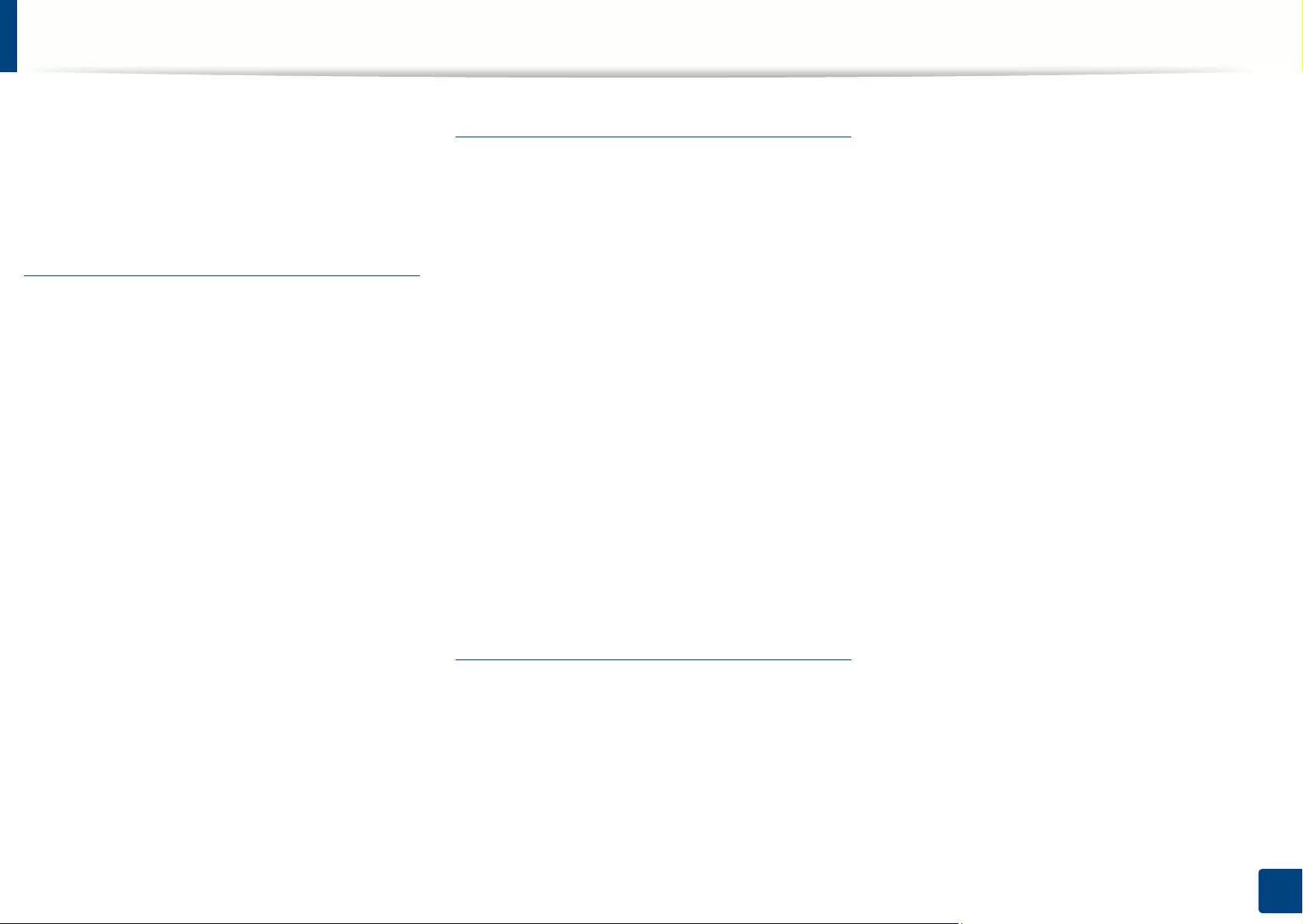
Index
441
Index
multi-purpose tray
loading 81
tips on using 81
using special media 85
N
network
driver installation
Linux 55
Mac 55
UNIX 56
Windows 51
general setup 262
installing environment 42
IPv4 configuration 46
IPv6 configuration 48
SetIP program 46, 47, 66
setting up 42
wireless network setup 58
network settings 262
N-up printing
Windows 105
n-up printing
Mac 118
O
optional tray
loading paper 76
ordering 297
original document
loading
in the document feeder 73
on the scanner glass 72
overlay printing
create 111
delete 112
print 112
overview
menu 238
overwrite
image 264
P
poster, print 106
postScript driver
troubleshooting 394
print
mobile OS 216
mobileprint 216
print media
card stock 88
envelope 86
guidelines 75
labels 87
letterhead/preprinted paper 88
output support 399
paper tab in printer preferences 98
setting the paper size 89
setting the paper type 89
special media 85
printer preferences
Linux 120
printer properties
opening printer preferences 96
printer status
general information 285
PrinterOn 223
printing
changing the default print settings 115
changing the print percentage 108
duplex 262, 271
fitting your document to a selected paper
size 108
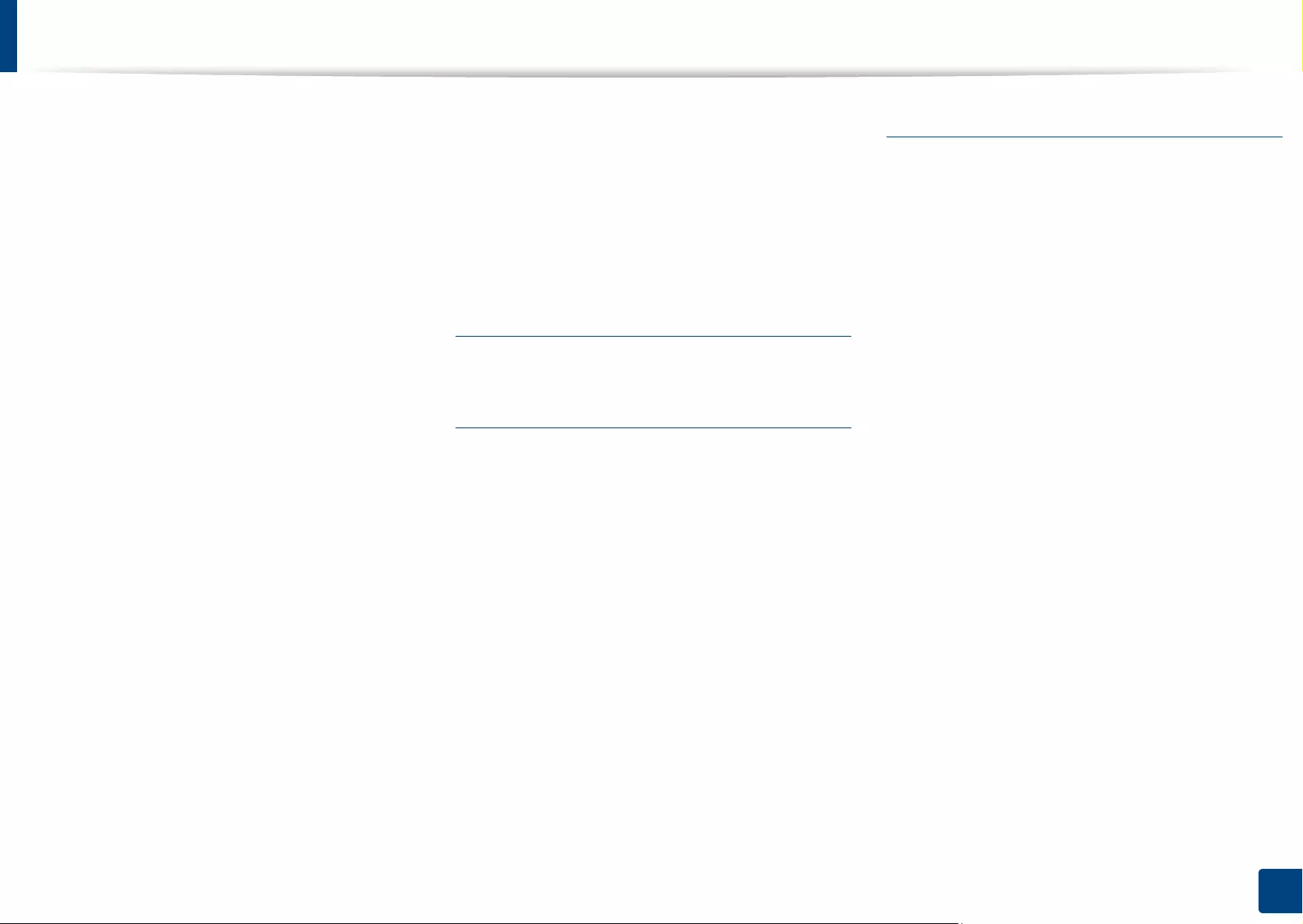
Index
442
Index
Linux 120
Mac 118
margin 262, 271
multiple pages on one sheet of paper
Mac 118
Windows 105
paper orientation 262, 271
poster 106
printing a document
Windows 94
printing on both sides of paper
Mac 119
Windows 107
printing to a file 117
setting as a default machine 116
UNIX 121
using direct printing utility 113
using overlay 111
using watermarks 109
printing a document
Linux 120
Mac 118
UNIX 121
problem
operating system problems 392
problems
copying problems 389
paper feeding problems 378, 380
power problems 379
printing quality problems 384
touch screen 380
Q
quick copy 129
R
Raw TCP/IP settings 272
rear view 22
register
PrinterOn 223
regulatiory information 405
reports
email confirmation report 151
fax report 190
machine information 163, 187, 188, 189
requirements
SyncThruTM Web Service 269
S
safety
information 14
symbols 14
samsung cloud printing 220
samsung printer experience 287
Samsung Printer Status 285
scan
color 257, 258
darkness 257
email server 272
format 258
original type 257
quality 258
to email 257
to server 257
to shared folder 257
to usb 257
Scan Assitant 168
scan to email 146
scan to server 152
scanner
glass 72
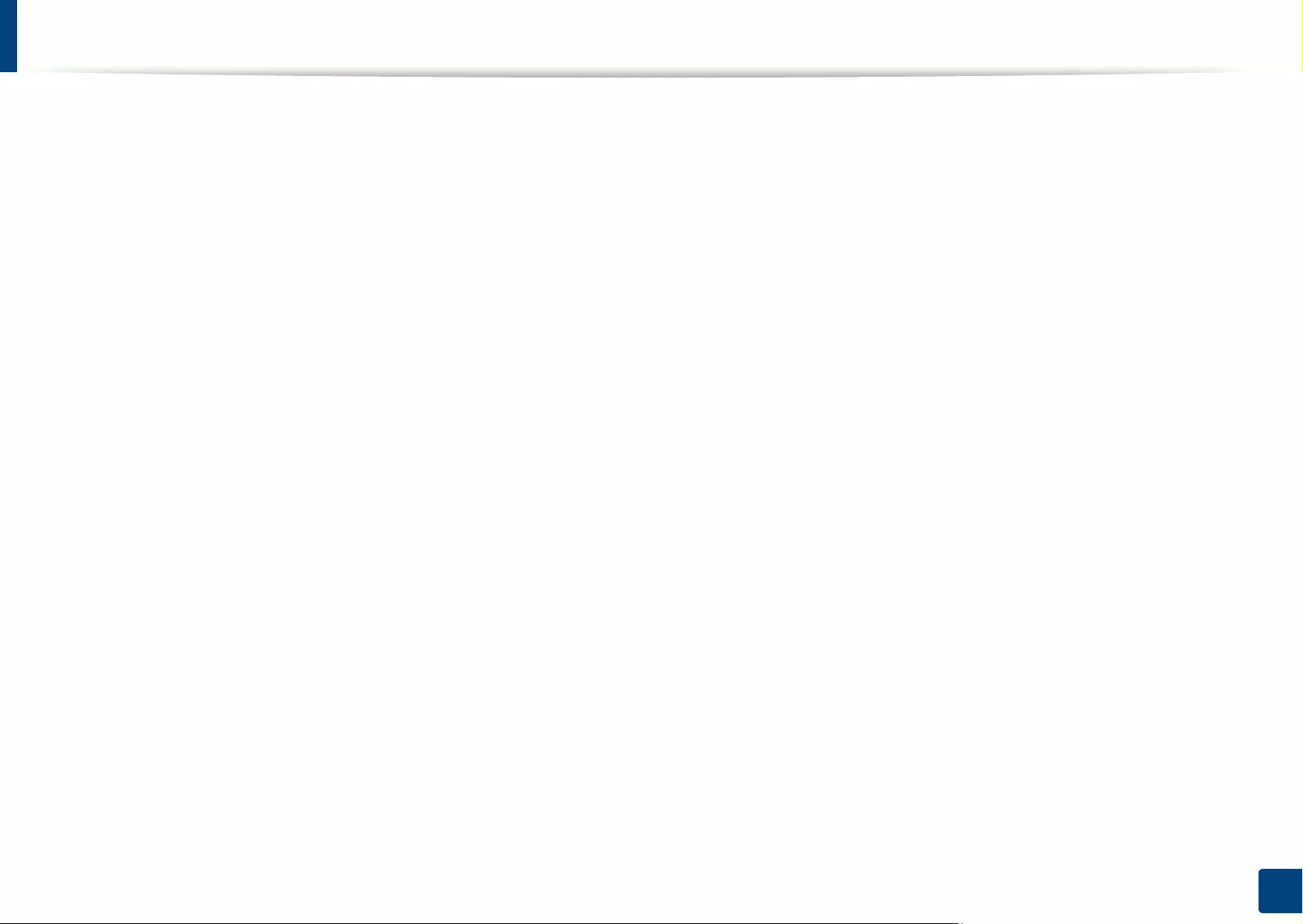
Index
443
Index
loading documents 72
scanner glass
loading documents 72
Scanning
Scanning with Samsung Scan Assitant 168
scanning
changing settings 162
for network connection
to email 146
to FTP, SMB, WEBDAV 152
Linux scanning 170
Macintosh 169
programs setting 166
TWAIN 167
searching
address book 197
security
system 272
security settings 263
image overwriting 264
server settings 41, 205
service contact numbers 419
SetIP program 46, 66
setting up an address book
from a control panel 194
settings 263
address book 258
application 252
copy 271
current 271
DNS 45
eco mode 260
ethernet 44
fax 254, 271
gernal 245
HTTP 272
machine 271
margin 262, 271
network 41, 44, 205, 262, 272
printer 271
scan 272
security 272
network 272
server 41, 205
SyncThruTM Web Service 272
TCP/IPv4 44
tray 259
WINS 45
shared folder 228
SMB, FTP
individual address 194
specifications 397
print media 399
stapling 253
stop button 23
storing
machine 334
paper 334
supplies 334
supplies
available supplies 295
estimated toner cartridge life 299
monitoring the supplies life 315
ordering 295
storing 334
SyncThruTM Web Service 269
accounting 273
address book tab 271
application management 274
configuring 272
connecting to 269
copy 271

Index
444
Index
external authentication server 273
fax 271
information tab 271
log 274
maintenance tab 274
network 272
printer 271
requirements 269
scan 272
security tab 272
settings 271
settings tab 271
user access control 273
user profile 273
what is 269
T
TCP/IPv4 44
to USB memory device 160, 161, 236
toner cartridge
estimated life 299
handling instructions 299
non-Samsung and refilled 299
redistributing toner 300
replacing imaging unit 306
replacing toner 303
replacing waste toner container 310
storing 299
touch screen
problem solving 380
tray
adjusting the width and length 76
changing the tray size 76
loading paper in multi-purpose tray 81
ordering an optional tray 297
setting the paper size and type 89
tray setting 259
TWAIN, scan 167
U
understanding the fax screen 175
understanding the scan screen 145
UNIX
driver installation for network connected 56
printing 121
Unix
system requirements 403
usage
counter 271
supplies 271
usb
understanding the usb screen 232
USB cable
driver installation 36
driver reinstallation 40
USB memory device
how to scan 160
printing 234
user
managing 273
profile 273
user access control 273
using
PrinterOn 224
using help 104, 119
W
watermark
create 109
delete 110
edit 110
print 109
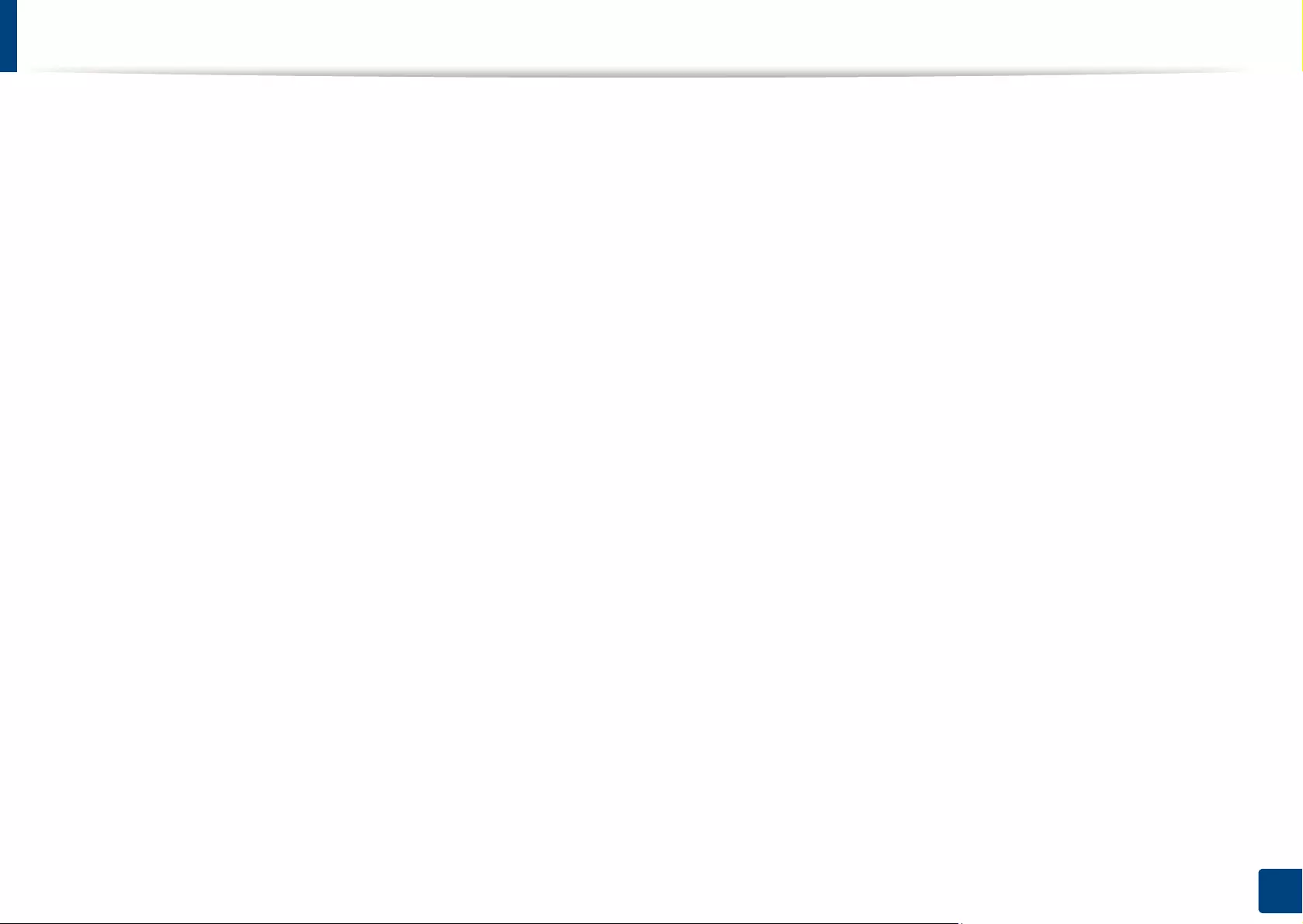
Index
445
Index
Windows
common Windows problems 392
driver installation for network connected 51
driver installation for USB cable connected
36
driver reinstallation for USB cable connected
39
printing 92
scanning 144
system requirements 402
using SetIP 46, 66
wireless
WPS
disconnecting 60
PBC mode 60
wireless network
network cable 66
WSD settings 272



